
- 2 Weeks for Couple
- 2 Weeks for Family
- Thailand Lantern Festival
- Indonesia(Bali)
- South Korea
- China (HK, Taiwan)
- Itinerary Ideas
- Asia Highlights Travel Reviews
- Thailand Travel Reviews
- Vietnam Travel Reviews
- Cambodia Travel Reviews
- Japan Travel Reviews
- Myanmar Travel Reviews
- China Travel Reviews
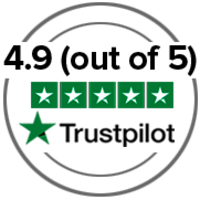
- 10 Days in South Korea: Best 4 Itineraries for a First Visit 2024/2025
When visiting South Korea, 10 days is the most popular length of time for both families and couples. You could explore major highlights of Seoul and Busan without feeling rushed. You would also have the flexibility to visit Jeju Island, traditional Gyeongju and Andong, or other places that interest you.
In this article, we've handpicked four 10-day South Korea itineraries to help you plan a once-in-a-lifetime vacation and stress-free journey. We would customize any itinerary based on your preferences.

Itinerary 1: Classic South Korea
- Itinerary 2: For Family with Teenagers
Itinerary 3: Modern and Historical South Korea
Itinerary 4: south korea off-the-beaten-path.
- How Much Does a 10-Day Trip in South Korea Cost
This 10-day itinerary is excellent for a first visit to South Korea. It covers the must-see attractions in Seoul, Busan, Gyeongju, and Jeju Island, as well as a variety of authentic activities to enrich your trip.
- 3 nights in Seoul
- 1 night in Gyeongju
- 2 nights in Busan
- 2 nights on Jeju Island
- 1 night in Seoul
Begin your adventure in Seoul. Explore iconic landmarks, such as Gyeongbokgung Palace, Bukchon Hanok Village, Myeongdong, and N Seoul Tower with your private guide. Your guide would help you to understand the culture and history of Seoul in a more interesting way.
To fully immerse yourself in Korean cuisine, taste authentic Korean food at Gwangjang Market. You would also have the chance to try your hands at a cooking class in a local home.
Next, head to Gyeongju, the ancient capital with many historic sites. Don't miss experiencing a night's stay at a traditional Hanok hotel. A Hanok hotel usually has 5–15 rooms and they're easily booked up, so you're advised to make a reservation at least 3 months in advance.
Continue your adventure to the seaside city of Busan. You could quickly get a feel for the city's cultural-rich atmosphere at Haedong Yonggung Temple and Gamcheon Culture Village.
Take a short flight to end your journey on Jeju Island. Be amazed by the natural wonders of Manjanggul lava tube, Hallasan Mountain, and Seongsan Ilchulbong (‘Sunrise Peak'). Watch Haenyeo divers catch seafood in a traditional way and enjoy some free time on the beaches. After that, back to Seoul to depart from the country.
Our South Korea travel expert would tailor-made a private tour for you based on your preferences and requirements.
Itinerary 2: for Families with Teenagers
This 10-day South Korea itinerary is suitable for families with teenagers and allows for a relaxing travel pace. It would satisfy your kids' love for K-pop and provides abundant family-friendly experiences. What's more, you don't need to change hotels a lot.
- 4 nights in Seoul
- 3 nights on Jeju Island
Start your trip in Seoul. For a special family experience, we could arrange many authentic activities to help you delve into Korean history, culture, and food. For example, experience a private K-pop dancing class and shoot a video, explore the DMZ tunnels with a guided tour, indulge in a cooking class, and spend a night at a traditional Hanok hotel.
Then, take a comfortable KTX (Korea Train Express) to Busan. Enjoy the natural beauty of Taejongdae by traveling effortlessly on the Danubi Train and then sample various street food at BIFF Square.
If you want to see the full view of Busan's coastal line, Songdo Skywalk is a must-visit. We suggest picking the high-end crystal cable car with a glass bottom instead of the regular one. That way, you could enjoy the beautiful sea view of Busan from every angle, feeling like you're walking on air.
Finally, you would fly to Jeju Island and be immersed in its attractive highlights: Seongeup Folk Village, the performance of Haenyeo divers catching seafood, and a sightseeing cruise to watch whales.
Our travel expert would carefully design each private tour to cater to your unique interests and requirements .
With this 10-day South Korea itinerary, you would explore the top two modern cities of Seoul and Busan, and also delve into the profound history of the ancient cities of Andong and Gyeongju.
- 1 night in Andong
- 2 nights in Seoul
Your journey through South Korea would begin in Seoul, a capital with a vibrant culture. You would take a leisurely walk in Insadong and Myeongdong, cruise on the Han River, and sample local Korean food at Gwangjang Market.
During your stay in Seoul, you could also consider taking 1–2 days for a day trip to explore nearby cities like Suwon, known for its rich traditions, and Chuncheon, a paradise for outdoor sports.
On day 4, you would head to the birthplace of Korean philosophical culture, Andong. Highlights include seeing a unique mask dance performance at the famous Hahoe Folk Village and creating your mask at Hahoe Mask Museum. With the company and guidance of a local guide, you would gain a deeper understanding of historical stories.
On day 5, travel to Gyeongju to visit the "museum without walls". There are many historical sites with thousands of years of history waiting for you to explore: Bulguksa Temple, Seokguram Grotto, and Donggung Palace and Wolji Pond. Don't forget to spend a night at a Korean-style Hanok hotel.
Then, spend 3 days in Busan, where you could wander around Haedong Yonggungsa Temple, experience the fun Songdo Skywalk, and sample the freshest seafood. After that, head back to Seoul to depart from South Korea.
You can just tell us your preferences and requirements, and we will customize a tour for you.
With this 10-day itinerary, you would visit the bustling city of Seoul and explore three off-the-beaten-path cities: Sokcho, Andong, and Suncheon. Immerse yourself in traditional villages and enjoy serene natural views.
To make the most of your time while visiting the attractions, you're recommended to travel in a private car when visiting the three hidden gems of Sokcho, Andong, and Suncheon.
- 1 night in Sokcho
- 2 nights in Suncheon
You would start in Seoul. Explore the highlights with a guided tour of Changdeok Palace, Bukchon Hanok Village, Jogyesa Temple, the DMZ, and any other attractions that you're interested in.
One of the highlights of this itinerary is the Seoraksan National Park in Sokcho. This is the highest peak near Seoul, featuring strange rocks and rare wildlife. It's a great place for travelers who love adventure and outdoor sports.
The traditional city of Andong is your next stop. Enjoy a unique mask dance performance at Hahoe Folk Village and visit the local Confucius temple and school to gain insights into the culture that has deeply affected Korean history.
Another highlight of this itinerary is Suncheon Bay Wetland Reserve in Suncheon. It's one of the world's top five coastal wetlands. You could take a sightseeing cruise to visit the rare birds with a guide and wander across the wide reeds. Finally, take a private car and return to Seoul to depart South Korea.
If you have other requirements, contact us and we can make it happen.
How Much Does 10 Days in South Korea Cost?
US$400–500 per person per day is the typical cost for a private tour with 4-star hotels, based on a family of 3–5 people. This includes a private guide, private car, full-day itinerary, tickets for attractions, all intercity transport within South Korea, and handpicked 4-star hotels.
Therefore, the total cost for 10 days in South Korea would be about US$4,000–5,000 per person (international flights not included).
Why Asia Highlights (10,000+ reviews & 98.8% 5-star rating)
- Save Your Time:
- Less research, more enjoyment!
- Real-time 1V1 expert planning
- Maximize Your Flexibility:
- Personal local guide and ride
- Explore at your own pace
- Celebrate Your Journeys:
- Specially-crafted family adventures
- Celebrate milestones with style!
- 16-Day South Korea and Japan Cultural Adventure Tour
- 8-Day South Korea Tour to Visit Highlights of Seoul, Busan and Jeju
- 10-Day South Korea Tour to Visit Seoul, Sokcho, Andong and Suncheon
- 17-Day Classic South Korea and Taiwan Tour
- How to Plan a Trip to South Korea in 2024/2025
- How to Plan a 12-Day Trip in Japan and South Korea
- How to Plan a 2-Week Itinerary in Japan and South Korea
- Japan Weather in January: Travel Tips for First-Timers
- Japan Weather in February 2024: Travel Tips for First-Timers
- Japan Weather in March 2024: Travel Tips for First-Timers
- Japan Weather in April 2024, Travel Tips (for First-Timers)
- Japan Weather in May 2024: Travel Tips for a First Visit
- Japan Weather in June 2024: Coolest Summer Month, Travel Tips for First Visit
- Japan Weather in July 2024: Full of Festivals, Travel Tips for First Visit
- Japan Weather in August 2024: Travel Tips for First Visit
- Japan Weather in September, Travel Tips (for First-Timers)
- Japan Weather in October 2024: Travel Tips for First-Timers
- Japan Weather in November 2024: Best Autumn Month, Travel Tips
- Japan Weather in December 2024: Travel Tips for First-Timers
Get Inspired with Some Popular Itineraries
At Asia Highlights, we create your kind of journey — your dates, your destinations, at your pace. You can have any trip tailor made for your travel.
More Travel Ideas and Inspiration
Sign up to Our Newsletter
Be the first to receive exciting updates, exclusive promotions, and valuable travel tips from our team of experts.
Why Asia Highlights
Where can we take you today.
- Middle East
- African Safari

- Travel Agents
- Our Differences
- Privacy Policy

Address: Building 6, Chuangyi Business Park, 70 Qilidian Road, Guilin, Guangxi, 541004, China

Zen Moments in Korea
7 days South Korea itinerary: what to do and where to go in 2024
Planning for a 7 days South Korea itinerary can prove to be challenging especially if you are visiting for the first time. The country has so much in store, from pristine nature to vibrant cities, delicious food, and impressive local traditions, that you will try to see it all.
With only 7 days in your hands, there is so much you can do and see. However, with a good itinerary, you will manage to make the best out of your time in the country and tick as many places as possible off of your bucket list .
Read also : South Korea 10-day itinerary | South Korea 5-day itinerary
This post contains affiliate links. This means if you click on the link and purchase the item, I will receive an affiliate commission at no additional cost to you. Read more about it on our disclosure page here .
Table of Contents
Day 1: seoul palaces, bukchon hanok, insadong, hongdae.
- Day 2: Namdaemun Market, Namdaemun Park, NSeoul Tower, Itaewon, Myeongdong
- Day 1 – Gamcheon Cultural Village, Jagalchi Fish Market, Yeongdo Island, Jeoryeong Coastal Walk, Yongdusan Park and Busan Tower
- Day 2 – Haedong Yonggungsa Temple, The Blue Line Park Sky Capsule & Train, Haeundae Beach, Gwangalli Beach
Day 6 – Gangnam (Lotte World)
Day 7: day trip outside of seoul (dmz, suwon, etc), day 1: cafes, seongsu, seoul forest, day 2: day trip to chuncheon, day 3: gyeongju day trip, day 4 + 5: busan, day 6: day trip to namhae, boseong, day 7: back in seoul or spend a day in incheon.
- Option 3: Seoul, Gyeongju, Busan
- Option 4: Seoul and day trips
Is 7 days enough for South Korea?
Other things to know when planning for 7 days in south korea, 7 days south korea itinerary: what to do and where to go, option 1: 7 days south korea itinerary for first timers – seoul and busan.

Any first-time traveler should visit at least the 2 most important cities in South Korea: Seoul and Busan.
We lived in Seoul and traveled to Busan as often as we could. The ocean-side city is much more colorful than South Korea’s capital.
After spending almost one year in Seoul, here is our favorite itinerary for 7 days in Seoul and Busan.
Best area to stay in Seoul for sightseeing: Myeongdong
Recommended Hotels in Myeongdong:
Budget: Crib 49 Guesthouse
Mid-Range: L7 Myeongdong by LOTTE
Luxury: Lotte Hotel Seoul Executive Tower

Start your first day in Seoul by visiting one or 2 of the famous 5 Palaces .
If you want to do something else as well, you won’t have the time to see all of them. Worry not because if you manage to see one or 2, that’s just enough.
Gyeongbokgung Palace and Changdeokgung Palace are within walking distance from one another, and they have the famous Bukchon Hanok Village in between.
Gyeongbokgung Palace
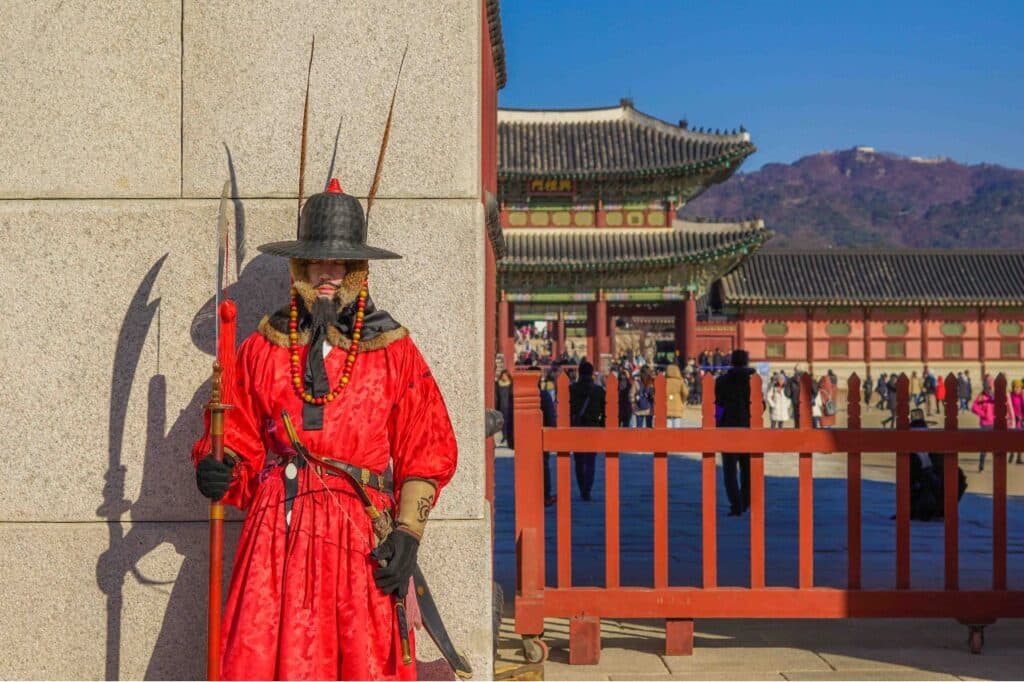
Constructed in 1395 AD by the first Joseon king, Taejo, its name was devised by an influential minister called Jeong Dojeon. It was the kingdom’s main palace complex, housing the royal household and most of the government.
Stepping through the grand gates, you’re immediately transported back to the Joseon dynasty, as the palace’s intricate architecture and sprawling grounds evoke a sense of awe and wonder.
The imposing presence of Gyeongbokgung, with its vibrant hues and traditional designs, offers a glimpse into the opulence of Korea’s royal past.

Walking along the meticulously manicured gardens and serene ponds, you can almost hear the echoes of history whispering through the air.
Exploring the palace’s various halls, pavilions, and courtyards reveals a treasure trove of artifacts and stories, each corner brimming with centuries of tradition and significance.
Admission Fees Adults (ages 19-64): 3,000 won / Groups (10 people or more): 2,400 won Children (ages 7-18): 1,500 won / Groups (10 people or more): 1,200 won
Free on the last Wednesday of the month and while wearing a hanbok.
Address : 161, Sajik-ro, Jongno-gu, Seoul
Gyeongbokgung Station (Seoul Subway Line 3) and Exit 5. Anguk Station (Seoul Subway Line 3) and Exit 1.
Official website
Changdeokgung Palace

Move forward to the Changdeokgung Palace, a UNESCO World Heritage Site.
Its seamless integration with the surrounding landscape, particularly the majestic Huwon Secret Garden , showcases the meticulous harmony between nature and human ingenuity.
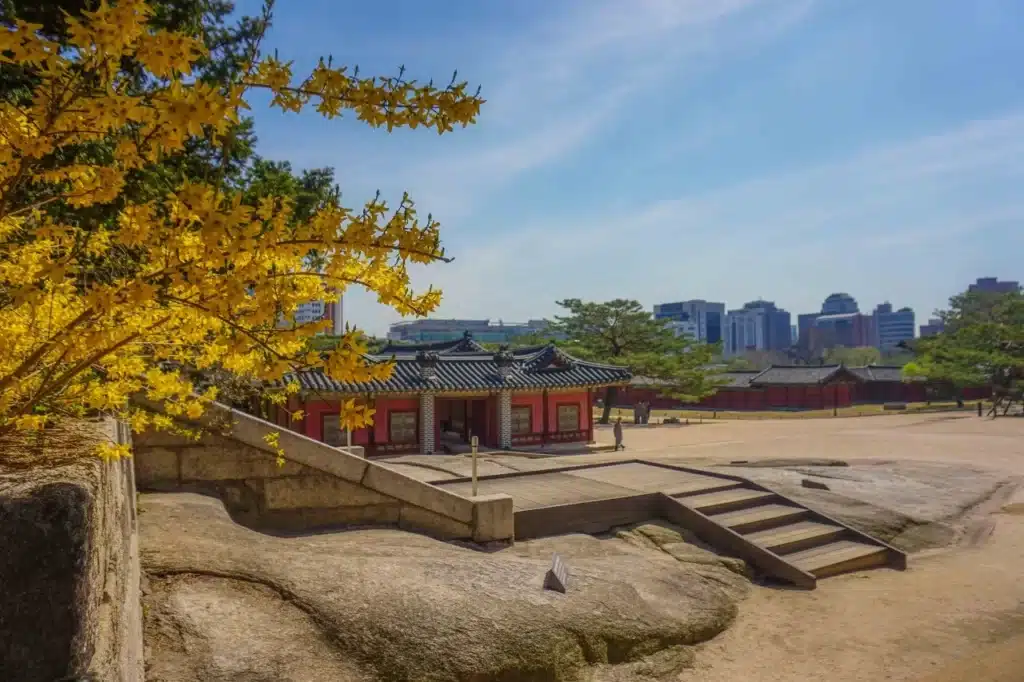
Walking through the palace’s ornate halls, pavilions, and courtyards, visitors are transported to an era of royal splendor, where every detail reflects the grace and elegance of Korean aesthetics.
From the iconic Injeongjeon Hall to the tranquil ponds and winding paths of the garden, each corner of Changdeokgung Palace invites exploration and contemplation.
Admission Fees [Changdeokgung Palace] Adults (ages 25-64): 3,000 won / Group (over 10 people): 2,400 won / Youth ( ages 7-18): 1500 won Students (ages 24 and under): Free (* Except for foreign visitors)
On the last Wednesday of the month, and when wearing a hanbok dress, the entrance is free.
Address : 99, Yulgok-ro, Jongno-gu, Seoul
Subway : Anguk Station (Seoul Subway Line 3), Exit 3.
Bukchon Hanok Village

One of our favorite areas in town, the Bukchon Hanok Village is packed with pretty cafes, art museums, and local traditional restaurants.
The neighborhood boasts a labyrinth of narrow alleyways lined with beautifully preserved hanok houses, showcasing the elegance of traditional Korean architecture.
The perfect area to explore during spring or fall , that’s when Seoul transforms itself and becomes incredibly photogenic.
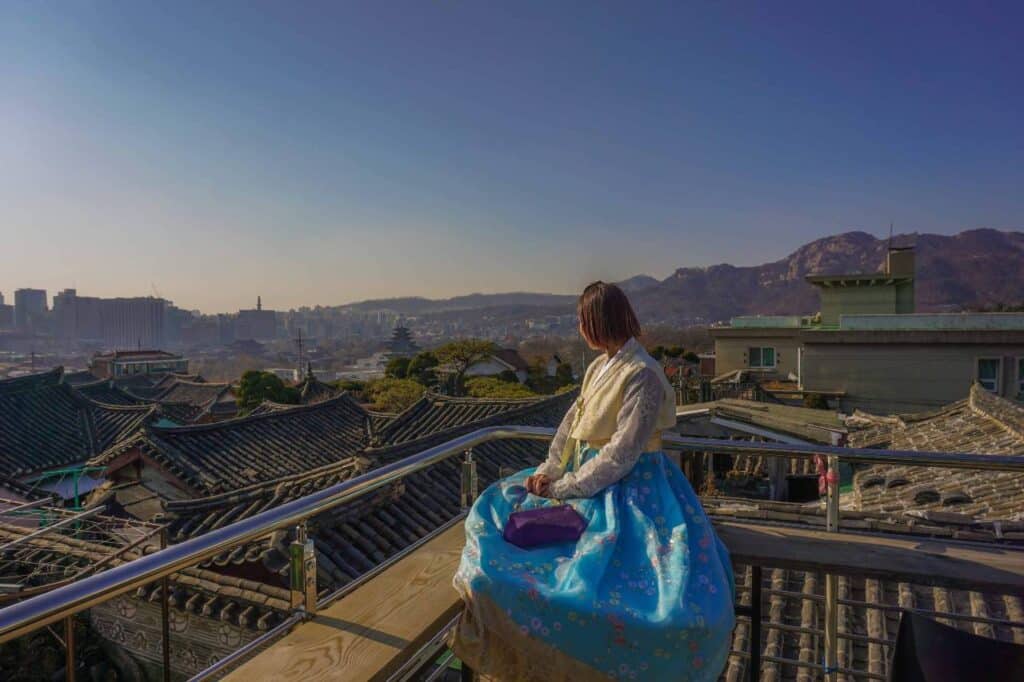
Rent a premium hanbok and stroll through the quaint streets, and you will be transported back in time, immersed in the tranquil ambiance of centuries-old courtyards, tiled roofs, and graceful eaves.
The village’s timeless charm is further enhanced by its panoramic views of the surrounding city skyline and nearby historic landmarks, including Gyeongbokgung Palace and Jongmyo Shrine.
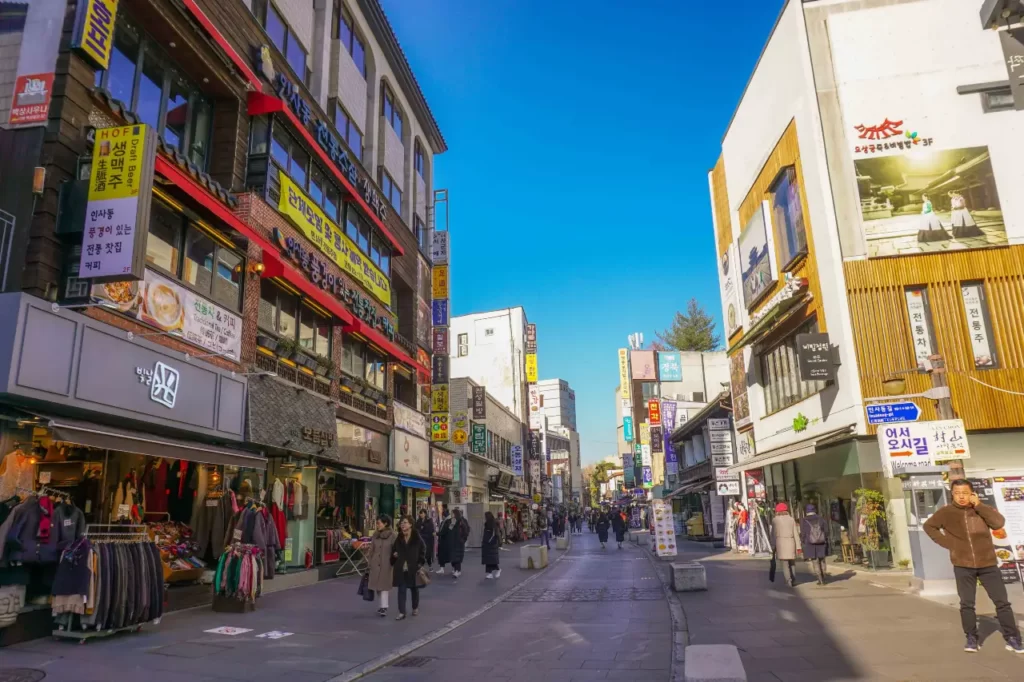
Across the street from the Bukchon Hanok Village lays the famous Insadong area.
Renowned as a hub for traditional Korean arts and crafts, Insadong’s bustling streets are adorned with galleries, teahouses, and shops showcasing a diverse array of handmade pottery, paintings, calligraphy, and other cultural treasures.
Eat at one of the local restaurants and try some traditional pastries – hotteok (sweet pancakes) and bindaetteok (mung bean pancakes).
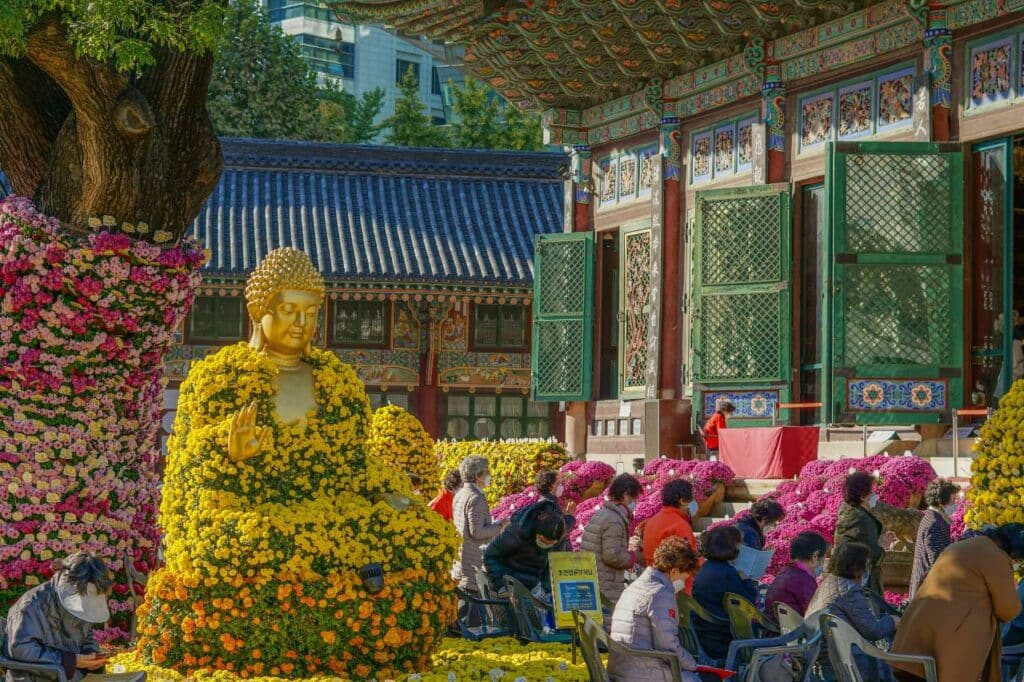
Don’t miss a visit to Jogyesa Temple – The temple’s main hall, Daeungjeon, is a masterpiece of traditional architecture, housing exquisite Buddhist relics and statues, including a majestic golden Buddha.
During special occasions, the temple is decorated with colorful lanterns or flowers.

End your day in one of the most vibrant areas in town: Hongdae.
You can easily get there by subway (on line number 3, green) or by taking the bus. We always preferred traveling by bus because that’s the best way to see the city.
Lined with trendy cafes, indie boutiques, and street performers, Hongdae exudes an atmosphere of constant excitement and innovation.
By day, the streets teem with shoppers browsing unique fashion finds and enjoying quirky coffee shops, while by night, the area transforms into a lively hub of music, dance, and revelry, with numerous clubs and bars hosting live performances and DJ sets.
Read also: Things to do in Hongdae | Where to stay in Hongdae, best hotels
Day 2: Namdaemun Market, Namdaemun Park, NSeoul Tower, Itaewon , Myeongdong
Namdaemun Market
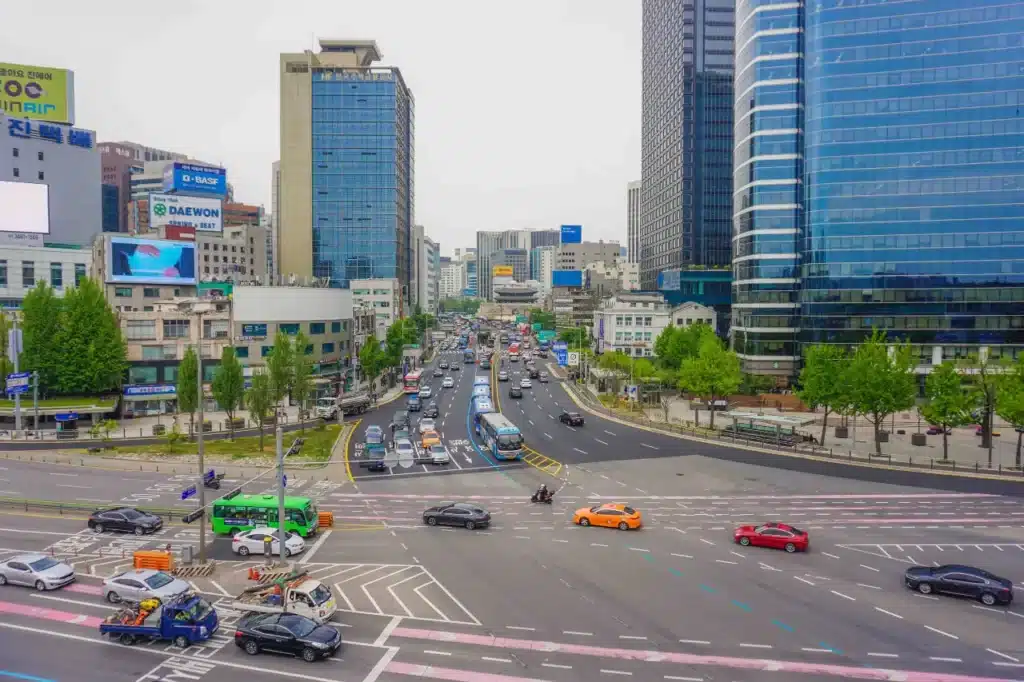
Start your day with a visit at the Namdaemun Market, in the heart of the city.
As one of Seoul’s premier shopping destinations, Namdaemun Market exudes a vibrant and chaotic energy, with the lively calls of vendors mingling with the chatter of shoppers.
Namdaemun Park and Namsan Mountain

From the market, cross the street, enter the beautiful park, and start climbing Namsan Mountain toward NSeoul Tower. As you move forward up you will be welcomed by stunning city views.
Of course, if you don’t feel like walking so much, there are plenty of other ways to get to Namsan Tower . Take the bus, the cable car, or a taxi when you want to get there fast and easy.

As one of the city’s most recognizable symbols, the tower stands tall at 236 meters, providing visitors with an unparalleled vantage point to admire the beauty of the South Korean capital.
Whether by day or night, the observation decks offer stunning vistas, with distant mountains, skyscrapers, and the winding Han River stretching as far as the eye can see.
Beyond its panoramic allure, N Seoul Tower is also a cultural hub, featuring various attractions such as the Teddy Bear Museum and numerous restaurants, cafes, and souvenir shops.

As you cross on the other side of Namsan Mountain, you will get to the famous Itaewon district.
As a melting pot of cultures, Itaewon attracts visitors from all corners of the globe, offering a kaleidoscope of experiences that cater to every taste and interest.
Its bustling streets are lined with an eclectic mix of trendy boutiques, art galleries, and vintage shops, alongside an array of international restaurants, cafes, and bars.
You can choose to spend the evening here at one of the many restaurants or bars or head over to Myeongdong.
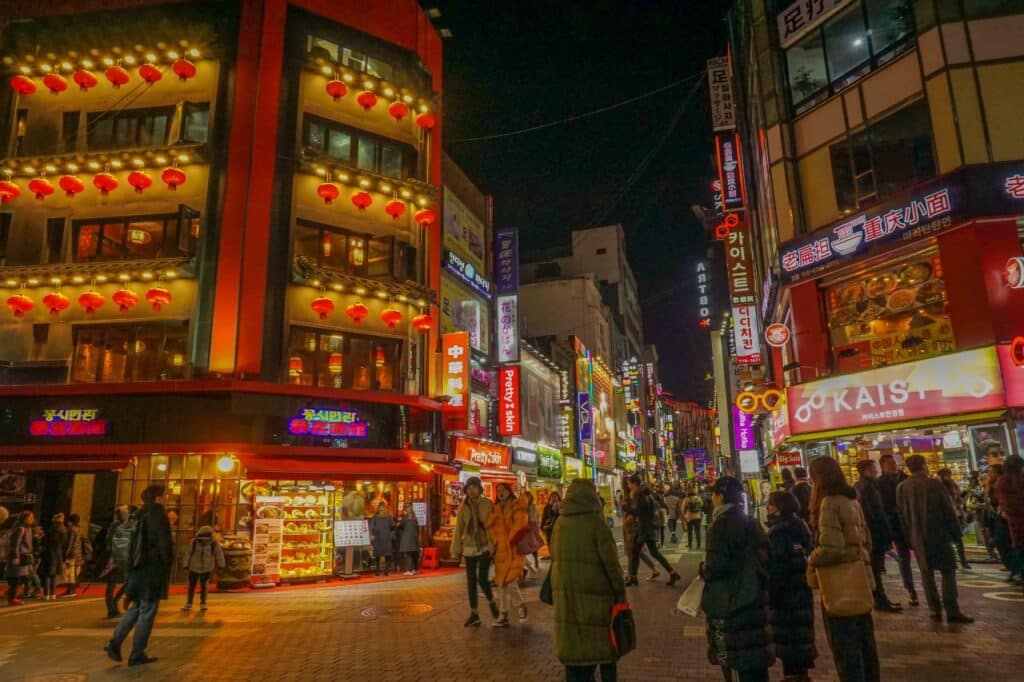
Set in the heart of the city, Myeongdong is packed with cosmetics stores , restaurants, cafes, and street food vendors. You can shop till you drop, have dinner at one of the local places, see a show at Nanta , or visit a cat cafe.
When it comes to what you can do in Myeongdong , the options are countless.
Read also: Where to stay in Myeongdong
Day 3-5: Busan
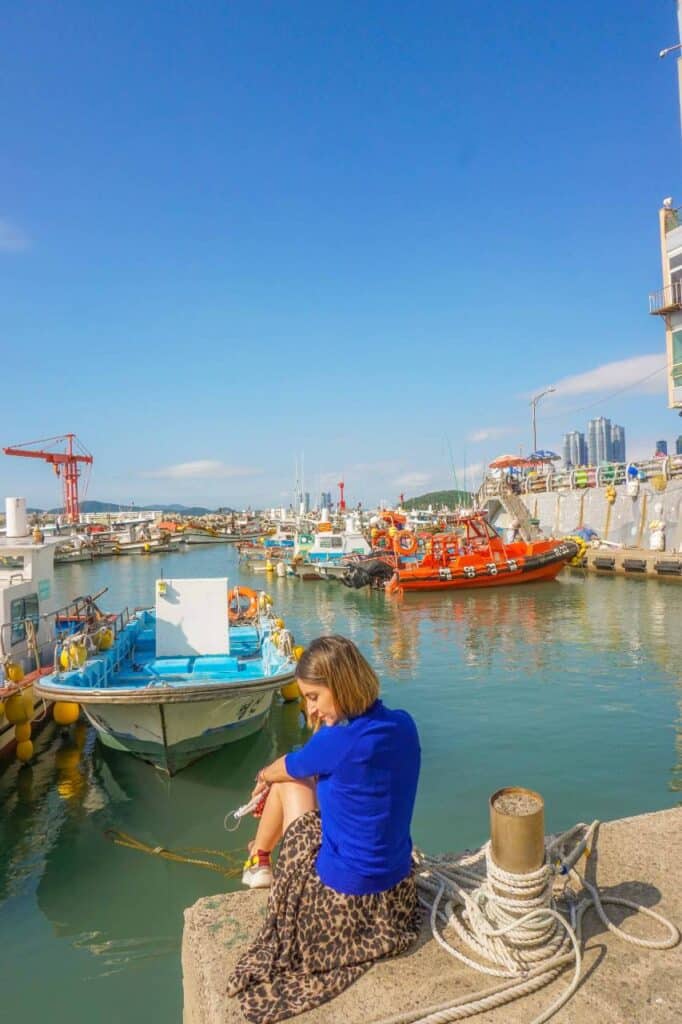
Getting from Seoul to Busan is easy and it can also be relatively fast when you choose to travel by high-speed train (KTX) or by plane.
If you ask us, we would always choose to travel by KTX – it is fast, convenient, and comfortable. The train station is close to the city center in both cities, and you don’t waste any more time on the commute. Book your Korea Rail Pass here!
Best area to stay in for 2 days in Busan : Seomyeon
Recommended hotels in Seomyeon
Lotte Hotel Busan
Browndot Business Seomyeon
We love Busan and would go back to the ocean-side city on every occasion.
The city offers so many things to do and see, and with only 2 days on your hands, you will need to carefully craft your itinerary. Here is our suggestion.
Read also: 2 days in Busan itinerary – packed with useful information
Day 1 – Gamcheon Cultural Village , Jagalchi Fish Market , Yeongdo Island, Jeoryeong Coastal Walk, Yongdusan Park and Busan Tower
Gamcheon Cultural Village

One of the most popular attractions in town, the Gamcheon Cultural Village attracts so many tourists on a daily base.
Nestled on the hillside, the colorful village offers stunning views.
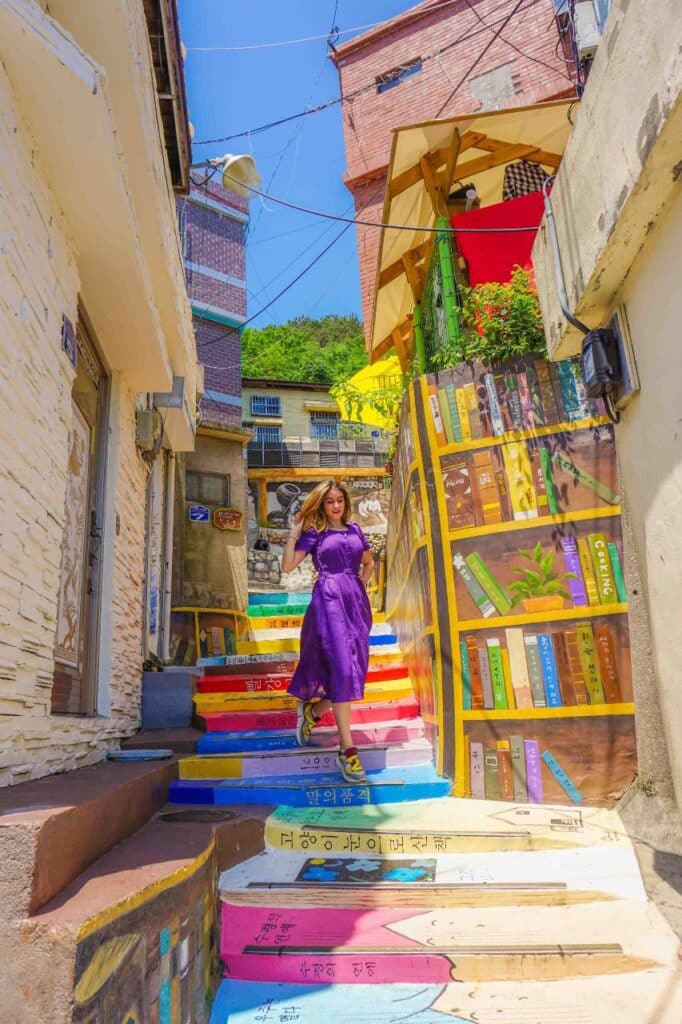
Once a humble settlement for refugees during the Korean War, the village has been transformed into a lively cultural hub adorned with vibrant murals, sculptures, and installations created by local artists.
From quaint cafes and art galleries to cozy boutiques and handicraft workshops, Gamcheon exudes a palpable sense of community and artistic expression.
Jagalchi Fish Market
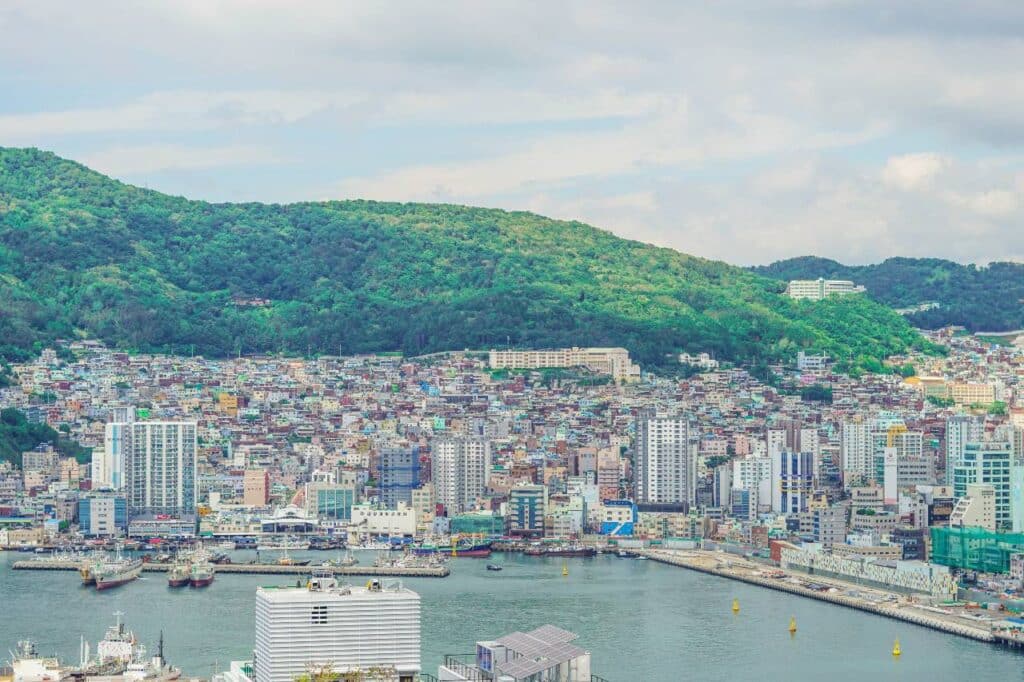
Take the bus and head over to one of the most famous local fish markets: Jagalchi Fish Market.
As one of the largest fish markets in Korea, Jagalchi is a sensory feast, with rows upon rows of stalls brimming with an astonishing variety of fresh seafood, ranging from familiar favorites like octopus and shrimp to more exotic offerings such as sea squirts and sea cucumbers.
The market’s vibrant atmosphere is heightened by the lively calls of vendors hawking their wares and the frenetic energy of shoppers bargaining for the best catch of the day.
Book a Jagalchi Fish Market & Korean Food Market Tour
Yeongdo Island

Cross the bridge and head to Yeongdo Island.
The island is home to several historic sites, including the towering Yeongdo Lighthouse and the historic Taejongdae Park, which boasts dramatic cliffs, dense forests, and sweeping vistas of the coastline.
But, the most popular attraction is the Jeoryeong Coastal Walk . Colorful streets, cafes with scenic views, and a perfect walk along the ocean.

Yongdusan Park and climb Busan Tower (부산타워)
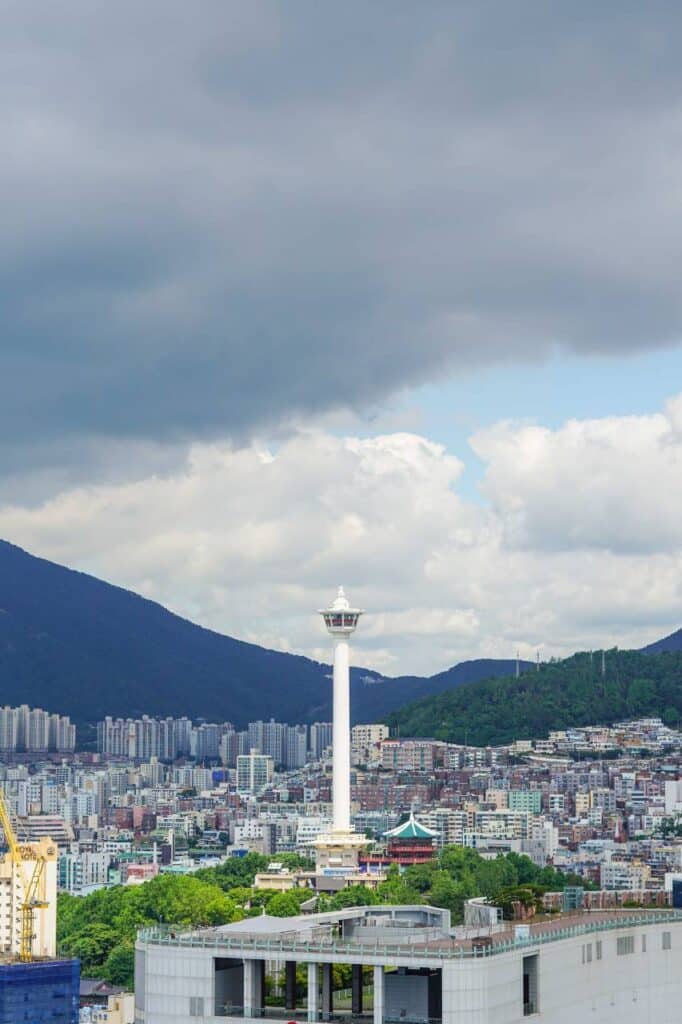
Standing 118 meters tall atop Yongdusan Park, this observation tower has been a symbol of Busan’s modernity and progress since its construction in 1973.
You can ascend to the tower’s observation deck via a high-speed elevator, where you are treated to breathtaking views of the city’s sprawling metropolis, picturesque coastline, and surrounding mountains.
Beyond its scenic allure, Busan Tower also houses a cultural exhibition hall showcasing the city’s history and achievements.
Tip : Save on attractions with the Busan Pas s
Day 2 – Haedong Yonggungsa Temple , The Blue Line Park Sky Capsule & Train, Haeundae Beach, Gwangalli Beach
Haedong Yonggungsa Temple

Start your day at the temple and make your way back towards the city.
Unlike many other temples nestled in the mountains, Haedong Yonggungsa’s oceanfront location imbues it with a unique and tranquil ambiance, making it a popular destination for both spiritual seekers and tourists.
The temple, believed to have been first built in the 14th century, boasts a rich history steeped in legend and devotion.
Adorned with colorful lanterns, intricate pagodas, and ornate statues, the temple’s architecture harmonizes beautifully with its natural surroundings, offering breathtaking views of the sea and surrounding cliffs.
Take the Blue Train or Sky Capsule from Cheongsapo Station (청사포정거장)
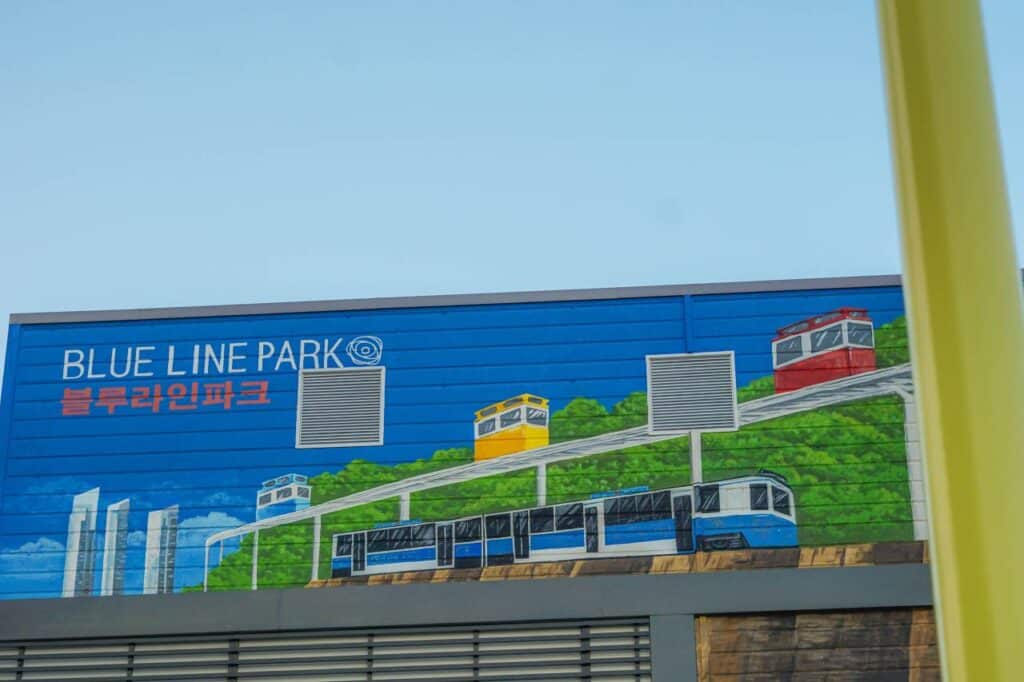
From the temple, take the bus and go to Cheongsapo Station, the end of the line for the Blue Train.
One of the most popular attractions in town, the train links Cheongsapo to Mipo Station and it rides along the ocean, offering breathtaking scenic views.
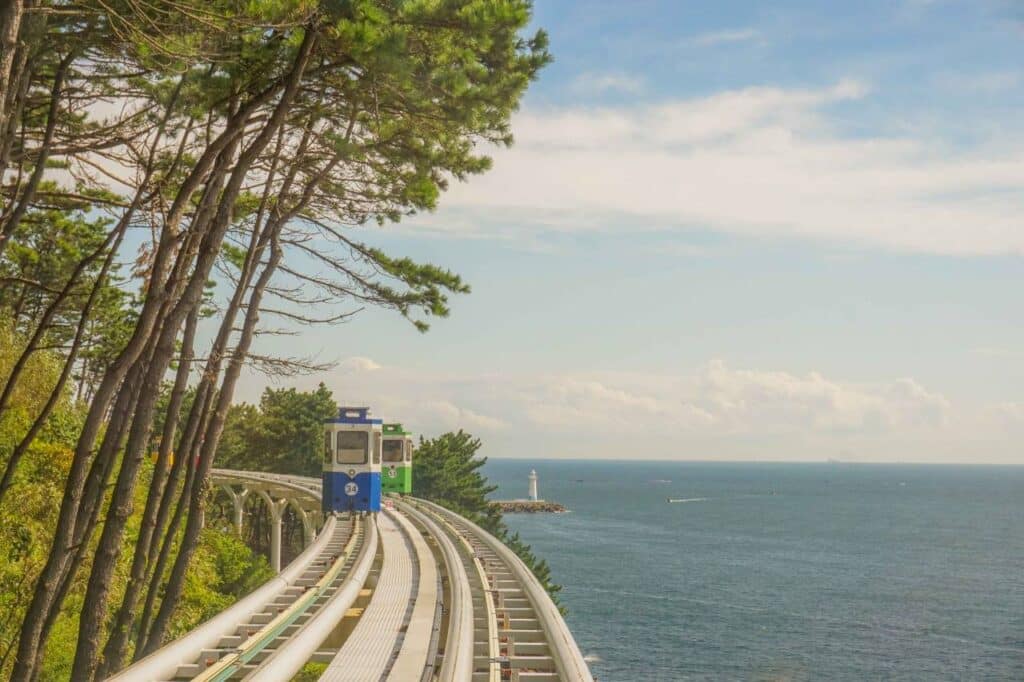
For the rest leg of the trip, choose to go on the Sky Capsule because it is indeed a unique experience.
Read our complete Sky Capsule and Blue Line Train Guide!
Haeundae Beach

Mipo Station is minutes away from Korea’s most popular beach – Haeundae Beach .
Haeundae stretches for approximately 1.5 kilometers, offering ample space for relaxation and recreation against the backdrop of the sparkling East Sea.
With its soft sands, crystal-clear waters, and panoramic views of nearby islands and mountains, Haeundae Beach provides the perfect setting for sunbathing, swimming, or simply unwinding by the shore.

The beachfront promenade is lined with an array of restaurants, cafes, and shops, offering a diverse selection of local delicacies, refreshing beverages, and souvenirs.
During the summer months, the beach comes alive with vibrant energy as locals and tourists alike flock to enjoy festivals, fireworks displays, and cultural performances.
Go for a SPA treatment with Korean beauty products at the famous SPA 1899 near the Haeundae beach. Book your treatment here!
Don’t miss the Sea Life Busan Aquarium – an impressive immersion into sea life. You will learn about hundreds of species of fish and marine animals, and can also take part in the feeding of sharks. Book your ticket here!
Gwangalli Beach

End your day with dinner and a sunset view at Gwangalli Beach.
Unlike its more crowded counterpart, Haeundae Beach, Gwangalli is known for its laid-back vibe and picturesque setting, making it a favorite among locals and tourists seeking a more relaxed seaside experience.
In the evenings, the beach transforms into a dazzling spectacle, as the Gwangan Bridge illuminates the night sky with its vibrant lights, casting a magical glow over the waterfront.
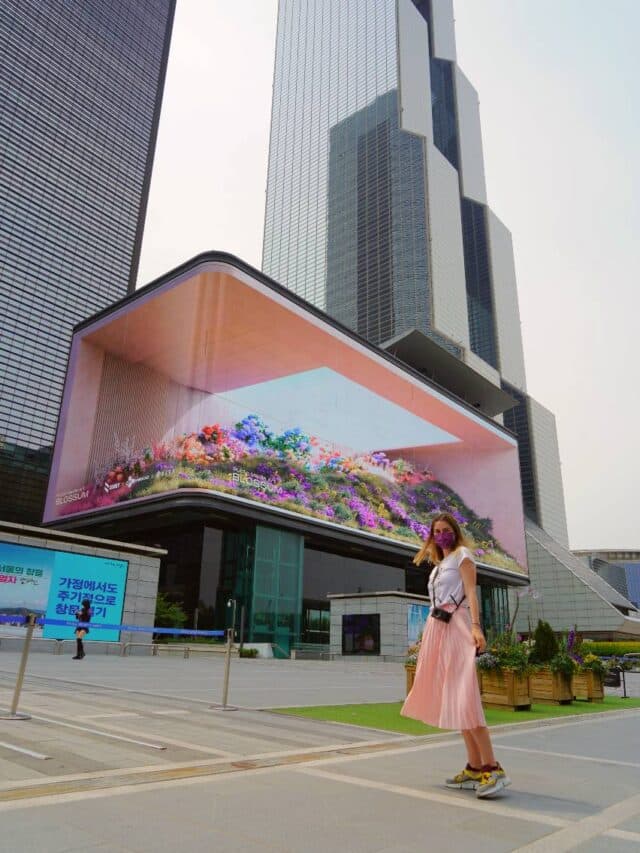
Made famous by the global hit song “Gangnam Style,” the district has become synonymous with luxury, fashion, and entertainment.
Its towering skyscrapers, glitzy shopping centers, and chic boutiques cater to a sophisticated clientele, offering a wide array of designer brands, trendy cafes, and gourmet restaurants.

You can either choose to explore Gangnam – have tea at Bongeunsa Temple, take a picture with the famous COEX Mall Library, see the Samsung Display, shop for luxury brands in Garosu-gil, or do any one of these cool things to do in Gangnam .
Or you can spend almost all the at the famous Lotte World – the most popular adventure park in South Korea.
As the day ends, climb Lotte Sky Tower , South Korea’s tallest building.
There are just so many things you can fit into one day in Gangnam.
The options for day trips outside of Seoul are endless, but visiting the DMZ should be on any new visitor’s list.
As one of the most heavily fortified borders in the world, the DMZ serves as a stark reminder of the ongoing conflict and the enduring hope for reunification.
Tours to the DMZ typically include stops at key landmarks such as the Joint Security Area (JSA), where visitors can observe soldiers from both sides standing face-to-face, and the Dora Observatory, which provides panoramic views of the border and glimpses into North Korea’s countryside.
Visitors also have the opportunity to explore the 3rd Infiltration Tunnel, dug by North Korea in an attempt to infiltrate the South, and the DMZ Exhibition Hall, which offers insightful exhibits on the history and significance of the area.
If that is not of interest to you, don’t worry! We have a comprehensive list covering many options for day trips outside of Seoul .
Incheon, The Garden of Morning Calm, Suwon and Hwaseong Fortress, are only a few of the amazing places you should see in South Korea, that are also easily reached from Seoul.
Option 2: One Week in South Korea off-the-beaten-path
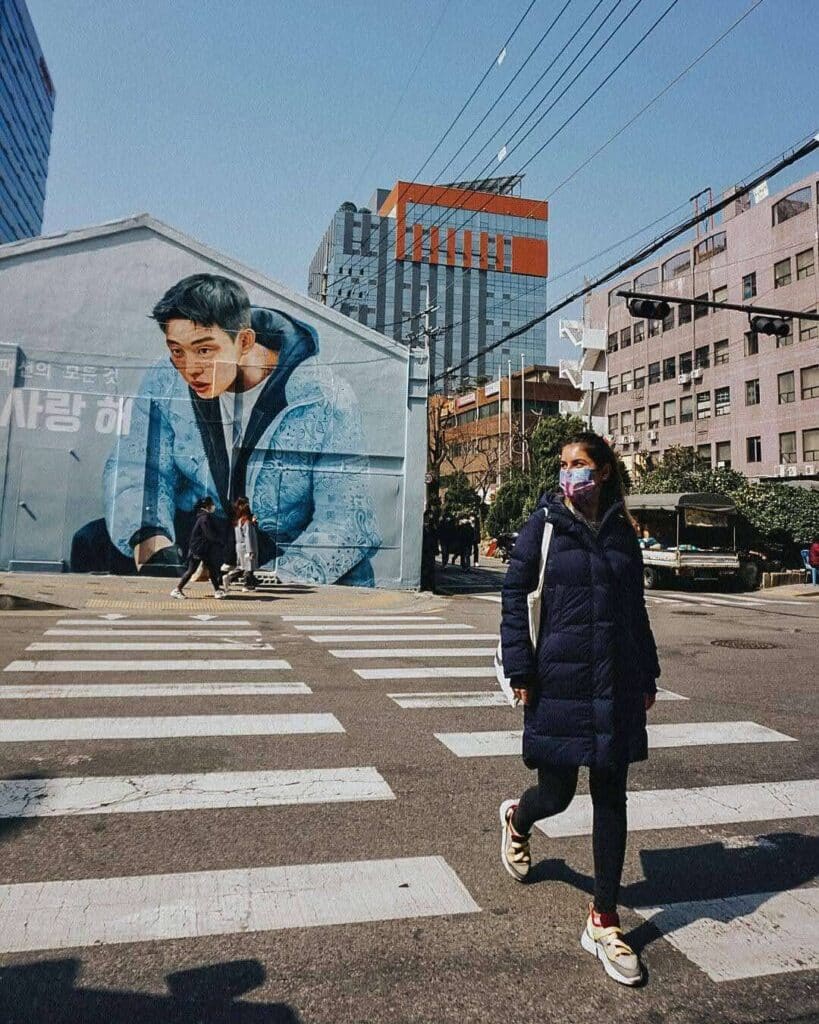
Seoul’s Brooklin, Seongsu-dong is worth exploring if this is not your first time in the city.
Packed with cool murals, photogenic pop-up stores, flagship stores, and great restaurants, you can allow yourself to get lost on these streets.
Thanks to its proximity to Seongsu-dong, you can explore the beautiful Seoul Forest Park, especially when visiting during spring or fall.

A beautiful lake set between the mountains, less than 2 hours away from Seoul.
The charming city is renowned for its natural beauty, cultural heritage, and culinary delights.

One of the city’s most iconic landmarks is the picturesque Soyangho Lake, where you can enjoy leisurely boat rides or scenic lakeside strolls. If you feel like it, you can also rent a bike and bike your way around the lake.
Chuncheon is also famous for its delectable cuisine, particularly dakgalbi, a spicy stir-fried chicken dish that originated in the city.

A day trip to Gyeongju is a must during your South Korean trip.
As the former capital of the ancient kingdom of Silla, Gyeongju is steeped in over a thousand years of rich history, evident in its myriad of archaeological sites, temples, and royal tombs scattered throughout the city.
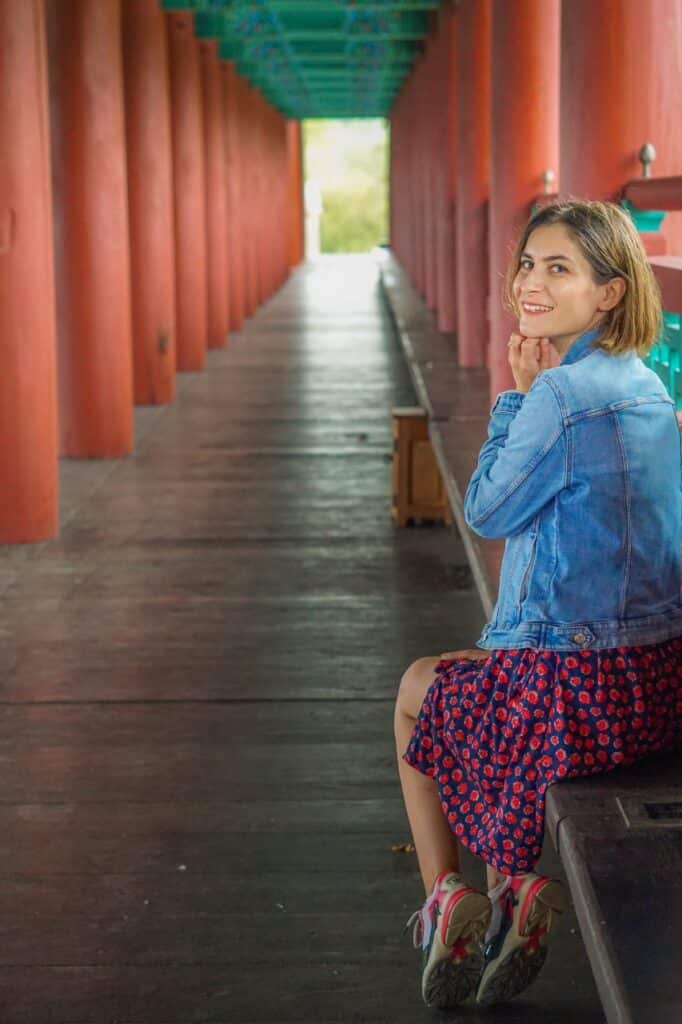
The UNESCO World Heritage Site of Bulguksa Temple and the Seokguram Grotto are just two examples of Gyeongju’s remarkable architectural and religious significance.
The city’s lush landscapes, including the serene Bomun Lake and the rolling hills of Namsan, provide a picturesque backdrop for exploration.
Even though we visited twice on rainy days, we fell in love with the charm of this unique Korean city.
You can easily get there by KTX from Seoul and get off at Singyeongju Station.
Read our comprehensive guide for a day trip to Gyeongju
Follow the above itinerary options.

You can rent a car and drive to see the famous Boseong Tea Plantations and the Namhae Peninsula.
Alternatively, you can book a day tour from Busan or Seoul , and enjoy round-trip transportation with a local guide.
Renowned as the birthplace of Korean green tea, these meticulously manicured plantations have been cultivated for centuries, with the region’s mild climate and fertile soil providing ideal conditions for tea cultivation.
You can wander along winding paths that snake through the lush greenery, offering panoramic views of the meticulously groomed rows of tea bushes.
Also, at the plantation, you can taste different types of green tea-flavored food and drinks.

The main attraction on Namhae island is the Boriam Temple , a Buddhist temple set on the top of the mountain, offering breathtaking views (on a sunny day).
As we visited after a rainy night, the temple was surrounded by heavy fog. Even so, it is worth going, especially since the hike to the temple is extremely enjoyable.
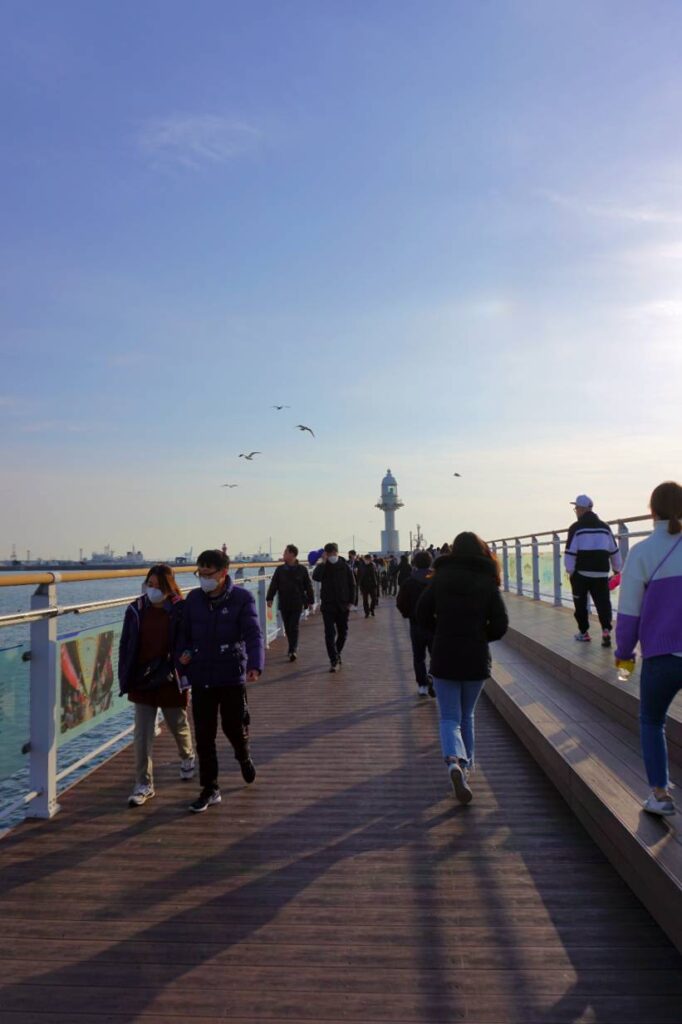
Start your day by visiting Incheon’s historic Chinatown , where you can wander through colorful streets lined with traditional shops, restaurants, and historical landmarks such as the Jajangmyeon Museum and the Incheon Open Port Museum .
Next, head to Songdo Central Park , a sprawling urban park boasting scenic walking paths, serene ponds, and modern art installations. Here, you can rent a bike or take a leisurely stroll while enjoying views of the iconic Incheon Bridge and the futuristic architecture of Songdo International Business District.
Catch a breathtaking sunset over the West Sea from one of the city’s scenic viewpoints like Eurwangni Beach or Wolmido Island.
Option 3 : Seoul, Gyeongju, Busan
Option 4 : seoul and day trips.
For this option, you book accommodation in Seoul and plan day trips outside of the city as often as you wish.
Yes, 7 days is plenty of time to experience the best of South Korea.
You can get a good overview in this amount of time and still have enough flexibility to explore at your own pace. Tick off Seoul and some other important attractions such as Busan or other important day trips outside of the city.
Depending on where you start, you could visit several cities spanning across the country as well as some popular attractions such as scenic hikes or temples.
Additionally, if you’re looking for a more laid-back experience, you can also take advantage of the many hot springs, beaches, and spas ( jimjilbangs ) that South Korea has to offer.
Visa – Depending on where you are traveling from, you will or won’t need a visa . Check your Visa requirements here!
Don’t travel without insurance – this is a World Wide Travel Health Insurance + Covid suitable for almost anyone, and easy to book. On top of that, they also provide luggage insurance in case your luggage gets lost or damaged. Get the best offer here!
Book your SIM Card & T-Money Card with airport pickup
See if you would rather buy a SIM card or pocket wifi for your trip
Travel by train and get the best ticket price with a Korea Rail Pass
Get discounts on popular tourist attractions & activities by booking them ahead of time on Klook , Viator , or GetYourGuide
By Ingrid & Alex
Ingrid A former financial professional, I have been passionate about photography since an early age. My fascination with Korean culture was one of the reasons Alex accepted a business role in Seoul. Alex A former corporate business executive, I am a historical fiction writer. My business career allowed us to live in Seoul and explore South Korea for one year. We fell in love with the country, its culture, food, and people, and we strongly believe you will love it too! Because we know how difficult planning a trip can be, especially to South Korea, we are here to help you out and ensure you have an awesome time there.
Leave a comment Cancel reply
Your email address will not be published. Required fields are marked *
Save my name, email, and website in this browser for the next time I comment.
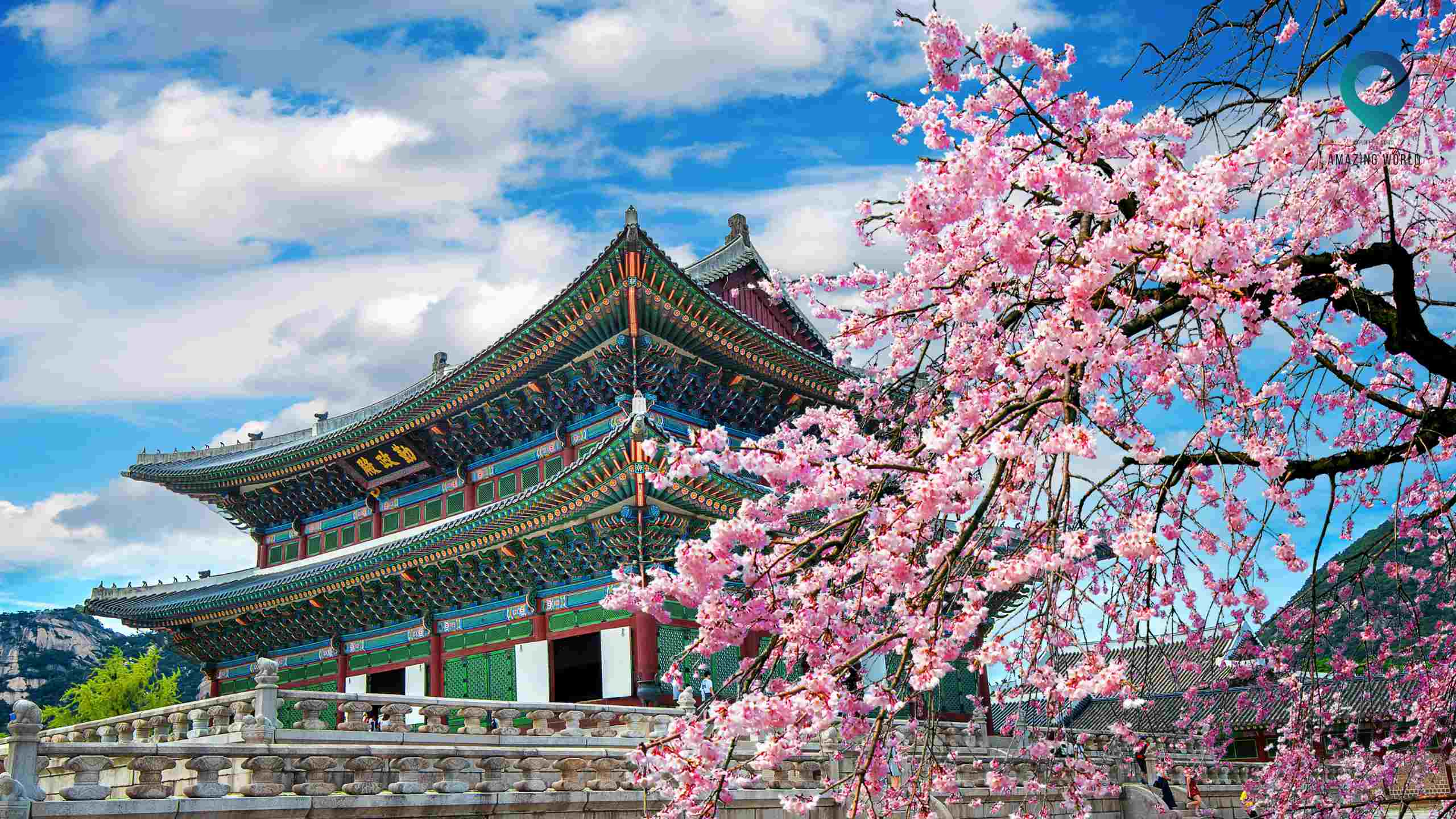
EPIC 7 Days Korea Travel itinerary for first-timers (2024)
- 9 minute read
- September 11, 2023
1-Week South Korea Travel Itinerary | Place to Explore, Safety Tips, Currency or Payment Types
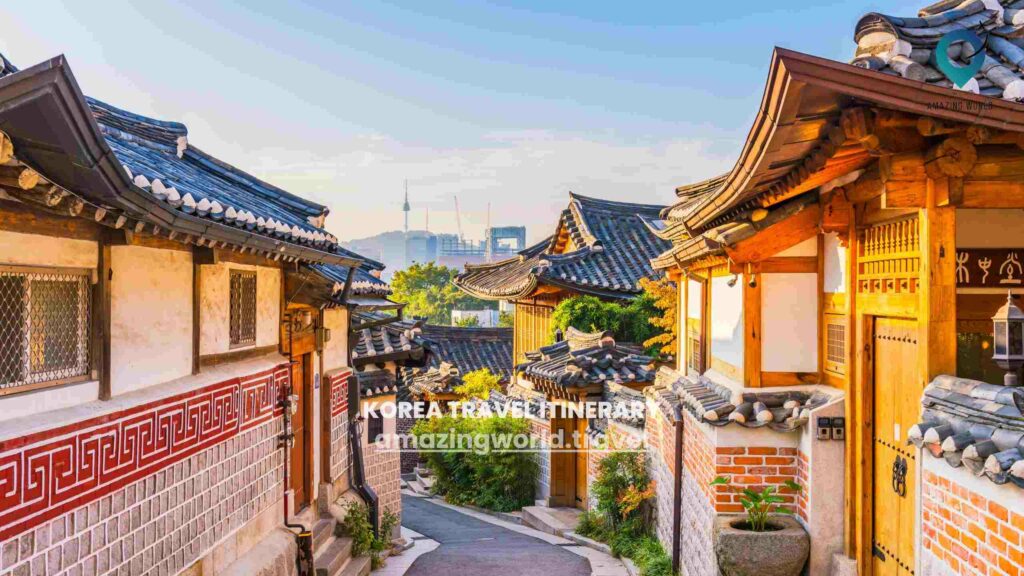
Are you planning a fantastic 1-week journey to South Korea? You’re in the right place! In this travel guide, we’ll help you map out an unforgettable trip to South Korea in just 7 days. We’ll provide you with a detailed itinerary, so you can explore the best of South Korea while staying within your budget and schedule. From exploring vibrant markets to enjoying delicious Korean cuisine, we’ve got your travel plans covered. So, let’s get started on your exciting adventure from India to South Korea!

Visa and Entry Requirements:
Check Visa Requirements: Determine whether you need a visa to enter South Korea. Visa requirements vary depending on your nationality and the purpose of your visit. Visit the official website of the South Korean embassy or consulate in your country to find out the specific requirements.
Prepare Required Documents: Gather the necessary documents for your visa application. Typical documents may include a valid passport, visa application form, passport-sized photos, proof of financial means, and a letter of invitation if applicable.
Submit Your Application: Submit your visa application to the nearest South Korean embassy or consulate in your country. Be sure to follow the specific instructions and pay the required visa fee.
Wait for Processing: Visa processing times can vary, so it’s essential to apply well in advance of your intended travel date. Check the processing times with the embassy or consulate.
Receive Your Visa: Once your visa is approved, you will receive it in your passport. Make sure to check the visa’s validity and any specific conditions.
Booking International Flights:
Research and Compare: Use online travel websites or consult with travel agencies to research and compare international flight options to Seoul. Consider factors like cost, airline preferences, travel dates, and layovers.
Book Your Flight: Once you’ve chosen your flight, book your tickets online through the airline’s website or a trusted online travel agency. Be sure to provide accurate passenger information and pay for your tickets using a secure payment method.
Check Passport Validity: Ensure that your passport is valid for at least six months beyond your planned departure date to avoid any issues with immigration.
Also, if you are looking best Fights at Discounted Rates we recommend booking your Fights with Singapore Airlines
Other Airports Serving Seoul:
Aside from Incheon International Airport (ICN) and Gimpo International Airport (GMP), there are also:
Gimhae International Airport (PUS): Located in Busan, South Korea’s second-largest city, this airport serves as an alternative international gateway to Seoul. You can reach Seoul from Gimhae Airport by taking a domestic flight to Gimpo Airport or using the KTX train service. Reaching Seoul by Flight:
Upon arriving at Incheon International Airport or Gimpo International Airport, you can reach Seoul’s city center by:
Airport Railroad Express (AREX): The AREX train connects both airports to Seoul Station, where you can transfer to the Seoul Metro or other transportation options to reach your hotel.
Airport Limousine Buses: These buses provide convenient transportation to various parts of Seoul, including major hotels and neighborhoods. They operate from both airports.
Transportation Services from the Airport to Hotels:
Taxi: Taxis are readily available at both Incheon and Gimpo airports. Ensure the taxi has a functioning meter, and you can communicate your hotel’s name and address to the driver in Korean or have it written in Korean script.
Airport Limousine Buses: Airport limousine buses operate routes to many hotels and neighborhoods in Seoul. You can purchase tickets at the airport and board the designated bus for your destination.
Private Airport Transfer: Some travelers prefer the convenience of pre-arranged private airport transfers. You can book these services in advance, and a driver will meet you at the airport and take you directly to your hotel.
Public Transportation: If you’re comfortable navigating public transportation, you can take the Seoul Metro or buses from the airport to your hotel or destination in the city.
Remember to check your specific airport and transportation options to your hotel before your trip, as details and services may change over time.
Also, if you are looking best hotels and Homestay deals then we recommend booking your hotels and homestay with priceline.com
Day 1: Arrival in Seoul, South Korea

Welcome to Seoul, the capital city of South Korea! Start your trip by checking into your hotel and taking some time to rest after your journey. In the morning, visit Gyeongbokgung Palace, the largest and most beautiful palace in Seoul, to immerse yourself in Korean history and culture. In the afternoon, explore the vibrant streets of Myeongdong, known for its shopping and street food. As the evening sets in, head to N Seoul Tower for breathtaking panoramic views of the city.
- Gyeongbokgung Palace : Check prices
- Myeongdong : Check prices
- N Seoul Tower : Check prices
Day-2: Seoul
Start your day by visiting Bukchon Hanok Village, a traditional Korean village with preserved hanok houses. In the afternoon, explore the lively district of Insadong, known for its art galleries, traditional tea houses, and souvenir shops. In the evening, enjoy a Han River cruise and admire the beautiful cityscape.
- Bukchon Hanok Village : Check prices
- Insadong : Check prices
- Han River Cruise : Check prices
Day 3: Busan
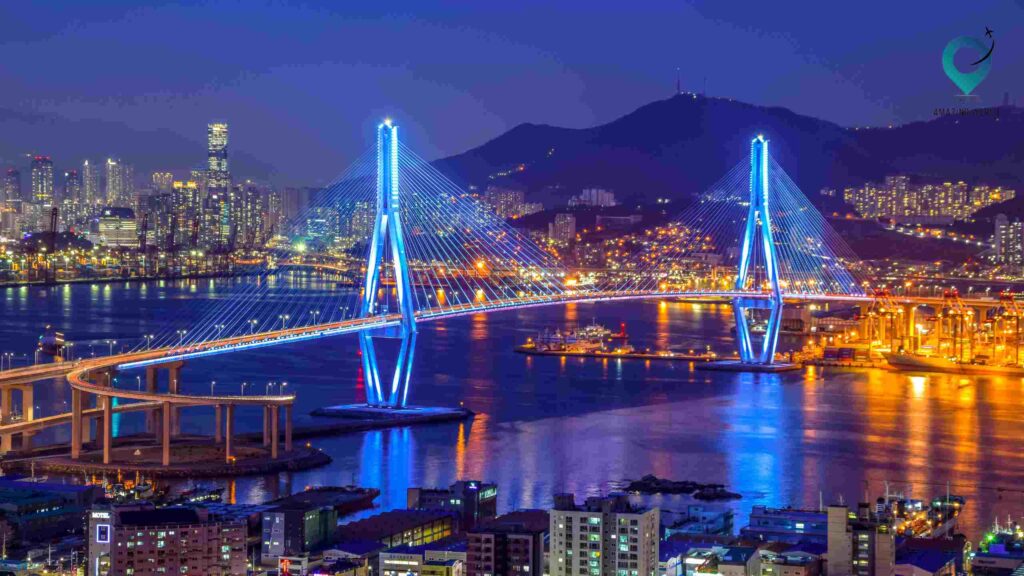
Take a day trip to Busan, South Korea’s second-largest city. Start your morning by visiting the iconic Gamcheon Culture Village, known for its colorful houses and art installations. In the afternoon, relax at Haeundae Beach and enjoy the vibrant beach atmosphere. In the evening, explore the bustling street of Gwangalli and enjoy dinner with a beautiful view of Gwangandaegyo Bridge.
- Gamcheon Culture Village : Check prices
- Haeundae Beach : Free
- Gwangall i: Free
Day-4: Seoul
Explore the modern side of Seoul by visiting COEX Mall, one of the largest underground shopping malls in Asia. In the afternoon, visit Lotte World, an indoor theme park with thrilling rides and entertainment for the whole family. In the evening, wander around the trendy district of Gangnam and enjoy some delicious Korean BBQ.
- COEX Mall: Free
- Lotte World: Check prices
- Gangnam: Free
Day-5: Jeju Island

Take a flight to Jeju Island, a beautiful volcanic island known for its stunning landscapes and natural wonders. Start your day by exploring Seongsan Ilchulbong, a UNESCO World Heritage site with a breathtaking crater. In the afternoon, visit Cheonjiyeon Waterfall and take a leisurely walk along the Olle Trails. In the evening, relax at one of Jeju’s beautiful beaches and enjoy the sunset.
- Seongsan Ilchulbong: Check prices
- Cheonjiyeon Waterfall: Free
- Jeju Beaches: Free
Day 6: Jeju Island
Continue exploring the wonders of Jeju Island by visiting the iconic Jeju Loveland, an outdoor sculpture park showcasing erotic art. In the afternoon, hike up Hallasan, South Korea’s highest mountain, for panoramic views of the island. In the evening, relax and unwind at one of Jeju’s famous hot springs.
- Jeju Loveland: Check prices
- Hallasan: Free
- Jeju Hot Springs: Check prices
Day 7: Departure from Seoul
Say goodbye to South Korea as you depart from Seoul. If time allows, explore the vibrant neighborhood of Hongdae, known for its street performances and nightlife, before heading to the airport.
- Hongdae : Free
Additional Mut Know Information

What To Pack + Weather
When traveling to South Korea in September, it is recommended to pack lightweight and breathable clothing as the average temperatures range from 17°C (63°F) to 25°C (77°F). However, it is important to note that South Korea experiences some rainfall during this season, so it is advisable to bring a lightweight raincoat or umbrella. It is also advisable to pack comfortable walking shoes as there will be a lot of exploring on foot.
Don’t forget to bring a power adapter for your electronic devices, as South Korea uses a 220V electricity system. Lastly, make sure to carry some Korean won for your daily expenses, as not all places accept credit cards. Enjoy your trip to South Korea!
Nearby Shopping
Transportation tips.
When traveling in South Korea, there are several transportation options to consider. In Seoul, the most convenient and efficient way to get around is by using the local public transportation system, which includes an extensive subway network and bus services.
Taxis and ride-sharing services such as Uber are also readily available and can be hailed from the streets or through mobile apps.
For day trips or exploring outside of the city, renting a car is a popular option, but make sure to have an international driving permit. It is recommended to plan your itinerary in advance and check the transportation routes and schedules to make the most of your time.
Safety Tips
- South Korea is generally a safe destination with a low crime rate.
- Take basic precautions and be aware of your surroundings.
- Keep an eye on your belongings, especially in crowded areas, to prevent pickpocketing.
- Respect local customs and etiquette, such as removing your shoes when entering homes or traditional Korean restaurants.
- Avoid discussions or activities that may be seen as disrespectful or offensive to local culture.
- Stick to well-lit and populated areas, especially at night.
- Avoid areas with a reputation for higher crime rates.
- Use licensed taxis and reputable transportation services.
- In areas like Itaewon and Hongdae known for nightlife, stay alert and cautious.
Overall, South Korea is safe, but being prepared and using common sense enhances your trip’s safety and enjoyment.
Travel Requirements
For traveling from India to South Korea, it is important to have a valid passport with at least six months of validity. Indian nationals are generally required to obtain a visa before entering South Korea. Visa applications can be submitted to the Embassy or Consulate of South Korea in India.
Additionally, it is advisable to check the travel advisories and entry restrictions for foreign visitors by contacting the Embassy or Consulate. Regarding vaccinations, it is recommended to consult a healthcare professional or a travel clinic for any specific requirements or recommendations for South Korea.
Cultural Norms + Etiquette
When visiting South Korea, it is important to be aware of and respectful of local customs and etiquette. South Koreans place a strong emphasis on politeness and respect, so it is customary to bow when greeting someone, especially when meeting someone older or of higher social status.
It is also important to remove your shoes when entering someone’s home or certain establishments, such as temples or traditional tea houses.
When dining, wait for the eldest person to start eating before beginning your meal, and use chopsticks instead of your hands. Tipping is not common in South Korea, as service charges are often included in the bill.
However, it is appreciated to leave a small token of appreciation, such as a small gift or a sincere thank-you. Overall, being respectful, polite, and mindful of local customs will make your visit to South Korea more enjoyable and memorable.
Some Local Daily Common Use Words
Health + medical facilities.
South Korea has a well-developed healthcare system with a wide range of medical facilities available. Hospitals in major cities like Seoul and Busan are generally of high quality and provide advanced medical treatments. Some recommended hospitals in Seoul include Asan Medical Center, Seoul National University Hospital, and Samsung Medical Center.
Pharmacies are easily found throughout the country, and they usually offer a variety of over-the-counter medications. It’s important to note that most pharmacies in South Korea close early, so it’s advisable to purchase any necessary medications during the day.
For travelers visiting South Korea, it is recommended to have travel insurance that covers medical expenses. This ensures that you are financially protected in case of any unforeseen medical emergencies or accidents during your trip.
Accepted Currency + Payment Types
Conclusion ..
crafting a memorable 1-week South Korea travel itinerary involves a blend of exciting places to explore, essential safety tips, and insights into currency and payment types. By following this guide, you’re not only well-prepared to navigate the wonders of South Korea but also ensure a safe and convenient journey. So, pack your bags, embrace the adventure, and let the beauty of South Korea unfold on your 7-day expedition.
How much did you like Our detailed EPIC 7 Days Korea Travel itinerary for first-timers (2023) ? Review Also, please share these Blogs with your friends on social media.
Related Article –
- Road Trips Ideas | 12 Tips to Prepare Your Car for a Long Road Trip?
- 150 Best Places to Visit in the United States In 2023
- Road Trip With Kids
- How to Stay Awake While Driving Long Distances
- Audiobooks to Listen to On Your Road Trip
- How to Create an Epic Itinerary Road Trip
- Best Rental Cars For Travel Adventures

Meet David Hoper, a passionate travel Blog writer with 7+ years of experience in travel content. Through his exemplary storytelling and engaging narratives, he shares his experiences and brings destinations to life. With a keen eye for detail and a love for exploration, he has cultivated a diverse portfolio of travel blogs that inspire and inform readers worldwide.
In this article:

Post written by: David Hoper
Leave a reply.
Your email address will not be published. Required fields are marked *
Save my name, email, and website in this browser for the next time I comment.
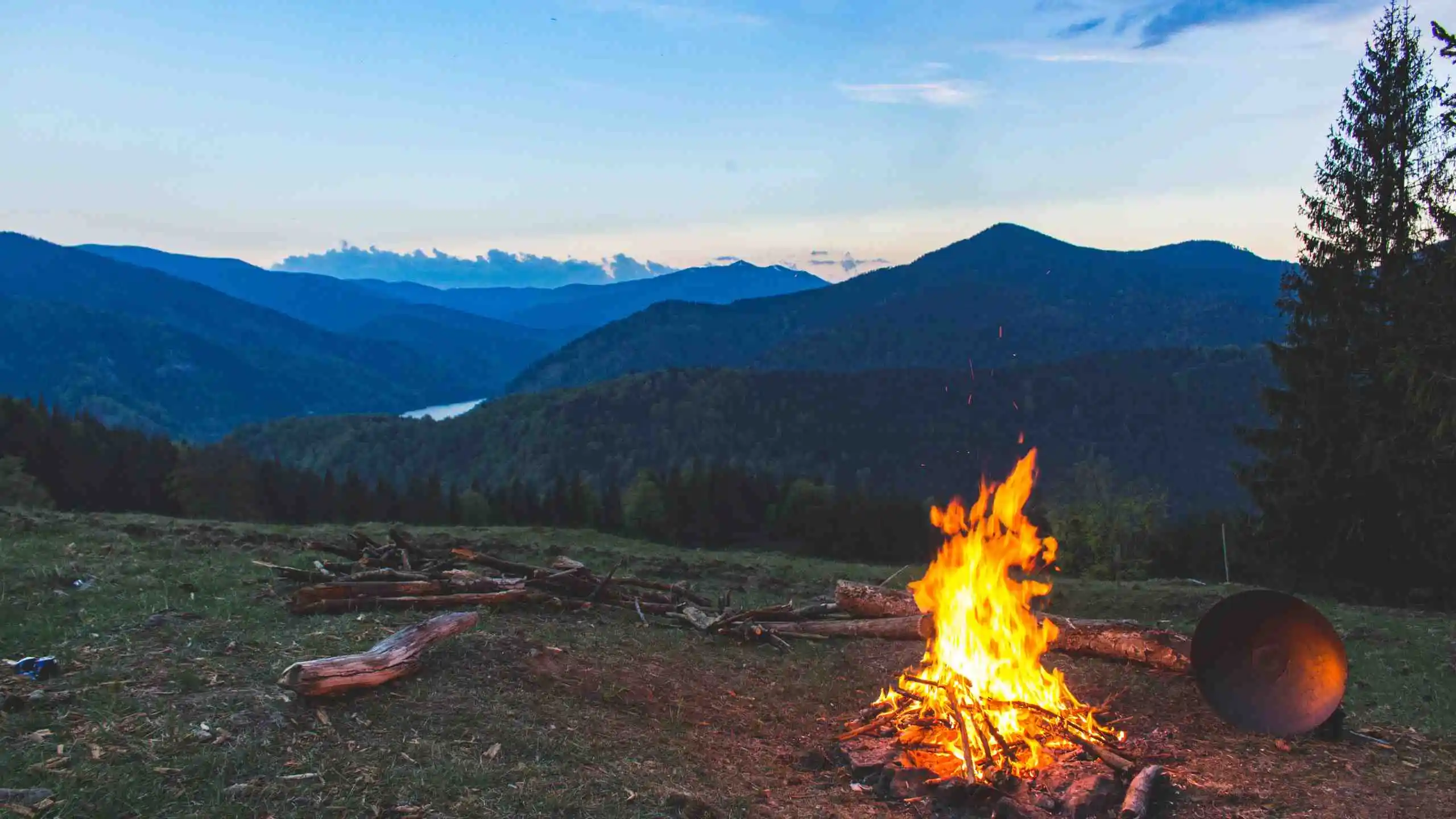
Camping Camping vs Glamping: Which is Best for You?

- September 12, 2023
Camping Luxury Glamping 101: Your Ultimate Guide to Luxurious Outdoor Adventures
You may also like.
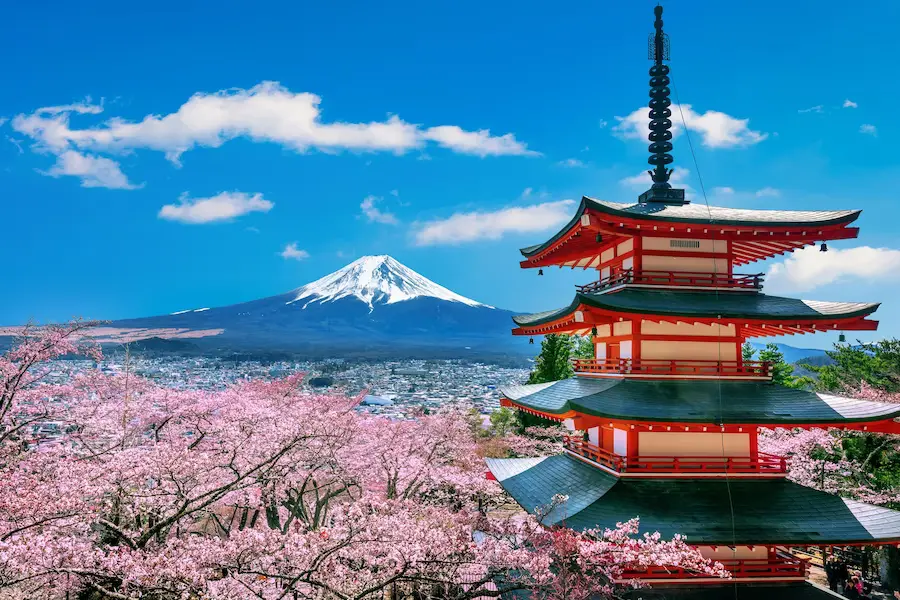
The best 5-day Japan itinerary suggestions for first-timers

Pattaya Itinerary: Best Places to Visit in Pattaya
- 2 minute read

Uncover the Southwest Road Trip Itinerary: A 7-Day Epic Road Trip itinerary
- 12 minute read

7 Day Phuket Itinerary (2024) | The Best Things to Do in 7 days in Phuket
- 6 minute read

Explore Morocco: A 7-Day Family Travel Itinerary (Updated 2024)
- 5 minute read
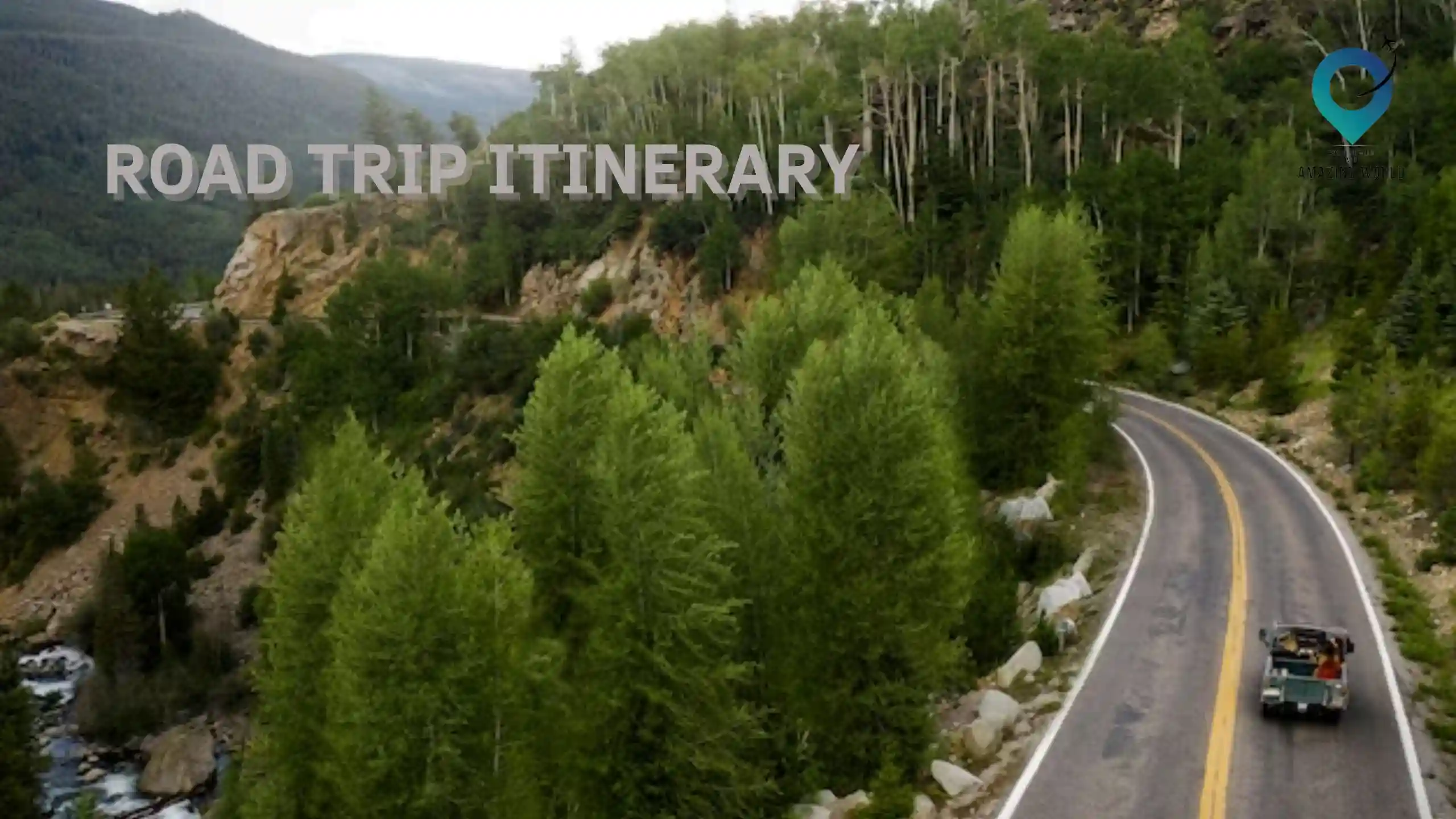
7-Day Road Trip from Delhi to Manali | Full Itinerary
- 7 minute read
Our Latest Instagram Posts
@amazingworld.travel8.
- Skip to main content
- Skip to primary sidebar

Follow Me On

South Korea Itinerary: 2 Weeks Or Less (From A Local)
Updated: Apr 5, 2024 by Max · This post may contain affiliate links · 50 Comments
This two weeks in South Korea itinerary is based on my three years living in Korea, discovering the country's beautiful places and the people who live there. Since I left, I've also been back to visit several times, most recently last year.
So while I could write a South Korea 10 day itinerary or 14 day itinerary centered only on Seoul and Busan , maybe even Jeju , I'm not going to do that. This country deserves so much more attention to detail, and so do you. So this guide actually covers five different cities in Korea to check out on your visit.
Even though there's no such thing as the perfect itinerary for Korea, the country is small enough that two weeks is enough time to adjust to the culture change and still have time to enjoy most everything. But if you only have 10 days in Korea (or even fewer), then I highly suggest you start in Seoul for 4 days, at least.
Starting with 4 days in Seoul, you can see the basics for tourists & build out your itinerary from there, as I mention in the South Korea sample itinerary section. So let's get to planning!
Buy a PDF Version of This Post!
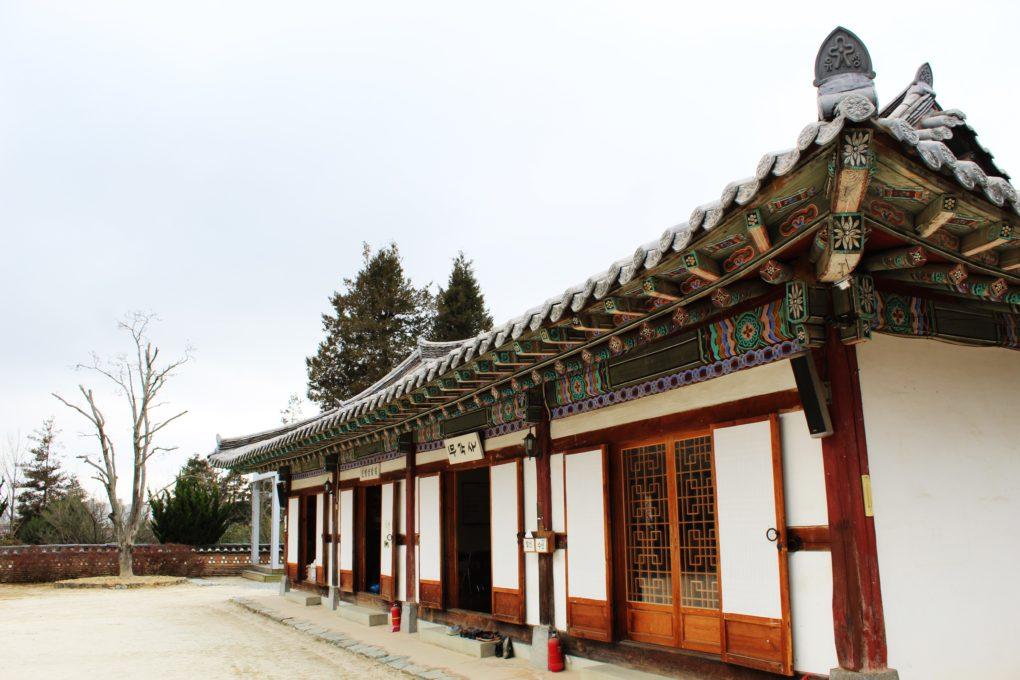
- 🇰🇷 Planning Vacations in South Korea
- 🛫 Basics of Korea Travel
- 🙋 South Korea Travel FAQ
- 🗺️ South Korea Trip Itinerary Examples
- 🚕 Where To Visit In South Korea
- 🧳 Budget For A Trip To South Korea
- 🚈 South Korea Travel Tips
- ☺️ Basic Phrases For Your Trip to Korea
🇰🇷 Planning Vacations in South Korea
Those of you looking to visit South Korea are probably as confused by all the changes as I was before I visited again post-covid. But as of March 20th, 2024, masks are still required in medical settings like hospitals but are NO LONGER REQUIRED in all other indoor public places, including public transport.
Here are what document you need to visit Korea as a tourist:
- K-ETA ( Korean Electronic Travel Authorization , applied for at least 72 hours before departure) OR Visa to visit Korea (countries which previously had a visa exemption now need to apply for a K-ETA). From April 1, 2023 to December 31, 2024, passport holders from 22 countries will also temporarily NOT need a K-ETA or visa to visit Korea (includes: Australia, Austria, Belgium, Canada, Denmark, Finland, France, Germany, Hong Kong, Italy, Japan, Macao, Netherlands, New Zealand, Norway, Poland, Singapore, Spain, Sweden, Taiwan, UK, US (including Guam)). If you're a valid ABTC card holder (APEC card), you are not required to apply for a K-ETA [excluding Americans & Canadians].
- Q-Code (can also be filled out upon arrival) : visitors need to fill out information for the Korean quarantine system, known as Q-Code . Note that all travelers are now allowed in regardless of vaccination status, but you do need to have filled out your Q-Code before going through immigration.
If for some reason you need to take a covid test in a South Korea airport, the cost of a covid test in Incheon Airport is currently ₩80,000 ($60USD), with some options within Seoul as inexpensive as ₩65,000 ($50USD). There's no testing requirement to leave South Korea.

🛫 Basics of Korea Travel
In Korea we use the Korean won (KRW), written as ₩ or 원 in Korean. ₩1000 is roughly equal to $0.75USD or ₱43. The won used in South Korea is different from the won used in North Korea.
This depends on your style of travel, but a mid-range budget for a solo traveler spending 10 days in South Korea would be about $65USD per day. If you're willing to stay in cheap hostels, stick to more free activities in Seoul, and eat local foods, then you could get it down to maybe $40USD per day. So I'd say that traveling Korea is really quite affordable, though you can always upgrade your trip, and the longer you stay the cheaper it will be per dium.
As you might expect, Korean people speak the Korean language , but many people in more urban areas also speak decent English, especially younger people. But the written language of Korea is called hangeul , and it's similar in number to the roman alphabet, but the appearance and pronunciation is different. You will not be able to read Korean unless you study some beforehand (if you're interested, I recommend Talk To Me In Korean ).
The internet is generally great in Korea. You can find free public wifi in basically every major point of transit, tourism, and general town hub (even in my little countryside area). But if you want to be connected constantly, you can rent a wifi egg as soon as you land at the airport, or buy a pre-paid sim card for trips longer than a week (I recommend KT/Olleh sims; it's what I've used all three years here).
South and North Korea are technically still at war. That said, there is no sense that this is a country at war, as the last few decades have been relatively quiet on that front. In fact, Korea and Japan are two of the safest places I've ever been; the biggest peril I've ever felt is from potential alcohol poisoning (the drinking culture here is insane; the local liquor of soju is the most popular beverage in the world ). I'd feel comfortable telling anyone they could walk around here at night, though unfortunately women should be extra vigilant with their drinking.
I agree with the general consensus that May, September, and October are the nicest months of the year, weather wise. They have nice sunshine, beautiful foliage, and outside of major holidays, they're light on domestic tourism. But if you want to find the shoulder season, come in April or June. They're either a bit colder or warmer than you might like, but the kids are still in school and the pollution will be less heavy than it would be in May or October. However, winter is food festival season in Korea, with coffee festivals and chocolate festivals happening across the country.
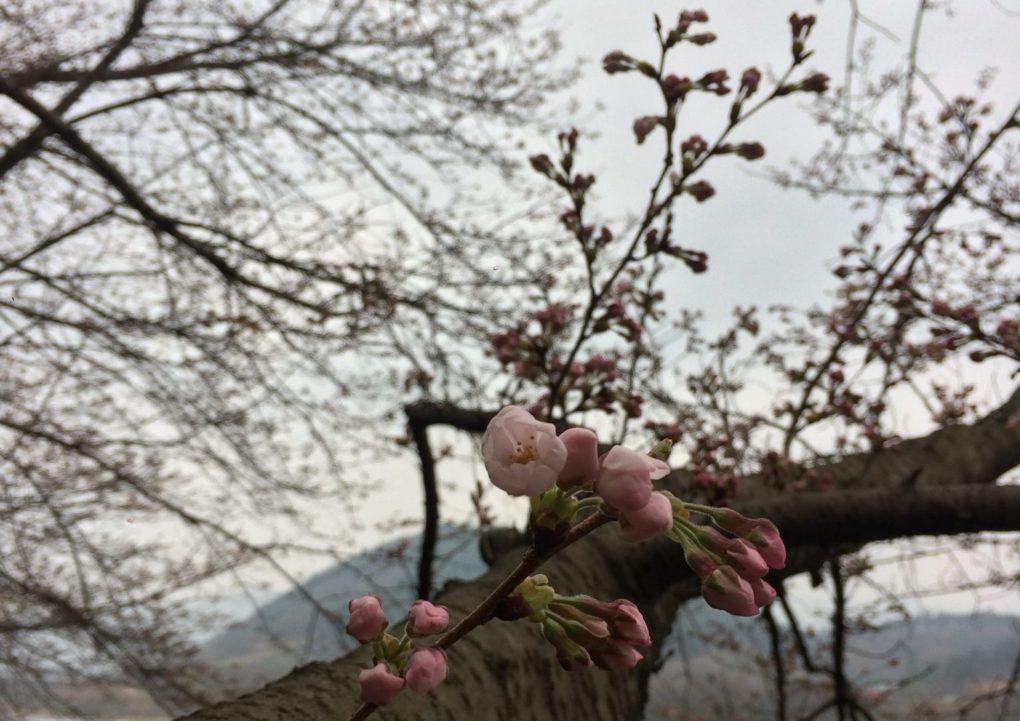
🙋 South Korea Travel FAQ
I've included a FAQ section including the most common questions I've been asked in the last 3 years, by friends, family, and complete strangers. Hopefully this answers the majority of your questions!
What should I wear in Korea during winter, spring, summer, and fall?
From mid-November to mid-March, it could definitely snow and you'll want a heavy winter jacket and some heat-retaining leggings for under your pants. From mid-March through early May & early October through mid-November, there's still the possibility of chilly nights. So bring pants and a jacket for the nights, and t-shirts for the days.
Pack more conservative tops to take to Korea, as showing your collarbones can be cause for staring, especially in smaller towns. Respect is very important in Korea. Early May through early October is a toss-up between extremely hot and warm with a breeze, but it will definitely be humid.
What do I need to bring to Korea?
Other than the basics you'd always pack for yourself, remember to bring higher-cut shirts, as Koreans are more conservative in their dress than most westerners. Women should be sure to bring tampons and pads, as there was recently an issue with domestic pads & tampons are extremely hard to come by.
Many readers have told me that purchasing a sim card and attraction pass (like the Discover Seoul Pass ) helped them make the most of shorter visits, and those are simple things to arrange in advance and take to Korea.
Do I need a visa to visit Korea?
While there are still 112 countries whose citizens don't need to apply for visas before visiting Korea for 30 to 90 days, as of September 2021, ALL visitors from those approved countries still need to have an approved K-ETA before arriving in Korea, even if you just have a long layover in Incheon .
K-ETA stands for Korea-Electronic Travel Authorization. You can check if yours is one of those visa-exempt, countries and how long your visa lasts for, here . Common countries: USA (up to 90 days), Canada (up to 6 months), South Africa (up to 30 days), Malaysia (up to 90 days), Singapore (up to 90 days).
But remember, even if you don't need to apply for a visa, from now on you do still need to apply for a K-ETA , which is good for two years form the date of approval. If you already need to apply for a visa, you do not need to apply for a K-ETA .
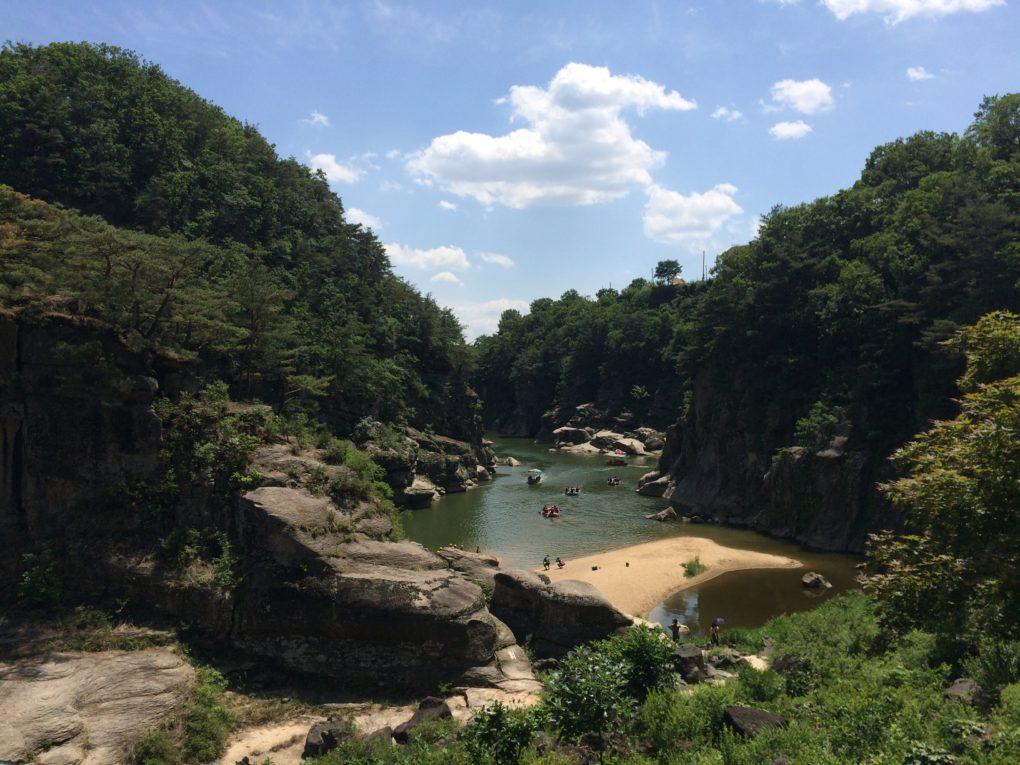
How can I get to & around Korea?
Since South Korea is on a peninsula off the southern coast of China, you have to fly in. Note that if you have a layover at Gimpo Airport for some reason, the airport closes each night from 12am-4:30am. Theoretically you could also arrive by boat from China or Japan, but that truly sounds awful to me.
As for actually getting around Korea, that's a much easier question. Getting between the cities is best done by bus, or train if it's a very popular route. Some people prefer to fly between Seoul, Busan, and Jeju, though you can also go via bus & boat.
Within the major cities, buses and metro and taxi are all reliable and safe forms of transport (just make sure your taxi uses their meter). In smaller areas, buses and the occasional taxi are the way to go; taxis are very affordable in South Korea.
How many days in South Korea is enough?
I think two weeks in Korea is ideal for getting a taste of the coast, the nature, and the overall urban lifestyle. But if you have less time on you vacation in South Korea, you can get a condensed version of all of that with just 5 days in Seoul (yes, even the beaches!).
If you have fewer than 5 days, I really do think it will be tough to get a good sense of the culture and people and cuisine.
Which apps should I download before visiting Korea?
My most used apps have been: Kakao Talk (like Korean WhatsApp), Naver Maps (Google Maps is trash here, so you'll want to download this local equivalent), Google Translate (the speaking function is a lifesaver; just remember town download Korean offline), and a Seoul Subway App (mine is in Korean, but there are plenty out there in English).
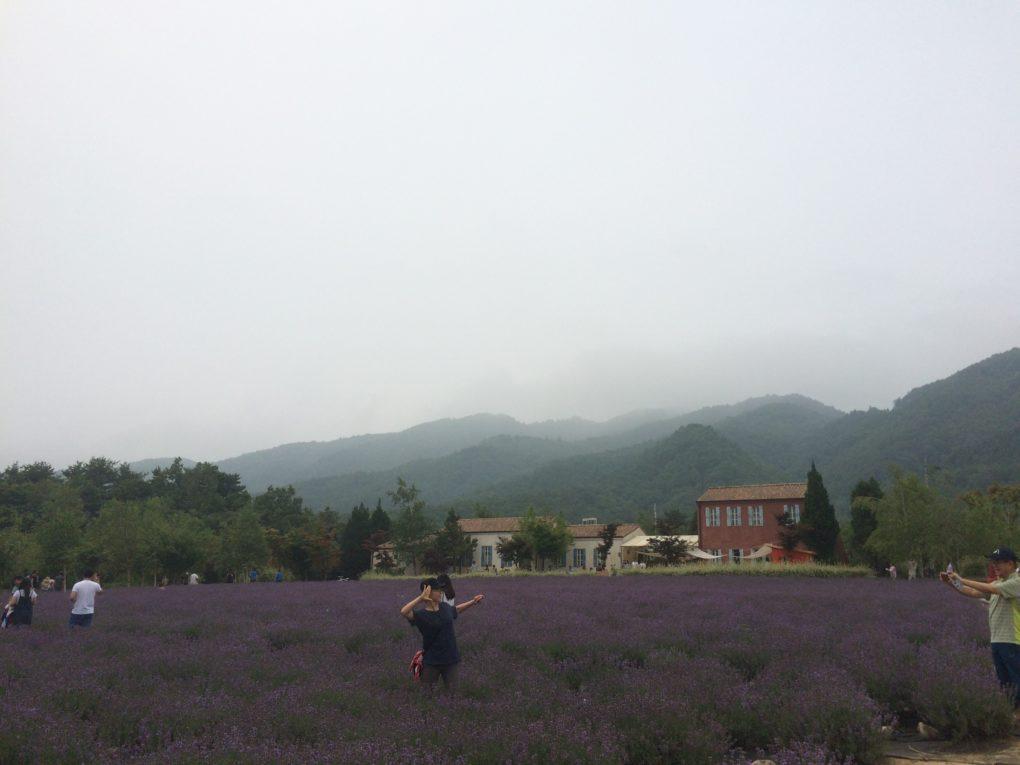
🗺️ South Korea Trip Itinerary Examples
The whole idea of this guide it to give you an idea of where to visit in Korea and how long you want to spend there. Tourism is on the rise in Korea, and having a unique experience is becoming more important than ever for visitors.
So in true DIY spirit, here are some route examples for a 2 weeks in Korea itinerary or less, for each of the following lengths.
South Korea Itinerary 14 Days
- Seoul (Days 1-4)
- Jeju (Days 5-7)
- Busan (Days 8-9)
- Suncheon area (Days 10-12)
- Jeonju (Days 13-14)
See below for more information on each city.
South Korea Itinerary 10 Days
- Suncheon area (Days 8-10)
Click to check current hotel prices in Korea.

South Korea Itinerary 7 Days
- Suncheon area (Days 5-7)
South Korea Itinerary 5 Days
- Seoul (Days 1-3)
- Jeonju (Days 4-5)
South Korea Itinerary 3 Days
Seoul. Just spend 2 days exploring all you can in Seoul, and then spend your middle day doing a day trip from the city, maybe to nearby Chuncheon .

🚕 Where To Visit In South Korea
Seoul : the capitol city, the darling of K-Pop fans, and one of the most populous cities in the world. Seoul is not for the faint of heart, but for those who can handle serious crowds, Seoul can be most anything you want it to be.
Almost everyone planning South Korea vacations will end up either starting or ending here, and they're lucky to do so. It's a great base from which to travel the rest of the country, or even spend a week or so experiencing all of the different neighborhoods & their vibes.
Seoul is great for culture, food, nightlife, and just about anything else you want in a trip to Korea, except for peace and quiet.
Busan : possibly best known outside of Korea for the movie Train To Busan , this port city is thought of domestically as the seafood and cinema capitol of the country.
Even though it's incredibly urban in its own right, people also think of it as more laid back, with beach vibes and ocean views for days. Busan is perfect for seafood lovers looking to spend time at the beach and indulge in some cinematic activity.
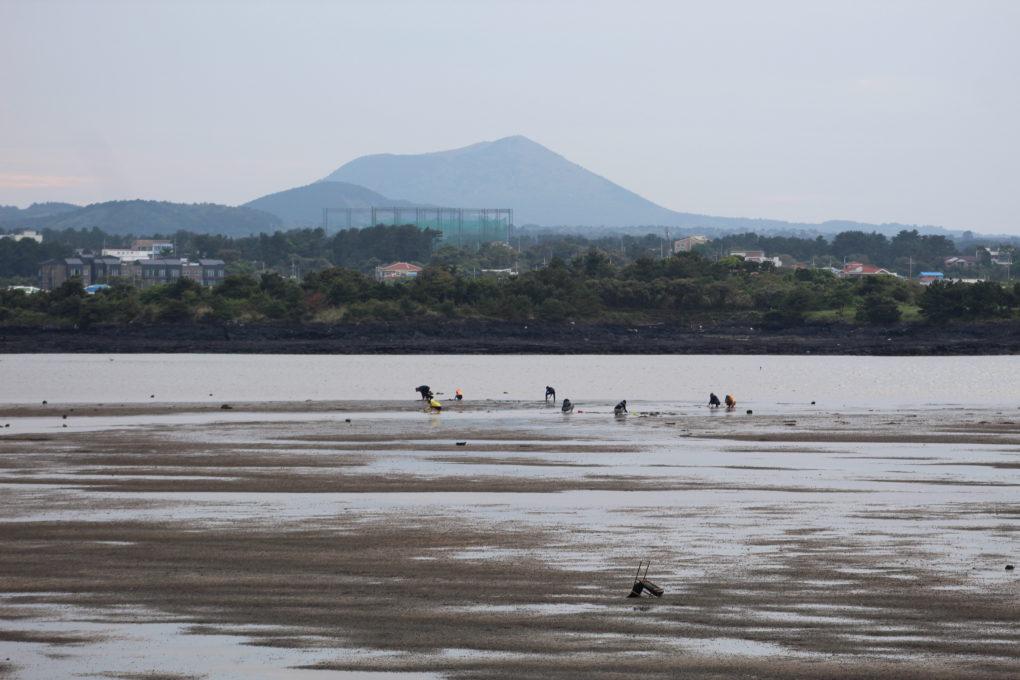
Jeju : the Hawaii of Korea, as it's often called, Jeju is known for its beaches and seafood and nature. The entire island comes from a single volcanic explosion thousands of years ago, and you can actually see the peak of that volcano from any point on the island.
Jeju is ideal for those looking to get a taste of Korean culture and cuisine, but with much more tranquility and beach vibes than you'd find anywhere on the mainland.
Jeonju : this lesser-known Korean destination is where Koreans go when they want to experience the "olden times" of Korea. Jeonju is one of the oldest cities in Korea , famous for its spicy bibimbap, traditional hanok houses, and many unique festivals.
Come to Jeonju if you want to soak in a whole city happily dedicated to maintaining traditional Korean culture, one bowl of spicy bibimbap at a time.
Suncheon : truly off-the-beaten path, Suncheon is a gorgeous region full of flowers, agriculture, and stunning natural landscapes. Domestic tourists most often visit in the springtime to see the green tea fields & cherry blossoms, but Suncheon is also a great base from which to explore a few nearby cities.
Visit Suncheon if you want to see a less-touristed side of Korea's natural beauty, with an emphasis on local agriculture.

✈ Seoul
What seoul is known for.
Seoul has everything you could want in a destination. It's one of the biggest cities in the world, and despite being the center of international cultures in Korea, it's still very much culturally Korean. It's for this reason that I think Seoul is the perfect place to put at the beginning of your Korea itinerary.
You'll probably arrive here, anyway, since Incheon Airport is one of Asia's biggest transport hubs. Many people even plan a Seoul itinerary for 10 days for a taste of the Korean dishes which have become so popular around the world.
Others come for the world-class shopping and cosmetics selection, or even for medical tourism . But I think that the most worthy reasons to write Seoul into your Korean itinerary are the natural beauty , historic temples , and little cultural quirks which all add up to an ambiance that's purely Korean.
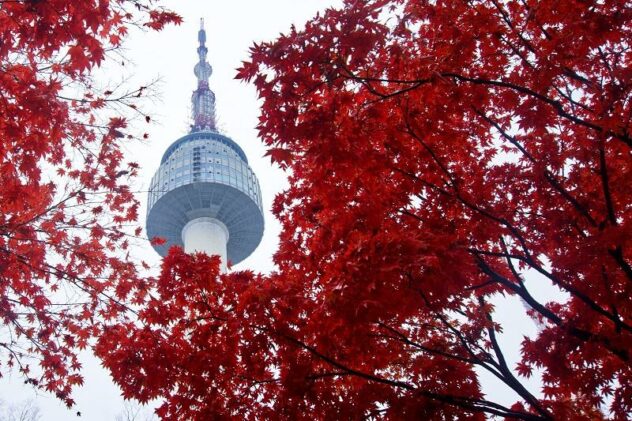
What To See In Seoul
I won't list out everything you can do or see in Seoul, since that could fill a whole book (and probably has). But here are 7 things you can't miss seeing in Seoul , since 7 is a lucky number here. Click here for more ideas of what to do in Seoul, with entrance fees, Korean translations, and hours .
Go to the spa. The spa, or sauna, is an important pastime for Koreans of all ages, and it's most common to go on the weekends as a family. A Korean sauna, however, is divided by gender and has you completely naked.
While you could visit a sauna in most any city in Korea, Seoul is going to have the most options for different types of baths and treatments, and it's going to be the most foreigner-friendly. I highly recommend Itaewon Land Spa.
Walk to Namsan Tower. This landmark is rather characteristic of Itaewon and the whole HBC area, located in central Seoul and considered the international hub of the city. Namsan Tower is set in a very green park, and right around the tower itself is a temple and a gate with “love locks” attached to it, but the Tower is best known for having an amazing view of the city.
It’s a bit of a walk from Itaewon’s downtown area, but there’s a bus if you get tired, and a cable car to take you to the top. I think the view is just as good from the cafe right before the top floor, so I wouldn't recommend paying for the cable car.
Visit Gyungbokgung , one of the 5 royal palaces in Seoul. Of the 5, Gyeongbokgung is the most accessible by public transportation, located just outside of a subway stop. I also think it’s the most beautiful, but I’ve had the chance to visit in both fall and spring.
Those are the seasons when the colors of the palace grounds come to life; in summer and winter it's a bit less colorful. The grounds of Gyeongbongung are large, but you could spend anywhere from twenty minutes to two hours exploring each corner of the grounds.
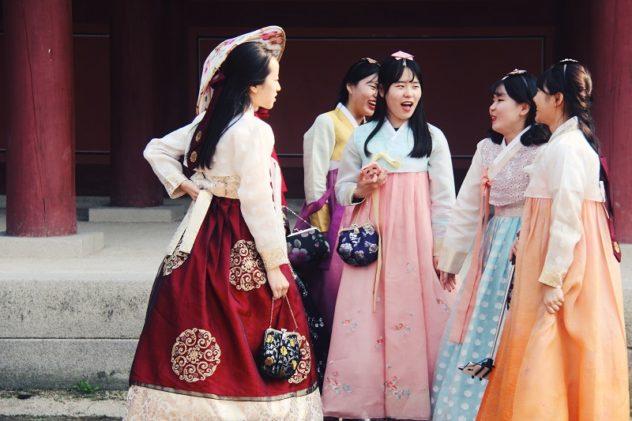
Sing in a Noraebang . Literally translated as "song room," noraebang are the quintessential nighttime activity of the Korean public. In English we usually know then by the Japanese name karaoke .
From middle school onward, on any given night you can find a noraebang full of Korean students hanging out with friends, or adults drinking with co-workers or family. In Seoul it's easy to find either coin noraebang, in which you pay per song, or regular noraebang, in which you rent a room by the hour & buy snacks .
Hike Bukhansan. Just a half hour north of Seoul is one of Korea’s many national parks. Hiking is a national pastime, so every day of the week you’ll see groups of older people geared up for a trip up Bukhansan. On the weekends there are visitors of all ages, usually ending their hikes with a picnic and drinks at whichever peak they decide to stop on.
Explore Gana Art Center . Gana is known across Seoul for its beautiful think pieces. Amidst all the traditional Korean food and aesthetics of northern Seoul, walking around Gana Art Center gives you a different perspective on the current events in Korea.
Luckily, you don’t have to speak any Korean to get the gist of real art, though it may be helpful to know some about Korean culture in order to get the full impact. The permanent exhibits are free, but you may have to pay to enter the special exhibits.
Wander Bukchon Hanok Village . A hanok is a traditional Korean house, a small building with a thatched roofs and beautiful painted walls & roof. In the spring and fall the foliage creates a stunning backdrop for photos, so that’s the perfect time to enjoy the village in traditional garb.
Note that Bukchon Hanok Village doesn’t actually close, but between the hours of 11pm and 5am there’s nothing going on.
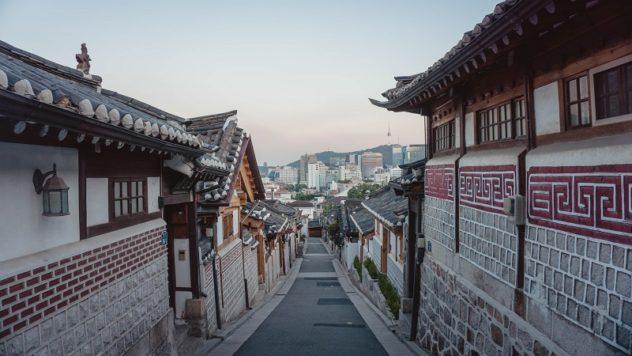
What To Eat In Seoul
In case you only have a few days in Seoul, this is where you'll get to sample a range of uniquely Korean foods. And hopefully also visit some of Seoul's dozens of delicious chocolate shops . So while you're in Seoul, be sure to look out for these top 5 Korean foods, particular to the country, but not to any specific region.
Japchae (잡채). A noodle dish containing thinly chopped vegetables, sweet potato starch noodles, and sometimes a little bit of meat. It’s great served warm as a main dish, but it’s often served as a side dish, tossed in sesame oil and soy sauce.
Hoddeok (호떡). This cinnamon sugar-filled fried rice cake is my absolute favorite treat. It's one of the few traditional sweets in Korea, but it's most easily found in the colder months, from October to April (I'd recommend you get it in the neighborhood of Insadong).
Samgyupsal (삼겹살). This is Korean pork belly, the most popular meat of choice in the country. It's just one of many types of meat you can have for Korean barbecue , which is basically a particularly communal style of cooking meat in the center of a table. If this is your only trip to Korea, you need to try this before you go!
Mul Nangmyeon (물냉면) . Translated as "water cold noodles," this chilled dish is made with buckwheat flour, and served with sliced cucumber & half a boiled egg on top. The dish is made with a meat broth and most commonly eaten right after barbecue, preferably with meat hot off the grill.
Samgyetang (삼계탕) . Quite possibly my favorite Korean meal, samgyetang is basically Korean chicken soup. The main part of the dish, thought be very healthy, is a whole chicken stuffed with rice and a bit of ginseng, jujubes, & ginko beans. You eat these with the side dishes and the meat & soup, after you dip it in the salt they serve on the side.

Where To Stay In Seoul
There are hundreds of lovely guesthouses and hotels throughout Seoul, and there are equally as many crappy ones. Most egregiously, some of them are both expensive and crappy. So here's my selection for the three best places to stay in Seoul . Each spot is centrally located, high quality, and foreigner-friendly. These are listed in order from least expensive to most expensive.
Budget: G Guesthouse
There's a reason this is always the recommended guesthouse in Itaewon. Not only does it always come in under budget, but the facilities are clean, the staff is helpful but unobtrusive, and the beds are comfortable. They even provide towels, a luxury not as common as you'd like.
Although you can't control what other guests do or what time they come back, my friends & I have always found that G provides a quieter environment for late-night entries than the other hostels in the area. Pro tip: the kebab place just down the street has the best kebabs in Seoul hands-down.
Mid-Range: Solaria Nishitetsu Seoul
Voted a traveler’s favorite in 2017, Solaria Nishitetsu is part of a Japanese hotel chain which combines comfort & convenience at a reasonable price. Guests love the huge rooms and large, firm beds, a real find in the heart of Myeongdong.
Because of its popular with business travelers, there are lots of harder-to-find amenities for digital nomads and other business people on-the-go, like work spaces and less-expensive single rooms.
Luxury: Signiel Seoul
Located in the top floors of Lotte Tower, Signiel is truly in a league of its own. Its sauna, gym, and pool facilities are world-class, with a staff and suites to match. Each room has a spa-style bathroom and a cozy place to rest your head, in addition to their unparalleled views of the city.
There are even free drinks and appetizers for guests in the hotel lounge, at all times of day. The Signiel is truly the place to get pampered, perfect for those looking for a honeymoon hotel .
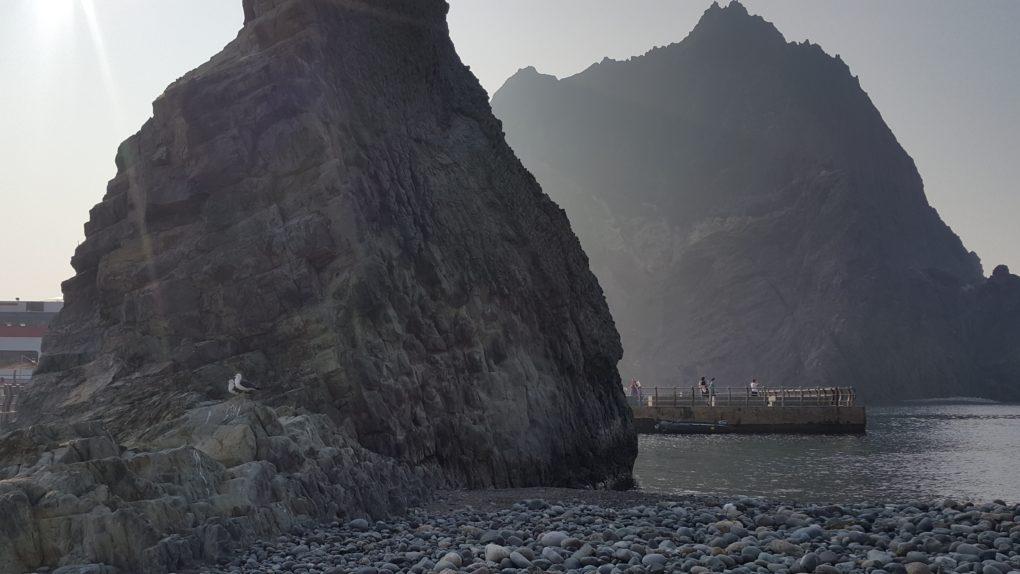
✈ Busan
What busan is known for.
Even though it's the second-largest city in Korea, and a metropolis in its own right, Busan doesn't get a lot of love from tourists. Most people think of it as a smaller version of Seoul, with a lot of the same cultural attractions but just harder to get to.
They have a point; Busan and Seoul are both massive port cities with cosmopolitan & hipster neighborhoods, alike. However, I'd argue that the feel of a place and its unique natural landscape plays a big role in your experience there.
In that regard, Seoul and Busan are more comparable to LA and San Diego. Seoul has glitz & glamour and a little of everything, while Busan has a more relaxed ocean-side vibe with lots of fresh seafood & quick flights to neighboring Japan .
As one of Korea's most popular weekend destinations, 3 days in Busan is plenty to see the city's highlights and get a feel for the ancient seaside temples , the beaches , and the local importance of cinema .
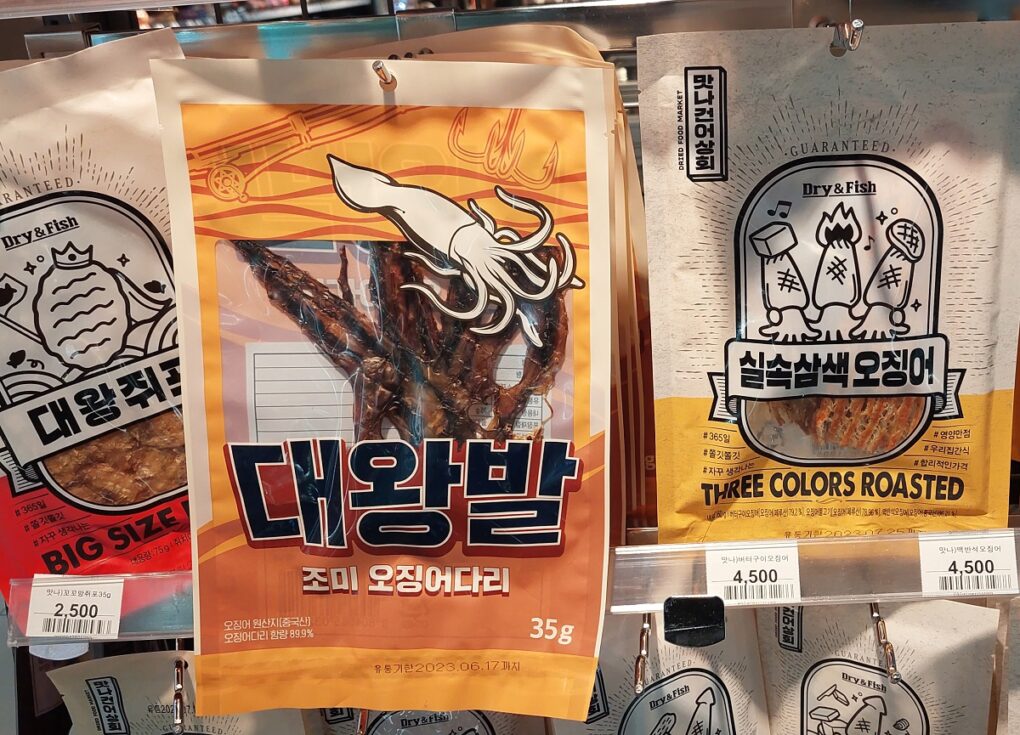
What To See In Busan
I won't write up everything you can do or see in Busan, since that'd take hours for you to pour through. So here are 7 things you can't miss seeing or doing in Busan (since 7 is a lucky number). Click here for more ideas of what to do in Busan, with entrance fees, Korean translations, and hours .
Lounge on Haeundae Beach. Undoubtedly the most popular beach in Korea, Haeundae is always packed in the summer, especially with families. But public schools don’t actually let out until mid-July, so if you time your visit well, you may just have a patch of sand to yourself. Note that beaches are only open for swimming from June to August.
Skip down Cheongsapo Daritdol Skywalk. This unique attraction has become quite popular over the last few years. It's basically a see-through bridge out over the ocean, perfect for showing off the ocean without you having to get in it. There’s also an observatory in the area, one of just 3 in the city. The skywalk is located a short walk from Haeundae Beach.
Explore Busan Cinema Center. As home to the Busan International Film Festival, which is held each fall, this is a great introduction to the film culture for which Busan is famous within Korea. The center has 3 buildings containing theatres of varying sizes, each offering daily tours & lectures. There are restaurants and cafes on-site.
Have a photoshoot in Gamcheon Culture Village. Probably the most popular photo backdrop in all of Busan, "GMC" has become known as a sort of Korean Cinque Terre . The calming blue houses look right out over the ocean, and are actually still people’s homes.
You'll see many an older person drying their laundry on their balconies and chatting on rooftops on sunny afternoons, so remember to stay respectful of the residents.
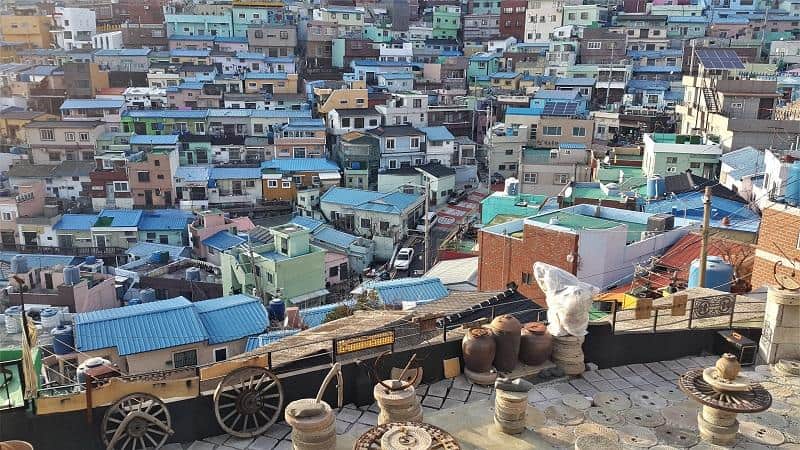
Have a meal at Jagalchi Market. This is the largest open-air seafood market in Korea, often compared to Noryangjin Market in Seoul. It’s actually become so famous that each October the city holds the Jagalchi Cultural Tourism Festival.
But even if you can’t make it on time for the festival, seafood lovers will have a blast walking through the market and exploring the diverse sea life found in Busan’s waters. The entire first floor is a wet market, while restaurants and the like are found on floors 2-7.
Wander the grounds of Taejongdae. Of all the things to do in Busan, this is by far one of my favorites. Equal parts resort & park, Taejongdae has become famous for its beautiful views and colorful tourist train.
The area's temples are accessible within an hour's walk, but even right around the entrance you can hike down and reach the shore in less than 10 minutes. Basically no matter where you go on the grounds, you’ll find a great view. Note that while it’s free to enter the grounds, this is likely to take up half of your day since it's so far south of downtown.
Watch sunrise at Haedong Yonggungsa Temple. In case you don't have the time to spare for a visit to Taejongdae, this is your alternative glimpse at Korea's ancient seaside temples. Most of Korea's temples are in the mountains, offering tranquility and spectacular views of life below.
But Haedong offers a broader view of the life going on below, focusing on the deep blue sea rather than countryside valleys. Some people come here to watch the sunrise, which is a spectacular choice considering it's on the east coast & opens at 5am!
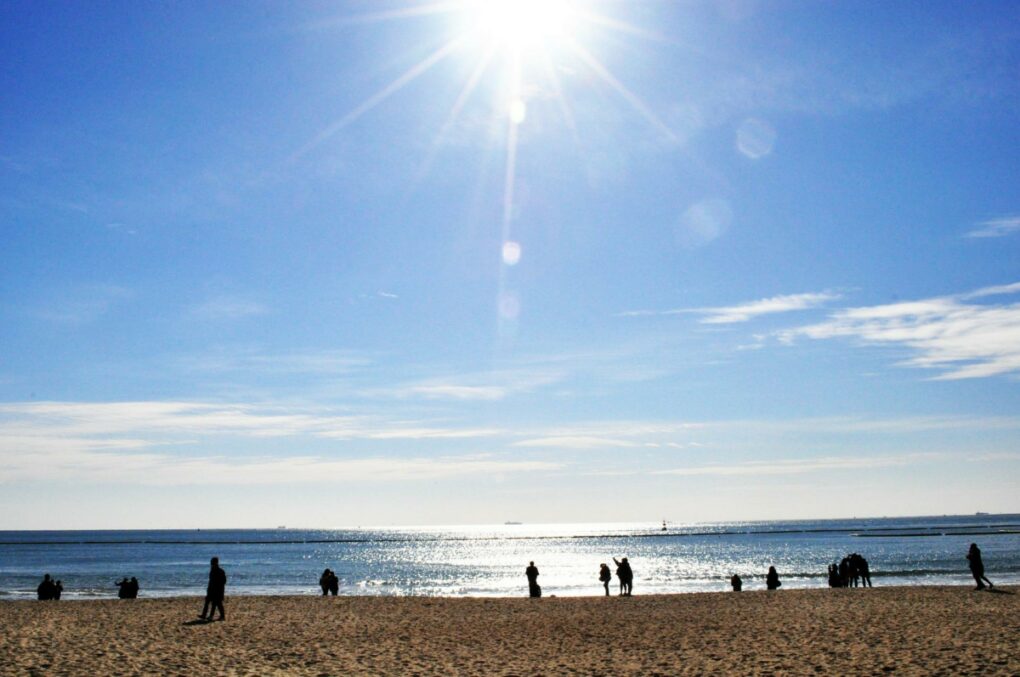
What To Eat In Busan
Busan is not a city for vegetarians or non-adventurous eaters, unless you're looking for chocolate in Busan , that is. The region's most famous foods are definitely of the sea variety, and thus, so are most of these 5 foods you should try in Busan. I have included a couple of land-based options for those who aren't into eau de ocean , however.
Sannakji : likely one of the most famous Korean foods, sannakji is often translated as “live baby octopus.” Cut & served immediately after being pulled from the water, sannakji are squirted with sesame oil & acidic fruit juices, making the tentacles continue to move around for minutes after death.
Haemul Pajeon : this is a seafood pancake, basically, but a Korean version (made with rice flour). They usually include tiny octopus, and are especially popular as a drinking snack, though many people come to Busan’s fish markets to enjoy them with family and friends.
Busan Jokbal : I don’t think I’ve ever met a Korean who didn’t like this dish. The jokbal , or pig’s feet, are cooked in a sweet cinnamon & honey mixture which reminds me of spiral-cut ham on Christmas. They're then served cut-up and ready for eating; the meat is fatty and rich, so don’t knock it ’til you try it.
Dwaeji Gukbap : this is a very hearty pork-based stew, prepared by slowly boiling pork bone into a broth & adding tender little pork bits. It’s served with rice and side dishes; you plop the rice into the stew and then eat it with side dishes of your choosing. It’s popular year-round, but is a must-try in winter.
Mulhoe : hoe literally means raw seafood, while mul means water. Mulhoe is therefore a raw fish soup, served cold & spicy with a variety of noodles and veggies. I'd only recommend it if you're eating somewhere right off the coast, like in Busan's Jagalchi market.
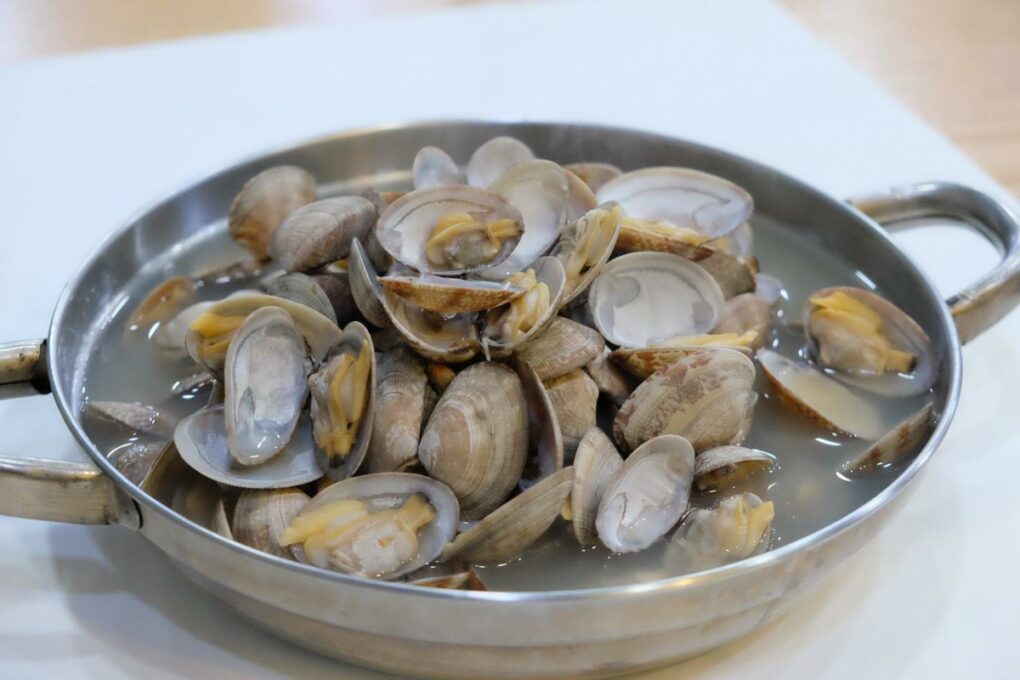
Where To Stay In Busan
Domestically, Busan is just as much of a tourist destination as Seoul is, since most of the people who travel around regularly are actually coming from Seoul. So Busan has hundreds of quality guesthouses, and probably an equal number of not-so-great ones.
So here's my selection for the 3 best places to stay in Busan , because there's no reason to suffer through a crappy, expensive hotel. Each of these spots is centrally located, high quality, and foreigner-friendly. These are listed in order from least expensive to most expensive.
Budget: The Bay Guesthouse
The Bay has become my go-to guesthouse in the warmer months, just 3 minutes from the beach & 2 minutes from the metro. It’s centrally located, the beds are large & comfortable, and the style is as a cross between a capsule hotel and a more typical hostel.
Every morning the manager even cooks breakfast for the guests, and there’s coffee brewed in the dining room.
Mid-Range: Stanford Inn Busan
Stanford Inn is a relatively new addition to Busan's "affordable luxury" lineup. But in the few years since it's opened its doors, guests have been very impressed with the high quality of the rooms & breakfast buffet.
Port-side suites garner the most praise, with guests impressed by the view and the proximity to the metro, just a few blocks in either direction.
Luxury: Lotte Hotel
Though best known internationally for department stores & perishables, domestically Lotte is known for offering a variety of luxury experiences; this includes their chain of hotels. Each suite in Lotte Hotel offers big fluffy beds and a spacious bathroom, as well as a bevy of modern furnishings.
Lotte Hotel is especially popular with families, thanks their reputable spa & restaurant facilities.
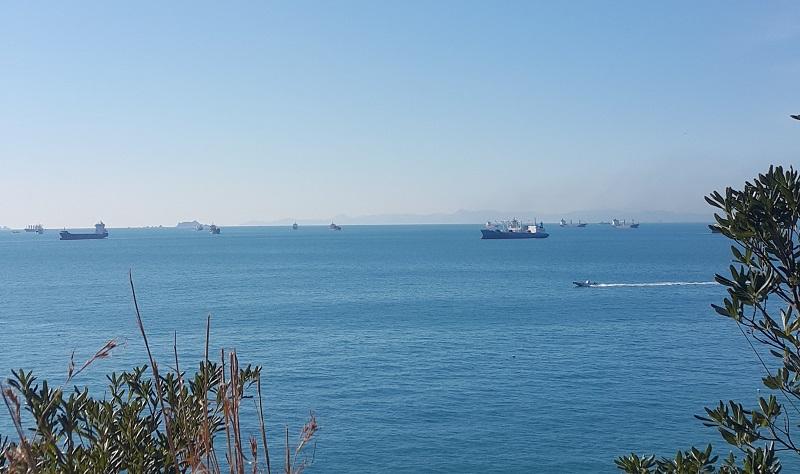
✈ Jeju
What jeju is known for.
A few days after one of my trips to Jeju, a Korean friend told me he was jealous that I went without him, because Jeju is his "stereotype of a beautiful place." Well to be honest, it's mine, too. Jeju is breathtaking in the spring & fall, and somehow a haven from the mainland's overwhelming weather in winter & summer.
The route from Seoul's Gimpo Airport to Jeju is actually the most traveled route in the world . That's how much Koreans love visiting this idyllic little island off their southern coast. But tourists? Not so much. Every time I visit Jeju, mine is one of the very few foreign faces I see.
But Jeju Island has so much to offer, from gorgeous hikes to unique local foods , that there's no reason it shouldn't be on every South Korea travel itinerary. Jeju is the place for you if you love exploring natural beauty , learning about sea life , and relaxing seaside .
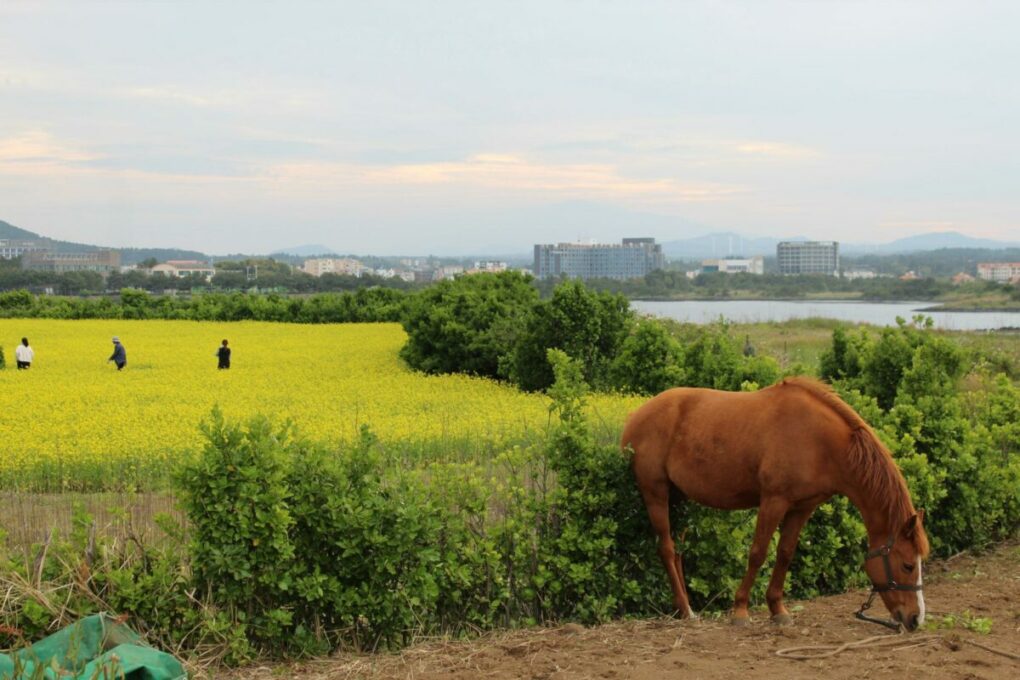
What To See On Jeju
There is such an incredible number of things to do on Jeju, in every season, that you could spend hours researching. But to give you an idea of some of the many things you can do across the island, here are 7 things you should do or see on Jeju Island. Click here for more ideas of what to do on Jeju, with entrance fees, Korean translations, and hours .
Pose in Love Land (erotic museum). This is often one of the most unexpected sites to find in Korea: a park full of penises & other various erotic sculptures. The park was opened in 2004 by a group of art students from Seoul’s prestigious Hongik University, and since then the park has been a surprising success, where selfies abound. Note that you must be at least 18 to enter the park .
Watch sunrise at the top of Seongsan Ilchulbong. Is this in Korea or the Highlands of Ireland? The immensity of the green and the brightly colored flowers that greet you in the spring could very well distract you from ever climbing to the top of Seongsan.
From the hike to the viewpoint, horseback riding, and boating, you could easily spend half a day here. If you’re lucky, this is also where you’ll catch site of some of Jeju’s famous women divers, though you may see some on the walk over.
Hike around Seopjikoji. Just across from Seongsan Ilchulbong is Seopjikoji, an area famous for being the filming location for several dramas, and just a stunning place in general. The stairs built into & walking trails leading along the cliffs can get a bit crowded on weekends in the summer.
But if you get too hot, there's also a sea side restaurant at the top of the climb. Seopjikoji's most gorgeous scenes are in the spring, when the hills are vibrant green and dotted with bright yellow canola flowers.

Stare in awe at Jeongbang Waterfall. Jeongbang’s claim to fame is that it's the only waterfall in Asia to fall directly into the ocean. It's honestly a cool sight to see, basically from the parking lot, making it my pick for the best waterfall in Jeju.
There’s even a tiny beach in front of it, just before the vast ocean extending way beyond. The shops just along the parking lot will also be selling souvenirs, oranges, and Jeju chocolates.
Walk the Jusangjeolli Lava Cliffs. Often compared to Giant’s Causeway in Northern Island, Jusangjeolli is another act of nature bestowed upon Jeju by the volcano from which it was forged. Less than 5 minutes from the parking lot, the cliffs are deep grey rectangular formations jutting out into the ocean.
It almost looks as if they were formed by a child slowly stacking blocks. They’re quite the popular photo spot, and certainly worth a stop, though lines for selfies can get long on weekends.
Bathe in Sanbangsan Carbonate Springs. This will be one of the strangest experiences of your life, if you’ve never been to a Korean sauna. Everybody here is separated by gender, and then strips themselves buck naked. It takes some getting used to, but when you do, it’s glorious. These hot springs are divided by each temperature and healing properties, making for a very soothing way to spend an evening.
Sip on a cup of tea at O’Sulloc Tea Fields & Museum. The museum is tiny, but if you came to the fields for the tea products, then this is your spot. The aforementioned museum is attached to a massive cafe serving up a variety of teas from their farm, plus coffee and desserts .
The entire complex is located next to a cosmetics shop & a second cafe. But the best part for most people will be the tea plantation itself, situated across the street from the museum, and laid out with pictures in mind.
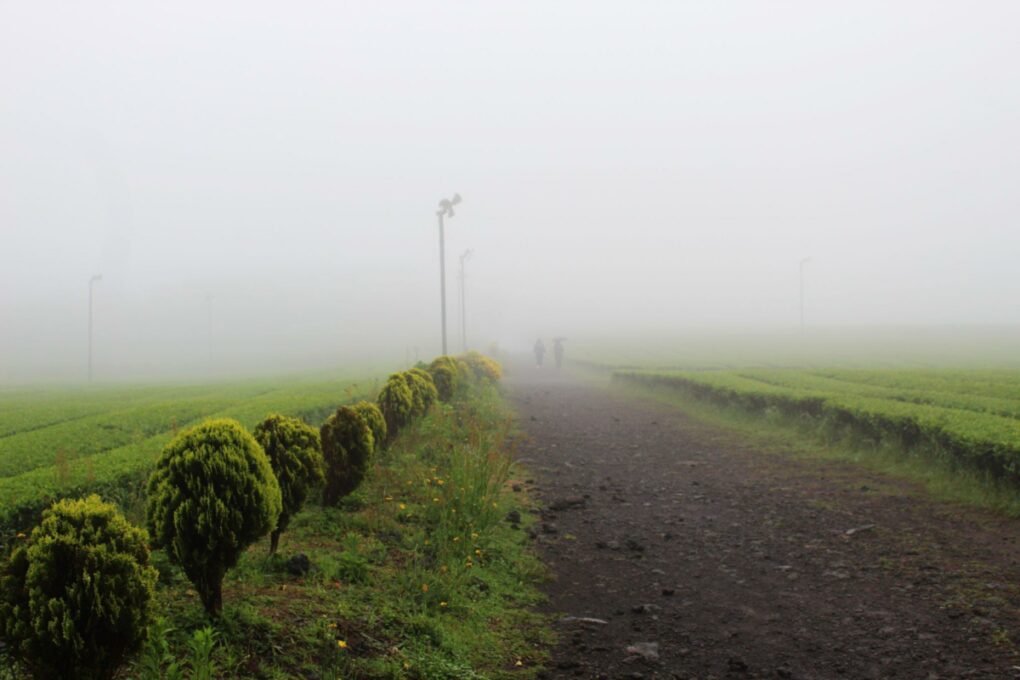
What To Eat In Jeju
Like all other provinces and cities in Korea, Jeju has a few foods it's famous for, but unlike most of those other regions, Jeju is famous for them because they're actually grown there. A few of these products have turned into a whole range of foods, all focused on that one crop. Take a look.
Abalone (Sea Snails). I know the translation doesn't sound very appetizing, but abalone are actually shellfish, more like oysters than snails (but don’t go looking for any pearls). They’re one of the many sea foods caught by the women divers of Jeju, and are caught & served fresh daily. Local favorites are abalone rice porridge and grilled abalone.
Black Pork. This is meat from a specific type of pig raised mainly on Jeju Island , and I find it to be a softer & more flavorful version of the meat found on the mainland. If you’re looking for easy pickings of a variety of black pork restaurants, check out Black Pork Street in Jeju City.
Hallabong (those big oranges grown throughout the island). The season for hallabong is actually winter time, but some of the groves manage to grow oranges year round. So you’ll see these thick-skinned beauties for sale in boxes along the side of the road, and at gift shops in most of the major tourists sites. Keep an eye out specifically for hallabong tea.
Green Tea Anything . Home to the well-known O’Sulloc tea fields, you’ll see green tea-flavored things for sale throughout Jeju. But nowhere is there a higher concentration of tea-flavored items than at the O’Sulloc tea museum, itself, which is profiled above.
Peanut Ice Cream. Depending on where you get it from, the cream flavor can be more or less intense, and the ice crystals can be very strong. But peanuts are actually grown on Udo, an island off the coast of Jeju, making it a truly local food. Though honestly, most people just buy it for the cute pictures.
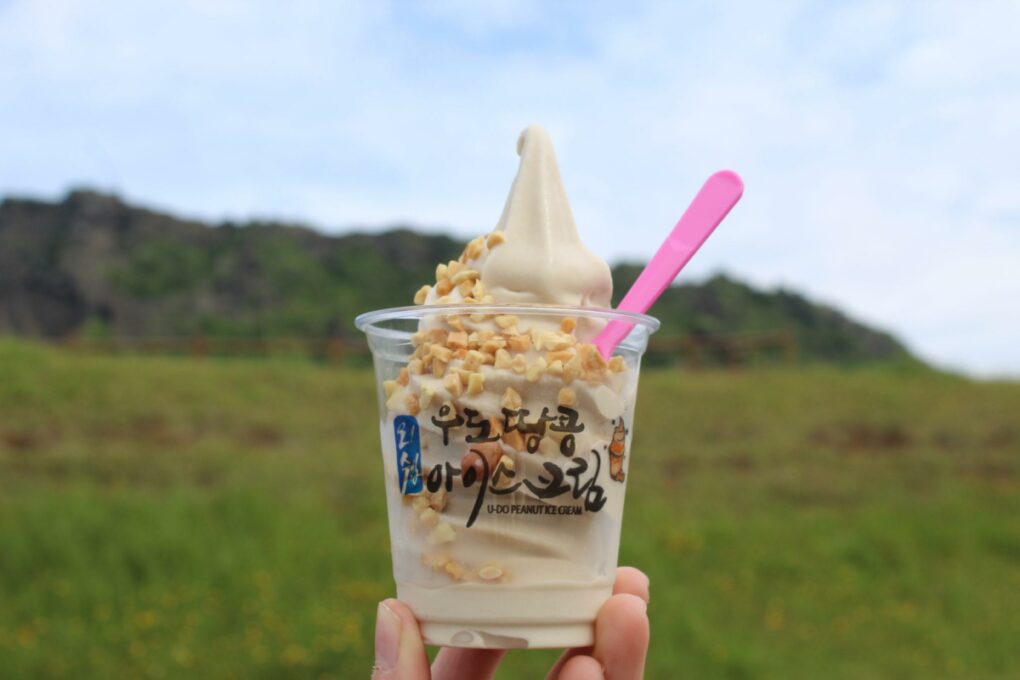
Where To Stay On Jeju
Since so much of the Island's economy depends upon tourism, you'll have your pickings of Jeju accommodation, especially in Jeju City and the southern city of Seogwipo. But there are some hidden gems, so allow me to shine light on 3 of the best places to stay on Jeju . Each spot is centrally located, high quality, and foreigner-friendly. These are listed in order from least expensive to most expensive.
Budget: Yeha Guesthouse
Seoul is famous for their inexpensive accommodation, but Jeju City really puts up a fight. Yeha is the best choice for backpacking or budget-minded visitors, with a solid 9/10 rating for their dorm beds, and a good connection to island's public transporation.
To top it all off, they’ll happily store your luggage for you if you want to explore a bit before your flight back.
Mid-Range: Color In Jeju
If you’re looking to stay on the eastern coast and want to splurge a bit, Color In is the move. They’ve got immaculate rooms, a small outdoor pool, and the rugged surroundings typical outside of the big cities. Front desk hours are limited, but that’s easily overlooked once you get to the pool.
With just 6 guest rooms in the entire place, odds are good that yours will be poolside.
Luxury: Kensington Hotel Jeju
One of the highest-rated hotels in Jeju, the Kensington contains all the opulence one expects from a 5-star hotel, infinity pool included. If the layers of indoor & outdoor pools isn’t enough, however, consider the superb staff and various on-site restaurants; their breakfast buffet is included in your stay.
Within walking distance of the hotel are a botanical garden and the teddy bear museum.
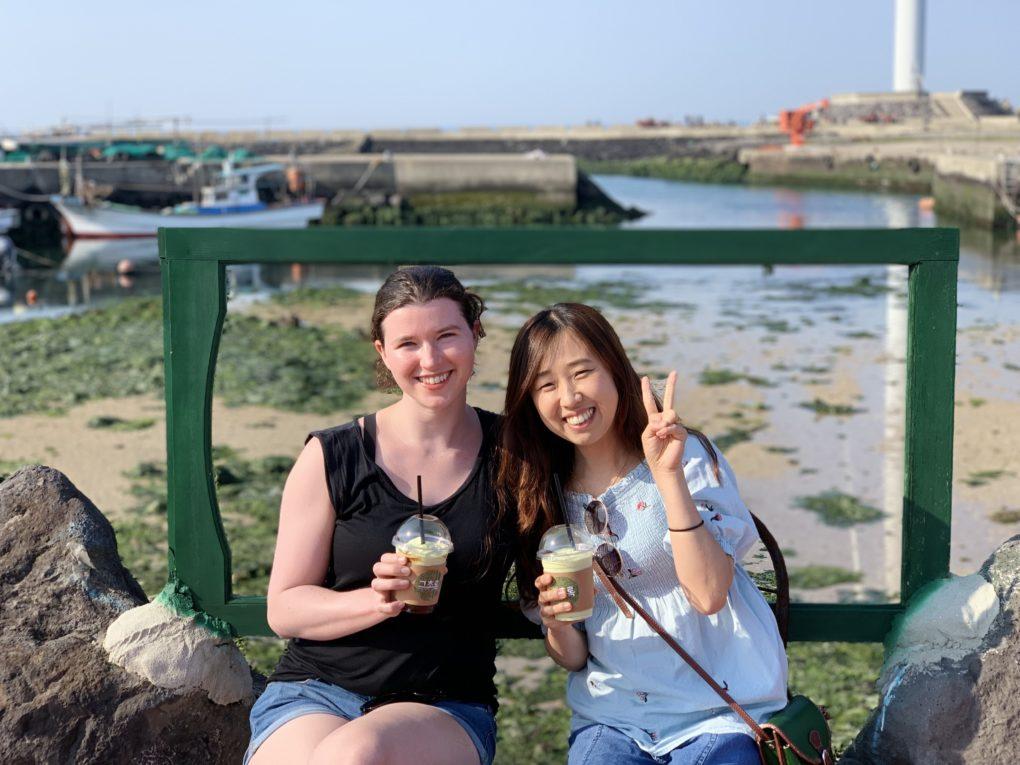
✈ Suncheon
What suncheon is known for.
Of all the cities in this Korea itinerary, Suncheon is probably the least famous internationally. The city has just a few hundred thousand residents, quite small by Korean standards, but each spring the county is flooded with domestic tourists chasing beautiful flowers and stunning natural landscapes .
But despite its size, I'd recommend Suncheon because of its great potential as a base from which to explore the rest of southern Korea. Just south of Suncheon are Boseong, where most of the country's green tea is grown, and Yeosu, a beautiful island with lots of attractions in its own right.
Northeast of Suncheon is Gurye, whose spring flower festival & fall cherry festival are famously striking. Simply put, people visit Suncheon in order to revel in the beauty of nature , get away from the big cities , and enjoy the festival culture of small Korean communities.
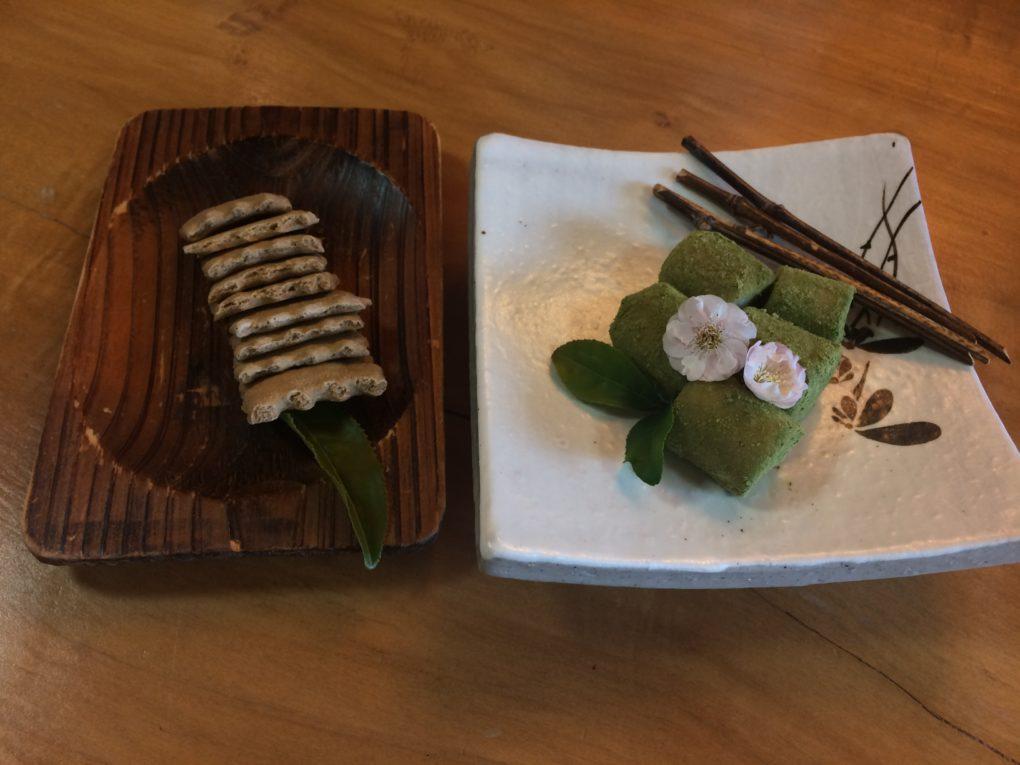
What To See Around Suncheon
As just one of four great cities to explore in southern Korea, it's difficult to distill Suncheon attractions into one post. But in order to lend an idea of some of the things you can do around Suncheon, here are 7 things you should do or see near Suncheon City.
Learn hands-on at Naganeupseong Folk Village. With remaining residents numbering in the hundreds, calling this a village is a bit of a stretch. But Naganeupseong is more like a demonstrative village, offering visitors performances and traditional experiences you couldn't find even in Seoul.
Each region of Korea has their own unique traditions that they've chosen to keep alive and highlight here. This means that for as vast & varied as Seoul is, you won't find as many ways to experience southern Korean culture up there.
This is honestly in large part because most Seoulites see Korea's southernmost areas as countryside and backwards and unworthy of a visit. However, I think that each is gorgeous (including my own countryside town), and this one in particular is worth a trip.
Hike the Suncheon Bay Wetlands. Small crabs reach up at you from the mud, wheat whispers in the wind, and old people are probably yelling from just behind you. So go the wetlands. Starting from the parking lot and continuing on through the carefully-curated gardens, you'll reach the wetlands themselves.
From there you can cross the gardens via a long bridge. On the other side is a small mountain, which you can take about half an hour to hike up, or you could stop and turn around where you are, admiring the other side of the wetlands' natural beauty.
Picnic at Suncheon Bay National Gardens. When I think of gardens, I think of somewhere well-kept and brightly-colored, maintained within a specific small area. Suncheon's National Gardens are a vast and impressive version of that, including not just flowers but also sculptures, a bridge covered in hangeul , and a variety of cafes & eateries on site .
In peak bloom season, from around mid-March to mid-May, you could easily spend a whole day walking across the ponds and admiring the colorful fauna, wondering why you didn't come here sooner.
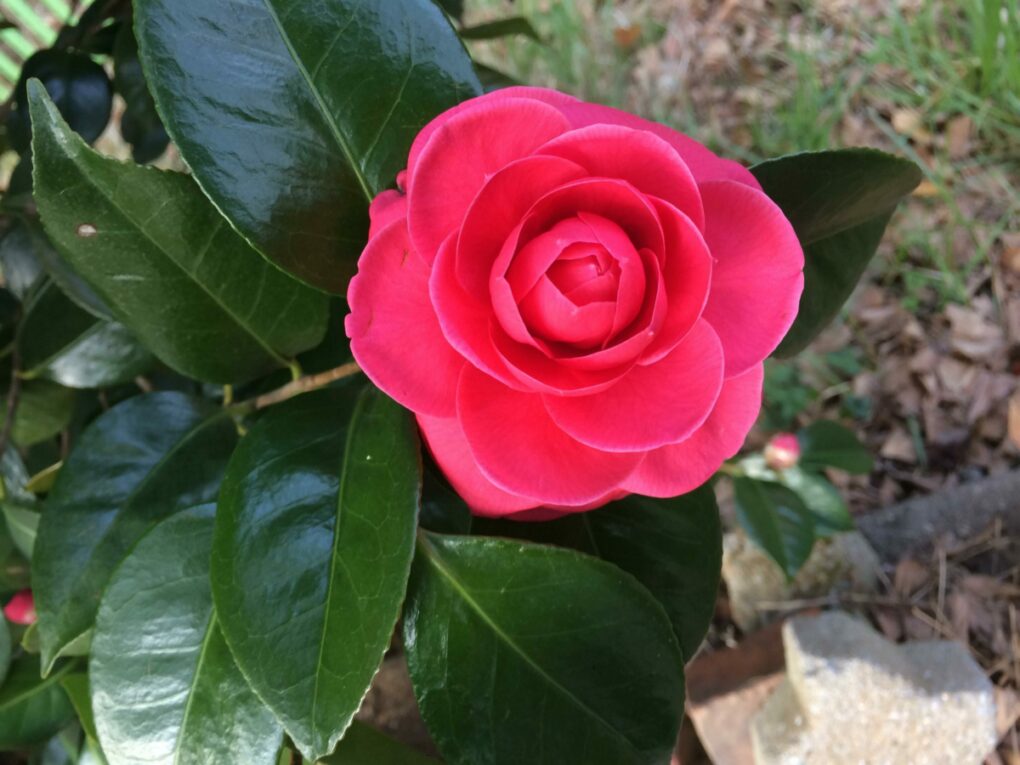
Relax at Jirisan Spa Land. If you've never been to a Korean sauna, you are missing out. Spas are a national past time here, and they're also quite affordable, and fun in a group, couple, or solo. Jirisan is particularly well-known because it features hot springs-supplied baths. Keep in mind that like all Korean spas, the indoor regions of the spa are separated by gender and have a no-clothes policy.
Do a photo shoot amongst Gurye Cherry Trees. These bright yellow blossoms have taken up root throughout the village of Gurye, bringing hoards of people (& tourism dollars) to town every spring. In the fall, the trees' cherries cover them in color once again, this time a deep red . If you manage to visit in March (outside of festival time), you may even find this to be the perfect spot for a photo shoot.
Ride the Yeosu Cable Car. Especially beautiful around sunset, Yeosu's cable car takes you across the bridge which connects Yeosu to the mainland. From an incredible height it gives you a look at the still-active port area and many smaller surrounding islands. Not to mention it saves you a taxi ride!
Drink up at Boseong Green Tea Fields. The green tea fields of Boseong hit their peak around mid-May, but they start turning a deep green color as early as March, continuing to lighten until late September. Koreans come to visit the main green tea plantation in order to hike up to the top of the hill on which the tea trees are planted.
Most people end up taking selfies and enjoying the view of everyone walking around far below them. At the plantation, other than the tea itself, you can enjoy green tea-flavored churros, lattes, and even a few savoury dishes (though don't expect much tea to be put in those).

What To Eat In Suncheon
Suncheon is often hailed as the foodie capital of the southern part of Korea. Located near the coast, in Jeollanam-do, local restaurants in Suncheon will serve all the classics, but with a southern twist. Popular themes include seafood, fresh local vegetables, and abundant side dishes.
Mudskipper Soup. Arguably the most popular way to consume this local fish, the soup is prepared using boiled fish, radish leaves, and soybean paste. It's a very strong flavor, but all the side dishes it's served with temper it beautifully.
Kongnamul Gukbap . Literally "soybean soup rice," you can find gukbap all over Korea; I actually recommend trying a hearty pork or beef version in Busan. But each region has their own special recipes for the soups and when they add the rice and where they source the ingredients. In the case of Suncheon's gukbap , the soybean sprouts add beautiful crunch to a very traditional Korean dish.
Sannakji Bibimbap. Another dish I sort of recommended in Busan, sannakji is basically the freshest form of raw octopus you could eat, served with lemon juice and seasoned with sesame oil. This iteration is less of a snack and more of a full meal, incorporating fresh vegetables and rice. Look for 산낙지비빔밥 on a menu.
Green Tea Churros. I couldn't recommend visiting the green tea fields of Boseong without also recommending the snacks! Only available on the weekends, these churros are nice when paired with a cup of green tea soft serve ice cream.
Grilled Duck. Suncheon famously raises about half the duck in Korea, meaning that finding a local duck dish is more likely than not. If you can find it, my favorite is Yangnyum Ori (양념오리).
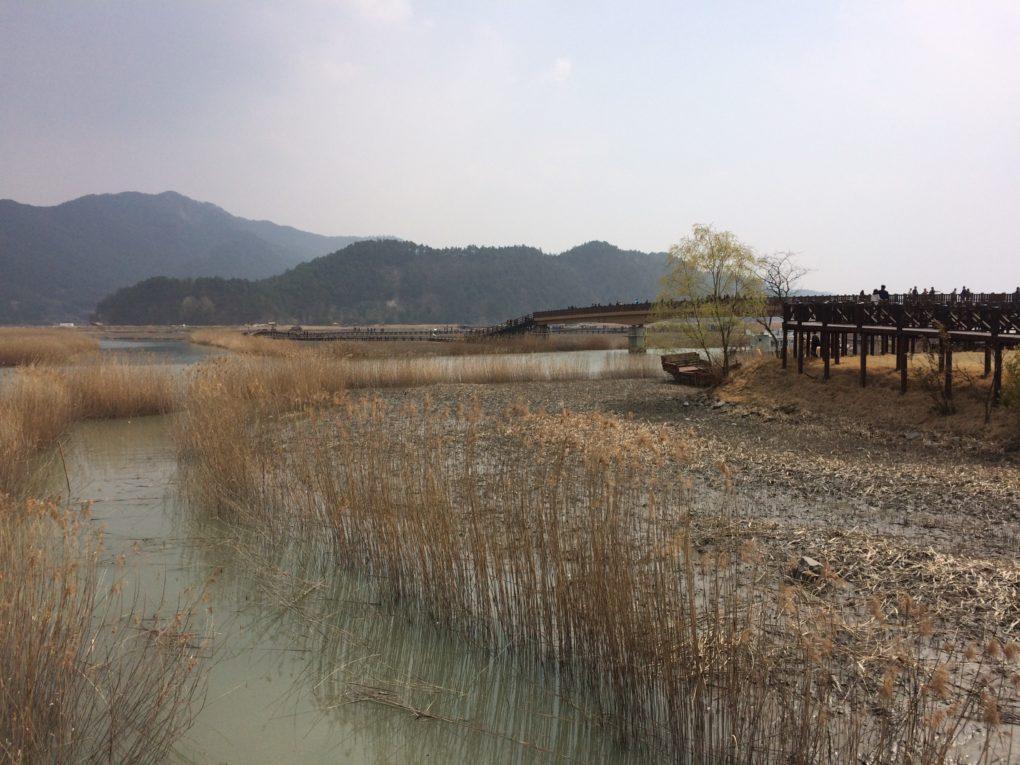
Where To Stay In Suncheon
Suncheon is quite the hot spot for domestic tourism, so most of the places to stay in Suncheon are Korean-style. This means that you sleep on the floor, and usually call to book directly. But there are some nice western-style guesthouses to choose from, three of which I've listed below. If you're visiting Suncheon between April and June, I'd recommend booking a guesthouse in advance!
Budget: Suncheon Namu Guesthouse
You can't get much closer to Suncheon bus terminal than Namu Guesthouse. No matter what time of day or night you arrive (or depart), if you stay at Namu you're just a few minutes from the city's bus terminal.
The beds are pretty standard for Korea, on the hard side, but the shared space is very homey and comfortable. At just $16USD a night for a dorm bed, it's the perfect spot for those planning to stay awhile and do a lot of day trips.
Budget: Baguni Hostel
It's rare to find a hostel with affordable dorm beds and a decent sense of privacy, but Baguni manages to strike this balance with grace. The dorm beds are each in their own little cubbies, with privacy curtains and fluffy bedding.
But the building itself makes use of lots of white and neutral tones, choosing to focus mainly upon providing a clean, comfortable, and affordable environment for guests.
The hostel is located right in the city center, a short walk from the bus terminal, making it a great choice for visitors who can't or choose not to rent a car. Single hostel beds start at $18USD a night.
Mid-Range: Hotel Iam
Every room at Iam includes an en-suite bathroom and complementary breakfast in the dining room. For those looking to upgrade their stay in Suncheon, this is an affordable hotel with comfortable beds, a nice staff, and a central location.
It's family-friendly, but more popular with couples looking to get away from hostels without breaking the bank. Double rooms start at $40USD.
Click here to check out prices for other hotels in Suncheon
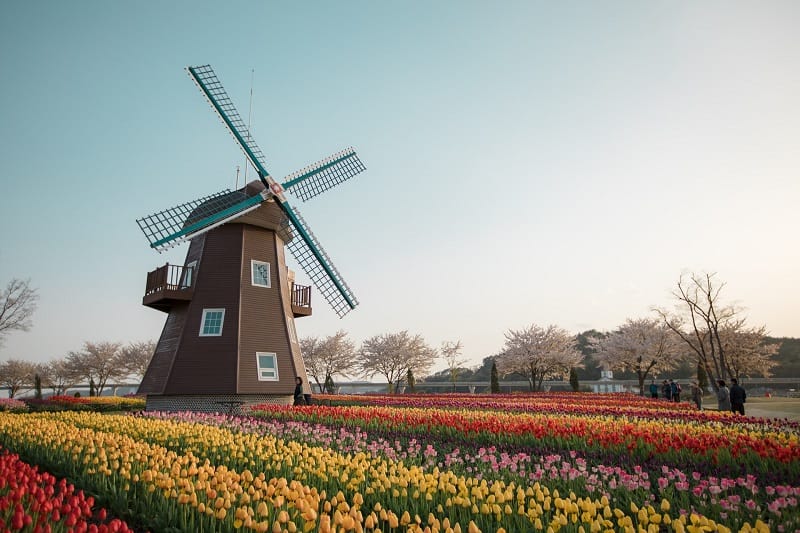
✈ Jeonju
What jeonju is known for.
Despite being just 1.5 hours from Seoul, Jeonju rarely features on a Korea itinerary, and that is a mistake. While you can easily visit Jeonju on a day trip from Seoul, I humbly recommend you spend at least two days in the city.
Preferably while staying in one of the historic houses & enjoying traditional Korean dishes in Korea's "Foodie Capital." Unlike Suncheon, most of the things to see in Jeonju are within the city itself, making it walkable and perfect for any wintertime Korea itinerary.
Seoulites tend to visit the city on the weekends, so take a couple of weekdays to discover the city whose name literally translates as "perfect region." While you're there, make the most of your time with visits to local galleries and walks around the city's many parks and green spaces.
Jeonju is seen as a very spiritual city, a place of historical importance for its maintenance of traditional foods, architecture, and those intangible parts of Korean culture we all strive to experience in a new place.
What To See Around Jeonju
Jeonju is a great place to just walk around, similar to some of the neighborhoods in central Seoul, but it's always nice to have a destination in mind. So in order to give you an idea of some of the things you can do in Jeonju, here are 7 things you should do or see in the city.
Photoshoot in Jaman Mural Village. Somewhat similar to Gamcheon Cultural Village in Busan or Rainbow Village in Taiwan , Jaman has become a symbol of revitalization for older parts of the city.
While the nearby hanok village has become well-known, just beyond the overpass is Jaman, a neighborhood painted up & beautified by local artists. The uphill scene is worth the trip, and makes for some very cute photos, especially for families and couples.
Tour a Hanok . A hanok is a type of small house, traditionally one story tall, which were the main type of dwelling in Korea for centuries. Due to Jeonju's ancient status, it was designated a UNESCO City of Gastronomy, and as a result, the rest of the city has also been well-preserved.
One thing that sticks out in Jeonju compared to Seoul or Busan is the height of the buildings. It can be hard to put your finger on at first, but you'll quickly notice how short most places are, and how it opens up the entire city.
This is due in large part to the city's hanoks . Places feel greener, even when you visit Jeonju in the winter. While you can tour a hanok ( hopefully stay in one, too! ) just by walking by, I'd also recommend checking out Gyeonggijeon Shrine for a more holistic look at how hanok culture shaped contemporary Korea.
Eat Street Food at Nambu Night Market. You can't recommend a visit to Jeonju without also recommending a trip to a night market. Korean night markets are notoriously boisterous affairs, with locals loudly hawking their wares from the safety of their booths, wafting any number of smells your way. The market is open every day, but Fridays and Saturdays are the busiest of all.
Some delicacies to enjoy once you've feasted your eyes are the grilled meat skewers, daepae saewoo (pork-wrapped shrimp), and hoddeok (honey cinnamon-filled rice cakes), though there are many international dishes, as well.

Try Dolsot Bibimbap With Makgeolli . Those little gold bowls full of translucent white liquid have become a staple in my life. Anytime staff at my job went out to dinner together, we always had makgeolli (rice wine), usually served from a big pot in the center of the table.
This is the most traditional way to consume the traditional rice liquor, and it's a great accompaniment to Jeonju's famous version of bibimbap (mixed rice). Try it almost anywhere in the ancient village, and I guarantee a smile.
Wear a Hanbok Amongst Hanok. Similar to the beautiful hanbok (traditional Korean outfits) you'll see in Seoul and Busan, it's almost a rite of passage to wear a hanbok around Jeonju. If you want a more unique experience in the city, this is the move. Rentals start from ₩8,000 (~$7USD), and range from 1-4 hours.
Have Tea in an Ancient Cafe. Or at least in a cafe that looks ancient, as many of the cafes in Jeonju's downtown area have been styled to look.
Some of the cafes are even in a hanok , which makes the tea-sipping feel all the more event-like. Some great cafes in Jeonju are Café Haengwon and Swan Park Cafe, but just remember to have a translation app on hand for the menus.
Admire the Flowers in Deokjin Park. One of the most popular gathering places in Jeonju, Deokjin Park has now become a draw for visitors, as well. In the spring there are flowers everywhere, while the summer sees the lotus blooming on the lake & fall brings changing colors to the leaves.
If you visit from July to August you'll notice crowds of locals taking pictures with the lotus flowers, as the high season coincides with kids' summer break.
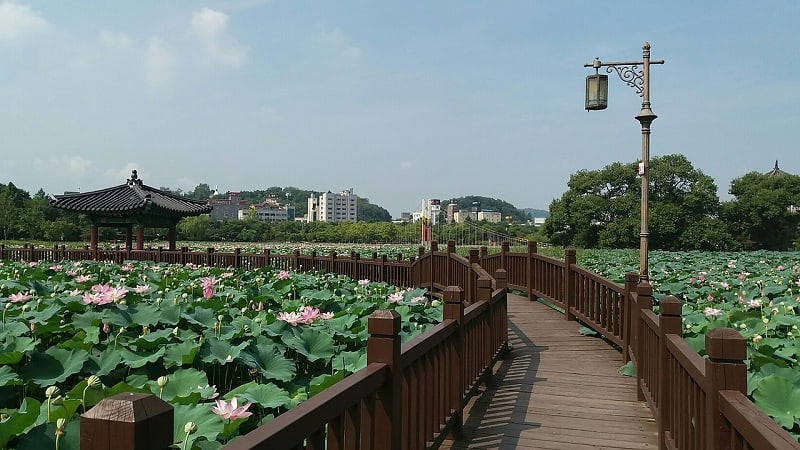
What To Eat In Jeonju
Despite the popularity of Suncheon as Korea's underground foodie capital, Jeonju is the official foodie capital of the country. In fact, in 2012 it was named a UNESCO City of Gastronomy. Domestically, Jeonju is known for its fresh vegetables and locally-grown rice, as well high levels of spice, so prepare your palate.
Legit Choco Pies. The infamous Korean treat of Choco Pies, which my students simply adore, were actually born at a bakery here in Jeonju. The bakery, PNB, has branches throughout the city, where you can find the layered chocolate and marshmallow pastry in multiple iterations.
Grilled Imsil Cheese. Korean cheese is notoriously gross. But many years ago, in a town just outside of Jeonju, one company faced this problem head-on: Imsil. In street food regions throughout the city you can find thick skewers of carefully grilled Imsil cheese, lightly sweet and crispy on the outside, halloumi-like in texture.
The brand also makes some delicious yogurt, and if you took the bus to & from Jeonju, you may even stop at an outpost where you can buy some of their cheese & yogurt. Go for the blueberry flavor; you can thank me later.
Jeonju Royal Court Cuisine. Gung hanjeongsik , as it's called in Korean, is the modern retelling of the special food eaten at the King's palace during the Joseon Dynasty. Even back then it was so intricate to prepare that it was only consumed once a month. One of my friends insisted that we try this type of meal when we went to her hometown, and it does not disappoint.
The setup is basically three tables covered in dozens of side dishes and a few main meals, all emphasizing local specialties from different parts of the country. This special meal is an investment, maybe $45USD per person. But it's seriously worth it.
Ddeok-galbi. Another local recommendation, these short rib patties will make your mouth water. They're prepared using marinated galbi , usually pork, and onion, garlic, ginger, and a umber of other spices. The meat is ground and then reformed into thin patties before being grilled on skewers or back on the bones; they're served with white rice and numerous side dishes.
Dolsot Bibimbap. While bibimbap (rice with steamed vegetables) is common throughout Korea, this version is unique because it's prepared in a piping hot stone bowl ( dol is Korean for "stone"). The rice is allowed to crisp up on the bottom, adding a delightfully different texture to the mix of ingredients.
This mix almost always includes fresh vegetables, kimchi, oak jelly, a small amount of beef, and a raw egg to stir into the steaming hot dish. Jeonju is so synonymous with bibimbap that there's now Bibimbap Festival every year. Just don't touch the bowl!

Where To Stay In Jeonju
One of the main reasons people choose to visit Jeonju over any other destination in Korea is for the hanoks (traditional Korean houses). All of them are now also equipped with ondol , the typical Korean floor heating system, making them quite comfortable even on the coldest of nights.
So most visitors do opt to spend the night in one of these beautiful guesthouses, most all of which are clustered in the famous Jeonju Hanok Village (in the southeastern part of the city).
But I'm not a huge fan of sleeping on thin blankets on a hard wooden floor, despite having done it a few dozen times. So here I've recommended just one hanok -style guesthouse, the two other being more western-style accommodations.
Budget: 24Guesthouse Jeonju
24 is a popular guesthouse chain, and I've stayed in several of their locations throughout Korea. They offer affordable double rooms with en-suite bathrooms, as well as 3- to 4-person hostel-style rooms for some of the cheapest prices around. A simple coffee & breakfast is included.
The guesthouse is a few blocks north of the Hanok Village, allowing you to be near but not right inside all of the action. At just $14USD a night per dorm bed, it's hard to beat the price if you're visiting Jeonju on a budget.
Hanok: Bu Kyung Dang Guesthouse
This is one of the most beautiful and most-loved hanoks in the whole village; no exaggeration. The entirety of the property consists of just 8 rooms, surrounded by greenery, which is found in full bloom if you visit in the spring.
On the outside is the traditional slatted doors with a paljak roof and paper lanterns around the perimeter. But heading inside you'll find a beautifully refurbished stone-tiled bathroom and wide open rooms. Grab a blanket from the stack and settle in for the night. Rooms start at just $32USD per night.
Mid-Range: N Bridge Hotel
Non- hanok accommodation in Jeonju is incredibly hard to come by; most people want to stay the night in the famous Hanok Village, and seem to have no problem sleeping on the floor. But for my fellow non-floor sleepers— at least those not on a budget— I'd recommend N Bridge.
It's got big fluffy beds, 24-hour service, and a fridge in every room. Unlike most of the hanok options, it also has multiple floors and a marble bathroom in every suite. Just be sure you don't book their futon room unless you actually do want to sleep on the floor, Korean-style. Double rooms start at $74USD.
Click here to check out prices for other hotels in Jeonju
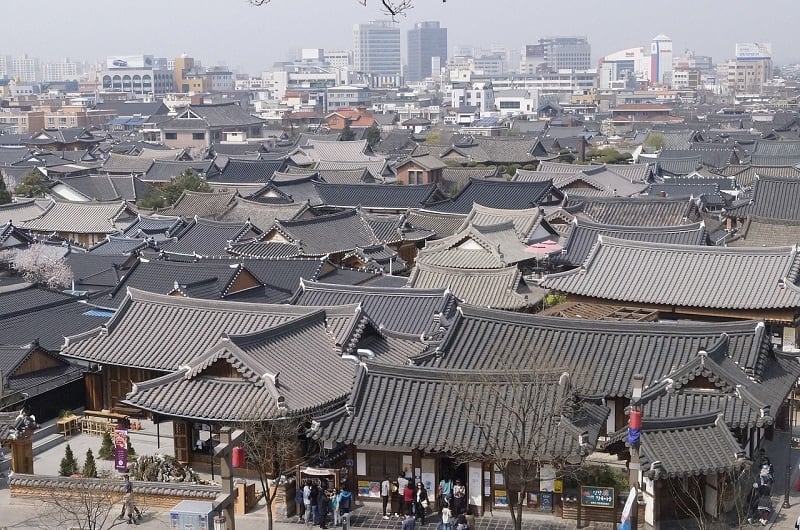
🧳 Budget For A Trip To South Korea
Of all the countries in East Asia, I'd argue that South Korea has become the most affordable to visit. There are many extremes to be found in the ROK (Republic Of Korea), a fact which extends to my daily life here over the last few years.
Visitors could stay in super cheap dorm beds booked way in advance for about ₩12000 ($10USD) a night, eat street food for another $10USD a day, and otherwise spend money only on transportation. I wouldn't recommend it, but it's doable.
On the other hand, Seoul is a massive city with plenty of hotels always ready to take your money. $500USD a night hotel rooms aren't the norm, but they're there. The key is to find a balance, and if you're looking to travel Korea on a budget, then make a list of priorities.
Do you most want a nice place to sleep? Fancy meals? Involved day trips? Budget travel in Korea is 100% possible, but it takes planning. So here's a rundown of the costs of traveling in Korea.
Note that this South Korea travel guide covers such a wide range of days that the budget below is a snapshot of how much you could spend in one day. My dad would call them "guesstimates." It also covers the cost of basic activities which most everyone would do. Remember to multiply this Korea travel budget by the number of days you'll be visiting us for!
ESTIMATED COSTS:
- Visa Fee : ₩30000 (to check if you need a visa, click here )
- Day Tours : ₩70000 (some day tours cost more, but these kids of trips include visiting the DMZ , Nami Island, and Jeju tours)
- * Each Trip To A New City : ~₩30000 (one way; this is an average)
- * Round Trip Airfare to Jeju : ₩80000 (if booked well in advance)
Decent Guesthouse : ₩25000
Meals & Snacks : ₩20000
Attractions & Activities : ₩10000
Transportation : ₩5000 (4 trips on the subway or bus)
Souvenirs & Cafes : ₩5000 (coffee or tea)
Average Cost Per Day : ₩ 65000
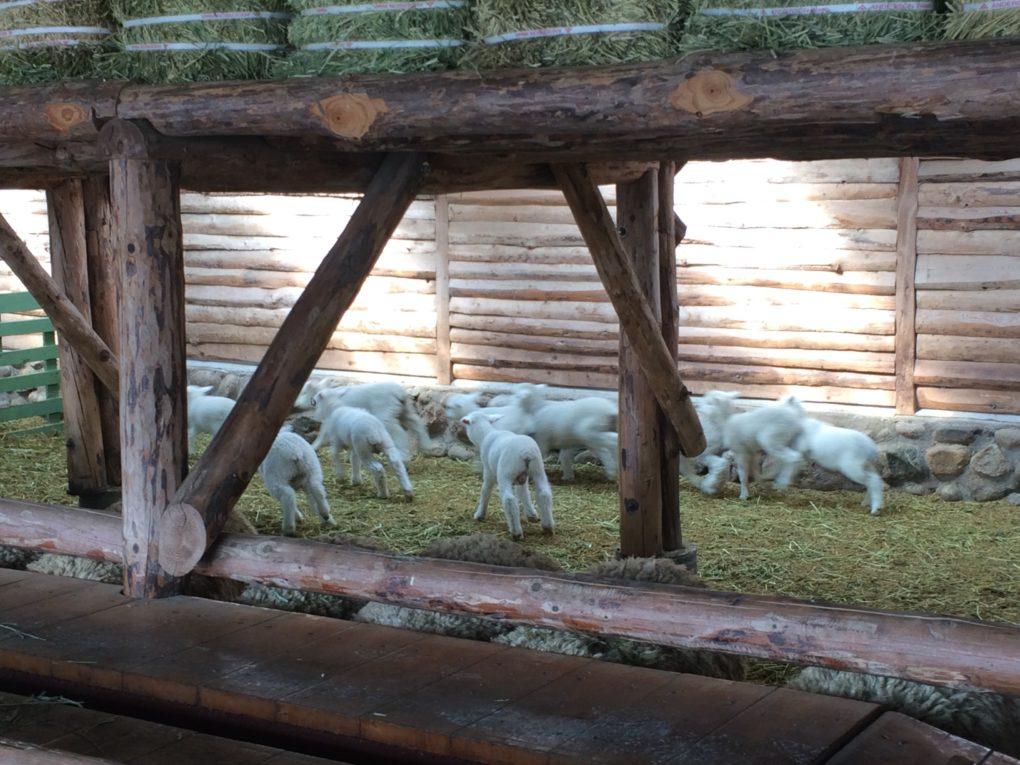
🚈 South Korea Travel Tips
- Metros aren't very accessible but the buses and taxis are. So if you're in a hurry or disabled, then you should take a taxi. They're very cheap and fast, though during rush hour they'll take as long as the metro. Most shops (like Korean chocolate shops ) are clustered right around metro stations anyway, so even if your driver doesn't speak much English you can tell them the name of the metro station closest to where you're going.
- Korean winters are not for the faint of heart . My friends from Vietnam visited me last winter and spent their first day alone— they were shivering for hours after we came inside. Even my sister was not very happy with all the snow over New Year's when she visited a few years ago. It can get brutal, thanks to winds coming down from Siberia.
- Also not for the faint of heart, entitled old people . They will push you, publicly and without shame if they think you're in their way. I understand that they act this way because they don't think young people respect their elders like they should, and they don't, in my opinion. But no matter how you think, it is something to be aware of.
- Korea is basically a cashless society , except for in the markets. This means that you can use your credit card most everywhere, but international cards aren't always accepted, so still keep some cash on hand.
- Along similar lines, in Korea you should expect late nights and late mornings . Cafes, restaurants, and shops are open very late, usually between 10pm and midnight, but rarely open before 11am. If you want morning coffee if Korea you'll have to either be at the airport or grab canned coffee from a convenience store.
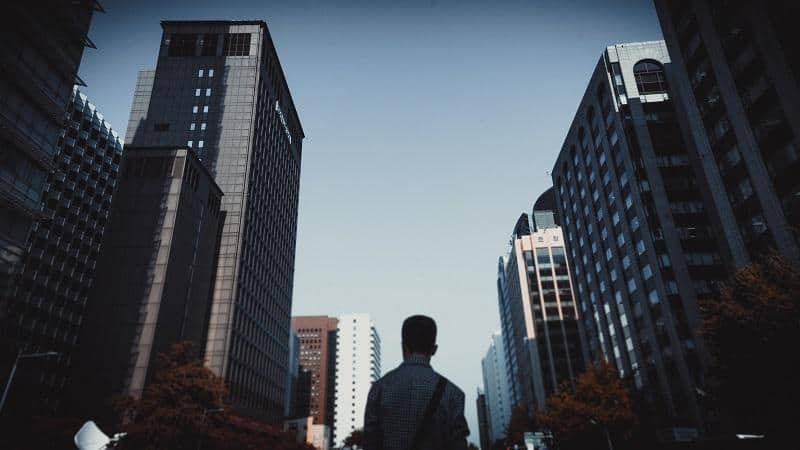
- Even though it's a more developed country, Korea has their share of travel scams. One of the most common is the fortune teller scam , in which a woman stops you on the street and offers to take you to have traditional experiences, only to scam you out of money. Either way, if someone stops you on the street, 95% of the time they want your money or to convert you. NYC rules apply.
- Pollution is horrible. Sometimes the skies aren't as bad, but spring 2018 and winter 2019 were particularly harsh, with many days seeing pollution levels as high in Seoul as in Beijing, China. Bring a mask, or buy one, especially if spending 2 weeks in South Korea, or longer.
- Naver Maps will tell you which door of the subway you should go to for the faster arrival at your next destination.
- If you're a bigger person , look for handicap-accessible or family bathrooms, as Korean public bathroom stalls are made for small people, especially the women's bathrooms.
- Look up . If you're looking for an office or guesthouse or restaurant, and you'd swear you're at the right address, just look up. It's probably just on a much higher floor, like the 11th or 32nd.
- However, when you do look up, don't make eye contact unless you want to start a conversation or get stared at as you walk away (though that might happen anyway, in the countryside).
- Hospitals are for everything , even if you're a visitor taking various South Korea tours and end up with a cold. The hospital is like the doctor's office, and in small towns like mine, they're open 9 to 5 like everything else.
- Always count to 5 before crossing the street , because without fail, at least once a week I watch someone go after the light turns red, be it a car or a motorbike. Better safe than sorry.
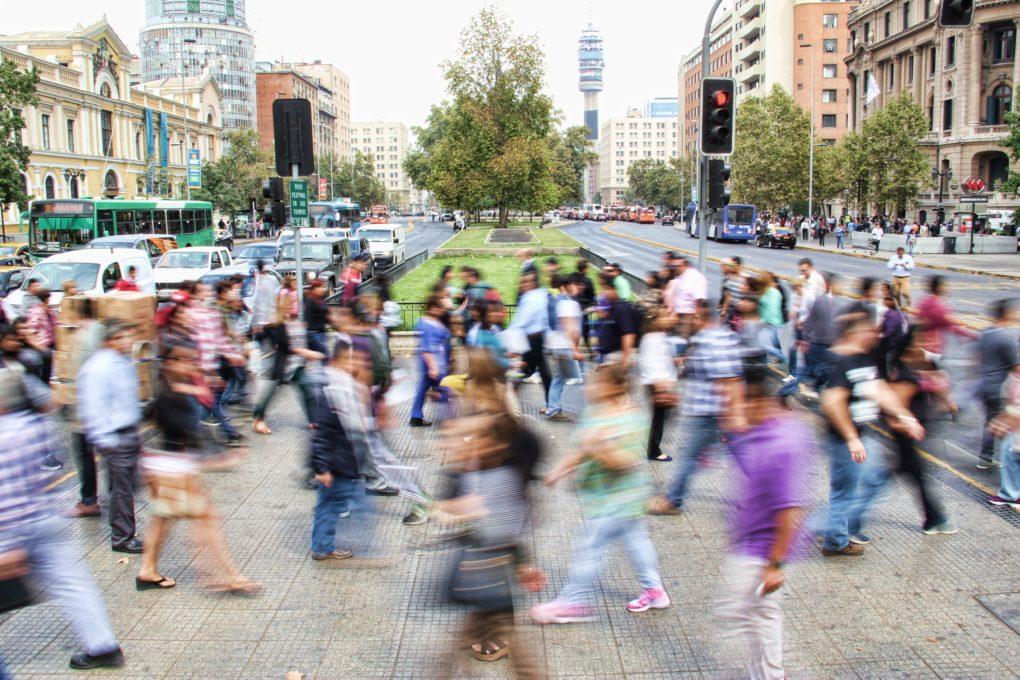
☺️ Basic Phrases For Your Trip to Korea
Hello // An-nyeong-ha-se-yo . (안녕하세요.)
Thank you // Gam-saahm-ni-da . (감사합니다.)
How much is it? // Eegaw eol-ma-yeh-yo? (이거 얼마예요?)
Do you speak English? // Yeong-aw jal-hae-yo? (영어 잘해요?)
I don’t speak any Korean. // Han-guk-aw jal-moat-hae-yo. (한국어 잘못해요.)
One of these, please. // Ee-gaw ha-na ju-say-yo. (이거 하나 주세요.)
It’s to-go/takeout. // Po-jahng ee-eh-yo or Tae-ee-kow-shi-yay-oh. (포장 이예요.)
Lesson complete! Now let’s get packing.
Did this post help you plan your trip to Korea? Save it on Pinterest so that it can help others, too!
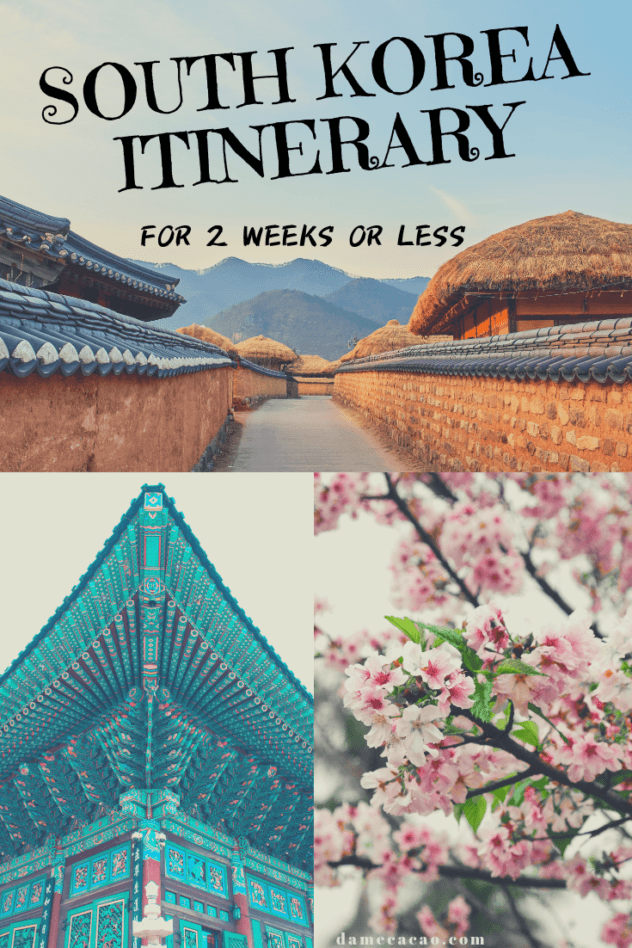
More South Korea Travel and Life

Reader Interactions
Happy Travelers
January 13, 2024 at 4:42 pm
Thanks for creating a 14 day with Jeonju! We will be in Korea feb 7-21 and obviously plan on seoul, busan, and jeju. We really wanted to hit Jeonju but was reading about doing a drive from seoul east and then south to hit Chuncheon, Sokcho, Gangneung, Samcheok, Andong, Gyeongju, Seokguram and skipping Jeonju.
I was wondering since we will be there in the Winter, which would you recommend the Jeonju plan or the east plan?
January 14, 2024 at 2:46 pm
Thank you for the kind words! At that time of year, you'd be better off giving Jeonju a visit since the warm weather that would make the east coast drive so pleasant & beautiful would be nonexistent right then. You'll also be overlapping with Seollal, or the Lunar New Year (weekend of Feb 10), with those dates, so renting a car may be a bit harder and traffic will be CRAZY heading out of the city all weekend (everyone is taking their fmailies back to the countryside to see parents/extended family). However it will be just one weekend out of two, so I recommend you just plan around that, and definitely give Jeonju a few days!
August 18, 2023 at 4:02 am
Thank you for your post. I wonder how to use 'Kakao talk' app during travel in Korea. Is there any way to use it?
August 20, 2023 at 5:55 pm
My pleasure, Kim! You can download Kakao Talk before your trip, but since it's connected to your phone number, if you need to get a local sim card in Korea, you'll just need to make a temporary new account for use in Korea. So unless you'll use your phone's regular sim card while in Korea, I recommend waiting until you're IN Korea to make your account for use during travel in Korea. Then you can use it to communicate with taxi drivers, food delivery, Air BnB hosts, local friends, etc.
August 07, 2023 at 6:14 am
Thanks for your great posts! I used this one (and a few others including the Seoul and Jeju one) to help me when I went to South Korea for two weeks. I read a few blogs on the internet, but your style and interests most closely matched me. Hope you are doing well one your new adventures 🙂
August 10, 2023 at 9:26 am
Thank you for the kind words, Kim! I'm glad you've found it all helpful. 😀
August 04, 2023 at 5:48 am
Hi, we are going to prepare a tour with golfers to Korea and beside of golf your information are very helpful. Do you live in Korea and work as DMC?
August 04, 2023 at 1:36 pm
That sounds like a very fun tour indeed, but unfortunately I don't like in Korea anymore, nor have I ever worked as a DMC. But good luck with your search, and enjoy your trip!
June 13, 2023 at 11:05 pm
What a great post! Thanks for sharing. We are planning to come from June 29th to 9th July. What do you think about the weather? Can we come now or delay due to rain and heat? Also, in Seoul what is a good location for a family stay - Four Seasons and something in Gangham?
June 14, 2023 at 12:40 am
My pleasure, VK! And since it's monsoon season, it's honestly pretty unpredictable as to which days might be nice, but with such a long stretch of time, you're bound to get some good weather days and maybe a bit of rain. I have a post covering 100+ things to do in Seoul , so I recommend looking through that and over the map on the bottom to note some things that look interesting & rain-proof, as well as some options for stuff close to where you choose to stay.
Speaking of, the Four Seasons is lovely, but I was also incredible impressed with VOCO Hotel in Gangnam . It's an affordable IHG property a block or two from the metro, and I felt like royalty for much cheaper than the Four Seasons (like 1/3 of the price)! But it's always worth comparing the two side-by-side, as the Four Seasons would offer slightly different amenities and is in an arguably more central tourist location. Either way, summertime will be warm in Seoul, but everythng is open and tends to have longer hours due to the increase in domestic tourism.
Enjoy your trip!
June 14, 2023 at 8:34 am
@Max, Thank you so much for your kind response and the details provided. I am planning to do 4 nights in Seoul, 2 nights in Busan, and 4 nights in Jeju. Is that plan correct? Given a choice you would me to skip summer and rain and come later or it is still okay to come from 27th June - 7th July? As we don't to come and spoil the trip - I hope you understand :).
The Hotel option you gave is great. I will definitely have a look. Is it better to stay in Gangnam or the area where the Four Seasons are? I know I am asking too much but if you have any recommendations for Busan and Jeju as well - would love to take your feedback.
Thanks so much again.
Regards, VK
June 14, 2023 at 5:24 pm
That's how I'd plan it out! And honestly, you can't predict the weather well enough to say whether it will rain half the days or just one or none. It can be rainy from June to September, and it gets quite cold after that, so sometimes you just have to roll the dice. If given the option, summer would be my pick over winter, but even if I knew the other times you'd be able to go, we'd still be in the same predicament about not being able to know for sure how the weather will be.
If the price difference doesn't matter as much, the Four Seasons would be my pick for a first-time visit, because it's truly in the middle of the touristy area with a large chunk of the museums, hanok (traditional) houses, souvenir shopping, royal palaces, and a ton of restaurants with great Korean food and mostly translated menus. Voco (and Gangnam as a whole) is about a half hour metro ride from that area, and while it's great for fancy shopping, visiting Lotte Tower, and some fabulous meals (if you eat beef then definitely try hanu , or Korean domestic beef, while you're there), it has a few tourist-friendly museums and not so much else. But what you save in staying there would more than pay for taxis all throughout the city! So each has their pros, and you should pick the one that's right for your preferences.
As for the other two, I spent many hours compiling accommodation guides for both Busan and Jeju Island , and you can read about the various neighborhoods/parts of the island in each, and make the best pick for each based on what you plan to do there. Again, since I'm not sure what attractions you're most interested in, I do think it would make more sense for you to look through those for the best picks for you personally, rather than booking only based on my recommendation. And if you do still have more questions after reading through those two posts, just leave another comment and I'd be happy to answer them there.
I never mind answering questions, as frustratingly few bloggers seem to still do so. But if you've found any of the info helpful, I always appreciate it if you book through my affiliate links. I specifically work with Agoda for hotels because I've always found that they have the best prices on accommodation throughout Asia, and always throughout Korea. But if you don't, no big deal; just wanted to mention it as a free way to say 'thanks'! 🙂
June 14, 2023 at 10:02 pm
@Max, Thank you so much for your kind help and answering questions. This really helps a lot. I will definitely use the affiliate links:)
Susan Hughes
February 25, 2024 at 11:01 am
My husband, oldest daughter, possibly a friend of hers and I will be in South Korea, leaving DFW the 9th (not getting there till the 10th at 3:15)-and returning the 20th at 5:25. Trying to come up with a tentative itinerary so we can experience the most of our time there. Seoul, Busan and Jeju Island are my top places to visit. I’m a Korean adoptee and would like to visit an orphanage. If you have information about Holt orphanage that would be wonderful. I was adopted in 1973 which the orphanage was called Livingstone but changed to Holt. Trying to determine if we should stay around Seoul when we get there or when a few days before we head back home. I’m realizing I should have booked 2 weeks which a friend who is living there for a year suggested but i compromised with 10 days. Would love to hear what advice you have to give. I’m just starting to do research so any info other than what you have said in your post would be much appreciated. Wish you were there when we are to be our travel guide😂Looking forward to hearing back from you!
February 28, 2024 at 1:14 am
Hi, Susan! That sounds like a wonderful experience you have planned. I'm sorry I don't know anything about Holt, but I also did my best to include every little detail about visiting in this post - it's over ten thousand words! However, when planning timing, I'd say to know your limits. If you're flying direct from Dallas and know you'd be up for another short domestic flight that would get you to Jeju by 7pm or 8pm, then I'd say to go directly to Jeju, because getting into Seoul formt he airport in Incheon take about 2 hours. It's a trek, and your time is better spent getting your sea legs, so to speak. From a few days in Jeju first, I'd fly from Jeju to Busan, then take the train from Busan to Seoul and leave form there. Lots of options depending on your particular interests!
Leave a Reply Cancel reply
Your email address will not be published. Required fields are marked *
This site uses Akismet to reduce spam. Learn how your comment data is processed .

Ultimate 2 week South Korea Itinerary: Best Places (2024)
Are you planning a 2 Week South Korea itinerary in 2024? This is our in-depth guide on how you can travel 2 weeks in South Korea visiting beautiful temples, eating the best food and learning about the Korean culture.
We’ll show you the best places to visit in South Korea and the best things to do in each place – tips on how to get around the country, what apps you need and how to budget for a 2 week South Korea trip. Let’s explore what to do in South Korea and create your South Korea route!
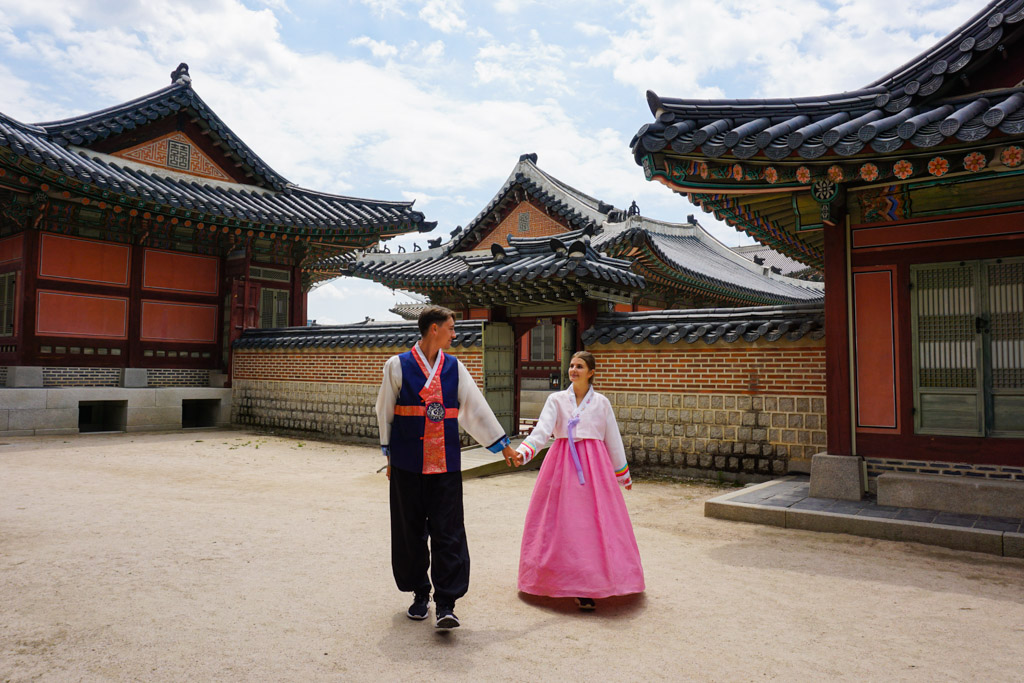
This post may contain affiliate links. We will receive a small commission if you make a purchase using these links, at no additional cost to you .
Quick Tips for 2 weeks in South Korea
Table of Contents (Skip to a section!)
- Currency – Korean Won (compare to your own currency here )
- Language – Korean (한글)
- Cuisine – Korean Cuisine (noodles, rice, BBQ & kimchi)
- Apps – NaverMaps (like GoogleMaps) & Kako Talk (like Google Translate)
- Transport Card – T-Money Card (the easiest way to use public transport in South Korea)
- Korea Power Voltage – Plugs C & F (220 V)
Simcard options for South Korea
E-Sim – A great option if you don’t need a Korean number! Purchase the sim online and with instructions you can install the sim on your phone settings! Here’s a 12 Day E-Sim . (£9.50 for 12 days)
Prepaid Sim – This may be preferred if you also want a Korean number as well as data. Price changes depending on the length you want the sim. Find a sim card on Klook here ! (£15 for 10 days) Pick up at the airport.
Portable Wifi – A great option if you want to connect more than just your phone! Find a portable Wifi on Klook here ! (£20 for 10 days) Pick up at the airport.
We also recommend having a portable charger for your phone so you always have enough battery to last the day and still use wifi! We recommend this one – Anker Power Bank !
Best time to visit South Korea
The best time to visit South Korea is around March – June (Spring) and September – November (Fall)! This doesn’t mean you won’t enjoy visiting in other months however the winter will be very cold and the summer will be very hot and humid!
Visiting South Korea in the winter means you have a chance to see snowfall and join in with winter activities. But in Spring you can see the cherry blossoms and in Fall you can see the autumnal foliage.
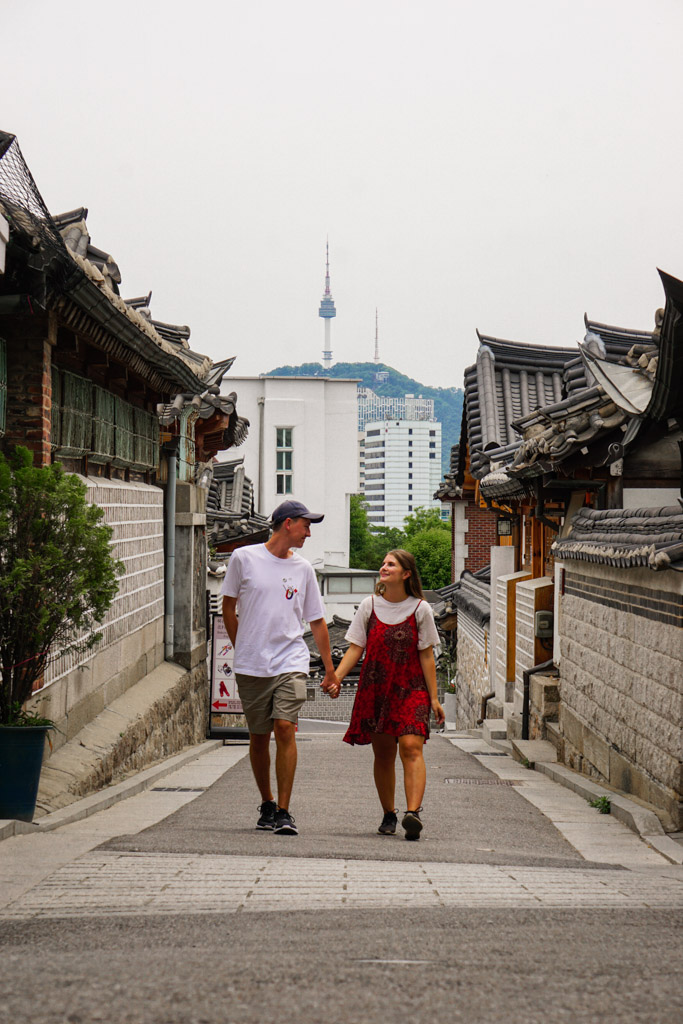
How to get around South Korea
South Korea is one of the easiest countries to get around – there are speed trains, well-connected cities, intercity buses and local buses! In the big cities, there are also metros to help you get to your destination. A Korea Rail Pass is a discounted train ticket that can help you get around the country – Find tickets on Klook here !
Trains – The fastest way to get around South Korea ( Korail tickets here ) ( Korea Rail Pass here)
Express & Intercity Buses – Another easy way to get around & cheaper than trains! ( Kobus tickets )
Flights – Flights to Jeju Island from Seoul or Busan – Check Skyscanner for flight times and prices !
2 Week South Korea Itinerary
Now that we’ve explained a few things about arriving in South Korea, let’s get down to the South Korea 14 day itinerary! We have written separate in-depth guides about most of the places on our list , so check out our page after you’re finished with this 2 weeks in South Korea route!
Day 1 – 5 | Seoul
The best way to start your 2 week South Korea itinerary is in the capital – Seoul! This city has a lot to offer and it’s one of the best places to learn about Korean culture whilst you get settled into the country.
How to get to Seoul
It’s likely you’ll be arriving at Incheon Airport which is just outside of Seoul. The best way to get to the city centre is to take the Airport Rail Road on the AREX Line. You can buy a ticket at the machines ( there’s an English option! ) and just follow the signs for the platform heading to Seoul Station. Find tickets on Klook here .
You can also buy a T-Money Card from a convenience store at the airport and top up here too ( 10,000 is a good starting point !). You’ll definitely want one for travelling around Seoul, so it’s best to buy one now!
Once you arrive at Seoul Station, you can head to your accommodation using buses or the metro. Naver Maps will be the best app for directions!
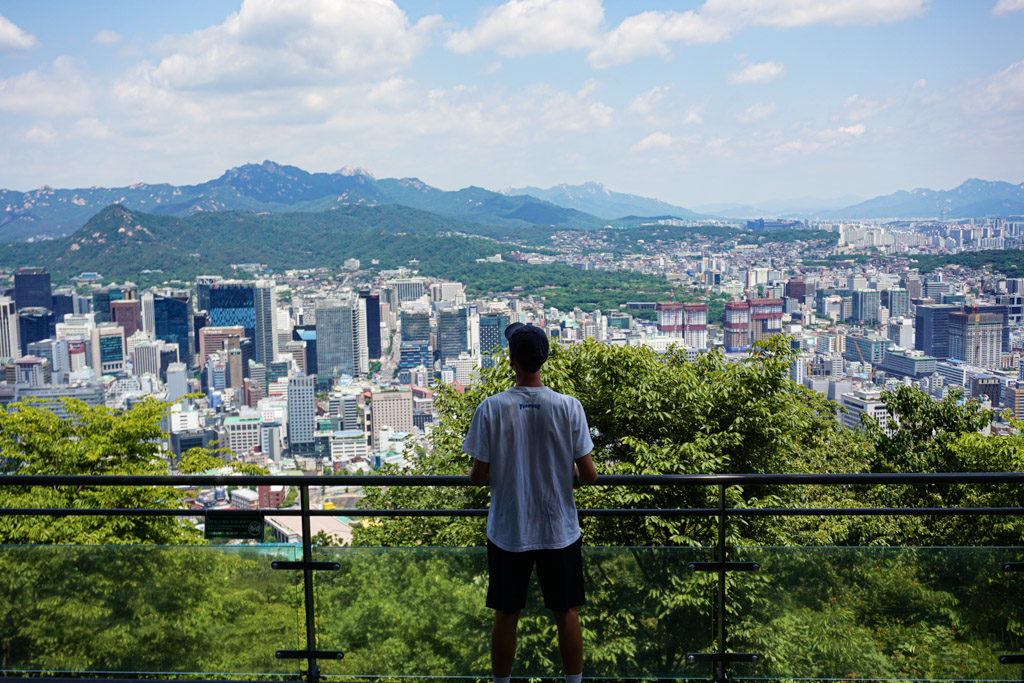
What to do in Seoul
There are many things to do in Seoul and you could honestly spend 2 weeks in South Korea just exploring the different areas of this capital city! We recommend 5 days or 5 nights in Seoul as this gives you the best amount of time to see what the city has to offer whilst not rushing around too much. Here’s a list of some of the activities to do in Seoul! (Also check out our 5 Day Seoul Itinerary travel guide here! )
Explore Insa-dong & Ikseon-dong
Insa-dong is one of our favourite neighbourhoods in Seoul. The area is filled with cosy restaurants, lovely teahouses and independent shops. The area is known for its historic art presence and you’ll also find galleries in between the alleys. If you’re hungry, enjoy a traditional Korean lunch or dinner at Osegye Hyang ( location ) in the beautiful streets of Insadong.
Nearby Insa-dong is Ikseon-dong – a hanok village full of trendy cafes, photo booths and cute shops! It’s a beautiful area to explore on your 2 weeks in South Korea itinerary.

Shop in Myeong Dong
Myeong Dong is the main shopping area in Seoul, there are luxury shopping malls, known fashion brands and so many cosmetic stores! The Myeong Dong Walking Street ( location ) is the main strip and you’ll find street vendors around this area too. It’s a great option for dinner or you can find one of the many restaurants in the area.
Check out some of Seoul’s Palaces:
- Changdeokgung
- Changgyeonggung
- Gyeongbokgung (highly recommend!)
- Gyeonghuigung
On your 2 week South Korea itinerary, we recommend visiting Changdeokgung & Changgyeonggung together as they are close together in the same park. The entry for Changdeokgung is 3000 won and Changgyeonggung is 1000 won. Changdeokgung served as the principal palace of multiple Joseon kings for over 250 years!
Another palace that’s definitely worth a visit is Gyeongbokgung – one of the most beautiful palaces in Seoul. It was the main royal palace of the Joseon dynasty and was built in 1395. The gardens are also beautiful to walk around.

Rent a Hanbok in South Korea
To make your visit to a palace even more special, you can rent and wear a hanbok for a few hours. There are many rental shops in Seoul around palaces and hanok villages. We recommend wearing your hanbok in Gyeongbokgung Palace as it’s the perfect size to explore and there’s a great rental shop nearby! Find the link on Klook here – Hanbok Rental Klook
Bukchon Village
Bukchon Hanok Village is a traditional Korean village with over 900 preserved homes. It’s the perfect area to visit at the beginning of your 2 weeks in South Korea to experience South Korean culture. Here’s the location for the area – Bukchon Village Location !
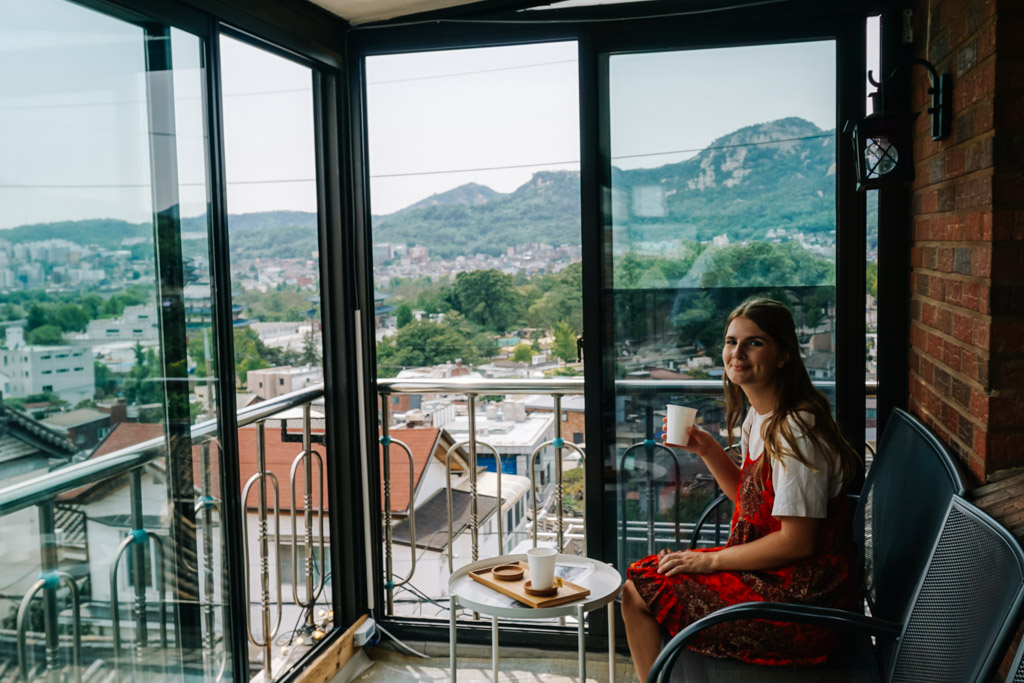
Namsan Park & Seoul Tower
Visiting Namsam Park is one of the best places to visit in South Korea! It should definitely be on your 2 week South Korea itinerary and it’s the perfect spot to view all of Seoul! It will take 30 minutes to 1 hour to reach the top of the park and it’s a relatively easy climb up to the top.
After admiring the views at the top of the park, you can go even higher and go to the top of Seoul Tower! Tickets are really affordable on Klook – so make sure you buy your ticket in advance! They don’t sell out and it’s an open ticket for whichever day you want to go on your South Korea route.
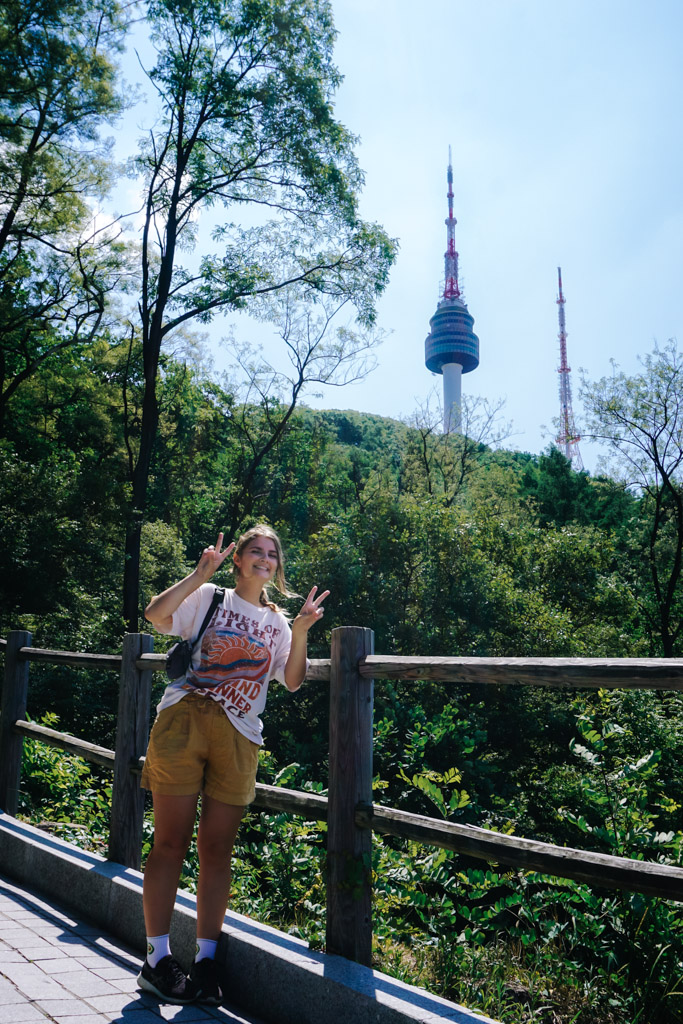
Visit Hongdae, Itaewon & Gangnam
All in different areas of Seoul, these three neighbourhoods along with Insadong and Myeongdong are some of the best places to visit in Seoul. Hongdae is one of the hip and trendy areas of Seoul, with many shops, restaurants and themed cafes. It’s also a great spot for nightlife alongside Itaewon.
Itaewon is right at the base of Namsan Park and it’s the place to go if you want to see the foreign area of Seoul – there are many international restaurants, shops and bookstores here! We recommend Plant Cafe Seoul ( location ) for lunch here!
You may have heard of the song ‘Gangnam Style’ and it’s actually a neighbourhood in Seoul – one of the wealthiest neighbourhoods in the country! The best spots to visit in Gangnam are Gangnam Shopping Street & Starfield Library Location .
Learn about the history of the Korean war and visit the Demilitarized Zone of Korea! It’s an important part of their country and you also get the chance to see a view of North Korea. You can only do this with a tour – book tickets with Klook here !
There’s also an Eland Hangang River Cruise to make your 2 week South Korea itinerary more unique! You can also day trip to Nami Island for a journey into nature.
5 Day Seoul Itinerary Breakdown : Day 1 – Insadong, Ikseon-dong & Myeong Dong / Day 2 – Changdeokgung, Changgyeonggung, Bukchon Village & Hongdae / Day 3 – N Seoul Tower & Itaewon / Day 4 – Gyeongbokgung, Hanbok, Naksan Park & Gwangjang Market / Day 5 – Seoul Forest & Gangnam
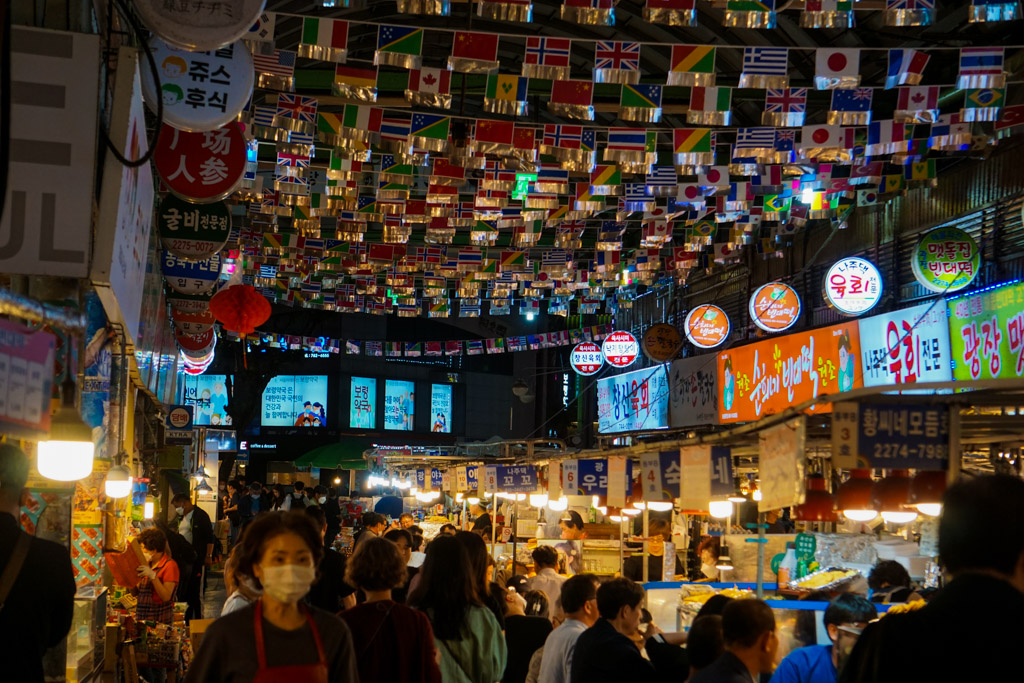
Where to stay in Seoul
Best area to stay in Seoul: Insadong, Myeongdong, Hongdae, Itaewon & Gangnam
Hostel Tommy $-$$ (Insadong) – This location is perfect for a first-time visit to Seoul. It’s close to the hanok villages, royal palaces, trendy cafes, restaurants and convenience stores. Located minutes away from a metro station to take you anywhere in the city. The hostel has dorms and private rooms to suit each traveller and there’s a common area with a kitchen! Find the link to Booking.com here – Hostel Tommy Booking.com
Where to eat in Seoul
Osegye Hyang $ (Insadong) – Traditional Korean vegan restaurant ( location ) Maru $ (Insadong) – Vegan street food ( location ) Gwangjang Market (Stall A11) $ (Jongno 5) – Vegan options at the famous market ( location ) Plant Cafe Seoul $$ (Itaewon) – International vegan cuisine in Seoul ( location ) ( website )
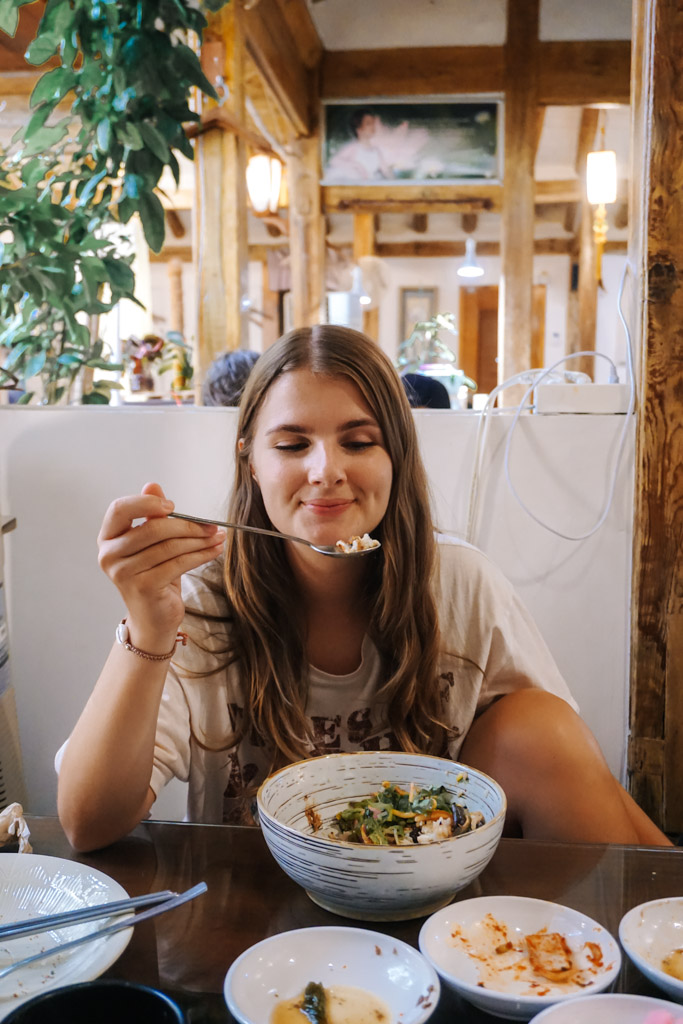
Day 5 – 6 | Golgulsa Templestay
‘ Templestay ‘ is a unique cultural programme in South Korea. There are many Buddhist temples in the country that allow guests to stay overnight and join in activities and meditation. It allows visitors to experience the life of Buddhist monks in Korea and they’re all so welcoming. Want to add this to your South Korea 14 day itinerary?
How to get to Golgulsa Temple from Seoul
KTX – You can book your train tickets online here – Korail Train Tickets and get a Korea Rail Pass if you’re planning to travel more of South Korea by train. Once you have your ticket head to Seoul Station and get on your train to Singyeongju Station (around 2 hours) The KTX will cost around 45,000KWR for a one-way ticket.
Once you’ve reached Gyeongju , you can catch a bus (150 / 100 / 100-1 around 50 minutes) to the Andong bus stop and then it’s a 15-minute walk to Golgulsa Temple. It’s also possible to get a taxi to the temple from Gyeongju which is faster.
Another option would be to take a bus or car ! Bus – Head to Express Bus Terminal and get a bus to Gyeongju Express Bus Terminal . It will take around 4 hours and is usually cheaper than the KTX. A car is also a great option to get to Golgulsa Temple as the temple has lots of parking spaces.
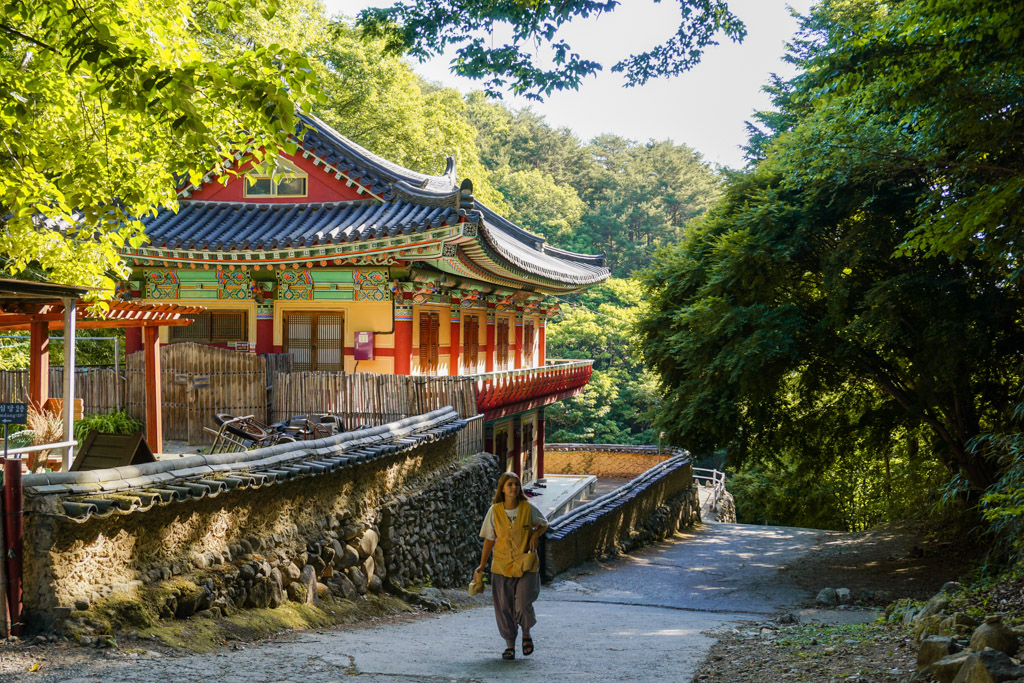
What to do at Golgulsa Templestay
As the Golgulsa Templestay is a programme – there will be certain schedules for weekdays and weekends. It’s completely optional to do any of these activities, but all of them are included in your Templestay experience.
Sunmudo Performance
One of the reasons why Golgulsa Temple is so unique is due to its teaching of Sunmudo. It’s a Korean Buddhist martial art involving strength and patience. The first activity you’ll do on arrival is to watch the Sunmudo Performance and it’s so beautiful.
You can also find out more here – Golgulsa Temple Sunmudo Website .
Sunmudo Training
Now it’s your turn to train like a Buddhist monk (it’s super hard!). If it’s summer, you’ll honestly break a sweat but these activities are so fun! One of the monks here at Golgulsa Temple showed us all the techniques they use to train on a daily basis and the strength he has because of this training.
108 Prostrations (Bows)
Buddhists bow 108 times to purify the body and free themself from the 108 defilements. During your Templestay in Korea, it’s possible to join in with these bows. It’s a beautiful experience to watch.
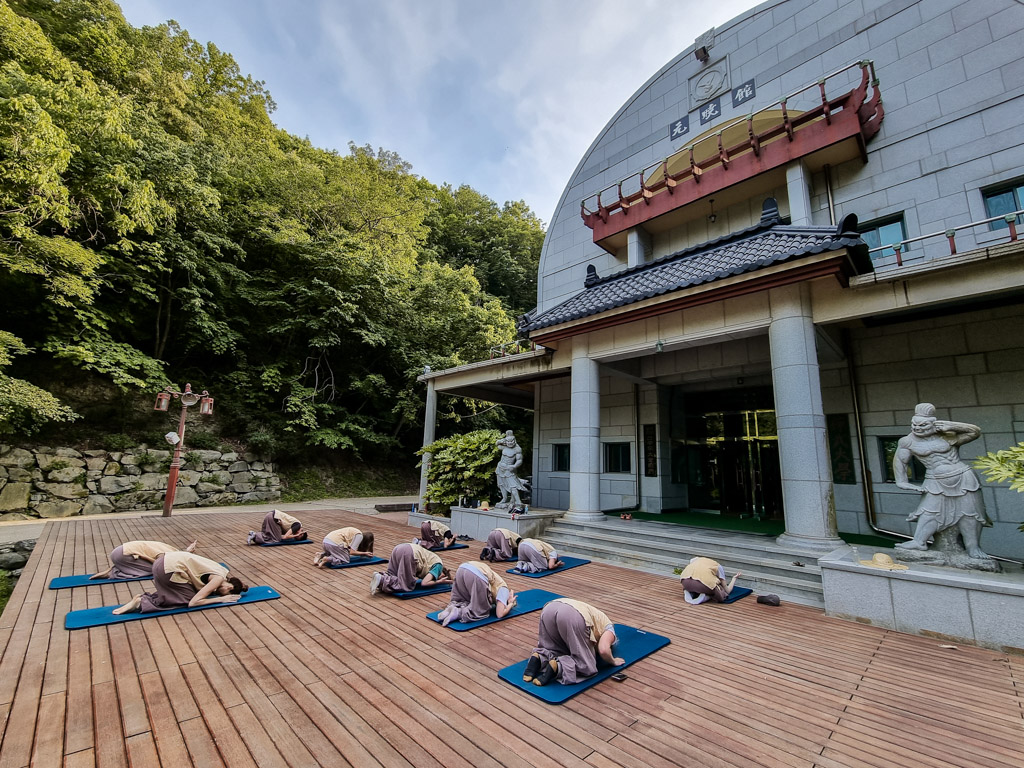
Morning Chanting Service & Meditation
After learning how to meditate with the monks, you’ll be waking up at 5 am to join in with the morning chanting service and meditation. It’s so peaceful at this time of day and a really great way to start your day. Don’t worry you’ll have time to sleep again after breakfast.
Trekking & Hiking at Gampo Beach
On weekends at Golgulsa Templestay, they take visitors on a hiking and meditation adventure. We visited Gampo Beach and meditated on the beach. It was also great to meet other visitors and locals who did the Templestay programme.
How to book a Templestay in South Korea?
The best way to book a stay at Golgulsa Templestay is through their website – Here’s the link for Golgulsa Templestay Reservations . The price is 60,000KRW per night, per person. (30krw for a pre-schooler)

We use a Joby GorillaPod 3K Pro Kit to take photos of us together on our camera, it’s so useful especially when there’s no one around! There’s also a version for a phone – Joby Phone Tripod to get the best photos on your 2 weeks in South Korea!
What is the food like at Golgulsa Templestay?
Included with the price are 3 meals – breakfast, lunch and dinner! This will be Buddhist Korean temple food which means strictly vegetarian (almost all vegan!) It’s likely you’ll have rice for all three meals with kimchi and other vegetables, it’s a really good choice of food and you can pick the food yourself.
We 100% recommend Golgulsa Templestay and if you have the time on your 2 weeks in South Korea itinerary, we would even spend 2 days. Although one night is enough to experience the lifestyle.
Day 6 – 8 | Gyeongju
Gyeongju is a museum with no walls . It was the residence of Silla rulers for over 1000 years ! It’s one of the best cities to visit in South Korea for its many archaeological sites. The remains sites and tombs from this time frame have been preserved, which makes Gyeongju a place to learn. It’s definitely a great spot to add to your 2 week South Korea itinerary!
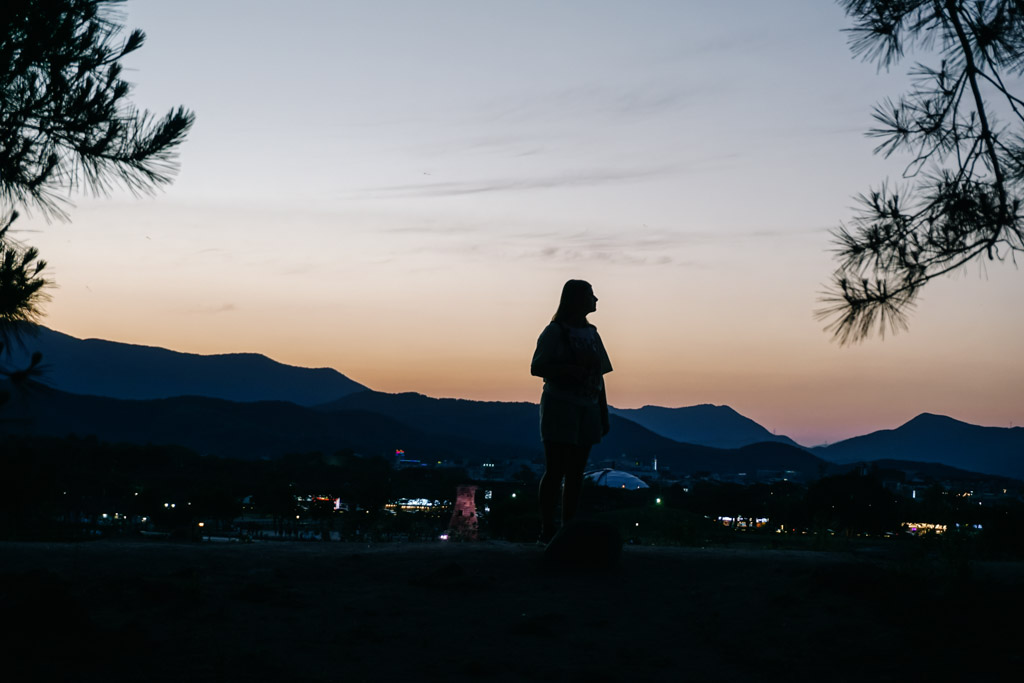
How to get to Gyeongju from Golgulsa Temple
There’s a high chance you passed through Gyeongju to reach Golgulsa Temple. If you arrived at Golgulsa Temple by bus, then you can simply follow the same way back to the city. Head to the Andong bus stop (a 15-minute walk) and then wait for a 1 50 / 100 / 100-1 , it should take around 50 minutes to get to Gyeongju city.
What to do in Gyeongju
There are many things to do in Gyeongju as part of your places to visit in South Korea itinerary – for a more in-depth guide check out of 11 Best Things to do in Gyeongju with lots of details about visiting the city.
Woljeonggyo Bridge
This beautiful bridge was built during the Unified Silla period (AD 676-935). It was burned down after this time frame and in April 2018 it was rebuilt. It’s now considered the biggest wooden bridge in South Korea. It’s also free to visit, like most things in Gyeongju.

Daereungwon Tomb Complex
An interesting way to spend your 2 weeks in South Korea is to visit Daereungwon Tomb Complex – an ancient burial site with 23 tombs. Cheonmachong Tomb is the most famous as you can see inside the tomb! There’s a lot of information and artefacts inside. The complex is 3000 won for entry.
Donggung Palace and Wolji Pond
In the Silla Kingdom times, Donggung Palace and Wolji Pond was an important palace and banquet hall for guests. It was abandoned in 1935 when the Silla Dynasty ended. However, in 1963, South Korea listed the palace as a historical site and it was beautifully renovated.
The best time to visit Donggung Palace and Wolji Pond is after sunset as the Palace glows up gold! It’s a magical place to see on your 2 week South Korea itinerary.

Cheomseongdae
Add Cheomseongdae to your South Korea itinerary if you want to see one of the oldest astronomical observatories in Asia ! It was built in the kingdom of Silla and used exactly as an observatory – to collect information on the galaxy. Check out Gyerim Forest if you’re in the area, it’s a great spot for sunsets.
Hwangnidan-Gil
This trendy street is filled with the coolest shops, the cutest cafes, teahouses and more! It’s one of the best places to find clothes and snacks in Gyeongju.
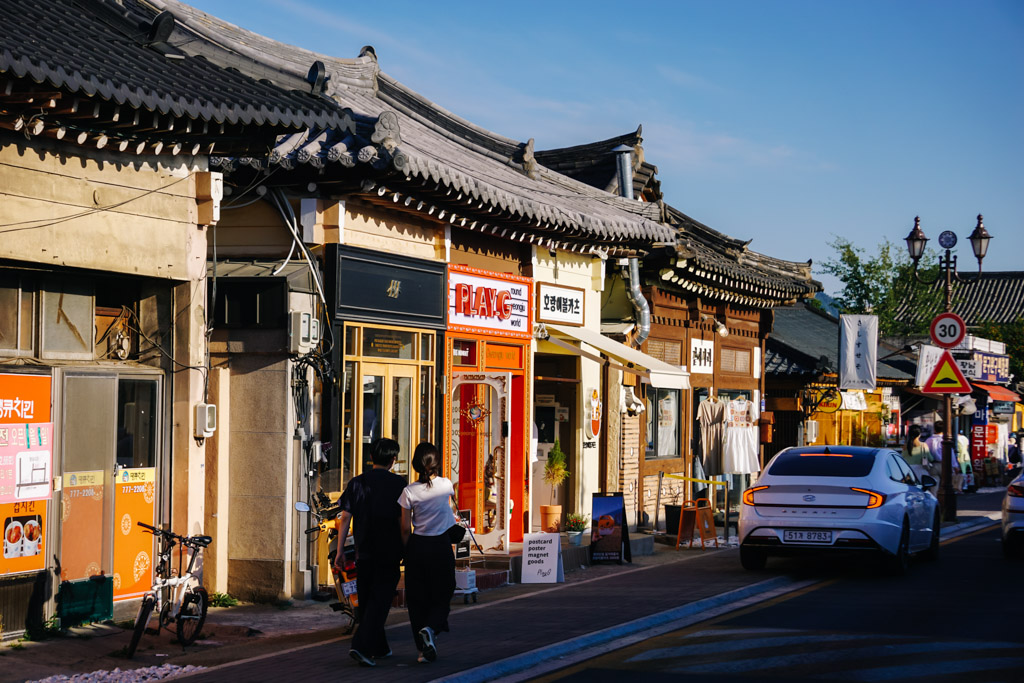
Where to stay in Gyeongju
We recommend staying in Hwangnam-dong and Noseo-dong . These areas are both close to many great sites in Gyeongju and there will be options for any budget. Bomun Tourist Complex area is also a good place to stay if you’re visiting Gyeongju World!
Doobaki Guesthouse $-$$ – Dorms & Private Rooms – We highly recommend Doobaki Guesthouse, it suits every traveller and there’s a big common area with a kitchen, games and the cutest cat! – Find here on Booking.com!
Dorandoran Guesthouse $-$$ – This guesthouse is also in a great location in Gyeongju and includes complimentary breakfast. – Find here on Booking.com !
Where to eat in Gyeongju
Top Market (Grocery Store) – Vegan instant ramens, bread, fruits & veggies! Baru $-$$ – A little out of the city centre, but a great spot for Vegan Korean food!
Day 8 – 11 | Busan
Busan is another must on your South Korea itinerary 14 days route! It’s the perfect spot to spend a few days and experience the city by the sea. There are many markets, skyscrapers and hikes to do here. Let’s explore more on your 2 weeks in South Korea itinerary!

How to get to Busan from Gyeongju
The best way to get from Gyeongju to Busan is by KTX or Bus – We recommend getting the bus because the Bus station is in the centre of Gyeongju, whilst the train station is a bus ride away. The bus will drop you off at one of Busan’s 4 bus terminals, and you can use public transport to make your way to your accommodation. It takes less than 1 hour by bus.
What to do in Busan
Here are a few of the best things you can do in Busan to fill 3 days! Some of the best places to visit in South Korea are located in this city, including amazing beaches! Check out the Visit Busan Pass if you plan to do a lot of activities in Busan.
Gamcheon Culture Village
Another must-visit on your 14 day South Korea itinerary is Gamcheon Culture Village! It’s also one of the best places to visit in South Korea and Busan.
Gamcheon Village has come a long way since the Korean war when it was populated with some of Busan’s poorest residents. After a time, the Tourism Board of South Korea chose to bring the village to life with art and soon after it became a beautiful attraction with cute cafes and trendy shops.
It’s free to enter – but you can buy a map for 2000 won which helps you find your way through the maze-like village.

Igidae Coastal Walk
If you’re looking for a long coastal walk for your 2 week South Korea itinerary, Busan is the place to be. The Igidae Coastal Walk will last between 1-3 hours and you don’t have to commit to the whole length as there’s many exit and entry points.
The walk itself is breathtaking with views of Busan, the ocean and wildlife along the way. A fun free activity on the north side of the walk is the Oryukdo Skywalk – a glass bridge with views of the rocks and ocean.
A short bus ride away from Gamcheon Culture Village is Nampo-dong – one of the coolest areas of Busan. There are many things to do in this area, including markets, bars, restaurants and shopping!
- Markets in Nampo – Jagalchi Fish Market & Gukje Market
- Gwangbokdong Food Street – The street food in Nampo comes alive at night!
- Biff Square – Another spot for street food and the annual film festival

Sunset at Lotte Department Building
The best spot for free views of Busan! Head to the Lotte Department Building and go up to the highest floor, from there you will find the garden and rooftop with views of all of Nampo and the iconic Busan Tower. It’s another great idea for your 2 week South Korea itinerary.
Also check out a visit to Lotte World in Seoul and Busan – one of South Korea’s best theme parks!
Busan Tower
Busan Tower is very famous for making up the Busan skyline. The views are very beautiful from the tower but similar to the department building. The entry price is 12,000 won to go up the tower.
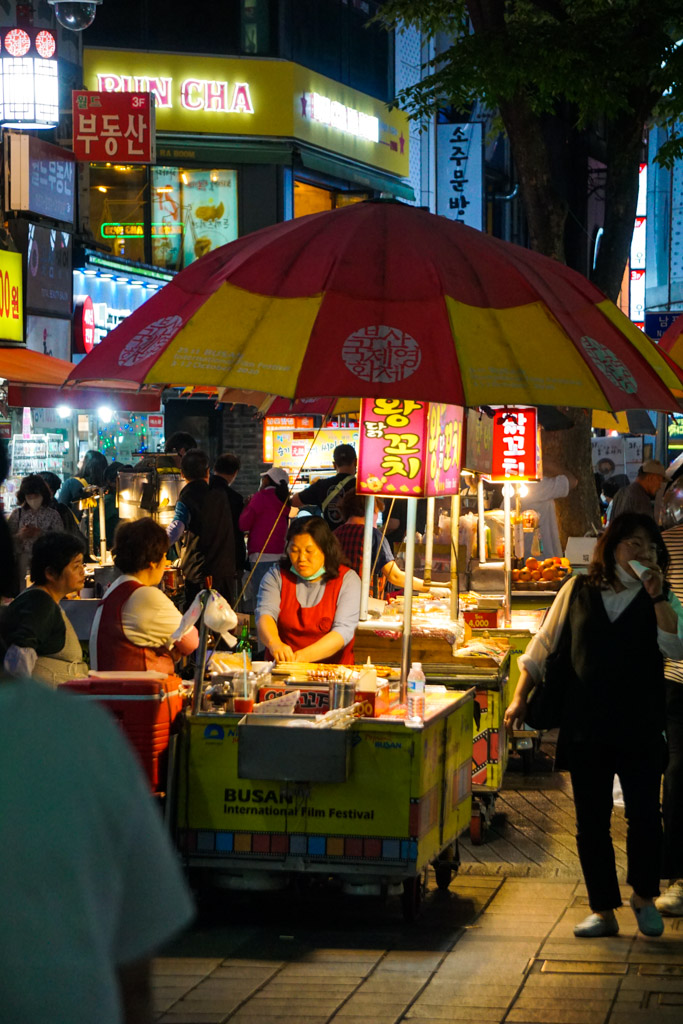
Evening in Seomyeon
Seomyeon is the central hub of Busan, it’s well-connected to all transport and you’ll definitely pass through here a few times on your trip. The area is filled with food, shops and even arcade games for you to spend a great evening on your South Korea route.
Another evening activity is the Busan Night Tour to see the magical Illumia Park.
Haedong Yonggung Temple
On your South Korea route, head to Haedong Yonggung Temple – a temple located on the amazing coast of Busan. It was built during Goryeo Dynasty in 1376 and it’s known to be one of the most beautiful temples in South Korea. It’s also free to enter!
It’s easy to reach Haedong Yonggung Temple by public transport such as metro and bus. It takes around 1 hour from Seomyeon. Use NaverMaps for the exact directions.
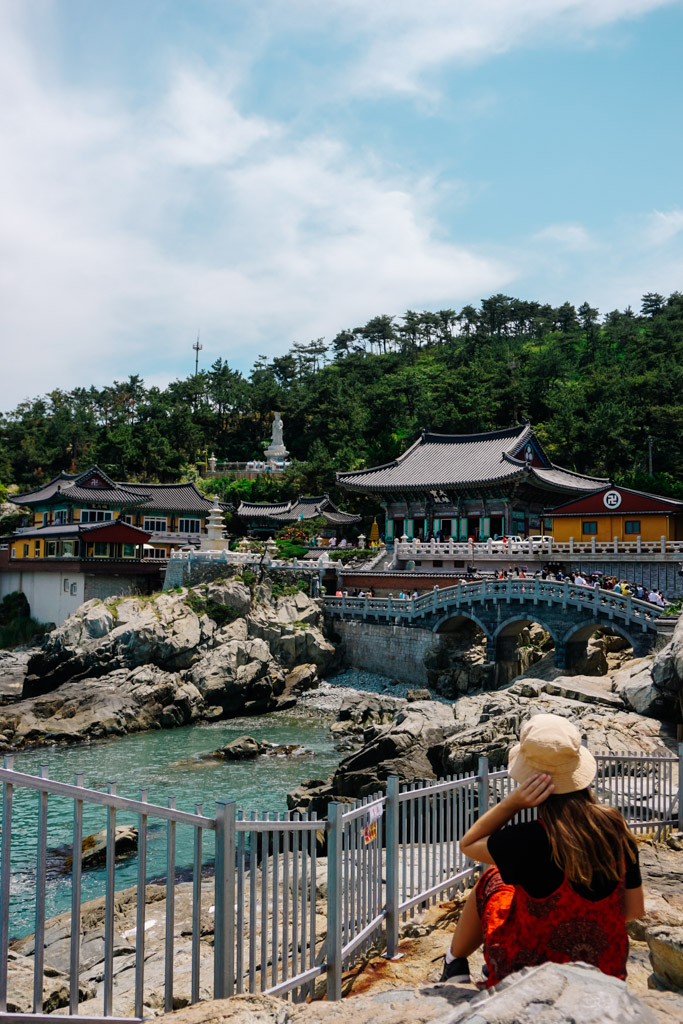
Relax at Haeundae Beach
Also on the east side of Busan is Haeundae Beach – one of the most popular beaches in Busan! Depending on the season, you’ll have different experiences at the beach. In the summer there’s many crowds but the opportunity to see festivals such as the sand festival !
There’s a long seafront to walk along with many restaurants and you can enjoy this in any season! Also check out the Haeundae Markets too! Check out BUSAN X the SKY for incredible views from the skyscrapers in Haeundae! Find tickets on Klook here .
3 Day Busan Itinerary Breakdown : Day 1 – Gamcheon Village & Nampo / Day 2 – Temples & Beaches / Day 3 – Coastal Walk & Seomyeon
Where to stay in Busan
We recommend staying in Seomyeon if you have a few days in Busan as it’s well-connected to all the great things to do in the city. There’s enough going on to enjoy your evenings after a day of exploring. Other areas to stay in are Nampo, Haeundae and Gwangan .
Dynamic Guesthouse $-$$ (Seomyeon) – Feel like a local and stay in an apartment block in Seomyeon! Located on the 36th floor are two penthouse apartments split into rooms – one of the coolest places we’ve stayed in! Find Dynamic Guesthouse on Booking.com here !
Plea De Blanc Hotel & Residence $-$$ (Haeundae) – A great place to stay during summer in South Korea. Find Plea Blanc Hotel & Residence on Booking.com here !
Where to eat in Busan
Dajeon $ (Seomyeon) – Some of the best bibimbaps! Soban Vegan Restaurant $ (near Gamcheon) – Go here for the vegan fried chicken! Doko – Dosi Nongga Cafe $-$$ (Seomyeon) – Bakery with vegan options !

Day 11 – 13 | Jeonju
On your last few days before heading back to Seoul, take the time to explore Jeonju – another great weekend trip away from Seoul! Back in 892 to 936, Jeonju was the capital of the Hubaekje Kingdom. We’ll show you why Jeonju is worth a visit and the best things to do in this lovely city.
How to get to Jeonju from Busan
Using public transport is the best way to get from Busan to Jeonju! We recommend taking the bus as it’s direct compared to the train. Head to Busan Central Bus Terminal and catch a bus heading to Jeonju, it should take around 3 hours.
Sometimes these buses can be busy and sell out, so if you want a certain bus make sure to book online (if you have a Korean number) or book ahead on your first day in Busan at the same station.
The bus is direct and drops you off at Jeonju Bus Terminal . From the bus terminal, you can take another bus to the traditional Hanok village. Use Naver Maps to double-check your directions!
Alternatively, you can take the train, however, you’ll need to change at Osong Station and it takes almost around the same time as a bus (which is usually cheaper!)

What to do in Jeonju
Jeonju is a very popular spot for locals so you’ll find a lot of souvenirs, cute cafes and you can even rent these tricycle-style vehicles to get around the city. Renting a hanbok is another popular activity here as every spot is so photographable! Jeonju is definitely worth a stop during your 2 weeks in South Korea, even if it’s for just one night.
Explore Jeonju Hanok Village
At this point, you would have seen many hanok villages on your 2 week South Korea itinerary. You don’t definitely won’t be bored of them at this point as the one in Jeonju has the largest hanok village in South Korea! It’s ultimately one of the main reasons Jeonju is a popular visit.
Explore the village in your own time and there are many cafes and teahouses around to spend some time.

Also look at 25+ Best South Korea Travel Tips: What to Know Before Visiting !
Jaman Mural Village
Another beautiful village to explore is the Mural Village just to the east of the hanok village. Since the Korean War when the buildings were rather dull, Jeonju decided to revamp them! Art such as colourful murals have made this place an attraction and even galleries have now opened in the area.
Gyeonggijeon Shrine
Gyeonggijeon Shrine is important in Jeonju and South Korea as it holds the portrait of King Tae-jo – the inventor of the Joseon dynasty. There are actually a few portraits of King Taejo that are preserved here. It’s an interesting spot to visit on your 2 week South Korea itinerary.
Nambu Market
This market is big! It’s possible to find almost anything here from food to household items and clothes to souvenirs. There’s a night market every Friday and Saturday, but it’s also open during the daytime all week.
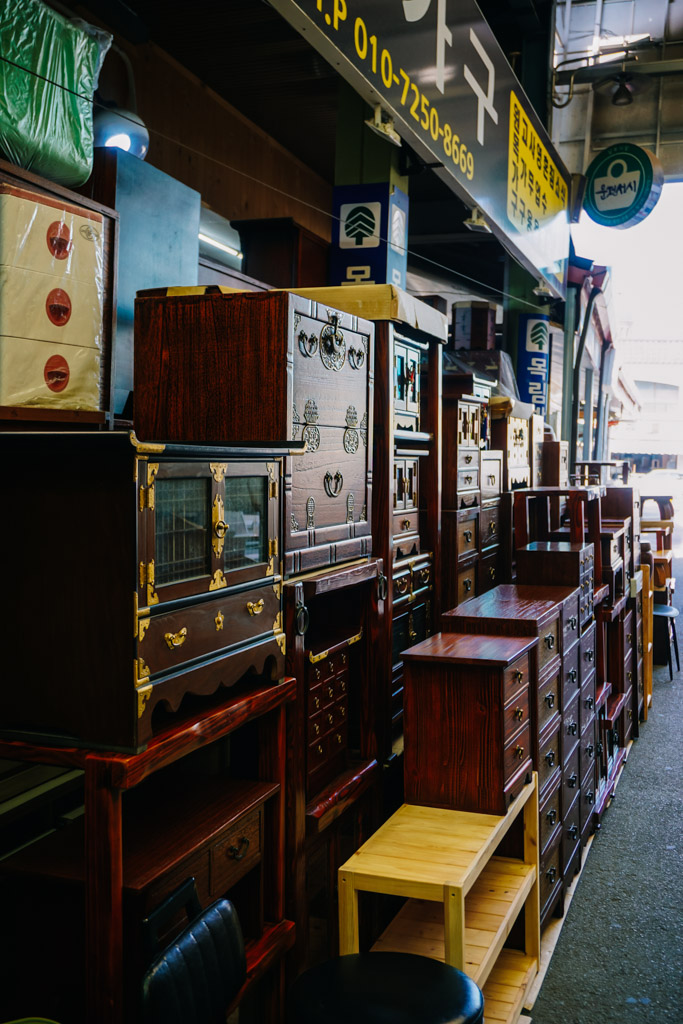
Jeondong Cathedral
Right next to the traditional Hanok village is the Old Cathedral of Jeondong – an important Catholic church in Jeonju! It was built in honour of Roman Catholics who lost their lives in the Joseon dynasty. The church was designed by Priest Poinel, who also designed Seoul’s Myeongdong Cathedral. They look quite similar too!
See the views from Omokdae
A short hike up this hill will reward you with views of the hanok village and part of Jeonju city in the background. It’s totally worth it at any time of day or season!
Where to stay in Jeonju
The best place to stay in Jeonju is around Jeonju Hanok Village. It’s very popular to stay in a traditional hanok when visiting Jeonju – and that’s exactly what we did! When browsing the internet we found many options for anyone’s budget and luckily found Jungdam that fit our budget.
Jungdam $-$$ – Right in the heart of the traditional Korean village. Jungdam is a hanok home split into many rooms for guests to come and enjoy the experience. They provide the best Korean breakfast in the morning – even suitable for vegans! Find here on Booking.com !

Where to eat in Jeonju
Jeonju is the birthplace of bibimbap! Try bibimbap from any restaurant in Jeonju to feel the authentic touch. If you’re after vegan options, here’s what we recommend!
Plantica $-$$ – The best Korean-inspired sandwiches with cakes & drinks! Pool $-$$ – Great spot for vegan Japanese food in Jeonju!
Day 14 | Seoul
Now you’re back in Seoul for the last night of your 2 week South Korea itinerary! After an incredible trip, you can tick off a few things you didn’t get a chance to do. Maybe revisit a favourite restaurant or neighbourhood? It’s completely up to you!
We spent our last day playing arcade games in Hongdae and eating at Osegye Hyang $ (Insadong) – Our favourite traditional Korean vegan restaurant in Seoul ( location )!
How to get to Seoul from Jeonju
The best way to get from Jeonju to Seoul is by bus or train! Again, we recommend the train as it’s a little less expensive and only takes 2 hours and 40 minutes. You can buy your bus tickets as soon as you arrive in Jeonju at Jeonju Bus Terminal . When you arrive in Seoul, there will be many public transport options for you to grab to get to your accommodation!
Interested in getting a Korea Rail Pass ? Check out tickets on Klook for a demonstration on how to book tickets and an easy way to receive your pass!
Where to stay in Seoul before leaving
For your last night in Seoul, you can choose anywhere that’s close to a metro line that gets to Seoul Station . If it’s available you can stay in the same place as your first time in Seoul or pick a new neighbourhood! Hongdae is another great place to stay as you can get the AREX Express from Hongik Univ Station .
Hostel Tommy $-$$ (Insadong) – We still recommend Hostel Tommy as his hospitality was amazing! It’s a great spot for 5 nights or 1 night in Seoul. It has easy connections to the airport via the metro and Seoul Station. Find the link to Booking.com here – Hostel Tommy Booking.com

2 Weeks in South Korea Itinerary Breakdown
Seoul – 5 nights, Golgulsa Templetsay – 1 night, Gyeongju – 2 nights, Busan – 3 nights, Jeonju – 2 nights & Seoul – 1 night!
Other Places To Visit in South Korea
Jeju Island – Jeju Island is the best vacation for those living in South Korea. It’s filled with nature, hikes and fresh air! You can reach Jeju island by flight from Seoul or Busan. It’s highly recommended to rent a car or motorbike whilst you’re here as the transport can take a while. However, if you have 4-5 days on the island it’s totally possible to have a great time with public transport. (We’d love to visit Jeju Island in the future on another South Korea trip!)
Seoraksan National Park – Another great escape from Seoul is Seoraksan National Park (Sokcho). It’s possible to visit here on a 2 week South Korea itinerary. If you’d like to fit it into this South Korea route, take off 1 night in Seoul and travel by bus early morning on one day and late afternoon the following day. The hikes here are pretty impressive, but possibly not for beginners.

How do I plan a 2 week trip to South Korea?
Now that you’ve read our 2 week South Korea itinerary, it’s time to truly start planning your trip! Start with focusing on what you really want to get out of your Korea trip.
As entry requirements are still around, please double-check if you’re eligible to enter the country! Also, check if you’re eligible for a visa in South Korea. Other than that, if you use this exact 2 weeks in South Korea itinerary, the first step:
- Check for any national holidays on your date of visit ( check here! )
- Quick check if places of interest are open ( sometimes things are closed on Mondays! )
- Book your flights ( check prices here! )
- Book your accommodation ( book here! )
- Book your templestay ( book here! )
- Book any trains you want to take ( book here and take a look at the Korea Rail Pass )

Is 2 weeks in Seoul enough?
Yes! 2 weeks in South Korea is the perfect amount of time to see the best places to visit in the country. We’ve created our 2 week South Korea itinerary at a good pace, so you don’t have to rush around every 2 days. We wanted to minimize our flights at the time, which is one of the reasons we didn’t visit Jeju Island, however, it’s totally possible on a 2-week trip!
Must-Try Foods in South Korea (Vegan edition!)
- Bibimbap (rice bowl with veggies!)
- Vegan Korean Fried Chicken (vegan chicken coated in a sweet bbq like sauce)
- Gimbap (similar to sushi)
- Tteok-bokki (rice cakes in a spicy tomato like sauce)
- Kimchi (there are many vegan-friendly versions around Korea)
- Baked Sweet Potato (the best street snack, sometimes covered in sugar)
We also have a Vegan in South Korea Guide – Best Restaurants & Snacks (2024) !

How much to budget for 2 weeks in South Korea?
We visited South Korea knowing it should be less expensive than the UK – and it is! It’s also slightly less expensive than in Japan. Here’s our average daily budget for 2 weeks in South Korea – South Korea Travel Costs (2024) .
How can you save extra money? Choose restaurants that aren’t so expensive, shop at convenience stores more often and stay in private rooms in hostels! Take buses over trains (although maybe treat yourself to one!)
Check out our 10 Best South Korea Budget Tips + Travel Costs (2024) !
What to pack for 2 weeks in South Korea?
This really depends on the season that you visit – if it’s winter, bring thermals, gloves and a hat. If it’s summer you may want to bring a raincoat or umbrella! Here are a few we can’t travel without:
- Stainless Steel Water Bottle – Our metal water bottles have been our side throughout it all! They are easy to clean and are better than plastic! Bring one along for your 2 week South Korea itinerary.
- Worldwide Travel Adaptor – The number one plug to have when travelling to different countries. It has one international plug and 4 USB slots to charge your gadgets at the same time.
- Amazon Basics Packing Cubes – We always travel with packing cubes and even use them at home!
- Anker Power Bank – A portable charger is always useful for those journeys around South Korea!
- Rain Mac in a Bag – A lightweight raincoat to help with tropical rain or light spring rain, we also have a backpack cover to stop our clothes from getting wet in our backpacks.
- Joby GorillaPod 3K Pro Kit – GorillaPods are a great little tripod to carry on a South Korea trip, they’re lightweight and can fit in a carry-on bag. They capture some of the best photos when there’s no one around to take a photo of you. We love our Joby GorillaPod and use it for our Sony A600 . There’s also a version for a phone – Joby Phone Tripod .
- Osprey Farpoint 40l Backpack – One of Dan’s favourite pieces of gear, perfect for long or short journeys. Better yet, it’s aeroplane carry-on compliant!
What to do after visiting South Korea
Japan – Whilst you’re in this area of the world, why not visit South Korea’s neighbour – Japan! You can find flights from Seoul or Busan that take you straight into many amazing areas of the country. Check out our Ultimate 2 week Japan Itinerary (2024) The Best Places !
South East Asia – This region of the world is filled with budget-friendly locations with beautiful beaches, mountains, culture and more! After South Korea, you may want to visit Thailand and have a relaxing vacation.
More South Korea guides:
- 5 Day Seoul Itinerary – Best Things To Do (2024)
- Staying in Golgulsa Temple: The Best Templestay in Korea (2024)
- 25+ Best South Korea Travel Tips: What to Know
- 3 day Busan Itinerary: What to do in Busan (2024)
- 11 Best Things to do in Gyeongju: Itinerary (2024)
- Ultimate South Korea Bucket List: 20 Best Things To Do
- Vegan in South Korea Guide – Best Restaurants & Snacks (2024)
- All our South Korea posts!
That’s the end of our Ultimate 2 week South Korea Itinerary: Best Places (2024)! Have the best trip to South Korea and if you need any more help planning – send us a message on Instagram (@thesunrisedreamers) or leave a comment below!
LIKE THIS POST? PIN IT FOR LATER & SHARE IT WITH OTHERS!

Don’t forget about Travel Insurance! – SafetyWing Nomad Insurance
SafetyWing is a totally flexible monthly-rolling travel insurance to help you stay safe on your trip anywhere in the world. Find out more here!
Amy & Dan are the founders of The Sunrise Dreamers. They are travellers from the UK who have been on the road since 2017 whilst living in places like England, Canada, Thailand and the Canary Islands. They share their knowledge of travelling the world with detailed travel guides and tips. They're experts in vegan travel and show their audience how to travel on a budget.
Similar Posts

The Best 10 Day Ontario Road Trip Itinerary (2024)
Planning an Ontario road trip itinerary? Here’s our travel guide on how to spend 10 days in Ontario driving through…

3 Week Philippines Route & Itinerary: Where to visit in 2024
Planning a 3 week Philippines route and itinerary in 2024? This is our detailed travel guide on how you can…

The Best El Nido Itinerary: 3 Days in El Nido
Are you planning a 3 Day El Nido itinerary? Here’s our in-depth travel guide to help you plan your trip…
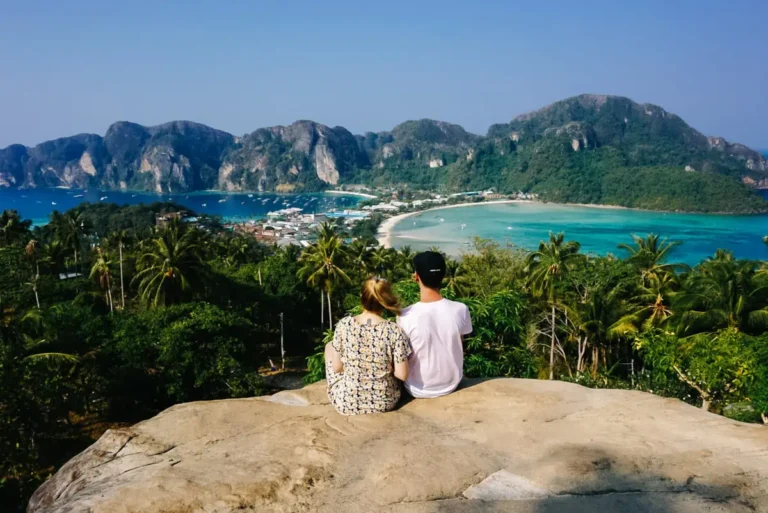
The Best 2 week South Thailand Itinerary (2024)
Wondering how to plan your 2 week South Thailand Itinerary? We’ll help you! The Thai Islands are incredibly beautiful –…

What to do in Colombo: 7 Amazing Places to Visit in 2024
Are you wondering what to do in Colombo? Sri Lanka’s busy capital city is filled with beautiful temples, hidden foodie…

The Best 3-week Backpacking Route in Europe – using Interrail!
Are you planning a 3-week backpacking route through Europe using Interrail? Amazing! It’s such a great experience and you’ll have…
10 Comments
Such a great itinerary, food & travel. Love the Jeonju Hanok Village photo 🥰
Thank you!!! 😀
This is amazing! I guess my trip for Seoul is planned! Thank you 🙂
Thank you so much! Have an amazing trip! 🙂
Hello, just curious how did you lug your luggages around between cities. Esp like to areas like the overnight stay in the temple and Jeonju?
Hey! We had backpacks for this trip but if you want to travel with suitcases, the public transport is great in South Korea, you won’t have to lug it around too much. If you have a late train/bus, ask your accommodation in advance if you can leave your luggage there for the day.
Thank you so much for writing all this up. I am adapting your itinerary and have 5 weeks to book everything before flying to Seoul. This guide is invaluable and will save me so much time. Wonder how much Hangul you could speak. Anyway, so grateful and glad I found your blog. Kudos!
Hi! Thanks so much for sharing this with us 🙂 I’m so happy you found this guide useful and that it will help you plan your trip to South Korea! We could only say Hello and Thank you, but that’s better than nothing haha!
Thanks for this amazing itinerary! Me and my friends are using it right now as a basis for our trip. We are now at Hostel Tommy and Tommy himself asked us to thank you for mentioning him and give you his regards. You’re welcome to stay for free if you ever return 😉
With kind regards, Laurens (and Tommy)
Hi Lauren, thank you so much for your lovely comment! It’s made my day – and thank you for passing over Tommy’s message, that’s so kind! I hope you’re having a great stay in Seoul and enjoy the rest of South Korea! So excited to go back one day 🙂 – Amy
Leave a Reply Cancel reply
Your email address will not be published. Required fields are marked *
Save my name, email, and website in this browser for the next time I comment.

EPIC 7 days Korea itinerary for first-timers
By: Author Kris
Posted on Last updated: January 8, 2024
Are you heading to Korea and looking for the perfect 7-day Korea itinerary? You came to the right place. Here we share what to do and where to go when you have 7 days in South Korea.
South Korea is a fascinating country. It has a rich history and offers its visitors everything from the ultra-modern capital city of Seoul to villages like Andong where it seems that time has stood still.
The country has countless National Parks, one of them even adjacent to Seoul, where we did some impressive but exhausting hikes. The park is very mountainous…
So, there’s a lot to explore in South Korea and the hospitable Koreans made our stay impeccable.
In this Korea trip blog post, we share our complete day-by-day South Korea itinerary for 7 days. We end with some travel tips for South Korea.
Perfect for your first time in Korea.
There is a really good chance that this post contains affiliate links. If you click one of them, we may receive a small commission (for which we are deeply grateful) at no extra cost to you.
In a hurry? Here we share our South Korea itinerary overview
If you don’t have time to read through the full 7-day Korea itinerary, use this overview to get an idea of the things to do each day and save it for later.
- Day 1-2 Seoul: Palaces, Insadong, traditional Hanok houses, Gwangjang market, Myeongdong, DMZ
- Day 3-4 Gyeongju: Andong Hahoe Folk Village, Royal tombs, Bulgasaka temple
- Day 5-6 Busan: Haeundae beach, Gwangandaegyo bridge, Taejongdae Resort Park, Jagalchi Fish Market, Busan Tower, Water Temple, Gamcheon cultural village
- Day 7 Seoul: Seoul tower, Bukhansan National Park
Table of Contents
How to travel around South Korea
We rented a car and went on a road trip in South Korea.
You won’t need your car in Seoul so our advice would be to pick up your car from one of the many downtown locations when you leave for Gyeongju.
You can rent a car from Rentalcars.com , QEEQ , or Klook.
Here is all the information you need about renting a car and driving in Korea.
If you prefer not to drive you can use the train. Both Gyeongju and Busan have good train connections. If you travel this itinerary by train you will save with the Korea Rail Pass .
1 week in South Korea: Our South Korea itinerary
Most international flights arrive in Seoul. This makes it the logical city to start our tour.
Day 1 -2: Seoul
Seoul represents the futuristic race the country has run over the past years. The pace at which this city has been undergoing development is similar to that of Chinese cities.
Seoul expanded enormously over the years and now houses almost 12 million people. It borders Incheon in the West and Bukhansan National Park in the North.
The highlights can be visited in a few days but you will need weeks to discover all areas of this stretched-out megapolis.

Seoul city walk
Depending on what time you arrive in Seoul you can do (part of this) walk to get a good first impression of this fantastic city.
The city counts 5 palaces. We visited Gyeongbokgung Palace, the most popular one, to watch the changing of the guards. Later on, we also went to Unhyeoungung Palace and Deosugung Palace. Those palaces are not as popular which makes them ideal for a complete and tranquil visit.
From Unhyeoungung you can continue to Bukchon Hanok Village, one of the most beautiful places in South Korea to stroll between the traditional Hanok houses.
From Bukchon it’s not far to Insadong , one of the most traditional and cultural districts in Seoul and a great place for lunch.
Make sure to drop by the beautifully decorated Jogyesa temple.
A little bit further out, but worth the detour, is Gwangjang market.
This is a traditional street market where you can mingle with the Koreans to taste some of the local street-food delicacies.
Have a look at the stalls that sell San-nakji which is raw octopus that is killed by cutting it into pieces on your plate so that the tentacles are still moving while it is served.
I can assure you that we did not try this either but there’s a lot more you can enjoy like the Soonday (blood sausage), different kinds of rice rolls, and bindaetteok, a kind of pancake.

Coming back from Gwangjang take a left at the futuristic Jongno tower towards Myeongdong .
Where you cross the Cheonggyecheon River, you will find several food trucks.
After you have discovered the Myeongdong shopping district you can make your way to the modern city hall and walk along the wide Sejong-daero boulevard back towards Gyeongbokgung palace.
Seoul Itinerary
Now that you’ve already got the first impression of this thriving capital it’s time to explore it further.
You can easily spend a day exploring the city’s palaces and Bukchon Hanok Village. A second day can be spent going to Namsan Park where you can go up the Seoul Tower. Afterward, you can visit Myeongdong and Hongdae.
If you ask us, the DMZ is also something not to be missed.
As you can see there is more than enough to do for 2 days.
We won’t go into more detail here. Instead, have a look at our detailed 3-7 day Seoul Itinerary . Our recommendation would be to focus on the first 2 days of this itinerary, but of course, you are free to create your own itinerary based on the different activities that we describe.
The ultimate Seoul itinerary for 3-7 days, 39 of the best things to do in Seoul and the 4 day Seoul itinerary.
Take our Seoul E-guide with you

For the price of a single cup of coffee, you can get our 3-7 days Seoul itinerary as a nicely formatted PDF document.
You can print it or store it on your phone so you can access it anytime during your visit to Seoul.
Have a look here for more information and a preview.
Organized Tours in Seoul
Here is an overview of the best-organized tours in Seoul. An organized tour saves you time and, moreover, the tour guide will enlighten you about the different sights you visit.
We partnered up with GetYourGuide and Klook for these activities.
We love GetYourGuide because they’re flexible. Sometimes your plans change last minute and then you want to be able to cancel your tickets and get your money back. It’s also good to know that GetYourGuide has your back when the local tour operator doesn’t show up or cancels your trip.
Klook is a trustworthy travel company headquartered in Hong Kong that teams up with local operators to offer all kinds of travel experiences.
We selected 3 excellent tours in Seoul just for you.
Visit the DMZ

Visiting the DMZ is a must-do when you are in Seoul. The DMZ area is located around 60 km up north of Seoul and can only be visited with a guided tour.
Make sure to book your tours well in advance as they often sell-out. Trips to the DMZ run Tuesday to Friday.
Book a full-day tour that includes the JSA , the Joint Security Area, the place where the 2 countries meet, and where you can step across the border and be in North Korea for a few minutes.
You can read more about the DMZ in day 3 of this itinerary and we have a full article online that compares the different tours that you can book to visit the DMZ.
Join a Seoul City Bus Tour

If you want to discover the highlights of Seoul but you are short on time, this bus tour is for you. Hop on the bus and discover the top city attractions with ease.
Perfect for first-time visitors.
Check prices and availability: Seoul City Bus Tour
Experience a Nanta show in Myeongdong or Hongdae

If you are looking for a fun night out in Seoul this nonverbal Nanta show is perfect for you. The narrative centers around 3 charismatic chefs and integrates the traditional rhythms of Samulnori with comedy and drama.
Lots of fun and perfect for the whole family.
For this activity, we decided to partner up with Klook because they often have the cheapest tickets for the Nanta show.
Check prices and availability: Nanta show
Where to stay in Seoul?
Seoul is a large city with lots of districts each with its own styles and attractions.
Here we share the best places to stay for tourists and first-timers based on our own experience.
Myeongdong – City Center
Myeongdong is right in the heart of Seoul’s city center.
This is one of the most popular places to stay.
The district does draw large crowds of tourists as well as shoppers and once the sun settles people flock to the streets to stroll along the pop-up food stalls and enjoy some of the best street food that Seoul has to offer.
You will also find plenty of restaurant options, we had some of the best dakgalbi in this district.
By staying in Myeongdong you are close to the Namsan Seoul Tower and the Namdaemun Sungnyemun gate.
Metro hotel

The Metro hotel is within walking distance of shopping areas, street food, and public transportation.
The rooms are small but clean and all have complimentary water, tea, and coffee facilities.
The hotel offers a complimentary smartphone which you can use to make local calls and take out when exploring.
The hotel offers a free massage chair to use in the main lobby which is nice after a tiring day sightseeing.
Check prices and availability:
Booking.com
Insa-Dong – Palace Quarter
Insa-dong is one of the most traditional and cultural districts in Seoul and a very touristy district. The streets are lined with souvenir shops, restaurants, and tea houses.
You are within walking distance of most palaces, the Jogyesa Buddhist Temple, Bukchon Hanok village, and Gwanghwamum square.
This is probably the best location if you’re short on time and want to visit the highlights on foot.
Sunbee hotel

The Sunbee hotel is close to 2 subway stations, the Bukchon Hanok Village, and Seoul’s city center.
There are many nice restaurants, tea houses, and cafes near the hotel.
This is an excellent location for sightseeing. The rooms are large and have good beds.
The hotel staff is always friendly and willing to help and most of them speak English.
We stayed in Gangnam the commercial district of Seoul that attracts the rich and young crowds who come here to spend their hard-earned money in the many exclusive bars, restaurants, and nightlife venues.
Its huge boulevards are lined with skyscrapers and are best enjoyed after dark when Gangnam comes alive and the huge billboards lighten up the neighborhood.
Gangnam is a little outside of the traditional tourist spots and might not be ideal if this is your first visit to Seoul.
Seoul has one of the world’s largest subway networks and the trains run frequently. Still, it took us 45 minutes to get from Gangnam to Anguk, one of the major stations in InsaDong, the Palace District.
The advantage of staying in Gangnam is that the hotel rooms tend to be a tad larger here compared to the city center.
Aloft Seoul Gangnam

Aloft Seoul Gangnam is about 5 mins walk to Cheongdam station (line 7). The subway system takes you relatively easy and fast to all the places of interest.
The hotel is very easy to reach from Incheon airport (Airport Bus 6006 literally stops in front of the entrance) and is in the nice Cheongdam Area with a bunch of good food options and coffee shops.
Nice rooms with great service. Friendly and helpful staff.
If you aren’t convinced of the above-mentioned hotels have a look at our other Seoul accommodations posts.
- Where to stay in Seoul: our post on the best areas and hotels to stay in Seoul
- Coolest hotels in Seoul: an overview of cool hotels in Seoul
- Best Airbnbs in Seoul: for those who prefer staying in an Airbnb in Seoul

How to get from Incheon or Gimpo airport to Seoul
There are 2 international airports in Seoul, Incheon International Airport and Gimpo airport.
How to get from Gimpo Airport to Seoul
Gimpo airport is Seoul’s smallest airport and lies about 50 minutes from downtown Seoul.
It is often used for domestic flights and offers a shuttle service to Tokyo.
Gimpo Airport can be easily reached by subway Line 5 and with the all-stop A’REX Airport Express.
How to get from Incheon airport to Seoul
Most international passengers will arrive at Incheon International Airport.
South Korea’s largest airport is 47km from Seoul Station , which is considered to be the center of Seoul. The airport is well-connected to this station.
Some hotels have courtesy shuttles to Seoul station but if they don’t you could continue your journey with the subway, the train, the limousine bus, or organize a private transfer.
The fastest and cheapest way
The fastest and cheapest way to get from Incheon International Airport to Seoul Station is using the A’REX Airport Express.
Check prices and availability: A’rex Incheon Airport Express Train Tickets
The limousine bus
Another option is taking the limousine bus. There are 4 lines that stop at various places in Seoul.
- 6701 Airport: Seoul City Hall
- 6702 Airport: Dongdaemun/Namsan
- 6703 Airport: Gangnam/COEX
- 6705 Airport: Jamsil/East Seoul Bus Terminal
The buses run from early in the morning until the evening.
Note that the schedule for all buses is different, so definitely check the bus hours before booking a ticket.
Check prices and availability: Seoul K lImousine Bus
Take a private and direct transfer
Depending on the location of your hotel and the length of your flight (and the amount of sleep you could get) you might not be looking forward to train and subway rides in your first hours in Seoul.
After a long flight, a private and direct transfer from the airport to your hotel will be a lot more comfortable.
Check prices and availability: Incheon Private Transfer

How to get around Seoul?
The easiest way to travel around Seoul is to use the subway.
Seoul’s subway is well-connected and quite cheap.
Single-ride cards can be purchased on vending machines with coins and bills, credit cards are not accepted.
T-money recharge card
To avoid the hassle of buying tickets for each and every ride you can opt for the T-money recharge card .
Korea tour card
If you are visiting more places in South Korea, we advise you to buy a Korea Tour Card. This is a T-money card that can be used in the whole of Korea.
In addition to the comfort of just having to tap the card whenever you use public transportation, you also get discounts at a number of popular attractions, including Lotte World, Everland, and several more.
If you have an Android phone, you can even use a digital version of the T-money card.
This card is a great deal as it is even cheaper than a regular T-money card. It costs ₩6000 and has a ₩5000 value that can be used towards rides.
Check prices and availability: Digital T-Money Tour Card for Android
Korail railPlus transport card
In addition to the subway and busses, this card can also be used on Korail’s intercity trains, including the fast KTX trains.
Some taxis also accept the Rail+ card and you can also pay your highway toll fees with this card.
Check prices and availability: RailPlus card

M-pass card
This is a transportation card exclusively for international tourists traveling in the Seoul metropolitan area.
M-PASS comes in five different durations: 1-day, 2-day, 3-day, 5-day, and 7-day passes.
You can buy your M-pass card on weekdays at the Seoul City Tower. (close to exit 10 of Seoul Station) Cash only.
Discover Seoul Pass
If you plan to visit a lot of Seoul’s tourist attractions then the above-described Discover Seoul Pass is your ideal travel companion.
The pass has a 1-day, 2-day, and 3-day variant and gives you discounted or free access to many top tourist destinations.
It also has a T-money function that will save you ₩2,500 from buying a separate T-Money card. As an extra benefit, you get one free one-way A’rex Express train ride.
Note that The Discover Seoul Pass is not always available.
If it isn’t, you can see if they have the BTS edition. It’s a 24hr edition of the Discover Seoul Pass without the T-money option.
Instead, you get a Korea Tour T-money Card as a bonus.
The BTS edition covers the same attractions as the regular Discover Seoul Pass.
Discover Seoul Pass BTS (24h+Korea Tour Card)

Day 3 -4: Gyeongju
The next stop on our 1-week Korea itinerary is Gyeongju.
As soon as you leave Seoul you will find yourself surrounded by high mountains and idyllic countryside. A stark contrast with the urban jungle of Seoul.
For the next 2 to 6 hours you will see endless green landscapes that occasionally have to make way for rugged mountain tops.
Gyeongju used to be the capital of Korea during the Silla dynasty and today it is still recognized as the cultural capital of the country.
This makes Gyeongju a must-visit on your 7-day Korea itinerary.
How to get to Gyeongju from Seoul
The fastest and easiest way is by KTX train . KTX trains travel between Seoul station and Singyeongju Station. The journey takes around 2 hours. From Singyeongju you can take a bus to Gyeongju. The bus ride adds another 30 minutes.
Don’t forget to buy a Korea Rail Pass . If you do the round trip between Seoul and Singyeongju, with a stopover in Busan, you will save with a Korea Rail Pass .
Having a rental car offers more freedom but you won’t be able to beat the time it takes for the train to reach the city. Using turnpikes the journey takes 4 hours, if you want to avoid tolls it will take somewhere between 5 and 6 hours.
The advantage of self-driving is that you can enjoy the beautiful landscape at your own pace, and make a stopover in the Andong Hahoe Folk village.

The Andong Hahoe Folk Village
On your way from Seoul to Gyeongju, you will pass the Andong Hahoe Folk Village.
Allow 2 hours for a visit to this folkloristic village. We had mixed feelings about our visit. This well-preserved village forms a valuable part of Korean culture and is recognized by UNESCO as a World Heritage site. But it is not an open-air museum.
All houses are inhabited and most are hidden behind high ramparts and closed gates. Therefore you cannot visit the houses, you can only stroll through the streets or drive through them with a golf cart as many Asian tourists do.
It feels strange to pay an entrance fee just to walk through the streets of an inhabited village.
I hope our entrance fee helps the inhabitants to conserve their village but as a visitor, I would have loved to see the inside of some of these houses and some more historical context like you get in most folk villages.
That’s why I would recommend taking a guide who can give you some context about the things you see. He or she can teach you all kinds of things about Korean culture, architecture, and religion. I’m sure we would have appreciated our visit more with a guide.
If you want to visit the Andong Hahoe Folk Village but don’t want to drive there yourself you can join an organized day tour from Seoul. If you’re a party of 3 or more you can arrange your own private group trip.
Individual tour
Private group tour

Things to do in Gyeongju
Gyeongju is a relatively small town and most sights are within walking distance.
You can see most of the highlights of Gyeongju by walking from the city center past the Royal Tombs (often compared to Teletubbies houses) and the observation tower to the Donggung Palace with the Wolji Pond.
The most charming moment to visit the Palace is after dark when the reflection of the palace in the water turns your visit into a fairytale story.
Still, it is a good idea to buy your tickets during the day so that when you come back in the evening you can walk straight in and skip the huge lines at the ticket machines.
Bulgaksa is a popular temple near Gyeongju. Recognized as Unesco World heritage it houses 7 of South Korea’s national treasures.
From the temple, you can hike to the nearby Seokguram Grotto which is part of the temple and also recognized as Unesco World heritage.
It’s a scenic 45-minute uphill walk. It is a small but peaceful temple with a stone-carved Buddha in the cave.
No photographing is allowed and a glass wall has been put up to protect the interior of the cave.
Where to stay in Gyeongju
Gyeongju gg tourist hotel.

We stayed at the Gyeongju GG Tourist Hotel. The hotel lies in a good location right in the city center near the bus terminal.
It’s easy to walk to the Royal tombs as well as the other UNESCO World Heritage sites in the ancient tomb complex.
The hotel has spacious and comfortable rooms with a big bathroom.
The only negative that we can say is that the walls of the room are quite thin. We had a lot of noise from our neighbors who were arguing until late at night. But I suppose we were just unlucky with our neighbors this night.
If you have a car you can also opt for a hotel near Bomun lake where you can take long walks around the lake.
Hotel Lahan Select Gyeongju

Hotel Lahan Select Gyeongju offers comfortable rooms with a balcony.
The hotel is in a great location next to the lake, a stroll around the lake is lovely, certainly during the cherry blossom season.
The hotel has a buffet restaurant, Chinese restaurant, coffee shop, bakery & wine shop, kids’ play area, and video gaming room.
The professional hotel staff speaks English.

Day 5 – 6: Busan
Next on our list is Busan , South Korea’s fastest-growing city. A fishing village bursting at the seams.
Getting to Busan
If you travel by train, the journey from Gyeongju to Busan takes about 1 hour.
You will first need to jump on the bus to Singyeongju station where you can board a KTX train for Busan.
If you drive yourself it will take 2 hours if you use the toll roads or 30 minutes more if you avoid them.
Things to do in Busan
Busan is located along South Korea’s southeastern coast. It has some wonderful beaches and draws huge crowds during the summer months.
Haeundae beach is a nice place to stay if you fancy a romantic stroll on the beach before you retire to your hotel room.
The nearby Dongbaek park offers splendid nocturnal views on the 7-km long Gwangandaegyo bridge, better known as the Diamond bridge.

On hot days you can cool down in the Shinsegae Centum city shopping center.
Holding the record of the world’s largest shopping complex you will be able to tie on your ice skates and practice some rounds on the ice rink or relax in Spa Land.
An enormous spa complex with 22 different spas and a mixture of 13 different Korean traditional ‘Jjimjil-bang’ saunas and saunas from all over the world.
Busan’s Sea Life Aquarium is also in Haeundae. It’s highly regarded, certainly by couples with kids. If you visit the aquarium you can save a lot of money by buying discount tickets online here.
There are over 3500 islands to discover in South Korea. One of the most famous and beautiful is Jeju island.
In the center of Busan, you will find the Busan tower and the Nampodong & Jagalchi markets.
A little outside of the city is Taejongdae Resort Park, a peninsula that offers breathtaking views, and the Instagram-worthy Haedong Yonggungsa temple.
Also worth mentioning is the colorful cultural village of Gamcheon. Due to the photogenic stacked houses, this place is very popular with tourists.
Busan has loads more to offer. We recommend that you follow our 2-day Busan itinerary .
- We wrote a complete article about what to do in Busan, you can find it here.
- If you are looking for a Busan 2 day itinerary, click here.
- Wondering what to do in Busan at night, click here.
- If you have still some time left in Busan, you could consider making a day trip. Here is an overview of the best day trips from Busan.
Organized Tours in Busan
Busan lacks the efficient public transportation network of Seoul. There is a metro network but many of the tourist sights are far from the subway stops and will require a ride by bus. A car is therefore still useful in this city.
For those who do not have a rental car, we share some organized tours below. With these organized tours, you can efficiently visit the different sights.
You will not need to plot out your own itinerary and you won’t lose time waiting for the bus.
Busan Private Tour with a Local

If you are like us and you don’t like group tours, this private tour might be something for you.
With this tour, you will have the chance to explore Busan with a local guide who will customize your tour in line with your personal interests.
Perfect if you want to learn more about Busan but you don’t like group tours.
Check prices and availability: Private customizable Busan Tour
Busan Night City Tour

Busan is well known for its amazing night views. This tour is for you if you want to discover the city at night and take awesome night pictures.
Check prices and availability: Busan night tour
If you didn’t find what you were looking for, take a look at our overview with the best Busan day tours.
Where to stay in Busan
Here’s a complete list of excellent places to stay in Busan .
Below is the hotel where we stayed during our last visit to Busan.
Shilla Stay Haeundae

We stayed in the brand new Shilla Stay Haeundae hotel, located right in front of Haeundae beach.
The hotel has soberly decorated modern and comfortable rooms.
They have a rooftop bar which is a great place to hang out. The hotel is within walking distance of many restaurants.
- Here’s our complete guide about where to stay in Busan.
- If you prefer Airbnbs, have a look at our post in which we share the best Airbnbs in Busan.

Day 7: Seoul
The last day of your 7-day South Korea travel itinerary takes us back to Seoul to spend more time in this huge metropolis.

Several viewpoints offer dramatic views of the vastness of Seoul.
The Seoul tower and Seoul sky (in the Lotte world center) are perhaps the 2 most known and most accessible while the vistas from Bukhansan National Park are not as widely known.
The views from the park are at least as good and we absolutely recommend that nature lovers reserve some time to visit the park.
The trail that leads up to the Bogungmun gate of the old fort is tiring but once you reach the top you are rewarded with a beautiful view of the park and the vast city.
From here you can follow the ramparts of the old fort to the Daeseongmun gate where you can go back down via another path.
You can also use your last day for a great day trip (or weekend trip) from Seoul.
Here is an overview of more fun things to do in Korea.
If you have 2 weeks in South Korea, check out this post.
South Korea travel tips
Let’s end this Korea itinerary blog with some Korean travel tips.
What’s the best time to visit South Korea?
May, September, and October are the best months to visit South Korea.
June, July, and August are rainier and hotter with temperatures reaching 25 to 30 degrees. Moreover, the risk of typhoons is also greater.
In May everything starts to bloom and in September and October, the autumn colors make the landscapes very photogenic.
We visited South Korea in April and had 2 rainy days over the course of 2 weeks and a half.
Here is a step-by-step guide to planning your trip to Korea.
Going independent or joining an organized tour
We found it easy and straightforward to create our own travel itinerary for South Korea. Korea is a very modern country, we could book and arrange everything online.
We also found it pretty easy to travel around the country independently.
But if you don’t want to travel independently you could join an organized tour. TourRadar is a trustworthy company where you can book an organized tour.
If you prefer an organized tour, have a look at our overview of the best Korea package tours.
Cheap flights to South Korea
If you want to score cheap flights to Korea we advise you to have a look at Momondo and Skyscanner .
Both are flight aggregators that compare several hundreds of booking sites and give you an overview of the best flights and the cheapest sites to book them.
Momondo and Skyscanner are both very good at finding good deals, of the two, Momondo is probably the one with the most intuitive user interface.
Wondering how to find a cheap flight? Have a look at this post.
Do I need travel insurance for Korea?
Travel Insurance is something that can be overlooked when you prepare for your vacation.
Certainly when you’re traveling to a safe and civilized country. We didn’t get travel insurance for our first vacation.
A few years later we both took out new credit cards that came with travel insurance and relied on those. We know better now…
Overall, chances are slim that you will encounter any problems while traveling through a civilized country such as Korea. But when things go wrong in civilized countries, the medical costs can be high.
We learned it the hard way when we once had to visit a hospital in the United States. The medical care was excellent but we had high out-of-pocket expenses as it turned out the insurance that came without credit cards didn’t cover these costs. It turned out we were underinsured.
Drawing up a travel insurance policy may seem expensive at first but it can potentially save you a significant sum, significantly more than the small insurance fee.
Good travel insurance, such as the one from SafetyWing and HeyMondo , covers things like medical expenses, trip cancellation, overseas medical costs, evacuation, baggage damage or loss, and theft.
Exploring South Korea by car
We would encourage you to explore South Korea by car. There’s nothing wrong with the public transit system in cities like Seoul. But there’s nothing that can beat the freedom of having your own car.
You’re the master of your own schedule and you just need to load your bags in your trunk.
Taking the train often means that you will be dragging your bags up and down several flights of stairs.
Yes, there’re elevators but they’re not always very easy to find.
So here we will share what you need to know to do the perfect South Korean road trip.
Money in South Korea
Cash is king for visitors. Koreans can swipe their cards everywhere but foreign cards are not always accepted.
There were many ATMs at Incheon airport and it took us at least an hour to find one where we could withdraw cash. Most tourists were helping each other by pointing out other ATMs to their fellow tourists. It seems all foreigners were having the same problems.
Once we had left the airport things didn’t get better. It was always a hit or miss with the ATMs we tried.
Most wouldn’t accept our cards, but some did. Usually, we never suggest bringing cash but it looks like it may be a good idea to bring some cash to South Korea.
And once you have found an ATM that gives you cash make sure to withdraw enough! We couldn’t use our credit cards for toll fees. We had better luck in restaurants and gas stations where our cards were usually accepted.

Safety in South Korea
We didn’t encounter any problems whatsoever (except getting cash :-)) during our week in Korea but if you would you can call the travel hotline in 4 languages (Korean, English, Japanese and Chinese) 24/7.
Internet in South Korea
South Korea has the fastest internet in the world. A lot of places offer free WiFi. We don’t know why, but we didn’t always manage to get on the wifi.
Because we used quite a few apps to help us to travel around Seoul and to check for the best places to eat we bought a local sim card.
This way we were certain that we always had internet.
You can purchase your SIM card here or read our full post about what’s the best SIM card for tourists.
We used our own Pocket WIFI device to share the 4G connection but if you don’t have a device of your own you can also rent one online and pick it up at the airport.
Rent your Pocket WIFI device or read our full post about the best Pocket WIFI device.
Handy South Korean apps
Mangoplate is the app to check for restaurant reviews and the best places to eat.
Naver Maps is your GPS companion for your road trip.
Google Maps navigation is not working in South Korea and despite some people reporting that Waze was working for them, it was not for us.
The Naver Maps app is available in English (their website is only in Korean) and the app’s look and feel is very intuitive and very much similar to any other GPS app.
Available on: Google Play – Apple (This app is not getting much love for its Apple version. We used the Android version which worked like a charm)
Korea Seoul Metro Navi
Korea Seoul Metro Navi will guide you quickly and efficiently through Seoul’s extended subway system. The app calculates the fastest route to your destination.
Available on: Google Play – Apple
If you plan on taking taxis, we recommend that you use the Kakao Taxi app.
Available on: Google Play , – Apple
Here is a list of more travel tips for Korea.
Did you ever visit Korea? What do you think is the best itinerary for South Korea?
Let us know in the comments.
If you like this article, pin it

Tuesday 12th of November 2019
Great guide, thanks very much. I've been looking for a good week-long itinerary to recommend to people visiting Korea.
We do our best to provide in-depth information.
Monday 29th of April 2019
Very well written and it helped me a lot! I am planning a 1-week trip to South Korea this September.
Thanks Margaux, glad you love it. Enjoy your time in South Korea!
Thanks, we do our best to provide in-depth information.

10 Days in South Korea: The Perfect South Korea Itinerary
South Korea may look relatively small on a map, but make no mistake about it – it’s packed with history, culture, and insanely good food. I’ll help you navigate the big cities and countryside villages to plan a perfect 10-day trip.
Few places embrace futuristic design the way that South Korea does in cities like Seoul – with a subway system and buildings like Dongdaemun Design Plaza that look like something straight from a science fiction epic.
But don’t get it twisted – there’s also a deep commitment to preserving traditional culture you’ll find in nearly every corner of the country, from the ongoing custom of wearing the ornate Korean hanbok dresses in smaller cities like Jeonju to the beautifully preserved urban palace and gardens at Changdeokgung.
I just got back from spending several weeks in this gorgeous country and I learned a ton from this trip. After returning from South Korea, I paged through my notebook (and memory bank) to develop a perfect travel plan so you can make the most of your visit.
Ready to learn more? Here’s everything you need to know for your South Korea trip.
PS: Wanna take a sneak peak? Watch the video on YouTube!
Watch on YouTube
South korea itinerary , days 1-2: seoul .
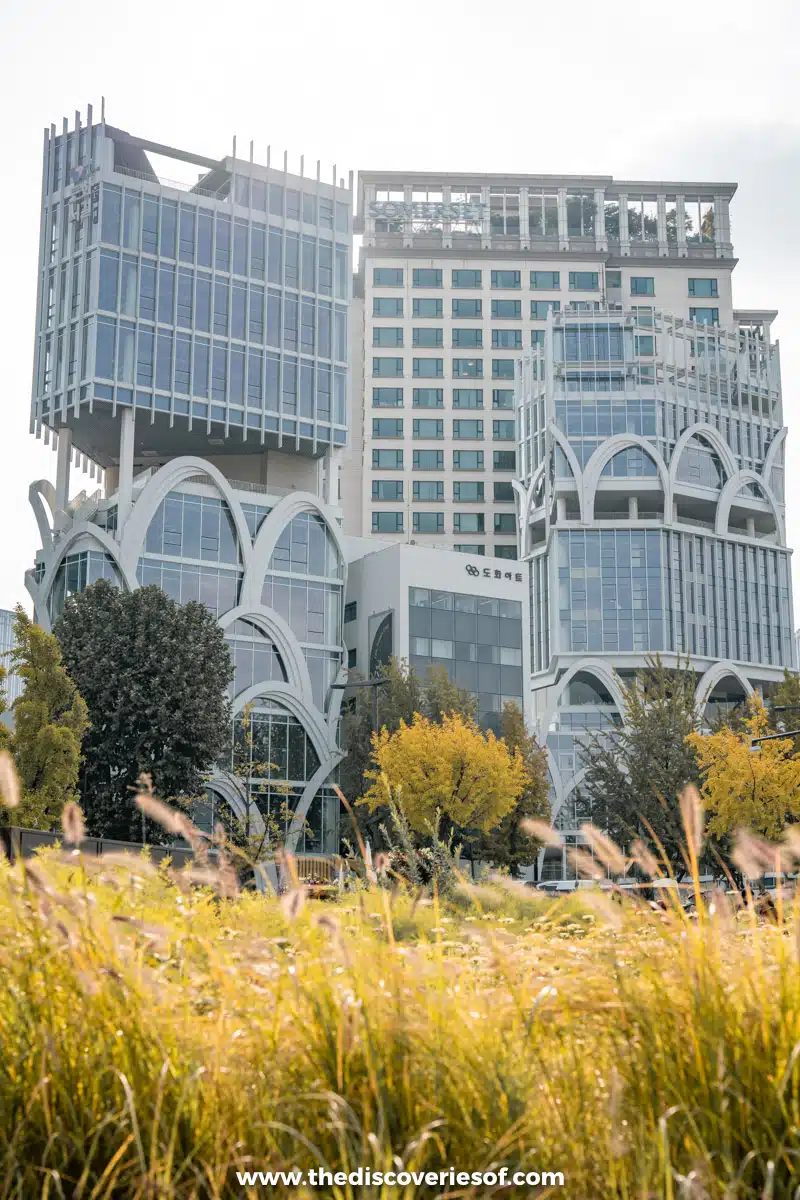
Few cities in the world balance old and new as well as Seoul does. Facts.
On my most recent trip, I found myself moving from ancient landmarks like the royal Joseon dynasty estate of Gyeongbokgung Palace to N Seoul Tower, where the bright neon lights from 237 metres (777 ft) encapsulate the city’s pursuit and perfection of modernity like no other vantage point I’ve seen.
Stroll through the charming Samcheong-dong area for some of the best shopping in the city and a look into the exciting neighbourhood filled with jazz clubs, cocktail bars, and hair salons where you might run into your favourite K-pop singer. The trendy boutiques featuring local art or K-beauty supplies seem perfectly at home near classic Korean Hanoks (houses) and bustling business districts, which speaks to the balance of history, commerce, and a trend-setting drive that makes Seoul one of the most interesting cities in the world.
Things to Do in Seoul
Visit changdeokgung palace.
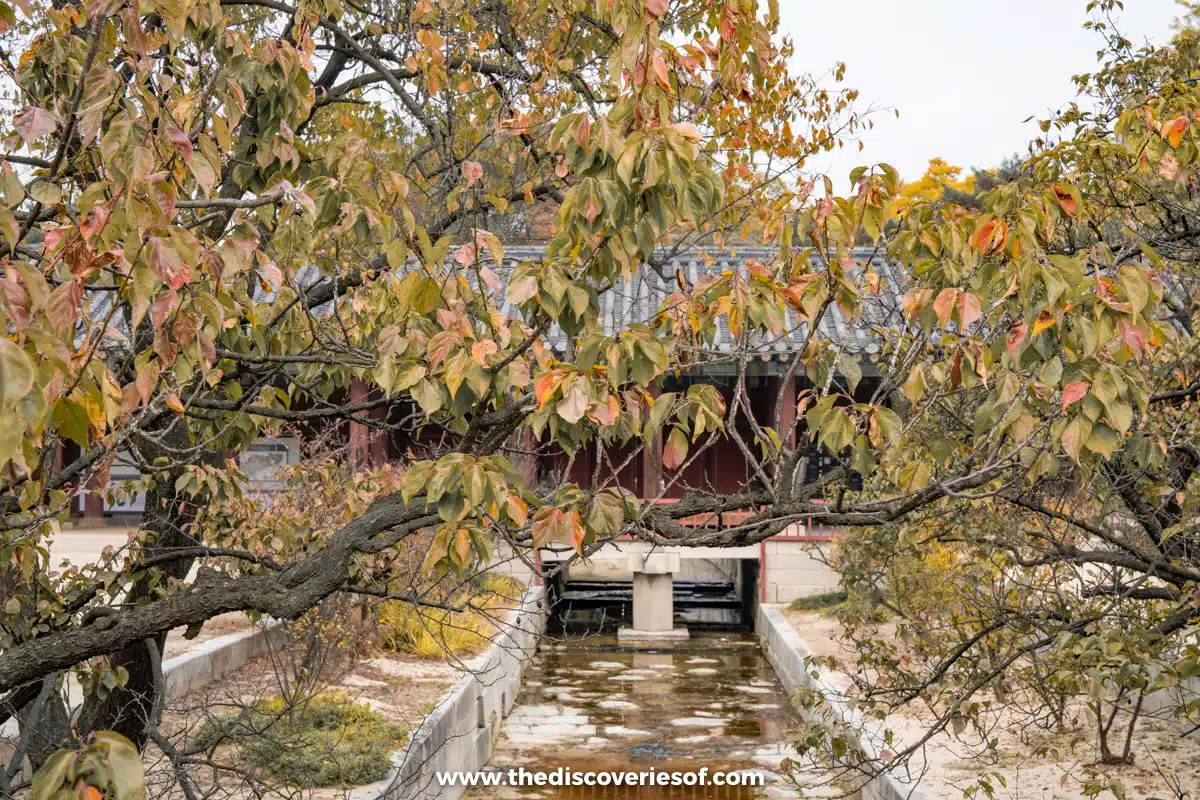
What’s the best way to kick off a 10 days in Seoul itinerary? Tap into the history and culture of the city. Visiting a Joseon Dynasty Palace offers a peek into the 500-year rule through a lesson in history and architecture. Changdeokgung Palace was my favourite, as the extensive palace and secret gardens really gave a sense of what life was like for Korean royalty for centuries. It’s an affordable tour, for just £6.10 ($7.70).
Alternatively, you can visit Gyeongbokgung Palace, where many of the original Joseon Dynasty Grand Palace buildings have been restored since being destroyed under Japanese occupation.
See the Views from N Seoul Tower
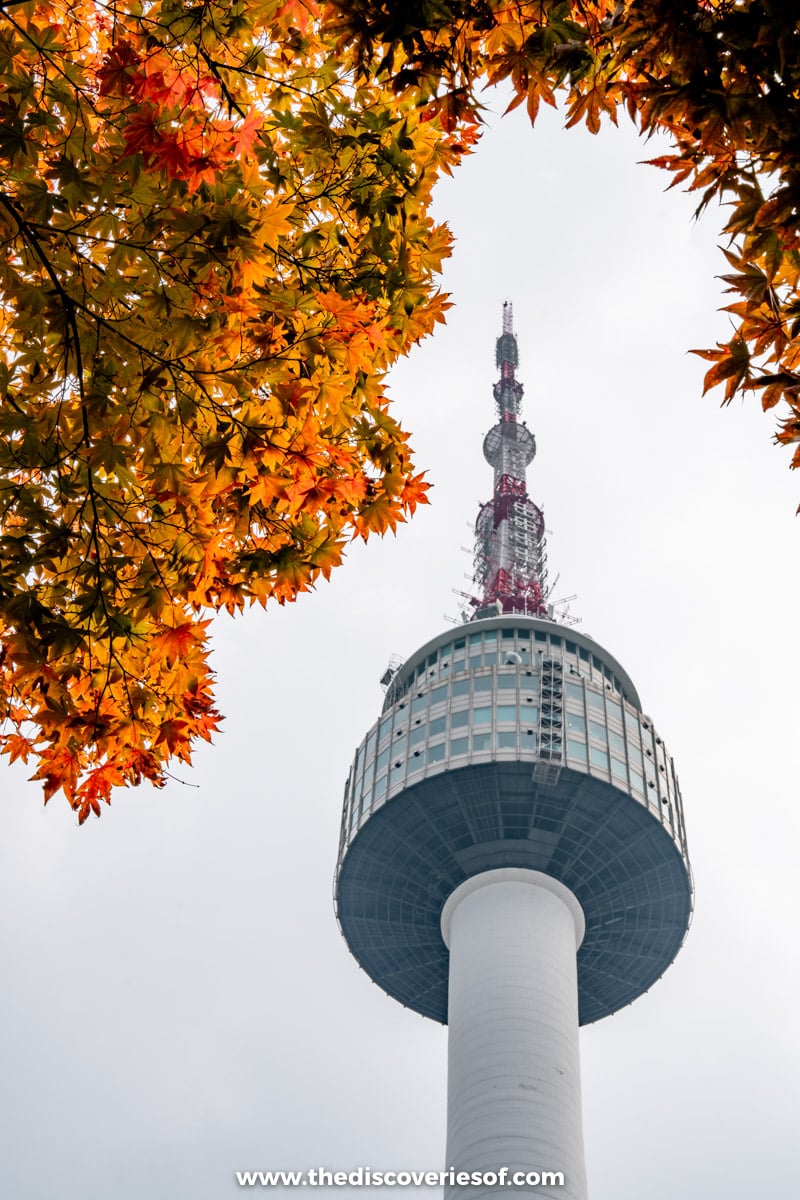
If you only make time for one viewpoint, you need to see the panoramic city views from the top of N Seoul Tower. High up on a hill, you can either walk or take the Namsan Cable Car to the top for gorgeous views from the landmark’s observation deck that doubles as a radio tower. I opted for the latter, and after elbowing my way to the window, my reward was spectacular views all the way up
Eat at Gwangjang Market
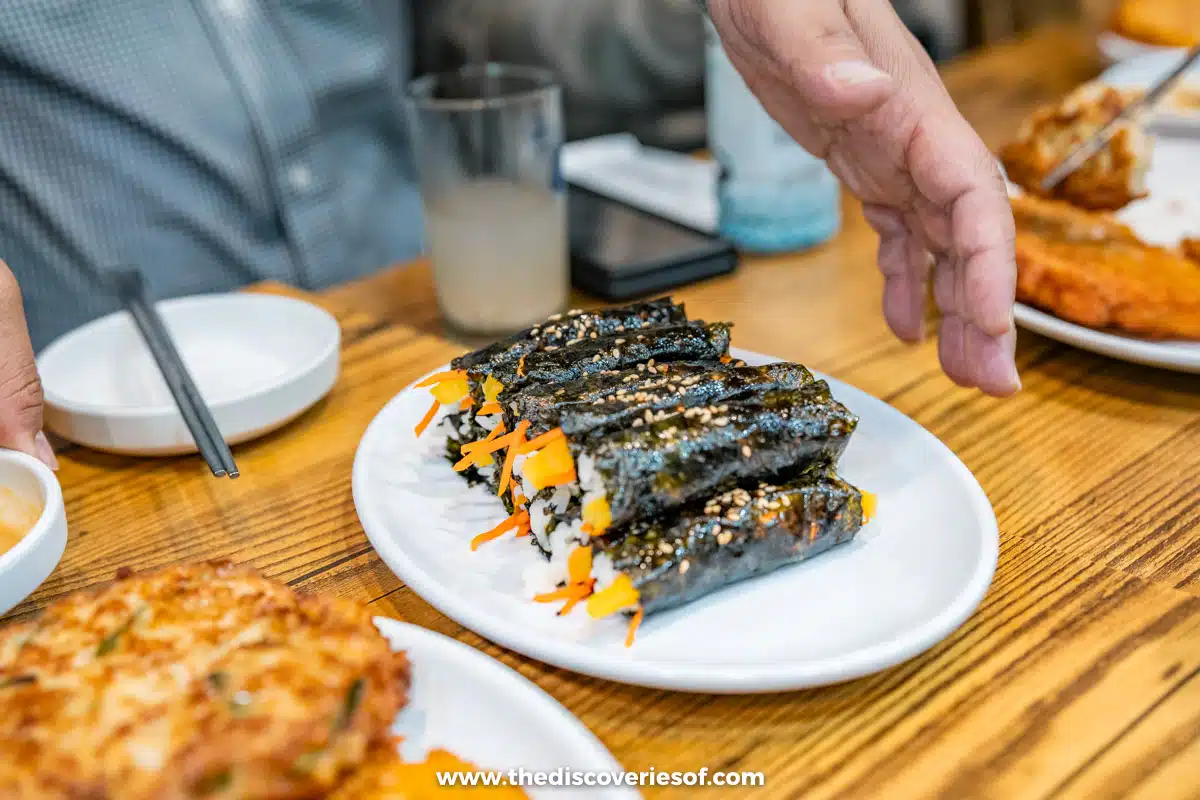
Whether you go for lunch, dinner, or both, visiting the iconic Gwangjang Market offers you a taste of why Seoul is literally heaven on earth for foodies. Try the fish cake soup (Eomukguk) and hand-cut noodles in anything you see. Only have time to try one dish? Try mung bean pancakes.
Head to Sunhui-ne Bindaetteok as early as possible to dive into the mung bean pancakes that are crispy, savoury, and oh-so-addictive.
Explore a Hanok Village
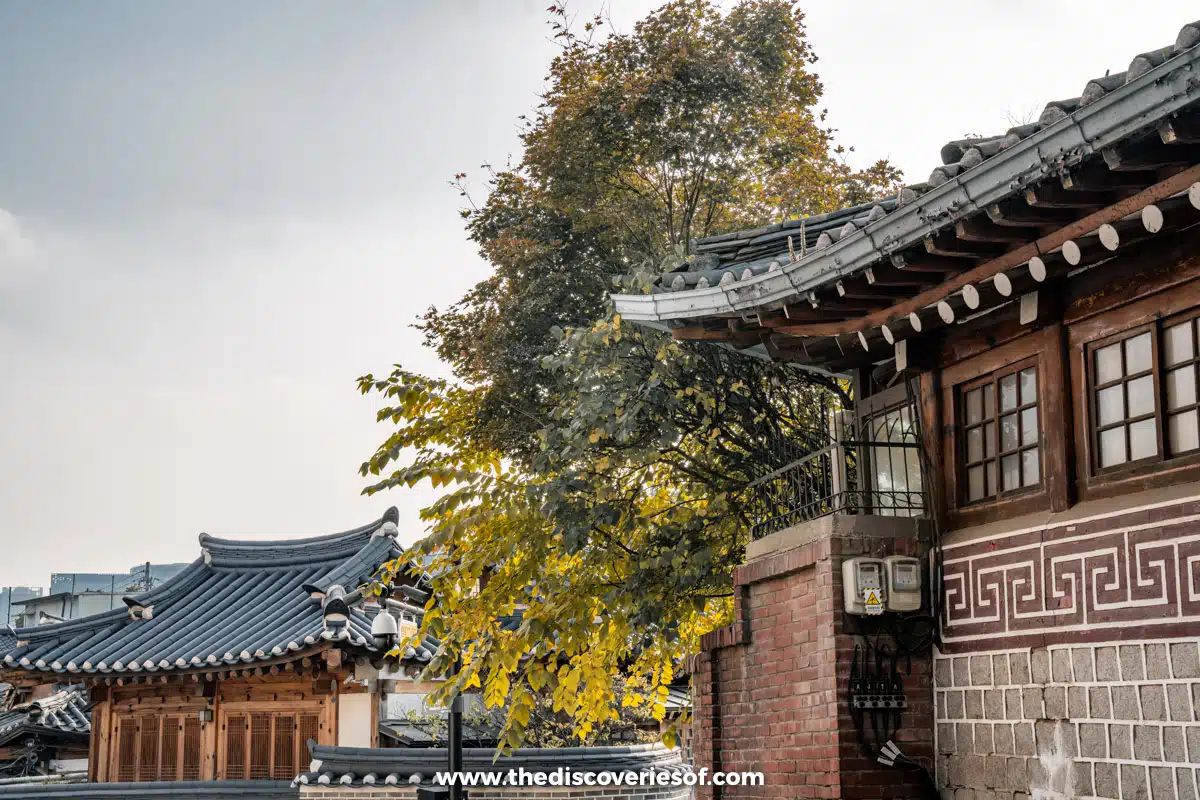
Whether you’re walking around the peaceful Namsangol Hanok Village, or exploring the bustling Bukchon Hanok Village, seeing the traditional homes made of pine, stone, and tile is another example of the well-preserved history in Seoul. The ancient homes (some dating back over 500 years) are now home to museums, shops, and tea houses, but Bukchon is still a functioning neighbourhood at its heart.
Unmissable Things to do in Seoul
Getting to Seoul
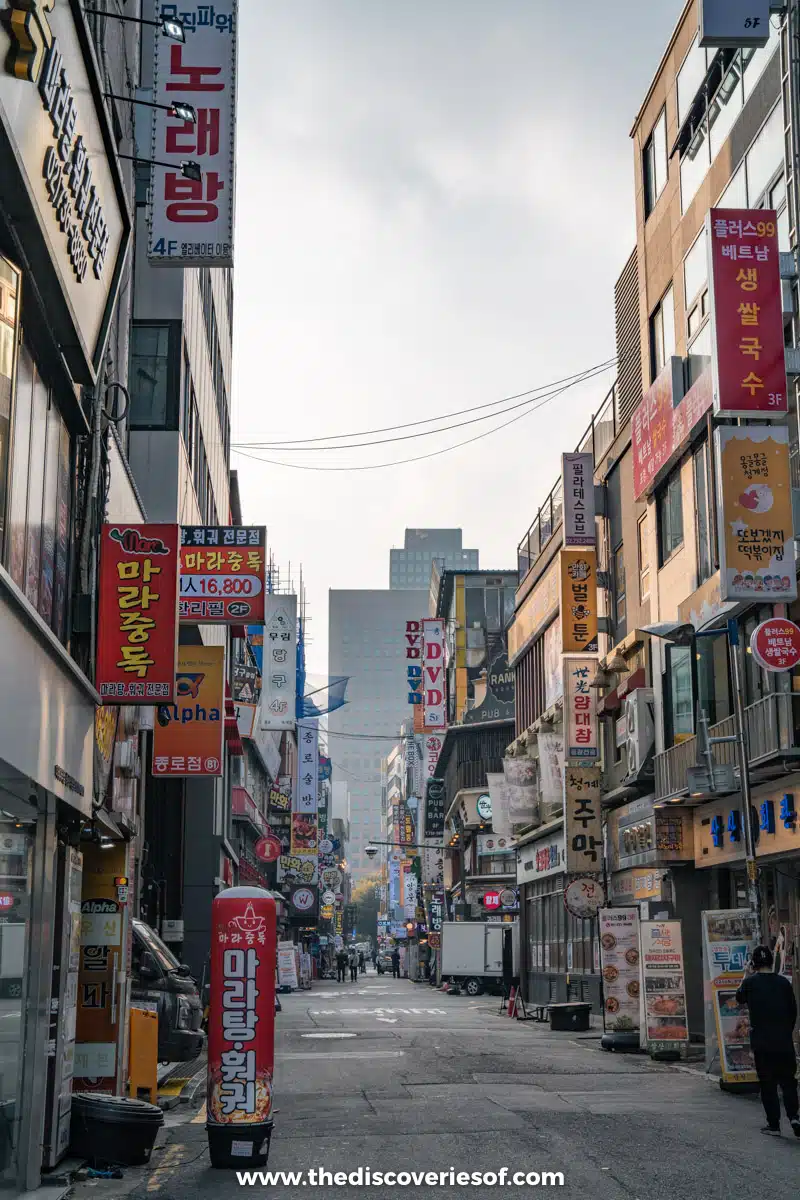
You’re most likely going to land at Incheon International Airport in Seoul, no matter which country you’re visiting from. From there, you can take a train from the terminal to Seoul Station before transferring to the Myeongdong Station and walking to your hotel. In all, it will take you just under 1.5 hours to get from your terminal to your hotel if you stay in Myeongdong.
Suggested Stay
Base yourself in Myeongdong when you’re in Seoul for access to the city’s top landmarks, restaurants, and transportation. The Four Points Josun Seoul Myeongdong offers comfortable (if a bit bland) accommodations that do have some of the better views of the gorgeous skyline. Rooms are on the small side but clean and cosy. The breakfast was a highlight, with Korean and Western options – my favourite was the made-to-order noodle station.
Check Prices and Availability for Four Points Josun Seoul Myeongdong Alternatively, Check All Accommodation in Seoul
Days 3-4: Andong
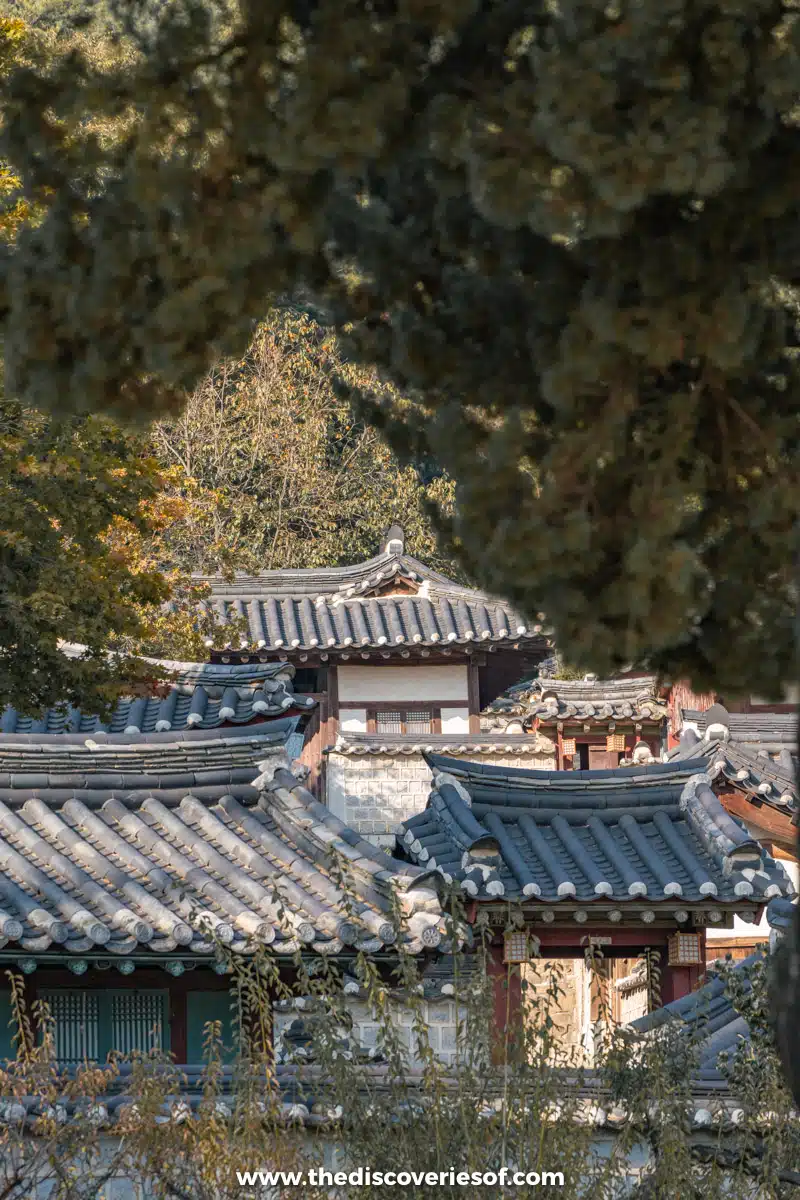
When you arrive in Andong, it’s not hard to notice a stark contrast from the bustling capital of South Korea. While walking through Seoul is an exercise in back-and-forth time travel from past to present to future, Andong is mostly rooted in centuries-old traditions and culture. I’m not complaining. I found it refreshing and enlightening to explore the UNESCO World Heritage sites like Dosan Seowon Confucian Academy, taste new (but ancient) flavours in places like Andong Set Menu Restaurant 한상채비, and walk across the Nakdong River on the country’s longest pedestrian-only bridge.
Things to Do in Andong
Dosan seowon confucian academy.
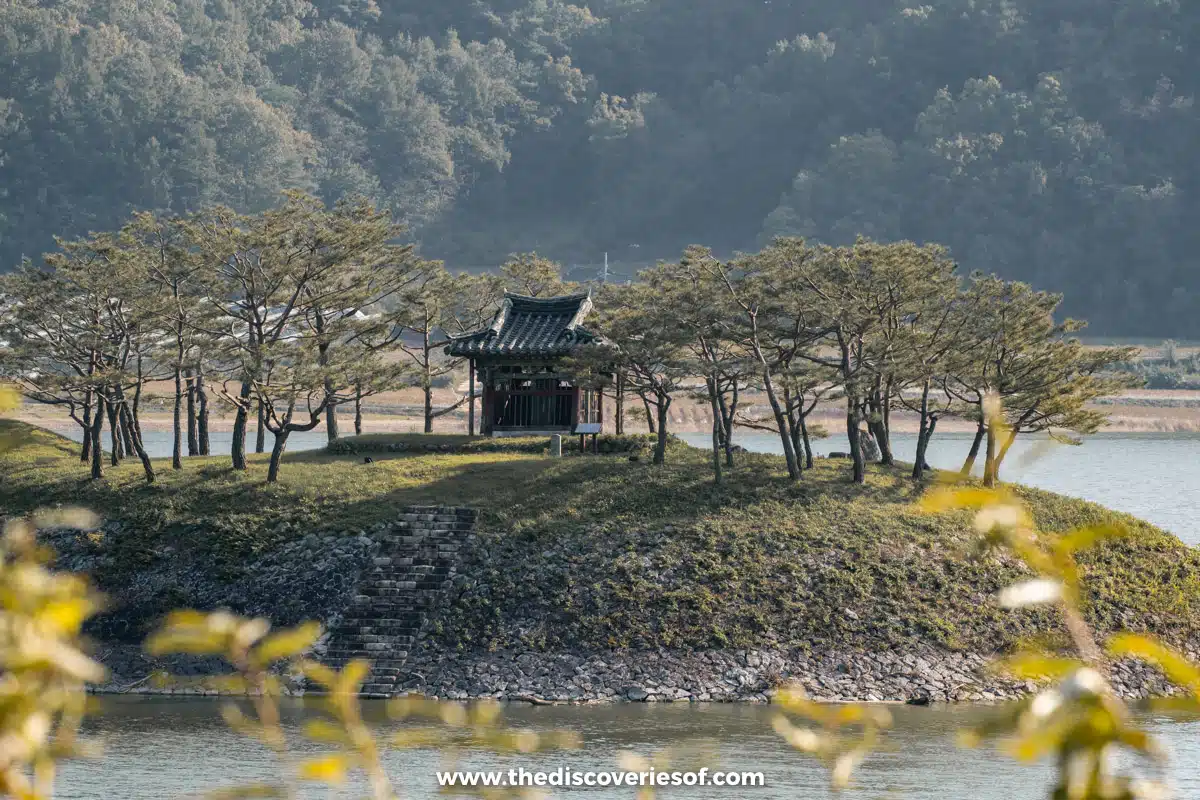
Confucianism is most commonly associated with China, but it also played a key role in Korean culture.
Yi Hwang was a well-respected Confucianist teacher in Andong, and his students created an academy after he passed away in the late 16th century. Confucianism began to fade away after the Joseon Dynasty no longer ruled Korea, but the Dosan Seowon Confucian Academy never closed. It’s a beautiful place with 17 beautiful Joseon-era buildings, and it’s no surprise it fostered deep thinking and centuries of teaching in its tranquil location by the large lake.
Dine at Andong Set Menu Restaurant 한상채비
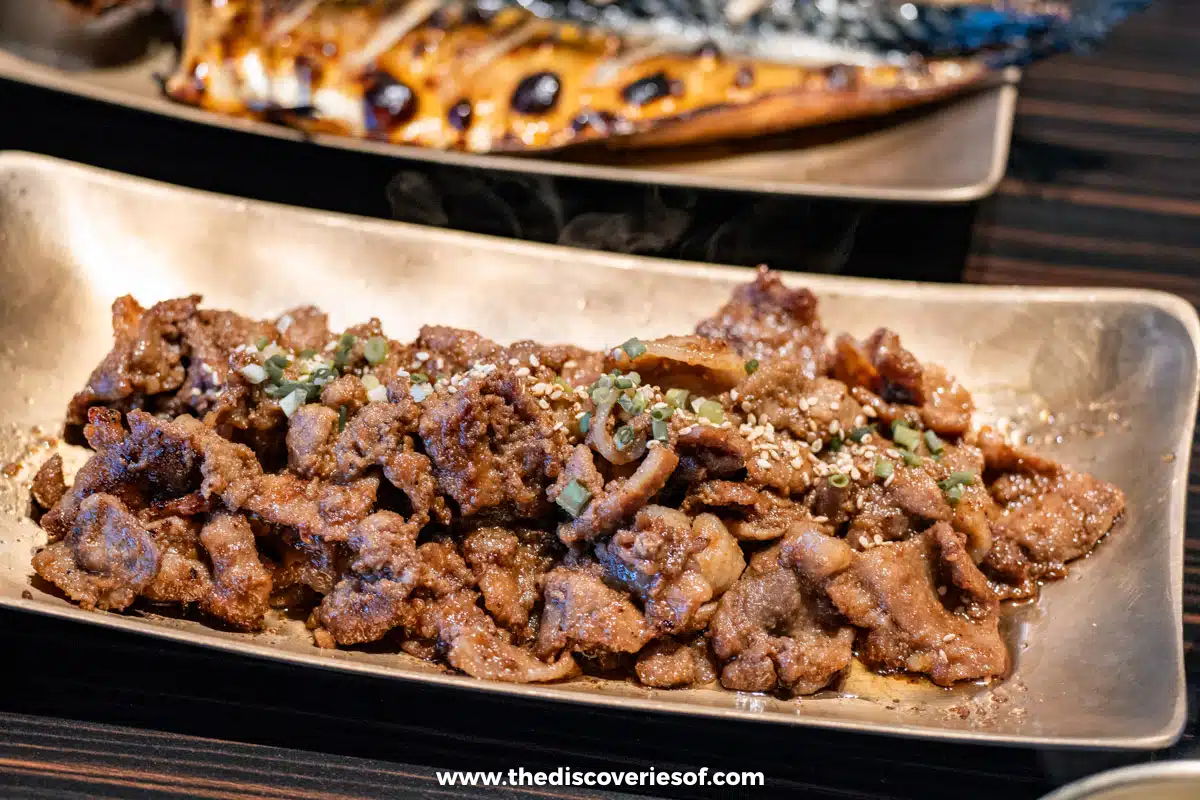
One of my favourite meals on my last trip was also the most traditional Korean restaurant I visited. The beef bulgogi, grilled mackerel, Jangajji (pickled veg), and every other dish at Andong Set Menu Restaurant 한상채비 were all spectacular.
You’ll need to go out of the way from Andong city centre, but it’s well worth the detour for the full South Korean dining experience on day 1 in Andong.
Start the Day at Nakgangmulgil Park
If you think Nakgangmulgil Park looks like a Monet painting, you’re not alone. The forests and ponds are picture-perfect and a beautiful place to wake up and enjoy the scenic side of Andong.
Try the Famous Chicken at Andong Old Market
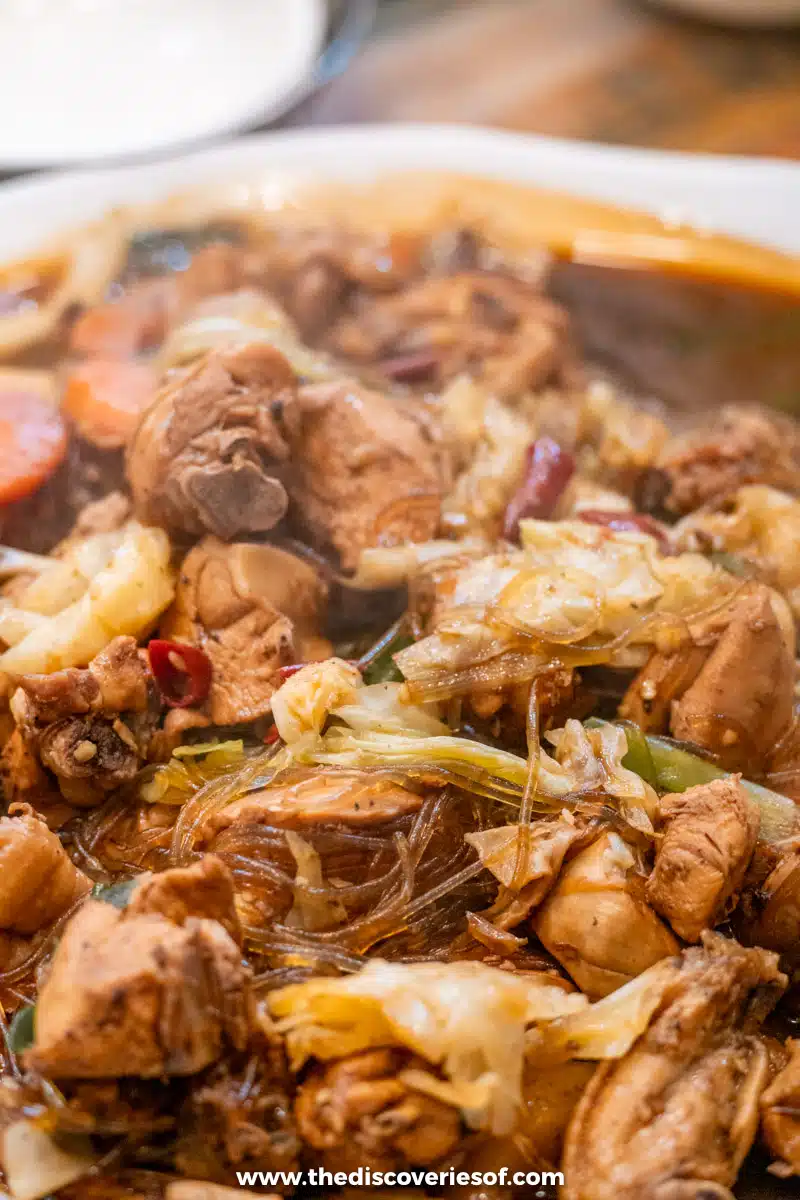
Walking past the lively stalls selling pastries, seafood, and fried chicken, you can’t help but fall in love with the aromas and flavours in this long-standing marketplace.
Don’t miss a chance to have a meal at Andong Shinsegae Jjimdak. The savory braised chicken over glass noodles is a classic dish in Korea, and there’s no better place to try it.
Go Wine Tasting at 264 Lee Yuk Sa Winery
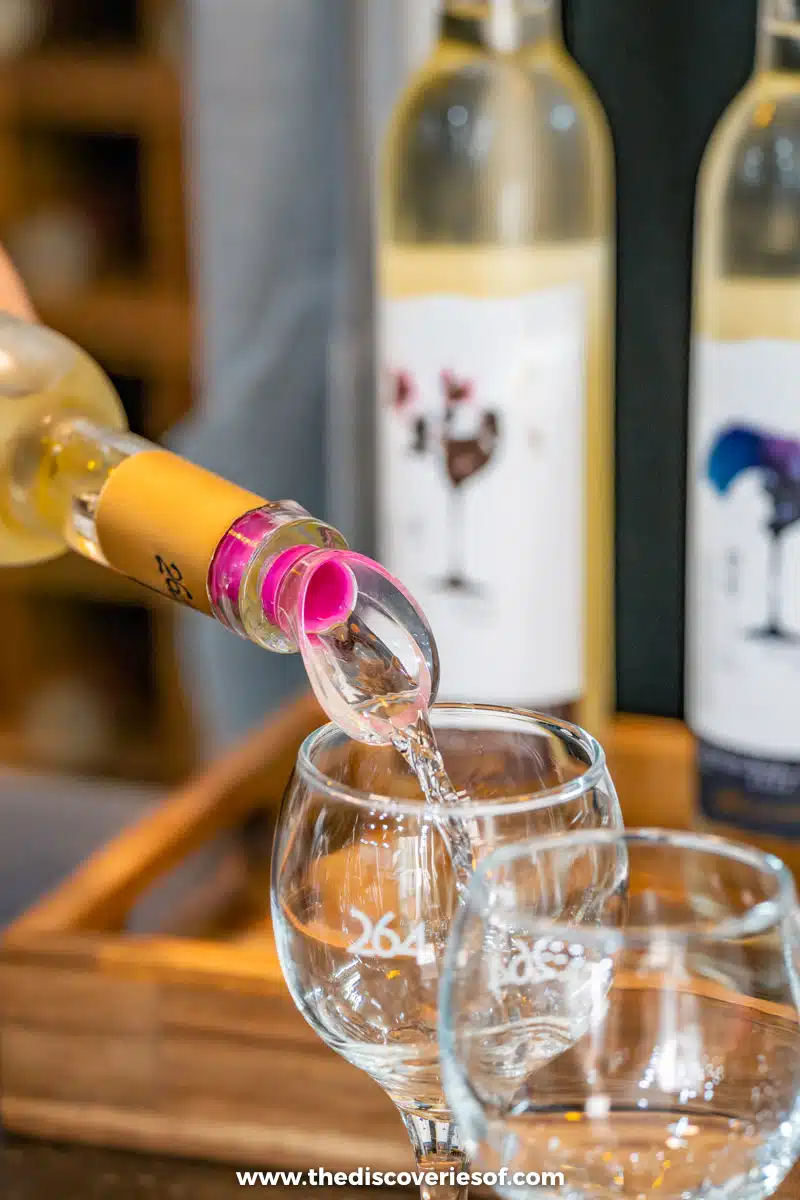
In an area so steeped in tradition; it’s a bit surprising to find a winery pushing the boundaries of local horticulture. But 264 Lee Yuk Sa Winery is a kind of tribute to famous poet and Andong hero Lee Yuk-sa, who died in a Beijing prison due to his affiliation with the Korean Liberation Army. Even though the winery is only a few years old, I thought they put out some impressive juice. The Cheongsu was a really fun white wine with a dry floral note that was better than I expected.
See the Light Show at Woryeonggyo Bridge
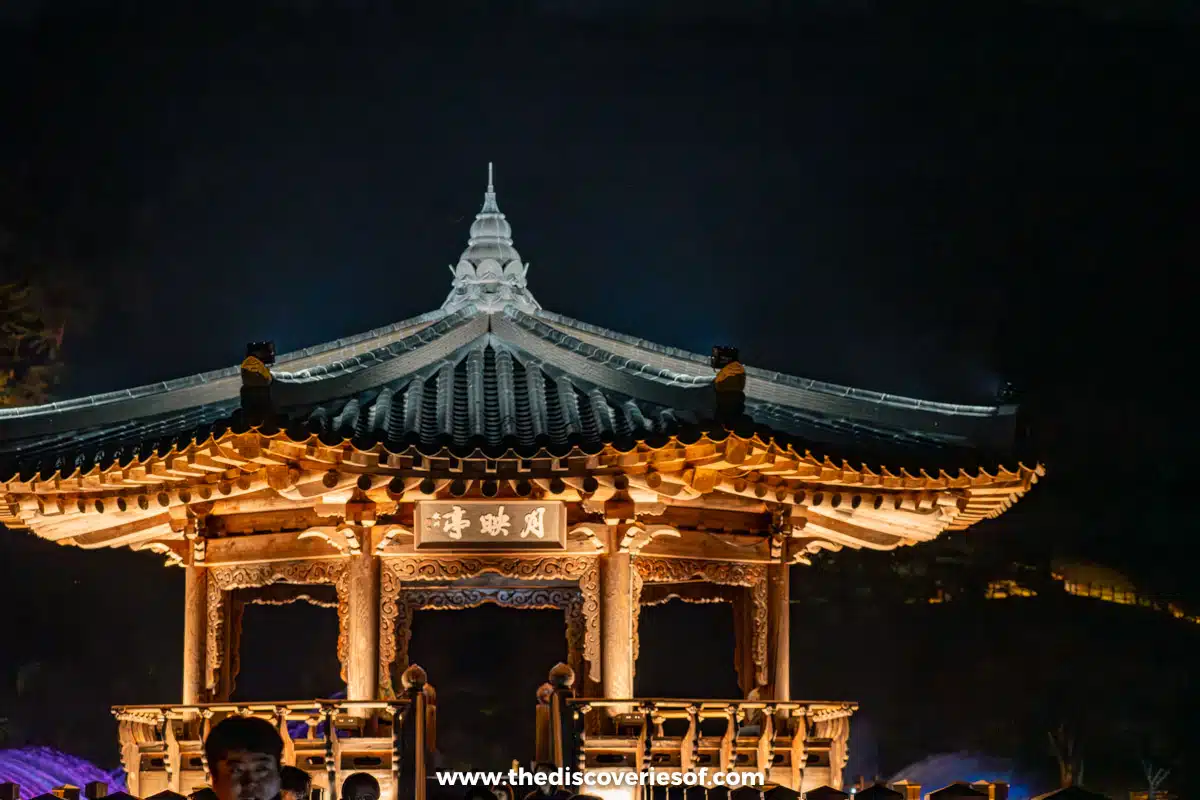
Take a walk on the longest pedestrian-only bridge in South Korea when you visit Andong. The Woryeonggyo Bridge is in a beautiful setting over the Nakdonggang River, but it’s especially striking at night.
Visit around 8 pm or 10 pm for a special show that lights up the water and temple in the middle of the bridge.
Getting to Andong
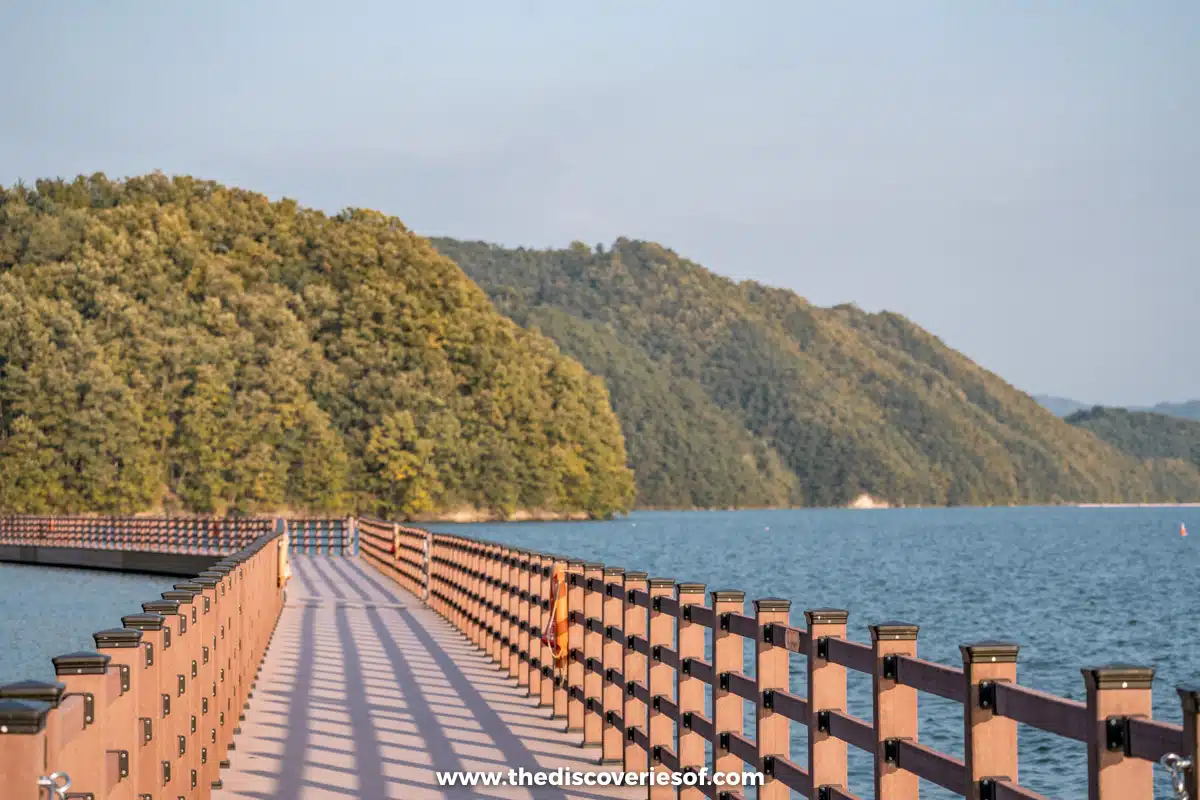
You can reach Andong from Seoul by bus or train. My advice? From the Cheongnyangni Station, take the high-speed KTX train, which will get you there in about 2 hours.
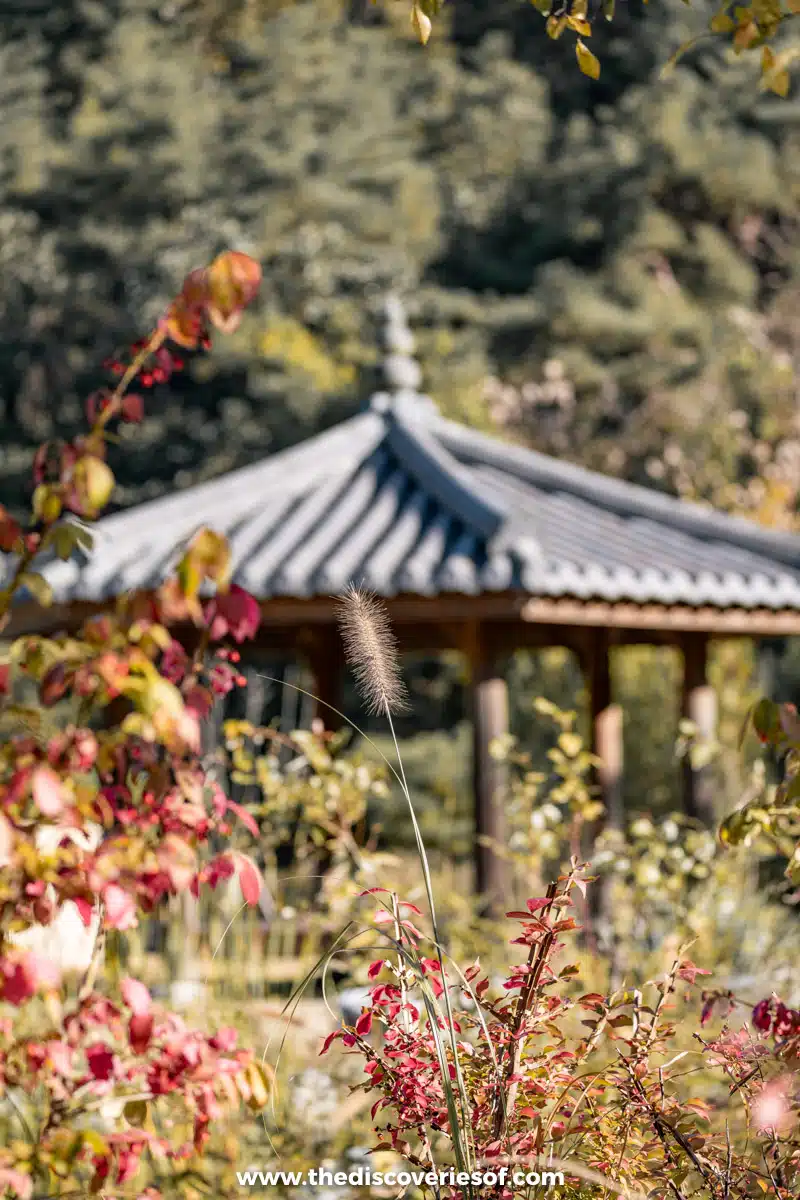
If you don’t mind going a bit out of your way, Andong Gurume Resort allows you to stay in a gorgeous Korean Hanok village. You can choose from several different room styles, each with a traditional design and a complimentary breakfast each morning.
Check Prices and Availability for Andong Resort Gurume Alternatively, Check All Accommodation in Andong
Days 5-7: Busan
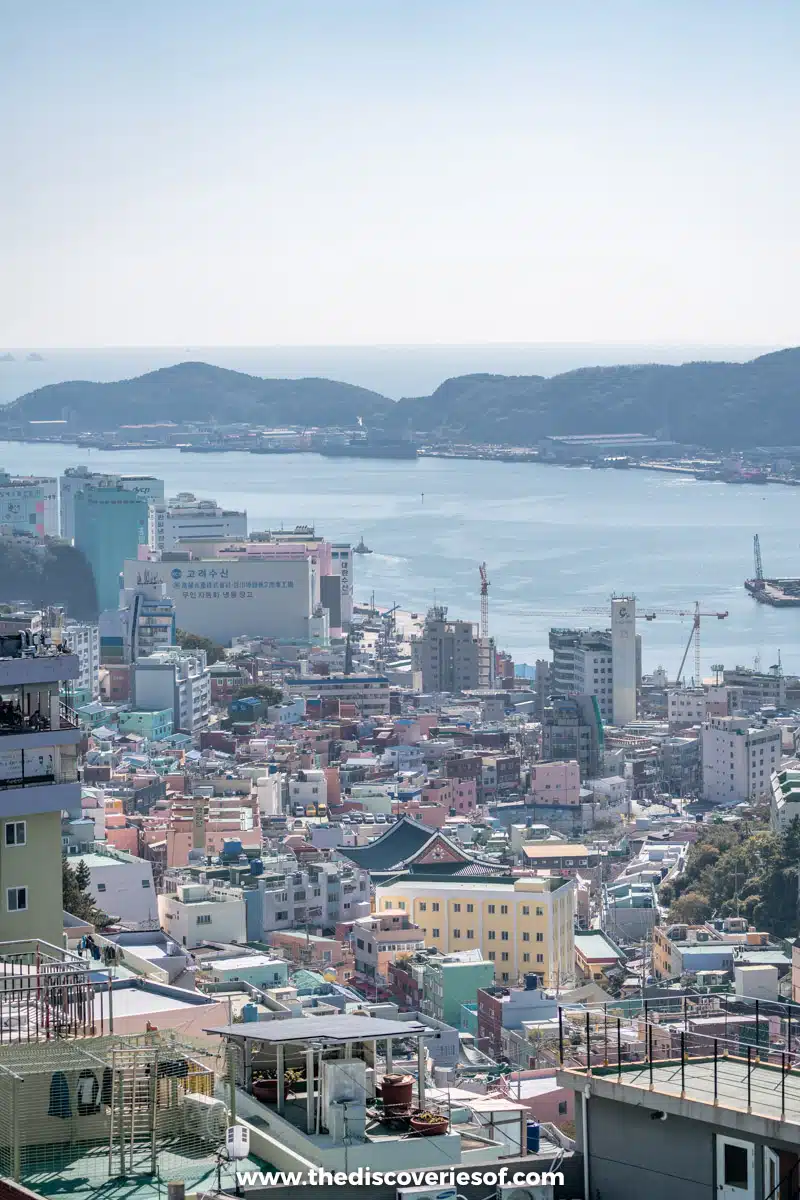
If you want to visit one of the most picturesque areas in the country, make sure you add Busan to your South Korea itinerary. The port city along the southern coast of South Korea is not only a delight for outdoor enthusiasts and foodies, but it also has a deep history related to the Korean War. Because it’s the 2nd largest city in the country and one of the most important ports, it was crucial that the UN helped defend the peninsula from the Korean People’s Army in the earliest months of combat. Now, Busan is home to the only UN Memorial Cemetery in the world.
Things to Do in Busan
Un memorial cemetery .
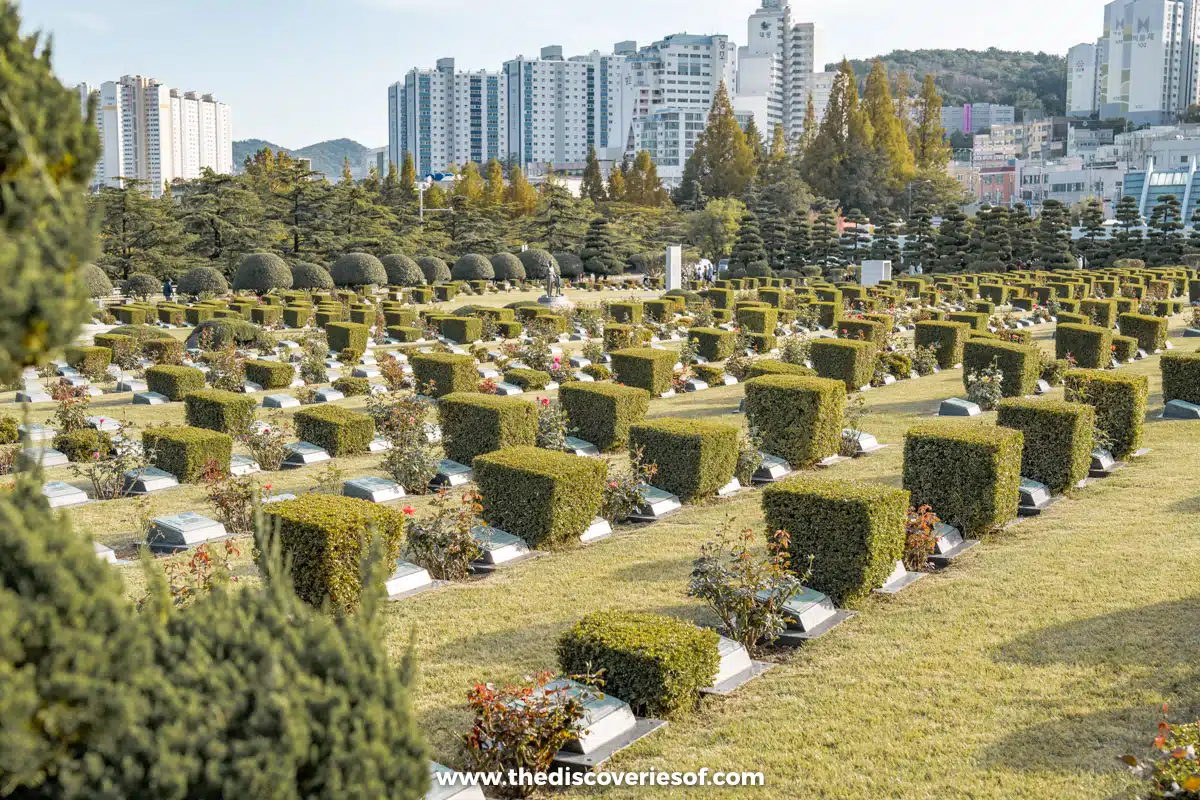
You can’t overstate the importance of Pusan (Busan) in the Korean War, and the UN Memorial Cemetery gracefully paints the tragic (but heroic) picture of the worldwide effort to retain South Korea’s independence. It’s the only UN cemetery in the world and a sobering reminder of the bloody war. Make sure you attend the UN flag raising and lowering and watch the educational video about the soldiers, which we were all in tears over by the time we left. This is a good way to learn more about the city’s history on your first day in Busan.
Try Korean Sashimi for Lunch
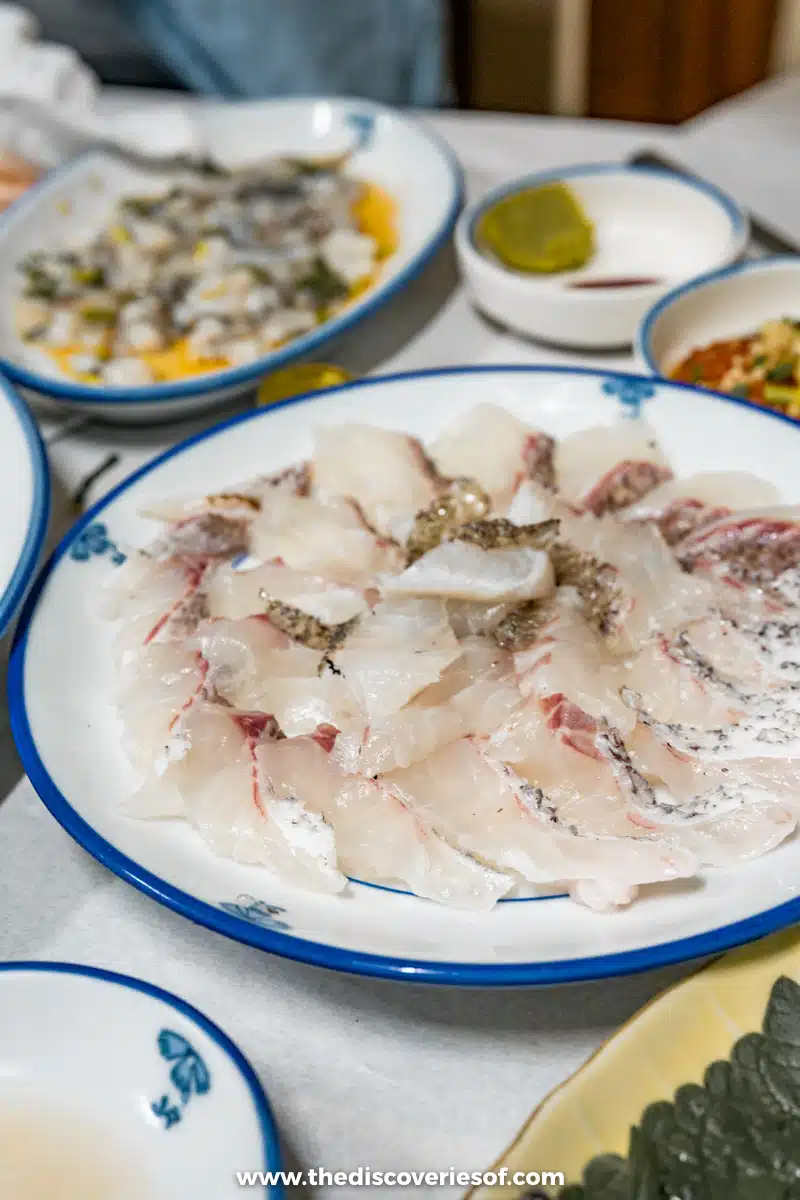
I know you may think sashimi is best in Japan, but hear me out – Koreans enjoy it just as much, and Bangpajae Hoetjip has it down to a science. Choose the fish of your choice when you walk in, and dive into anything from the fresh catch of the day to something a bit more adventurous, like the live octopus. I found the latter a bit challenging, but if you can get over the suckers trying to put up one last fight, it’s a dish with delicious flavours.
Ride the Busan Air Cruise
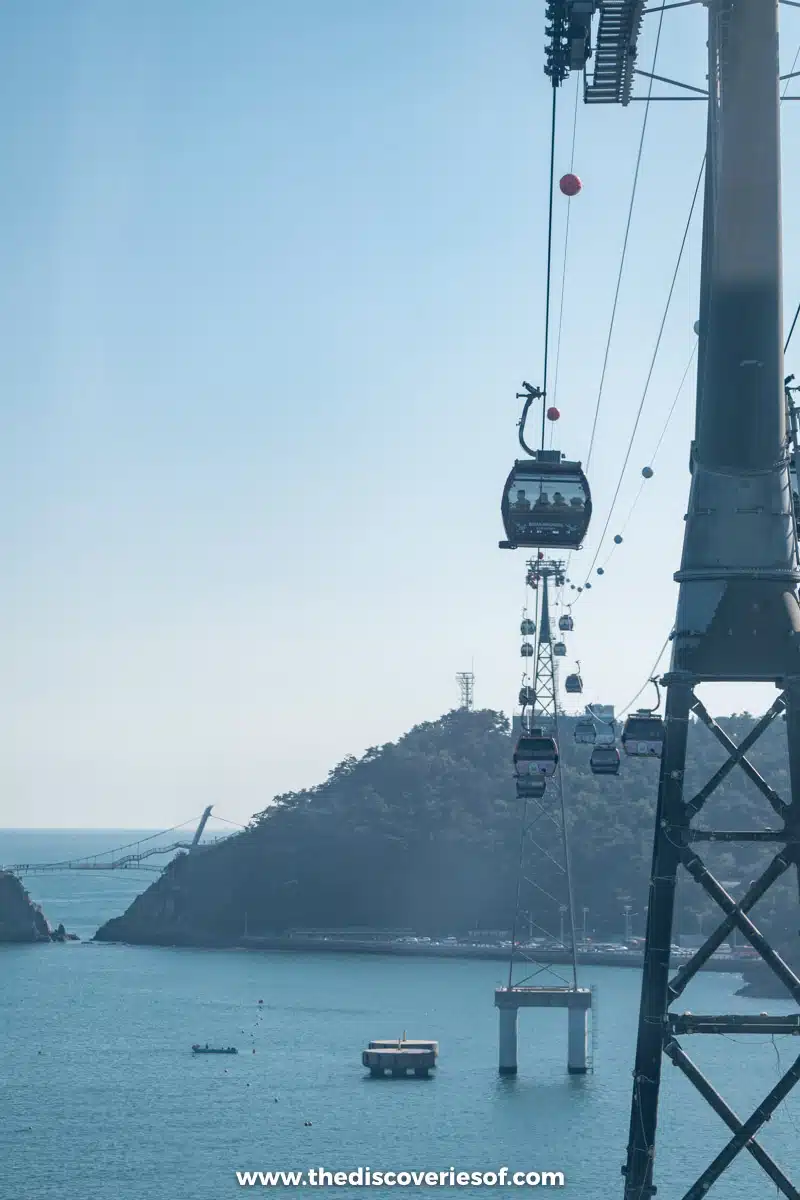
One of the best ways to take in any city is from an aerial perspective, and hopping aboard the Busan Air Cruise is one of the more impressive rides with a view I’ve taken.
Not only do you get incredible vantage points of downtown and Songdo Bay, but you’ll see the rugged cliffs and water right under your feet.
The museum on the top is kind of strange, but the city and ocean views are seriously amazing.
Splurge on a premium ticket for a better look from the glass floor below your feet.
Visit Gamcheon Cultural Village
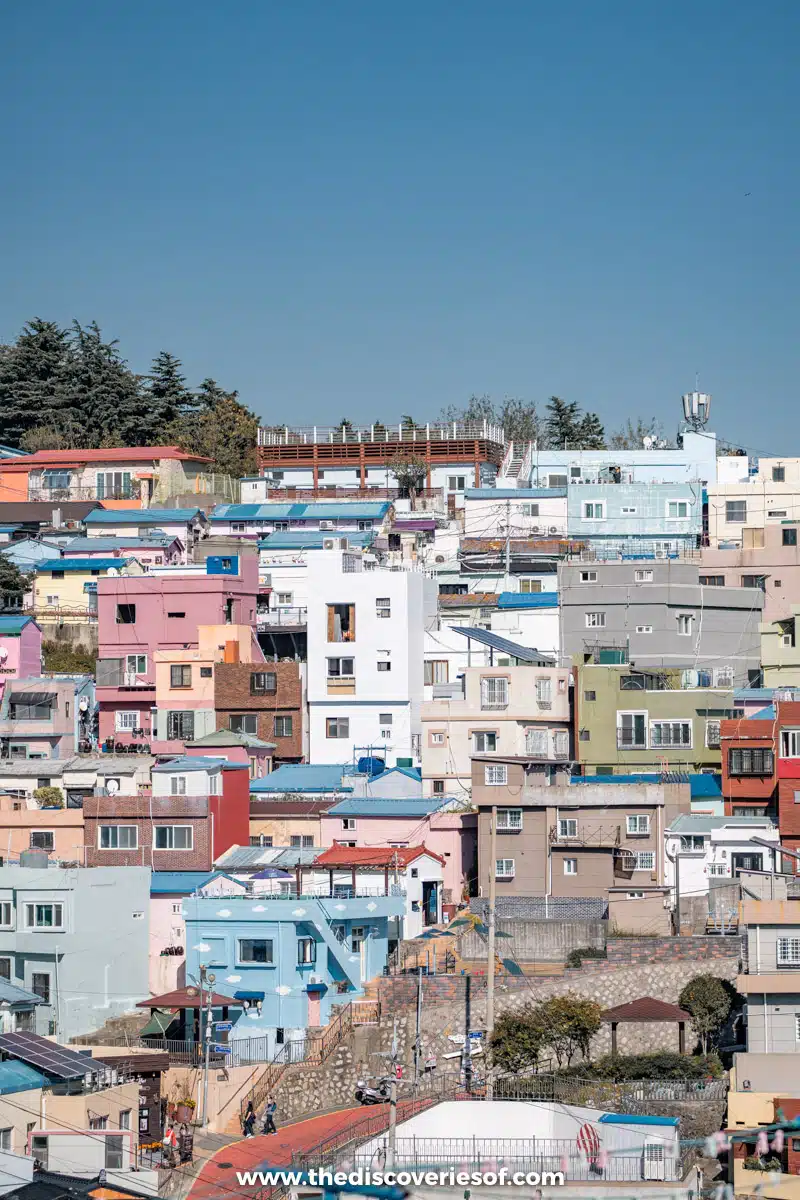
Start your second day in Gamcheon Cultural Village, which is quickly becoming a top tourist destination in South Korea. The historic neighbourhood got a bit of a facelift in 2009, and now the rows of densely packed hillside houses with colourful wooden facades and brightly painted street murals is one of the most photogenic areas in Busan.
Stand-Up Paddle Boarding at Gwangalli Beach
Try stand-up paddle boarding on Gwangalli Beach, where you’ll have picture-perfect views of the skyscrapers and Gwangan Bridge from a SUP. The best part? You can rent them right off the beach! The conditions can get a tad gnarly, but that’s part of the appeal. I think this is best at sunset, so plan for a late dinner.
Have Dinner at Korean Steak Grill
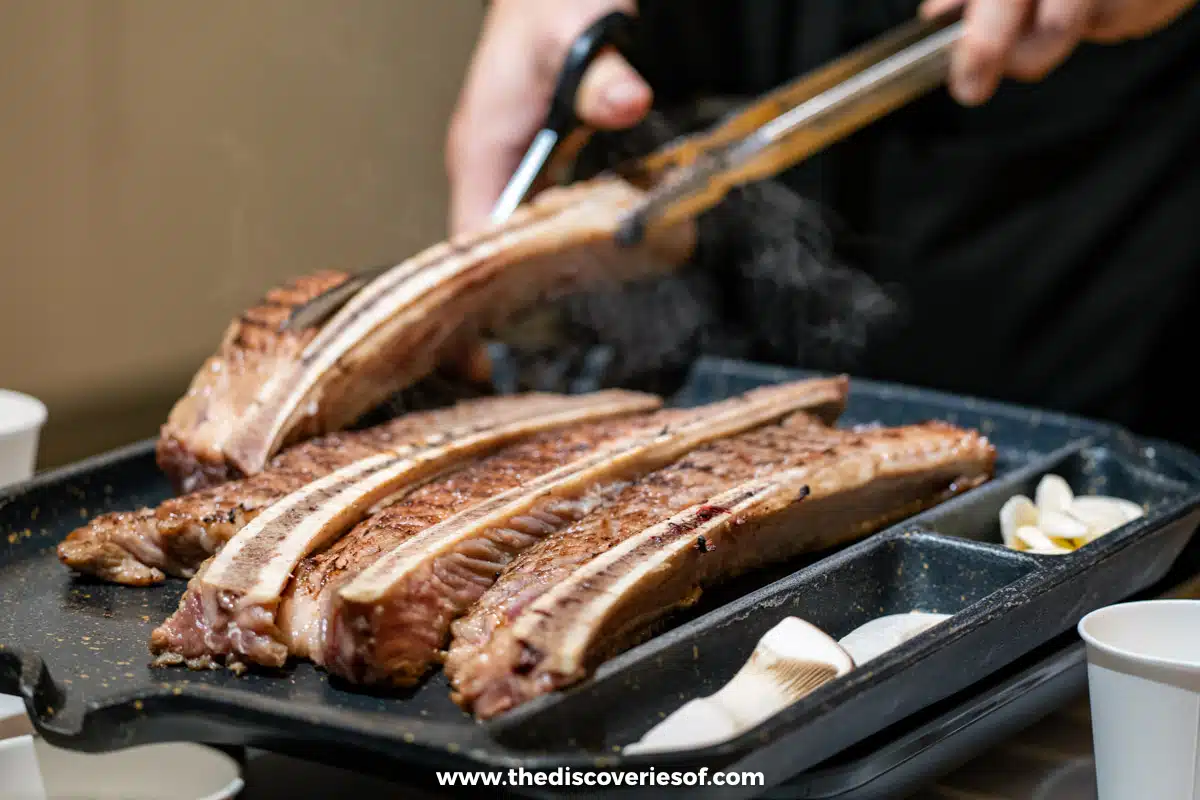
It’s really hard to narrow down my favourite restaurant in South Korea. Borderline impossible.
Nonetheless, this Korean Steak Grill (전설의 우대갈비 해운대직영점 ) between Haeundae Traditional Market and Haeundae Beach is what Korean BBQ dreams are made of (the views by the window are great, too).
So, what should you order? The steak on the bone is a must. It’s grilled at your table and then cut into small pieces for you to tuck into in sheer bliss. It’s divine.
Visit Haedong Yonggungsa Temple
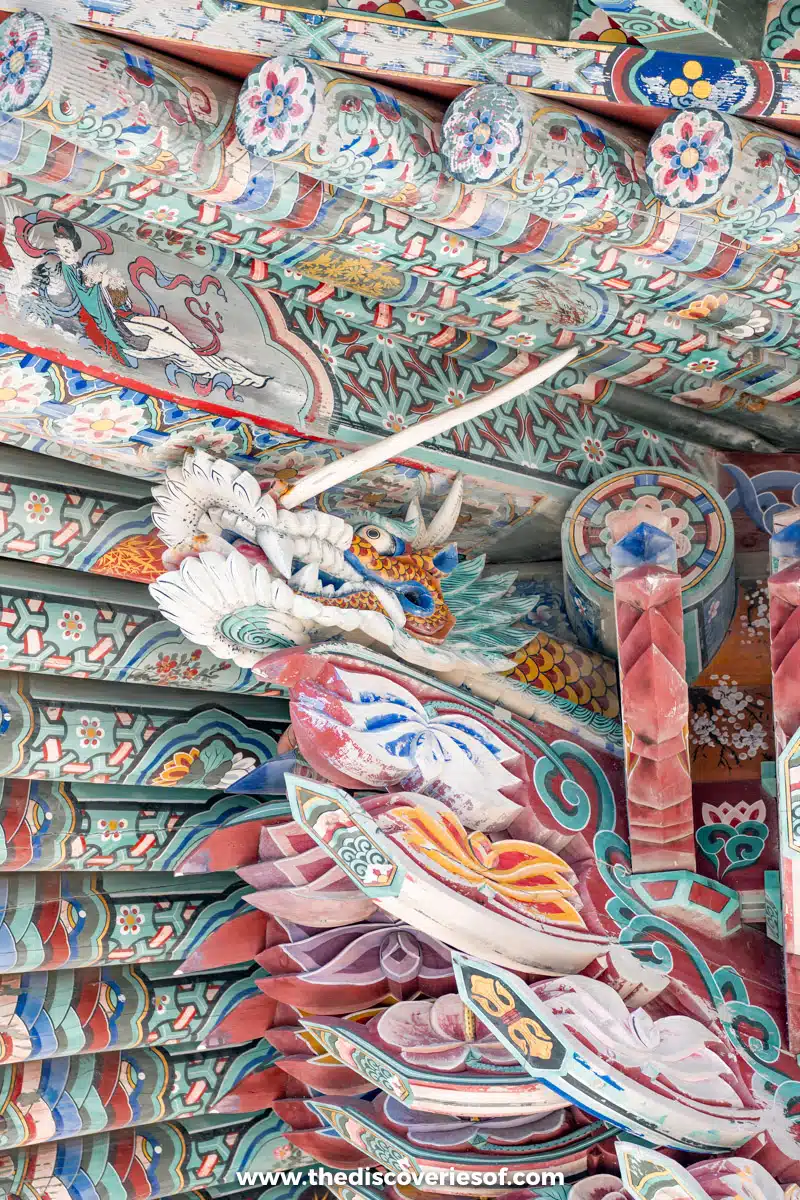
On your last day in Busan, take a day trip to Visit Haedong Yonggungsa Temple, just under an hour bus ride from Haeundae Station.
The oceanside landmark is a beautiful example of a Korean Buddhist Temple, with a rich history dating back to the 14th century and wonderful recreations of Joseon Dynasty-era architecture.
Take a full-day tour of Busan, with a stop at the iconic temple .
Watch the Sunset in Huinnyeoul Culture Village
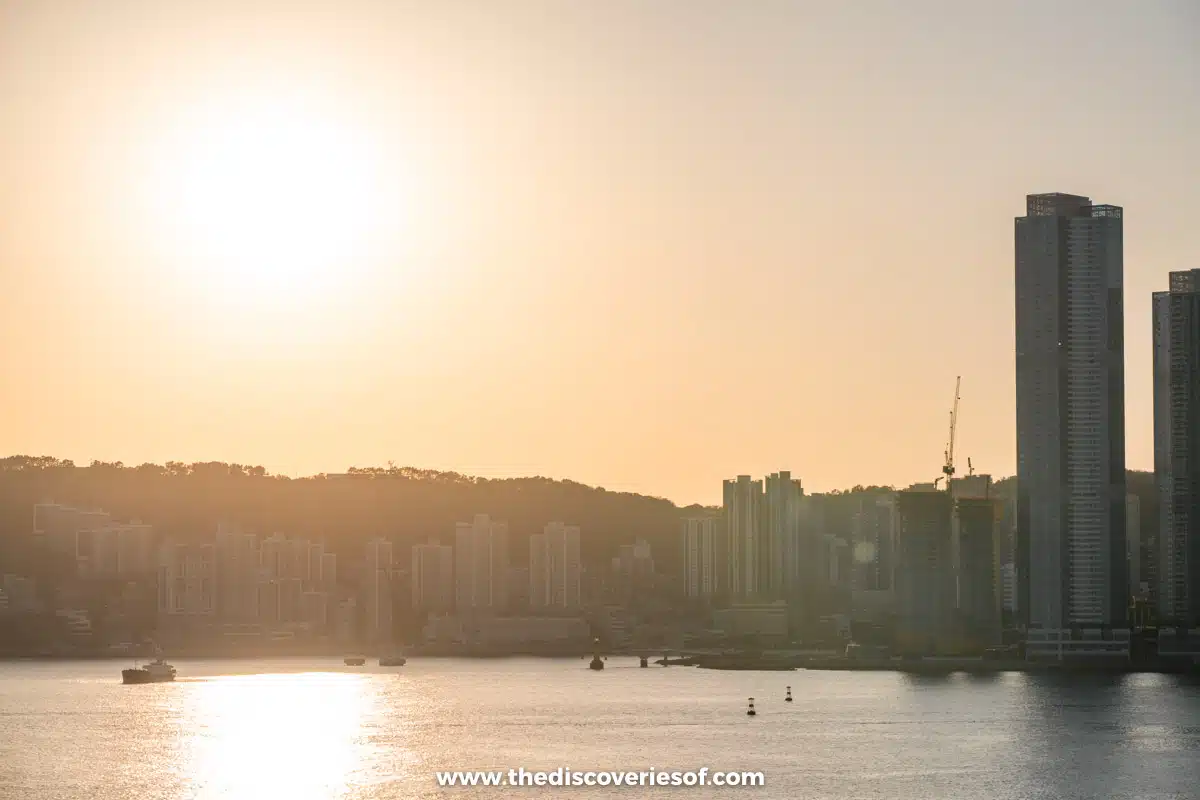
Save yourself time to visit the “Santorini of Korea” and go to Huinnyeoul Culture Village in the afternoon. You’ll find over a dozen murals (you can pick up an information guide near the village entrance) in the charming coastal village and some ridiculous sunset views from the Huinnyeoul Trail.
Spend 3 Days in Busan with this itinerary
Getting to Busan
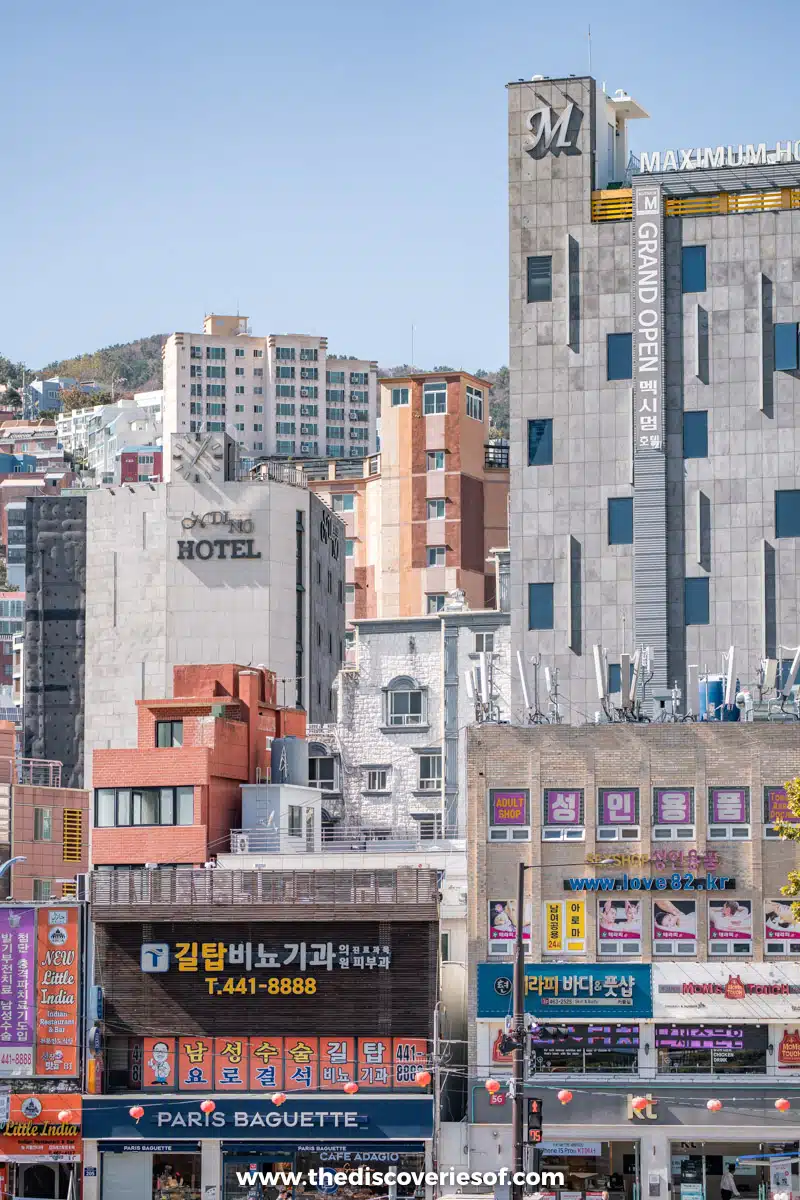
You can travel from Andong to Busan by train or bus. Both options will take around 2-2.5 hours, door to door, so either will work just fine.
Grand Josun Busan boasts sleek, modern rooms in a beautiful property near Haeundae Beach. The luxury hotel features a pool, spa, and stunning vistas from the rooms and suites
Check Prices and Availability for Grand Josun Busan Alternatively, Check All Accommodation in Busan
Days 8-9: Jeonju
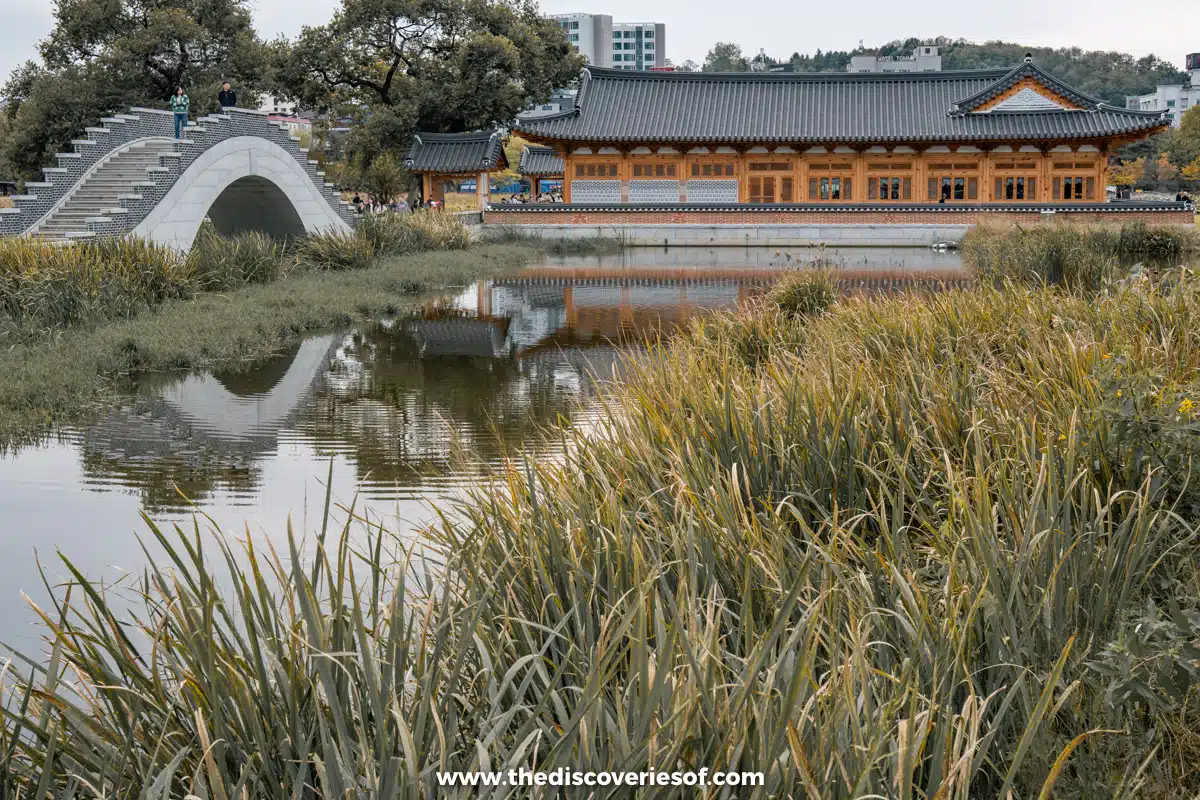
If you’re beginning to pick up on a theme in Korea, it’s that the food is absolutely incredible.
I’m not kidding when I tell you that each city I went to left me reeling about how exciting the culinary scene was. Jeonju might have been my favourite.
You’d expect no less out of the place where bibimbap originated, right? Oh yea, it’s also a UNESCO City of Gastronomy.
From making the Korean fermented beverage Moju to eating more pork in one sitting than I thought possible, culinary treats are around every corner in Jeonju. That said, I was surprised by how much there is to do here besides dive into the incredible food and beverage.
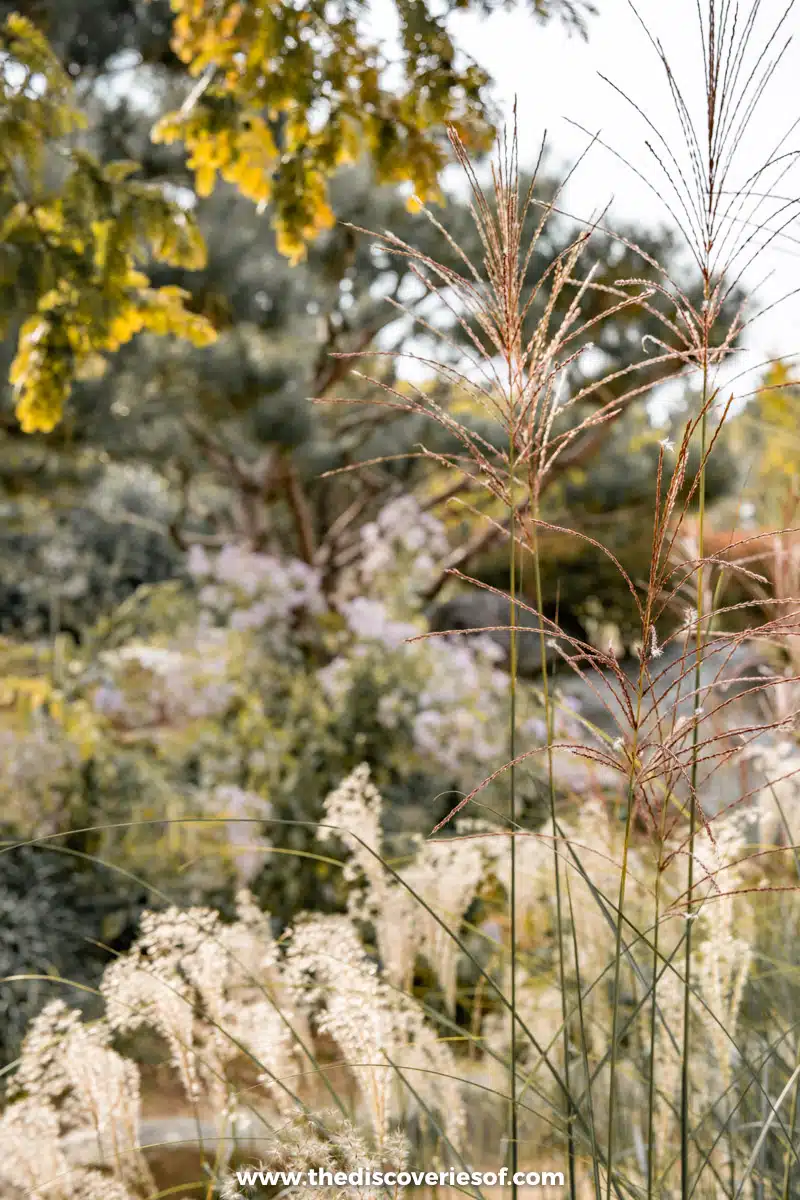
For starters, the gorgeous free open spaces like Jeonju Arboretum or the lakeside Deokjin Park are a welcome respite from the busy city streets. There’s also a deep commitment to education and the arts, which you can explore by signing up for cooking classes , pottery demos , or taking a stroll through the Yeonhwajung Library in a gorgeous Hanok. In all, Jeonju is so lovely that I would say you can’t plan a trip to South Korea without including it on your itinerary.
Things to Do in Jeonju
Jeonju arboretum.
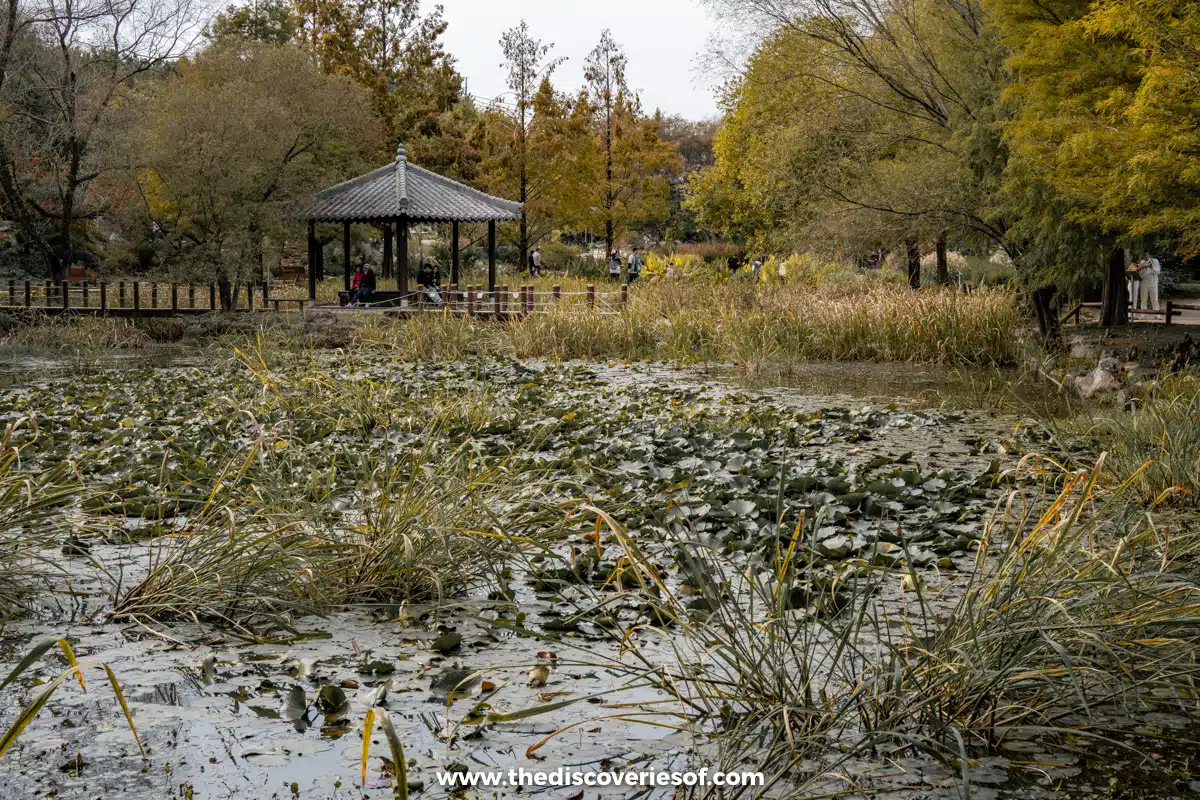
Jeonju Arboretum is home to one of the most beautiful parks in the city, and it’s even free to stroll through and look at the abundance of flora and fauna. It’s a stunning garden, which sprouted up after the expressway left the land in less than desirable shape. They transformed it into a tranquil space that is especially beautiful in the fall, when the pink muhly is in peak bloom.
Visit the Gyeonggijeon Shrine
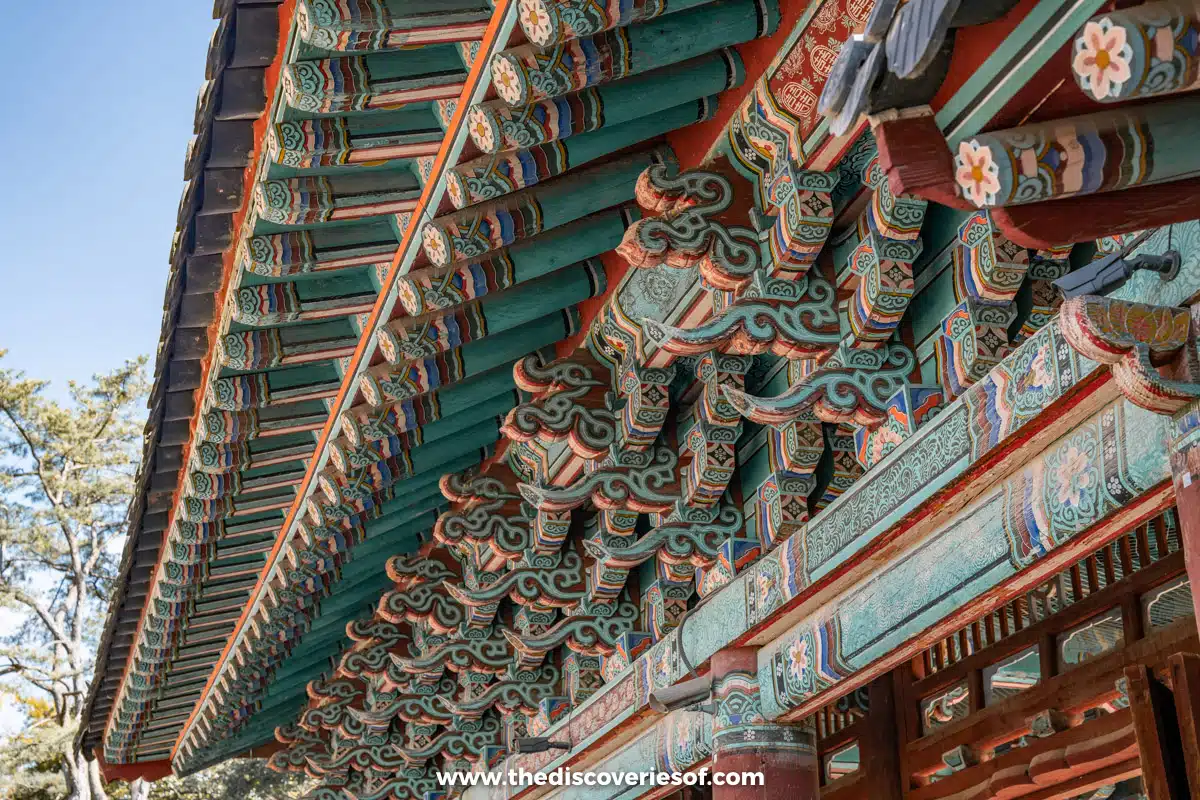
The 15th-century Gyeonggijeon Shrine is a beautiful example of Joseon Dynasty architecture in Jeonju and was built as the home of a portrait for the first ruler King Tae-jo. Despite being damaged during a Japanese invasion in the 16th Century, the building is still beautiful inside and out and home to portraits of numerous Joseon Dynasty royalty over the 400+ years of their rule.
Make Your Own Moju
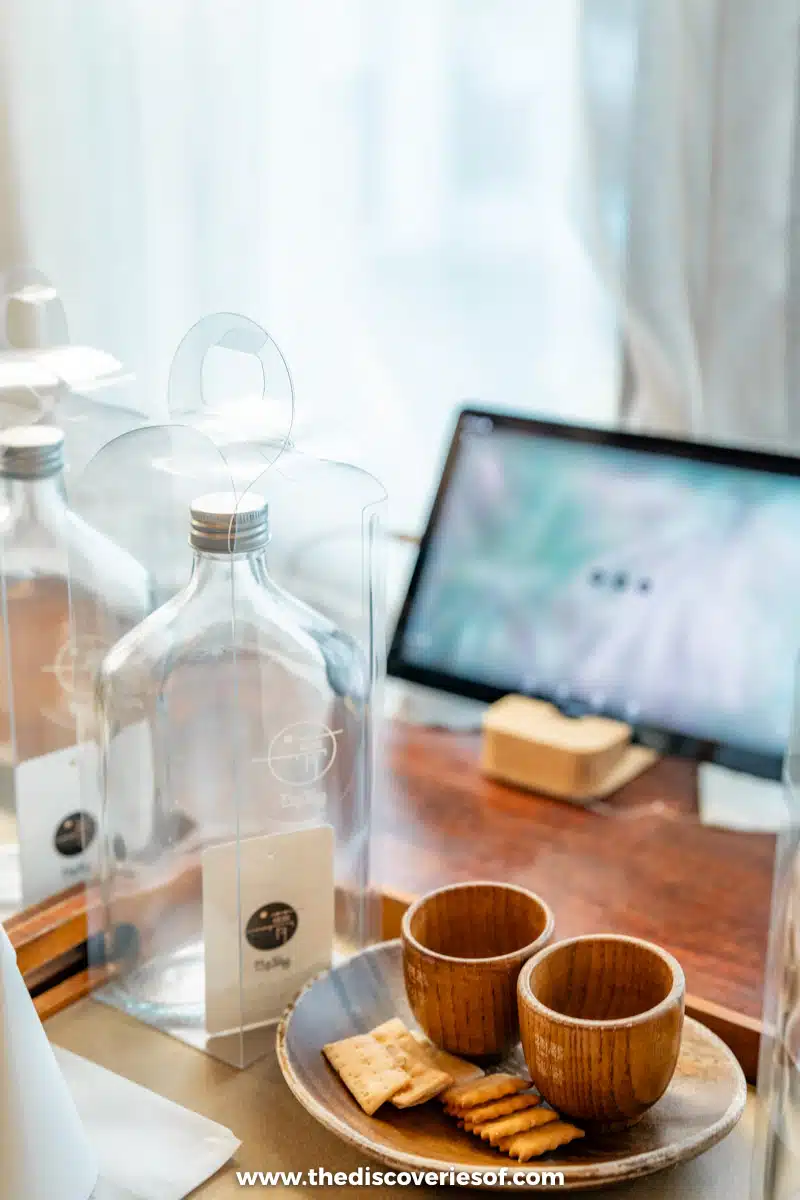
If you’re looking for a cool activity to try while you’re in town, try making the fermented Korean rice wine bevvy known as moju.
First time trying moju? Not to worry. You can choose from 3 different recipes, each with unique ingredients
Decide on your favourite in this fun guided class through Airbnb .
Explore Jeonju Hanok Village
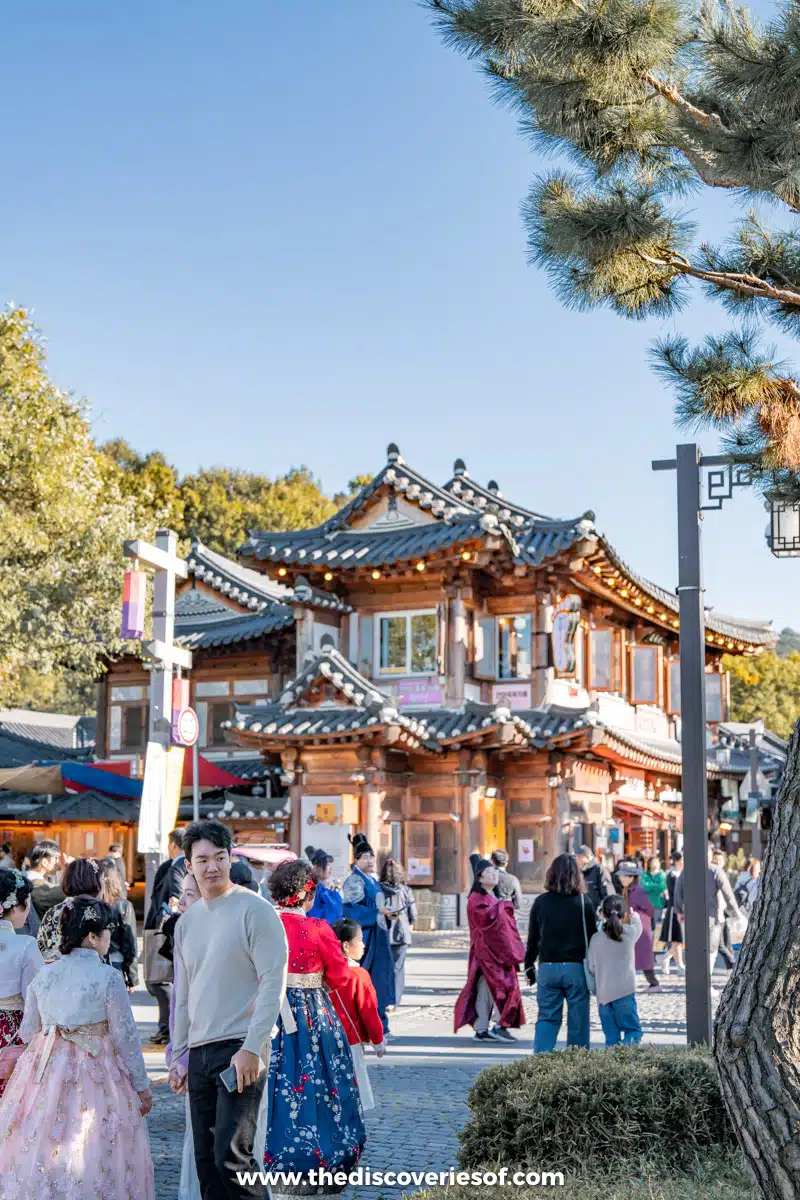
One of the best memories of my most recent trip was walking through Jeonju Hanok Village.
Locals and visitors dress up in traditional Korean hanbok dresses and stroll around the town, a beautiful reminder of the rich cultural traditions in Jeonju. You can even rent them at a local shop .
Head to the Jeonju International Film Festival in the spring, which helps bring to life a place that’s already brimming with tradition.
Dinner at 경성금돼지 – Pork Grill Restaurant
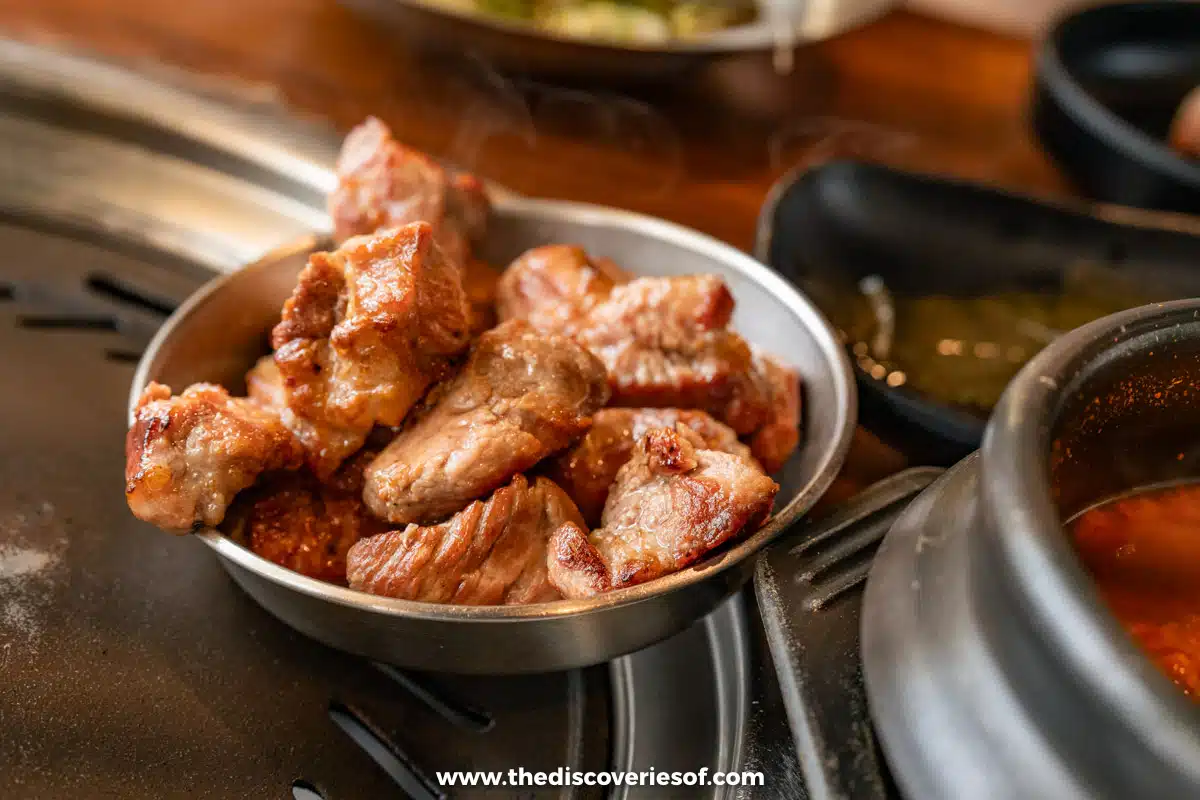
Had plenty of grilled meat? Sorry, but make room for more. This excellent restaurant dishes up unctuous cuts of pork grilled to perfection at your table. The prices are reasonable, and the atmosphere is festive and social. So, come hungry and enjoy some cold noodles and kimchi alongside too much meat for one person to comfortably take down.
See Deokjin Park at Night
After you enjoy dinner, head to Deokjin Park to see why locals love the beautiful urban green space after the sun goes down. The pond lights up from the lights along the walkways and nearby University buildings. Still, it’s the stunning Yeonhwajeong Library with its traditional Hanok facade that really lights up the park at night.
An insider’s guide to exploring Jeonju
Getting to Jeonju
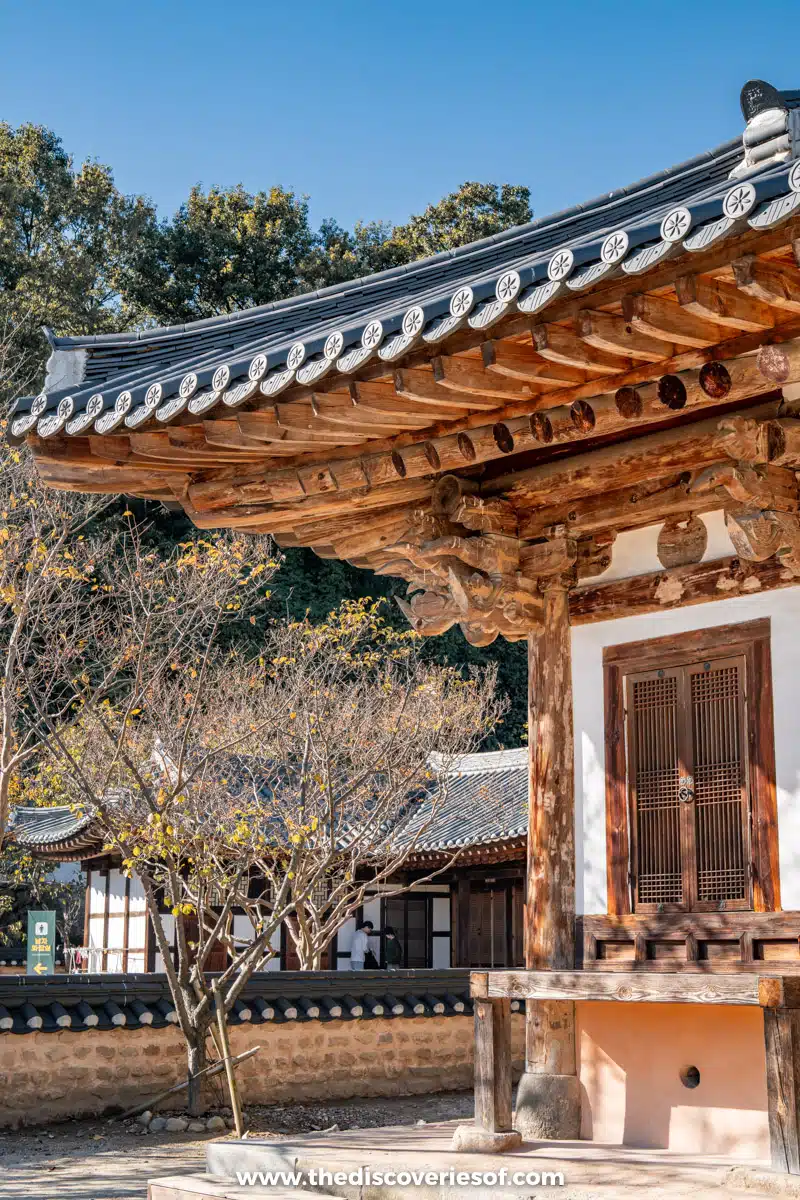
Jeonju is easy to get to from Busan. You can take KoBus and reach the city in 3 hours or take a train from Cheonan Asan Station, a short bus ride away from Jeonju.
Lahan Hotel Jeonju is a popular modern hotel overlooking the city and traditional Hanok village. The rooms are large, the beds are comfortable, and it’s a perfect location for exploring the city.
Check Prices and Availability for Lahan Hotel Jeonju Alternatively, Check All Accommodation in Jeonju
Day 10: Seoul
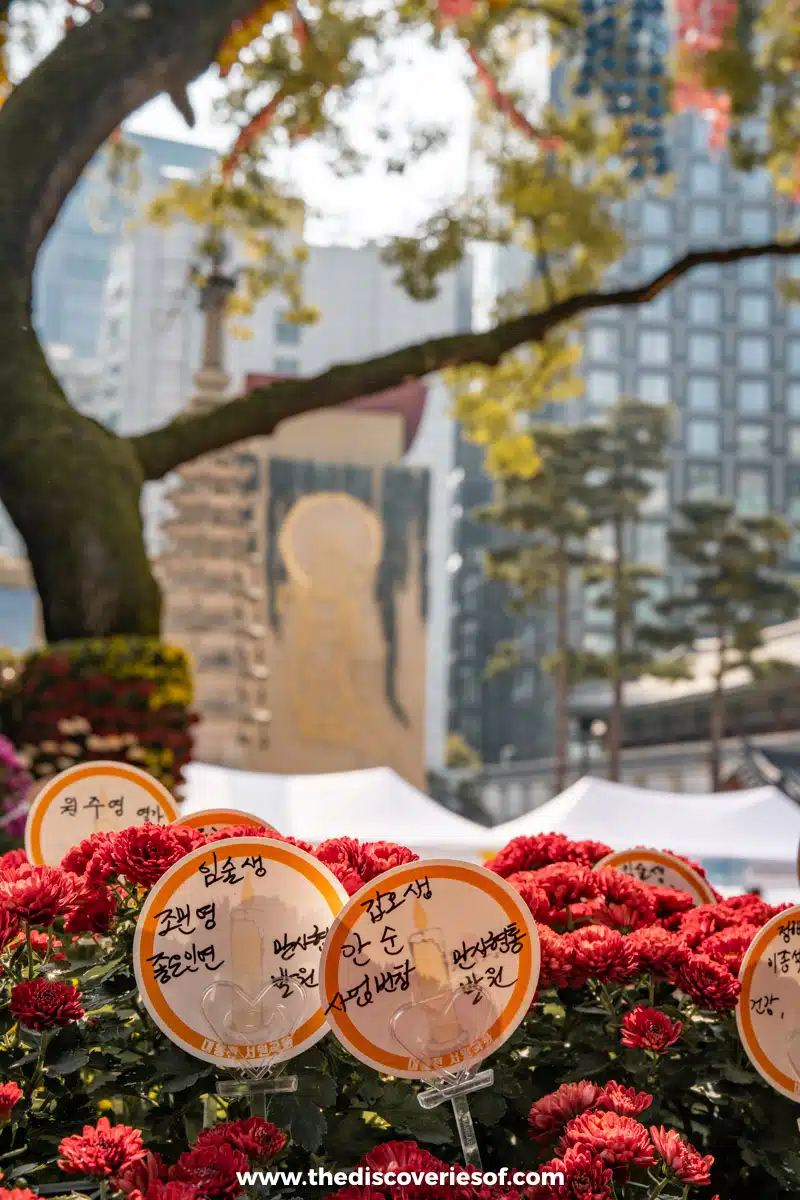
Now that you’ve checked a few of Seoul’s most popular tourist boxes, it’s time to see the city like a local. Start at Cheonggyecheon Stream, where you can hang out at numerous spots along the 10.9 km (6.7-mile) stream known for its street art, bridges, and famous Unicorn Horn art installation.
After that, check out the vendors at the bustling Gwangjang Market or explore the vibrant shopping and dining scene in Myeongdong; I promise when you start digging deeper into things to do in Seoul, you probably won’t want to leave.
Walk Around Yeouido Hangang Park and the Hyundai
Start your day at Yeouido Hangang Park, where you can take a stroll, hire a bicycle, or snap a selfie in front of the “I Seoul You” sign on the Han River. Then, visit The Hyundai Seoul for some shopping. Visit any of the pop-ups for a unique look at the rotating storefronts and kiosks, including exhibits by some of the most well-loved clothing brands and K-pop stars.
Dine at Insadong Hangane Bulgogi Jumak
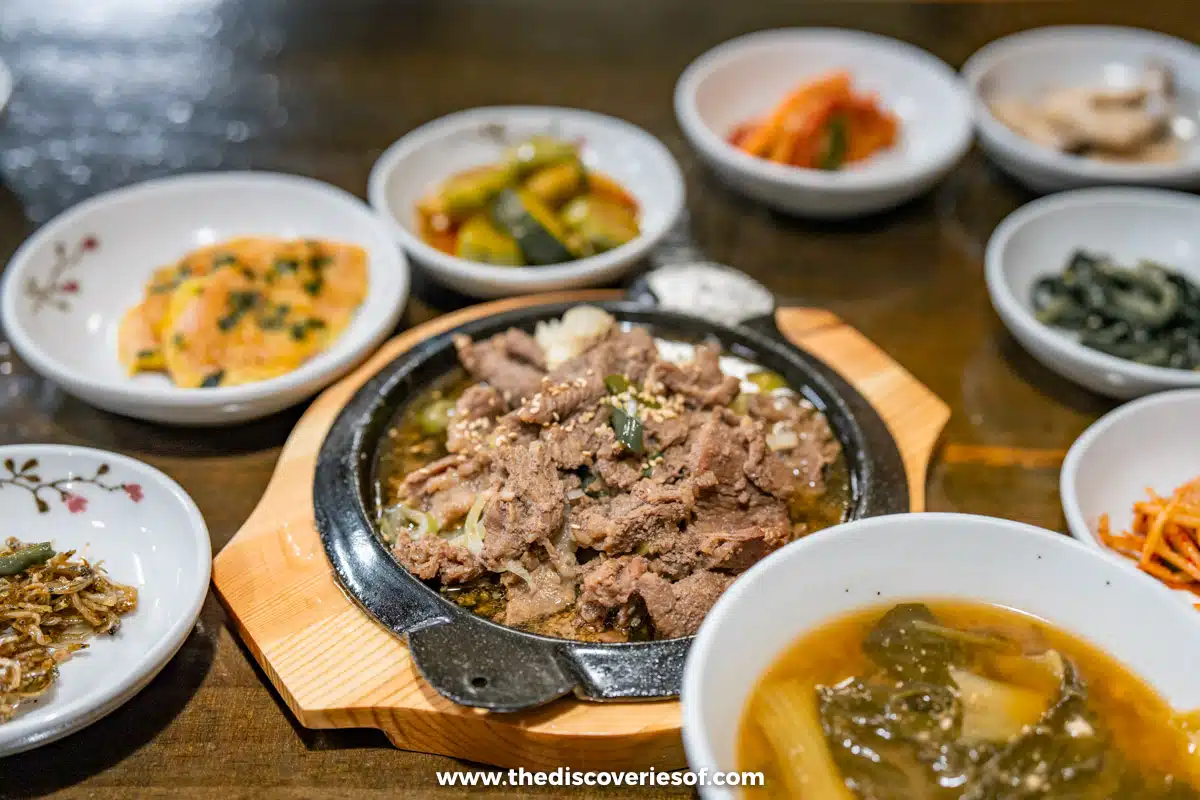
There are some cities where I feel like you need to hop around as many restaurants as possible until you’re uncomfortably full. Seoul is one.
But if you only have time for one, do the set menu at Insadong Hangane Bulgogi Jumak. For 18,000 won (£11), you’ll enjoy soup, rice, and pickled veggies. But the real star of the show is the beef bulgogi, which was buttery, rich, and a must-try when you’re in Seoul.
Jijimbang at Spa Lei Seoul
Be sure to schedule a session at a Korean spa. It’s a unique experience, and Spa Lei is probably the most accessible to Westerners and is also for women only. I wouldn’t say this is relaxing, but it’s totally invigorating. And for under £100 ($125), the massage and body scrub made me feel like an entirely new person before my long flight home.
Getting to Seoul
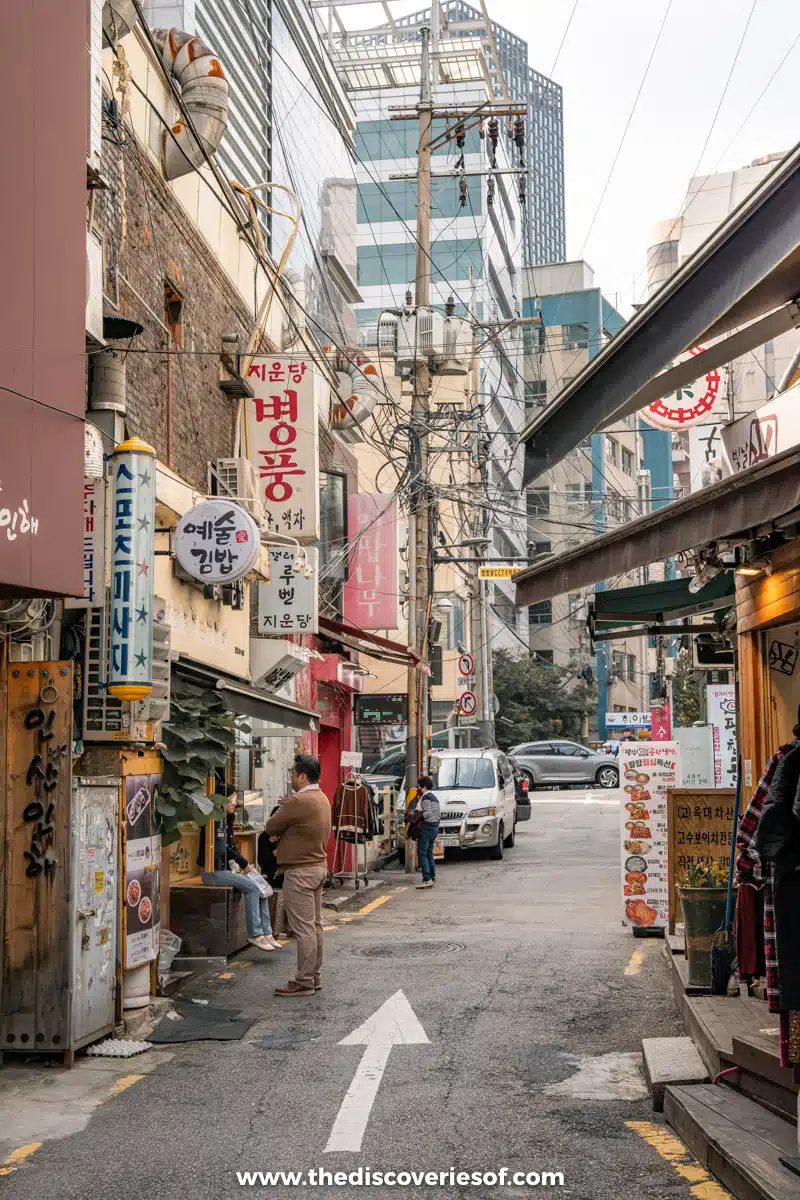
From Jeonju you can take a high-speed train from KTX to Seoul in around 2 hours. I thought the trains were extremely comfortable, and the views were spectacular – so don’t hesitate to book a ticket.
Suggested Stay
If you want to stay in a different part of town, I recommend Insadong for your second leg in Seoul.
The rooms are comfortable, there’s a 24-hour front desk with currency exchange available, and you can walk to the subway easily from the lobby.
Check Prices and Availability for Nine Tree Premier Hotel Insadong Alternatively, Check All Accommodation in Seoul
Have More Time? Add Gangneung To Your Itinerary
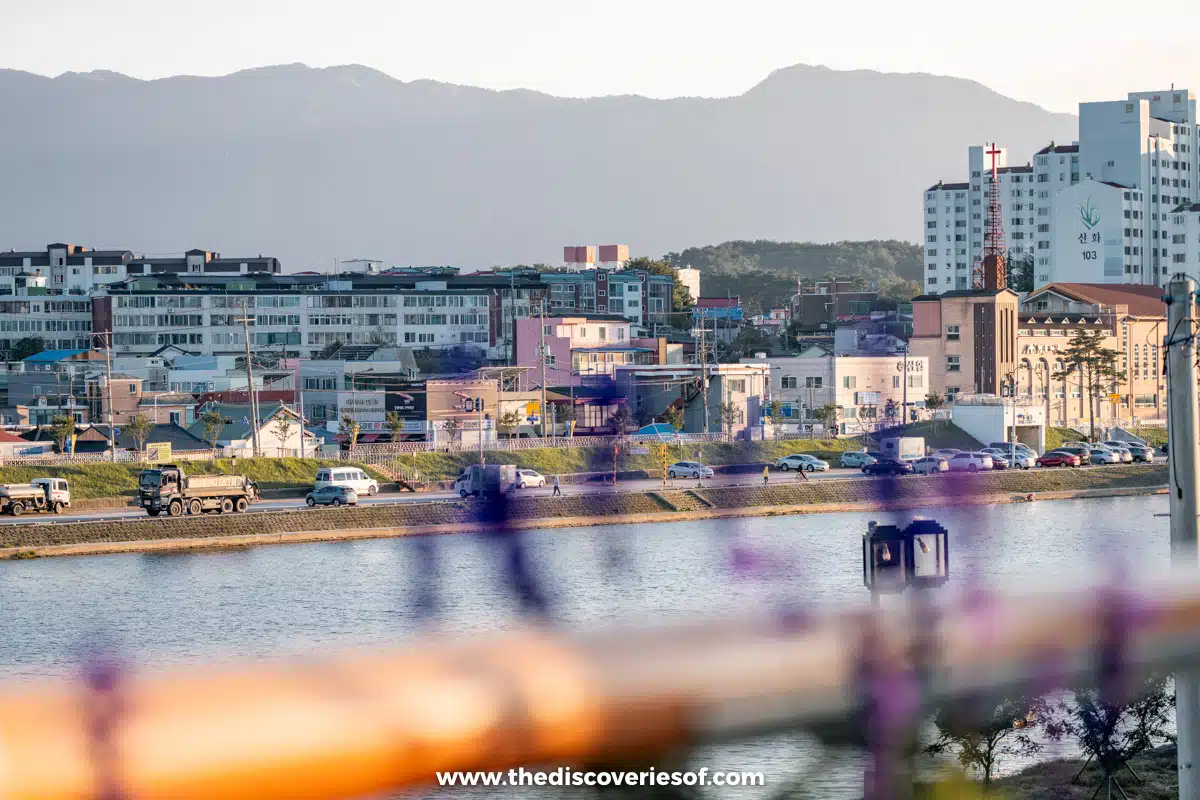
If you have more time, I highly recommend adding a couple of days in Gangneung .
For starters, the “City of Coffee” might just boast more artisanal cafes roasting their coffee than any place I’ve ever been. And pretty much every market and restaurant I tried was seriously incredible, so I’ll just mention a few.
Be sure to stop by Gangneung Jungang Market, where you can check out the traditional and underground fishery market, which has been open since the 1980s. Take your time to sample regional fare, but do not miss the Korean fried chicken from Baenni – an explosion of flavours and textures that was straight-up delightful.
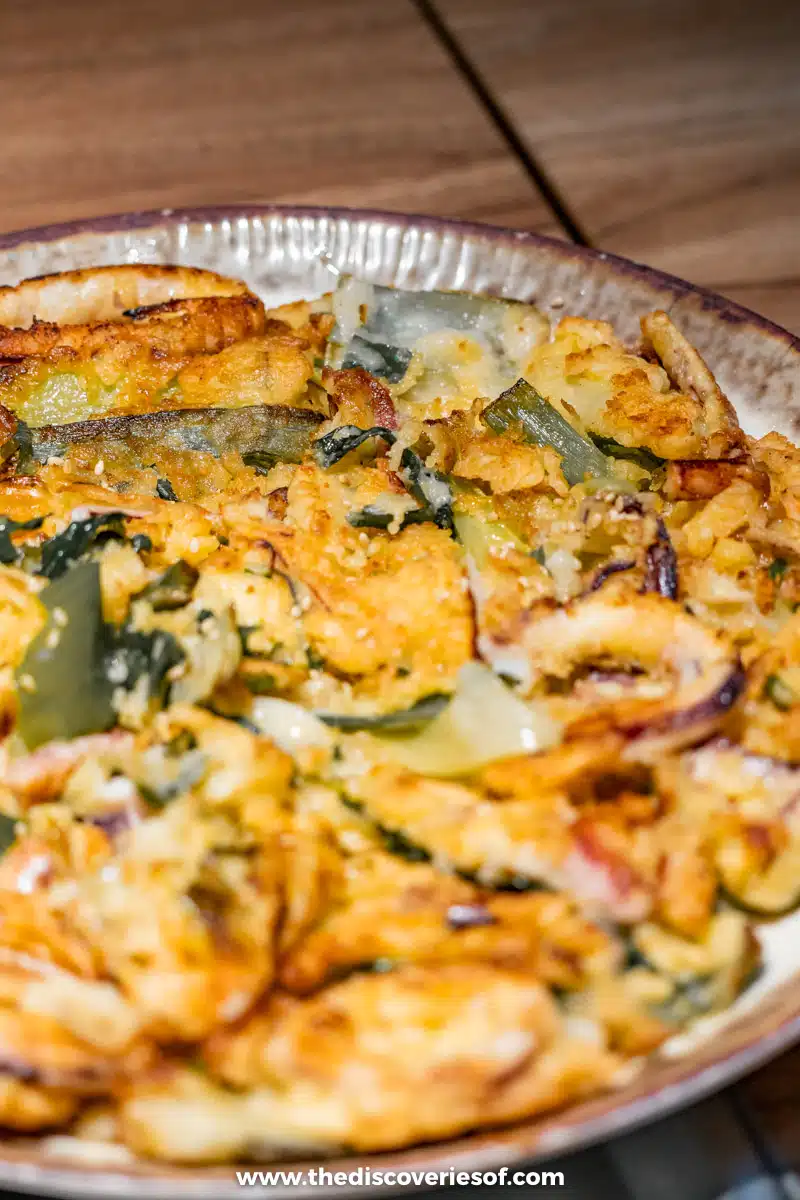
And if you only have time for one meal, Owole Chodang Korean Pancake Restaurant (오월에 초당) is the spot. The thick omelettes are bursting with fresh ingredients. Think crunchy on the outside, soft veg, and seafood on the inside – it was easily one of my favourite dishes from the trip.
Want to see a bit of the surroundings between chowing down? The city has a stunning coastline, with Gyeongpo Beach being the most popular place to spend a day lying on the white sands lined with fragrant pines.
Handy Tips for Planning Your Korea Trip
What to pack .
You’ll need to decide what time of year you’re visiting South Korea before you start planning your wardrobe. The weather is completely different in July than it is in January. You can see temperatures below -6.6°C (20°F) in the winter, where summer highs often reach over 26.6°C (80°F).
No matter when you visit, you’ll want to pack dressy clothes for restaurants and museums and lean a little towards conservative. I like choosing dresses or skirts with tops that are a bit less revealing, as it’s the custom in most areas of South Korea.
Bring a reliable pair of sneakers for getting around the city and subways, underseat luggage (or a small rolling suitcase ), and a mix of casual and formal clothes for sightseeing, dinners, and entertainment. Pack your best beachwear if you visit in the summer, but again, you might want to stick to conservative outfits like a one-piece or shorts and a cover-up.
Best Time to Visit
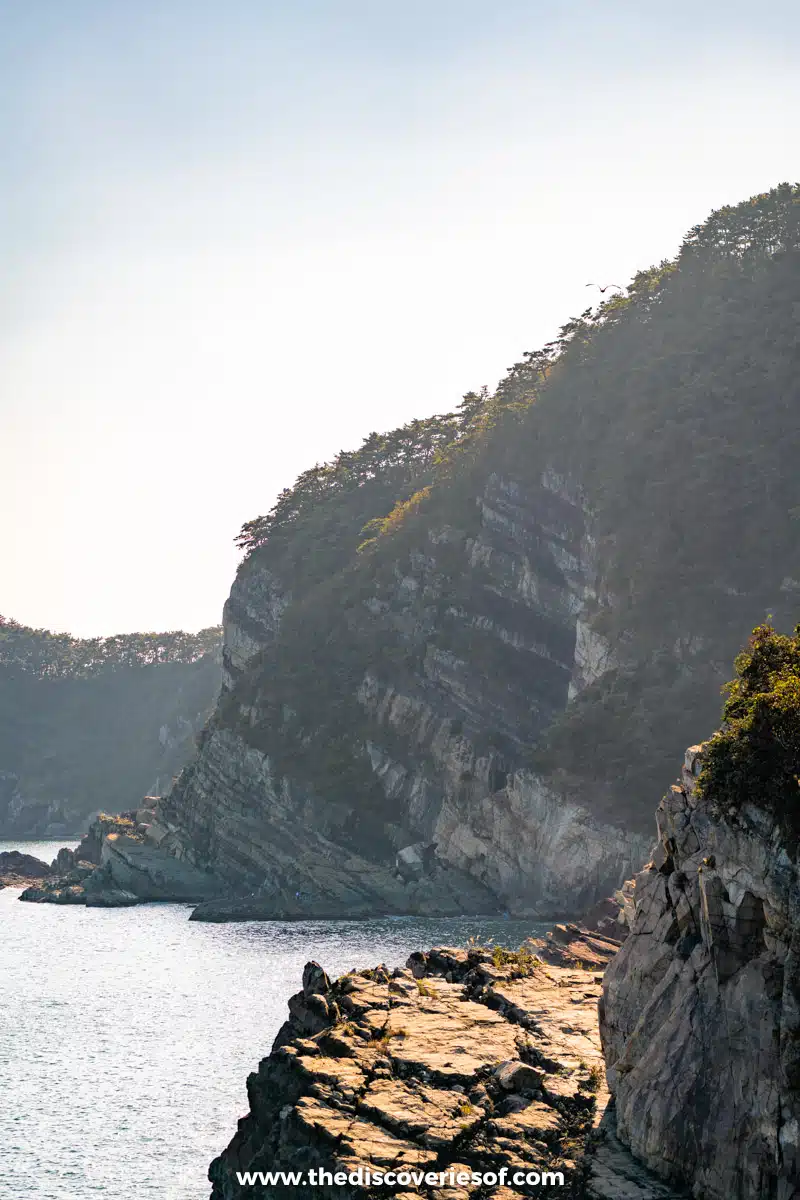
Winters are quite cold, and summers tend to be very hot. If you can, plan your holiday in South Korea for the Spring or Fall. Trying to visit when the weather is perfect? I’d aim for May or September when it’s generally between 13°C – 38°C (55°F – 75°F).
Getting Around
The public transportation system in South Korea is excellent. I used the bullet train to get between Jeonju and Seoul, and it was so comfortable, with beautiful views along the route. You can also rely on the bus system to get from city to city, with several companies offering consistent bus trips, depending on the region. BusTago and Ko Bus are 2 of the most popular options, but you can check Kakaobus or Rome2Rio for specific routes and times.
When you need directions, always use Naver or Kakao – Google Maps doesn’t work well in South Korea.
Group or Tour
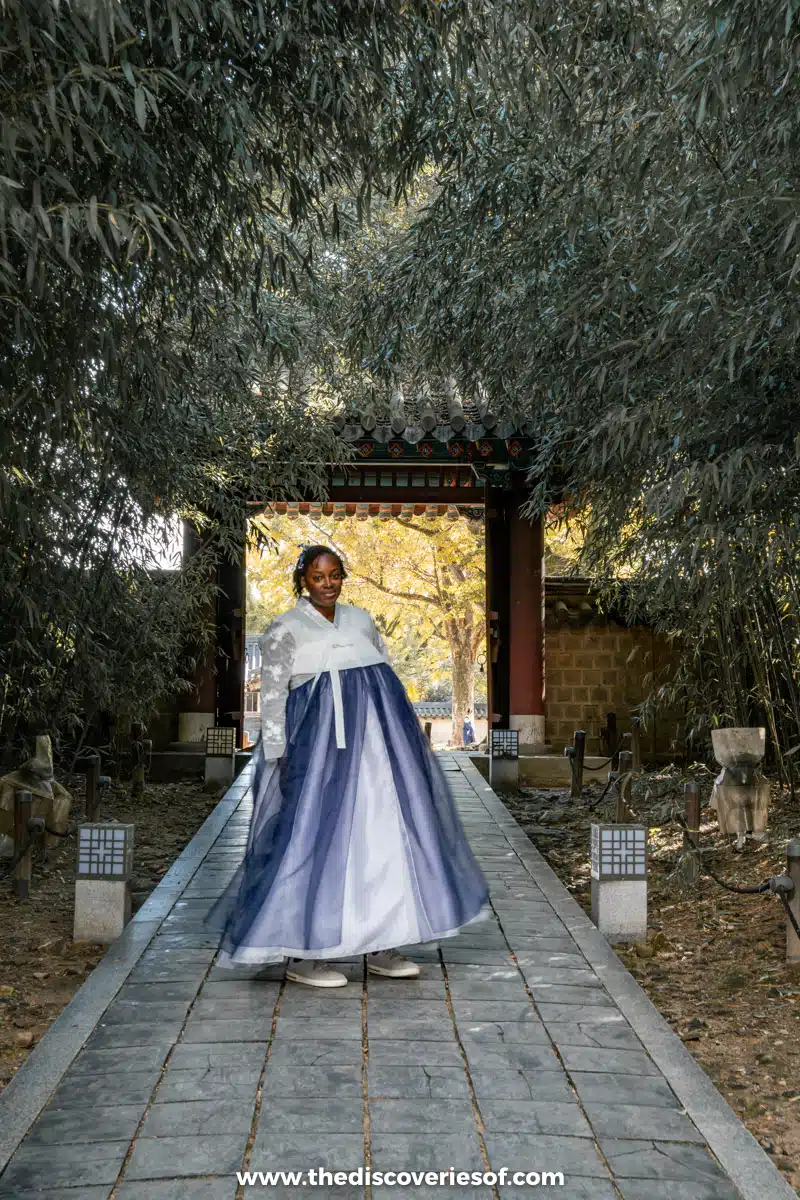
I just returned from a group trip to South Korea, and it was excellent. My only complaint is that I didn’t have just a bit more time to explore each city and town while I was there.
If it’s your first time in the country, I think a group tour is a wonderful way to learn more, especially if your tour guides speak Korean.
But this itinerary for 10 days in South Korea is perfect if you’d rather take your time and check out a few hidden gems I discovered on my most recent holiday.
South Korea Itinerary – Map
*I was hosted on a press trip by the Korean Tourism Organisation – as ever, all thoughts and opinions are my own.
Read More South Korea Guides
- Unmissable Things to do in South Korea
- How to Spend 3 Perfect Days in Seoul
- Unmissable Things to do in Busan
- A Complete Guide to Travelling to Jeonju
- A Complete Traveller’s Guide to Gangneung
- Insider South Korea Travel Tips for Your Trip
Love This? Save and Share on Pinterest
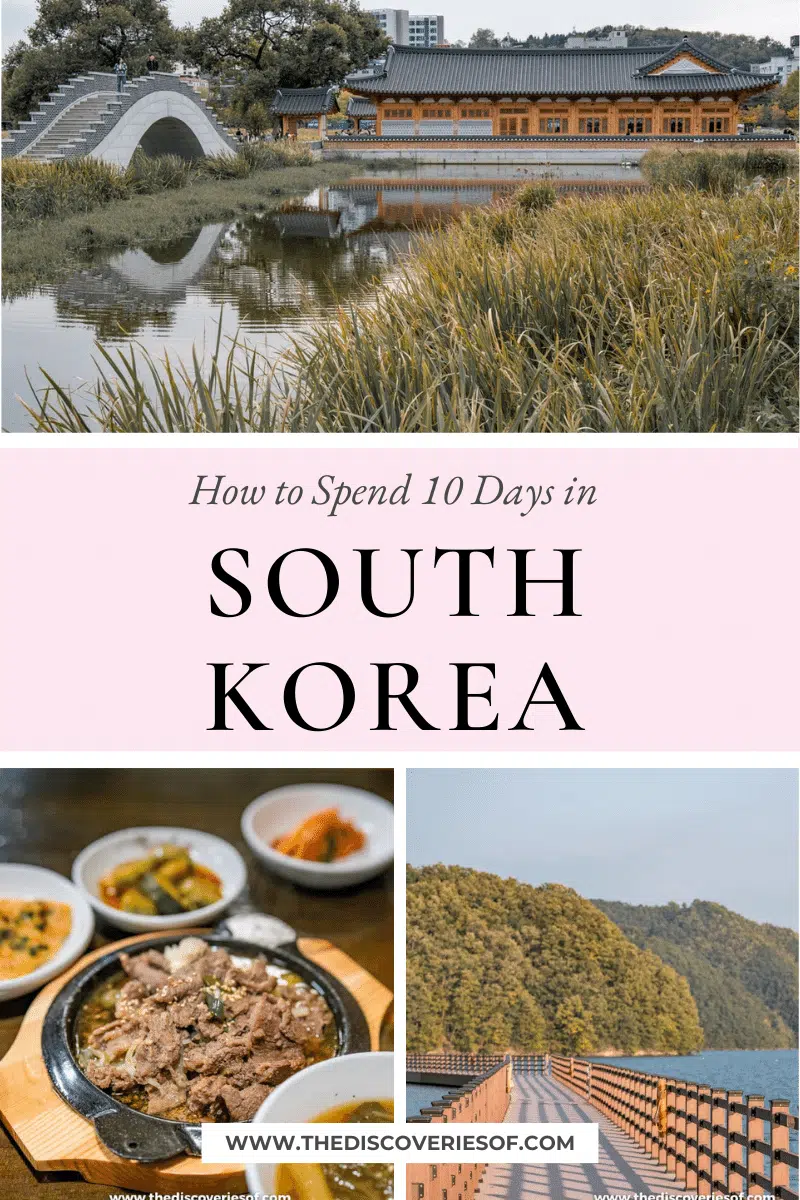
I’m Julianna Barnaby - a professional travel writer and geek extraordinaire. I started The Discoveries Of to help you to discover the best of new destinations from around the world.
Discovering new places is a thrill - whether it’s close to home, a new country or continent, I write to help you explore more and explore differently.
Related Posts
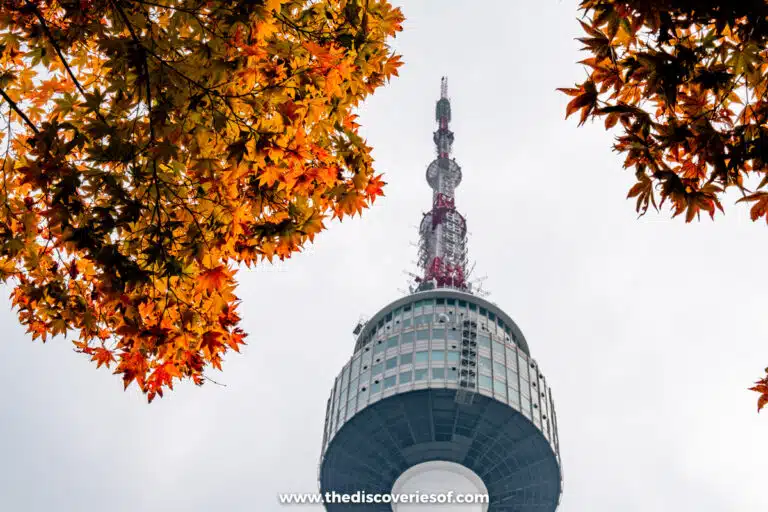
28 Brilliant Things to Do in Seoul
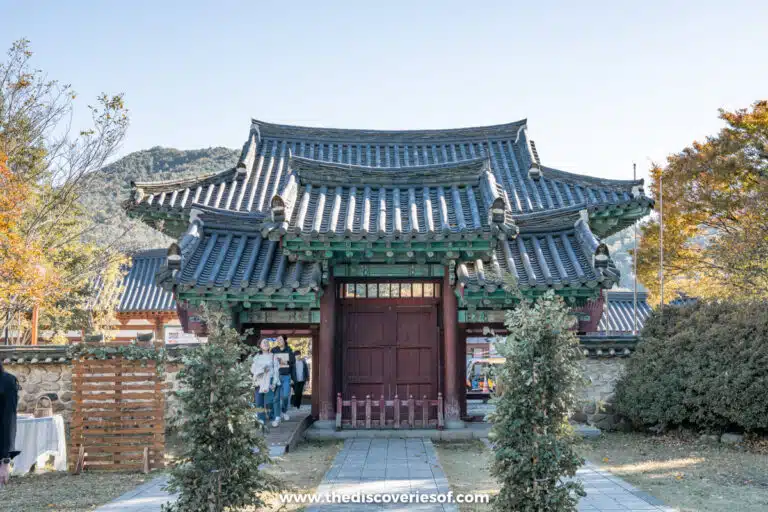
A Complete Guide to Visiting Jeonju’s Hanok Village
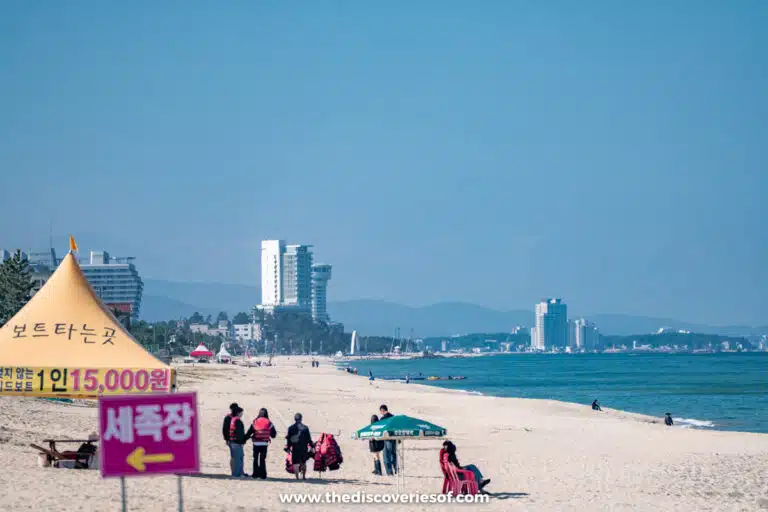
A Complete Guide to Gangneung, South Korea
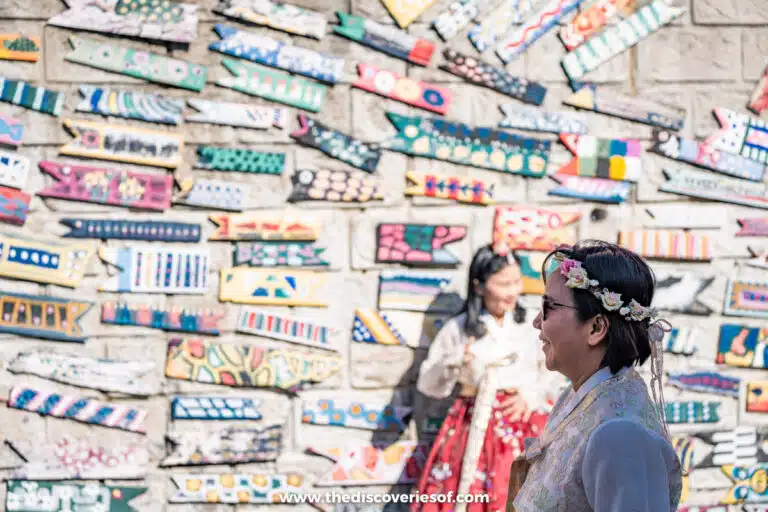
15 Unmissable Things to Do in Busan

Follow me on Instagram for travel inspiration, tips, and guides.

The Best South Korea Itinerary for 2 weeks [Insider’s Guide]
Are you planning your itinerary for Korea? Firstly, I’m super jealous! I lived in Korea for over a year, and I would go back in a heartbeat.
I experienced the best that the country has to offer, and I’m so excited to share this South Korea 2 week itinerary with you.
We’ll start in Seoul, then head to Jeju Island, the so-called “Hawaii of Korea” before jetting off to Busan.
From there, we’ll make our way back to the K-pop capital, with stops at Gyeongju and Sokcho along the way.
But that’s not all, I’ve crafted this South Korea itinerary to fit any season, so whether you’re traveling in summer or winter, I’ve got you covered!
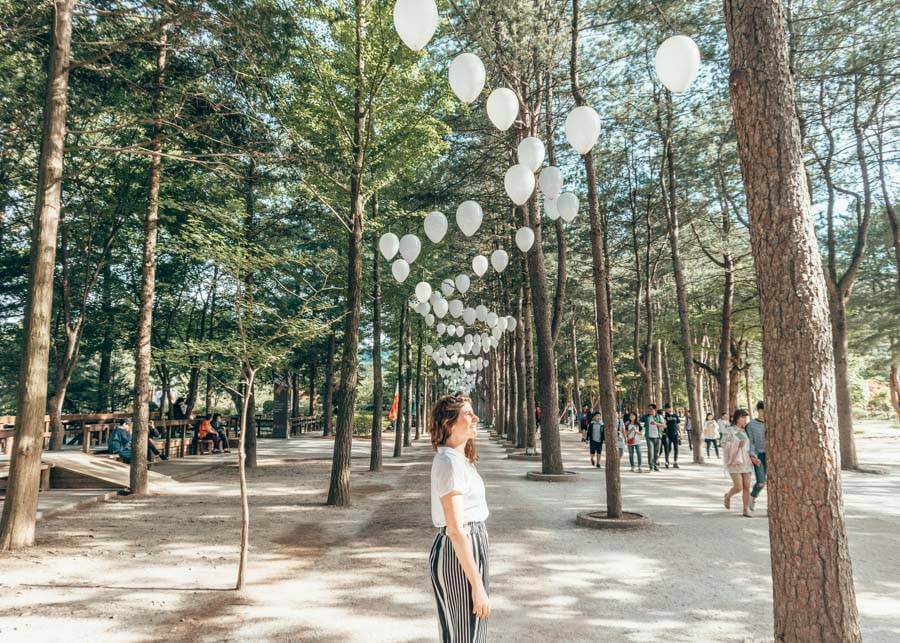
Torn Tackies contains affiliate links. If you make a purchase using one of these links, I may receive compensation at no extra cost to you. See my disclosure for more information.
Quick Navigation
South Korea itinerary
The truth is there is so much to do and see, and with only 2 weeks in Korea, you won’t get to everything!
On the bright side, 2 weeks is more than enough time to explore the capital city, Seoul, and learn about the rich culture.
You’ll indulge in the delicious food and visit spectacular palaces and temples whilst also experiencing the breathtaking landscapes and natural attractions.
This itinerary for Korea is balanced
My Korea travel guide is for those adventurous souls who want to catch a glimpse of Korea’s history.
It’s for solo travelers eager to meet like-minded people. For backpackers looking for that once-in-a-lifetime experience on a budget. It’s for families planning their perfect trip.
That’s why I believe this is the best South Korea itinerary out there because it covers a bit of everything for every type of traveler.
In fact, I’ve left off quite a few attractions that I visited myself.
Do you really want to have temple burnout – as I did after visiting 6 temples in one week?
And markets. There are only so many you can see before they become monotonous (well, besides the food).
And no, you don’t want a soju hangover every day!
Your time in Korea is precious – trust me! But if you follow my tips and advice, you’ll see the best of South Korea in 2 weeks.
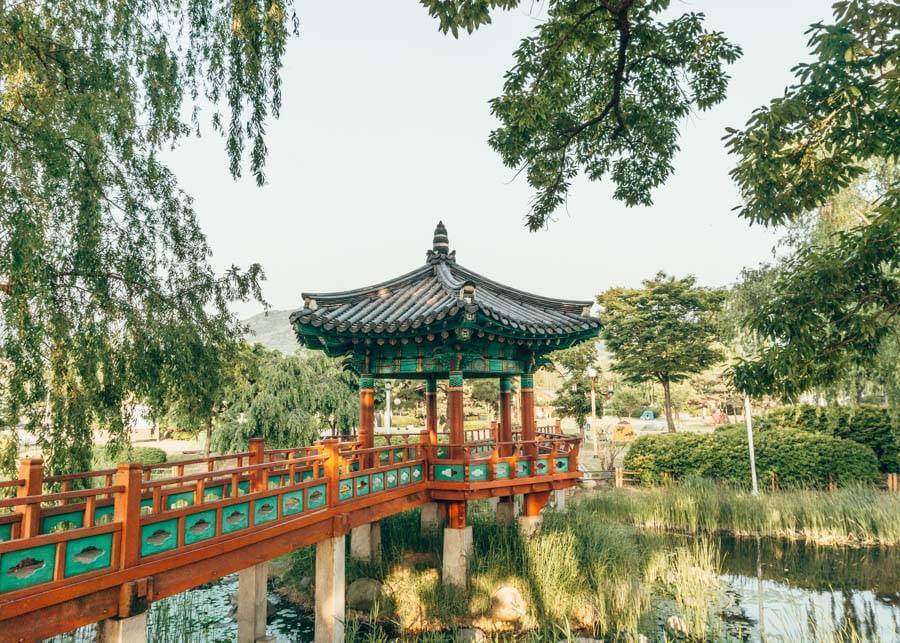
Tips for planning your South Korea vacation
The local currency is the Korean Won. You can easily draw cash from the ATM’s and bank cards are accepted in most places (except for street markets).
Korea is visa-free for most visitors . But as of 2023, there have been changes to the Korea entry requirements. If you’re a citizen from one of the countries that are eligible for visa-free entry, you may still be required to get a K-ETA to enter Korea. You can find out more here.
Pack with caution. When packing for Korea, consider not only the weather but the local customs as well. For example, exposing your shoulders (and chest) is not ok.
Spring and Fall are the best times to plan your trip. Korea has 4 distinct seasons. The summers are excruciatingly hot, whilst winter is freezing cold.
Air pollution is a real thing. At times the air quality is extremely poor, and everyone wears face masks. It’s handy to have one on you when you travel through Korea.
A T-money card is used to access public transport in Korea. You can either purchase this card at a convenience store or train station. But if you’re pressed for time, you may want to preorder one here and collect it at the airport.
Google Translate will be your new best friend. You might be surprised to hear that most Koreans cannot speak English. Seoul is the exception, but when traveling through other destinations within this South Korea itinerary, you’ll need to have Google Translate on hand so that you can communicate with the locals.
Korea is an extremely safe country. Crime is unheard of! If you’re backpacking Korea or you’re a solo traveler, you can rest easy knowing you have the freedom to move around safely.
Get a sim card. Whilst the wifi in Korea is really good, it’s best to stay connected by purchasing a local sim card. This will come in handy when traveling between cities and when you’re out and about trying to find your way around. You can purchase your Korean sim card here , and it will be waiting for you at the airport when you arrive.
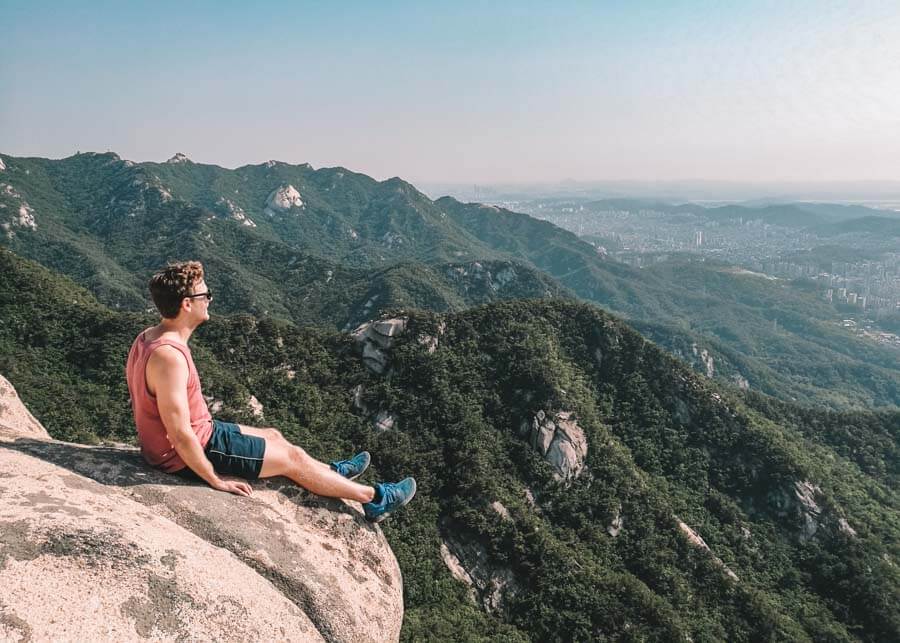
Where to visit in South Korea
Every Korea trip itinerary should include the 3 destinations I’ve highlighted below.
But there are a few other worthy places to visit, and depending on your time and preferences, you may want to add them to your itinerary.
Best Places to visit in South Korea
Seoul is the capital city of Korea and the most exciting place to visit. Many people arrive here and don’t want to leave! It’s a hive of activity with so many things to do and see.
Jeju is a volcanic island south of the country. It’s a popular holiday destination for locals and is famous for its unique landscapes and outdoor attractions.
Busan is the second largest city in Korea. Located on the southeast coast, it’s known for its beaches and seafood.
Other places to visit in Korea
Sokcho is a small fishing village on the northeast coast of South Korea. It’s a bit more off the beaten track and home to the stunning Seoraksan National Park.
Gyeongju is a small city with a rich history. There are historical sights, temples, tombs, and relics around every corner, and it’s often referred to as the museum with no walls!
Jeonju is one of the oldest cities in South Korea. You’ll include this on your South Korea itinerary if you’re looking for a blend of gastronomy and tradition, as it’s home to the famous Korean dish, Bibimbap , and a well-preserved Hanok village.
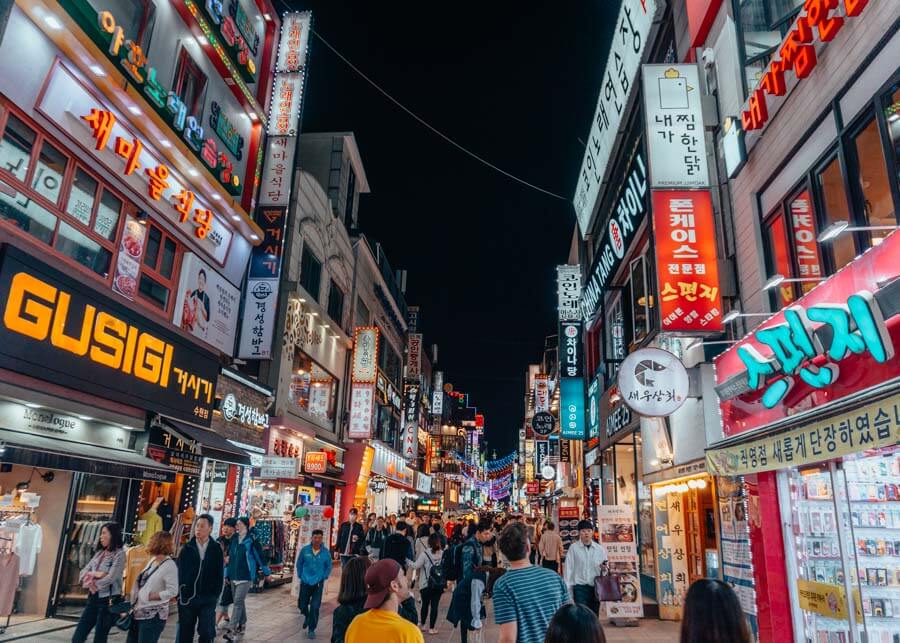
Where to start your itinerary for Korea
Most South Korea trip itineraries start in the city that never sleeps: Seoul.
If there’s one word of advice I can give when planning your vacation, it’s to end in Seoul.
Because Seoul will be the highlight of your 2 weeks in Korea. If you start in the capital, you won’t want to leave!
And whilst Seoul is the most exciting place to visit, the rest of Korea has so much to offer!
If you’re looking for a more authentic Korean experience, then you need to venture to the rural areas, where you’ll discover a whole different side of the country.
On that note, let’s jump right in!
This travel route is flexible and can be cut to a shorter Korea itinerary or extended if you have more than 2 weeks in South Korea.
Travel route for your South Korea itinerary
- Day 1-4: Arrival and Jeju Island (3 nights)
- Day 4-6: Busan (2 nights)
- Day 6-7: Gyeongju (1 night)
Day 7-12: Seoul (5 nights)
- Day 12-13: Sokcho (1 night)
- Day 14: Seoul and departure
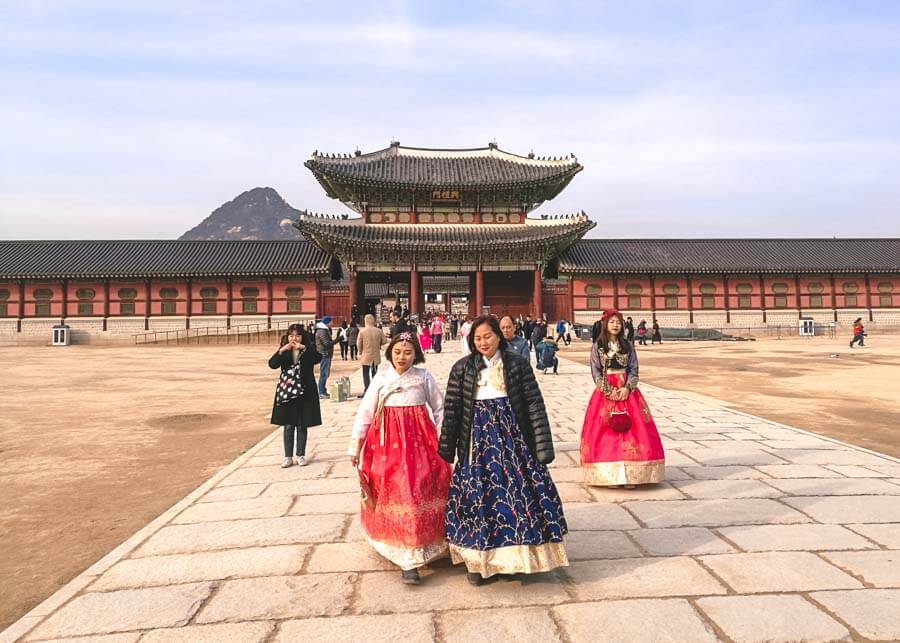
Day 1-4: Jeju Island (3 nights)
Jeju Island, the “ Hawaii of Korea” , is a must on any itinerary for Korea.
Formed through volcanic activity over 2 million years ago, this large island south of the Korean peninsula was recently listed as one of the New 7 Wonders of the World.
Koreans love Jeju – so much so that the flight route from Seoul to Jeju is the busiest and most popular route in the whole world.
Families pop over for a quick weekend getaway, and it’s a favorite for vacationers. It’s also a romantic island and a hotspot for honeymooners.
I had big expectations before arriving in Jeju. It’s the place where I had my first real Korean BBQ, the first time I overindulged in Soju, and the first time I got to experience the Korean way of life, which includes an obsession with selfies!
It was an island of firsts, and whilst it may not have been the tropical paradise I was anticipating, it was spectacular in its own right and is worthy of a spot in your South Korea 2 week itinerary.
How to get to Jeju Island
Jeju Island is the starting point of your vacation to Korea. International flights from across Asia have designated routes to Jeju, so be on the lookout for those.
However, most international flights will land at Seoul’s Incheon International Airport. From there, you will need to catch a flight to Jeju.
Seoul has two airports, Incheon and Gimpo, which are a 40-minute train ride from each other.
Gimpo mostly caters to domestic flights, so you’ll book your flight to Jeju International Airport from here. This is a quick 1-hour flight that costs $40 one way.
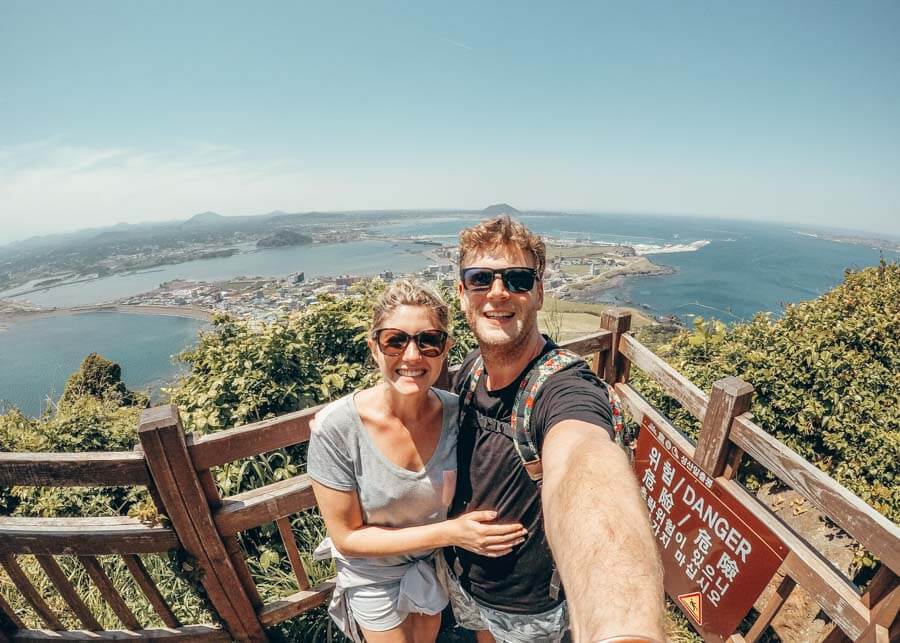
Where to stay in Jeju
Choosing where to stay in Jeju is often the most challenging part of any trip, as the island is massive.
The airport is in the north, in Jeju City, which has a big city feel.
In contrast, the south and east coast are less chaotic and more peaceful areas.
If you’re following this South Korea two week itinerary, I suggest you stay in Seogwipo, which is south of Jeju Island.
It’s within close walking distance to many attractions, and the vibe is awesome.
Budget travelers will love Gudeok Guesthouse , which is where I stayed. It’s the perfect option for solo travelers, backpackers, and even couples. Gudeok Guesthouse is located in the middle of all the action and close to the harbor, with parks and playgrounds close by.
If luxury is what you’re looking for , GoldOne Hotel is the best place to stay in Seogwipo. The rooms are tastefully decorated and are much bigger than most in Korea. The outdoor pool offers spectacular ocean views, and it doesn’t get much better than this.
Things to do in Jeju Island
There is so much to see and do in Jeju . With only two weeks in Korea, you’re going to need to choose your activities wisely.
Day 1 in Jeju
Day 1 is the perfect introduction to Korea.
You’ll probably arrive in Jeju around noon, giving you just enough time to explore one or two attractions. It will be an early night as you’ll be exhausted from your international travels.
Waterfalls: After checking in to your hotel, take a walk to the 2 best waterfalls in Jeju, namely Cheonjiyeon, and Jeongbang Waterfall. Both are conveniently located just a short walk from Seogwipo, so it’s a great opportunity to get some fresh air after a long day of travel.
Jeju Black Pork: After exploring Seogwipo, head out for dinner to try your first Korean meal: A Black Pork BBQ. Jeju Black Pork is world-famous! The meat itself isn’t black but rather the color of the pig. For a true Korean BBQ experience , head to Tam Gung Restaurant in Seogwipo.
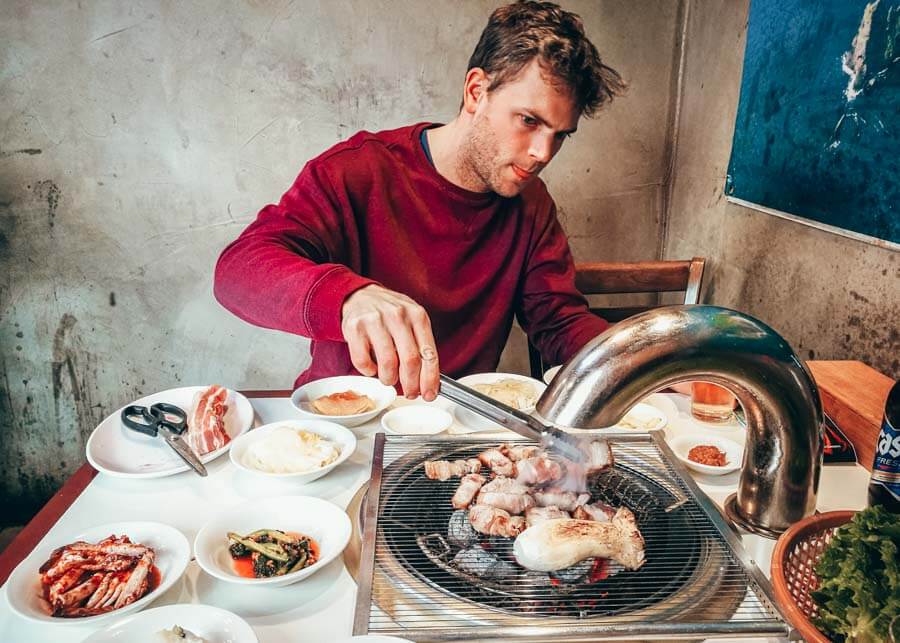
Day 2 in Jeju
Today I recommend you head east of the island to explore several UNESCO World Heritage sites in Jeju.
These spots are not to be missed and should be part of every South Korea itinerary.
You can either book a full-day tour or you can use public transport to get around today.
The public transport in Jeju is good, but not at the same high standard as the rest of Korea.
I only used buses on the island and managed just fine, but they were slow with long wait times.
However, I had more time to play with as I had 5 days in Jeju (and not 3). If you’re able to, I suggest you book a full-day tour instead.
Manjanggul Cave: This cave east of the island is one of the longest in the world! At 13 km in length, you’re guaranteed to set your sights on many spectacular natural attractions. Although only the first kilometer is open to the public, it’s absolutely fascinating.
Seongsan Ilchulbong: Also known as Sunrise Peak, Seongsan Ilchulbong is an extinct volcano and one of the top attractions in Jeju. The hike to the peak takes around 30 minutes and offers unspoiled views of Jeju island in the distance.
Women Divers: The Jeju Haenyeo (women divers) have made a name for themselves in Korea. These women free dive for up to 20 meters and fish for shellfish and clams, which they sell to the local stores. Their work is impressive, especially given that they’re over 70 years of age! You can easily watch them after your hike to Seongsan Ilchulbong as they dive into the ocean at the foot of the volcano.
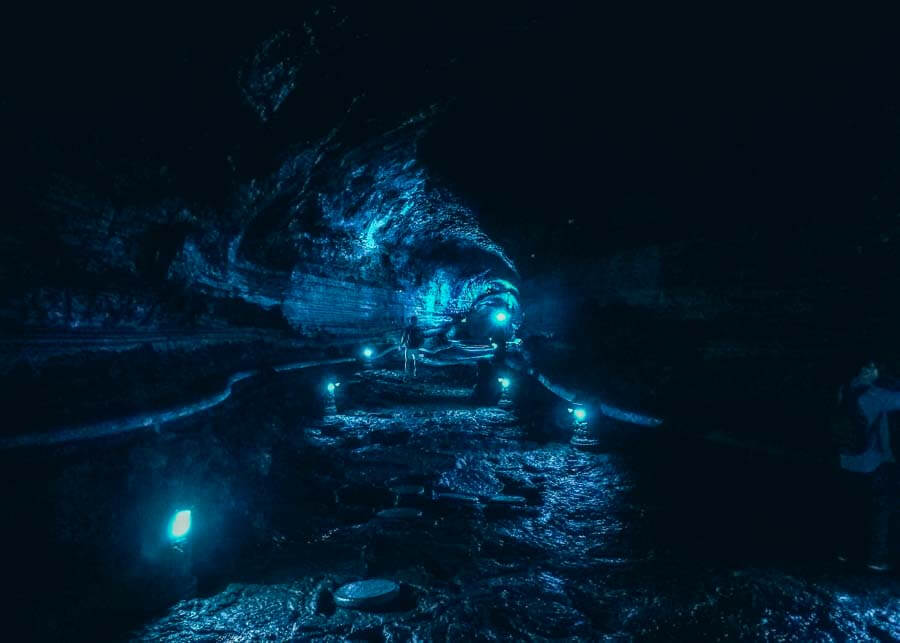
Day 3 in Jeju
Your third day in Jeju can be customized to your preferences.
Beaches: If you’re backpacking Korea during the summer, you have to visit the beaches in Jeju Island. They’re the best in the country! Jungmun Beach on the south coast is arguably the most popular, and Sagye Beach, which is nearby, is also worth a visit. Both are close to Cheonjeyeon Waterfall, which can easily be included in your itinerary for today. If you’re looking to go further west, you’ll find Hyeopjae Beach, which is also a crowd favorite.
If you’re going beach hopping, hire a private driver for the day . This way, you can customize your route and enjoy the beaches at your own pace.
Hike Mount Hallasan: Mount Hallasan is the highest mountain in the country. Many people include it as a bucket list activity on their itinerary for South Korea. Situated in the middle of Jeju, you’ll need a full day to hike to the peak, and it’s best done during the spring or fall when the weather’s pleasant and cool.
Western Island Tour: If you’re looking to see a bit of everything, this western island tour of Jeju is for you. Highlights include Cheonjeyeon Waterfall, tea fields, Hyeopjae Beach, and even a stop at Hanlim Park. You’ll be exhausted by the end of it, but it’s a great mix of the best of western Jeju.
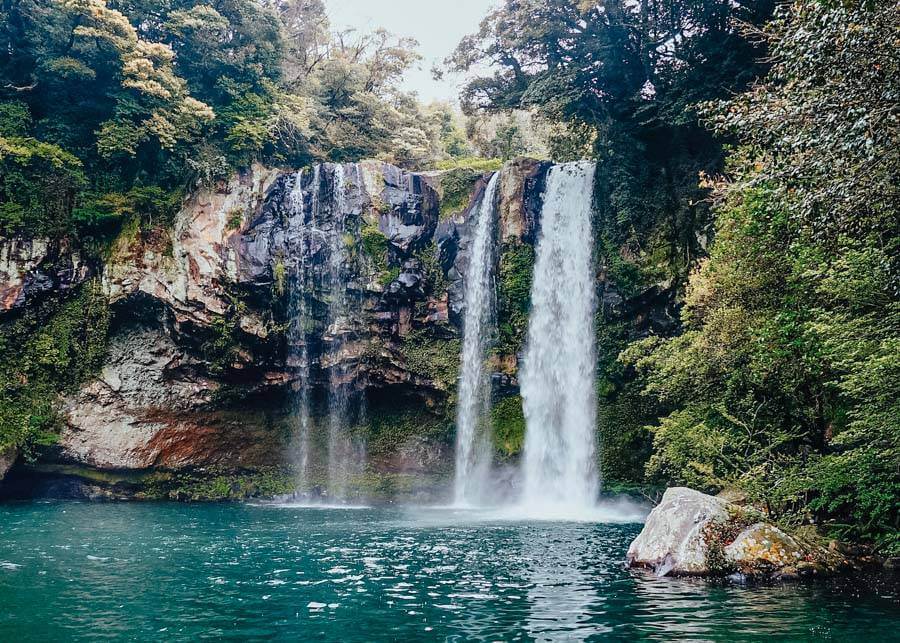
Day 4-6: Busan (2 Nights)
Next up on your 2 week South Korea itinerary is Busan.
It’s the second-largest city in Korea and lies southeast of the country. Famous for its beaches, Busan is strikingly different from Jeju and other cities in Korea.
Although Busan is a favorite for travelers backpacking South Korea, it wasn’t my favorite. But it’s still worth a visit, and that’s why I’ve only included 2 days here.
Where to Stay in Busan
Because you only have 2 nights in Busan, I strongly recommend that you stay near Haeundae Beach. It’s an awesome area with a lively atmosphere and a great vibe.
Haeundae gets extremely busy during the summer, so prices may be inflated. But staying just a stone’s throw away from the beach justifies the cost.
Here’s my guide to the best places to stay in Busan , which includes the pros and cons of each neighborhood.
If you’re backpacking Korea, Mama Guesthouse in Haeundae is the perfect place for you! It’s just a short walk to the beach, where you can spend your evenings watching the sunset.
Got more money to spend? You won’t get much better than Paradise Hotel ! The spacious rooms come with oceanfront views, and the rooftop bar has a luxurious infinity pool.
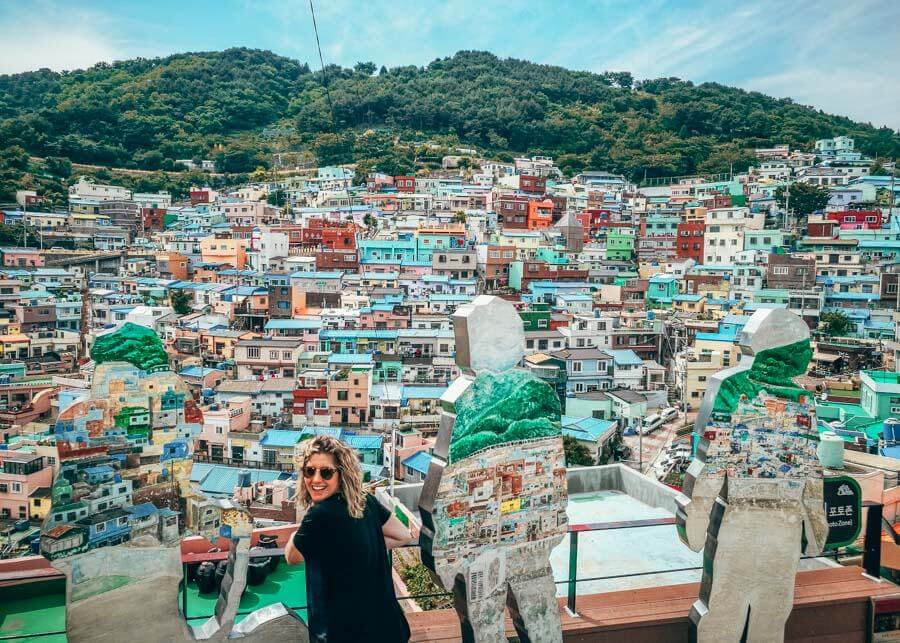
How to get to Busan
Busan is easily accessible throughout Korea via a short flight from Seoul. Or you can hop on the speedy KTX fast train, which is the quicker option!
If you’re following this South Korea 2 week itinerary, then it’s best to book a flight from Jeju to Busan. This won’t cost you more than $40 for the 45-minute flight.
If you’re backpacking Korea, and traveling on a tight budget, you can also opt to take the ferry from Jeju to the mainland. But the journey takes over 12 hours.
Things to do in Busan
You only have 2 days in Busan , and they’re going to be busy!
Put on your walking shoes because you’re off to visit the best places in the city.
Day 4 in Busan
You’ll be traveling from Jeju to Busan on day 4 of your South Korea itinerary.
There are many flights to choose from, but try to get one that leaves Jeju in the morning.
Yonggungsa Temple: This stunning Buddhist temple sits on the coast of Busan, with gorgeous views from its cliffside location. Yonggungsa Temple is 7 km east of Haeundae Beach, but if you’d prefer to take it easy, you can give it a skip. You’ll be visiting many temples over the next few days, and this one is particularly crowded!
Haeundae Beach: I love Haeundae Beach! And no matter the season, there’s always a hive of activity surrounding its sandy shores. Grab a coffee (or a Cass Beer) and some snacks, and head to the beach to watch the sunset.
Jagalchi Fish Market: The Jagalchi Fish Market in Nampo offers the biggest variety of seafood I have ever seen! And you don’t need to order anything if you’re put off by what you see, just take a stroll and watch as the locals do their thing.
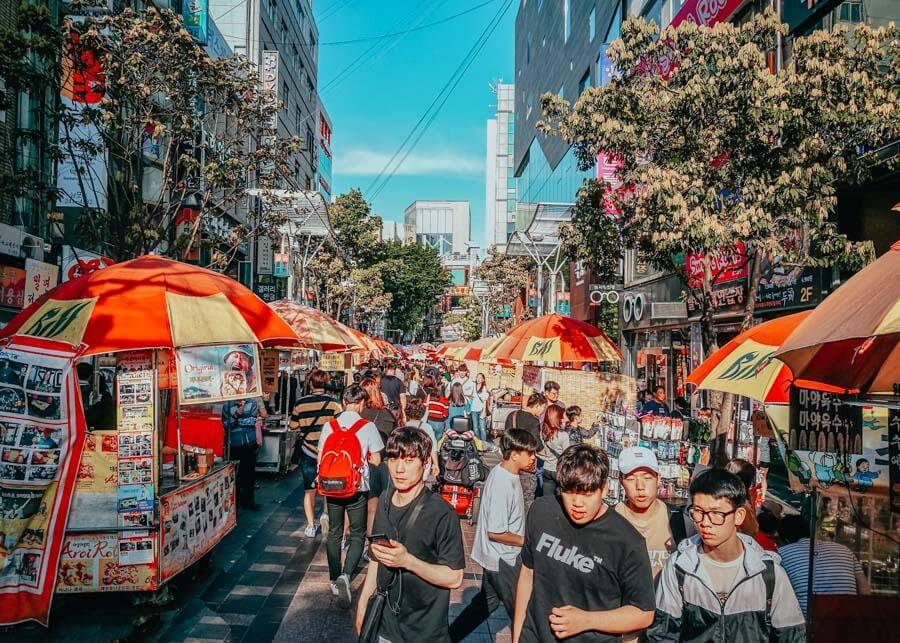
Day 5 in Busan
Your fifth day in South Korea is going to be a busy one!
We’ll be heading southwest of Busan to check out some epic places. All the attractions are found along the same route, so it makes sense to visit them all today.
Gamcheon Culture Village: Gamcheon Culture Village is an iconic neighborhood in Busan. This bright-colored and vibrant neighborhood was once a slum but has now been transformed into an Instagrammers dream location with quirky houses, murals, and statues dotted all over the show.
Biff Square Market: After visiting Gamcheon Culture Village, you will have worked up quite the appetite. It’s the perfect time to visit your first street market in Korea! And the food here will blow your mind and satisfy all your cravings. While you’re at it, you can purchase some socks, beauty products, cell phone accessories, and more because Biff Square has everything.
Gwangalli Beach: Gwangalli Beach is another one of the top beaches in Busan. After a busy day exploring, you can finally head to Gwangalli Beach where you can chill by the seaside. Here’s where you’ll spot live performances on the beach, selfies galore, and couples having photoshoots. Once the sun’s set, head to a nearby chicken and beer restaurant (yes, it’s a thing, and yes, you have to try it) before making your way back home.
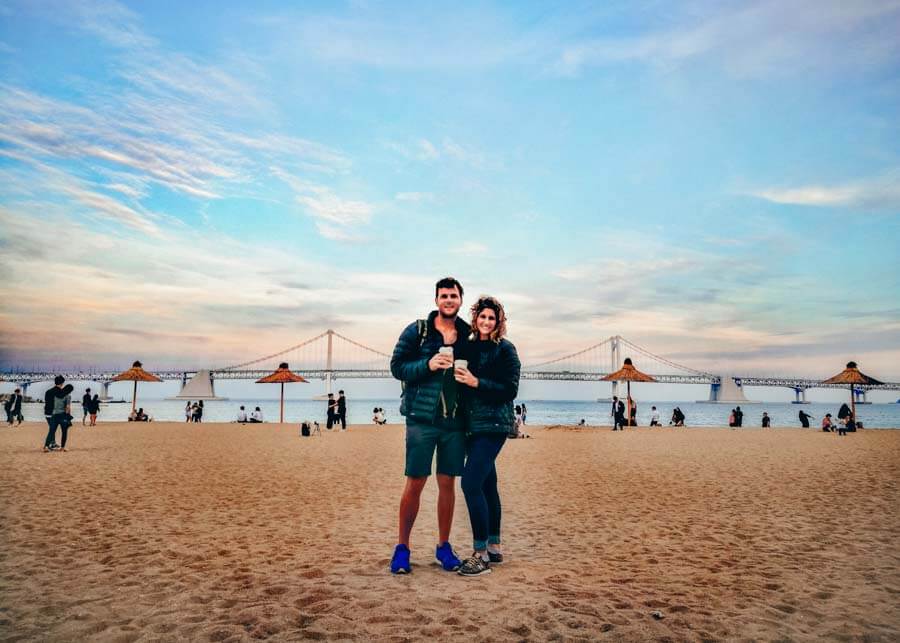
Day 6-7: Gyeongju (1 Night)
Before saying goodbye to Busan, have an early start to the morning and visit Life Day Spa, one of my favorite Jimjilbangs in Korea.
No Korea itinerary is complete without visiting these traditional bathhouses.
This particular spa is more Westernized and caters to tourists. It’s a great option if you’re not sure of what to expect.
Once you’re done, it’s time to head off to your next destination, as you’ll leave Busan today.
You have a few options for things to do and places to go: Either Gyeongju or Seoul.
In my initial itinerary for Korea, I had allocated more time to Busan. But after spending 2 days in the city, I was keen to check out something new.
It’s not that I didn’t love Busan, it was just a lot, and my first days were pretty busy.
I wanted to see a more traditional side to Korea, so I headed to Gyeongju.
Gyeongju was the capital city of the ancient kingdom of Silla and is one of the most historical sites in South Korea.
It was once the 4th biggest city in the world and holds a significant place in Korean history.
Should Gyeongju be on your itinerary for Korea
But Gyeongju isn’t for everyone. It’s a charming city with a rich history and cultural heritage of the Silla dynasty.
As you can imagine, Gyeongju has a completely different vibe to that of Seoul and Busan.
I never saw any foreigners during my time there. But I loved this feeling of being so foreign and completely out of my comfort zone.
If you’re looking for nightlife, a backpacking crowd, and other creature comforts, then don’t visit Gyeongju.
If that’s the case, skip this section of my South Korea itinerary and continue onto Seoul (and then Sokcho)!
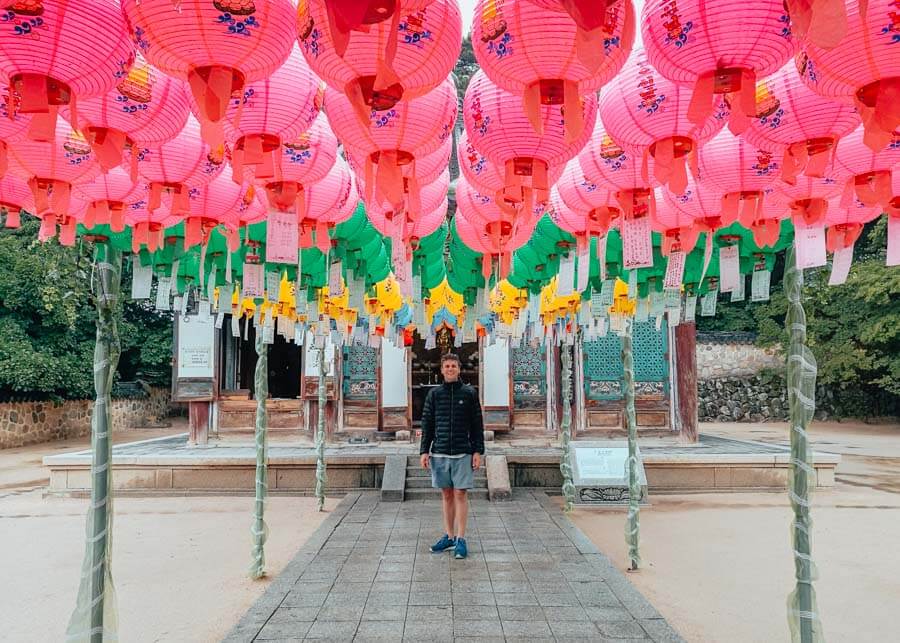
How to get to Gyeongju
Gyeongju is a short 1-hour drive north of Busan.
The easiest way to get here is to hop on the express bus at the Nopo Bus Terminal (in Busan) to Gyeongju.
You can find the bus schedules here.
Where to stay in Gyeongju
Gyeongju is a relatively small city, and it’s best to stay near the bus terminal as you’ll only be here for one night.
I stayed at Motel Apple House , conveniently located in the middle of town. The price is affordable, and the rooms are much bigger than most. I rented bikes from the owner, who happily offered us insider tips on where to go and what to do.
A more luxurious option is Gyeongju GG Tourist Hotel. This hotel is one of the best! Its prime location is the biggest selling point (and the delicious breakfast that’s included).
Things to Do in Gyeongju
Despite being a small city, there is plenty to keep you busy.
These are the highlights and what you should include in your 2 week South Korea itinerary.
Day 6: Arrive in Gyeongju by 11 am
Try to get to Gyeongju before noon so that you have time to explore the city on your first day.
Rent a bike: The best way to experience Gyeongju is by bike. The city is small, so you can easily cycle around, visiting the top attractions in a short space of time. You can rent a bike from your accommodation, but there are many bike rental shops throughout the city, and it won’t cost you more than 5 000 won ($4) per day.
Daereungwon Tomb Complex (Tumuli Park): When cycling through the city, make your way to Tumuli Park where you’ll find the royal tombs. They are easily identified as they resemble small mountains within a park. These tombs are the resting place of kings, queens, and court officials, but most are unidentified.
Donggung Palace and Wolji Pond: Formally known as Anapji, it’s hard to believe that this was the palace complex of the ancient Silla. Walking through the restored complex grounds was like going back in time. If possible, visit the palace at nighttime when the soft lights illuminate the pond and temples.
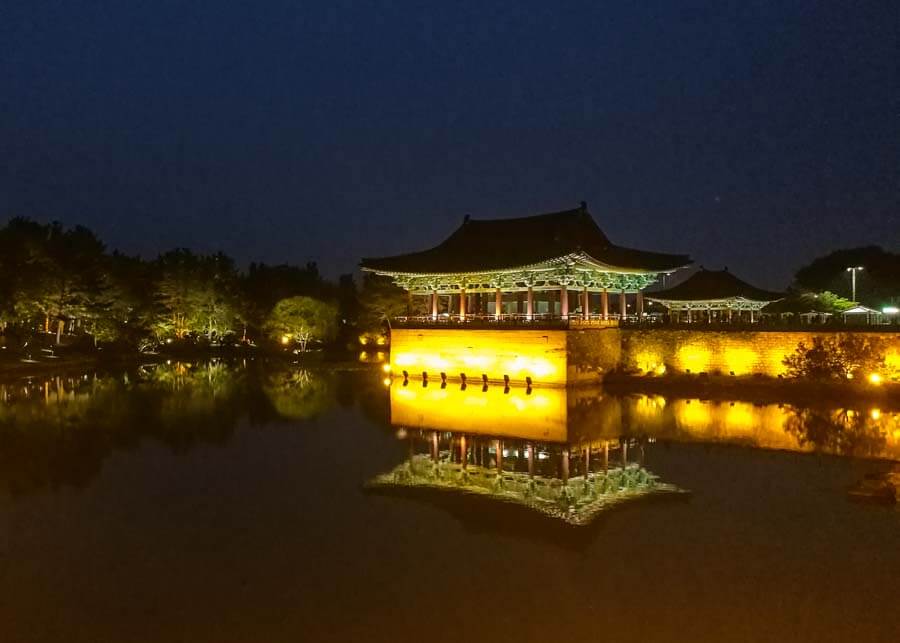
Day 7: Gyeongju (Depart for Seoul by 2 pm)
Today is going to be busy. But you’ll be on your way to Seoul by the end of it.
First, you have a bit of sightseeing to do in Gyeongju! Start early so that you leave Gyeongju before 2 p.m.
The Bulguksa Temple: The Bulguksa Temple is a national treasure and one of Korea’s most important temples. This working Buddhist temple is located on the outskirts of Gyeongju and is a UNESCO World Heritage Site. I was amazed by how beautiful the temple complex was, with its wooden buildings hidden high up against the mountain. Surrounded by lush trees, the Bulguksa Temple has a calm and serene atmosphere and is a must-visit if you include Gyeongju in your itinerary for Korea.
Seokguram Grotto: Within the Bulguksa Temple complex lies the Seokguram Grotto which houses a monumental statue of the Buddha. The hike from Bulguksa Temple to Seokguram Grotto takes over an hour, but the views are stunning. Alternatively, you can hop on a bus that leaves every hour.
After spending your morning visiting Bulguksa Temple, it’s time to get to Seoul!
How to get to Seoul
The quickest way to get from Gyeongju to Seoul is via the KTX fast train, which takes 2 hours. But it does have its downsides!
Firstly, this ticket is about double the price of the bus, so if you’re backpacking South Korea on a budget , you may opt for the cheaper 3.5-hour bus trip instead. Secondly, the train station is about 15 minutes drive outside of Gyeongju, which will be an additional cost for a taxi.
I took the bus from Gyeongju Bus Terminal to Seoul, and it was quick, easy, and cheap!
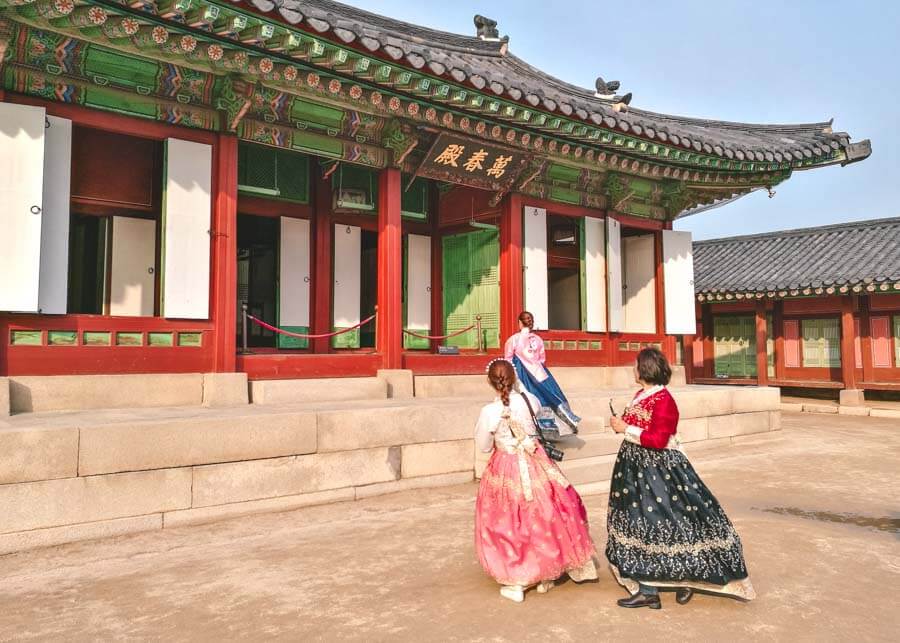
What better way to kick off your second week in South Korea than by hitting the big city, Seoul.
You can’t come on a vacation to South Korea and skip Seoul – it’s unheard of!
After spending the past 7 days traveling between Jeju, Busan, and Gyeongju, all destinations that offer contrasting experiences, you’ll find a good mix of everything in Seoul.
It effortlessly combines the old with the new. You’ll be blown away by the towering buildings, bright neon lights, and the latest (and greatest) tech.
But amongst the hustle and bustle, you can still find gorgeous temples and spectacular landscapes, making it the best place to visit in Korea!
How many days in Seoul
If you have 3 weeks in Korea, I recommend you spend 7 days in Seoul, which will include day trips to destinations nearby.
But, for a 2 week Korea itinerary, you may need to exclude certain attractions or plan your days so that you can squeeze in all the sights.
So, according to this itinerary for Korea, you have 7 days left in Korea.
Either you’ll spend the last 7 days in Seoul, or you’ll do 5 days in Seoul and head east to Sokcho for the other 2 days.
Top tip: If you decide to skip Gyeongju, you’ll still have 7 days in Seoul and 2 days in Sokcho!
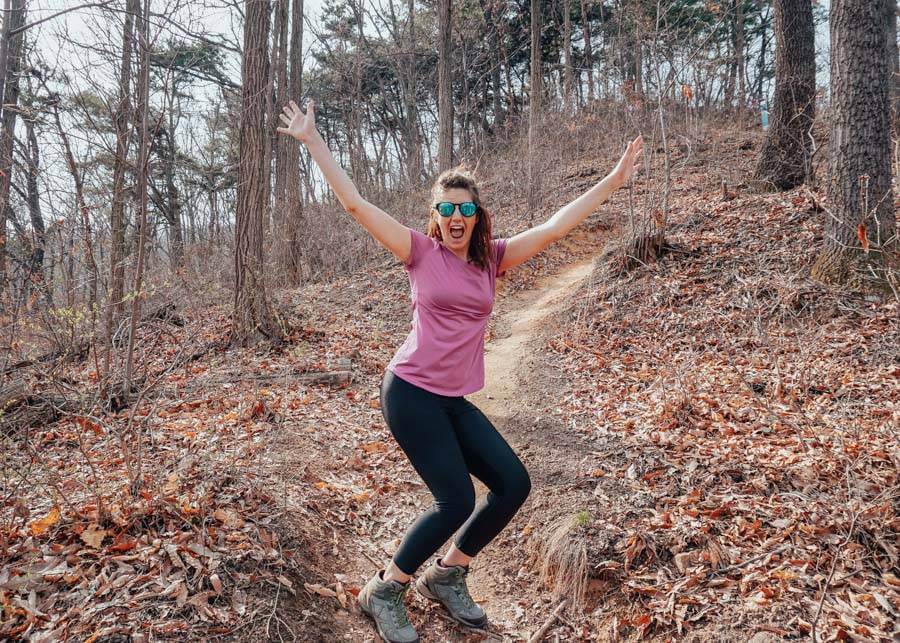
Where to stay in Seoul
Seoul has one of the best public transport systems in the world, making it easy to explore the city and navigate between the sights.
This also means that you can stay in one area and use it as your base instead of constantly moving around.
Myeongdong gets my vote as it is the most central area to stay in Seoul . It’s close to many attractions, and if you’re planning on doing any tours, most have pick-up points at the Myeongdong station.
Backpackers in South Korea will love Myeongdong Rooftop Hostel . It’s a brand new hostel situated slap-bang in the center of Myeongdong with an epic rooftop area offering great views of N Seoul Tower.
If you’re looking for a quieter and more elegant option, Hotel 28 Myeongdong ticks all the right boxes. This luxurious boutique hotel is the center of Myeongdong, close to all the action. It’s just the type of place you want to come home to after a long day of exploring, with a stunning interior, comfortable beds, and gorgeous views from the rooftop bar.
Things to do in Seoul
Here are the top things to do in Seoul, which should be on every itinerary for Korea.
Day 7 in Seoul: Arrival in the evening
If you’re following this South Korea itinerary and coming from Gyeongju, you’ll likely arrive in Seoul late afternoon or early evening.
Explore Myeongdong: Myeongdong is the shopping district of Seoul and home to the best street food in the city. It’s bright and vibrant and the first place you’ll visit in Seoul. Myeongdong is best to visit in the early evening. Walk the streets, do some shopping, eat tteokbokki and gimbap , and take in all that is Seoul!
Cooking Nanta Show: The Cooking Nanta Show is a live performance combining arts, dance music, and entertainment. This 90-minute food extravaganza takes place in Myeongdong, so it’s the perfect way to end your first day in Seoul. Buy your Nanta Show tickets here.
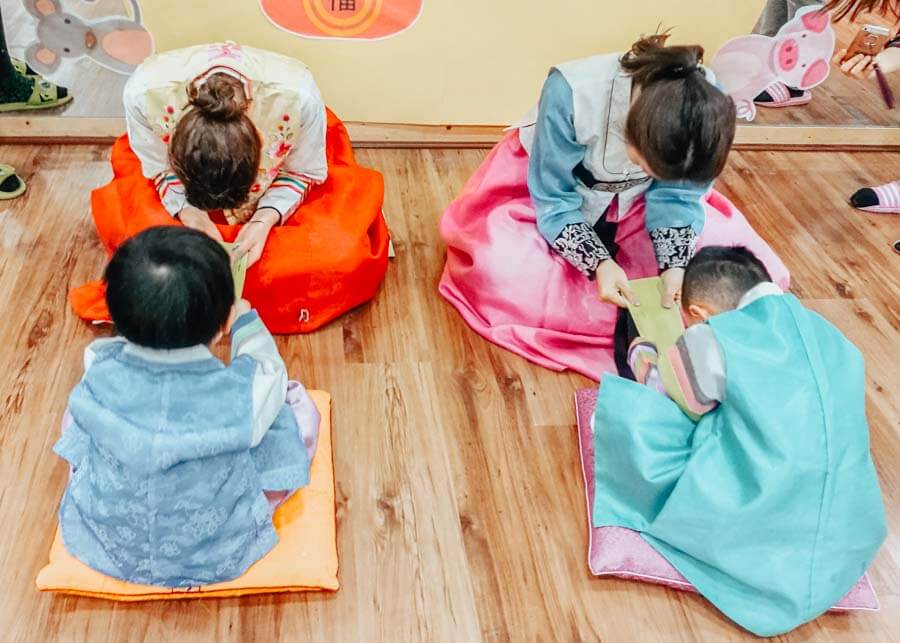
Day 8 in Seoul
Bukhansan National Park: Start early with a hike to Bukhansan National Park, one of the most beautiful natural attractions in Seoul. The hike to the highest point, Baegundae Peak, is a tough one, but the views are spectacular. You’ll need 3-5 hours for your morning’s adventure.
Top tip: If you’ve decided on the Sokcho addition to your South Korea itinerary, then you may want to skip this hike to Bukhansan. Why? Because you’ll be hiking Seoraksan National Park (in Sokcho) a few days later.
Itaewon: Itaewon is the party district of Seoul, and I love the vibe here! It’s also multicultural, with scores of local and western restaurants. Grand Ole Opry is one of my favorite bars in the area! As with Myeongdong, it’s best to plan your trip to Itaewon in the evening when the streets come alive.
If you’re not one for hiking (or drinking in Itaewon), you can easily add Gangnam to today’s itinerary. It’s the district where the rich and famous hang out. It’s also home to the Instaragammable Starfield Library and Coex Shopping Center, as well as Bongeunsa Temple.
I enjoyed Gangnam, but I preferred hiking and partying in Itaewon. Hence I’ve included it as an optional extra. You can also include Gangnam on your last day (which I’ve mentioned further along) .
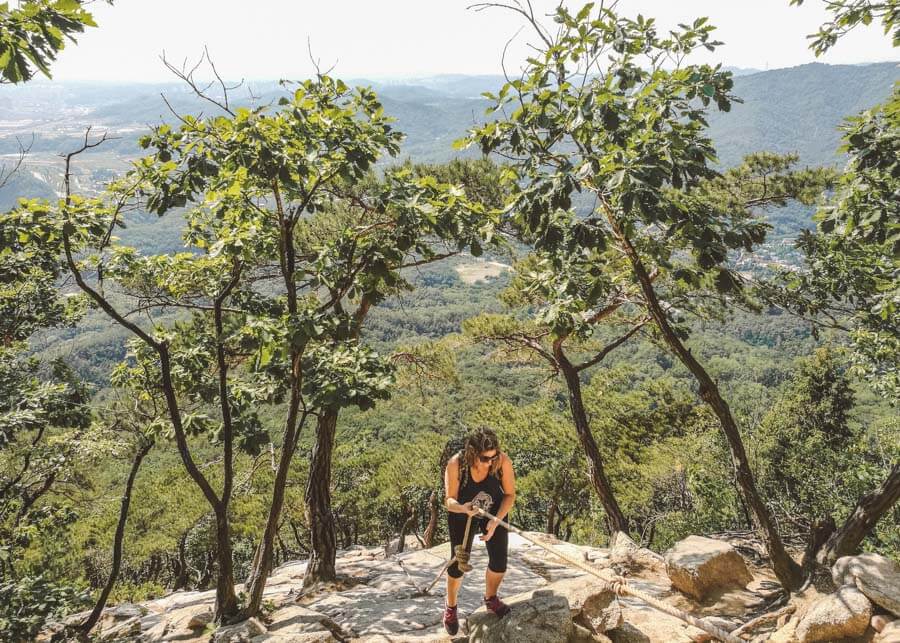
Day 9 in Seoul
Bukchon Hanok Village: This is one of the most iconic traditional villages in Korea. With its narrow streets and charming houses, called hanoks, Bukchon Hanok Village is a great place to explore on the 9th day of your South Korea itinerary.
Gyeongbokgung Palace: This palace complex was once home to royalty! The gorgeous temple grounds are fascinating, and it’s common to wear a traditional Korean dress called the hanbok when exploring.
You then have three options of what to do after, depending on your time and energy levels.
Han River: The Han River is yet another famous landmark in South Korea. Alongside it, you’ll find gorgeous parks, walking trails, and playgrounds. It’s a hive of activity during the weekends, and it’s a great place to hang out after a busy morning exploring.
If you’re running late, you may need to skip the Han River in favor of N Seoul Tower and Hongdae (below).
N Seoul Tower: N Seoul Tower, otherwise known as Namsan Tower, is the second-largest point in Seoul and offers sweeping views of the sprawling metropolis in the distance. I recommend that you take the cable car to the peak and walk back down through Namsan Park. N Seoul Tower is easily accessible from Myeongdong, so you can head home and freshen up before hitting Hongdae.
Hongdae: Hongdae is a university neighborhood filled with live street performers, cool cafes, noraebangs (Karaoke rooms), and epic bars. The youthful and fun atmosphere attracts backpackers in Korea, and it’s a good spot to check out in the evening.
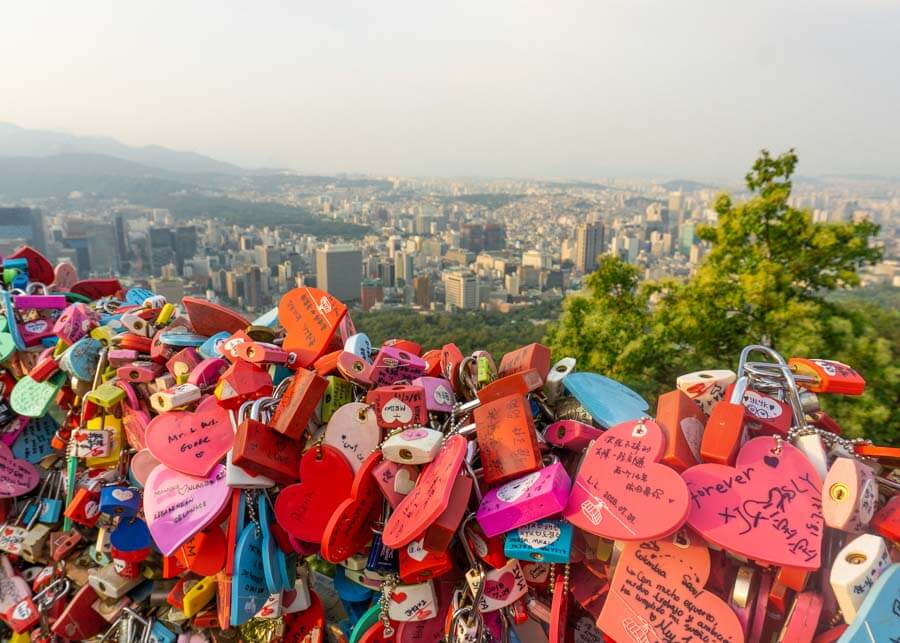
Day 10: Day Trip to Nami Island
Nami Island is only 50 km from Seoul and makes a great addition to your itinerary for Korea.
I spent a night here. But given your time limits with only two weeks in South Korea, I don’t suggest you do the same.
It’s best to book a day trip from Seoul as there is so much to do and see in the Gapyeong region.
Nami Island: Nami Island is a half-moon-shaped island located east of Seoul. Like Jeju Island, don’t expect those tropical island vibes! It’s popular for couples and families and has a quirky and cool vibe to it. With gorgeous tree-lined walkways and beautifully manicured paths, Nami Island is an awesome day adventure, allowing you to get a feel for what Korean love most.
READ MORE: THE PERFECT NAMI ISLAND ITINERARY
Gangchon Rail Park: Just a stone’s throw away from Nami Island lies two of the best rail bike parks in Korea: Gangchon and Gapyeong rail parks. These awesome parks allow you to peddle down unused tracks, through mountains, and alongside rivers. It’s a beautiful way to experience the Korean countryside, away from the hundreds (if not thousands) of people you’ll see at Nami Island. Here’s why I believe Gangchon Rail Park is better than Gapyeong Rail Park!
Eat Dakgalbi: Yep, this is getting its own shout-out! Dakgabli (the most delicious marinated chicken and cheese dish you will ever have) is famous in Gapyeong, and you’ll find many restaurants serving up the yummy dish. Make sure dakgalbi is part of your lunch plans!
More to do: I highly recommend you visit the above attractions in Gapyeong, but there’s more to do in the area. Petite France and the Garden of Morning Calm are destinations included in most Korean itineraries. If you’re traveling independently, then you may not be able to visit them due to time limitations. But if you book a group tour like this one , private transport is provided, which will allow you to see all the top sights around Nami Island.
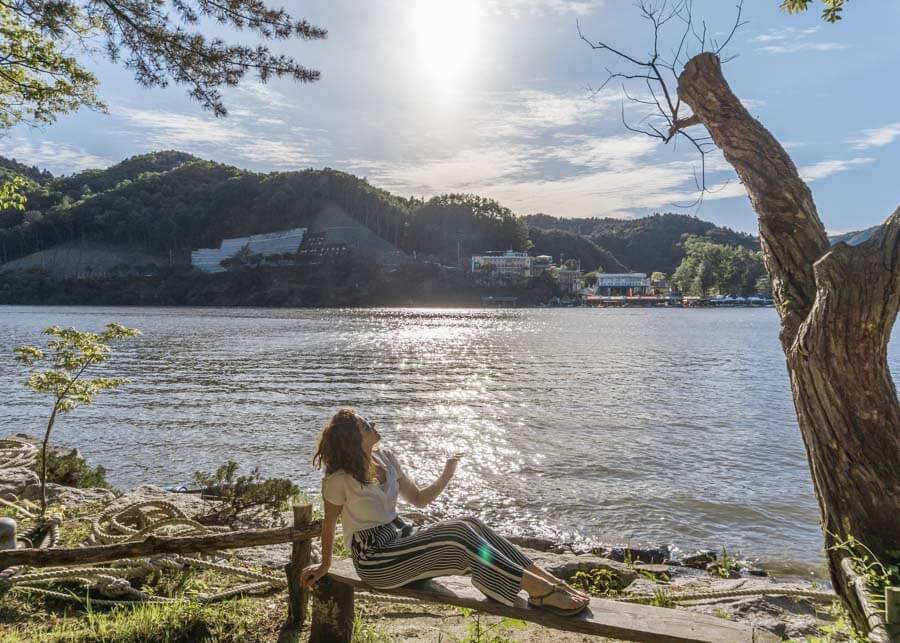
Day 11: Day Trip to DMZ
It’s no secret that there is tension between North Korea and South Korea!
The DMZ is proof of this, as it is one of the heaviest militarized borders in the world.
Visiting the DMZ is only possible with a group tour like this , and it’s easily accessible on a day trip from Seoul.
Depending on what else you want to see in Seoul, you may want to take the half-day DMZ tour so that you can return earlier to check out other destinations you’ve missed (Such as Gangnam, Hongdae, or the Han River).
You can find the best half-day tours here .
Unfortunately, these half-day tours don’t include stops at the Joint Security Area (JSA). So if this is on your Korea bucket list, you’ll need to opt for the full-day DMZ tour instead.
This is what I did, and I was absolutely knackered afterward, so be wary of planning too many activities for the evening!
2023 Update: The JSA is currently closed to visitors, but there are still tours going to other sections of the DMZ .
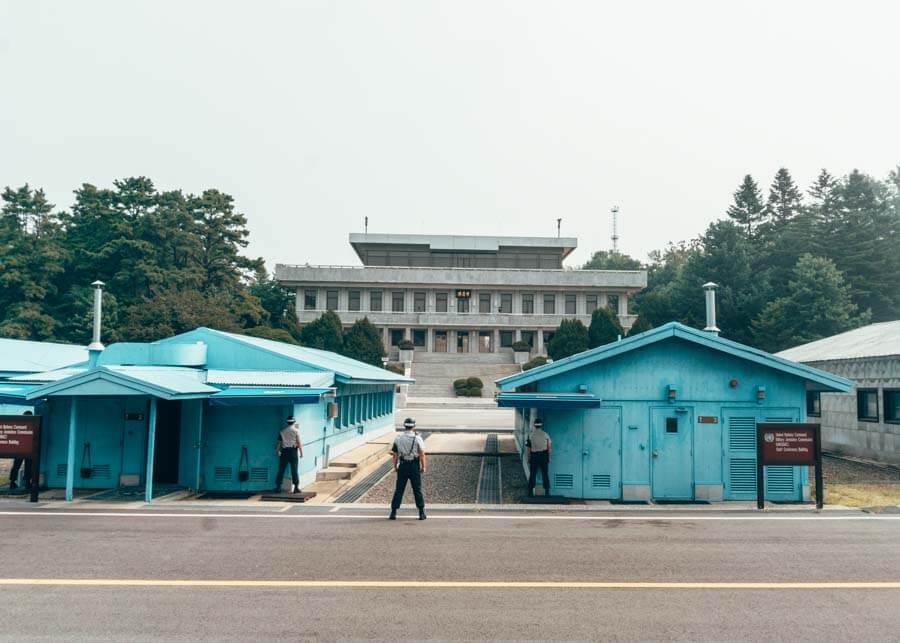
Day 12-14: Seoul or Sokcho
You’ve already spent 5 days in Seoul – and you’re guaranteed to love it!
Since you only have 3 days left on your South Korea itinerary, it’s time to make a big decision.
Do you want to spend more time in Seoul? Or do you want to check out Sokcho?
Day 12-14 in Seoul
If you decide to stay in Seoul, there are plenty of attractions to keep you busy.
Go skiing: If you’re planning this itinerary for Korea during winter, you must head to the mountains and go skiing. There are numerous awesome ski resorts near Seoul – many of which I visited myself.
Visit Everland: Everland is the Disney of Korea. If you’re planning your South Korea itinerary with your family, you need to visit Everland. Lotte World is also a crowd favorite. Both Everland and Lotte World get extremely busy on weekends and public holidays, so try to avoid visiting these days. To save time waiting in queues, purchase discounted tickets here.
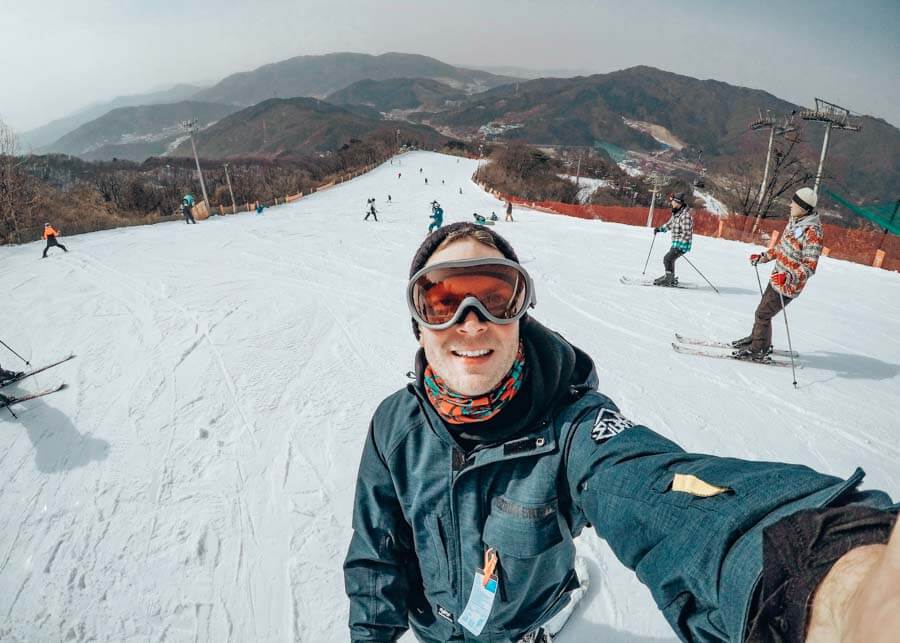
Day 12-13: Sokcho (1 Night)
Nature enthusiasts will love Sokcho as it’s home to Seoraksan National Park.
It’s on the east coast of Korea, a 3-hour drive from Seoul.
Many shorter Korea itineraries include Sokcho as a day trip recommendation,.
Yes, it’s possible on a tour like this .
But considering the time it takes to get there, it’s best to spend the night.
How to get to Sokcho
The easiest way to get to Sokcho is to take a bus from Seoul’s Express Bus Terminal to Sokcho.
This trip will take under 3 hours (traffic dependent) and will set you back on 14,000 won ($11) for a one-way ticket.
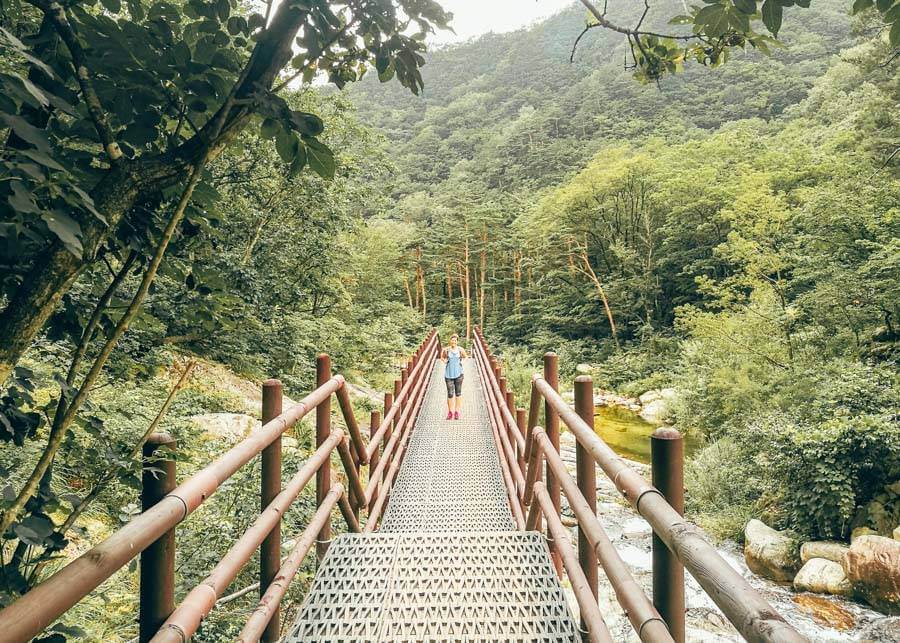
Where to stay in Sokcho
Sokcho is surprisingly small, but there’s a range of accommodation options to suit every budget and travel style.
Try to stay near the beach so that you’re within walking distance of everything.
Budget travelers will love Sokcho Hutte . What makes this place shine is the hospitality of the owner, who will go out of his way to ensure you have a great trip. Situated near the bus terminal, the location couldn’t be better.
If you’re traveling on a mid-range budget, you may prefer to stay in The Mark Sokcho Residence , which offers bigger rooms with their own kitchenette areas. The comfortable space also offers views of the beach and ocean.
Day 12: Arrive in Sokcho by 11 am
Hike Seoraksan National Park. This national park is breathtaking, and you can spend hours hiking through the forests and wandering the rugged paths. There are several trails you can choose from, each with varying levels of difficulty. I hiked to Ulsanbawi Rock which was quite tough but is known to have some of the best views in all of Korea. ( Although I didn’t get so lucky as it was overcast and cloudy on the day of my hike )
Day 13: Sokcho and Seoul
You’ll be leaving Sokcho today. But there’s still time to check out a few spots that you wouldn’t have had time for yesterday.
Explore Sokcho: Sokcho is a small fishing village with an awesome beach, so spend your morning exploring the town before hopping on a bus back to Seoul.
Naksansa Temple and Naksan Beach: Instead of the above, I recommend you hop on a bus and head to Naksan Beach, which is a nearby town. It doesn’t have much with the expectation of a laid-back atmosphere, beautiful temple, and gorgeous beach. I spent my summer vacation in Naksan Beach and loved it, but you’ll only have a few hours here. Explore the cliffside Naksansa Temple (which is well worth a visit over the temple in Busan), take a stroll along the beach, and then head back to Seoul by 3 p.m. to enjoy your last night in Korea!
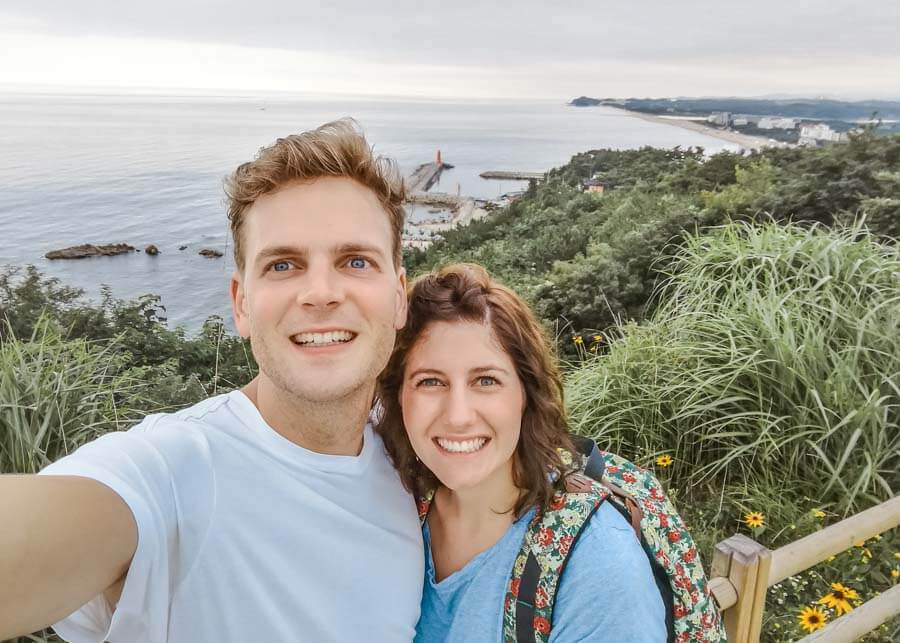
Day 14: The Last Day of Your South Korea Itinerary
Can you believe your two weeks in South Korea is over?
If you’ve followed this South Korea itinerary, you will have eaten your heart out, walked enough miles to justify another vacation, and experienced the best of Korea, from the people to the culture.
Depending on when your flight departs, you may have some time to squeeze in a few more activities in Seoul!
- Visit another themed cafe and get one last Insta-worthy pic
- Explore the Insadong neighborhood. It’s an artsy traditional neighborhood in Seoul where you can make a few last-minute purchases
- Take a stroll along the Cheonggyecheon Stream
Extra day in Korea: Jeonju
My South Korea itinerary highlights Seoul, Jeju, and Busan as must-visit places in Korea. I then recommend visiting either Gyeongju or Sokcho.
But there’s one more place you may want to consider: Jeonju.
Jeonju is a foodie’s delight and a charming city 3 hours south of Seoul.
Jeonju’s signature dish is Bibimbap, yet another one of my favorite Korean dishes!
Another major attraction in Jeonju is the well-preserved Jeonju Hanok Village which is arguably one of the most spectacular traditional villages in Korea.
Walk the streets, explore the traditional houses made from wood and slate, dress up in a traditional Hanbok, and observe the selfie-obsessed visitors.
You’ll need to spend a night in Jeonju, which is easily accessible on the KTZ train from Seoul. If you visit here, you’ll have to skip either Gyeongju or Sokcho.
How to get around for 2 weeks in Korea
The public transport in Korea is top-notch! It’s fast and efficient, and more importantly, it’s budget-friendly.
This South Korea travel itinerary covers all forms of transport, from trains to buses, flights, and even organized tour groups.
Thinking of joining organized tours? No need to!
If you’re on a budget or you’re a seasoned traveler, you may opt to avoid tour operators, and travel independently. This is possible if you have 3 weeks, giving you more time to travel slowly.
But with only 2 weeks in South Korea, your time is limited, you may want to consider a few day tours.
I personally used Trazy and Klook , depending on their tour availability. Both are reputable companies and offer awesome day trip itineraries to several leading attractions at affordable prices.
Their guides speak English (but there are also Chinese-speaking options if you prefer), and they take the hassle out of trying to navigate around areas that are more difficult to reach via public transport.
The bonus – most tours offer massively discounted rates to foreigners!
Read reviews and compare tours on Klook | Trazy.
Budget for 2 weeks in Korea
Korea is more expensive than other countries in Asia. But there’s plenty to do and see, even if you’re on a budget.
Here are my estimated daily costs for your South Korea itinerary.
- Accommodation: $40 per night (Budget, private room for 2 people). $100 per night (mid-range, private room in a hotel for 2 people) .
- Food (lunch & dinner): $20 per day. This will include a mix of street food and local restaurant food for 1 person. If you’re only eating at Western restaurants, you’ll need to fork out at least $60 per person per day for food.
- Organized day tours: $50 – $110 per person per tour (I’d recommend only going on 2 organized tours during your time).
- Public transport between cities: $10 – $30 per person. The trains and buses in the cities are cheap!
- Drinking: Soju and beer are the local favorite and they’re cheap compared to wine and spirits.
If you’re traveling on a budget, you can get by with $100 per day for 2 people ($50 per person per day). This excludes international flights.
If you follow my itinerary for Korea and travel mostly with public transport, $50 per person per day should be okay.
But if you want to hire a car, go on organized tours in every city, and eat at nicer restaurants (or go out drinking and parting), you could look at double that budget.
READ MORE: 20+ THINGS I LOVE ABOUT SOUTH KOREA
Bucket list for your itinerary for Korea
Before I arrived in South Korea, I hadn’t done much research!
Luckily, I had 14 months to figure my way around. If you’re following this itinerary, you will only have 14 days in Korea.
Here’s what not to miss if you’re planning a long-term or short vacation to South Korea!
- Get naked at a Korean Jimjilbang (bathhouse)
- Eat all the food: Kimchi, Korean BBQ, Dakgalbi, Bibimbap and Tteokbokkie
- Sing your heart out at a Noraebang (Karaoke rooms)
- Go hiking and watch in awe as you see how committed Koreans are to their outdoor activities
- Listen to K-pop music
- Visit a themed cafe: There’s everything from poop cafe’s to 3D cafes and even flower cafes
- Your itinerary for Korea must include visits to at least one temple and also a palace
- Drink Soju (and Somaek which is a mixture of Soju and beer)
FAQS for your trip to South Korea
How many days is enough for south korea.
You’ll need 2 weeks in South Korea. This is enough time to visit 3 cities which will give you a great taste of the country and its unique culture. If you have less time, you’ll miss out on so much.
Is Jeju or Busan better?
Both Jeju and Busan are unique in their own ways, but if I had to choose between the two, I would say that Jeju is better than Busan. The island is an outdoor paradise with volcanic formations, incredible caves, and stunning beaches.
Which month is best to visit South Korea?
The best time to visit South Korea is during the spring time, which is between March and May. However, March can be quite cold and extremely busy due to the Cherry Blossom season. If you’re looking for the best month to visit Korea, I recommend planning your itinerary for May.
Is South Korea expensive for tourists?
This depends on what type of traveler you are. If you’re happy to eat local food, catch public transport, and stay in mid-range accommodation, then you’ll find South Korea relatively affordable. But if you’re going out often, staying in luxury hotels, and taking tours, it can be very expensive.
READ MORE: GUIDE TO BORYEONG MUD FESTIVAL IN KOREA
Final thoughts on your Korea Itinerary
South Korea surprised me in every way. The year I spent teaching English in the country taught me so much.
It wasn’t just the travel aspect, but also what we learn through our travels – how we begin to understand different cultures and open our minds to a different way of life.
I’m already planning my next trip, which will include numerous visits to Korean Jimjilbangs, an overload of Kimchi and Toekbokkie, and lots of K-pop!
If you’ve followed my South Korea itinerary, you’re guaranteed to leave feeling the same way I do. With happiness in your heart, fond memories, and a full, satisfied stomach!
Have you traveled to Seoul, Jeju or Busan? What destinations would you recommend for the perfect itinerary for Korea? Let me know in the comments section below!
Looking for more Korea travel inspiration? Check out my other posts!
- Where to see Cherry Blossoms in Seoul
- 24 Strange Things About Life in Korea
- Getting Lasek or Lasik in South Korea
- 19 Things You Need to Know Before Moving to Korea
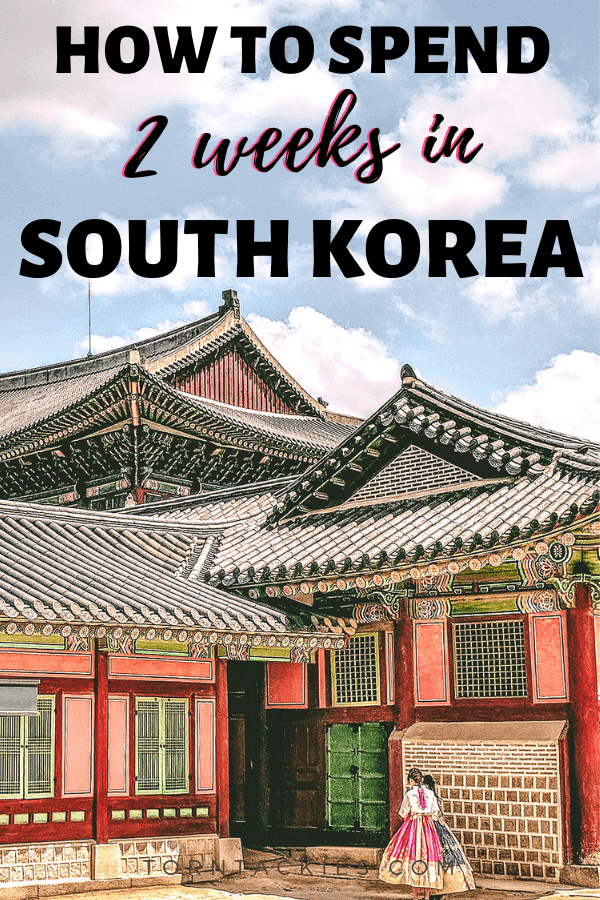
Hi, I'm Carryn. I’m an adventure travel blogger trying to figure out my way through life by traveling and exploring. Join me as I share my travel guides and tips for life abroad. Find out more about me here .
The Coogee to Bondi Walk: The Ultimate Guide to the Bondi Coastal Walk
Porters pass and colliers causeway: best hike in the blue mountains, 16 thoughts on “the best south korea itinerary for 2 weeks [insider’s guide]”.
Hello, I’ve been thinking about going to South Korea and came across your itinerary and was really fascinated by the places that you mentioned, such as Bukhansan Mountain and Jeju Island. Can you give me an approximate estimation, without the value of the plane ticket, of how much this itinerary would cost for two budget-friendly people? Thank you very much Carryn. Best regards.
Hi Ana, Korea sure is a fascinating place! It is more expensive than in other countries in Asia but there’s plenty to do and see, even if you’re on a budget. Here are my estimated daily costs for budget travelers visiting South Korea.
– Accommodation: $40 per night (Private room for 2 people) – Meals (lunch & dinner): $40 per day. A mix of street food and restaurant food for 2 people – Organized day tours: $50-$110 per person per tour (I’d recommend only going on 2 organized tours during your time) – Public transport between cities: $10-$30 per person
If you’re traveling on a budget, you get by with a total of $100 per day for 2 people which excludes international flights ($50 per person per day). There are many free things to do in Korea and if you follow my itinerary and travel mostly with public transport, $50 per person per day should be ok. But if you want to hire a car, go on organized tours in every city, and eat at nicer restaurants (or go out drinking and parting) you could look at double the budget. Hope that helps
Hi Carryn, Thanks for the great guide! Your pics are gorgeous.
I have a 2 week trip to South Korea planned in November and my flights arrive and depart from Incheon Airport. I was wondering in what order you’d recommend going around the cities? I was thinking of doing Seoul > Busan > Jeju > Seoul but I see that you’ve put Jeju first – is there a reason for that?
Thanks and really appreciate this amazing itinerary!
Hi Patricia, I planned my Korea itinerary in the reverse order that you mentioned above. (I started in Jeju and ended in Seoul). But it doesn’t really matter where you start or end – it’s individual preferences. From my experience, Seoul is an amazing city and was the highlight of my trip. If you start with Seoul, you might be slightly disappointed in the other areas because they don’t match Seoul’s vibrant and exciting atmosphere. So by ending in Seoul, you’ll be saving the best for last. But either way, you should allow for at least 5 days in the capital. Let me know which route you decide and how it goes. Carryn
I’ll be visiting South Korea in August. I loved all your tips – thanks for sharing your itinerary! I’ve been doing some research and I was thinking of going to Jeonju too. However, you haven’t included in your itinerary. Is there any reason for that? Have you been there? Is it worth visiting?
Thank you very much, Aura
Hi Aura, thanks for reaching out. Yes, I did spend time in Jeonju and while there are a few attractions (the Hanok village and the food scene), it isn’t a bucket list city and wasn’t a highlight for me. How much time do you have? If you have more than 3 weeks, then perhaps you could visit Jeonju, but with only 2 weeks in Korea, I would give it a skip. If you have a few extra days after visiting Jeju, Seoul, and Busan, rather explore Sokcho and Seoraksan National Park (if you enjoy the outdoors) but if it’s cultural attractions you’re looking for, Gyeongju is also a fascinating city. Hope that helps with your travel planning. All the best, Carryn
A mom in my mom group posted your link. I just finished reading your travel guide and tips and it’s just so incredible! I’m planning to visit Korea this summer. Your post has inspired me and took away alot of concerns and worries that I had in my thoughts. Thank you much for writing about your tours and listing all the places to go, stay, visit and experience. This is a truly special post and I feel the love you have for Korea! Cheers fellow traveler!!!💛
Hi Sonja, thanks so much for taking the time to share this feedback. Means the world to me! Have an awesome time in South Korea.
Hey, One of the best itineraries I’ve seen !Thanks 🙂 for any of the places on this list do you need vaccines such as Japanese encephalitis or typhoid if visiting in August?
Hi Gab, I didn’t have any of those vaccinations for Korea – and I lived there for over a year. I recommend consulting a travel doctor to confirm whether you need or not. Enjoy Korea!
Hi, I read your posts (several of them) with pleasure and interest, and i think it will be very helpfull during my stay in Korea. i’m planning to visit Korea very soon and I’m wandering if you know if in hotels can pay with cash or only card ( i’m planning only stays in hotels)? And one more think. You wrote about budget. Is 1000-1500 usd enough? I have my doubts about this. I’ll try to travel to Seul, Busan, Gyeongju, Suwon, Yongin, Gayasan and Jeju of course. And have only 10 days:/. Only in Seul, Busan and Jeju i intend to stay in hotel.
Hi Tom, cash payments are accepted in most places in Korea. However, due to hygiene reasons, some businesses may prefer card payments as it is contactless. Yes, a budget of of $1000-$1500 USD is more than enough for 10 days in South Korea (this is excluding your international return flights). That gives you about $150 USD per day which will cover the costs of a nice hotel ($50 per day), food ($40 per day) and activities/travel costs ($60 per day). This is assuming your total budget is for one person. If you are backpacking or wanting to travel on a budget, you can get by with $60 per day. And if you’re more of a luxury traveler and are planning on eating at fancy restaurants and doing lots of shopping, you will need more than $150 per day. Hope that helps. Enjoy your time in Korea. Carryn
Thank You Carryn. Now i know where i stand.
One more thing. Is it possible to pay for a ticket to Jeju online or only at airport? I worry that all tickets will sold out soon And cannot buy on jejuair.net.
Hi Tom, I purchased my flights online a few weeks before as this is where I found the best price and my preferable time. You can also try T’Way Air and Asiana. There are so many flights every single day so I have no doubt you’ll be able to purchase one at the airport. But remember there are two airports in Seoul from where you can fly to Jeju (but most flights are from Gimpo International Airport).
Leave a Comment Cancel reply

The Ultimate 10-Day Itinerary for South Korea
South Korea is a small and densely-packed country, which makes it a delight to explore. Distances are short, transport links are widespread and reliable, and you never have to go very far for a change of scene. While there’s a lot to see and do, you don’t have to spend weeks traipsing around to make the most of your time there.
In my experience, 10 days is the perfect amount of time to get a real flavour of what South Korea has to offer, from hyperactive cities to pristine natural parks and beautiful historic towns. Whether you’re there for K-Pop or hiking, the incredible food scene or centuries of fascinating history, it’s easily accessible, and this itinerary includes it all.
After flying in, you’ll start your trip proper in delightful Gyeongju, a beautiful and relaxing historic town that ticked so many boxes for what I’d hoped to see in South Korea. From there, you’ll launch head and stomach-first into the bright lights of Seoul, with all of the endless energy that comes with this world-class capital.
Finally, you’ll get to experience a part of the country that I’m convinced will be the highlight of your time in the country. Seoraksan National Park blew me away with its incredible hiking trails, stunning mountains and rivers, and quiet, peaceful surroundings that I honestly didn’t expect to find.
If you have two weeks in South Korea, you could easily add an extra day in and around each of the places I mention if you prefer to move more slowly, or tack on an extra activity or two: I give a few options for that at the end.
Right, let’s get into the detail!
Day 1: Arrive in South Korea
Presuming that you’re arriving at one of South Korea’s international airports, you’re likely to be pretty tired and jetlagged. Rather than throwing yourself into the chaos of a major city, then, I’d recommend heading somewhere much more chill right off the bat. Gyeongju is that place.
Once the political and cultural heart of South Korea, Gyeongju these days is a much more relaxed place to be. This small city in the south of the country is known as the “Museum Without Walls”, and even an hour or two of walking around will clearly show why, with ancient buildings, temples, and burial mounds seemingly around every corner.
Almost all long-haul flights arrive into Incheon Airport in Seoul: if you land early enough in the morning, you’ll have no problem getting to Gyeongju at a reasonable hour. Buses run there directly from the airport, taking about five hours, or you can take the metro from the airport to Seoul Station to catch the high-speed KTX train instead. Total travel time is about the same either way.
Tip: even if you don’t plan to use it straight away to get into the city, be sure to pick up a T-Money card from one of the vending machines at the airport and top it up with a useful amount of money (I spent ₩40,000 following this itinerary). Not only does it make each ride slightly cheaper, it saves a lot of time and effort versus buying individual tickets, especially on crowded buses or at busy metro stations.
If you don’t land until late in the day, just do what I did on my last visit and book a night in a hotel close to Seoul Station, then jump on an early train to Gyeongju the next morning instead. After a long flight, being able to take a shower, sleep, and start refreshed in the morning was very welcome! We spent the night at a cozy little guesthouse that was perfectly set up for exactly this kind of short stay, less than a five minute walk from Seoul Station. Check-in is open until 10pm: we arrived just after that, and there was a note on the door with our keycode. The room itself was great for a night: the shower, fridge, and air-con all worked well, and the bed was nice and comfortable. After 11 hours on a plane to get there, it may as well have been the Hilton. Except the Hilton wasn’t in such a useful location, nor did it cost just $65 USD (₩85,000) a night.
When it comes time to take the high-speed train bound for Gyeongju , it leaves Seoul Station from early morning until late evening, and costs around ₩40-50,000 from Seoul. We took the 8:11am departure, and it took almost exactly two hours to get to Singyeongju KTX station outside Gyeongju.
From there, just head out of the station and veer right to find taxis and buses to take you into the city: there’s a picture of the bus stands below. All of the following buses take you into town in about half an hour, and cost ₩1300: 50, 60, 61, 70, 203, 700.
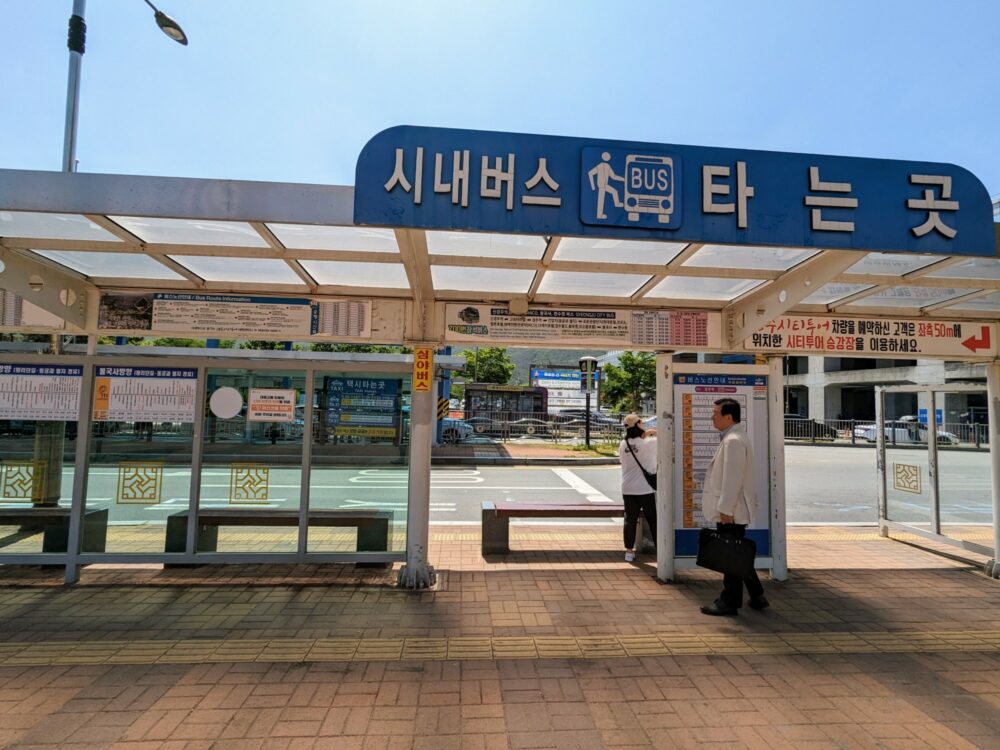
If you picked up a T-Money card in Seoul, you can use it on this bus as well, otherwise you’ll need to pay in cash. The bus runs along the main street through Gyeongju, so just make a note of where your accommodation is so you know where to get off. It’s one of the reasons we chose the hotel we did: there’s a large bridge just before the stop we needed, making for a very obvious landmark!
If you’re anything like me, you’re going to need a little recovery time after a long-haul flight! For that reason, I’ve saved most of the activities for tomorrow: for now, just freshen up, grab some dinner, and get a good night’s sleep in before diving headfirst into things in the morning.
Where to stay in Gyeongju : We loved our time at this cute mini hotel . It was very easy to find, only a couple of minutes from where the bus dropped us off near the Express Bus Station and an easy walk into the centre of town. The manager was super-friendly, and more than happy to look after our bags when we arrived well before check-in time so we could head out exploring straight away. The room itself was spotlessly clean and quite large for South Korea, and I particularly appreciated the coffee machine in the shared kitchen, complete with little takeaway cups so I could grab one on my way out the door. Paired with the good value (₩55,000/$40 USD a night), I’d absolutely stay here again next time I’m in town.
Day 2: Gorgeous Gyeongju
After breakfast, it’s time to head out and see the city’s biggest attractions: a collection of large lumps in the ground.
These aren’t just any old lumps, though: they’re royal tombs and other earthen burial mounts from the Silla dynasty, which ruled much of the Korean peninsula from the seventh to the ninth centuries. They’re part of the wider UNESCO World Heritage site that covers much of Gyeongju’s historic district, and they’re seriously impressive.
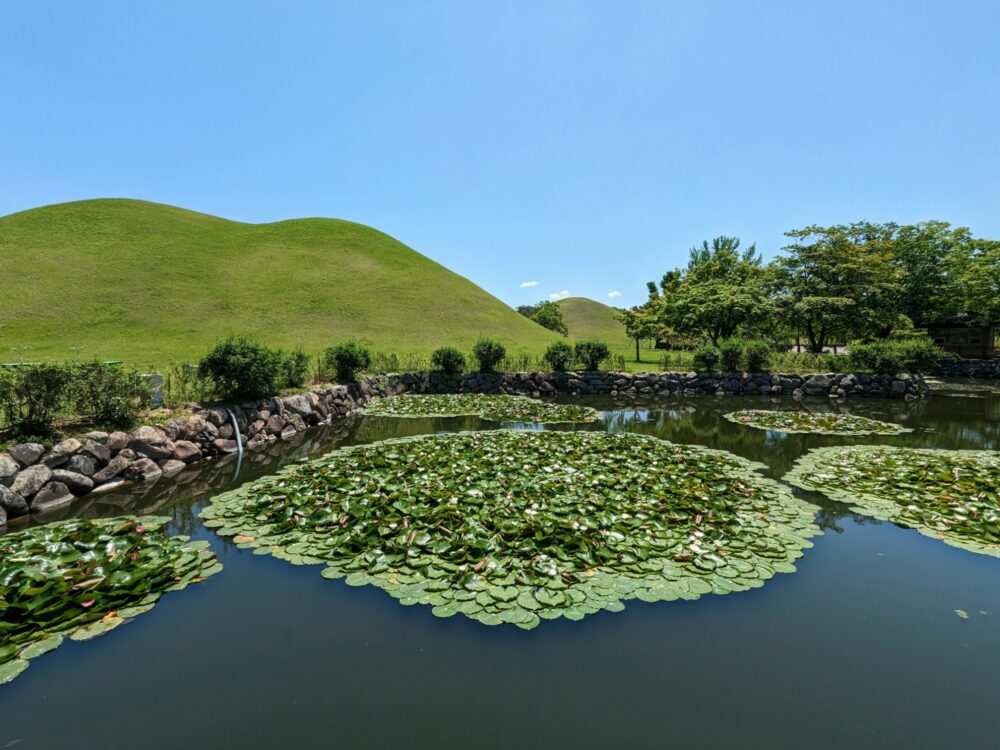
The tombs are in clusters, spread across a series of parks that you can easily walk to and between from any hotel in the city. It’s worth checking them all out, either in one go or just as you explore; they’re really not hard to find!
The most popular area ( the Daereungwon complex) is also the largest, with the most tombs. There are several designated photo spots: they’re much quieter early in the morning if you want a shot without dozens of people in. A bunch of nearby cafes and restaurants make it easy to grab a drink or snack before or after your wanderings.
It’s worth visiting the other tomb clusters that lie slightly further north as well; they’re much quieter, and there’s an interesting small museum inside the Geumgwanchong tomb about Silla history and the construction, excavation, and preservation of the tombs that’s definitely worth a visit.
The museum is free, with written and video information in English. I only ended up in there because I happened to be walking past and saw the sign, but I’m very glad I did!
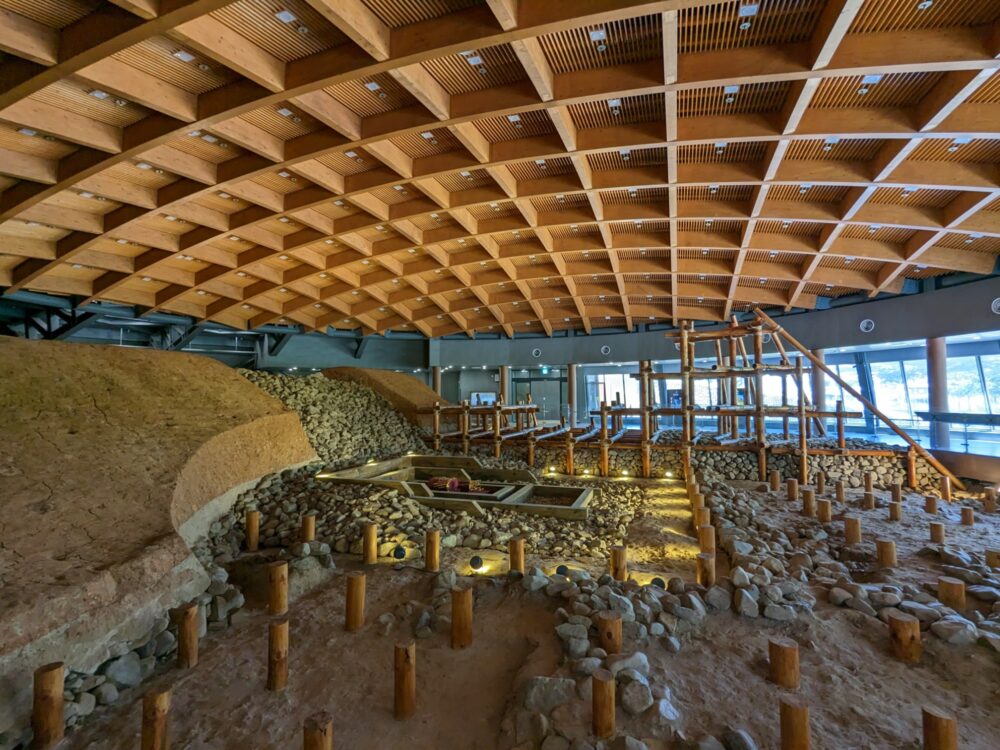
Once you’re done with the tombs, it’s time to go for a stroll down Hwangnidan Road . If you’ve ever seen photos of beautiful wooden hanok-style Korean houses in Gyeongju, chances are this is where they were taken. Most of them have been converted into cafes and shops now, but they’re no less beautiful for it: I ended up walking up and down this street probably a dozen times during my stay, and never tired of it.
Lunch: If you’re feeling peckish by this point, it’s time to stop for bibimbap . If you’re not already familiar with this classic Korean dish, you probably will be by the time you leave the country. Daewha Mandu is a great place to start. The menu at this small restaurant near the start of Hwangnidan Road is simple, and most of the staff speak enough English that you shouldn’t have translation issues! The tuna-based bibimbap was absolutely delicious, but if it doesn’t appeal, there are a few other options including dumplings and tteokbokki , another tasty Korean staple. Order and pay in advance at the counter.
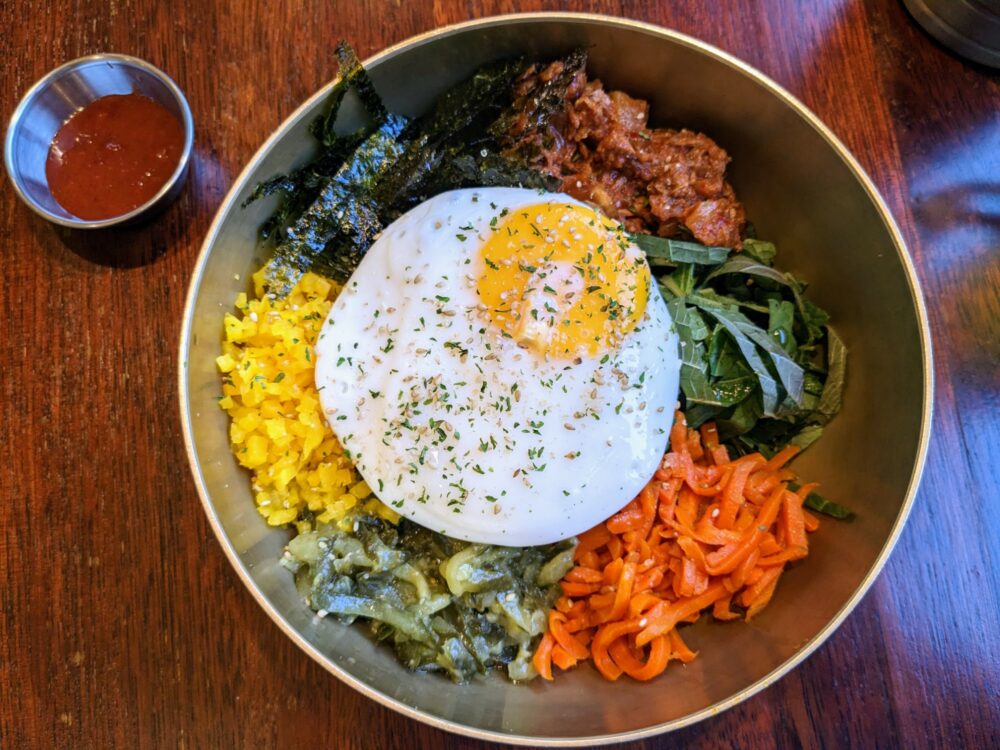
Once you’ve got to the end of Hwangnidan Road, turn left and walk for a few minutes towards the famous Cheomseongdae observatory . Before you get there, though, detour south for a block to Lichoya , an ice-cream store with a different kind of fame.
This place is big on Instagram and Tiktok, thanks to the cute cookies in the shape of Cheomseongdae observatory that come with its desserts. Be sure to order the matcha flavour: it’s what they specialize in, and it’s particularly good!
Ice-cream safely in hand, head back north towards the observatory. Just before you get to the vast park that contains it, though, keep an eye out for a Starbucks that couldn’t be any more Korean if it tried. You’ll see what I mean when you pass it!
The observatory itself dates back to the seventh century, and is the oldest surviving example in Asia or, depending on who you ask, the entire world. You can’t go inside (and not only because the entranceway is at least a dozen feet up the side of the tower), so it doesn’t take long to walk around it.
I was lucky enough to be there in spring, and as interesting as the observatory was, it was hard to focus on it due to the explosion of colour nearby. Fields of flowers lined the walking paths, carved out with convenient photo spots that were in regular use as I wandered past. It was genuinely stunning, so if you’re there at the right time of year, be sure to take advantage.
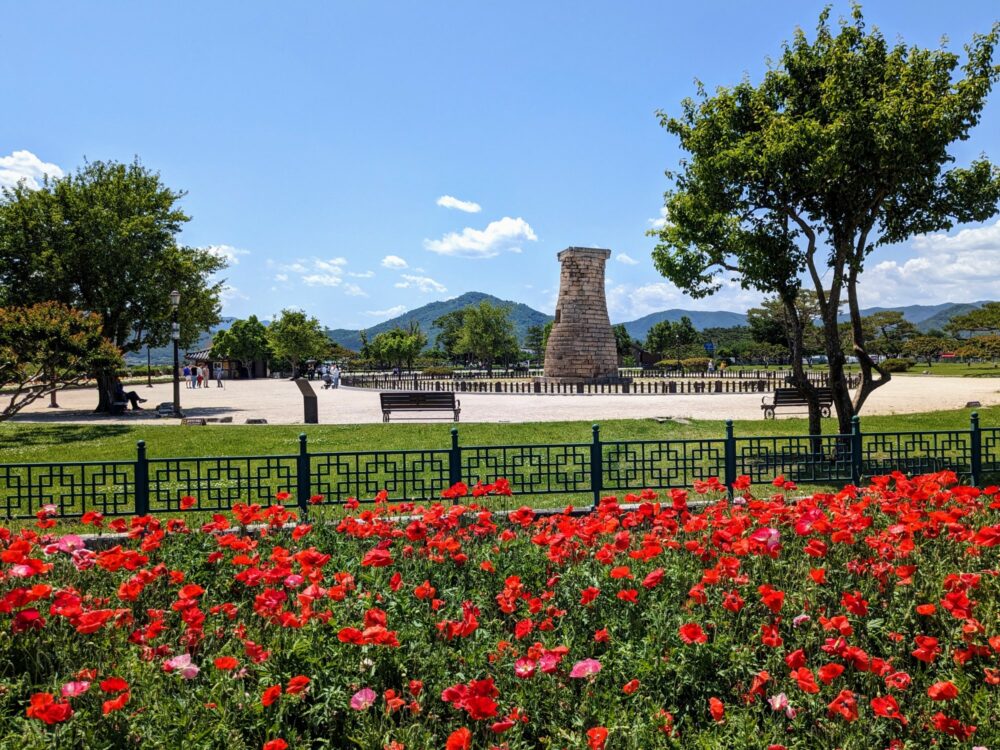
While the observatory is the most well-known historic site in the park, it’s far from the only one. To be honest, it wasn’t even the one I enjoyed the most. For that, keep following the paths south and west towards Woljeong Bridge ; you can either skirt around the edge of the woodland or (better idea) wander through it instead. It’s only a small patch of forest, so it’s basically impossible to get lost, and surprisingly tranquil.
Like many of the attractions in Gyeongju, the original version of the bridge dates back to the Silla dynasty. It’s been fully reconstructed since then, and it’s lovely to wander across, take photos, and admire the views up and down the river.
Be sure to head up to the top level as well; there’s a small gallery up there, complete with Korean comic strips about a famous Buddhist monk, and a kiosk where you can take a selfie and edit it to make yourself look like…well, something. A Silla warrior, perhaps, although it’s kinda hard to tell.
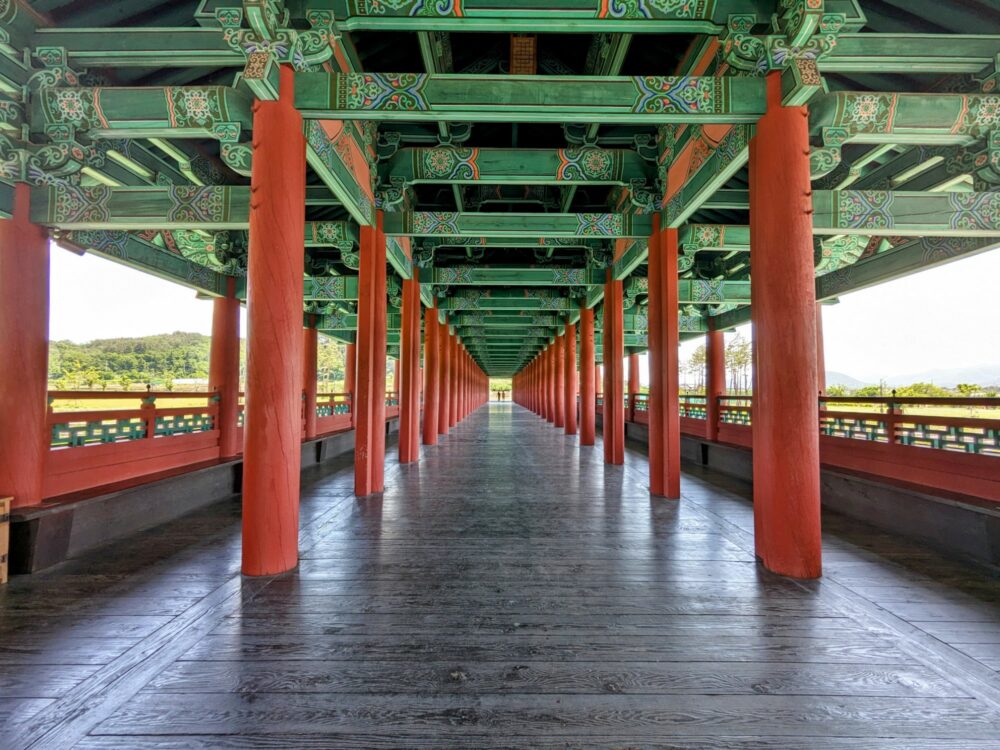
As you were crossing the bridge, you likely noticed a series of stepping stones a little further down the river off to your right. That’s the best way to get back to the other side; it has great views back towards the bridge, and flat rocks where you can stand and take photos while letting other people get past. Just watch your footing if the rocks are wet; they’re not particularly slippery, but you could still fall in if you tried hard enough.
The bridge is lit up at night, so if you happen to be in the area after sunset, it’s worth stopping past again for a different view.
For now, though, you’re very close to the entrance of the Gyochon traditional village. It’s a popular spot, with renovated hanok-style houses that people still live in to this day, and an almost equal number of cafes, restaurants, and places renting hanbok (traditional Korean dress) by the hour for photo opportunities.
It’s a relatively large area, so even if it’s crowded near the main entrance and food area, it’s not hard to find a quieter spot elsewhere. While many of the buildings are private residences, you can go inside a few of them for a better idea of how people used to live. Give yourself plenty of time to wander around here; it’s best explored at a leisurely pace.
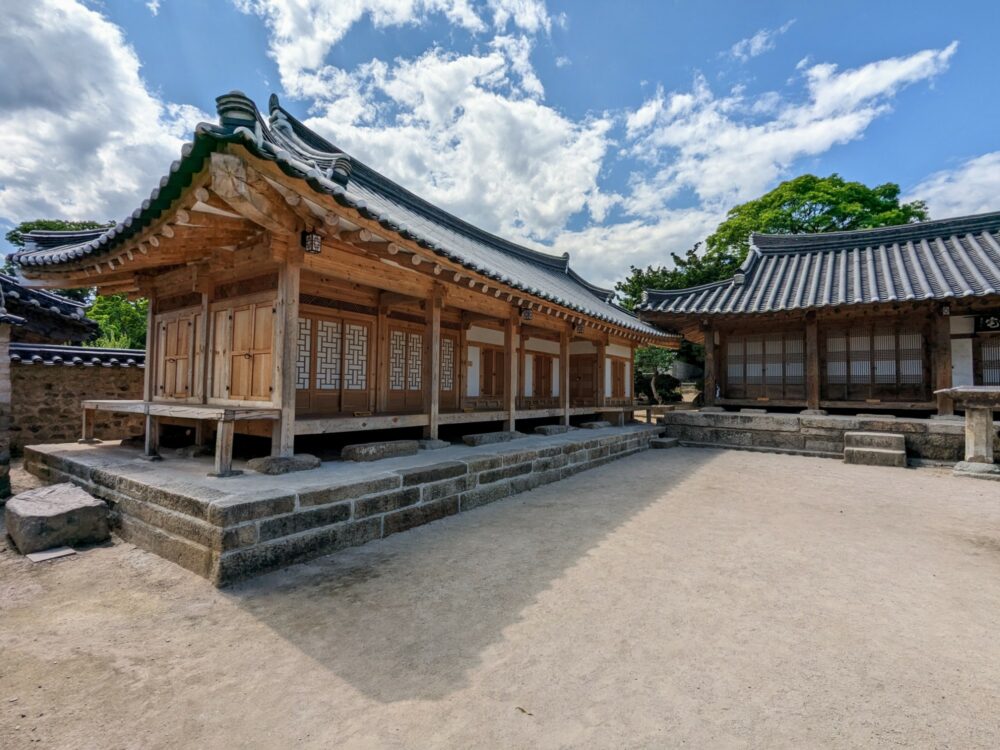
Once you’re done, exit on the eastern side near the woodland you passed by (or through) earlier, and take a stroll back through the park on some of the smaller paths. I really liked this area; if you head towards the Wolseong site, you can walk up a dirt track on (very) small hill just to the north and get a nice overview from the top.
This was once the main royal palace of the Silla rulers, but there’s almost nothing left above ground now. Extensive archaeological work continues to find artefacts at the site, many of which end up in the nearby Gyeongju National Museum . This impressive free museum is devoted entirely to Silla history: if you’ve got the energy to explore today, give yourself at least a couple of hours inside, otherwise walk on past.
Once you’re done, cross the road to another of Gyeongju’s famous attractions, Donggung Palace and Wolji Lake . You may have seen photos of this lit up at night; if the sun is going down by the time you get there, by all means wait around until dark. I think it’s equally lovely during the day, though, and there are far fewer people around. I went in the early evening, an hour or so before sunset, and the light on the buildings and pond was perfect.
The grounds are smaller than you might expect, and as with many historic sites in South Korea, the buildings are replicas of those that once stood here; the originals are long gone. Give yourself an hour or so to walk around the lake. The side closest to town is flat and manicured, while the other side of the lake has a more natural setting, with a dirt trail through the trees and benches to sit and admire the view.
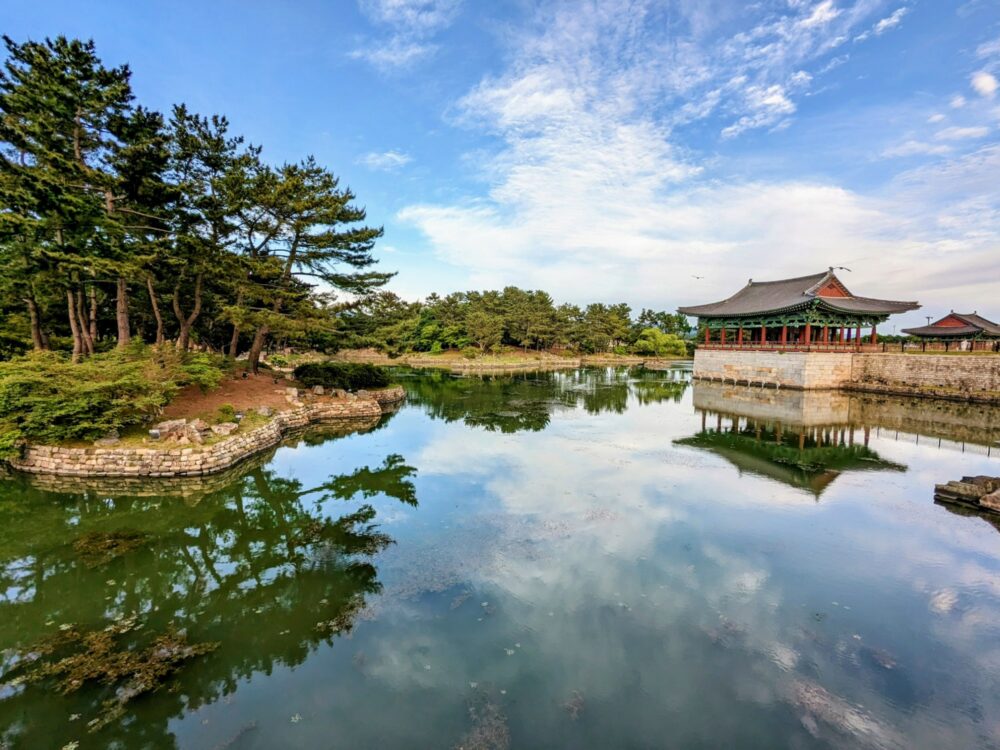
There’s also a small museum near the entrance, which is a good way to kill a bit of time if you’re waiting for sunset. The entrance fee for the grounds is ₩3000 ($2.50) per adult, and last entry is at 9:30pm. Note that there are no pass-outs: if you want to come back later, you’ll need to pay for a second ticket.
And that’s it for the sightseeing today: you’ve definitely earned a drink after all that exploration!
Dinner : head back to Hwangnidan Road for dinner: there, or a few streets either side, is where you’ll find many of the better restaurants in town. I ended up at a Japanese place called Sasiseuseso (사시스세소), mostly because I had an unexpected hankering for spicy soup, and it was surprisingly tasty. You can’t go too far wrong with most of the well-rated places in this area, though; just expect the prices to be slightly higher than some other parts of the country, because it’s popular with both domestic and international tourists.
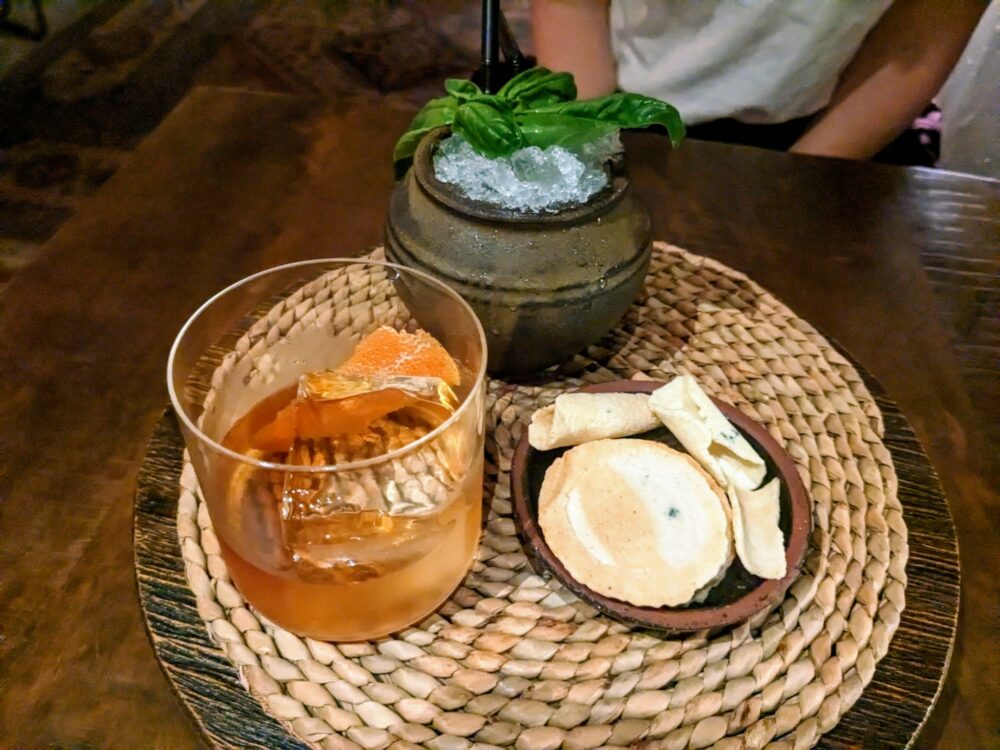
Drinks : if you’re in the mood for those drinks I mentioned, I can highly recommend the cocktails at Bar Boon . They’re not especially cheap, but they’re unusual and very high quality, made with local ingredients by fun, enthusiastic young bartenders who are only too happy to chat. Pull up a stool at the bar, or head upstairs to a lovely cosy area with tables and chairs.
Day 3: Visit Bulguksa and Seokguram Grotto
Today you’re off to Bulguksa Temple and Seokguram Grotto , two famous Buddhist sites that together form another UNESCO World Heritage Site. They’re about 15km (~10 miles) out of town, so you’ll need some kind of transport to get there.
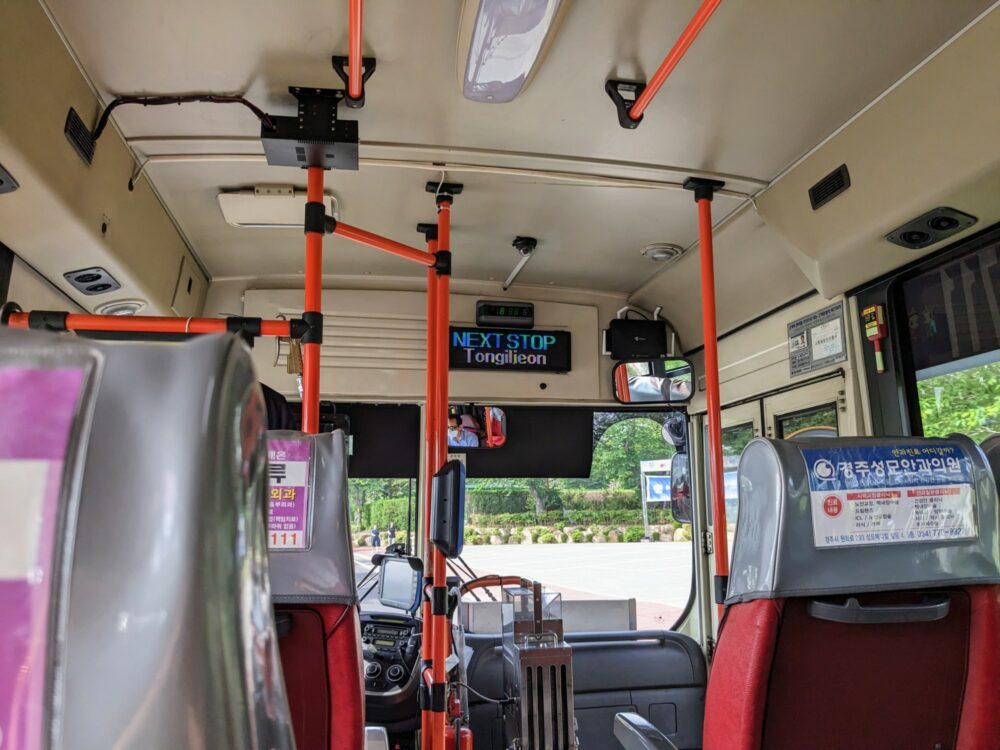
A few different buses run regularly from the Express Bus Terminal, through Gyeongju and out to Bulguksa. Just jump on the number 10, 11, or 700: you can pay with your T-Money card or cash. The buses can be quite busy as they travel through the city, but should be pretty quiet after that.
There’s an announcement and electronic signage in English as you approach Bulguksa, and the bus drops you off on the main road near a cluster of cafes and convenience stores. It’s a good place to get snacks, drinks, and anything else you might want for your time in the park. The entrance is about a five minute walk on a paved path up the hill; there’s plenty of signage around to show you the way.
If you’re pressed for time or don’t feel like dealing with public transport, you can take a taxi to get out there instead. Getting between Bulguksa and Seokguram Grotto and back to Gyeongju shouldn’t be a problem (I saw several taxis waiting in the parking lot at both sites), but your hotel may also be able to arrange for a driver who’s happy to wait.
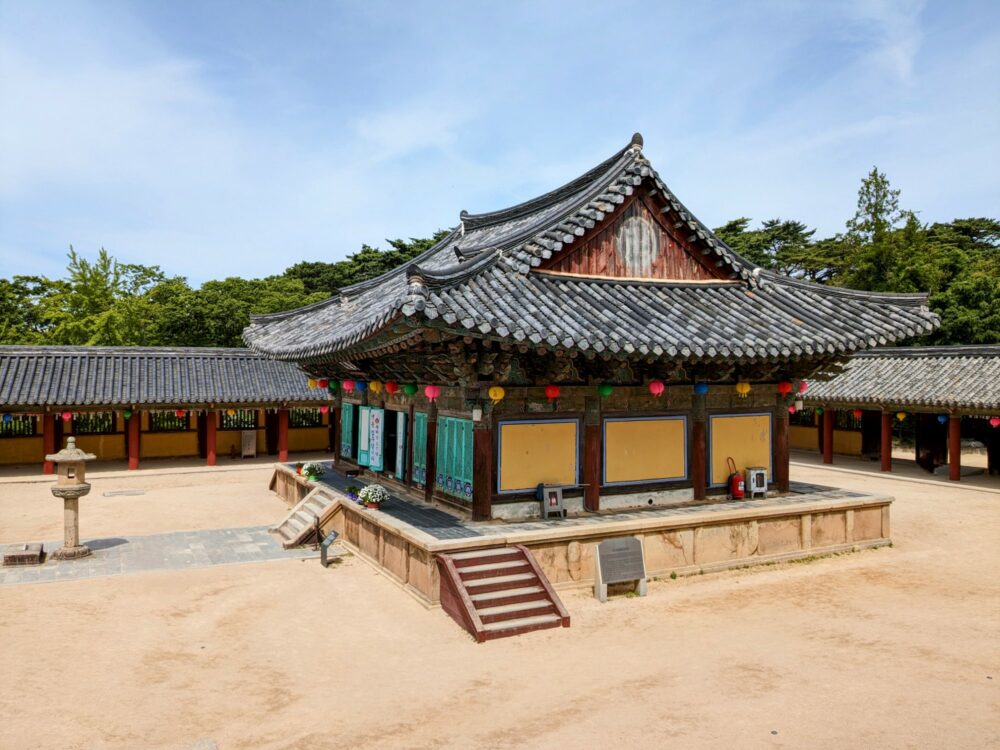
Still a working Buddhist temple, Bulguksa is a major cultural and historic site that dates back mainly to the eighth century, although a small temple is thought to have existed there up to 200 years earlier. All of the buildings in it have been rebuilt after time, fire, and pillaging took their toll, but while they may not be original, they’re far more impressive because of it.
Entrance fees were abolished last year, so although you’ll still see the ticket office to the right of the entrance gate, there’ll be nobody in it. Just walk through the entranceway like everyone else!
Hours vary throughout the year, as below: we arrived just after opening time and had the place largely to ourselves for the first hour or so, but by the time we left in the late morning, the crowds were definitely rolling in. If you don’t mind the early start, get there early to avoid the tour groups, otherwise take a more leisurely approach and just accept a few more people in your photos!
Bulguksa opening hours:
- February: 7:30am to 5:30pm
- March to September: 9:00am to 6pm weekdays, 8:00am to 6pm weekends
- October: 7:00am to 5:30pm
- November to January: 7:30am to 5pm
Before you even get to the buildings, you’ll find yourself in a peaceful natural setting, with a bridge over a small stream and lake that’s surrounded by trees. From there, you just follow the path up the gentle slope towards the main part of the site.
Colourful lanterns decorate several of the buildings and courtyards, and there’s a large collection of stone cairns that have been created by those in search of a little extra good luck over the years. Speaking of good luck, don’t forget to rub the golden pig in front of the Geungnakjeon building while you’re there!
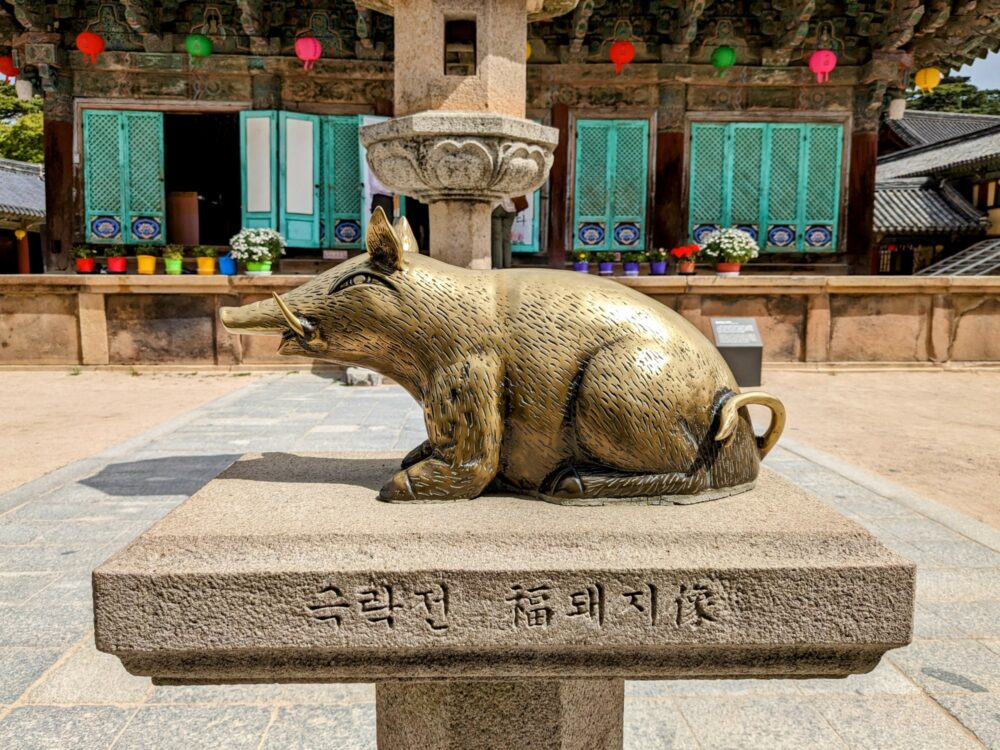
It’s not a huge area, so depending on your interest levels and how fast you walk, give yourself an hour or two to fully explore.
Once you’re done, retrace your steps through the site, taking in anything you missed along the way, until you end up back beside the ticket booths and main carpark. From here, you have a choice: you can either head back down to the main road to pick up some lunch at one of the cafes, or continue on to Seokguram Grotto.
To get between Bulguksa and Seokguram Grotto, take the number 12 bus from either the main road or parking lot. It runs once an hour, departing Bulguksa at forty minutes past the hour, and leaving Seokguram Grotto on the hour. There’s also a walking trail that runs between the two and takes about an hour, but it’s currently closed due to storm damage.
Seokguram Grotto
Part of the same UNESCO site as Bulguksa, but sitting around 3km away as the crow flies, Seokguram Grotto dates from around the same period in the eighth century as the main buildings at Bulguksa. It’s much smaller than the main temple complex, consisting of a stone grotto holding a large carved seated Buddha that’s 3.5m (11.5ft) tall. Several other, smaller religious figures are carved alongside from both Buddhist and Hindu tradition, all behind floor to ceiling glass to protect them from over-enthusiastic humans.
From the carpark where the bus or taxi drops you off, it’s a roughly 500m walk along a gently-sloping gravel path through the forest to the grotto. Before you do that, though, you really should stop at the large bell on the left as you walk from the carpark.
For only ₩1000 (~75c), you get to ring the bell, donating to the upkeep of the site while making a spectacularly loud noise that will get dozens of people to stop what they’re doing, turn around, and look confusedly at you. If that’s not worth the money, I don’t know what is.
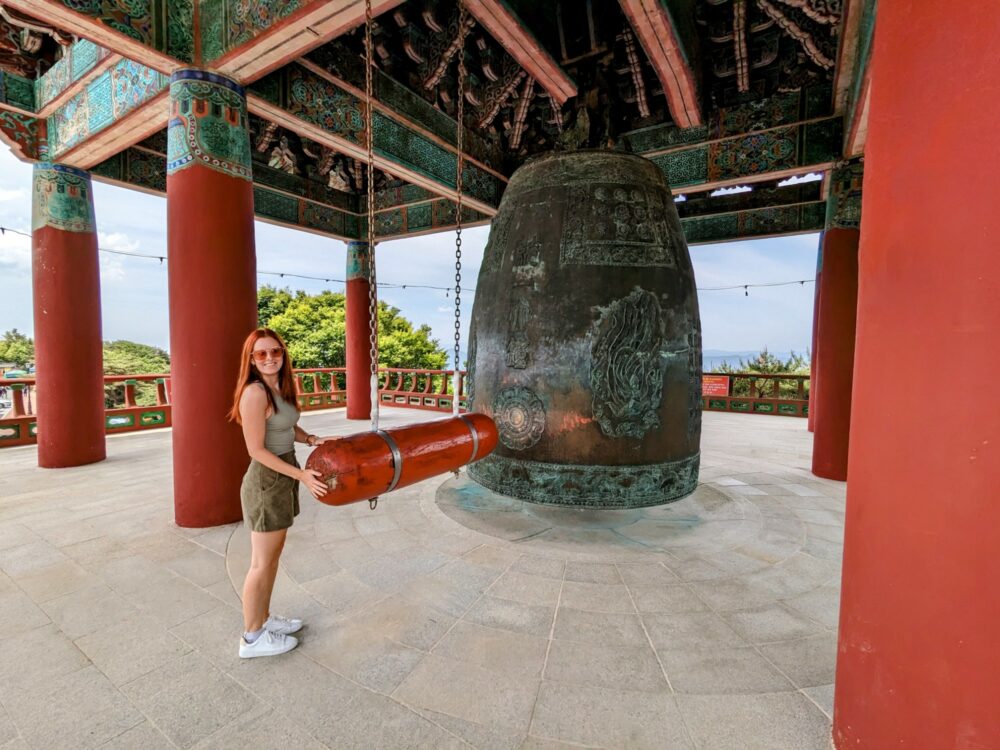
After the ringing in your ears stops, it’s time to head to the grotto. As with Bulguksa, there’s no longer an entrance fee for Seokguram, so just follow the signs towards and down the gravel path. Once you get to the other end, there are a few steps up to the grotto itself: you’re very unlikely to have the place to yourself, but depending on the time of day, the line will either be just a few other people, or…a lot more than that.
The grotto itself is small, with signs outlining expected behaviour. This includes not taking photos inside, so out of respect, I didn’t do that. You’ll likely only get a minute or less in front of the Buddha statue, but there’s nothing stopping you from re-joining the line for another look if you’d like one.
Take some time to admire the views towards the mountains in the distance, before retracing your steps along the path and back to the carpark. You’ll likely spend an hour or so in total at Seokguram, although that does depend on how long the line at the grotto is.
As I mentioned earlier, the bus from here leaves on the hour; when it drops you off at Bulguksa, check the printed timetable at the stop to see how long you’ll need to wait for a second bus back to Bulguksa. You can take a taxi from either site if the wait is too long.
Traditional Meal
Once you’re back in Gyeongju and feeling hungry, it’s time for what may well be the most impressive meal of your time in South Korea. It’s a big call, given how amazing the rest of the food in the country is, but I’m pretty confident about my pick here. It’s the ideal way to try a huge range of local dishes without having to order a lot of anything, and is remarkable value for money.
Hongsi Hanjeongsik is a traditional restaurant that’s well away from the main tourist strip around Hwangnidan Street, but still easily walkable from most parts of town, and only a few blocks from the hotel where we stayed . If it feels like you’re walking through a residential neighborhood to get there, that’s because you are!
It’s open for both lunch and dinner, from 11:30am to 3:30pm, and then again from 5:30pm to 9:30pm. The set menus are the same either way, with two different variations, so just go whenever suits your hunger levels. We didn’t book in advance on a weekday in May, and had no problem getting a table.
There’s a translation on the menu and staff speak good English as well, but this is definitely a more traditional experience than you’ll likely have elsewhere. By that I mean that you’ll be sitting on cushions on the floor at a low table, and that unless you’re already very familiar with traditional Korean food, you’re unlikely to recognize most of the 20+ dishes that show up!
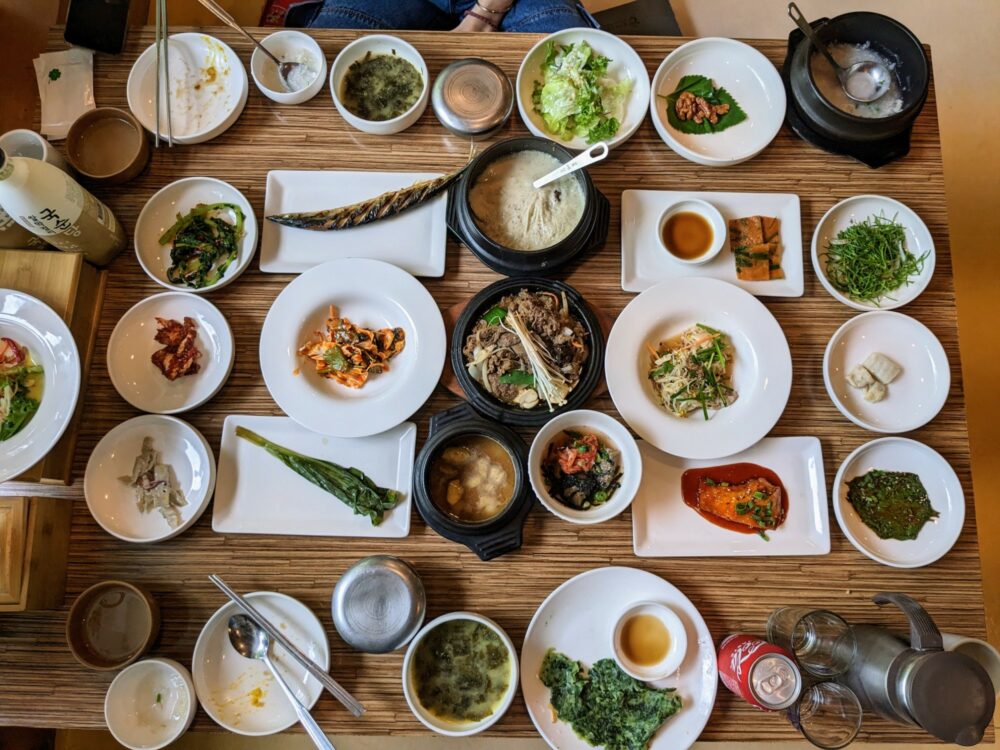
From candied walnuts and pig feet salad to acorn jelly and grilled shark, there was a lot on the menu that I’d never heard of. I didn’t enjoy everything equally, but there was nothing that I genuinely disliked, and plenty that I really loved.
Go in with a sense of adventure and a willingness to try at least a little bit of everything, and I promise you won’t be disappointed by the experience. Washed down with plenty of makgeolli (a delicious milky rice wine that’s one of my favourite alcoholic beverages anywhere in the world), it was definitely a meal to remember, for all the right reasons!
Day 4: Explore Hongdae, Seoul’s Most Vibrant Neighborhood
Check out of your hotel and retrace your steps back to the KTX station at Singyeongju: it’s time to take the train back to Seoul . I’d suggest an early to mid-morning departure, so that you’re left with a full afternoon to explore Hongdae, the most hipster of hipster neighbourhoods in the city.
This is where aspiring K-Pop stars can be found performing on the streets each night, the latest weird fashion trends come and go in the blink of an eye, and the buzz and neon glow of the city never really seems to stop. It also makes for a great base to explore the rest of Seoul, well-connected by metro and bus to anywhere you want to go.
Start your time in Hongdae by dropping your bags at the hotel (we stayed here ), then checking out some of the street culture that makes it famous. Street art is everywhere in this part of town, some of it by seriously talented artists. You’ll spot everything from small pieces in tiny alleyways to huge pictures covering the entire side of a building; I found some of the best in the small side streets around Fashion Street, but locations change all the time for obvious reasons, so don’t be afraid to wander.
If you came to Seoul for some retail therapy, you’re in for a treat. Hongdae is one of the homes of shopping in this city, with everything from cute little boutiques to enormous multistorey department stores and pretty much anything you can imagine in between.
Start out at AK Plaza, which is alongside exit 4 of the Hongdae metro station and includes a wide range of well-known brands across its five floors. I spent an hour in here one rainy afternoon, having gone in only looking for a t-shirt and walked out with three of them, having tried on about 15 different things in the MUJI store alone!
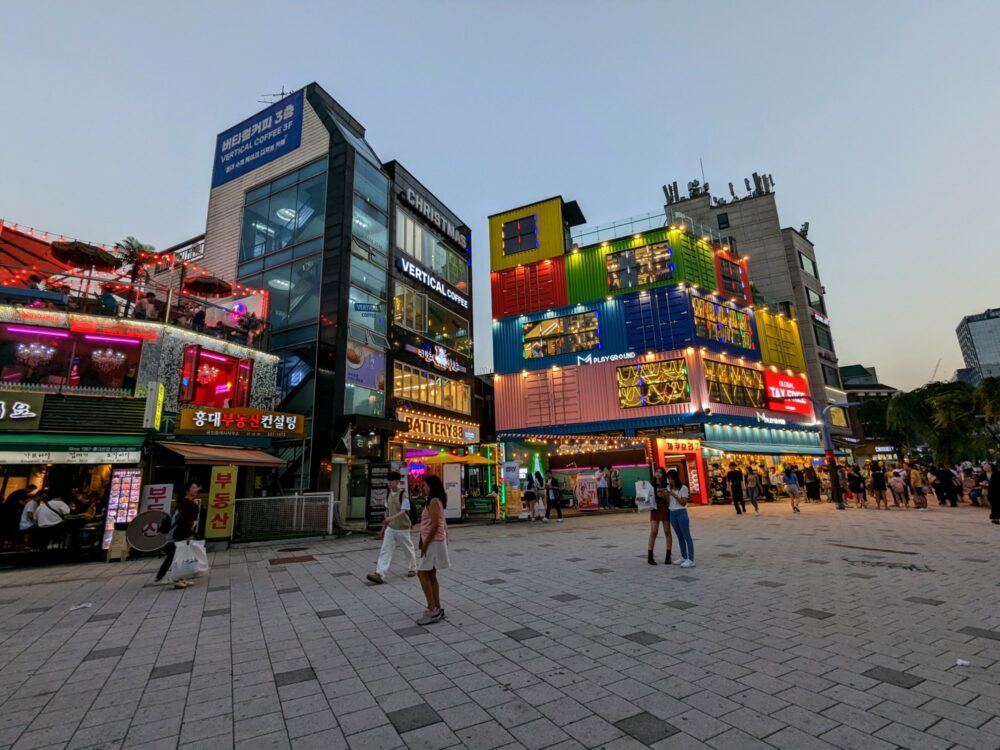
From there, it’s really up to you. Vintage threads, tacky souvenirs, discounted clothing in a store made from (fake) shipping containers, even several floors of fashion eyewear, it’s all in Hongdae, often within a few feet of each other.
Speaking of AK Plaza, it’s the ideal kicking-off point for a stroll along the Gyeongui Line Forest Park . As in many parts of the world, city leaders in Seoul decided to turn a disused railway line into a walking trail. They’ve done a great job, creating a narrow green oasis that stretches for over six km (3.7 miles) northwest to southeast, with AK Plaza roughly a third the way along.
On a nice day, you’ll see plenty of people out walking their dogs, kids, and each other along the paved paths. Keep an eye out for the Gyeongui Line Book Street , a section dedicated to the joy of reading. Sadly many of the little kiosks and book stores didn’t seem to be open any more when I walked past, but the public artwork is still there regardless.
There are endless options for cafes and restaurants along pretty much the entire length, so walk for as far as you feel like, then branch off a block or two in either direction for some refreshment.
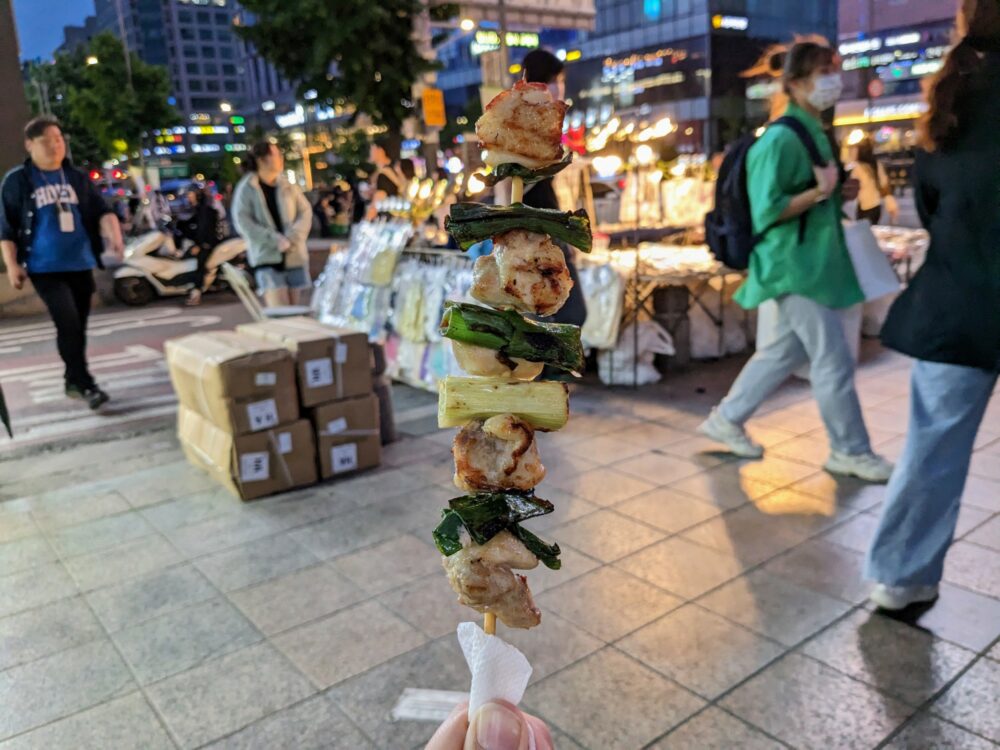
Once night falls, the already-bustling streets come even more alive. Night markets pop up, some stretching for multiple blocks, with food trucks and unidentifiable objects for sale in equal measure. Make sure you’re wandering around on Hongdae Street at this time; in some sections of this long, semi-pedestrianized thoroughfare, you literally can’t walk a block without coming across a new group of street performers performing choreographed dance moves to an ever-changing crowd.
Chicken and beer is a huge thing in Korea, so much so that there are entire streets dedicated to it. You’ll find several chicken and beer restaurants basically alongside each other on Hongdae Street, packed with patrons from late afternoon onward. They’re all pretty good, but I preferred the crispy, spicy drumsticks at Kyochon Chicken, a couple of blocks back from Hongdae Street and just off the main Yanghwa Road. They were so delicious, I went there twice!
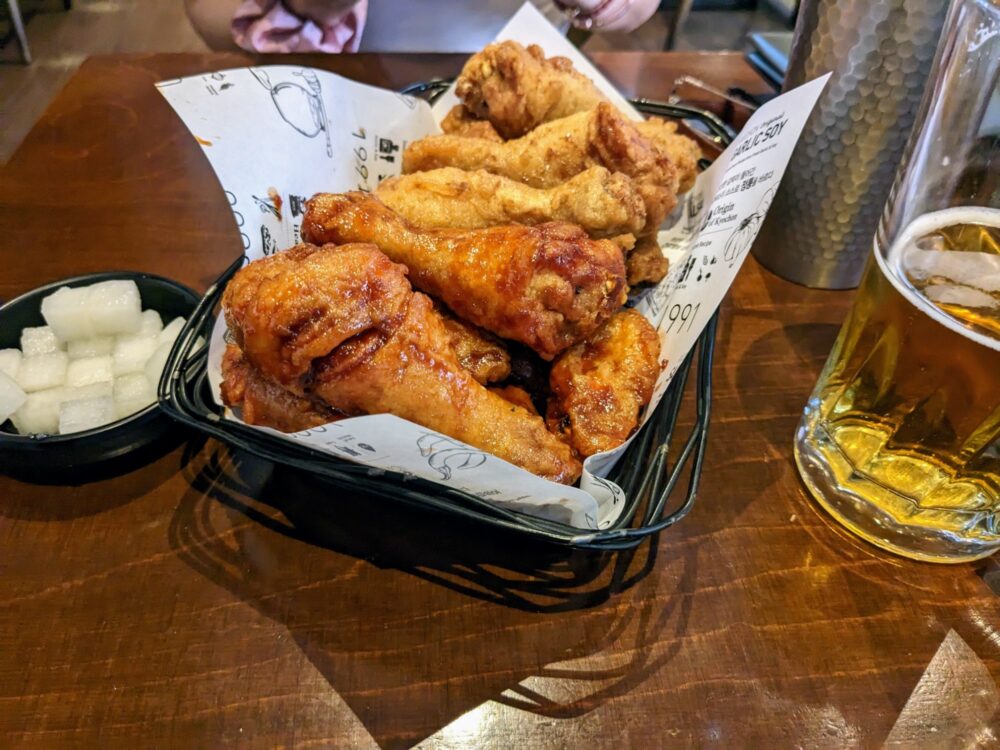
Speaking of beer, while the mass-market Terra and Cass are perfectly drinkable and pair well with sunny days and/or fried chicken, there’s a growing craft beer scene in and around Hongdae as well. Head to Brew Heim, Craft One, or Deeper to sample some of the best local and international options.
Once you’ve downed a sufficient number of those craft beers, it’s time for karaoke . This is serious business in Korea, with several 24/7 multistorey buildings devoted entirely to it on Hongdae Street alone. Just look for the signs and head inside: you’ll get your own soundproof booth, with a vast array of English songs available, plus Korean and often Japanese hits as well. You pay by the hour, with a minimum spend on food/drink as well.
After you’ve eaten, drunk, and sung your heart out, finish the night at Zzang Games . This huge arcade has pretty much everything, from dance mats and shooting games to driving simulators and a wide range of those endlessly-frustrating machines where you try to grab soft toys and other prizes using a mechanical claw. Entry is free, you just pay for each game you play.
Where to stay in Hongdae : We splurged a bit for our time in Hongdae, and this stunning hotel couldn’t have been more worth the money. It really is one of the best places to stay in the city, and considering that, is pretty good value. Our modern, stylish room had amazing views, which were bettered only by those from the rooftop bar; whether you drink there or not, you definitely have to go up to take photos at sunset! We even got a free bottle of wine, a local travel-sized game to play and keep, and a pack of fancy toiletries. Despite being right in the heart of this bustling neighbourhood, the sound insulation was so good that I couldn’t hear any outside noise at all. The hotel gym was larger and much better equipped than almost any other I’ve used, and while the in-room coffee was very good, the brews from the downstairs café were even better! I’d stay here again in a heartbeat.
Day 5: Historic Seoul
If yesterday was all about modern-day Korea, today focuses firmly on the country’s past. Despite being such a trend-setting city in many ways, Seoul’s links with its history are never far from the surface.
There are five famous royal palaces, for instance, all conveniently located quite close to each other. Unless you have a lot of stamina, though, I’d suggest not trying to visit them all in a single day: it’s a lot of walking, and there’s a good chance you won’t appreciate much of what you’re seeing by the end of the day!
Instead, I’ve selected the three must-visit palaces, leaving the other two as options if you have extra time or want to skip out on some of the other activities I mention in Seoul. This gives more time to explore each one, as well as take in all of the other things to do nearby without being too tired to enjoy them.
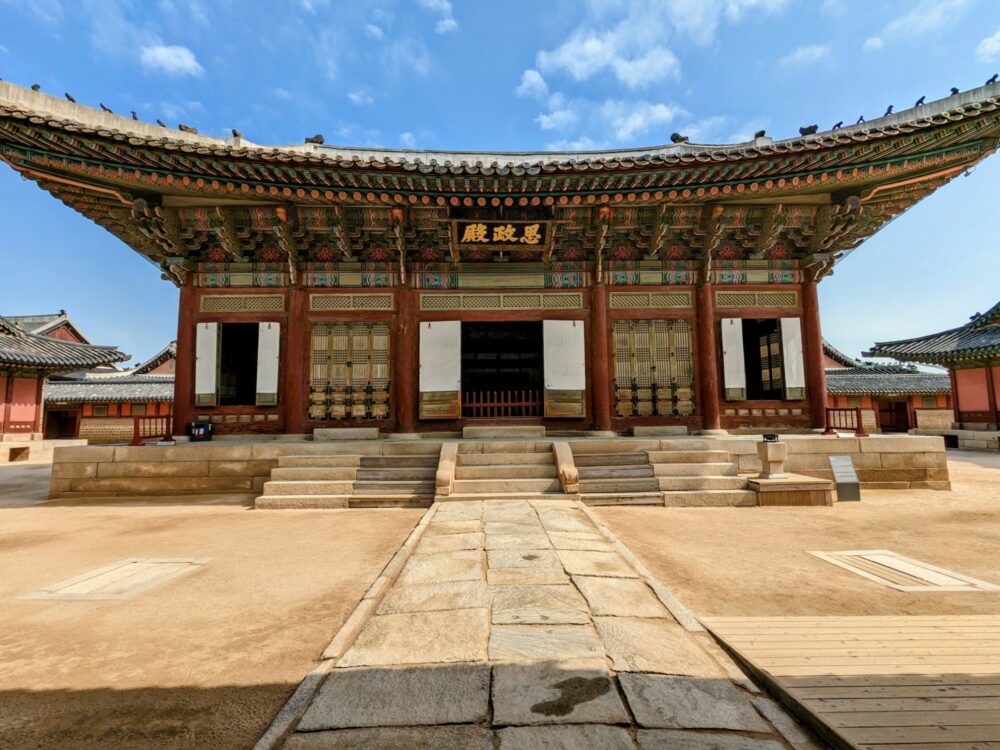
Let’s start with Gyeongbokgung Palace . It’s the biggest and most impressive of the five, first built in 1395 and stretching over an impressive 100 acres (nearly 4.5 million square feet)! To get there, take the metro to either Gyeongbokgung Palace station (exit 5) or Gwanghwamun station, exit 2. Once you emerge at street level, it’s impossible to miss. Do note, however, that it’s closed on Tuesdays.
You can either pay for an individual entry ticket (₩3000), or buy a pass that gives access to all five palaces for ₩10,000. It’s valid for three months, and assuming you’re planning to go to Changdeokgung palace (below), will save you money. Anybody wearing hanbok gets in to all of the palaces for free: it’s a popular pastime, and there are dozens of nearby shops renting this traditional Korean attire by the hour or day if that’s something you’d like to do.
A ceremonial changing of the guards takes place at 10:00am and 2:00pm each day; I’ve been to many of these around the world over the years, and this is one of the most impressive. Because of that, it definitely attracts the crowds, who tend to arrive just before the ceremony and then spend the next hour or two exploring the site.
For that reason, I’d recommend arriving around opening time at 9:00am and heading straight for the gardens and pond at the rear of the complex, so you can enjoy the peaceful surroundings without hundreds of other people around. Once you’re done there, just work your way back towards the main gate, being sure to arrive at least 15 minutes before the parade starts so you can get a good spot along the roped-off area.
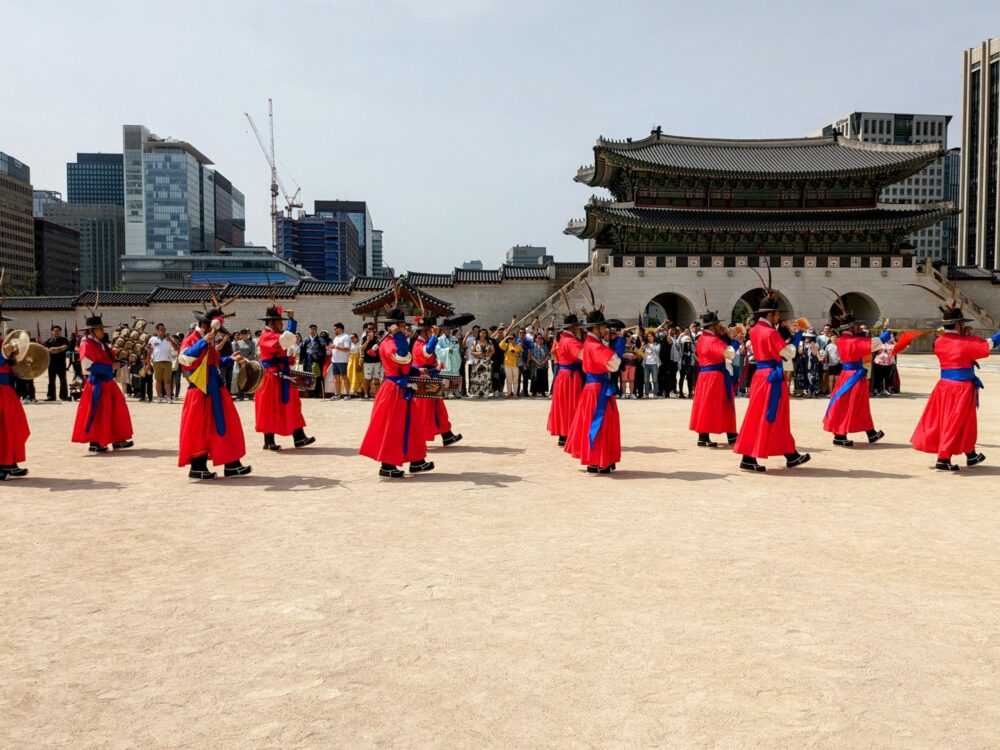
Like so many of the historic sites in Korea, nothing remains of the original buildings. They were burned to the ground during the Japanese invasions in the 1590s, and after being rebuilt in the nineteenth century, were then systematically destroyed by the colonial government during the Japanese occupation in the early 1900s. Only ten buildings survived that destruction, with everything else being rebuilt since 1989. They’re still stunning, of course; they’re just not original!
Once you’ve taken in the changing of the guard, which takes about 15 minutes, finish up looking around the front section of the palace and then head out the main gate. It’s time for some more delicious food!
Lunch: if you’re looking for an unusual place to eat with few other foreigners, head to Tosokchon Samgyetang . It’s only a short walk from Gyeongbokgung Palace, and has been serving up its famous ginseng chicken soup for the last several decades. It’s a popular spot, which is why we skipped breakfast that day and got there around 10:30am for an early lunch instead. The restaurant opens at 10am, and lines start forming outside soon afterward. We went for the black chicken, which looks unusual but doesn’t affect the taste, along with a seafood and scallion (green onion) pancake and the obligatory sides of kimchi and pickled garlic. The chicken was super-sort, falling off the bone, and the broth was delicate and delicious. There’s even a useful guide (in English) on how to tackle the meal correctly, which we definitely appreciated: we’d have had no idea otherwise! It cost a total of ₩47,000 for two ($35 USD): not the cheapest meal we had in South Korea, but absolutely worth it for the experience.
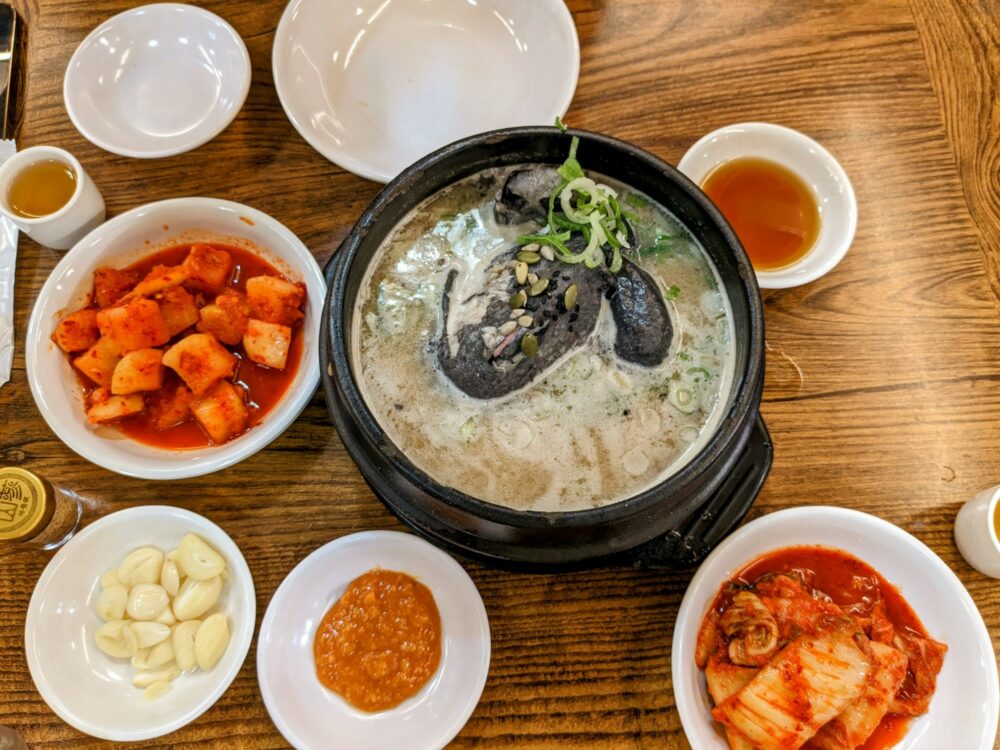
Once you’re done, it’s time to work off some of that tasty soup with a bit of a walk. Your next stop is Bukchon Hanok Village , a spot that’s become Insta-famous in recent years for its beautifully aesthetic restored houses that date back to the Joseon era, wedged tightly together on the side of a small hill. It’s about a half-hour walk away, on the other side of Gyeongbokgung Palace.
As with most great views the world over, there’s a bit of effort required to get them. In this case, it’s a fairly steep climb up the village streets to the top of the hill, so you can get those long, lovely views back down the narrow alleyways. The famous photo spot is helpfully marked on Google Maps.
You don’t need to spend a lot of time here; because people still live in most of these houses, there’s not a lot to see beyond the elaborate facades. That said, it is worth having a look around beyond that singular photo spot: things get much quieter only a short distance away, and the buildings are just as pretty.
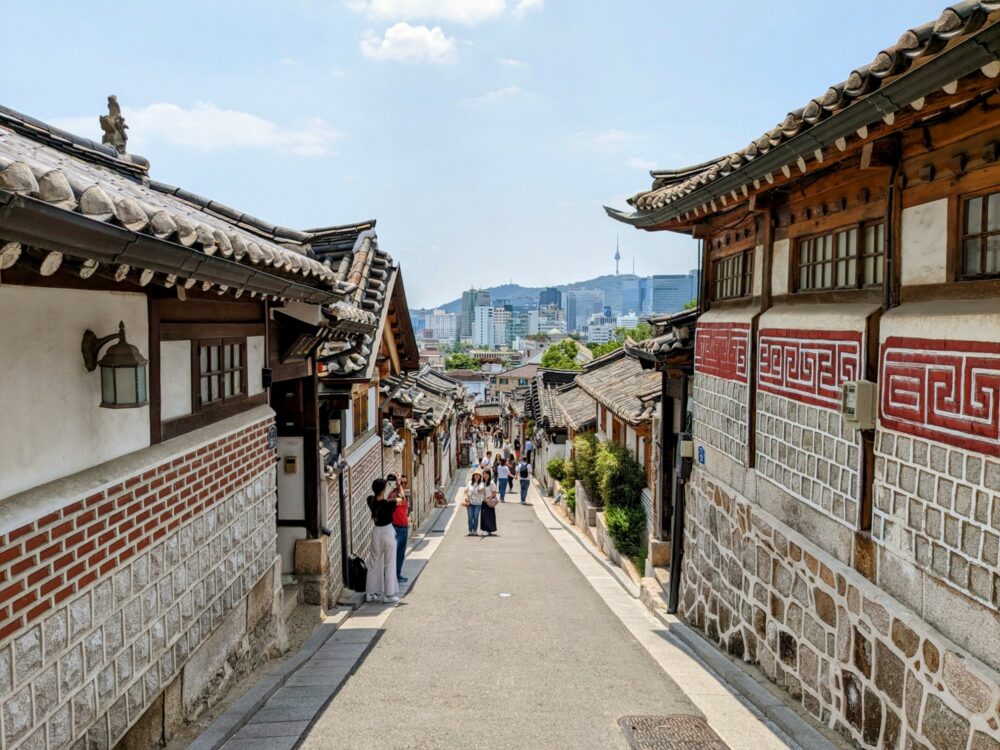
Moving on, it’s time for Changdeokgung Palace : the entrance is about a 15 minute walk from Bukchon village. If it’s a hot day and you’re in need of refreshment, stop off at Onion along the way: this popular café is famous for its cakes and other baked goods, although I had no idea of that when I popped in for a coffee and wondered why the line was so long! It moved quickly, though, and it’s such a lovely building that I didn’t mind the wait.
The palace itself is large and reasonably interesting, but for most people, it’s the Secret Garden inside that they’ve really come to see. Entry to the garden is only permitted as part of a guided tour, which is offered in Korean, English, and Japanese.
Tickets cost ₩3000 for the palace and a further ₩5000 for the secret garden: both are included in the palace multi-pass I mentioned earlier, but you do need to exchange the voucher in the booklet for a timed ticket on a guided tour. The palace and garden are closed on Mondays.
The English tours run at 10:30am, 11:30am, 2:30pm, and (other than Jan/Feb), 3:30pm, and take about 90 minutes. With that in mind, I’d suggest booking yourself on the 2:30pm tour, so you don’t have to rush to get there and have plenty of time to explore the palace grounds beforehand. There are 100 places available on each tour, with half able to be booked online up to six days in advance, and the others available on a walk-up basis.
If you didn’t manage to get yourself one of the prebooked slots, I’d suggest arriving at the palace by 1:15pm. That way, you can go straight to the ticket office for the secret garden, book yourself on the next available tour, and then explore the rest of the grounds while you wait.
The gardens themselves are quiet and peaceful, a lovely little slice of nature in the middle of a metropolis. Much of the area is quite manicured, with ponds and small buildings, but the final 15 minutes or so of the tour goes through a more natural, wooded area. This is also the steepest part of the track, although that’s really only by comparison with the dead-flat path that precedes it.
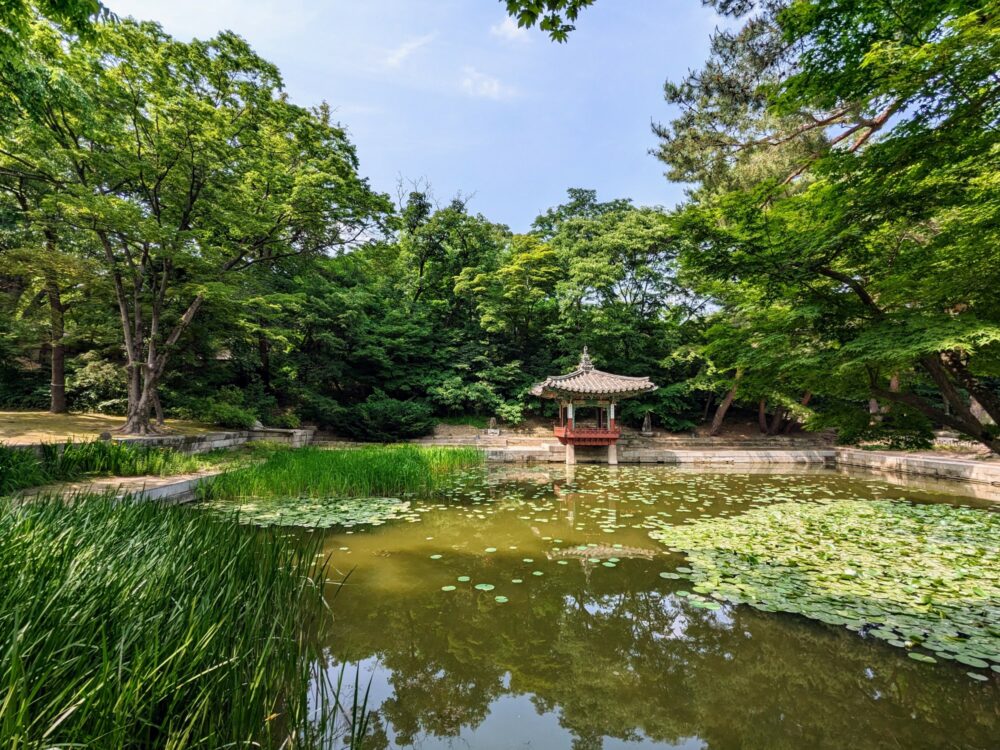
You finish the tour back close to where you started: once you’ve seen everything else of interest in the palace, it’s time for the final attraction of the day: Changgyeonggung Palace . Far less-visited than the previous two palaces, it has a much more natural, woodland feel, with several lakes and reservoirs, and trails that branch off in various directions.
Conveniently, you can access it via a small gate at the back of Changdeokgung Palace, so you don’t need to go all the way back out and around to the main entrance. It’s the cheapest palace to enter, at just ₩1000 (again, entry is included with the multi-pass), and is also closed on Mondays.
There’s a particularly photogenic spot inside this palace, one that we just happened to stumble upon as we walked past. Stone steps lead down to a large courtyard that was once a residential area for the queen and concubines, which are flanked by large trees. With the contrast of the city’s skyscrapers clearly visible in the distance, it’s one of my favourite photos from my entire time in Seoul.
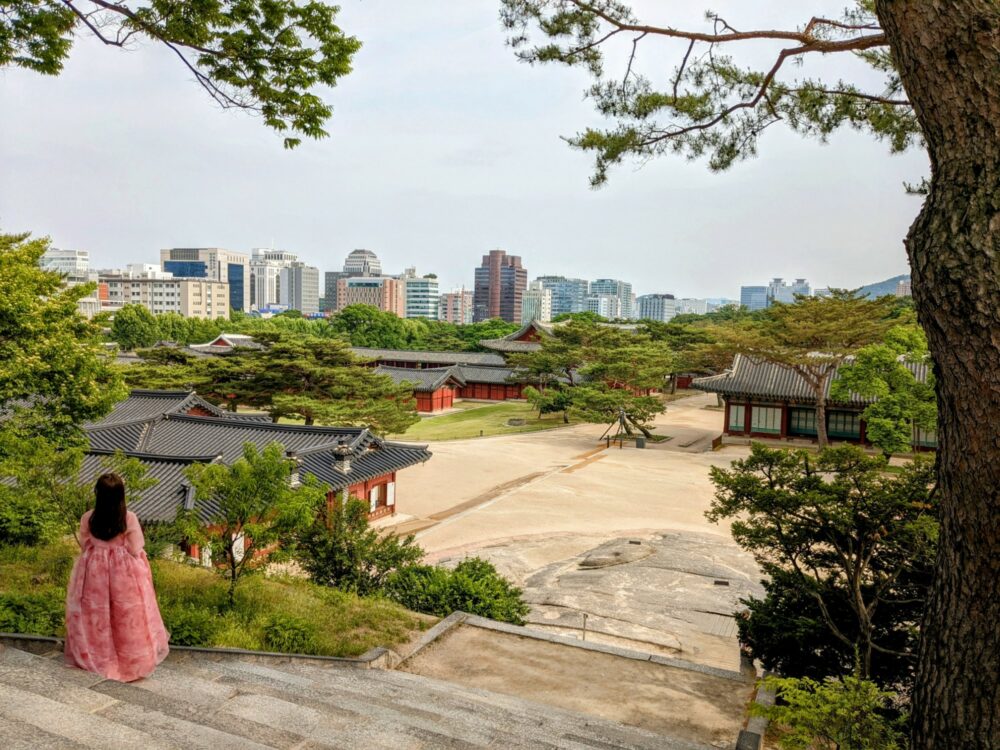
We chose to explore the palace grounds at a leisurely pace, taking about an hour to work our way around and ultimately out to the main entrance/exit gate on Changgyeonggung Road. From there, the number 7101 bus runs regularly back to Hongdae and takes about 45 minutes: it’s faster and easier than walking back to a metro station.
Got a Second?
I pay for all my travels myself, don’t work with tourism boards or PR people, and don’t accept freebies or discounts. Everything in this post is based on my own experiences, and every word is written by me. I’d rather go lie down in a ditch than use AI.
Because of that, I rely on my readers to help keep me on the road. Everything I write will always be free to read, but if this post helped you plan your trip, I’d love it if you’d consider making a small donation so I can keep doing this in the future. If you’re able to help out, thanks so much in advance!
Day 6: Cultural Seoul (and Market Madness)
Today, you’re off to Insadong , which is Seoul’s cultural heart and easily one of my favourite neighborhoods in the city. I was surprised how much I loved it here: it’s the perfect place to go shopping for one-off souvenirs that you won’t find anywhere else, eat in little family-run restaurants, and just wander around getting lost in the cobbled alleyways that snake off the main street.
It’s not just about art and tradition, though: tucked between antique stores and tiny boutiques selling beautiful stationary, you’re just as likely to find a hipster coffee shop as an art gallery. This area is ideal for exploring on rainy days; I kept getting caught in showers during the day I spent here, which just gave the perfect excuse to duck inside a shop or spend a bit longer sipping that coffee!
The neighbourhood itself is close to where you were yesterday, a little south of Gyeongbokgung and Changdeokgung palaces. Aim for Jonggak station on the metro to start your day, making sure to check out the small “solar” garden inside the station before heading out onto the street.
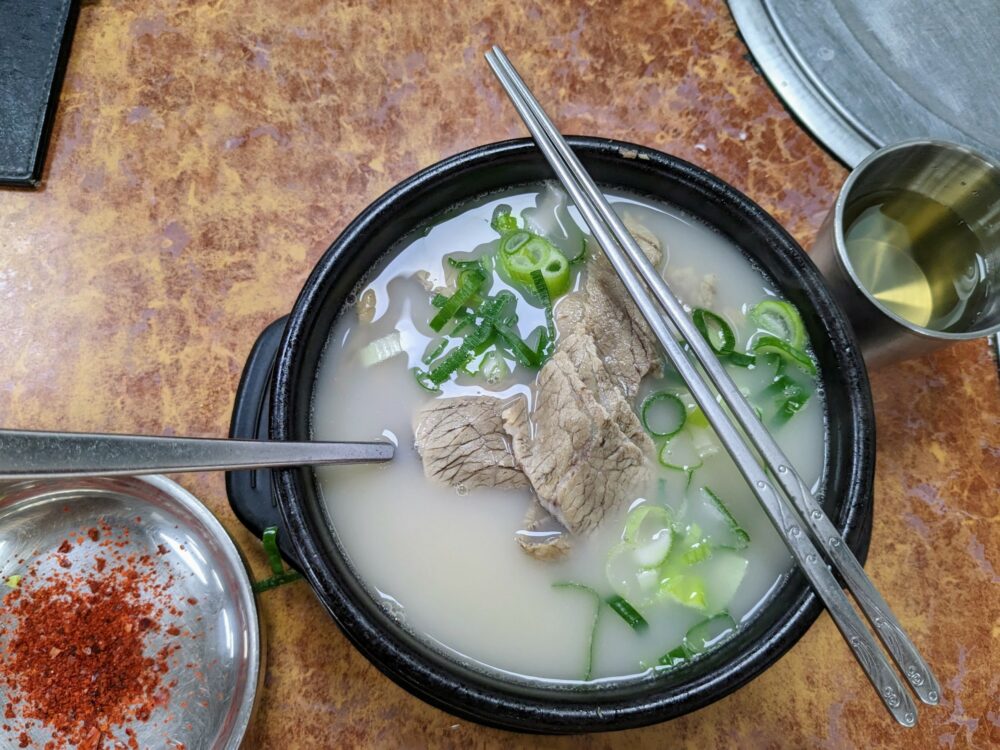
Like the day before, we decided to forgo breakfast in favour of an early lunch, this time at Imun Seolnongtang . Famous for the ox-bone soup that they’ve been turning out for over a century (so much so that they got a mention in the Michelin guide), the place is slightly tricky to find and resembles a school canteen on the inside. It really is all about the food. There are only three options on the menu, so it’s not hard to figure out what to order even though there’s not a lot of English spoken. If you go for the soup (and you should), don’t be afraid to be heavy-handed with the sides: the broth is quite bland by itself, with the idea that you mix and match to exactly your preferred flavour. We paid ₩13,000 each for our soups.
Once you’re done, the best way to experience Insadong really is just to wander without a lot of intention, both along the main street that’s lined with galleries and boutiques, and the numerous alleyways that spider off from it. I’d recommend taking a near-empty backpack with you; there’s a good chance it’ll be full by the time you leave! We filled ours with lovely ceramic mugs, both as gifts and to keep as souvenirs: I’m sipping my morning coffee from one as I write this.
One place that’s particularly worth going, though, is Ssamzie-gil , a four-storey open air shopping mall that’s crammed full of wonderful little stores that mostly seem to sell one specific type of item. You can (and we did) lose plenty of time inside here; we walked away with various unusual earrings, pens, and other random souvenirs that we hadn’t seen anywhere else, and could have bought a lot more!
When you’ve worked up an appetite from all that shopping, it’s time to head towards Gwangjang market , made famous in the west thanks to Cho Yonsoon’s starring role as the “knife-cut noodle lady” in the Seoul edition of Netflix’s Street Foods: Asia series.
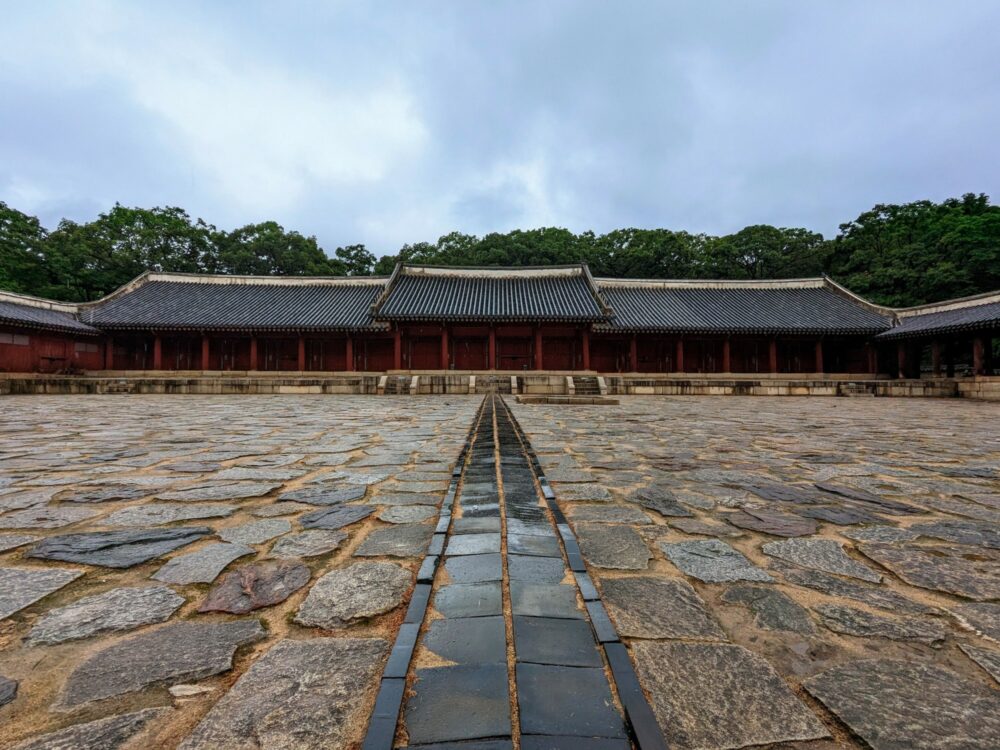
It’s about a 20-minute stroll from the southern end of Insadong Street to the market, a walk that takes you right past Jongmyo Shrine . Entry is included in the multi ticket for the royal palaces if you bought one. Much smaller than the palaces you visited yesterday, there’s scaffolding around the shrine itself at the moment, so it’s not anywhere near as attractive as usual. I was fortunate enough to visit just before it got covered up!
Still, the grounds are lovely to wander around, and since it only takes about half an hour to check out the main sights, it’s worth the small amount of effort. If you didn’t buy the multi-pass, entry is ₩1000. Note that while you can walk around by yourself at the weekend like we did, you’ll need to join a (free) tour to visit the shrine during the week.
From the tranquillity of Jongmyo to the mayhem of Gwangjang market, the difference couldn’t be more extreme. The market is seriously busy at weekends: we got there at around 2:30pm on a Sunday afternoon, and as you can see, even moving around was difficult! Early or late on a weekday would be a much better option if you’re not a fan of crowds, although note that most stalls are closed on Mondays.
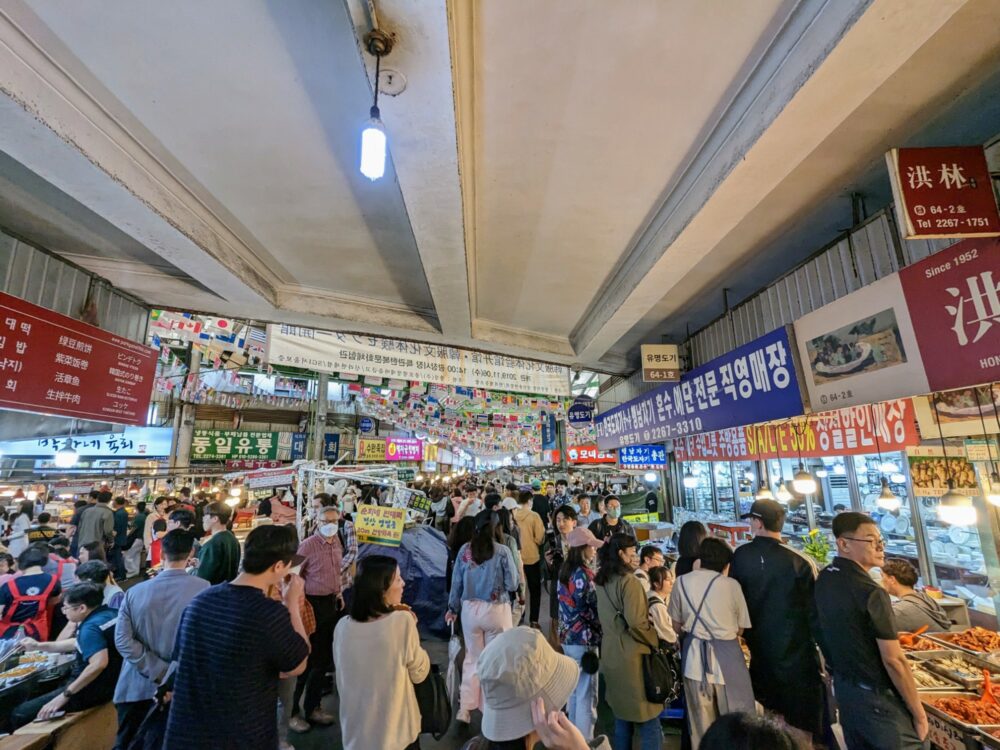
If you’re hoping to visit Cho Yonsoon’s noodle stall, keep an eye out for the Netflix signs in the middle of the market, near where the two “lanes” form a crossroads. The line was extremely long when we visited, so we skipped out on that experience, but there was an endless supply of other great food stalls to choose from.
I particularly enjoyed the mung bean pancakes, hot and delicious straight from the deep fryer: several vendors offer them. Many other local dishes are available as well, most from multiple stands in the market: just be prepared to wait for a seat during busy periods if it’s not something you can order to go.
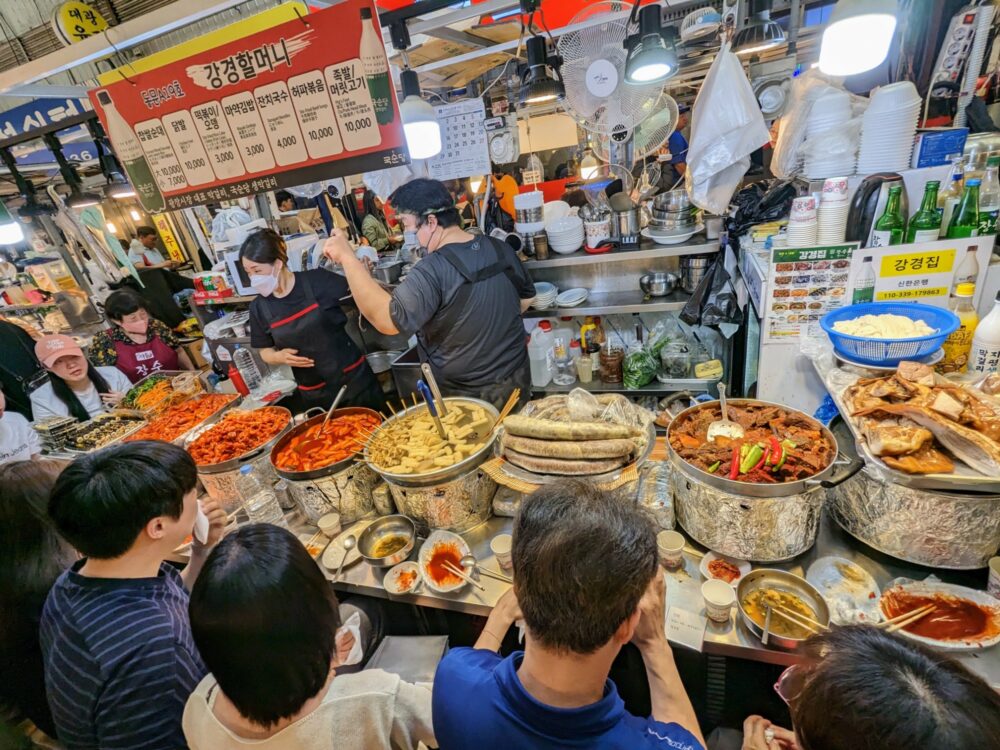
How long you spend in the market will likely depend on your appetite for both food and large groups of people. Give yourself half an hour if you only walk through from one end to the other and grab something to snack on while you’re strolling, and at least twice as long if you plan to sit down at one or more popular spots.
When you’re done, leave via the southern exit from the market and head for Euljiro 4(sa)ga metro station: it’s on the same line as the Hongik University stop for Hongdae.
Day 7: Gangnam Style
I try to blot out a lot of music from the early 2010s, but try as I might, Gangnam Style is an earworm that I just can’t get rid of. That song (and damn horse dance) was everywhere a decade or so ago, and its commentary on the lifestyles of the rich and famous introduced the rest of the world to both K-Pop and Seoul’s most high-end neighborhood. Today, you’re off to Gangnam.
Your first stop is Starfield COEX Mall , a vast shopping and exhibition center that’s full of everything from fast and high-end fashion to a large food court and a multistorey library that you’ve almost certainly seen on Instagram.
Getting there from Hongdae is easy: just jump on line 2 of the metro heading counter-clockwise (the “outer circle”) to Dangsan station, then switch to line nine until you get to Bongeunsa station. It takes about 35 minutes in total: leave the station via exit 7, which leads directly into the mall.
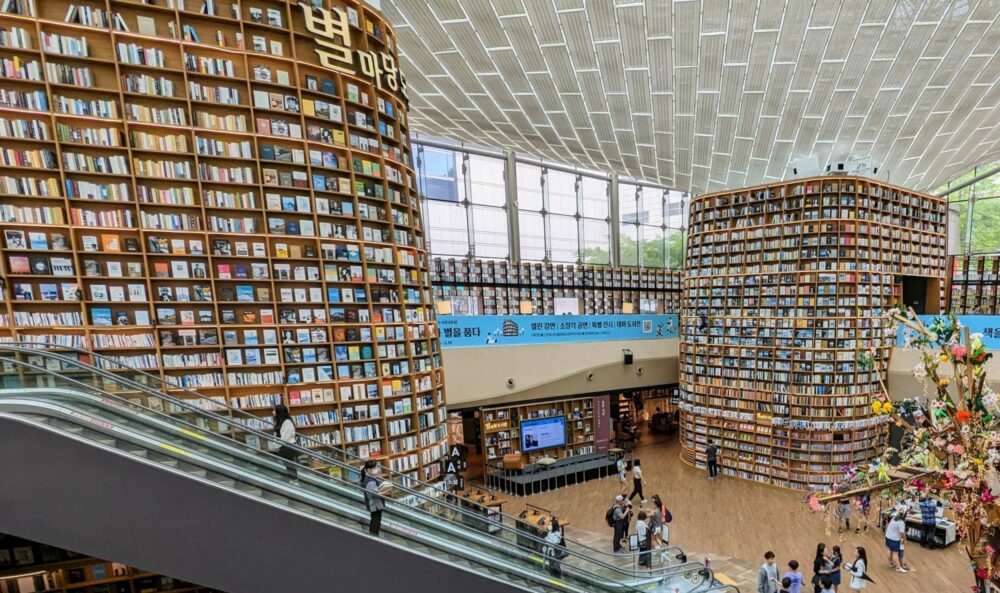
The most famous part of the mall, at least these days, is the Starfield Library that I mentioned earlier. With multistorey bookcases holding thousands of books and stretching from floor to ceiling, it’s hardly surprising that this is a popular spot with Instagrammers and Tiktokers. There isn’t a time where you’ll have the place to yourself, but going early on a weekday means that at least the visitors won’t outnumber the books.
While it’s predominantly a library (you’re welcome to take a book from a shelf to read at one of the nearby tables or sitting on the steps), there are also several tables with titles to browse and buy as well. They’re mostly in Korean, but many of the coffee-table books would make for great souvenirs even if you don’t speak the language.
Once you’re finished up there, it’s time to explore the rest of the mall. Honestly, you could spend all day inside if you wanted to: with something like 300 retail, food, and drink outlets, I suspect most visitors will run out of time before they run out of ways to spend their money.
There’s also a large aquarium attached to the mall, with around 20,000 sea creatures inside including sharks, rays, turtles, and many more. It’s a great spot to take the kids, but is worthwhile for adults as well, especially if you’ve never been to a large aquarium before. Give yourself around 60-90 minutes to look around: it’s worth booking online to save money on the walk-up price.
If all that shopping and sea life-spotting leaves you in need of sustenance, head downstairs to the sprawling food court, which has what feels like an endless range of local and foreign restaurants. I wandered around for at least fifteen minutes before finally settling on a tasty bowl of samgyeopsal from a small stand.
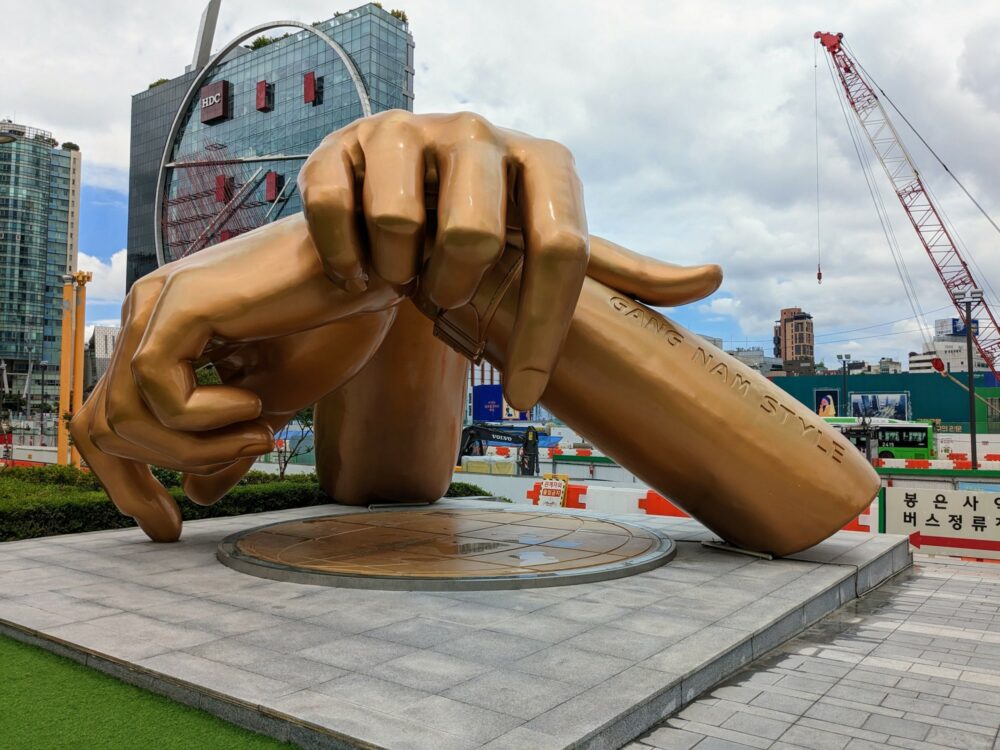
Just in case you’d forgotten where you were after the sensory overload of being inside a huge shopping center, you’ll be quickly reminded as soon as you leave. After the worldwide success of that song, it was deemed only appropriate to put up a huge sculpture of Psy’s folded hands outside COEX, complete with “Gang Nam Style” engraved on one of the forearms.
The fun doesn’t stop there, mind you: there’s a large area of (fake) grass alongside, with a video terminal that loudly plays Gangnam Style on demand so that you can dance along to your heart’s content. That’s not a hypothetical, by the way: I’d be surprised if you didn’t see someone performing in front of the statue when you’re there.
Once you’re done, it’s finally time to leave the mall precinct, but you’re not going far. Just over the road lies Bongeunsa , a Buddhist temple complex that’s a peaceful contrast to the shrine to consumerism that you’ve just left. It dates back to 794, although it now sits about a kilometre up the road from its original location, and most of the buildings are reconstructions after fire and war destroyed much of the complex in the middle of last century. Entry is free.
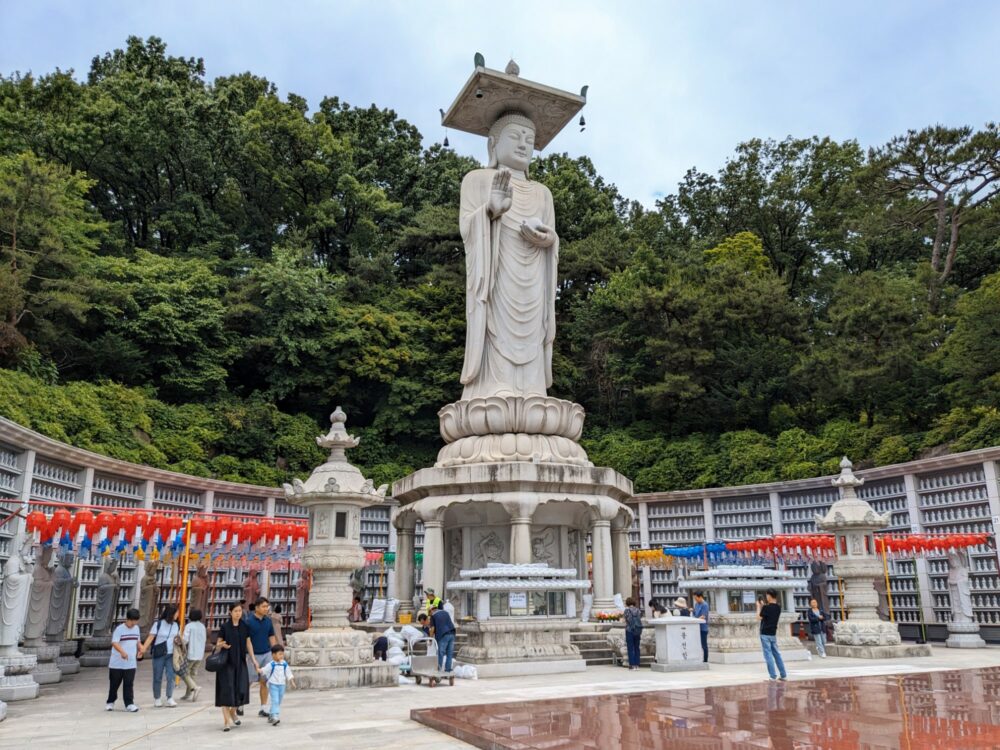
The highlight is definitely the huge stone Buddha that stands over 20m high, towards the rear of the temple complex. Be sure to check out the alcoves surrounding the statue as well: each one has dozens of small statuettes inside.
It’s not a huge area, but the wooded hillside is lovely to walk around for half an hour or so. A ceremony is held at 6:40pm each evening where monks beat drums and bang gongs for several minutes: it’s worth sticking around for if you’re visiting at that time. There’s a morning version of the ceremony as well, but since it happens just after 4am, it’s a touch less likely that you’ll be there for it!
If you happen to be there on a Thursday afternoon, it’s also worth jumping on one of the temple experiences that starts at 2pm. Costing ₩10,000 and lasting around two hours, it includes a tour, guided meditation, and a tea ceremony and conversation with temple monks.
After you’re finished at the temple, it’s time to make a choice. If it’s getting late in the day and you’re done with sightseeing, feel free to head back to your hotel: assuming you’re staying in Hongdae, I’ve got a delicious dinner recommendation for you below. If you’ve got the time, though, there’s plenty more to see and do in Gangnam, including:
- strolling along Apgujeong Rodeo Street and Cheongdam Fashion Street , where it’s easy to see the high-end style that the area is known for. If you’ve got a sudden hankering for an Armani suit or Gucci handbag, this is the place to get it.
- enjoying the colourful gingko trees (in autumn) on Garosu-gil , another popular shopping street with cute little boutiques and more mainstream brands, including a particularly large Apple store.
- getting your K-Pop on on K Star Road , where large, brightly-coloured bear statues line a roughly 1km stretch of footpath. The main attractions are the (shock) Psy and BTS bears, but there are many others.
- heading up to the top of Seoul Sky at Lotte World Tower (the highest building in Korea) for great views over the city skyline. Again, it’s cheaper to buy the tickets in advance than in person on the day.
Dinner: Back in Hongdae, head for a dinner at Shin Migyeong Hongdae Dakgalbi. If you’ve never had dakgalbi before, you’re in for a treat: it’s basically a spicy chicken stir-fry, but that simple description doesn’t come close to describing just how delicious and fun this meal is. After making a few simple menu choices (including the sides and how much chili goes into the food), the meal is cooked out the back, then tipped onto a large, heated cast-iron pan at your table to make sure it stays hot. Portion sizes are huge (we got one between two) and take a while to get through, which gives the perfect excuse to work your way through a bottle of makgeolli as you go. It’s a super-fun, social kind of place, and while it isn’t huge, the tables turn over reasonably quickly, so you shouldn’t have to wait long for a table. We went around 6:00pm on a Monday and were seated straight away. It’s an inexpensive, super-tasty way to finish the day!
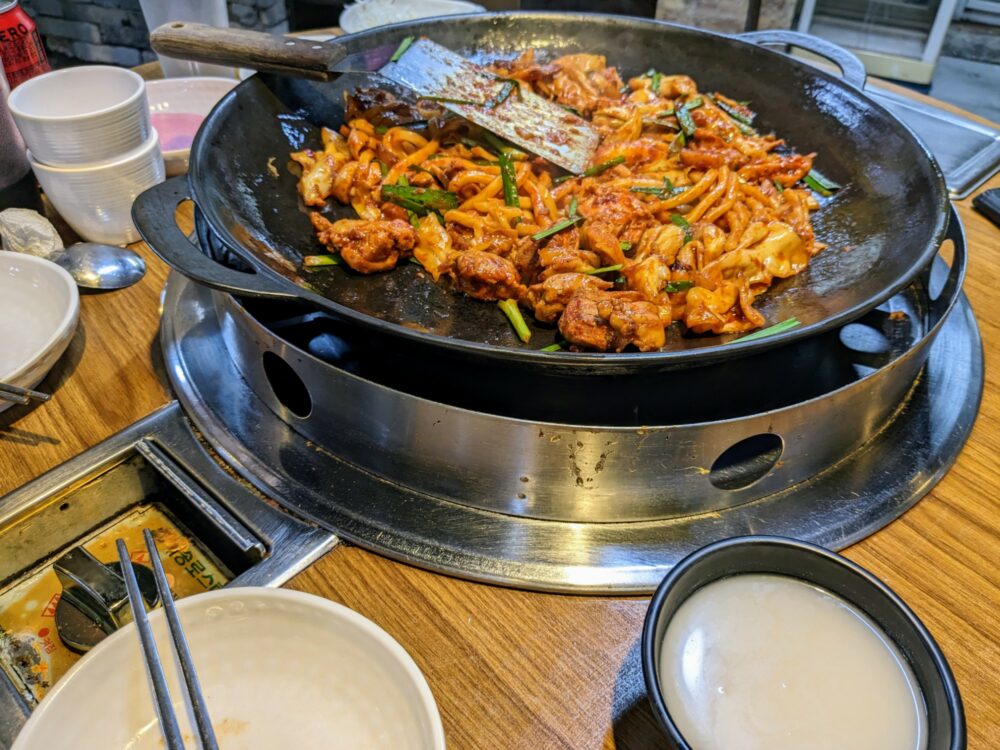
Day 8 and 9: Stunning Seoraksan National Park
You wouldn’t really know it when you’re in the middle of a huge city like Seoul, but South Korea is a seriously mountainous place: over 60% of the landmass is made up of hills and mountains. Hiking is practically the national pastime, and there are some stunning parts of the country to do it in.
For the next couple of days, you’ll be in one of the very best of those: Seoraksan National Park . I was honestly blown away by how beautiful this park was, and how good the trails were: in a couple of hours you can get to the tops of rocky mountain peaks, wander alongside beautiful tranquil streams, and stroll past delightful tumbling waterfalls. It was the highlight of my entire time in South Korea!
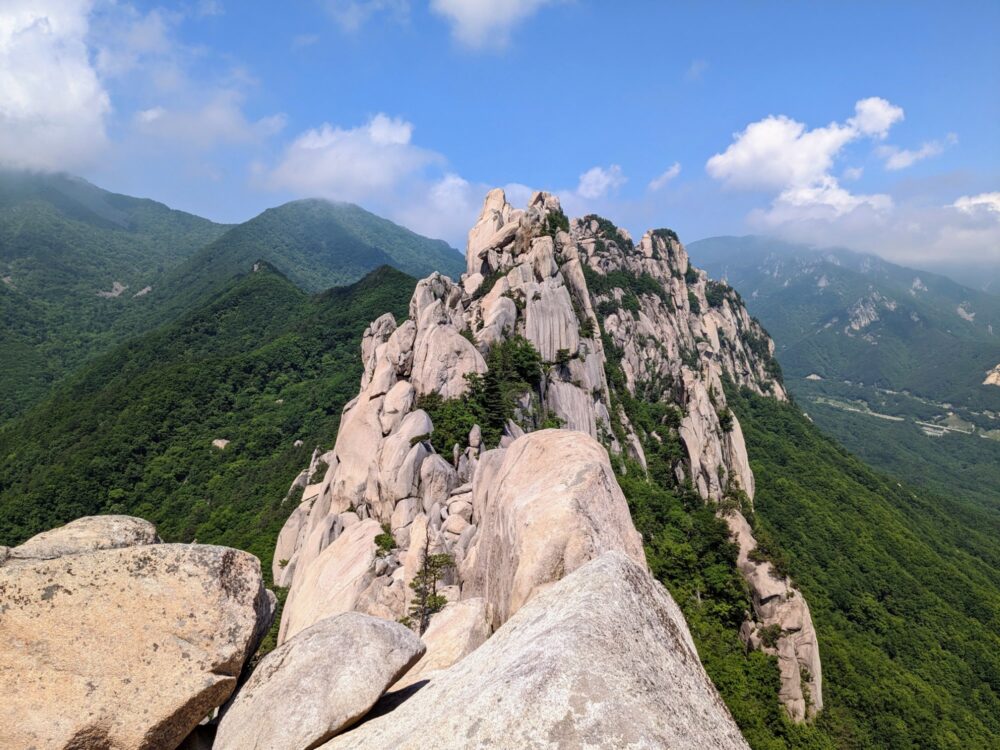
There are a few different ways to get there: I’ve written a detailed guide on how to get to Seoraksan , so feel free to read that for all of the info you need. To summarise, though, the easiest option for most people is to take a bus from Seoul Express Station to Sokcho, and then a local bus or taxi to the national park.
I’d suggest leaving Seoul reasonably early in the morning, since it takes about 2.5 hours to get to Sokcho, and another half-hour from there to the park.
You can buy the intercity bus ticket online ahead of time if you want certainty about when you’re going to leave, or just wing it and buy a ticket on the next available service when you get to the station. If that’s what you decide to do, you should be able to get a seat on a bus leaving within an hour or so, as long as you’re travelling outside weekends and peak fall colours season in September/October.
From the terminal in Sokcho, cross the street and wait for a number 7 or 7-1 local bus heading to the park entrance. You can use your T-Money card on this bus, or pay the fare in cash.
And now the fun part: all of the beautiful walks and viewpoints!
I have a complete guide to visiting Seoraksan National Park , which covers off all of the different walks worth doing, where to eat and drink, details of the cable car that goes up to Gwongeumseong Peak, and pretty much anything else I could think of. You’ll want to bookmark it before you go!
With around a day and a half in the park, you’ve got enough time to hike all of the shorter trails without being completely exhausted. Some of them are pretty flat and easy, others are definitely not. I’ve summarised the best ones below, but one of the key things to bear in mind when deciding which walk to tackle is what the weather’s doing.
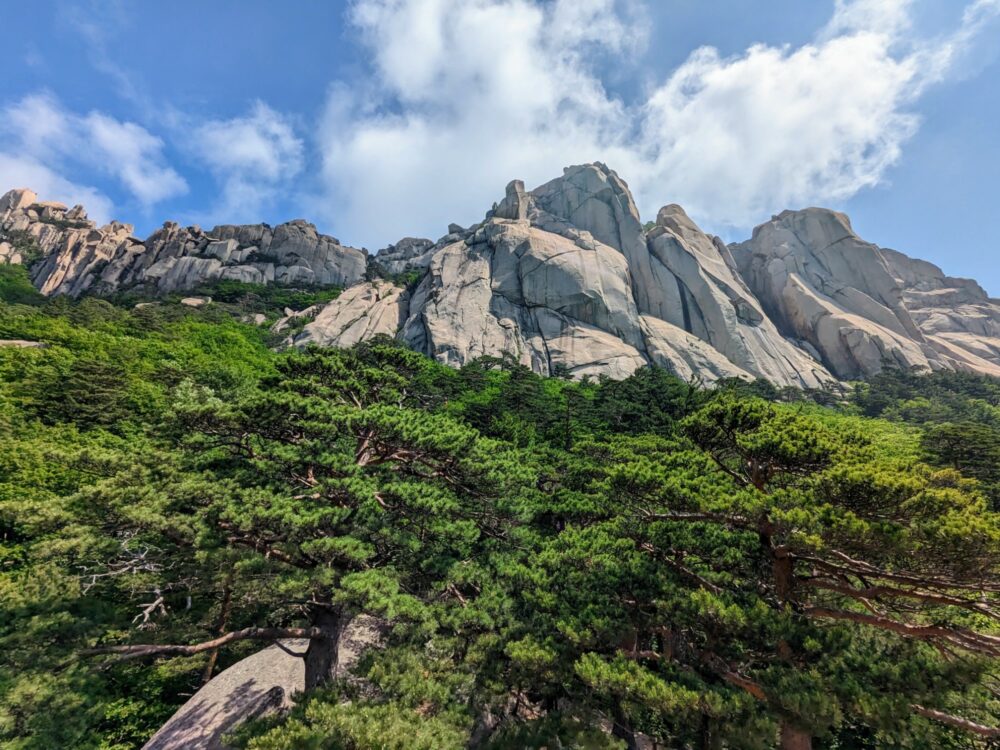
The weather in Seoraksan can be quite variable and change quickly: as a rule, I’d suggest doing the lower walks if it’s cloudy, and hope that conditions clear in time to tackle the higher trails. There’s not much point climbing all the way up to a viewpoint if you can’t see anything from the top!
Note that as of last year there are no longer any fees to enter the park, which makes it even more appealing to visit! Things like the cable car and onsite parking still cost money, though.
The Cable Car
While the highlight of Seoraksan National Park is its hiking trails, you don’t have to walk to get great views. A cable car climbs 700m from close to the park entrance up to the top of Gwongeumseong Peak, giving you most of the views with none of the sweat.
It’s believed there was once a fortress at the top of the hill, but there’s nothing left of it now: the reason to head up there these days is for the vista, not wandering around castle ruins.
If you’re taking the cable car, note that your ticket is for a specific time, and can only be bought in-person on the day. There are no advance tickets, mostly because strong winds often cause the cars to stop running at short notice.
Because the park gets busier as the day wears on, you’re best to head straight to the cable car office when you arrive, and buy the next available ticket that suits your plans. Cars leave every five minutes and hold 50 people at once: despite that, they often sell out completely at peak times.
If you buy a ticket for a few hours later and want to hike one of the trails beforehand, use the estimates in the section below to make sure you’ve got enough time. Likewise, if you can’t get on the cable car at all on the day you arrive, head back first thing the following morning and get a ticket for later that day instead.
Return ticket prices are as follows:
- Adults and teenagers: ₩15,000
- Children aged 3+: ₩11,000
- Infants under 3: Free
The car takes about five minutes to get to the top, where there’s a cafe, toilets, and viewing area. A path to the right leads uphill for 15 minutes to the “fortress” site, which is basically just a big, flat-ish rocky peak. Give yourself about half an hour to look around and take photos in all directions before heading back.
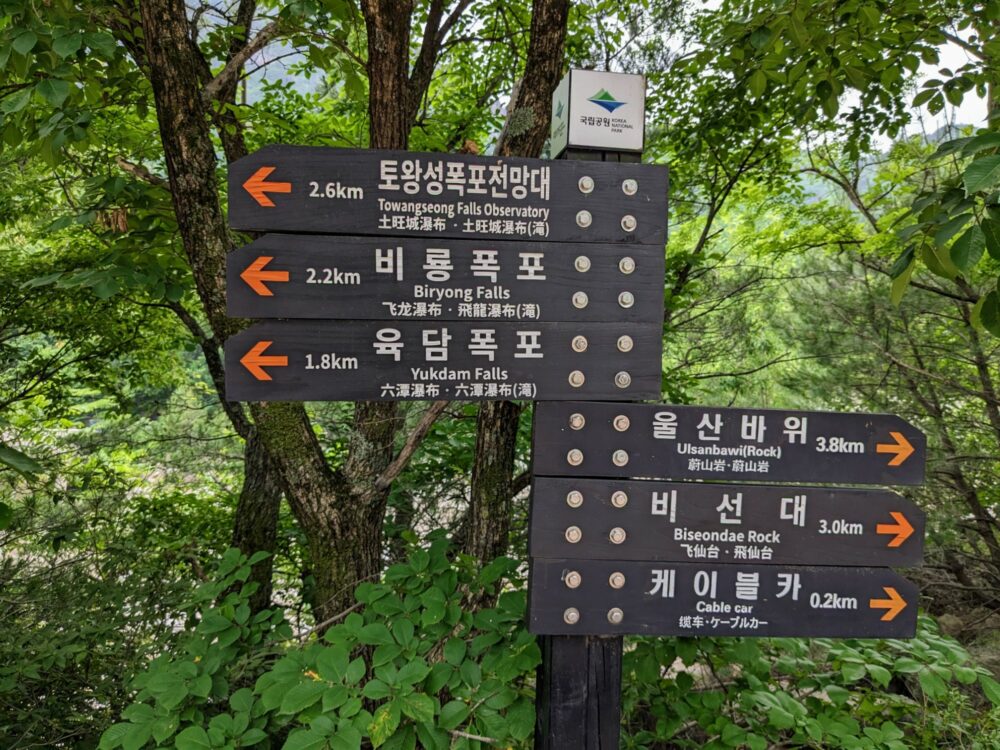
Walking Trails
These are the three trails I consider the best short-ish walks in the park. Ranging from roughly one to four hours in length, there’s something here for people of all fitness and mobility levels. Again, there’s much more detail in my full Seoraksan guide : the below is just a summary to whet your appetite!
Ulsanbawi Rock Trail : 7.6km return / 3-4 hours / Hard
Probably the biggest attraction in the park, the hike to Ulsanbawi Rock is glorious on a clear day. Along with spectacular views over the valley, you get to admire Ulsanbawi Rock itself, a distinctive jagged granite ridge that sits around 870m (2860ft) above sea level.
The first part beside the river is easy, with a concrete path to walk on and minimal climbing to do. The concrete ends once you hit the first set of stone steps, but even this section as far as Gyejoam Temple isn’t too difficult.
From there, the trail continues upwards, past a large boulder that’s worth clambering up on to for a great view of Ulsanbawi. It’s less than a kilometre from the boulder to the top, but it’s hard work: essentially one long staircase, with many hundreds of steps and no real shade once you’re above the tree line.
All that effort feels worthwhile once you get to the top, though!
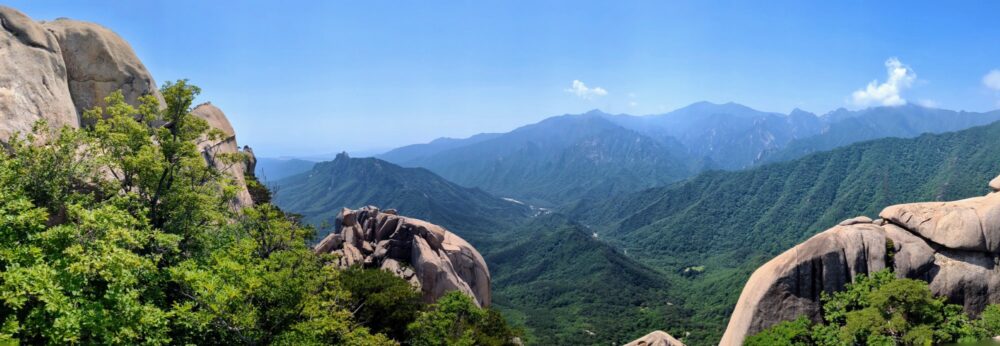
There are a few different viewing areas at the end, with different perspectives of the park and nearby countryside. Take a lunch break here, or at least have a drink and a snack: you’ve earned the rest!
While the return trip is faster and not as much of a cardio workout, it’s tough on the knees after a while. Let’s just say I was happy to see the end of the steps and get back to some flat ground again at the bottom!
Biryong Falls Trail : 4.8km return / 1-1.5 hours / Moderate
Fan of waterfalls? Look no further than the Biryong Falls trail. It’s a relatively short hike that starts out as an easy, flat nature trail through the forest, before climbing steadily alongside the river to two different waterfalls. If you don’t mind a workout, you can also extending the walk up a steep staircase to an observation platform for Towangseong Falls, the tallest in the country at 320m (1050ft).
After a gentle stroll through woodland, the path becomes steeper and rockier as it approaches Yukdam Falls. You get some lovely views as you approach and cross the suspension bridge over the falls.
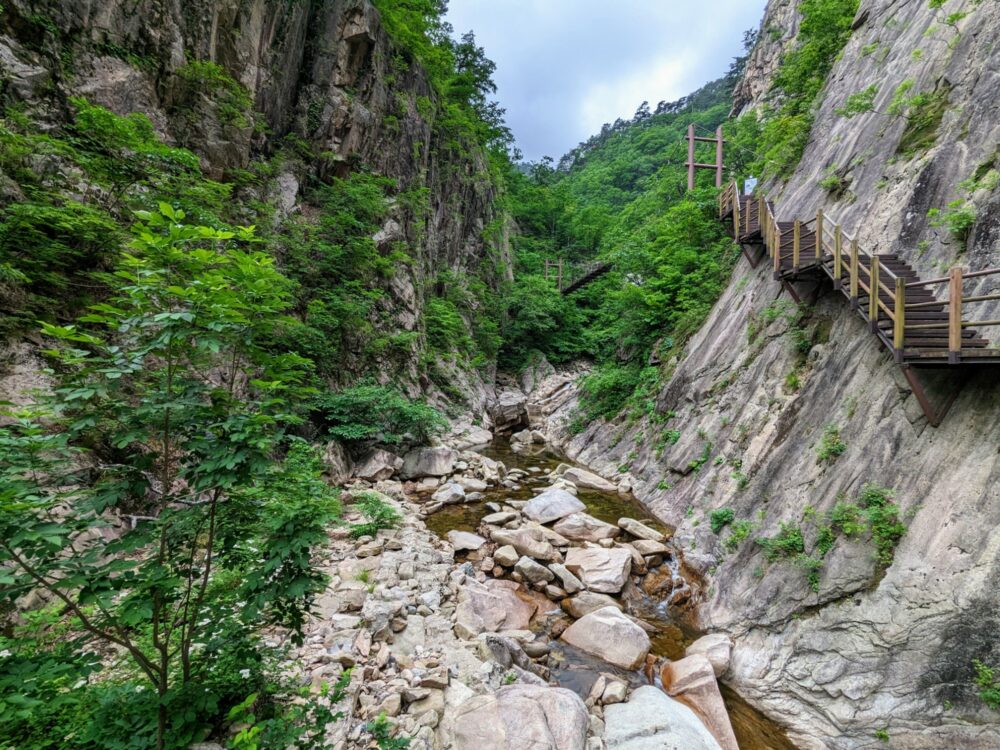
The next section is a bit steeper than the last, but still pretty straightforward as you climb up to Biryong Falls. It’s not the biggest or most exciting waterfall in the world, but it’s a good place for a snack or a drink, with plenty of seating around the pool at the base of the waterfall.
Many people turn around at this point, returning the way they came back towards the main part of the park. If you’re feeling fit, however, follow the sign pointing up to Towangseong Falls Observatory instead. It’s only an extra 400m, but you’ll feel every single one of them: it’s stairs, stairs, and more stairs the entire way.
Expect to take 15-20 minutes to get up there, and to be more than a little short of breath when you do. Once the panting subsides, you’ll find yourself on a multi-level observation deck, looking out towards a pretty significant mountain range and the tumbling Towangseong Falls in the distance.
You probably won’t spend too long up there, no more than five or ten minutes, before starting the journey down the stairs and along the main path back to where you started.
Biseondae Rock Trail : 6km return / 1.5-2 hours / Easy
The Biseondae Rock trail was the last hike I did during my time in Seoraksan, and one of the best. It’s the easiest of the three walks I mention here: you simply follow a stream up a valley the whole way, under tree cover and mostly on flat paths. It’s all very straightforward.
The trail is quite scenic on the way to the large rock that gives the path its name, but it’s when things open up right at the end that it gets seriously pretty. I was lucky enough to have the place to myself, and it was super-peaceful, with just the sound of buzzing insects and rushing water for company.
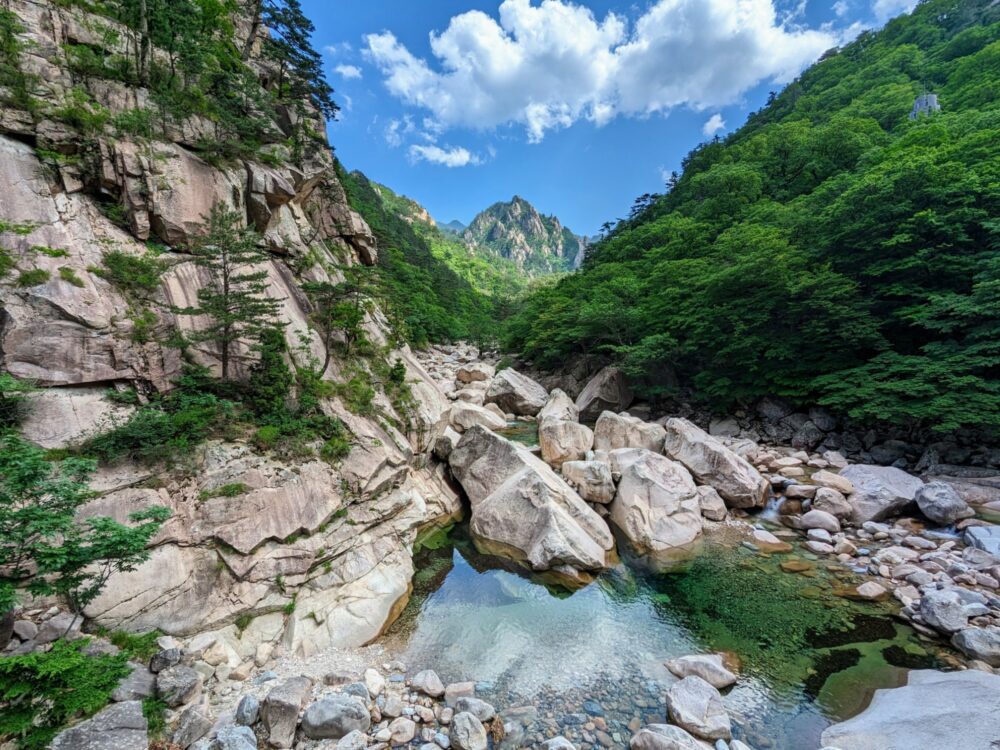
To find myself in such lovely scenery after less than an hour of easy walking made me very happy, and I lingered for a while before finally heading back to the start. It was the perfect trail to end my time in the park, after giving my calves and knees a major workout the rest of the time!
In terms of what you get out of it for what you put into it, I’d probably have to put this trail at the top of my list. Sure, the views from the top of Ulsanbawi Peak are far more dramatic and expansive, but they take a lot more effort to get to as well.
Where to stay for Seoraksan National Park: You’ve got two choices about which area to stay in for Seoraksan National Park: Sokcho, which is the nearest city a half-hour bus ride away, or somewhere along the road that leads into the park. We opted for the latter, staying at a great family-run guesthouse about 3km (five minutes on the bus) from the park entrance. It was the best-rated place in the area and lived up to its reputation: with friendly owners, comfortable rooms, a simple but tasty breakfast, and reasonable prices, we were very happy with our decision. Staying in Sokcho gives a much wider range of accommodation and food options; it just means a half-hour ride to and from the park each day. Next time I’d probably stay there to mix things up, most likely at Urbanstay Sockho Beach . It has clean, modern rooms, and is only a five minute walk from the bus terminal. It’s also very close to the beach, with great views over the water, and plenty of restaurants within easy walking distance.
Day 10: The Food and Shopping Mecca of Myeongdong
With your time in Korea drawing towards a close, it’s time to head back to Seoul. Check out of your accommodation after breakfast and head back to the bus station in Sokcho to retrace your steps from a couple of days ago. Again, if you’re travelling on a weekday outside peak times, you can probably just buy a ticket on the next service when you get to the station. At other times, book it in advance .
Note that I’m assuming your flight out of Korea is from Incheon or Gimpo airports in Seoul: if it’s one of the few that leave from Busan instead, there are a couple of direct buses per day that run there from Sokcho instead.
This time around, I’d suggest staying in Myeongdong. It’s one of the most popular restaurant and shopping areas in the city, has a huge street food market that springs into life each evening, and is convenient for getting to the airport the next day. What’s not to like?
This is definitely one part of town that’s set up for aimless wandering. Myeongdong’s main walking street has so much going on that I was very glad I didn’t have to keep an eye out for cars: there were far too many other interesting things to look at! Restaurants, bars, tiny boutiques and huge department stores, it’s a busy, bustling, neon-lit temple to the gods of retail.
If you’re looking for a temple of a different kind, the oldest Catholic cathedral in South Korea is also in Myeongdong, on top of a small hill a short but steep walk from the eastern end of the walking street. Be sure to visit the crypt and museum while you’re there; both are small but interesting.
If you’re on the hunt for Korean skincare products , you’ve come to the right place. Dozens of stores in Myeongdong specialise in them, including flagship outlets of major brands like Olive Young and Laneige. If you need a second suitcase just to carry all your new products home with you, never fear: there are plenty of luggage stores nearby as well!
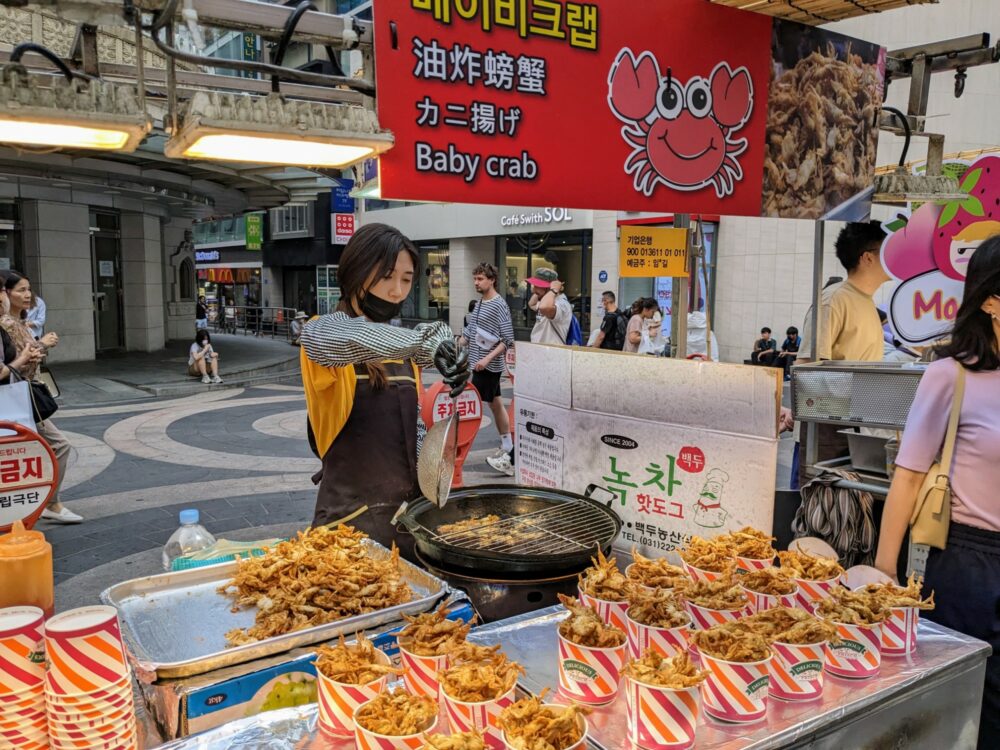
Street vendors start setting up the night food market along the walking street and surrounding roads from mid-afternoon: there are usually around 200 vendors on any given day, most dedicated to cooking up all kinds of delicious street food, but with many selling souvenirs and other random bits and pieces as well. The souvenirs weren’t anything you can’t find elsewhere in the city, but the street food stalls were a delight.
Definitely start out with an empty stomach, so you can try as many of the different options as possible. I particularly enjoyed the deep-fried crab and a few of the different beef and chicken skewers, but just wander around and see what grabs you (or what has the longest line). We spent well over an hour just strolling past the different vendors, choosing random things as we went. Most of the dishes are snack-sized rather than being a full meal, so they’re ideal for grazing.
Now that you’re full of delicious street food, it’s time for a short walk to work some of it off. As you’ve been exploring Seoul, you’ve probably noticed a large hill that’s visible from Myeongdong and much of the busy downtown area, complete with a prominent broadcast tower at the top. That’s Namsan Hill and N Seoul Tower , the latter of which sits around 500m (1650ft) above sea level and has commanding sunset views over the city.
Getting to the top couldn’t be quicker or easier: a cable car zips between the base of the hill near Myeongdong and the tower in about three minutes. Once you get there, the four different levels have a range of restaurants, multimedia displays, and other attractions to check out beyond just the spectacular vista.
You can buy the cable car and tower entry tickets separately, but it’s cheaper and more convenient to just get them as a package instead. The lower cable car station is only a 10 minute walk from Myeongdong metro station.
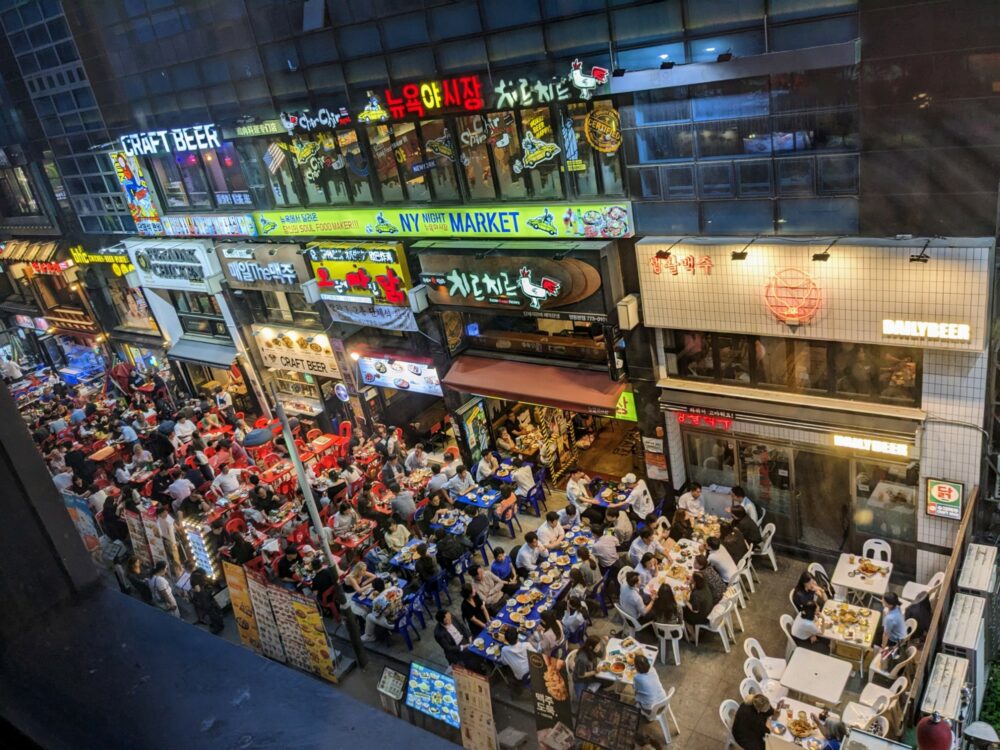
If you’ve worked up an appetite again by the time you get back, or at least a thirst, that chicken and beer street I mentioned earlier is well worth a visit. With so many restaurants crammed alongside each other, competition is fierce and quality is high, so you can’t really go too wrong with any of them. The hardest part will be finding somewhere with a spare table: it’s a popular spot as the night wears on!
Where to stay in Myeongdong: We stayed at a delightful cinema-themed hotel right in the heart of Myeongdong, and only a block or two from the night market. Our room was stylish and spacious, with a great bathtub, and the staff were lovely: we even got a free bag of popcorn when we arrived! There was no problem with storing our bags when we arrived before check-in time, either. The hotel sits alongside a busy strip of chicken and beer restaurants, which is very convenient when you’re hungry!
Sadly it’s arrived: your final day in South Korea! If you’ve got an early flight, then all you have left to do is take the metro to the airport. Luckily that’s very easy to do, since Myeongdong is on the airport line. It takes about 75 minutes to get there.
If you’ve got a few hours to spare, though, there are plenty of ways to spend your time beyond just sitting in your hotel room! I’ve included a couple of specific suggestions below that are easily accessible from Myeongdong; if your flight isn’t until sometime after dinner, you could also do any of the longer activities I suggest in the next section instead. The place we stayed at was more than happy to look after our bags all day if needed!
Take in the Tranquility of Cheonggyecheon Stream
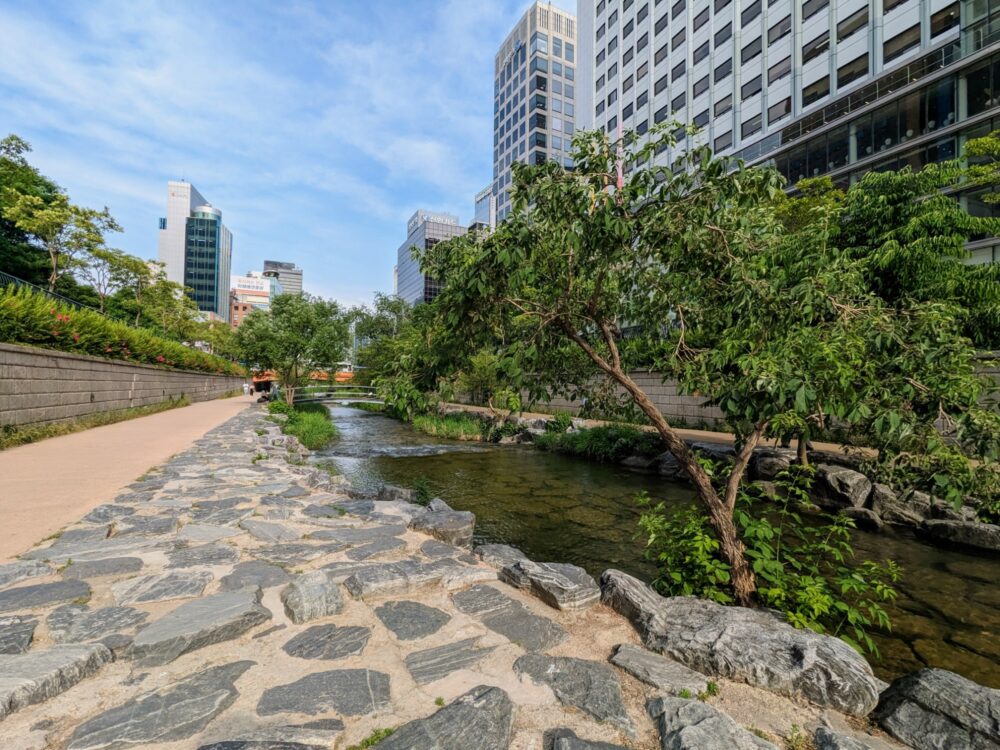
If you want to see an example of urban revitalisation done right, you need to look no further than Cheonggyecheon Stream. The highways that once covered this little waterway were ripped up in 2005, and a once-ugly thoroughfare was turned into a lovely place to stroll and relax.
Sunk below street level, the 8km (5 mile) path is surprisingly peaceful, with plenty of places to sit and relax. We spent a wonderful hour or so walking the first half, from the entrance near Gwanghwamun station in the west to Dongdaemun. The first section is definitely the busiest: after that, the surroundings start to become less manicured, with narrower paths and fewer people.
Just walk as far as you feel like: you can easily get back up to street level at any point if you only have a short amount of time, and then take the metro or a taxi back to collect your bags.
Relax in Seoul Forest
If even the tranquil surrounds of an urban stream aren’t relaxing enough for you, how does a vast park in the middle of the city sound? Seoul Forest is actually where the Cheonggyecheon Stream path ends, but if that’s where you’re headed, it’s easier to take the metro instead: line 4 goes directly there.
Across the five separate parks you’ll find everything from botanic gardens to playgrounds, restaurants, and even a stage where concerts are held during summer, but with close to half a million trees spread over 300 acres, there’s plenty of nature (and space) for everyone.
If you’re more interested in wildlife and woodland, the “Eco Forest” is the place to go. It’s home to a population of elk and deer in a series of enclosures, along with chipmunks and other smaller animals roaming free.
If you have an extra day or two in South Korea, never fear: I have a few more suggestions for how to spend them! As well as the three Seoul-based options I talk about below, you could easily add another day in Gyeongju so you can explore it at a more leisurely place, or work in a full day in Sokcho to chill out on the beach and explore the city. They’re all good options!
Optional: Day trip to the DMZ
Many first-time visitors to South Korea want to visit the DMZ, the infamous 4km (2.5 mile)-wide no-man’s-land that forms the border between South and North Korea. The two countries are still technically at war despite the 70-year armistice, and access to the area close to the border is heavily restricted. The only way to get there is on an organised tour , and numbers are limited even then.
In the past, I would have included a DMZ tour as an absolute must-do, but for now at least, it’s only optional as far as I’m concerned. Why? Well, mostly because the Joint Security Area (JSA)—the famous blue barracks where North and South Korean soldiers stand face-to-face—is currently out of bounds. Since the pandemic, tours to the JSA have been on and (mostly) off, and as I’m writing this now, there simply isn’t a way to get there.
As a result, the closest you’ll get to North Korea is standing on a hill and looking into the country from afar with binoculars. The upside is that these trips are much cheaper than the JSA tours when they’re running, the downside is that it’s probably not really the DMZ experience that you were envisaging.
Even these non-JSA tours are very popular, mind you, so if you are thinking about going, don’t leave it until the last minute to decide. It’s not uncommon for spots to be sold out a week or more in advance during busy periods.
On these tours, you typically get to visit one of the “infiltration” tunnels dug by North Korea in a failed attempt to set up a surprise attack, along with the DMZ observatory point and freedom bridge. It’s still an interesting and thought-provoking trip; just be aware of what it does and doesn’t contain in 2024!
Optional: Day spent hiking in Bukhansan
While Seoraksan National Park offers wonderful trails and incredible scenery, and is absolutely worth the visit, it does take a bit of time and effort to get there from Seoul. There are no such concerns with Bukhansan National Park, though: you can literally take the metro there from downtown Seoul!
Named after the three-peaked Bukhan mountain that forms the centrepiece of the park, it takes under an hour to get there from pretty much anywhere you’re likely to be in Seoul. There are three entrances, each of which is accessible by public transport, but the easiest is probably the eastern gate. Be sure to visit the (Jeongneung) visitor information centre just inside it when you arrive.
That’s for two reasons: to get trail maps and general information about the walks on offer, and also to find out which paths are currently closed. All of the popular trails (which given the proximity to Seoul, is basically all of them) are closed on a rotating basis to help protect them from overuse. Make sure the trail(s) you plan to walk are open on that particular day!
I’ve included a couple of good trail options below to get you started, but there are many others. The Alltrails app has them all marked out, or as I say, pick up paper maps from the visitor centre before you start. Admission to the park, fortress, and temples are all free.
- Obong Course : this 7.6km loop trail is moderately difficult but worth the effort, winding past Dobongsan mountain with great views on its way to the lovely Songchu falls. It takes 2-3 hours.
- Baegundae Peak : this is a challenging one-way trail that runs east-west across the park and climbs to its highest point, at 835m (2744ft). It gets trickier towards the top, with metal cables set into the rocks to help pull yourself up. Don’t tackle it unprepared, but if you’re capable, expect stunning views from the top. It takes 4-5 hours to complete.
Optional: Visit to Lotte World
For an adventure of a completely different kind, head to the sprawling expanse of Lotte World. This enormous indoor theme park in Sincheon is the largest of its kind in the world, covering four stories and covered by a vast glass dome. There’s also an outdoor section, dubbed Magic Island: a man-made island that sits in middle of Seokchon Lake that contains most of the rides, along with cinemas, restaurants, and more.
It’s hard to even summarise everything on offer here at South Korea’s version of Disneyland: from the amusement park and ice-skating rink to a museum, department store, aquarium, shooting range, roller coaster, huge spinning gyro swing, laser and music shows, VR roller coasters and arcade games, and who knows what else, there’s more than enough to keep adults and kids alike amused for the entire day.
There’s even a monorail that whisks you around the complex, which I think gives some idea of the scale of what’s on offer here. To get there, jump on the metro and head for Jamsil station (exit 4). As is often the case in Korea, it’s cheaper to buy tickets in advance than to show up and buy them on the day.
Summary and Checklist
Given how long this itinerary ended up being, I figured it’d be worth putting together a checklist of all things that you’ll want to do in advance of your trip, just to have them together in one place. I hope it’s useful!
Further Reading
- Tech Guide to South Korea for all the little (and not so little) differences about things like making payments, how taxis and T-Money work, why Google Maps is so bad in South Korea and what to do about it, plus the best ways of staying connected and whether a local phone number is as important as everyone says
- How to Get to Seoraksan National Park for the nitty-gritty about transport to and from the park
- Guide to Seoraksan National Park for trail information, where to eat and drink in the park, cable car details, other things to see and do, and so on
- a physical SIM or eSIM so you’re connected before leaving the airport. Note that the plastic card that contains the physical SIM also works as a T-Money card, so you don’t need to buy a separate one!
- First night near Seoul Station (if necessary)
- Two nights in Gyeongju
- Five nights in Hongdae
- Two nights in Sokcho or Seoraksan
- Last night in Myeongdong
- High-speed train to and from Gyeongju
- Express bus to and from Sokcho
- Discounted entry tickets for the aquarium , N Seoul Tower , and Seoul Sky
- Tour of the Secret Garden at Changdeokgung Palace (no more than six days in advance)
- Optional: DMZ Tour , Lotte World tickets
- Naver Maps – iOS | Android
- Kakao Maps – iOS | Android
- Papago – iOS | Android
- Uber/UT – iOS and Android
- Kakao T – iOS | Android
- XE – iOS | Android
- Airvisual – iOS | Android
And there we have it: my complete guide on how to spend 10 days (or more) in South Korea! I think I’ve covered everything you might need to know, but if you’ve got any questions, feel free to leave them in the comments and I’ll do my best to help. Most of all, enjoy your time in this delightful country!
How useful was this post?
Click on a star to rate it!
I'd love to hear your thoughts!
What did you like and dislike? How could I improve this post?
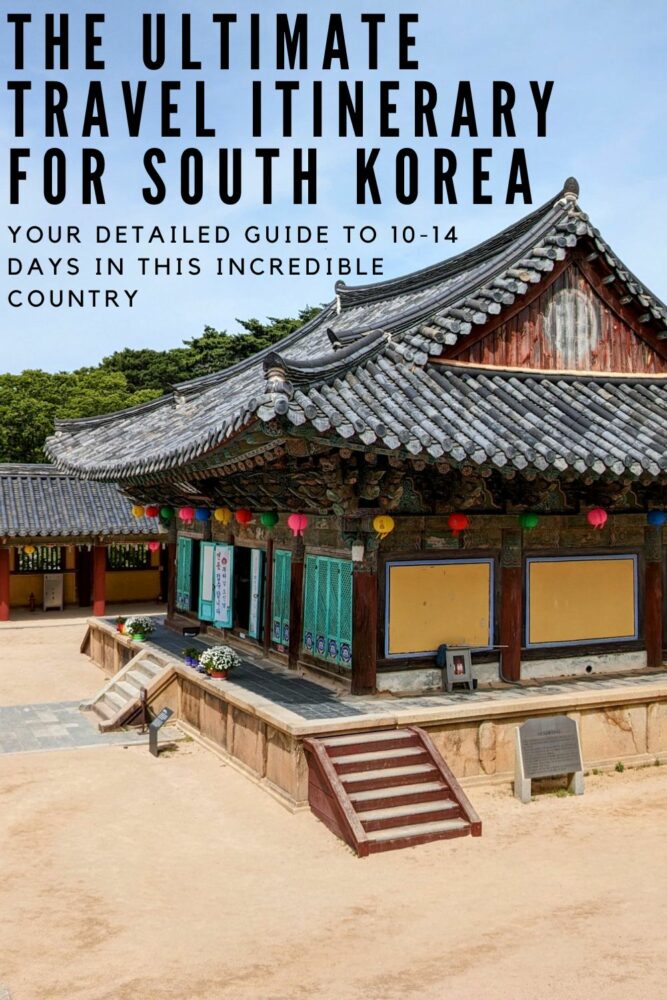
Similar Posts
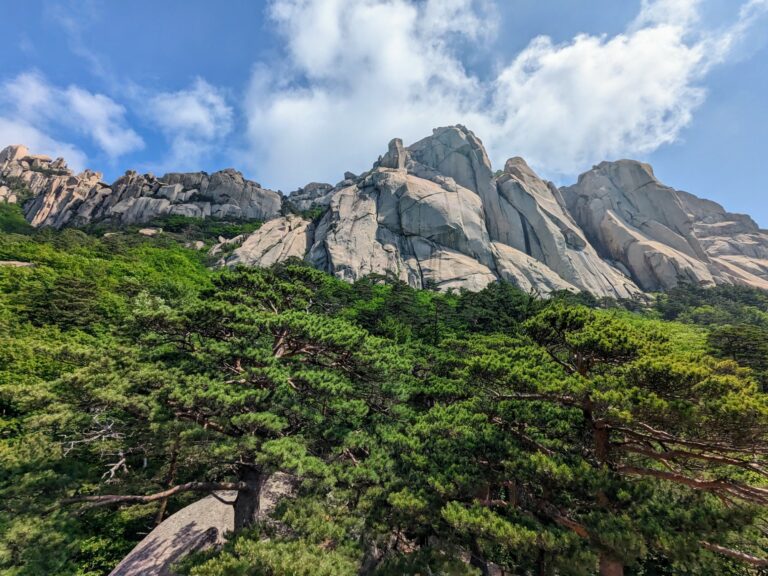
How to Get to Seoraksan National Park: Everything You Need to Know
Heading to South Korea’s Seoraksan National Park? Great decision! Here’s everything you need to know about getting there.
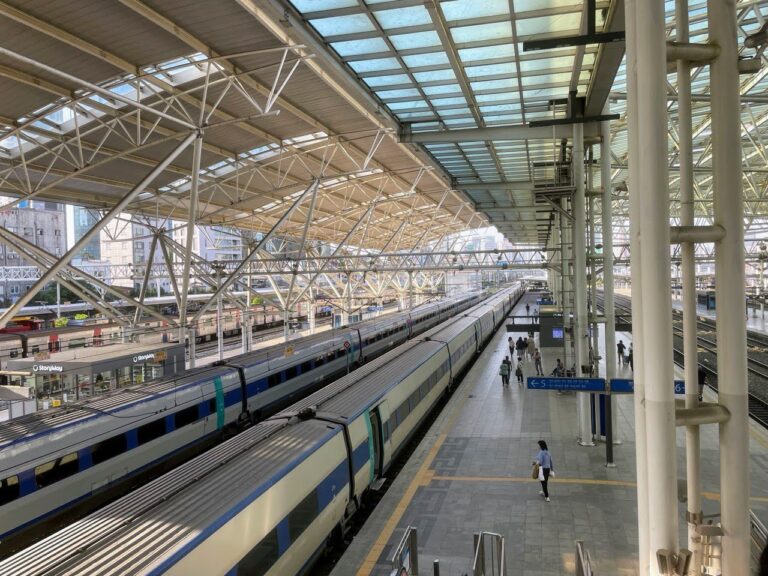
How to Get From Incheon Airport to Seoul
What to know about getting from Incheon Airport into Seoul: trains, buses, taxis, and how to pay for them all.
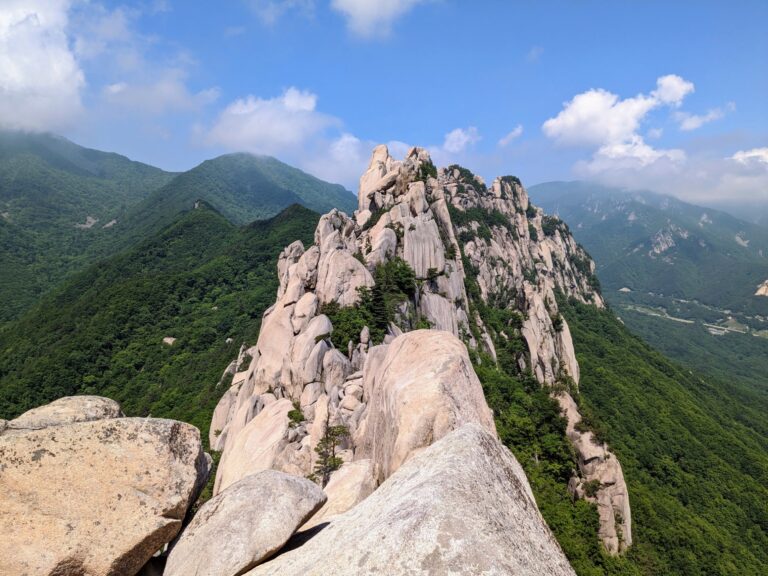
The Ultimate Guide to Visiting Seoraksan National Park
A detailed guide to visiting one of my favourite places in South Korea, Seoraksan National Park.
Leave a Reply Cancel reply
Your email address will not be published. Required fields are marked *
Save my name, email, and website in this browser for the next time I comment.
This site uses Akismet to reduce spam. Learn how your comment data is processed .
- Work with me
- Privacy policy

- Years in review
- United Kingdom
- Bosnia & Herzegovina
- North Macedonia
- Philippines
- South Korea
- South Africa
- Africa Overlanding
- Central America
- New Zealand
- Solo Travel
- Budget travel
- Travel tips
- Travel itineraries
- Hidden gems
- Bucket list
- Travel resources
- Digital nomadism
- Blogging tips
- Start a travel blog
Perfect South Korea Itinerary For 2 Weeks: Best Stops + Tips!
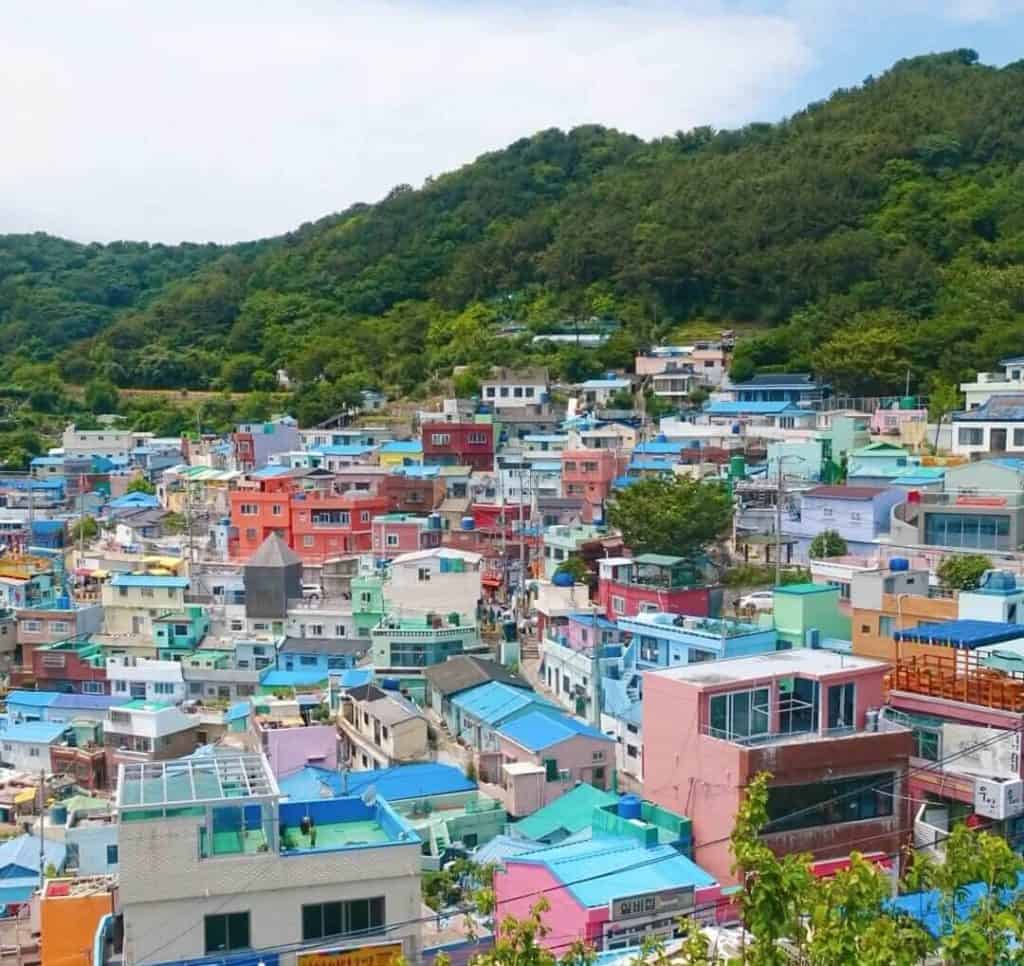
Table of Contents
This post may contain affiliate links to things like tours, hotels, Amazon associates and products. These help me earn a small commission at no additional charge to you.
Hey, stranger! Planning to spend 2 weeks in South Korea? I got you! This South Korea itinerary lets you soak up the culture, see the sights, do some hiking and relax on the beach.
Psst – don’t miss a thing during your trip thanks to my 40 South Korea bucket list items!
I recently followed the below South Korea travel itinerary so you can rest assured it’s tried and tested. I made all the travel mistakes so you don’t have to. What else are blogs for, right?
SOUTH KOREA ESSENTIALS Accommodation: Booking.com / Hostelworld Activities: GetYourGuide Getting there: air ( Skyscanner ) Getting around: Train ( Trip.com ) / bus Pre-book a Tmoney transport card Pre-book private airport to hotel transfer Stay connected: SIM card / portable WI-Fi Travel insurance: True Traveller (European travellers) / Hey Mundo (other nationalities) / Safety Wing (digital nomads)
What kind of South Korea itinerary is this?
The itineraries below are relatively fast-paced . You’ll see 4 places during 2 weeks in South Korea or 7 places during 3 weeks in South Korea. But you’ll still have a good few days in each place to soak up the culture (and devour copious bowls of bibimbap, naturally). If you want to see a new place each day and whiz around fast, this might not be the 2 week South Korea itinerary for you. I’m an advocate of slow travel but I appreciate you want to see a lot during 2 or 3 weeks in South Korea so I’ve aimed for a middle ground.
Check out my other 2 week Asia itineraries to Taiwan , Malaysia , Bali and Vietnam .
How long do you need in South Korea?
I believe 14 days in South Korea is enough to see it properly, providing you pick just a few places of interest. This will allow you to explore two major cities, Jeju Island and another destination of your choosing. Of course, the more time, the better!
Read next: 30 Korea travel tips
Internet & SIM cards in South Korea
There’s good Wi-Fi in South Korea, from hotels to cafes and even in the subway stations. However, when you’re out and about, you may want to stay connected by using a SIM card. I found out the hard way that tourists can only purchase SIM cards at the airport. Shops and market stands rarely sell them to travellers without a Korean residency card. I’d recommend being organised and ordering one in advance. Book your UNLIMITED 4g SIM to collect at Seoul airport or upgrade to include a Tmoney transport card . Alternatively, rent a pocket Wi-Fi device and return it at the airport when you leave. If you’re taking a big trip, it might be worth buying your own mobile Wi-Fi hotspot to bring with you.
Read next: 101 Asia backpacking tips
How to get around South Korea
The train and bus are both quick and efficient which saves valuable time during a South Korea itinerary. Trains can be booked on Trip.com , partner of Korail (the official railway network of Korea). Click the three stripes in the top right corner then the flag to change it to English. Buses are notoriously hard to book online for foreigners so it’s recommended to just turn up. I did this and always got a seat.
It’s also possible to fly between Korean cities although I chose not to for environmental reasons. However, you’ll need to fly when visiting Jeju Island. I use Skyscanner to find the best deals on flights.
Read next: all my South Korea travel tips
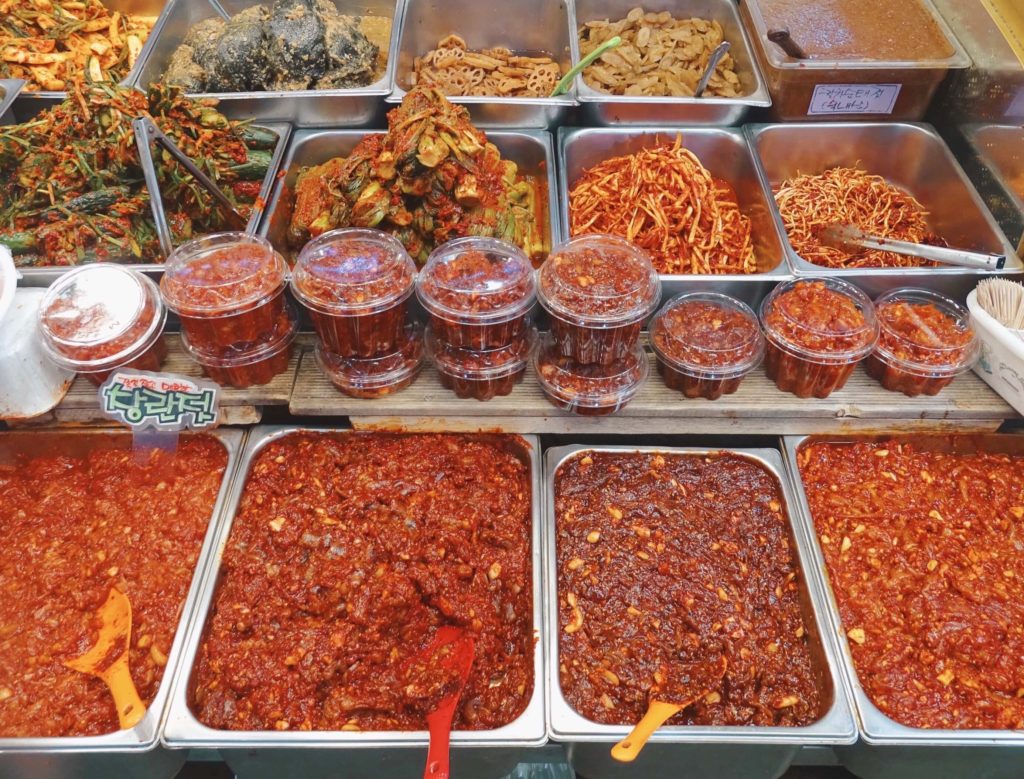
Getting from Seoul airports to the city
Getting from Incheon International Airport to Seoul: the international airport where you’ll probably be arriving is connected to Seoul Station by the AREX Express train (from T1 and T2 direct to Seoul Station), the All Stop Train (from T2, making 13 subway stops to Seoul Station). Finally, the Incheon Airport Bus costs 15,000 won and taxis start from 3,800 won. Getting from Gimpo Airport (domestic flights) to Seoul: a taxi on the metre should cost 15,000 won; the AREX All Stop train takes 20 minutes and costs 1,450 won, and the 6021 bus costs 7,000 won and takes 45 minutes.
From either airport, you can pre-book private airport to hotel transfer . The AREX Express train from Incheon Airport is included in the Discover Seoul Pass .
Budget for 2 weeks in South Korea
Korea is much more expensive than countries like Vietnam and Thailand but still cheaper than most Western countries. It’s a similar price to Japan. Here’s a quick summary of how much you can expect to spend during two weeks in South Korea:
Transport: A couple of my shorter journeys (i.e. Busan to Gyeongju and Daegu to Jeonju) cost just 5,000 KWR ($4 /£3.30) but the fast train between Jeonju and Seoul was more expensive at 30,000 KRW ($25 / £20). I could have saved money and caught a lengthy bus but for the most part, trains and buses are similar prices. Make sure to budget for flights to Jeju and back. They start at around 30,000 KRW each way. I use Skyscanner for flight booking. Accommodation: Beds in hostel dorms start at 22,000 KRW ($19 / £15) and private rooms cost around 32,000 KRW ($30 / £22). Hotels start at 45,000 KRW per night ($40 / £30). I suggest Hostelworld for finding hostels and Booking.com for hotels, homestays and apartments.
Read next: complete budget guide to South Korea
Street food: The good news is that you can eat during your South Korea trip for as little as 2,000 KRW ($1.50). It won’t be nutritious but it WILL be tasty. It’s worth noting most of the best street food markets are in Seoul and Busan; markets in smaller cities are more like wet markets selling fresh produce (which you can buy to make a healthy dinner if your accommodation has a kitchen). Restaurants: You’ll find meals from 5,000 KRW in modest restaurants. Bibimbap can be cheap as chips (and nicer). For more upmarket restaurants (and those in cool areas of Seoul), expect to pay up to 20,000 KRW a meal.
In total, 2 weeks in South Korea cost me 1,000,000 KRW ($830 / £620). This is a hostel & street food budget!
2 week South Korea itinerary overview
Days 1-5: Seoul . Explore Bukchon Hanok Village, Bukhansan National Park, Ihwa Mural Village, Gwangjang Market (amongst others), Insa-dong, Myeongdong, the DMZ, museums, Hongdae and Gangnam. Days 6-7: Sokcho for hiking in Seoraksan National Park (option for nature lovers and hikers) OR Jeonju (option for culture vultures and foodies). Days 8-10: Busan. Visit the Temple by the Sea (Haedong Yonggung), Haeundae Beach, Gamcheon Culture Village, Nampo district, Seomyeon district and hike Igidae Coastal Walk or Taejongdae Park. Days 11-14: Jeju Island. Discover the East, West and South coasts during different days. Got an extra week? Keep reading for my 3 week South Korea itinerary.
Days 1-5: Seoul
I’m assuming you’re starting your 2 weeks in South Korea in Seoul. If you’re beginning in Busan like I did, just reverse this route.
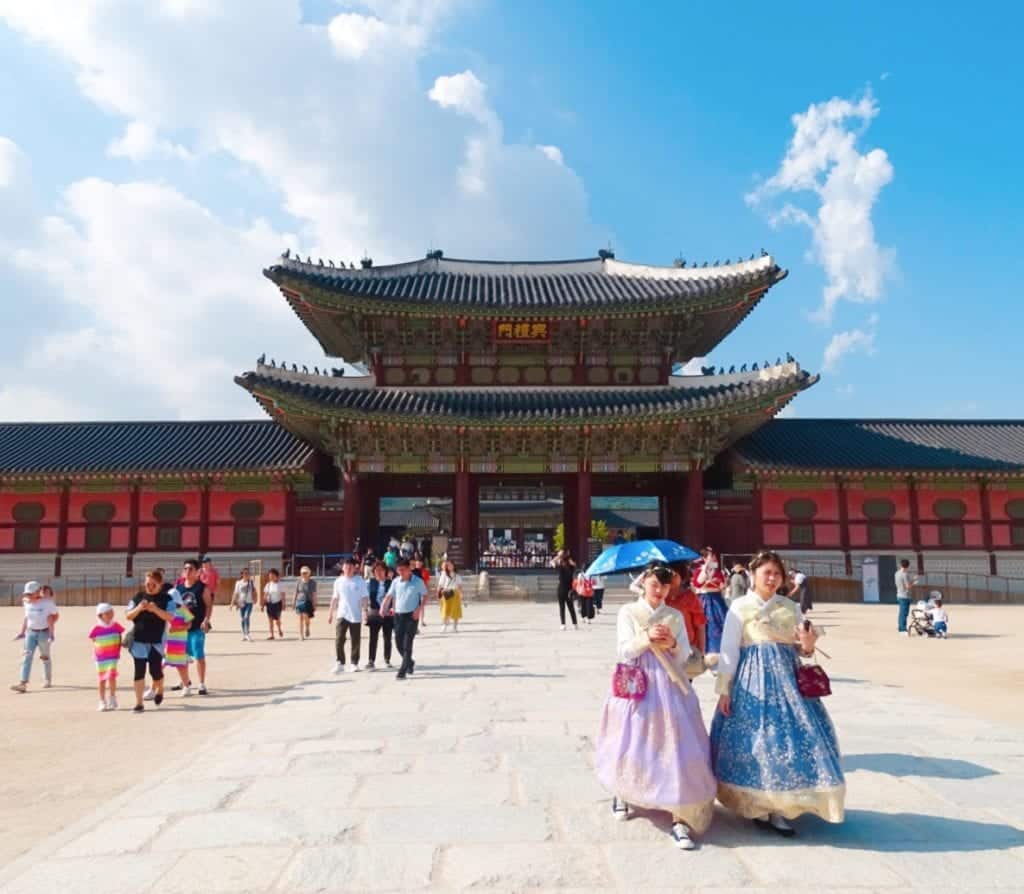
Seoul, South Korea travel tips:
- Collect your 4g SIM card or pocket Wi-Fi device at the airport
- Get a Tmoney transport card to save money and skip queues. Buy yours now or get it with a SIM card combo .
- Download an app like Navar since Google Maps doesn’t work properly
- Prebook your airport pick-up
Where to start with Seoul? After 2 years travelling around Asia , I felt at home in Seoul. Within days I’d decided it was my joint-favourite Asian city (tied with Hanoi ). It has everything: traditional palaces, informative museums, nature hikes, street art villages, quirky cafes, street food, fine dining, boutique shopping, crazy nightlife… The list goes on and on!
Read next: The ultimate 5 day Seoul itinerary
Is the Discover Seoul Pass worth it? From $37, you’ll get free entry to over 50 attractions and discounted entry to over 100 attractions AND a transport pass. I would say it’s worth it should you plan your time tactically and visit as many of the included attractions in the validity period. Research what’s included in the Discover Seoul Pass .
How to get around Seoul
For a huge city, Seoul is easy to navigate. The expansive Seoul subway has 20 lines with a map displayed in each station, but you can also download a Seoul subway mobile app (there are several to choose from). I also enjoyed travelling by bus because it’s nice to be above ground and see the city as you go. Although navigating a bus network in a city where you don’t speak the language may seem overwhelming, it’s not so bad: the journeys even show on Google Maps. You just need to pop your money in the box by the driver (so make sure you have the right change). The buses are priced according to colour so use this guide to bus travel in Seoul to work out what you need to pay.
Make sure to get a Tmoney transport card or a Discover Seoul Pass which acts like a travel card when valid!
Fun transport: the Yellow Bus Tour Seoul and the Seoul City Tour Bus are sightseeing buses for tourists, both included in the Discover Seoul Pass .
Day 1 – Bukchon Hanok Village OR Bukhansan National Park
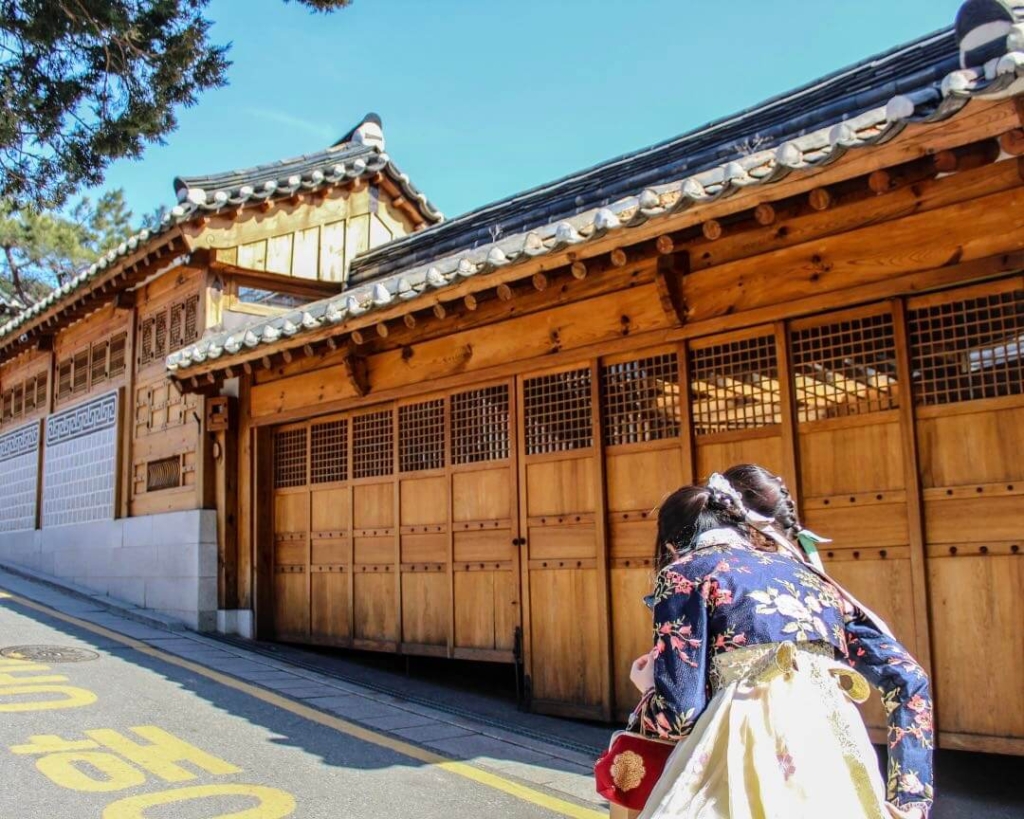
OPTION 1 – tour traditional architecture at Bukchon Hanok Village, preserved to reflect the architectural styles of the Joseon period (14th century-1897). Bukchon comprises a few hundred houses built, as all traditional hanoks were, facing north with water in front and a mountain behind. Bukchon retains all the charm of an ancient hanok village while offering visitors the chance to get immersed at cultural centres, cafes and tea houses. You can even stay overnight as many hanoks are now guesthouses. Take a 3-hour self-guided walk around Bukchon . Note that most attractions are closed Sundays . Getting to Bukchon Hanok Village: Take the subway to Anguk Station (Line 3), take Exit 3 and follow signs. Afternoon: After your morning culture dose, why not try walking Seoul City Walls? Hike along sections of this 18km wall constructed during the Joseon Dynasty overlooking spectacular city views. Better yet, it’s free! Naksan Mountain Trail is the easier trail (2km) and Baegak Mountain Trail is slightly longer (4.7km). The other great thing about Naksan Park is the wonderful sunset views from the top. DAY 1 , OPTION 2 – If you’re feeling energetic, a hike in Bukhansan National Park will certainly be a memorable addition to your trip. My favourite thing about Korea is how easy it is to jump on a city bus and arrive in nature.
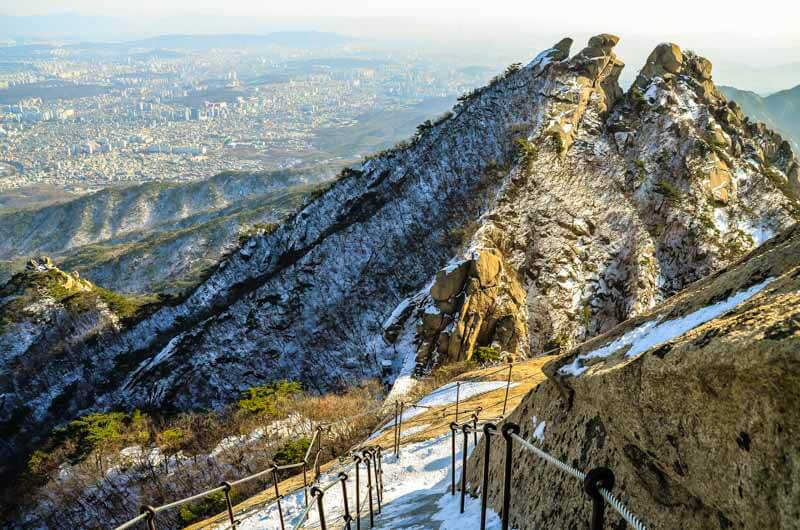
The Bukhansan Peak hike takes 4-5 hours (but you may wish to set aside 5-6 if you like to stop and take photos) but there are also other, more leisurely, trails in the park. If you’re a fan of the great outdoors, I have no doubt this will be a highlight of your South Korea trip itinerary. Getting to Bukhansan: Take subway Line 3 to Daehwa Station and board the 704 bus outside Exit 1. Get off at Bukhansanseong Fortress Entrance. Tips for Bukhansan : Hiking boots are preferable but comfy trainers will do. Make sure you have enough suncream, water and a hat in the summer, and rain gear in cooler months.
Related tour: since Bukhansan Peak can be a challenging climb, you may want to go with an expert guide who will provide you lunch, water and hotel pick-up. Book a day hiking tour .
DAY 1, OPTION 3: More about theme park adrenaline than the great outdoors? Spend the day at Lotte World instead. This theme park with water flumes, aquariums and the famous Lotte Tower observatory is a popular, modern attraction where you could easily spend a whole day, especially if travelling with kids.
Day 2 – Ihwa Mural Village, Gwangjang Market, Insa-dong & Myeongdong
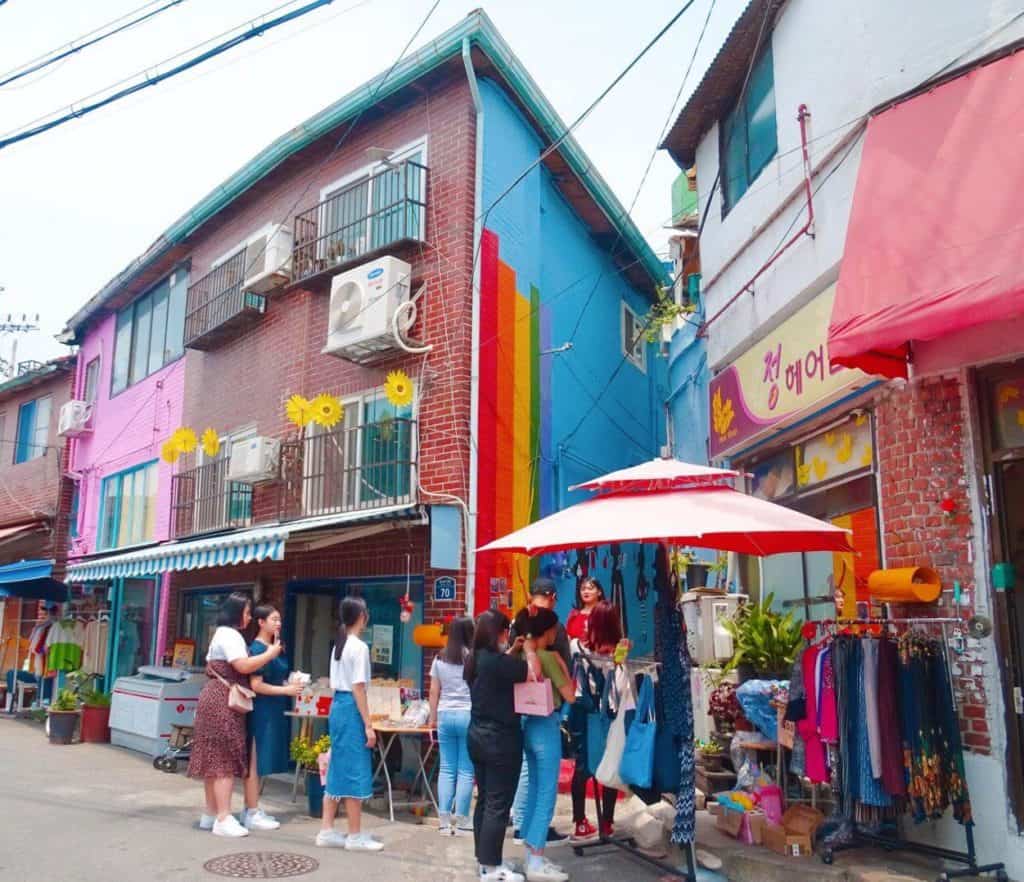
Morning: Fans of street art , or simply cool and colourful places, should pay a visit to Ihwa Mural Village . Like many mural villages in South Korea, this was once a rundown area that didn’t benefit from the flow of tourism to the city. The residents took fate into their own hands and gave their area a lick of paint… Or rather, thousands of licks of paint! Getting to Ihwa Mural Village: The nearest subway station is Hyehwa Station. Take Line 4 there and follow signs to exit 2. Tips for visiting Ihwa Mural Village: Wear comfy shoes and prepare for the steep steps leading to the village. Be respectful when taking photos: these are locals’ homes, not your selfie station!
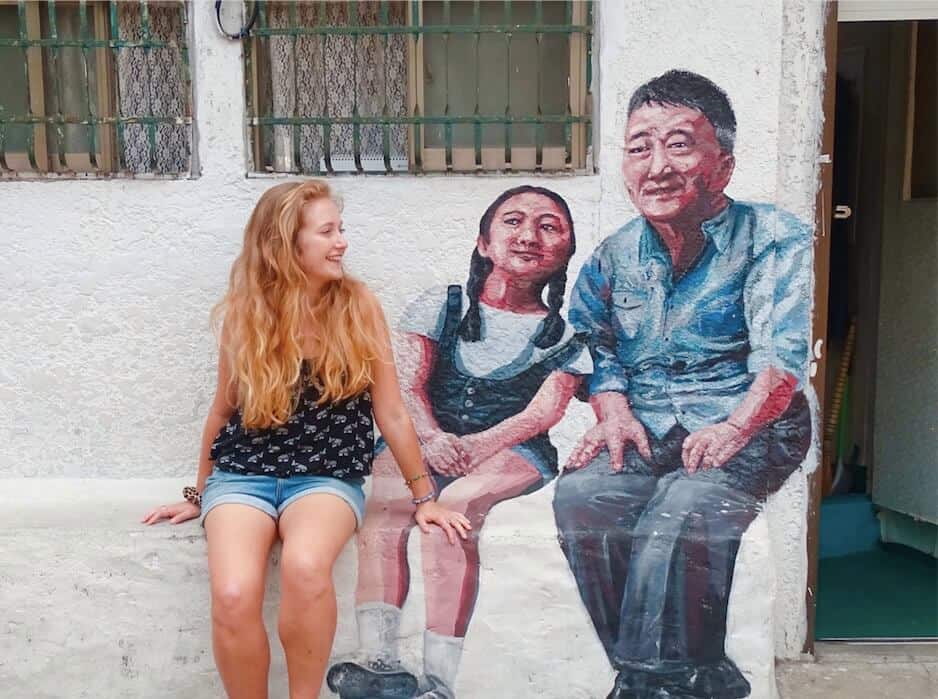
Gwangjang Market : For lunch, eat Seoul street food at this famous market not far from Ihwa Mural Village. Walk in 20 minutes or jump on a bus. Options include fried chicken, dumplings, bindae-tteok (mung bean pancakes) and more. If you’ve watched Netflix’s Street Food documentary, you may recognise chef, Cho Yonsoon, serving her famous knife-cut noodles. Eat them in soup with lashings of kimchi.
Afternoon: Journey to Seoul’s Insa-dong neighbourhood (just a 6-minute ride on subway Line 1 from Gwangjang Market), one of the oldest and most traditional neighbourhoods in Seoul (aside from Bukchon Hanok Village which you’ll have seen on day 1 of this Korea itinerary). Wander the traditional shops to get a feel for Insa-dong and sample flavoured tea and snacks at an authentic tea house. My favourite is Old Shin Tea House set inside a peaceful hanok. The plum tea is delicious.
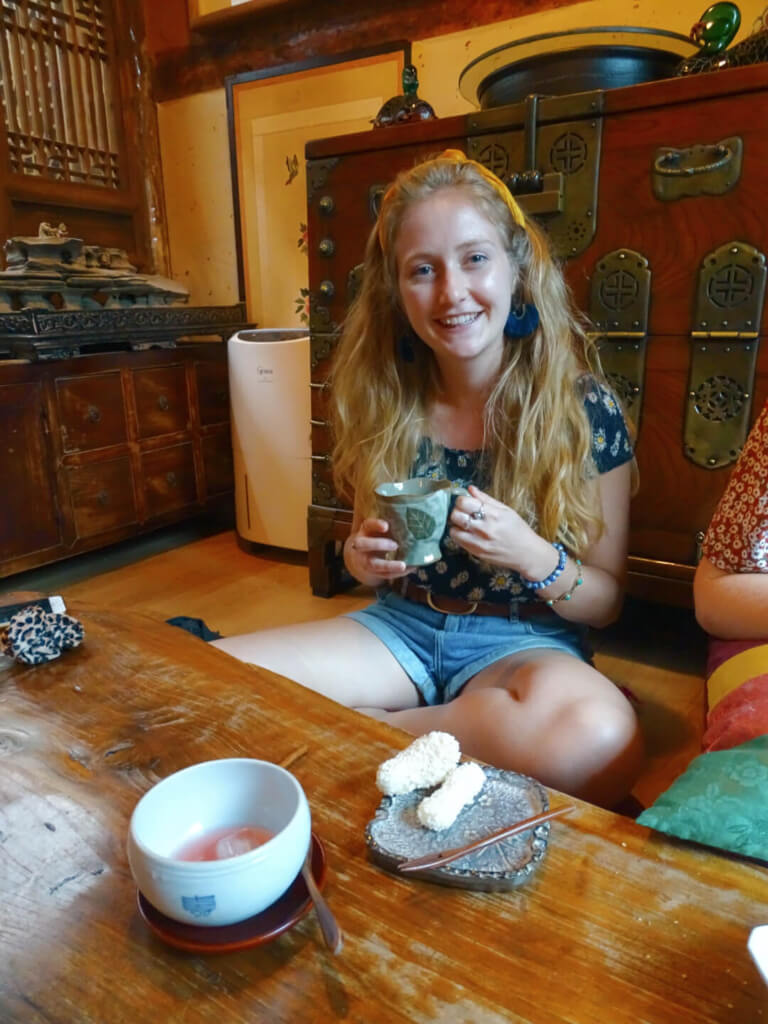
Getting to Insa-dong : Take Line 3 to Anguk Station (Exit 6) or Line 1 to Jonggak Station (Exit 3). Late afternoon: Jump on a 10-minute bus from Insa-dong to Myeongdong for a complete contrast. This bustling neighbourhood is flanked by skyscrapers and home to more beauty stores than you’ll have seen in your life. Head inside for free product samples. Despite being an upmarket area, there’s affordable street food at the open-air Myeongdong market . After gorging your heart out on tteokbokki, tornado potatoes and other Korean treats, you could finish your day by walking through Namsan Mountain Park to the Seoul Tower for sunset. Beware it gets crazy busy at weekends and there are long queues; book a skip-the-line ticket in advance or get free entry with the Discover Seoul Pass .
Day 3 – DMZ day trip
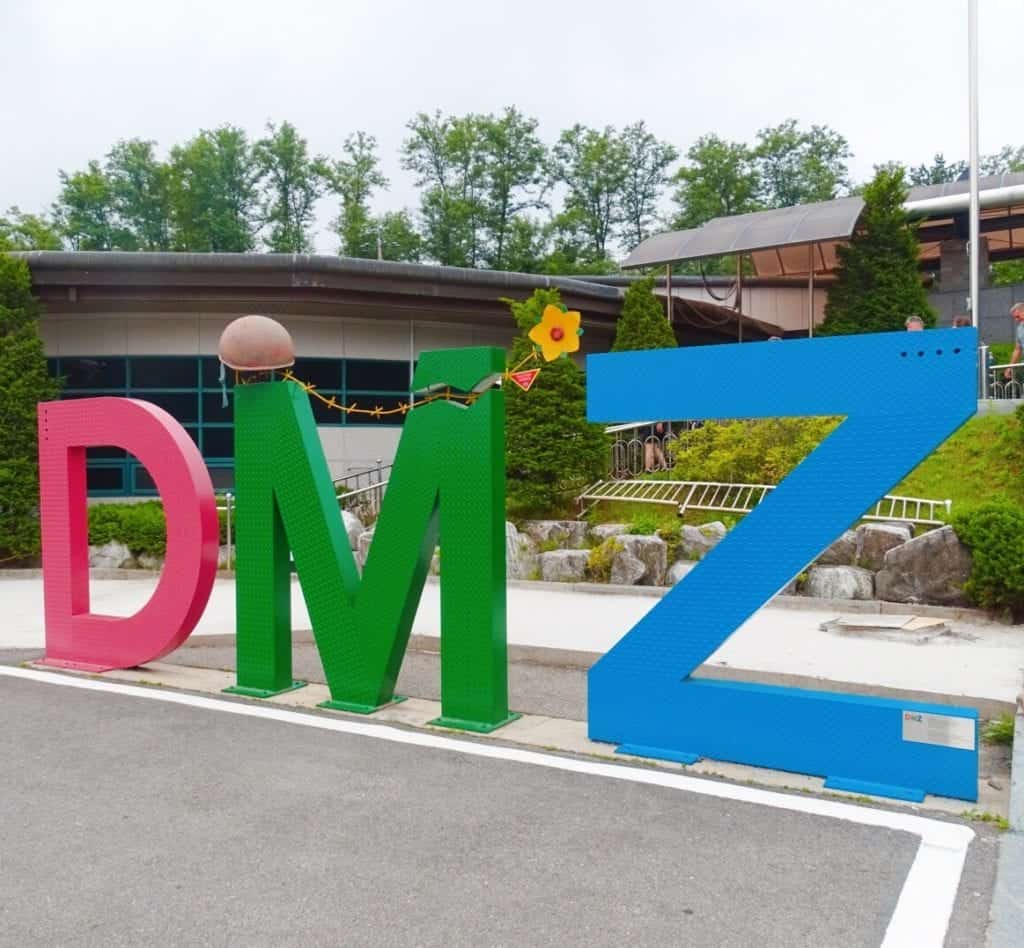
Take a day trip to the DMZ , a must for any South Korea 2 week itinerary. This buffer zone between South Korea and North Korea has a tragic history which you can learn about during a guided tour. Walk inside Third Tunnel, look through binoculars towards the Peace Village (a propaganda village built by NK to give the impression all is well in their country) from Dora Observatory, and visit Dorasan, the final train station before the border that will hopefully one day reunite families separated by the DMZ.
Recommended tour – since you can’t visit the DMZ independently, book a DMZ tour with Viator .
Note – as of 2023, tourists are now allowed to visit the Joint Security Area (JSA) after 2 years of closure. I haven’t noticed any popular tour companies add this back to their itineraries but I’ll keep checking. If you opt for a half-day trip, you’ll get back to the city early afternoon. Head to Hongdae for more weird & wonderful cafes, shopping and street performers. Have a street food dinner here or visit one of the many Korean BBQ restaurants. These go on well into the small hours, as do the many Hongdae bars and clubs.
Read next: Tips for visiting the DMZ from Seoul
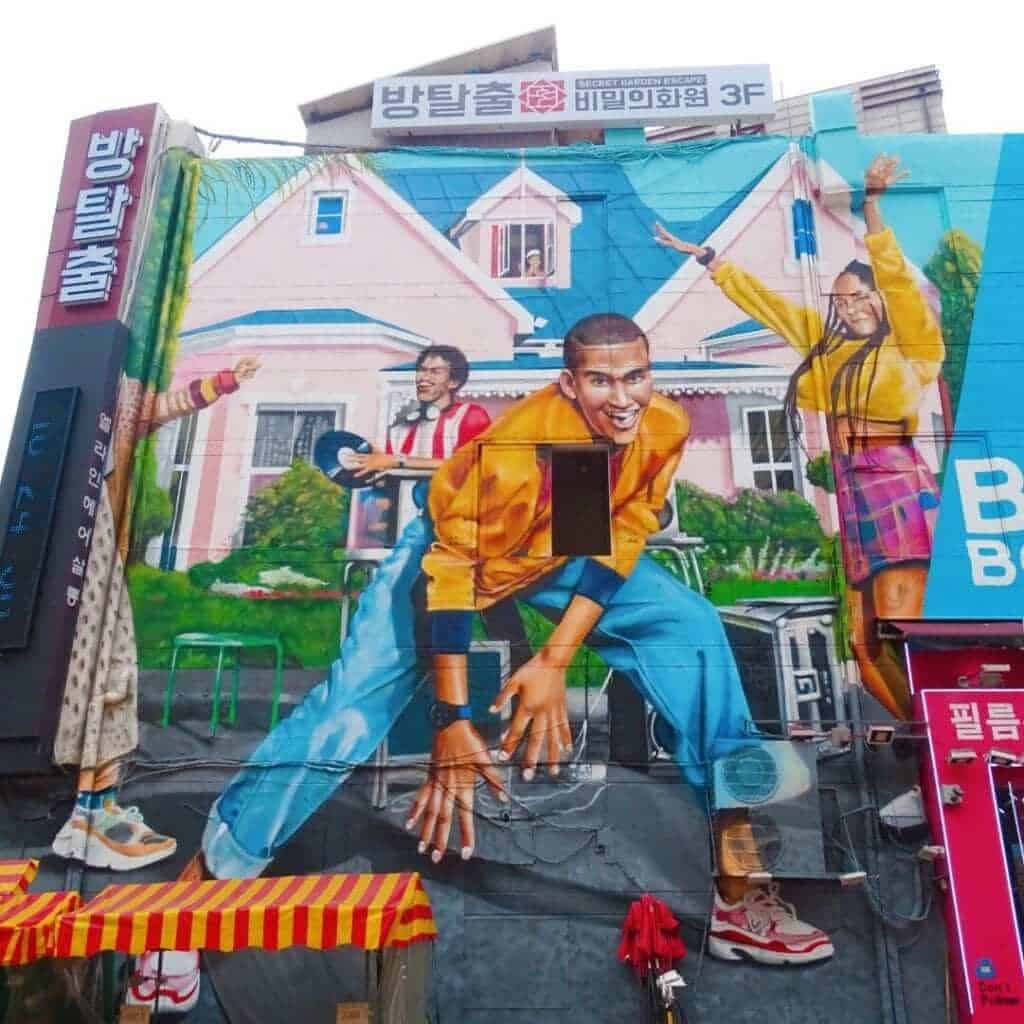
Day 4 – museum & culture day
No South Korea travel guide could miss the rich cultural heritage in Seoul. Visit the palaces, museums and galleries, breaking up the day by visiting Tongin Market for lunch. Here you can exchange tokens for a lunchbox of local food.
Gyeongbokgung Palace
Gyeongbokgung Palace is the oldest and most impressive of the five palaces in Seoul , built under the Joseon Dynasty. If you just have time for one, I’d recommend Gyeongbokgung because it’s the most beautiful, and easily accessible in central Seoul near Heungnyemun Gate. Built in 1395, this detailed and delicate palace could take half a day to explore. But if your time’s limited, make sure to visit at 10am or 2pm (apart from Tuesdays when the palace is closed) to witness the impressive changing of the guard ceremony.
More palaces in Seoul to add to your South Korea itinerary
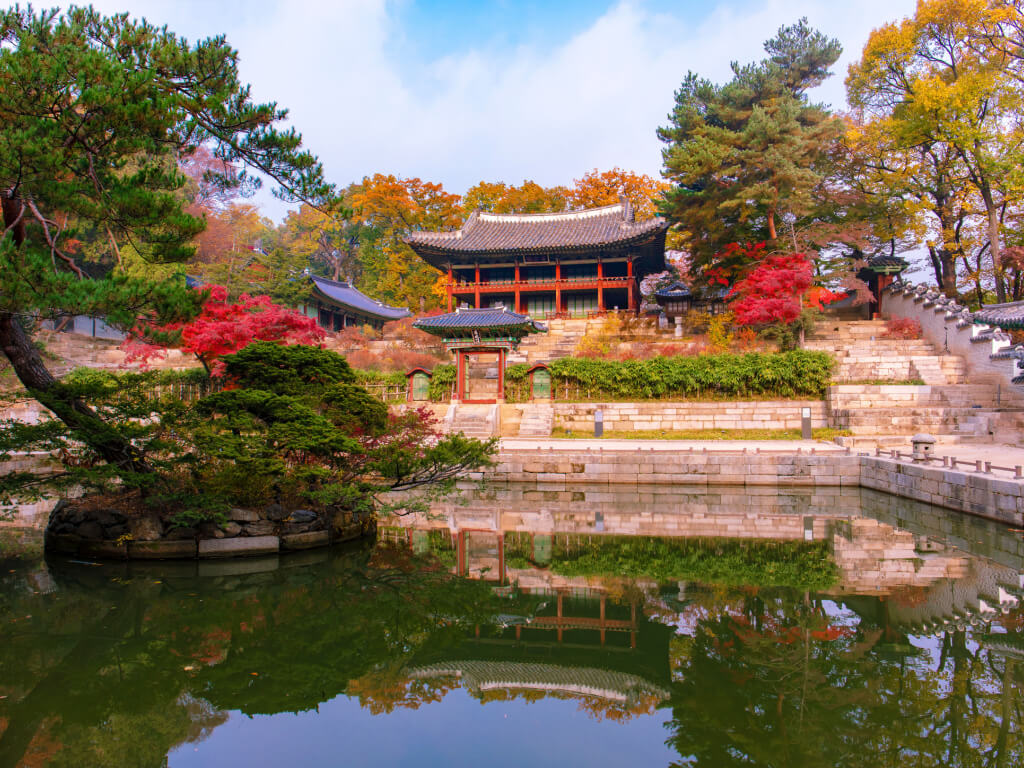
Changdeokgung Palace – surrounded by beautiful gardens measuring 78 acres, this is another serene palace to visit in South Korea’s capital with fewer crowds than Gyeongbokgung. With several pristine gates and temples, it’s little wonder it’s protected by UNESCO. Visit for a guided tour in English at 10.30am or 2.30pm. Closed Mondays. Deoksugung Palace – briefly Seoul’s main palace during an era when the others had burnt down. Find it near City Palace. Changgyeonggung Palace – like the others, this palace is bursting with history, having been destroyed several times during Japanese occupation. Luckily, it’s survived and is a lovely place to explore today. Gyeonghuigung Palace – the youngest and least-visited of the Seoul palaces is a hidden gem with more than 100 halls. It’s beside Heunghwamun Gate so makes for an easy add-on when visiting Gyeongbokgung.
Hanbok rental in Seoul
It’s a popular activity for tourists and locals alike to dress up in hanboks AKA traditional Korean clothing. As a White person, I initially felt uncomfortable at the idea of wearing clothing from another culture, in mind of cultural appropriation. However, Koreans will certainly encourage you to! If you feel comfortable, renting a hanbok will also get you into the Seoul palaces for free!
Seoul museums
- National Folk Museum of Korea – here you can learn about Korean life in the days gone by
- The National Museum of Modern and Contemporary Art – a vibrant contemporary art gallery
- National Museum of Korean Contemporary History – the place to understand recent history including Japanese rule and the split with North Korea.
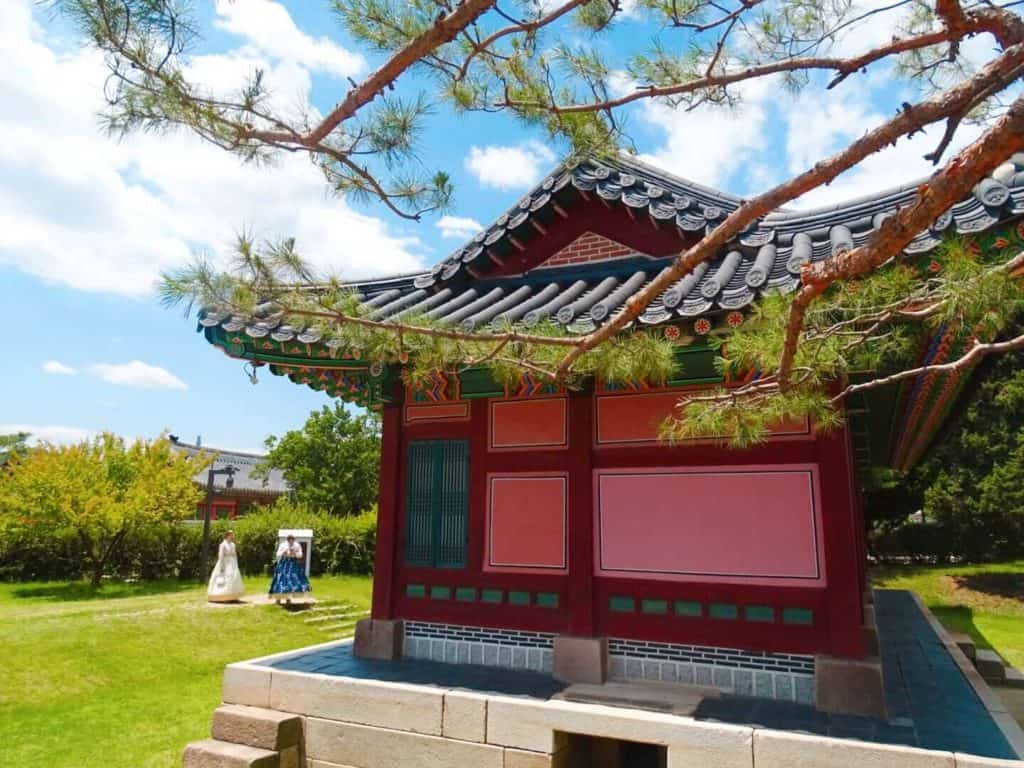

Day 5 – fun neighbourhoods
End this section of your South Korea itinerary by exploring Seoul’s modern side. Morning: Head to Gangnam to visit ‘ grammable Starfield Library and pose with the giant gold hand statue (inspired by a certain catchy pop song that brought Gangnam international fame). Although Gangnam is a modern neighbourhood these days, it has a long history. Visit historical Bongeunsa Temple founded in the year 794 by the highest-ranking monk of the Silla dynasty. Next, grab lunch in stylish Sinsa-dong neighbourhood. There are countless cool cafes packed with fashionable young Koreans. Afternoon: visit Itaewon district for hipster hangouts and the world’s best sandwich at Casablanca , or instead take a leisurely river stroll along Cheonggyecheon Stream. This is a peaceful place in Seoul where you’ll glimpse undisturbed wildlife.
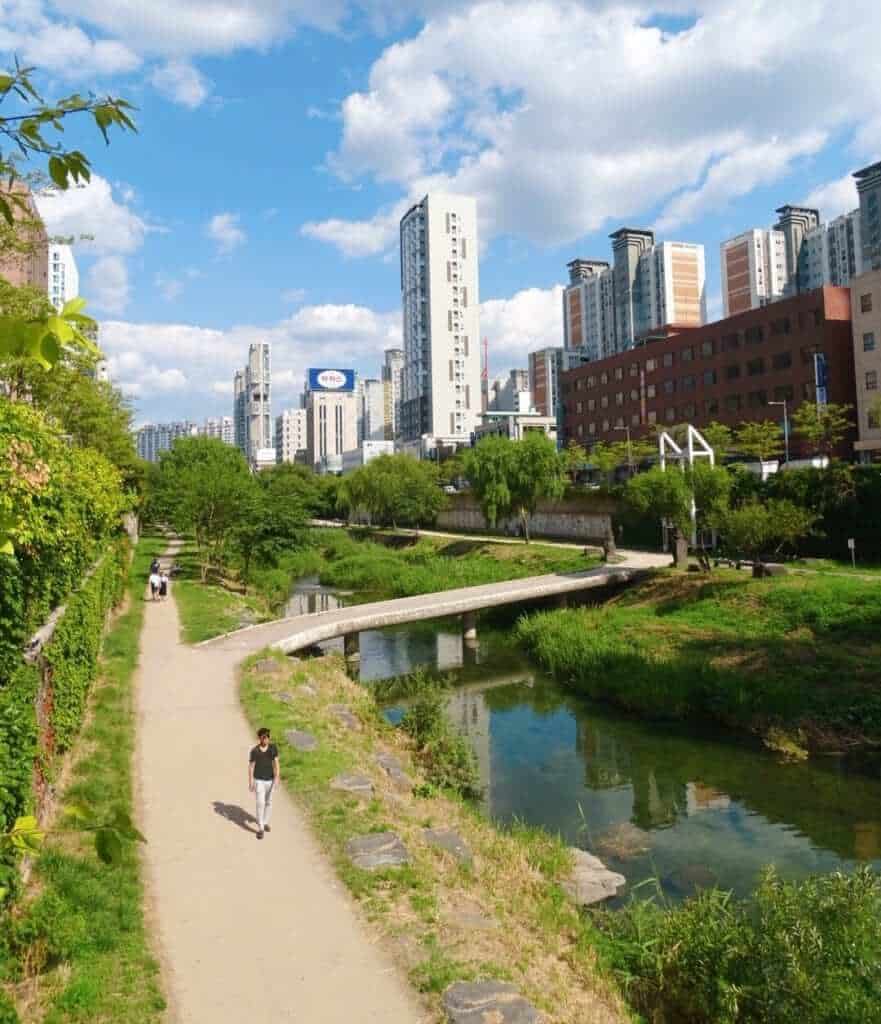
Where to stay in Seoul?
I would highly recommend Hongdae which is full of shops and cafes but isn’t as busy as the heart of the city. It’s easy to get everywhere from the metro station, plus there are many bus connections. Check out:
- Hostel – You can’t do better than Bunk Guesthouse Hongdae , one of the best hostels I’ve stayed at in 10 years of backpacking. The friendly owner remembers everyone’s name, there was complimentary breakfast, and my dorm room had a private lounge with sofas and TV. It was like a home from home. Check availability from US$22 per night .
- Budget hotel – Just 5 minutes from the subway and less than 900 metres to Jongmyo Shrine and Changdeokgung Palace, Hi Guesthouse Insadong is a clean and friendly base with breakfast and excellent shared facilities, including a sun terrace with BBQ, kitchen, laundry, and living area. Check availability from US$40 .
- Mid-range – With an unbeatable location, clean, modern rooms, and the friendliest staff around, it’s no wonder that Daeyoung Hotel Myeongdong is one of Seoul’s top-rated hotels. Check rates from US$60 .
- Splash-out – with gorgeous double rooms, a panoramic skyline view of the city and an indulgent breakfast buffet served in a stylish restaurant area, 9 Brick Hotel is where you can really splash out. Check rates from US$120 .
- Apartment – for the convenience of a private apartment not far from Hongdae, check out the comfortable studios at Dada Stay . Check rates from US$90 .
For more Seoul accommodation, check out Booking.com and Hostelworld .
Where to eat in Seoul
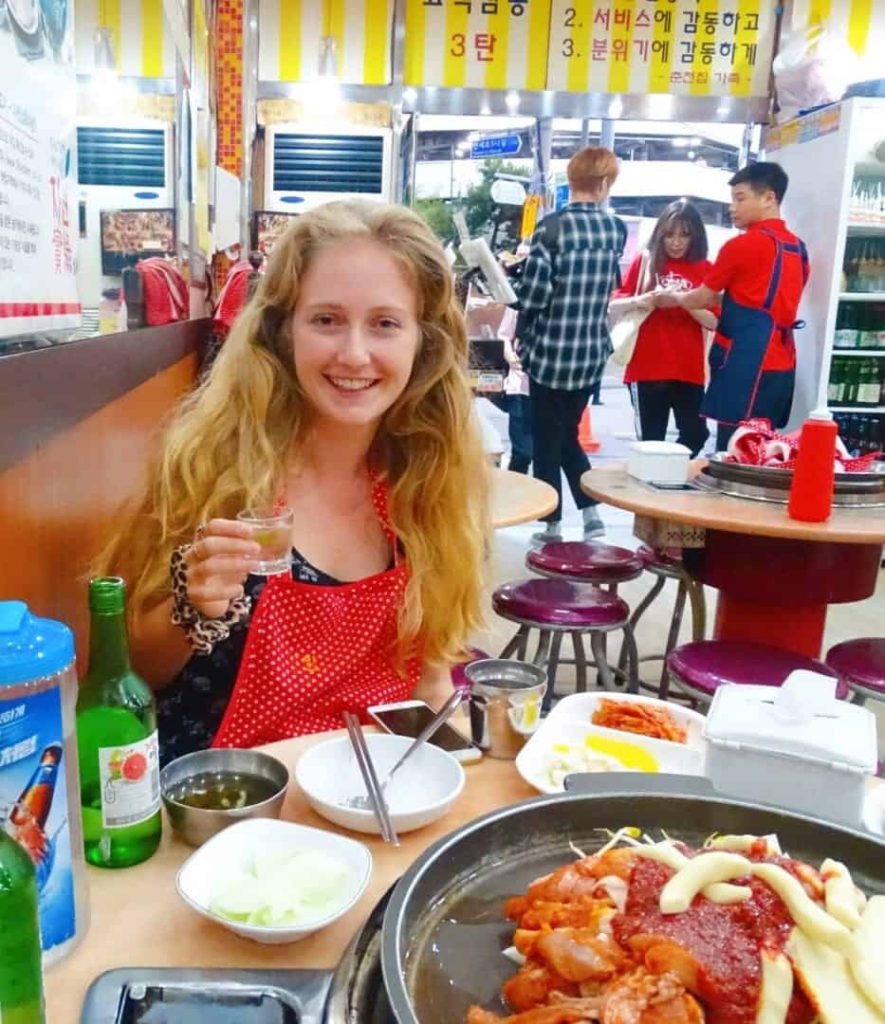
Well, where to even begin! There are so many places to eat in Seoul from fine dining to street food. Since I was travelling alone in South Korea , I’ll focus on the latter by telling you about some best food markets in Seoul… Myeongdong Market – in the heart of the thriving beauty district, this is a great place to nurture your body by shopping for skincare essentials… While also indulging your stomach with typical Seoul street foods sold at open-air stalls!
Namdaemun Market – this is one of the city’s most authentic night markets with a large indoor section with butchers stalls and fresh produce, and many stands outside. This market begins to wind down at 6pm so visit for lunch or an early dinner. Tongin Market – a vibrant daytime market near the main palaces and museums. Buy a ‘lunchbox’ and tokens to exchange for yummy local dishes.
Gwangjang Market – probably my favourite market, packed with every Korean delicacy under the sun! Better yet, it’s home to Cho Yonsoon’s knife-cut noodles that featured on the Netflix Street Food series. Also, a Korean BBQ meal and a dak galbi meal (rice cakes, chicken, cheese and gochujang sauce cooked on a hot plate) is a must for any South Korea itinerary! Annoyingly, they don’t usually serve them for one person but I managed to find a restaurant that would, for a slight surcharge. If you’re on a budget, make sure to eat bibimbap , one of the cheapeast and best Korean dishes !
What to do in Seoul at night?
Well, how long have you got? From crazy clubs to boujee bars and everything in between, this city truly never sleeps. But it’s not all about alcohol: you’ll see friends and couples drinking coffee at 2am and groups crowded around tables at buffet restaurants ’til sunrise.
Then, there are talented buskers who perform free K-pop concerts in the streets of Hongdae. There’s always something fun going on, not limited to the activities below:
- Take a pub crawl – join a guide and group of fellow partygoers visiting 4 bars in lively parts of town.
- Ghost stories walking tour – hear dark tales and learn about legends and true crime during this unique evening walking tour!
- Take an evening boat cruise or dinner cruise down the Han River
- Hike or take the cable car (then ride the elevator) to the top of the Seoul Tower for sunrise or night views
- Catch a NANTA show using traditional Korean music and performance to tell the hilarious tale of chefs throwing a chaotic wedding banquet
- Karaoke! Noraebang is the local name for karaoke, usually located in private booths you can rent out with your friends. As someone with a terrible singing voice, I much preferred this to having a bunch of strangers watch!
Days 6-7: Sokcho & Seoraksan National Park
Just 2 hours from Seoul is a stunning part of South Korea that many tourists miss. The main reason to visit Sokcho city is to hike in Seoraksan National Park , a beautiful area full of stunning cliffs and endless forest. If you love hiking and nature, don’t miss this stop from your 2 week South Korea itinerary .
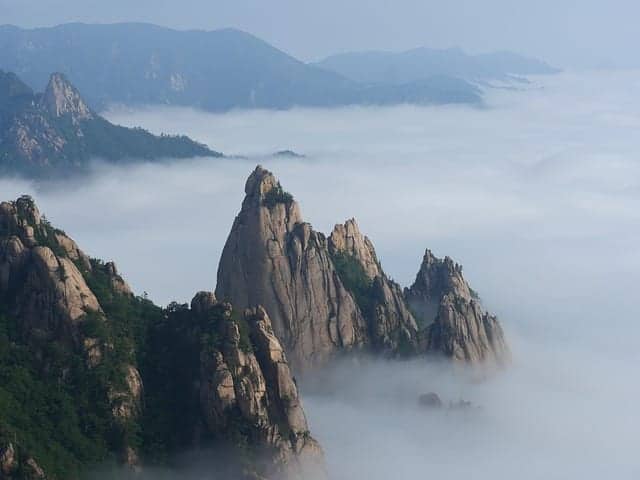
Getting to Sokcho: Buses run from Seoul Express Bus Terminal, taking 2.5 hours to reach Sokcho and costing 18,000 KRW. Day 6: Travel by bus to Sokcho. Check out Sokcho Beach. Day 7: Spend a day hiking in Seoraksan . From your accommodation, catch a bus to the Outer Seorak entrance of the park near the Seoraksan cable car. Just 10-minutes by foot from the entrance is Sinheungsa Temple with a 62-foot gold Buddha statue. Rumour has it this is the oldest Zen Temple in the world, built in the year 653. Better yet, a FREE bowl of noodles is handed out to every guest!
Where to stay in Sokcho
- Hostel – At just 1km from Lighthouse Beach and 400m from Sokcho Culture Centre, Sokcho Hutte is a conveniently located and budget-friendly hostel. Guests can enjoy the onsite bar, common area and delicious breakfast, alongside staying in clean, modern dorms with AC and private rooms with city or mountain views. Check availability from US$24 .
- Budget hotel – Sokcho & Guesthouse is a top-rated accommodation near the beach. Don’t miss the daily American breakfast, and stop by the shared kitchen and lounge. The super-friendly hosts can help book tours and bus tickets. Check availability from US$55 .
- Mid-range – Just 80 metres from Lighthouse Beach, you’ll have fantastic city or ocean views from your room at Heavenmark in Sokcho. Well-equipped modern rooms include air-conditioning, a TV, a balcony, a fridge, a kettle and a washer-dryer. Check availability from US$80 .
- Splash-out – Make the most of the Sokcho scenery from every immaculate sea view room at Lotte Resort Sokcho . Facilities include a water park, arcade, mini golf, infinity pool, gym, restaurants, and rooftop pub. Check availability from US$200 .
Browse more Sokcho accommodation on Booking.com .
Alternative days 6-7: Jeonju
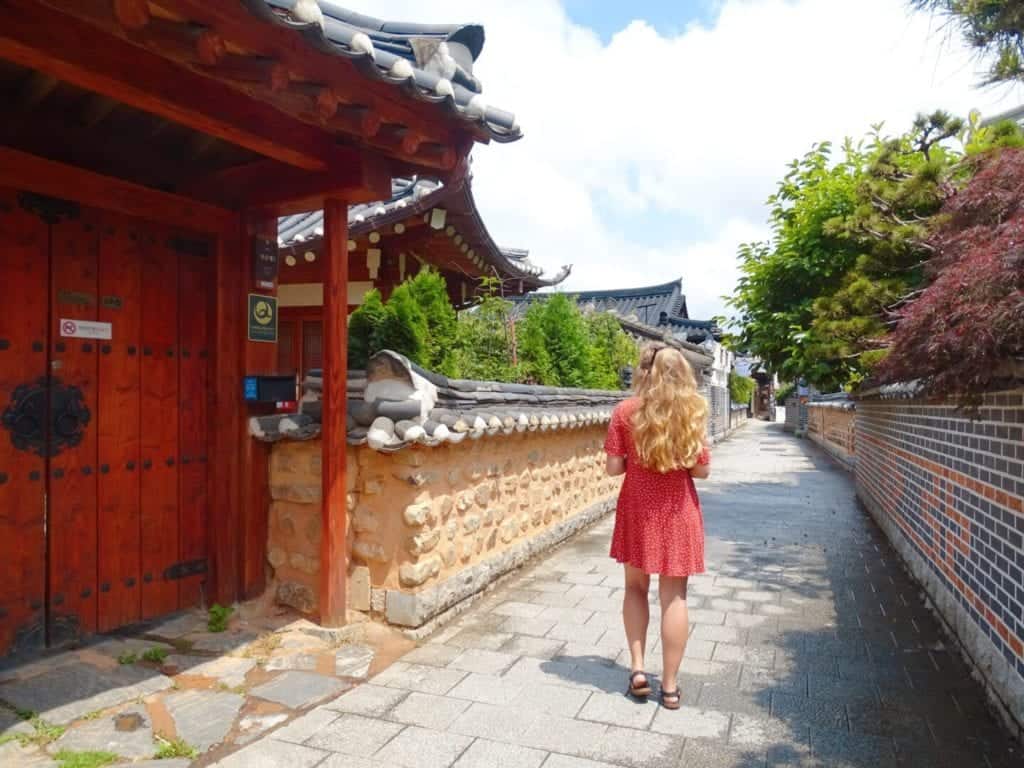
Prefer cities and culture to nature and hiking? Swap Sokcho for Jeonju to ensure this South Korea 2 week itinerary suits you. Getting to Jeonju: From Seoul, catch the train or bus in just under 3 hours. Book your train on Trip.com or simply turn up at the bus terminal if you’re catching a bus. The gorgeous little city of Jeonju is somewhere I’ve written about a lot since my visit. If you didn’t have time to visit Bukchon Hanok Village in Seoul, never fear because Jeonju is arguably even more charming. It’s a fantastic place to stay overnight in a perfectly preserved hanok house. If that doesn’t persuade you, Jeonju is a UNESCO City of Gastronomy and the birthplace of bibimbap. Foodies, drop what you’re doing and get over here!
Read next: Complete Jeonju travel guide
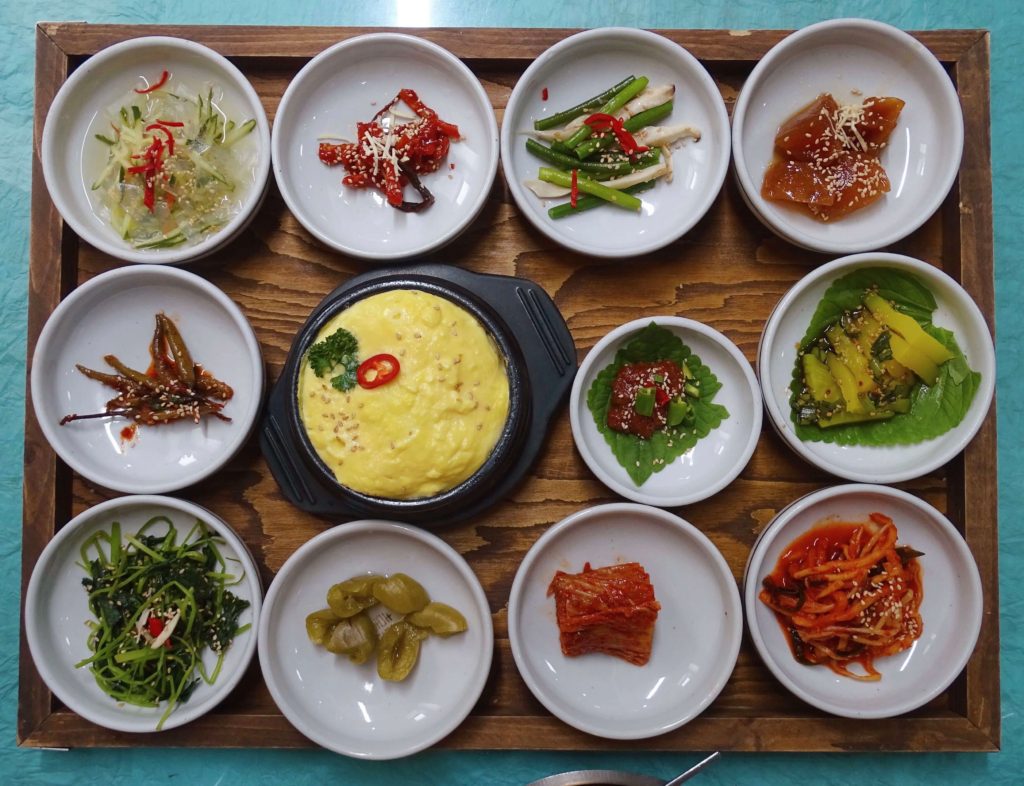
Day 6: Arrive in Jeonju and get your bearings. Head for dinner at Family House for a bibimbap feast (pictured above). Although I initially thought ordering a 20,000 KRW meal was pricey, I was stunned at the sheer amount of food that arrived. This is how Rose died and went to bibimbap heaven! Day 7: Explore Jeonju, visit the Hanok Village, eat at Nambu Market and spot street art Jaman Mural Village (a smaller version of Seoul’s Ihwa Mural Village). Honestly, you could see Jeonju in a day but I enjoyed staying 2 nights in order to relax during my busy 2 weeks in South Korea. If you try Jeonju’s famous makgeolli (Korean rice wine served in a teapot), you may need the extra day to nurse your sore head.
Where to stay in Jeonju
- Hostel – Happinessfull Hanok Guesthouse is a gem. This traditional hanok house is the real deal, with a modest floor bed and a TV showing K-pop and K-dramas. Although the owner could speak little English and I could speak even less Korean, she was so friendly and handed me maps and freshly-brewed tea. Check availability from US$35 .
- Budget hotel – Whoever put together the rooms at Kama Hotel thought of every modern amenity you might need, from a TV with Netflix to hair straighteners. It’s conveniently located near bus routes and includes a simple breakfast. Check availability from US$45 .
- Mid-range – With contemporary facilities, a great breakfast and city views, Hotel Arari is a clean and convenient base for exploring Jeonju. Check availability from US$57 .
- Splash-out – The well-located Best Western Plus Jeonju has an onsite restaurant, gym, outdoor pool, and cocktail lounge, so you’ll be well set to return and relax after a day of exploring the city. Check availability from US$85 .
Browse all Jeonju accommodation on Booking.com and Hostelworld .
Days 8-10: Busan
While some people describe Busan as just another big city, I liked it. No, it’s not as quirky or cool as Seoul but where is? Busan is still an excellent addition to any South Korea 2 week itinerary, as well as a launching point for reaching Jeju Island.
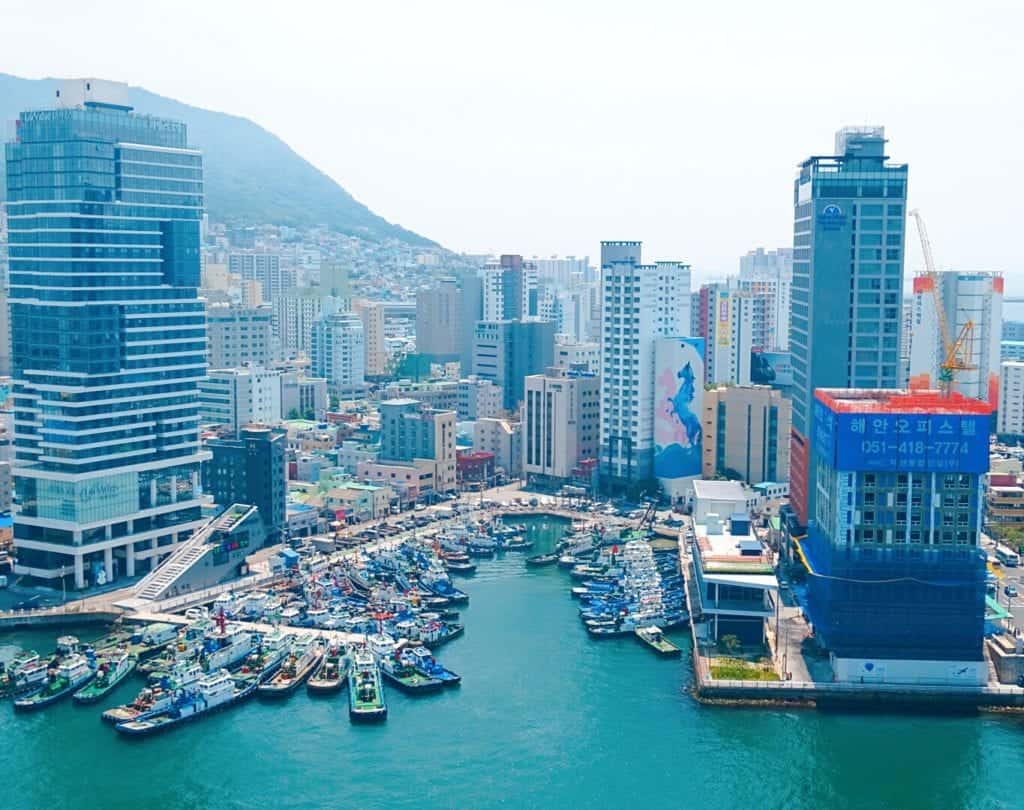
Getting to Busan: From Jeonju, you can catch a bus or train within 3 hours. If you were previously in Sokcho, you can take a 6-hour bus or alternatively a 2-hour bus to Seoul then a fast train to Busan in 2 hours 15 minutes.
Day 8 – arrive and sightsee
Depending on your arrival time, there are plenty of activities for your first day in Busan. One option is visiting the Temple by the Sea (Haedong Yonggung Temple). Alternatively, kick back and relax on famous Haeundae Beach. Chill out even further at Spa Land inside Shinsegae Centum City (shopping centre) in the evening. This is a traditional Korean jjimjilbang with a nude hot pool area. Visit after 8pm for a discounted ticket.
Read next: Busan 3 day itinerary
Day 9 – Gamcheon Culture Village & Nampo
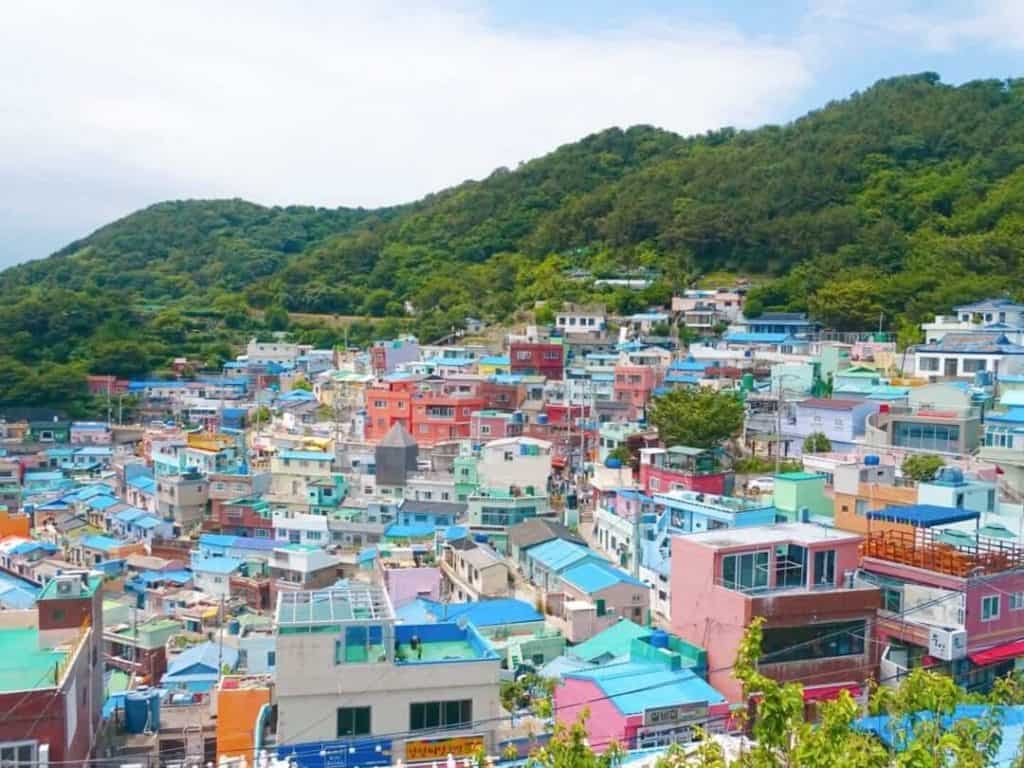
Morning: Visit colourful Gamcheon Culture Village . This once rundown neighbourhood is now a vibrant tourist attraction. As a street art fan, it was one of my favourite stops during 2 weeks in South Korea. As well as murals, there are cafes, cultural centres and arty statues. Afternoon: Head to Nampo district to climb Busan Tower, check out Jagalchi Fish Market, shop at Gukje Market and eat Korean street food in Biff Square.
Read next: The best day trips from Busan
Day 10 – hiking in Busan
Take a morning hike, add either Igidae Coastal Walk or in Taejongdae Park, across the bridge on a small island, to your South Korea itinerary. Relax in the afternoon at Gwangalli Beach then visit Seomyeon neighbourhood in the evening for street food, restaurants and nightlife.
More details about these hikes are listed in my guide to the best Busan day trips .
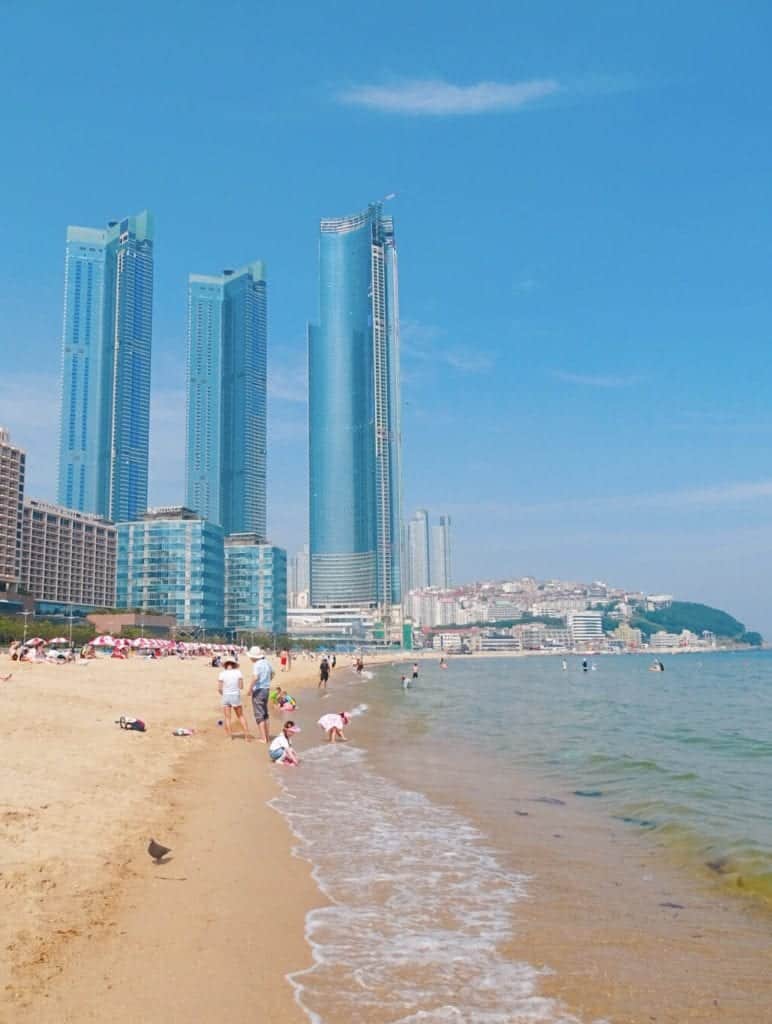
Where to stay in Busan
I would highly recommend Seomyeon neighbourhood because it’s full of cafes, restaurants and bars and it’s also the station where most of the subway lines connect, meaning it’s easy to get everywhere.
- Hostel: Book Blue Backpackers , run by a friendly family. This hostel down a sleepy side street makes it quiet at night, plus there’s complimentary breakfast and a comfy lounge area. Check availability from US$16 .
- Budget hotel: Stay at Seomyeon Brown-dot hotel gold for some of the area’s most affordable yet comfortable rooms, with TVs and en suite bathrooms. Breakfast included. Check availability from US$40 .
- Mid-range: Unwind at Nampo Ocean2heaven Hotel, which has an onsite fitness and spa centre with a sauna and baths. It’s conveniently located with city or sea views from each room. Check availability from US$75 .
- Splash out: For stylish rooms with mountain views and an excellent array of onsite facilities, including a gym, golf centre, spa, and sky bar, you can’t go wrong with a stay at Avani Central Busan . The breakfast spread is superb, too. Check availability from US$140 .
- Apartment: Close to Busan station and the port, Le Collective boasts stylish, spotless suites with city views and easy access to vibrant Chinatown. Check availability from US$100 .
Browse all Busan accommodation on Booking.com and Hostelworld .
Where to eat in Busan
Jagalchi Fish Market – for seafood in Busan, don’t go anywhere else! This is a thriving market where you’ll find fish, crab, oysters and so, SO much more. The way the market works is you pick a fish on the first floor, then head upstairs to eat it in a restaurant.
Gukje Market Street – Gukje is the largest market in Busan, serving every local dish under the sun. One of the famous is bibimdangmyeon AKA glass noodles.
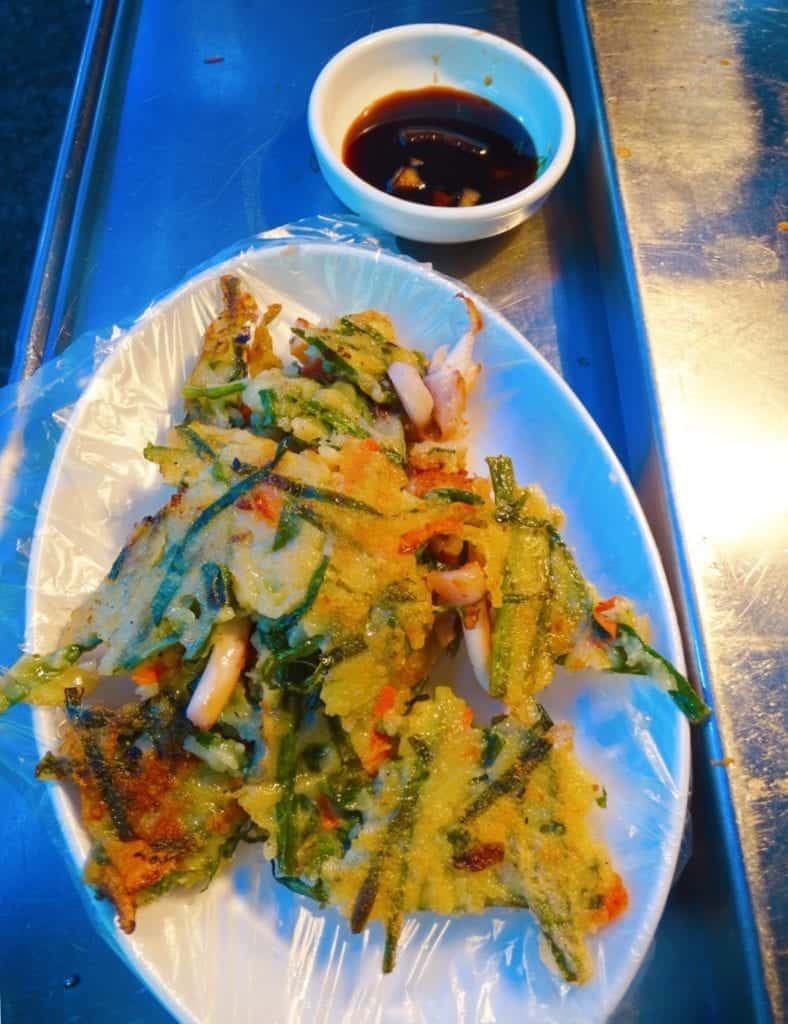
Top foods to try in Busan:
- Milmyeon – noodles in a meat-based broth topped with egg, veggies and gochujang sauce is the typical dish of Busan.
- Eomuk – fish cakes are a popular Busan dish, served in various shapes and flavours, including on sticks.
- Kimbap – yummy rice and veggies in sushi rolls. Unlike Japanese sushi, it usually doesn’t contain fish.
- Buchimgae – moreish seafood pancakes.
Days 11-14: Jeju Island
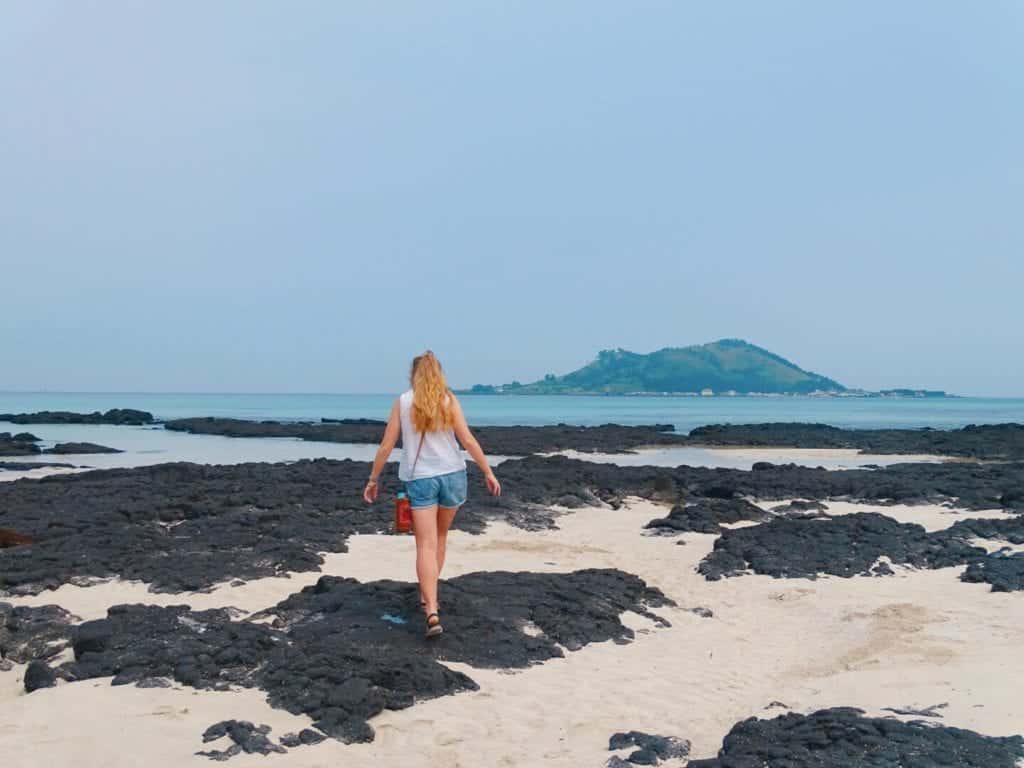
Jeju Island is a must for your 2 week South Korea itinerary. It’s been voted a New 7 Wonder of Nature alongside the Amazon and Cape Town’s Table Mountain. It’s so popular that Seoul to Jeju has officially been declared the world’s most popular flight route! The power of nature is what makes Jeju so special. Formed by ancient lava, you’ll feel it many places like the magnificent Manjanggul tunnels, Jusangjeolli Lava Cliffs and the beautiful ‘sunrise peak’ jutting off the coast, Seongsan Ilchulbong. Getting to Jeju: The best way to get to Jeju Island is by air. Many visitors fly Busan to Jeju but you could also consider flying from Seoul to Jeju and then into Busan. In this case, rejig this itinerary accordingly. You can also fly to Jeju Island from Daegu, Cheongju and Gwangju so check if any of those serve you better. How to get around Jeju Island: Hiring a car gives you the most freedom. Use Rentalcars.com to find a vehicle and pick it up in Jeju City. Otherwise, Viator offer a range of affordable day tours. While you can catch public buses on Jeju, these are infrequent so expect to see fewer attractions. Recommended tours:
- East Coast tour (Manjang Cave and haenyeo female divers)
- West Coast tour (Cheonjeyeon waterfalls, Hyupjae beach and tea plantations)
- South Coast tour (the Mysterious Road, Jusangjeolli Hexagon Lava Cliff and Mt Halla hiking)
Read next: A guide to visiting Jeju Island without a car
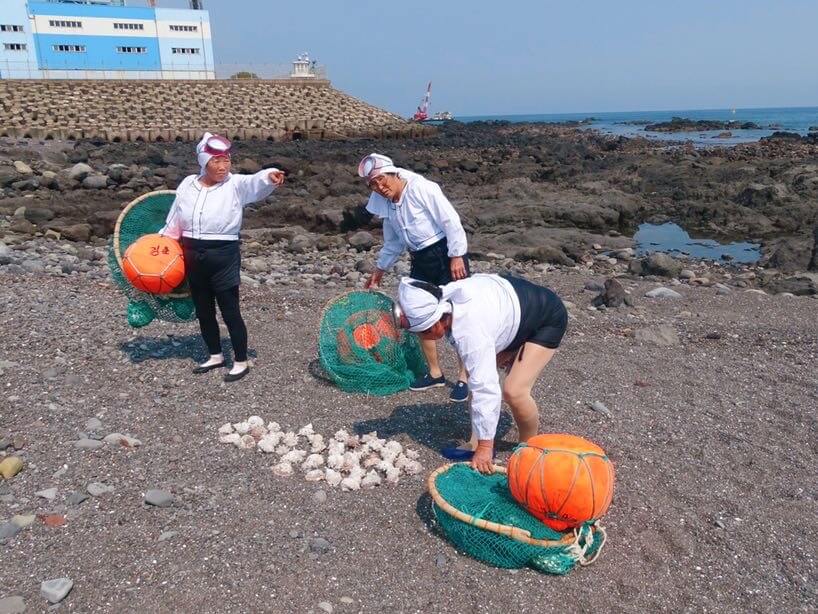
Day 11: Arrive in Jeju and settle into your surroundings. If you have time, visit a beach or the infamous Jeju Love Land (a risque theme park) in the afternoon. Day 12: Explore the West Coast of Jeju. Visit Hyupjae Beach, Hallim Park, O’sulloc Tea Museum and Cheonjeyeon Waterfall. If you don’t have a car, book a West Coast tour. Day 13: Travel the East Coast of Jeju Island stopping at Gwangchigi Black Sand Beach and Manjang Cave. Attend the fascinating UNESCO World Heritage women diver show to learn about these highly-skilled female divers (haenyeo) who dive down 10 metres without equipment to catch seafood. If you don’t have a car, book an East Coast tour . Day 14: Why not take a Mount Hallasan day hiking tour or have a beach day before flying back to the mainland in the evening? If your onwards destination is in Asia, you might even be able to finish your 2 weeks in South Korea by flying there directly from Jeju Island.
Where to stay in Jeju
- Hostel – Backpackers don’t have to sacrifice on sea views at the friendly Yesjun Guesthouse . It has a complimentary breakfast, a really friendly front desk, a kitchen, a restaurant, a games room, a simple breakfast, and a garden with bean bags next to the ocean. Check availability from US$17 .
- Budget hotel – Jeju Pureun Hotel has air-conditioned units with a fridge, microwave, kettle, TV, and complimentary toiletries. It’s also wheelchair accessible, and some rooms have visual aids. Check availability from US$30 .
- Mid-range – Located close to the beach and many attractions and restaurants, The Grang Seogwipo is an ideal base. Rooms are spacious with a city view, and an a la carte or American breakfast is included. Check availability from US$90 .
- Splash-out – After a day exploring, what’s better than unwinding by the outdoor pool with a cocktail, booking a massage, or tucking into a delicious meal at Toscana Hotel ’s onsite restaurant? Rooms include a balcony, bathtub, and floor-to-ceiling windows so you can order room service and enjoy the view. Check availability from US$190 .
Browse all Jeju accommodation on Booking.com and Hostelworld .
Where & what to eat in Jeju Island
- Black pork – this is the island’s signature dish, made from a specific breed of pig. Served with all the yummy Korean sides like gochujang, kimchi and veggies, it’s a treat! Sukseongdo is a popular place to try it.
- Haemultang – this a yummy seafood hotpot popular on the island. Try it at Samseonghyeol Haemultang .
- Matcha – as it’s grown on the island, make sure to find a cafe serving the local Jeju blend!
3 week South Korea itinerary
Since most people spend 2 weeks in South Korea, I decided this was the most useful itinerary to put together. But I personally spent 3 weeks in South Korea which, in my opinion, is better . You can get past the big cities and explore more local destinations. Plus, it’s an extra 7 days of eating kimchi! If you have 3 weeks in South Korea, there are a couple of stops I’d suggest adding, Daegu and Gyeongju . This 3 week South Korea itinerary also means you can include both Sokcho and Jeonju so there’s no need to choose. I’ll breeze through the stops we already mentioned and elaborate on the new destinations: Days 1-5: Seoul. As per 2 week South Korea itinerary above. Days 6-7: Sokcho. As above. Days 8-9: Jeonju. As above.
Days 10-12: Daegu
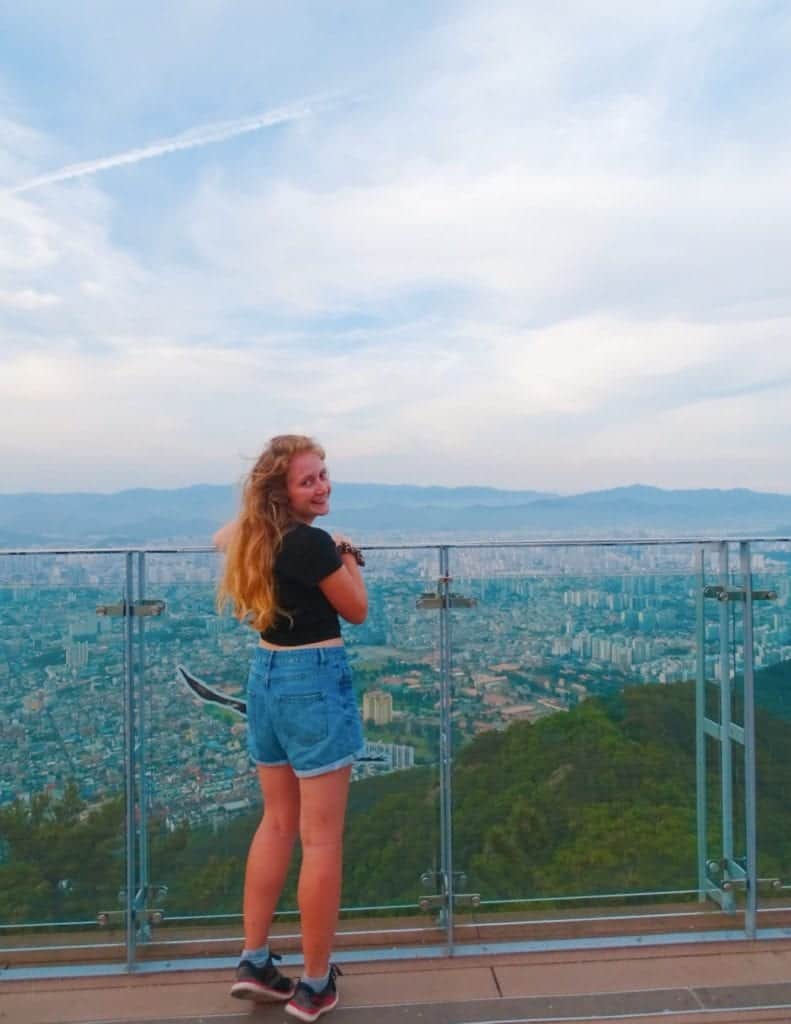
The fourth biggest city in South Korea is a sweet spot to spend a day or two especially if you like hiking. Day 10: Arrive in Daegu. Day 11: Catch a bus to Palgong Mountain for hiking and temples. Here you can find the Gatbawi Stone Buddha at Seonbonsa Temple and get immersed in the surrounding hiking trails. Day 12: Start your day with coffee and unlimited free pastries (yes seriously) at Schumann and Clara . Have a city day or hike up to Apsan Park where you’ll get spectacular sunset views over the city and countryside from the deck at the top.
Where to stay in Daegu
- Hostel – Located in downtown Daegu near the subway and bus routes, Empathy Guest House is a handy and comfy place to stay. Check availability from US$19 .
- Budget hotel – Blo by Blo is a quiet hotel with a hot tub and terrace. It’s conveniently located near the metro with minimal but clean rooms. Check availability from US$60 .
- Mid-range – For a cute and sustainable accommodation option, go for Aega Hanok Guesthouse. With aesthetic, Korean-style rooms and passionate hosts, it’s an excellent choice for anyone wanting to get a taste of traditional Hanok-style stays. Check availability from US$90 .
- Splash-out – If you want to truly relax in Daegu, then Susung Spa Resort is perfect. You have everything you need to unwind with two pools, a garden, a spa centre with hot tubs and a sauna, and a restaurant with a lake and mountain views. Check availability from US$150 .
Browse all Daegu accommodation on Booking.com and Hostelworld .
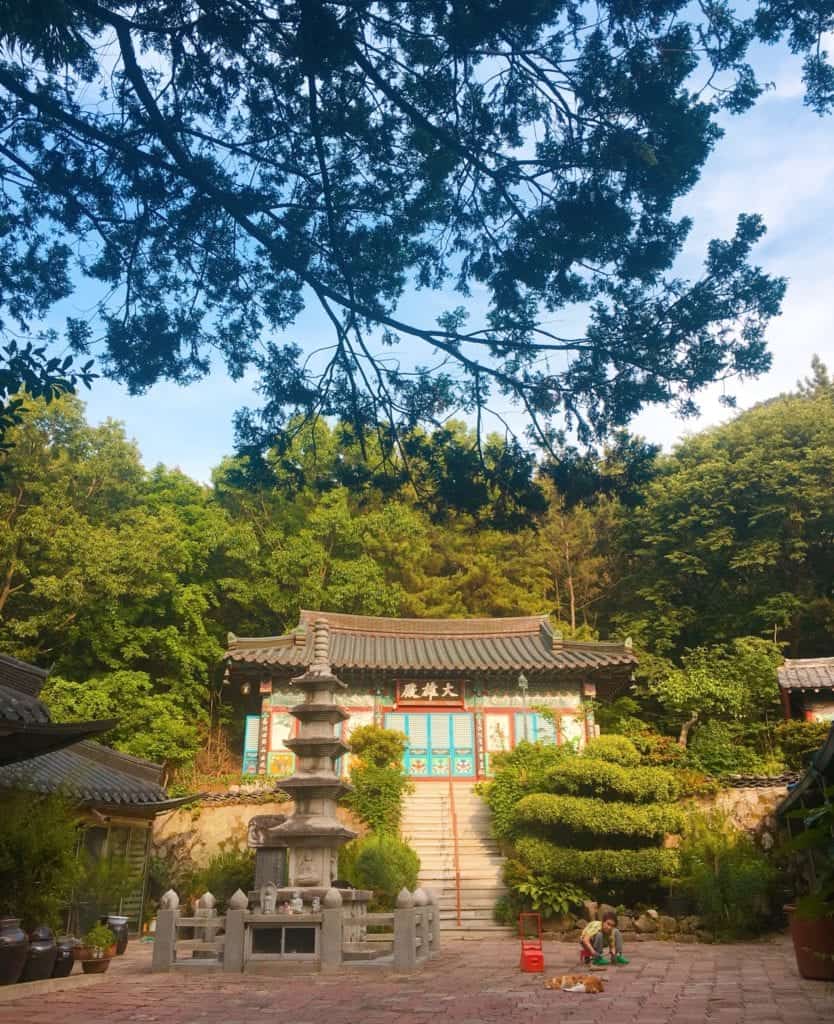
Tip – Check out Life of Brit’s Daegu hiking guide . Brit lived in Daegu while teaching English so she is your girl for tips (and always replies on Instagram).
Days 13-14: Gyeongju
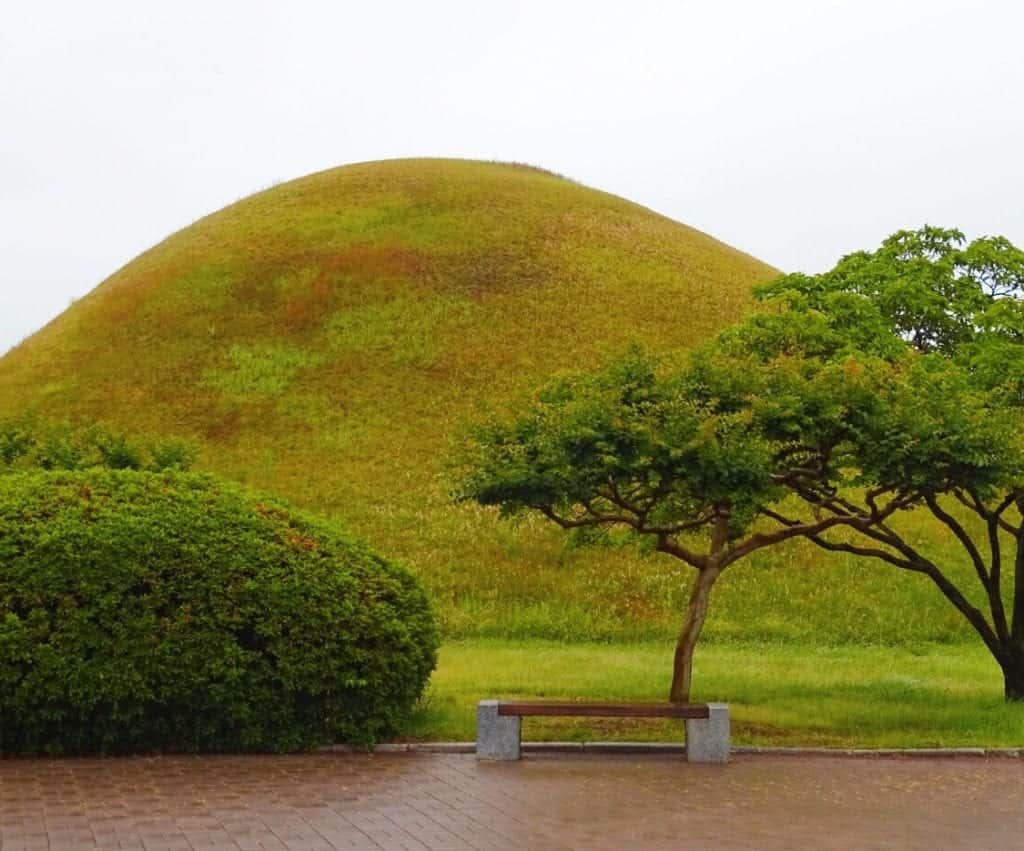
History lovers spending 3 weeks in South Korea shouldn’t miss Gyeongju, home to the Silla Dynasty from the 1st to 7th centuries. It’s also an excellent stop for foodies. I didn’t find anywhere else quite like Gyeongju which is why I liked it. Day 13: Explore Daereungwon Tumuli Park (ancient manmade hill tombs filled with gold and jewels), Wolji Pond and Cheomseongdae Tower. Tuck into a traditional ssambap meal: small bitesize portions of food wrapped in leaves. For dessert, sample Hwangnam (sweet bread filled with red bean paste).
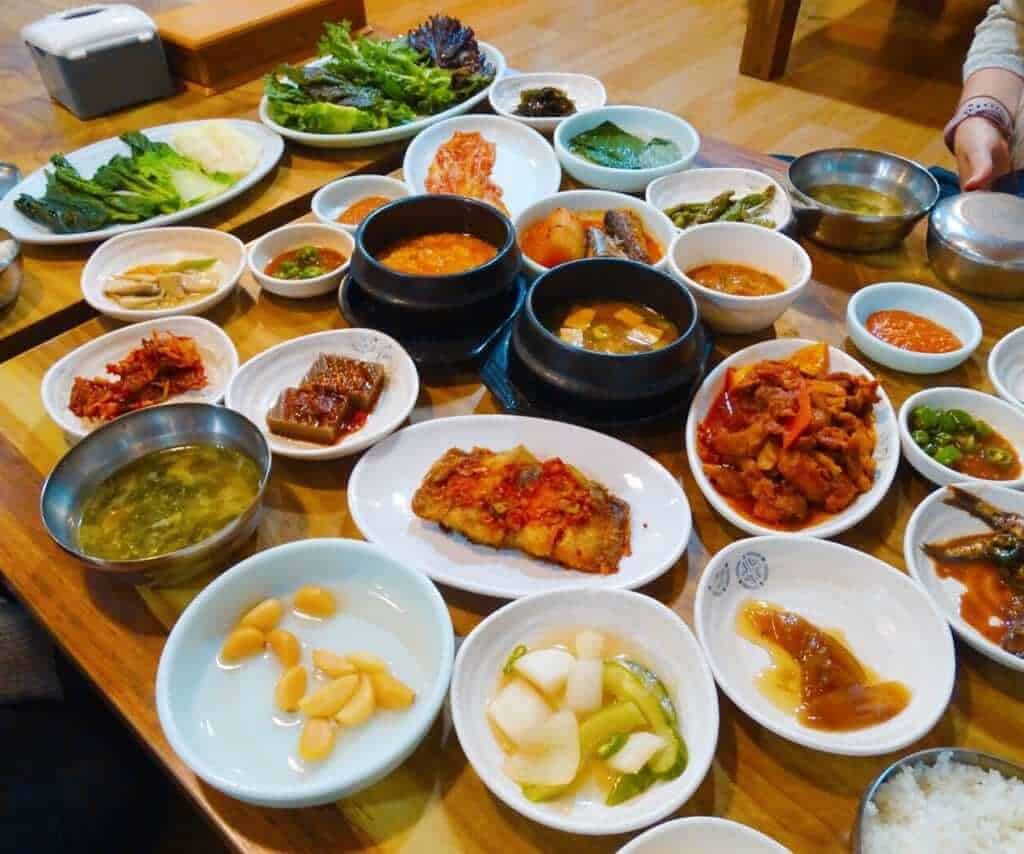
Foodie visiting Korea? Don’t miss my South Korea food guide !
Day 14: Catch a bus to Bulguksa Temple and hike up to Seokguram Grotto at the top (comfy footwear necessary). On the way home, stop at Gyeongju National Museum to learn about the ancient Silla Dynasty.
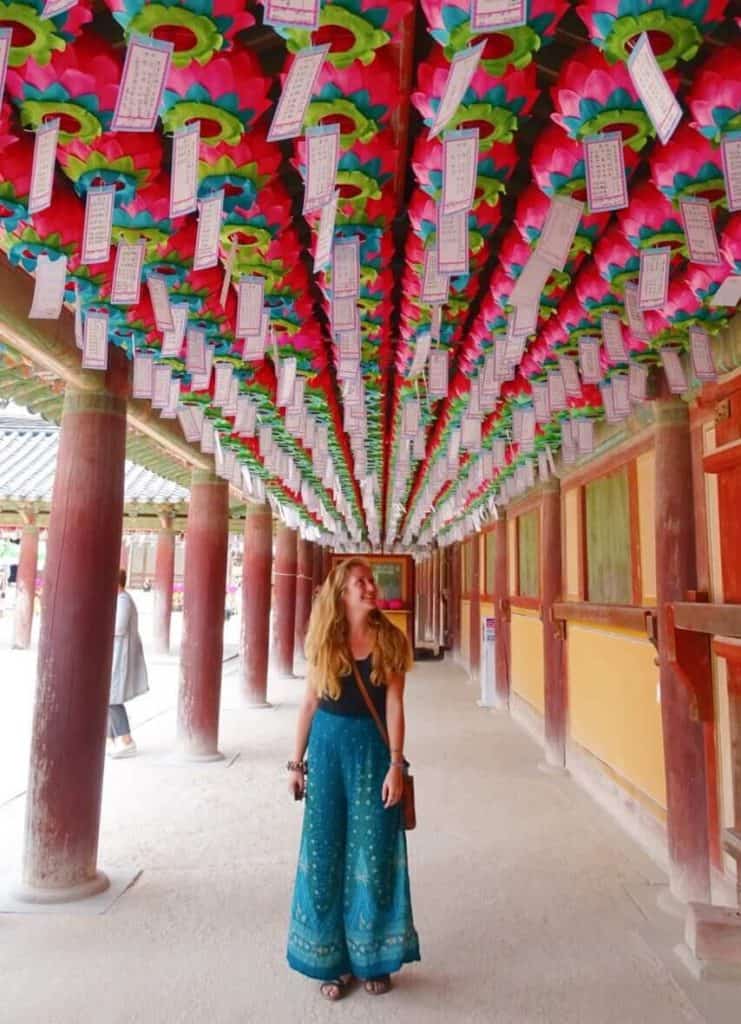
Another fun addition to your South Korea trip itinerary, should you have time, is a templestay experience at Golgulsa Temple near Gyeongju. Surrounded by stunning Hamwolsan Mountain scenery, Golgulsa is somewhere you can practice Sunmudo, a Korean-Buddhist blend between meditation and martial arts. Stay a night, several nights, or even up to a month!
On a tight schedule? It’s possible to visit Gyeongju as a day trip from Busan rather than stay overnight.
Where to stay in Gyeongju
- Hostel – I stayed at Blueboat Hostel , which is a cosy hostel run by a friendly local who will give you tips and local advice. It’s a great place to meet other backpackers. Check availability from US$18 .
- Budget hotel – For a comfy and clean room close to the centre, G HOUSE Mini Hotel & Guesthouse has you covered. Breakfast included. Check availability from US$45 .
- Mid-range – Rivertain Hotel has spacious rooms with spa baths and complimentary breakfast in the heart of town. Check availability from US$100 .
- Splash-out – Overlooking beautiful Lake Bomun, Lahan Select Gyeongju is a tasteful and welcoming resort with a gym, two swimming pools, indoor golf, and various dining options. Check availability from US$140 .
Browse all Gyeongju accommodation on Booking.com and Hostelworld . Days 15-17: Busan. As above. Days 18-21: Jeju Island. As above.
Useful info for 2 weeks in Korea
What is the best season to visit south korea.
March to May and September to November are optimum as the weather is pleasant. In the spring season, you may see cherry blossom and in the later season, you’ll see the country become beautifully autumnal. Saying that, I visited in June (summer) and although it was hot and sticky at times, it was bearable. This is also a good season for hiking as temperatures are cooler in the mountains. December to February are freezing cold so only visit if you’re really prepared. Note – make sure you know when Korean holidays fall as many businesses will be closed. Korean New Year is the first day of the Korean calendar. Chuseok falls on day 15th of the 8th lunar month.
Is Korea safe?
As a solo female traveller, I found South Korea to be very safe. I felt comfortable walking at night as well as during the day. Petty crime is not a big problem and violent crime is near non-existent. See my solo travel archives for safety tips for women. Here’s a guide for Black travellers in South Korea and LGBT+ travellers in South Korea .
What language is spoken in South Korea?
That would be Korean. Although the language is complex, the alphabet is actually quite simple. Some travellers told me they’d learnt it in a day! Doing so would definitely help you recognise dishes on menus. Failing that, have Google Translate close to hand and be prepared to do a little miming from time to time.
What plug do you need for South Korea?
South Korea uses plug type F with two round pins, like many other Asian countries. The standard voltage is 220 V with a frequency of 60 Hz.
Do you need a visa for South Korea?
More than 100 nationalities – including US, UK, Canada, EU, Australia and New Zealand – can enter South Korea visa-free. Check if your nationality is on this list and how many days you can stay for. If not, you’ll need to apply for a visa.
South Korea travel tips
- Unlike some countries, tipping isn’t necessary in South Korea
- For city travel, pick up a Tmoney card . They cost 500 KRW (you get back 3,500 of the 4,000 deposit) but save you money in the long run, plus you never have to queue at ticket machines. Buy yours now or get it with a SIM card combo
- Korea is a difficult place to travel for veggies. Download the HappyCow app.
Read my top 30 Korea travel tips here.
Best apps for a South Korea trip
- Seoul subway app – there are several apps to help you navigate the subway system.
- Kakao Talk – the Korean version of Whatsapp, should you make local friends (always a good idea).
- Google Translate – naturally!
- Naver Maps – since Google Maps gives you very limited information in South Korea, I recommend this local alternative for navigation.
South Korea essentials
- Copy of Lonely Planet Korea .
- A Korean phrasebook & dictionary .
- To stay connected, a 4g SIM to collect at Seoul airport or a rental pocket Wi-Fi device
- A handy bum bag with secure zip to keep your belongings secure.
- Reusable coffee cup (collapsable) for hot takeaway drinks.
- A reusable water bottle that you can fill up with filtered water (your accommodation will have this).
- Alternatively, a filtering water bottle that allows you to safely drink tap water.
- Metal straw and cloth bag set to reduce the use of plastic straws.
- Travel luggage – I use I recommend the Osprey Farpoint ( men’s ) ( women’s ).
- A camera – I use the Sony DSC-HX350 Digital Compact Bridge Camera which I think is one of the most affordable options based on the zoom and quality of photos.
- A GoPro if you’re into making videos – I use the HERO8 Black .
- Solo travel pick: a tripod or mini GorillaPod to get yourself in the shot – I use the Manfrotto tripod and Joby GorillaPod .
Thanks for reading my South Korea 2 week itinerary!
For more travel content, follow me on Instagram , Facebook , Twitter and YouTube .
See you next time for more adventures,
Ps. Liked this 2 week South Korea itinerary? Pin it for later!
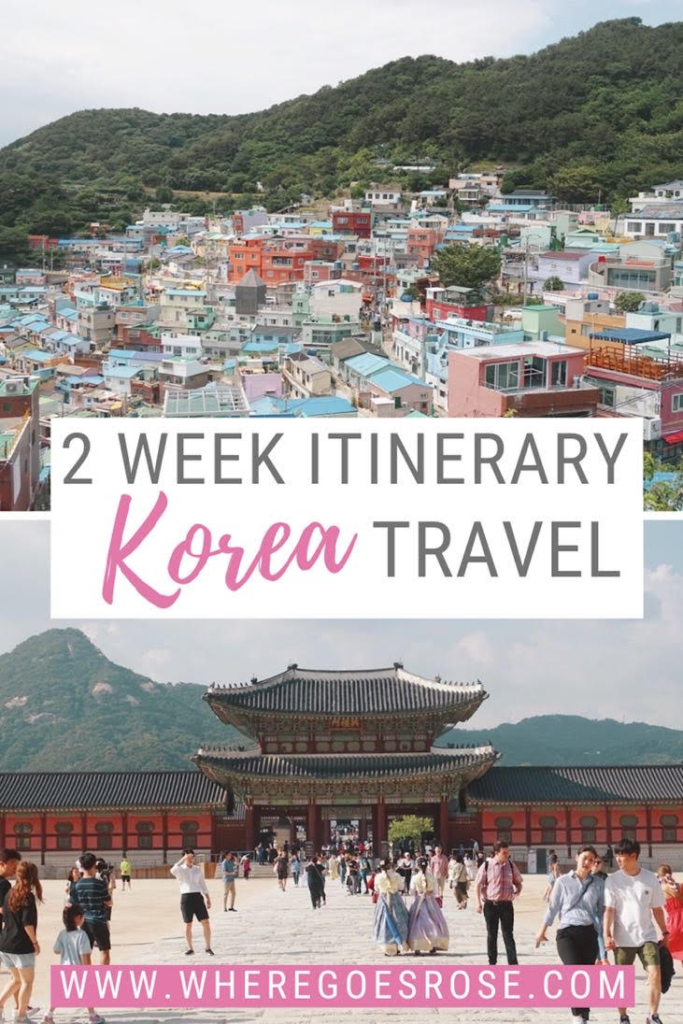
VISITING SOUTH KOREA? These are my trusted resources: Getting around by air – I use Skyscanner to find the best-value flights, using the ‘search by month’ tool to find the cheapest dates. You can also use the ‘to anywhere’ feature if you’re flexible on where you’re going. Buses – buses are comfy and efficient. It’s tricky for foreigners to book online so it’s best to turn up on the day. Trains – use Trip.com , partner of Korail (the official railway network of Korea) to book your tickets in advance. The website accepts international payment options, unlike Korean rail websites. Click the three stripes in the top right corner then the flag to change it to English. Driving in Korea – use Rentalcars.com to compare car rentals. Hiring a car will be especially useful on Jeju Island. For hotels in Korea, I use Booking.com – they also have self-catering apartments. You can filter by review score and price to find the best-rated budget places. For hostels, I use Hostelworld . To save money on accommodation, I use Trusted Housesitters , a website that connects homeowners going away and travellers who can sit their homes & pets. Browse South Korea tours and activities on GetYourGuide . I also check Viator and Klook in case they have a better price. For food tours with passionate local chefs and foodies, check out EatWith . Check out my resources page for more travel discounts and tips!
Rose is a solo traveller from the UK who has been on the road since 2015. She wants to show other women that solo travel isn't scary and doesn't have to be expensive! Rose has lived in Mexico, Canada and all over Asia, seeking out food, bubble tea and street art wherever she goes!
4 thoughts on “ Perfect South Korea Itinerary For 2 Weeks: Best Stops + Tips! ”
Hi! If you don’t mind me asking, how much did you spend for 3 weeks in Soith Korea? I plan to set aside a budget for my dream vacation there. ☺️ Thank you!
Hey Hannah! I spent about £900 in 3 weeks on a backpackers budget. Quite costly! I actually have a budget guide scheduled for next week if you check back on my homepage then!
Hi, I was just wondering if your last stay was on the jeju island, from which Airport did you fly back home? I want to make the similar route that you recommendet. But I’m unsure about from where i should fly back. Because going back to seoul from the jeju island would be elaborate. Even if my last stay would be in busan, would you recommend to fly back from there or take the train back to seoul – to fly back home from there.
I would be glad if you could help me out here 🙂
Hello! I flew return from Seoul then after a couple more days in Seoul, took my exit flight. If doing it again, I might do Jeju in between Seoul and Busan to save travel time. 🙂
Leave a Reply Cancel reply
Your email address will not be published. Required fields are marked *
You can see how this popup was set up in our step-by-step guide: https://wppopupmaker.com/guides/auto-opening-announcement-popups/
SEOUL - north | SEOUL - south
Day Trips from Seoul | Busan | Best Collections
🌸Festivals ( Seoul • Busan )
5-9 Days Trip Itinerary for First Timers to Seoul, Korea
KoreaToDo has put together a step-to-step detailed trip itinerary for first timers (or any busy travellers with little time for planning) to Seoul , Korea .
It offers ONE central page of information for all your key travel needs to Seoul . They include, where to stay , important mobile apps to use, how to get from Incheon International Airport to your hotel in Myeongdong (the most popular and central place to stay in Seoul ), day-by-day itinerary with detailed transport/walking guides on getting from one attraction to another, recommended tours, shops and restaurants .
The itinerary covers 8 out of 9 Korea's Top 100 Must-Visit Places in Korea (2023-2024) in Seoul (e.g. N Seoul Tower , Gyeongbokgung Palace , Hongdae ), as released by Korean Tourism Organization . It also covers previous attraction winners like Myeongdong .
Itinerary Highlights

🎖 Present/Past Top 100 Must-Visit Destinations in Korea
Before Departure
1. Recommended Activities, Tours & Tickets to pre-purchase before trip (optional)

N Seoul Tower Observatory Ticket
enjoy breathtaking views

Namsan Cable Car Round Trip Ticket (weekdays & min. 2 pax)
beautiful scenery of Seoul

4G SIM Card (KR Airport Pick Up) - KT OLLEH (3/5/10/20/30 days options)
data, calls & texts/24 hrs pick up

4G Pocket WiFi (KR Airport Pick Up) - SK TELECOM (Unlimited Data)
max 3 devices / 24 hrs pick up
2. Recommended Hotel Location: anywhere near Myeongdong Station , preferably on the same side of the road as ' Nine Tree Hotel Myeongdong ' (i.e. 2 mins walk to airport limousine bus drop off/pick up bus stop , near exit 8 of Myeongdong Station )

★★★ | 8.5 Review Rating

★★★★ | 8.8 Review Rating

★★★★ | 8.6 Review Rating

★★★ | 8.4 Review Rating

★★★ | 8.8 Review Rating

★★★★ | 8.7 Review Rating
3. Download Mobile Apps
a) Korea Subway Info App - Metroid HD (/ KakaoMap/Naver Map )
b) Location/Walking Direction Map - KakaoMap or Naver Map
more travel tips ....
Day 1: Arrived Seoul / Check in / Namsan Seoul Tower / Myeongdong
At Incheon Airport - Arrival Hall (public area after collecting luggage)
Pick up pre-purchased WIFI Router & SIM Card at Incheon Airport (where applicable).
Recommend to purchase T-money Card at any convenience store at the arrival hall of Terminal 1 (T1) or Terminal 2 (T2). Card deposit is ₩4,000. Suggest to top up at least ₩20,000 to ₩30,000 as the airport limousine fare is ₩17,000.
( Th e card ca n be used on airport limousine bus to city, bus, taxi, subway and convenience stores. Top up at any downtown convenience stores or subway stations. More details ... )
💡If you can't get the card at the convenience store, you can walk a bit further to the subway station to purchase the card. Alternatively, you can get it at most convenience stores when you arrived in Myeongdong. Different stores carry different designs and you can pick your favourite too !

Take Airport Limousine Bus from Incheon Airport (T1/T2) to City (i.e. Myeongdong Station Bus Stop )
Bus #: 6015
Interval: 2-6 departures per hour
Duration: 80 mins
Fare: ₩17,000 (discount may apply when used with T-money Card)
No reservation required. Just join the queue and it is free seating on board.

Departing from T1 to Myeongdong Station :
First bus 05:40 | Last Bus 23:00
Walk outside of arrival hall (1F) at Gate 5, look for Bus #6015 to Myeongdong at bus platform 5B.

Departing from T2 to Myeongdong Station :
First bus 05:20 | Last Bus 22:40
Go to Basement 1 for platform No. 28
Tab the T-money Card on boarding.
alternatively, bus ticket can be purchased at counters/machines (recommended) outside arrival hall (T1, 1F), bus waiting area (T2, B1) or by cash to driver.

Refer to Incheon International Airport official website on the latest bus schedule and updates.
Alternative ways to get to Myeongdong from Incheon International Airport :
a) book your Private Airport Transfer by Car OR
b) take the non-stop AREX Airport Railroad express train from Incheon International Airport direct to Seoul Station (Terminal 1: 43 mins / Terminal 2: 51 mins, ₩11,000) and transfer to subway for Myeongdong Station (line 4, 3 mins, 2 stops, ₩1,400). Luggage carrying up/down the stairs might be required. There are taxi stands outside Seoul Station too.
Check into accommodation booked after alighting from Airport Limousine Bus at Myeongdong Station Bus Stop.

N Seoul Tower 남산서울타워

👉 How to get to N Seoul Tower
From N Seoul Tower, take the Shuttle Bus No. 01B to the last stop (i.e. Namsan Yejang Bus Transfer Parking Lot). 13 mins bus ride. From there, walk towards Myeongdong Station , 4 mins.
💡Myeongdong's main shopping area is right at Myeongdong Station's exit 5-8.

Food & Drinks

Street Food

Day 2: Seoul Plaza / Cheonggyecheon Stream / Gwanghwamun Square / Gyeongbokgung Palace / Tosokchon Samgyetang / Bukchon Hanok Village / Insadong
Depart 9:00 or earlier [ in time for the 10:00 changing of guard ceremony at palace]
Using KakaoMap or Naver Map , take an easy leisure walk from your accommodation to Seoul Plaza (15 mins) , located right next to City Hall Station (line 1, exit 5) and facing The Plaza Seoul (hotel). The very popular Lotte Department Store (main branch) and the established Lotte Hotel Seoul that every taxi drivers know even in English are located nearby too.
Seoul Plaza 서울광장

Walk along the straight road, Sejong-daero at the side of Seoul Plaza (passing by City Hall Station , line 1, exit 4/5) towards Gyeongbokgung Palace (20 mins) , bypassing Cheonggyecheon Stream and Gwanghwamun Square along the way . This is a nice, spacious and modern area in Seoul .

Cheonggyecheon Stream 청계천

Gwanghwamun Square 광화문광장

Gyeongbokgung Palace 경복궁
To arrive before 10:00 for the Changing of the Royal Guard Ceremony (20 mins) , followed by the optional Free English Guided Tour at 11:00 (1-1.5 hrs) . No reservation required.
The next Changing of the Royal Guard Ceremony is at 14:00.
For those who wish 'conserve' energy, you can take a taxi direct from Myeongdong to Gyeongbokgung Palace (20 mins, ₩7,200) or subway to Gyeongbokgung Station with 1 transfer (15 mins, ₩1,400). Use subway mobile app Metroid HD or KakaoMetro for the lines and transfer station.

Hanbok Experience (Hanboknam Gyeongbokgung Store)
incl. basic hairstyling & inner skirt

Hanbok Rental (& Photoshoot) Experience by Hanbok That Day
3 mins walk fr. Gyeongbokgung
Walk from Gyeongbokgung Palace to the popular Tosokchon Samgyetang (Ginseng Chicken Soup) Restaurant. 10 mins .
Tosokchon Samgyetang (Ginseng Chicken Soup) 토속촌 삼계탕 @Seochon Village

Seochon (Sejong) Village 서촌마을

Walk back to Gyeongbokgung Station (line 3).
Take the subway from Gyeongbokgung Station to the next stop, Anguk Station (line 3, exit 2). Walk to Bukchon Hanok Village ( 10 mins) .
Bukchon Hanok Village 북촌한옥마을

Walk from Bukchon Hanok Village back towards Anguk Station to Insadong . 3 mins walk from exit 6.
Insadong 인사동

Dinner at one of the quaint restaurants at Insadong .
After dinner, walk back to Anguk Station (line 3). Take the subway back to Myeongdong Station (line 4, 1 line transfer, 10 mins).
Alternatively, at any point along Insadong , you can take a taxi back to Myeongdong (11 mins, ₩5 ,600).
Day 3: Day Trip from Seoul
1. Recommended Day Tours from Seoul

DMZ 3rd Invasion Tunnel & Korea Traditional Boat Voyage Day Tour
river flowing out of North Korea

Everland Day Tour (Admission, Tour Guide & Round Trip Transfer)
Eng./Mandarin speaking guide

Nami Island, Petite France, Italian Village & The Morning Calm Day Tour

Nami Island, Alpaca World & Samaksan Mountain Lake Cable Car Day Tour
longest cable car in Korea!
2. or Pick a Day Trip from Seoul under 3 hours

Day 4: Gwangjang Market / Hongdae / Ikeongdong Hanok Village
Gwangjang Market 광장시장속박물관
Take the subway from Myeongdong Station to Euljiro 4-ga Station (line 2/5, 1 line transfer, 11 mins, exit 4). 5 mins walk to Gwangjang Market .

Take the subway from Euljiro 4-ga Station to Hongik Univ. Station (line 2, 14 mins journey, exit 9).

Hongdae / Kakao Friends Hongdae Flagship Store / Line Friends Hongdae Flagship Store

Seoul Personal Color Group Consulting Experience Using Self-Tester
Hongdae/Garosu-gil Branch

Nail Art & Hairstyling Experience at OLRANG, Hongdae
onsite English translation

Seoul Personal Color & Make-up Analysis in Hongdae
with English speaking expert

Nanta Show Seoul @Myeongdong / Hongdae
Korea's longest running show
Walk back to Hongik Univ. Station. Take the subway to Jongno 3-ga Station (line 1/3/5, 1 line transfer, 23 mins, exit 4/6).

Ikseondong Hanok Village
After visiting the hanok village, take the subway from Jongno 3-ga Station back to Myeongdong Station (line 4, 1 line transfer, 8 mins).
Day 5... : Self-explore based on your interest

Korean Folk Village, Suwon Hwaseong & Suwon Nammun Market Day Tour
Authentic cultural experience

Incheon Day Tour (Ganghwa Luge, Rail Bike, Wolmido & Fairy Tale Village)
enjoy the best of Incheon!

Alpaca World, Nami Island & The Garden of Morning Calm Day Tour
walk with adorable alpacas

Legoland Korea & Samaksan Mountain Lake Cable Car Day Tour
longest 3.61km cable car ride!
2. or Pick a Day Trip from Seoul under 3 hours

3. or Explore more on North of Han River / South of Han River (i.e. Gangnam)

Day before departure: last minute shopping / chilling out
Last Minute Shopping
or Chill Out...

Buy your favourite Korean goodies back home!

Duty free shops, food court & supermarket.

Largest underground mall in Seoul with over 600 shops (GOTO MALL).

For those who must see Gangnam & its underground shopping mall.

cluster of shopping malls that open past midnight.

12 floors of shopping, dining & entertainment experience.

Hairstyling at Franck Provost in Myeongdong
premium hair salon

O HUI & WHOO SPA Myeongdong
25% off skin care kits

Art De La Peau Massage Shop in Myeongdong
K-beauty by the professionals
Last Day: Getting to Airport...
Take the Airport Limousine Bus, #6015 (or #6001) from the same drop off stop ( Myeongdong Station ) to Incheon Airport (T1/T2)
Bus stop location: near exit 8 of Myeongdong Station and right in front of KB Bank.
Duration: 80 mins (T1) / 90 mins (T2)
Fare: ₩17,000 (discount may apply when used with T-money Card)
First bus 04:35 | Last Bus 20:15 ( refer to the information at bus stop for the latest schedule )

Alternatively, you can book on a private car transfer to Airport as well .

Private Transfer: Incheon Airport (ICN) to Seoul (1-3 or more pax/car)
Myeongdong, Hongdae, etc

🌸SPRING PICKS🌸 Handpicked Experiences from Seoul

Chasing Cherry Blossom & Spring Flowers Day Tour
29 Mar - 14 Apr 2024
3 best spots of the day in Seoul/Gyeonggi

Taean Tulip Festival & Strawberry Picking Day Tour
12 Apr - 7 May 2024
500g strawberry picking

Jeonju Hanok Village, Wansan Park & Gakwonsa Temple Day Tour
8-23 Apr 2024
King Cherry Blossom Festival

Pink King Cherry Blossom Tour (Spring Flower Festival, Gaesimsa & Munsusa)
14-29 Apr 2024
king cherry blossoms are larger & denser

Hwadam Botanic Garden, Nami Island & Gangchon Railbike Day Tour
29 Mar 2024 ~

Pink King Cherry Blossom Tour (Wansan Flower Garden, Jeonju Hanok Village)
15-28 Apr 2023
& Gakwonsa Temple
♔ KoreaToDo recommends Klook.com , Asia leading in-destination service provider.
Other KoreaToDo Collection that you may like:
Seoul & busan travel itinerary, cherry blossoms & spring flowers travel itinerary in seoul, autumn foliage itinerary, still looking explore koreatodo handpicked collection of:, seoul - north of han river, seoul - south of han river.
One Week in South Korea: The Ultimate Itinerary
There’s a lot more to South Korea than Seoul. Despite the country’s compact size (it’s roughly the same size as Indiana or Portugal), this vibrant East Asian nation is brimming with genteel Buddhist temples, mist-capped mountains, and buzzing cities. Although one could easily spend a week in Seoul alone, a seven-day itinerary encompassing the entire country is entirely doable, and will give you a thorough overview of Korea’s natural beauty and cultural treasures.
South Korea is well known for its vast and easy-to-use public transportation system; a seamless network of subways, trains, buses, flights, ferries, and (relatively inexpensive) taxis that can take you almost anywhere in the country. The backbone of north-south travel is the KTX, a high-speed train that can reach top speeds of 190 mph, and travels from Seoul to the southern port city of Busan in approximately three hours. Domestic flights are also offered to many larger cities around the country, and mainly depart from Seoul’s Gimpo International Airport; about 21 miles away from Incheon International Airport , the city’s main international hub, buses run every 15 to 25 minutes between the two airports, and cost 7,500 won.
For those who prefer autonomy, car rentals are possible but require an International Driving Permit in addition to a valid driver’s license issued in your home country. (FYI, an IDP must be obtained in the same country your driver’s license was issued in.) Another consideration before you get behind the wheel is that Korea’s main routes are toll roads, so plan accordingly.
Patrick Foto/Getty Images
Most foreign visitors to South Korea will arrive at Incheon International Airport just west of Seoul, making the capital a perfect starting point on your itinerary. Take either a limousine bus or the AREX Airport Express train to downtown Seoul to get your trip started. Once you’ve stashed your bags at one of the city’s numerous hotels, motels, or guesthouses, it’s time to hit the streets.
In the geographical center of Seoul lies Namsan Mountain, topped with the spindly N Seoul Tower . This futuristic landmark is visible from many areas of Seoul, and makes a good point of reference as you navigate your way around the capital. Starting your tour from the observation deck at the top of the tower will help you get your bearings on the layout of the sprawling city. Enjoy lunch at the tower’s rotating N Grill , a chic restaurant that offers customers 360-degree views of Seoul while they dine on fine French delicacies and wines.
Next, take a bus or subway to the 14 th -century Gyeongbokgung Palace , the largest of Seoul’s five royal palaces from the Joseon dynasty. The grand entrance gate is an impressive work of architecture guarded by traditionally clad performers who reenact historically accurate Royal Guard Changing Ceremonies daily.
To get a big picture perspective of the nation, a visit to the National Museum of Korea is in order. The majestic, striking building houses approximately 15,000 items dating from prehistory to the modern era, and is Korea’s largest and most impressive museum.
For more essential travel tips, including how to navigate the city's public transportation, where to stay, and what to pack, check out our complete guide to Seoul .
ericfoltz/Getty Images
History buffs, political aficionados, and curiosity lovers alike will revel in a bizarre day trip to one of the world’s most notorious borders. The Korean Demilitarized Zone (DMZ) is the 160-mile long border that divides the Korean Peninsula into the North and South, and lies only 31 miles from central Seoul.
Various tour options take visitors by bus from Seoul to the DMZ’s most popular sites, including the Bridge of Freedom, the 3rd Infiltration Tunnel, and Dora Observatory with views over North Korea. Plus, you can see the iconic blue buildings in the Joint Security Area, which is guarded by fierce-looking soldiers from both sides.
Many sights of the DMZ can also be reached via a special roundtrip “ Peace Train ” that departs from Seoul Station. Upon reaching Dorasan Station, the last stop before reaching North Korea, the tour continues via bus. (The DMZ Peace Train tour doesn’t include a visit to the Joint Security Area, which can only be accessed via specific tour companies, such as DMZ Tours .)
Bukhansan National Park
KR_nightview / Imazins/Getty Images
Seoul is one of the only cities in the world that has a national park within its borders. This easy access has made Bukhansan National Park a favorite among Seoulites, and has won a spot in the Guinness Book of World Records as having the highest number of visitors per square foot of any national park on the planet.
Filled with jagged rock formations, miles of hiking trails, and sweeping views of the capital, Bukhansan is well worth a day trip. Buses from Seoul Station take approximately 40 minutes to reach Bukhansan National Park Jeongneung Visitor Center, which lies just outside one of the park’s entrances.
Across from the visitor’s center is a 7-11, where you can pack your rucksack with hiking snacks like dried squid or kimbap (Korea’s version of sushi) before hitting the trails.
Aside from the natural beauty of the rock formations, 1,300 species of animal and plant life (the latter of which is especially lovely and photogenic during the colorful spring and fall seasons) and over 100 Buddhist temples can be found within Bukhansan’s borders. Hwagyesa Temple is renowned for its graceful 17 th -century architecture and its popular temple stay program, where visitors can learn what it’s like to live as a Buddhist monk.
Akanit Laveewan / EyeEm/Getty Images
Time to board the KTX train and head south to Daegu, South Korea’s fourth largest city.
Sports fans may recall that the city played host to the 2002 FIFA World Cup and the IAAF 2011 World Championships in Athletics, where superstars such as Usain Bolt and the now-infamous Oscar Pistorius wowed crowds.
Whether you’re a sports enthusiast or not, make your first stop a visit to Daegu Stadium . In addition to the stadium itself—which is surrounded by landscaped parks, mountains, and hiking trails—check out memorabilia at Daegu Sports Museum or stock up on K-Beauty products at Color Square , a shopping and entertainment complex.
Afterwards, take a cable car to the top of Palgong Mountain for lunch at a restaurant that may serve simple food, but features some of the best views of the city. Then hike down to Dongwhasa Temple and the famed Gatbawi Buddha, a 7 th- century stone statue that's said to grant one wish to each visitor who prays here.
Round out your day with a stop at Seomun Night Market , which features traditional and surprising street food from over 65 vendors, making it South Korea’s largest night market.
Insung Jeon/Getty Images
Catch an intercity bus for about 5,000 won, and an hour later you’ll find yourself in Gyeongju, the capital of Korea during the ancient Silla kingdom that reigned from 57 BC to 935 AD.
Marvel at the exquisite architectural details of Bulguksa Temple ; originally built in 528 BC, the current temple is a restored version since between then and now it was destroyed many times by fires, theft, and war. After your visit, hike to the nearby UNESCO World Heritage Site of Seokguram , a temple built inside a grotto of granite and graced with a carved seated Buddha.
Gyeongju National Museum is a must-see for insights into the Silla dynasty, and features numerous exhibits on culture and daily life of times past. But to get really up close and personal with history, head down the road to the Daereungwon Tomb Complex , where the otherworldly burial mounds conceal the underground chambers of ancient kings and queens.
Hop on a train or intercity bus to reach Busan in about 1.5 to two hours. As Korea’s second largest city and the country’s largest seaport, Busan is always bustling with things to do.
Start with a hot soak and a skin-tingling body scrub at Spa Land Centum City , a contemporary take on the traditional Korean bathhouse. There are 22 different indoor and outdoor spring water soaking pools of various temperatures, as well as 13 different types of saunas ranging from Finnish to Turkish.
No visit to Busan would be complete without a stroll along Haeundae Beach , South Korea’s equivalent to the world-famous Waikiki. The golden sand remains largely vacant in winter, but come summer it’s awash with bright beach towels and parasols. The street lining the shores houses a wide array of bars, restaurants, and hotels, as well as an aquarium and a coastline hiking trail.
Adventurous eaters can catch dinner at the Jalgachi Fish Market , Korea’s largest seafood market, which sells both live and dried fish. Options range from crab and abalone to the more exotic grilled eel and raw octopus.
Natthawut Utsawachaichot / 500px/Getty Images
The semi-tropical volcanic island of Jeju is 181 miles south of Busan, and while it merits a multiple-day visit of its own, a whirlwind tour can be done by the determined in just one.
After landing at Jeju International Airport (or taking an overnight ferry from Busan if you have more time), make use of the extremely efficient bus system that connects the most popular tourist sites.
Jeju’s most iconic destination is Seongsan IlchulBong Peak , a tuff cone crater that formed 100,000 years ago during a submarine volcanic eruption. Take a walk along the rim for some seriously sensational views of the sunrise and the surrounding sea and countryside.
Hike the network of trails through Hallasan National Park to the 6,397-foot Halla, a volcanic peak that’s the tallest mountain in South Korea. Home to 1,800 plants and 4,000 different species of animals and insects, this UNESCO World Heritage is known for its unique vertical ecosystem resulting from the varying temperatures at each elevation.
Another UNESCO site worth admiring is the Manjanggul Lava Tube . At 59 feet wide and 75 feet high, it’s one of the largest lava tubes in the world, and stretches nearly 5 miles into the subterranean darkness.
Bukhansan National Park: The Complete Guide
Getting Around Seoul: Guide to Public Transportation
The Top 18 Things to Do in South Korea
Getting Around Busan: Guide to Public Transportation
The Top 10 Destinations in South Korea
The Top 15 Things to Do in Daegu
The 12 Best Day Trips From Seoul
The 12 Best National Parks in South Korea
The 9 Best Day Trips From Busan
Seoul Guide: Planning Your Trip
The Top 7 Temples in Busan
One Week in Argentina: The Ultimate Itinerary
The Top 12 Things to Do in Busan, South Korea
One Week in France: The Ultimate Itinerary
Where to Go in 2022: The Most Exciting Destinations to Explore This Year
The Best Time to Visit South Korea

South Korea 7 Day Itinerary
Looking for a sample itinerary and ideas on how to spend a week in South Korea? Read our post with South Korea 7 Day Itinerary. This detailed itinerary is based on our own experience travelling in South Korea and includes visiting Seoul , Busan , Gyeongju and Gapyeong .
We travelled to South Korea in 2023 and really liked the country. South Korea has a rich history, delicious food, hilly landscapes, beautiful coastlines, busy cities and pretty countryside. Many first time visitors to South Korea limit their visit to Seoul only. While Seoul is a vibrant city with lots of things to see and do, we wanted to see more of South Korea during our trip.
We didn’t want to move to a new location every night or two, rent a new place every time, pack and unpack often, and think about where to store our suitcases when between hotels. Therefore, we based our first part of the trip in and around Seoul , and the second part of the trip – in and around Busan . This way, we only had to book two hotels – one in Seoul and one in Busan, and could explore cities and make one day trips with a light backpack, leaving all the rest in the hotel.
Here is our 7 Day Itinerary in South Korea.
South Korea 7 Day Itinerary at a glance:
Day 1 – historical sights and night views of seoul, day 2 – jogyesa temple, bukchon village, gyeongbokgung and modern seoul, day 3 – day trip to gapyeong (petite france, nami island and garden of morning calm), day 4 – seoul parks, shopping districts and food markets, day 5 – busan (haeundae beach, x the sky, blueline tram and haedong yonggungsa temple), day 6 – day trip to gyeongju (daereungwon tombs, hwangridan-gil, bulguksa temple, gyochon village and donggung palace), day 7 – busan (gamcheon culture village, biff square, jagalchi market and songdo beach).

Planning a trip to South Korea
There are few things you need to plan and prepare before travelling to South Korea.
First of all, you need to check whether you need a tourist visa to South Korea or Korea Electronic Travel Authorization (KTA), and obtain it.
Next, plan and sort out mobile internet for the trip (e.g. get a roaming, a local sim-card or rent a WiFi device in South Korea).
Also, think about bringing cash, how to get to Seoul from Incheon airport, how to use public transport, buying a train pass and getting useful mobile apps before going to South Korea.
Read about all this and more in our dedicated post Things to know before travelling to South Korea .
As the majority of international travelers to South Korea fly to Seoul, we start our 7 Day South Korea itinerary with this vibrant city.
Seoul is one of the biggest cities in the world and has lots of attractions and things to see and do. We recommend spending at least 3 days in Seoul to get a good overview of the city, see its big attractions and experience its busy life.
In the morning
On the first day in Seoul go to Ikseon-dong Hanok Village – a traditional Korean village with narrow streets, pretty houses, cafes and small shops.
Visit Changgyeonggung Palace complex built in the mid-15th century by King Sejong. Explore its many buildings and gardens.

Next, walk to Unhyeongung – a former royal residence . There are a couple of historical buildings and quiet courtyards inside. The entrance to the residence is free.
Have lunch in one of the many cafes and restaurants of Insa-dong street . Also, there are many souvenir shops and other stores on Insa-dong street if you feel like shopping.
In the afternoon
All of the attractions above are located within walking distance to each other. But to get to the next point of the itinerary you would need to take a bus or a subway. Read about using public transport and paying with Tmoney cards in Things to know before travelling to South Korea .

In the afternoon, go to Naksan Park to enjoy the views over the city. For the best night views over Seoul go to Eungbong Mountain Park.

Read our detailed post on the 3 Day Itinerary for Seoul .
First stop on Day 2 is Jogyesa Buddhist Temple . Its main building – the temple with the Budha statue – is surrounded by a spacious courtyard decorated with paper lanterns. Jogyesa is open to the public and the entrance is free.

Next, walk to Bukchon Hanok Village – a traditional Korean village with small alleys and houses with hanok architecture. It’s located on the top of a hill between Changdeok Palace and Gyeongbok Palace.
Gyeongbokgung Palace (or Gyeongbok Palace) was the main and the largest royal palace of the Joseon dynasty. It’s a big complex with many historical buildings and gardens. Plan to spend at least 1-2 hrs exploring Gyeongbokgung.

Just south to the Gyeongbok Palace lies Gwanghwamun Square . The square is surrounded by tall modern buildings and has two massive statues – the statue of King Sejong and the statue of Admiral Yi Sun Shin.
Continue walking from the Gwanghwamun Square towards Cheonggye Plaza and Cheonggyecheon. Cheonggyecheon is a public recreational space right in the heart of Seoul. It has lots of cafes and restaurants around and is a great place to stop for lunch.

In the afternoon explore Seoul on the other side of Han river. In that part of Seoul you will find the famous Gangnam suburb, a viewpoint to Banpo bridge with its colourful fountain, the 123-story Lotte World Tower with its Seoul Sky observation deck, as well as Lotte World Magic Island amusement park, as well as many other Seoul attractions.
Enjoy some shopping at Lotte World Mall or visit Lotte World Aquarium . Get to the observation deck of the Lotte World Tower – the tallest building in South Korea and the 6th tallest building in the world.

Last stop of the day is Banpo Bridge and its colourful show of the Banpo Bridge Moonlight Fountain. You can watch it from the Banpo Hangang Park, which is a 20 min by bus from Gangnam.
On the Day 3 of the South Korea 7 Day Itinerary, take a day trip from Seoul.
There are quite a few day trips you can take from Seoul – check them out on Klook or GetYourGuide . We would like to recommend the one that we took ourselves – a day trip to Gapyeong county .
On the day we were picked up in the morning by a tour bus (you can choose one of the meeting points when booking the tour). We visited three places in the Gapyeong county – Petite France and Italy villages, Nami Island and the Garden of Morning Calm.
Petite France and Italy are purpose built miniature villages (one French and one Italian) with cute houses, display rooms, small alleys and squares. Built on a hill the villages have nice viewpoints over the Korean countryside.

After making a stop for lunch (with traditional Korean food of fried chicken, veggies and spices), we went on a ferry to Nami Island . Nami Island on the Han River has lots of alleys with tall trees on the sides, gardens, sculptures, cafes and a few small shops. It’s a nice destination not only for nature lovers, but also for those who watch Korean drama series – Korean drama “Winter Sonata” was shot at Nami Island.

Last stop of the day is the Garden of Morning Calm – one of the oldest private gardens in Korea. We visited in spring and it had many blooming trees and flowers. In autumn you will find there abundance of fall colours. In winter they decorate gardens with colourful lights and illumination. And in summer, of course, you can enjoy all the greenery of the plants in the gardens.

The tour bus will bring you back to Seoul in the evening around 7pm. If not too tired, take a walk in the center of Seoul after dark. Seoul is always a busy city, even at night.
Spend the last day in Seoul with leisure walks in city parks, shopping in popular shopping districts and visiting traditional Korean markets.
Start the day with a walk along the Seoul City Wall and in the Naksan park . From the Naksan Park, walk down to Ihwa Mural Village and then continue downhill to Dongdaemun gate .

Dongdaemun is a large shopping district in Seoul. There are many shopping malls, Dongdaemun Market and DDP – Dongdaemun Design Plaza.

Next, take a metro to Myeongdong – another popular shopping and dining area in Seoul. Have a break for lunch at Myeongdong.
In the afternoon walk to the Namsan Mountain cable car station at the foot of the mountain. Take a cable car to the top to see N Seoul Tower and enjoy the views over Seoul. Then walk through the Namsan park down to the city below.

Finish your day with an evening walk in Seoul and visiting one of Seoul’s night markets, for example, Namdaemun Market . You can buy food from the stalls and eat it on the way, or sit down to eat at one of the food kiosks/shops.

We spent our last day in Seoul in a very relaxed manner. Slow walks, just taking in the views and the city, making stops to taste Korean snacks, drinks and food, enjoying the atmosphere of the busy and diverse city of Seoul.
Next in our South Korea 7 Day Itinerary is the city of Busan. Busan is known for its beautiful beaches and a laid back atmosphere typical of a coastal city.
In the morning – take a train to Busan
A direct speed train from Seoul to Busan takes only 2.5 hours. Read the ‘Travelling by Train in South Korea’ section in our post Things to know before travelling to South Korea for the information on how to get train tickets and a special KORAIL pass for tourists.

Arriving in Busan, first of all, go to your hotel to leave the bags. Most of the hotels will store your suitcases before the check in time. Alternatively, you can store the bags at Busan train station and get them later when you’re ready to check in to the hotel.
First point of interest in Busan is Haeundae . You can take a bus or a subway from Busan train station to Haeundae. Visit Haeundae Market to grab a bite at one of its food stalls or to have lunch in one of its food restaurants. A short walk from the market is Haeundae Beach – a 1.5km long sandy beach popular with the locals and tourists alike. Have a walk at the beach, go to Dongbaek Park and Lighthouse or visit SEALIFE Busan Aquarium.

Visit Busan X the Sky – an observation deck in a skyscraper located at the far end of the Haeundae Beach. Pay a small admission price and take a lift to the 100th floor. Floors 98 to 100 are open to the public and have amazing views over Busan and its coastline.

Next, take a leisure tram ride along the coast. Walk to ‘ Haeundae Blueline Park – Mipo Station ’ and take a beach tram from there to the end of the line to Songjeong Station. All the seats in the tram are facing windows, so you will enjoy seascape views while on the tram.
Get off the tram at the Songjeong Station and walk to the Songjeong Beach . Songjeong beach is another nice beach in Busan, and it’s usually not as crowded as Haeundae beach. Have a walk at the Songjeong Beach and stay for lunch at one of the waterfront’s cafes along the beach.

From Songjeong Beach either walk or take a bus to Haedong Yonggungsa temple. Haedong Yonggungsa temple is a buddhist temple built on a rocky seashore. The setting of the temple is very picturesque and it’s well worth a visit when in Busan. On the way to the temple, at the end of Younggung-gil street there is a small market with street food/snacks and souvenirs. Prepare to spend 1-1.5 hrs at Haedong Yonggungsa temple and around.

Depending on your interests, not far from Haedong Yonggungsa temple you can visit Busan National Science Museum, Skyline Luge Busan, Lotte World Adventure park or Lotte Mall.
In the evening we returned to Haeundae Market to eat a variety of Korean street food and sweets. This is where we tried Korean sweet pancake Hotteok filled with honey and seeds, and Korean 10 Won bread filled with molten cheese. Alternatively, have dinner in one of the many cafes and restaurants of Haeundae.

If you’re not too tired, take a bus to either Millak Waterside Park or Namcheon Seaside Park – to finish the day with the night views over Busan cityscape and Gwangan Bridge .

Read our detailed post on the 2 Days in Busan Itinerary
On the Day 6 of the South Korea 7 Day Itinerary, take a day trip from Busan to Gyeongju. Gyeongju was the ancient capital of Korea and has lots of historical sights and places to visit. Attractions in Gyeongju are quite spread from each other and so we decided the easiest way to see them would be with a guided tour. We recommend this day tour from Busan that can be booked on Klook – Gyeongju day tour from Busan .

First stop of the day is the Buddhist temple complex – Bulguksa Temple . Bulguksa Temple is on the UNESCO World Heritage List and is one of the most important historic and scenic sites in South Korea. If you visit in spring, make sure to also make a stop at the park nearby to admire cherry blossoms.

Next stop is Hwangnidan-gil – a busy street with traditional Korean architecture and lots of small shops and cafes. We had a nice lunch there at a restaurant serving traditional Asian hot pot food, and afterwards enjoyed a cup of coffee at a local coffee shop.

Minutes from Hwangnidan street is Daereungwon – a large ancient tomb complex. You will recognize it by several tombs next to each other looking like big green hills in a park. One of the tombs is open for visitors and has excavated artefacts on the display.

Next, visit Gyochon Traditional Village to have a look how people used to live in the olden days when Gyeongju was the capital. Walk the alleys of the hanok village, admire the traditional Korean architecture and make sure to get down to the river to take a picture of the rebuilt 8th century Woljeong Bridge.

Last stop of the day trip to Gyeongju is Donggung Palace & Wolji Pond . There is a reason why tour guides leave visiting Donggung Palace until the end. While not that impressive during daylight, after sunset the place transforms with all the lights on and reflections in the pond.

Return to Busan for the night.
On the last day of the South Korea trip explore the southern parts of Busan city .
First thing in the morning of our last day in South Korea was breakfast in one of the bakery cafes in Busan. Travelling in South Korea you will notice that bakeries are quite popular and the variety of baked products is great! So, after a cup of coffee with local baked goods we checked out of the hotel and went to Busan train station to store our bags. Then, with a camera and a small backpack we took a bus to Gamcheon Culture Village.

Gamcheon Culture Village is a neighbourhood in Busan featuring many colourful houses spread over a hilly landscape. Historically, this is where the poor lived for a long time, until in 2009 the government decided to renovate and make the village into a culture hub. Now, with the colourful painted houses, art installations, cafes and souvenir shops, Gamcheon Culture Village is a popular place to visit in Busan.

After walking in the village and taking hundreds of pics from its different viewpoints, walk to BIFF square. BIFF square is a busy area with shopping, cinemas, street food and alleys with handprints of famous Korean actors. Not far from BIFF square is Yongdusan Park and its Busan Tower (also known as Diamond Tower). It was on our itinerary until we realised we spent too much time trying all the different street foods and searching for a Busan souvenir magnet in the shops around BIFF square. As we were flying from Korea in the evening, we were conscious of time on our last day in Busan. But if you have enough time then I’d recommend going for a walk in Yongdusan Park and getting up to the observation deck of the Diamond Tower.

Next, visit Jagalchi Market – a famous seafood market that is the largest in South Korea. You will find here a huge variety of fresh seafood. In the indoor section of the market you can order takeaway or eat-in food made out of the fresh seafood right there at the market. We didn’t eat at the Jagalchi Market (we were too full after the stalls at BIFF square), but it was still an interesting experience to see such a huge fish market with so much seafood variety.

Next point of interest is a man-made beach in Busan – Songdo Beach. Together with its pedestrian bridge-trails – Songdo Cloud Trails, surrounding cafes and coastal views, Songdo Beach is a nice place to visit in Busan.

Take a cable car (Busan Air Cruise) from the Songdo Bay Station to the Songdo Sky Park . Enjoy the nice views from the Songdo Sky Park, have a walk at Amnam Park or walk the suspension bridge to the small island of Dongseom.

If you still have time (depending on when you need to leave Busan for Seoul and Incheon International Airport) I’d recommend taking one of the walks at Yeongdo . Go to Hynyeoul Munhwa Maul – a cultural village with a nice waterside walk, then walk along the coast and up to the Yeongdo Haneul Observation Deck to admire the views.

That was the end of our trip in South Korea as it was time to take a train from Busan back to Seoul and then to Incheon International Airport to take our flight back home.
This South Korea 7 Day Itinerary was just perfect for us – not too long, but enough time to see South Korea’s biggest cities, many historical and cultural sites, enjoy Korean food and see some of the natural sights in the country.
Read next – 2 Days in Busan Itinerary
Liked the post? Pin it!

4 thoughts on “ South Korea 7 Day Itinerary ”
That sounds a great itinerary, the unique buildings are definitely something that piqued my interest.
I just recently started to contemplate going to Korea. 1 week seems to be the perfect time for a visit. Seoul and Busan sound like interesting destinations! Thank you for this great itinerary!
I have always wanted to visit South Korea. It looks like you thoroughly enjoyed your trip there. Lots of things to see and do and defintely eat. I hope the language wasn’y much of an issue. Thanks for sharing your itinenary with us.
Jan – https://flyingbaguette.com/
Language wasn’t an issue at all. Many Koreans speak English, and sellers know some basic words. And everyone so friendly and ready to explain with signs if necessary:)) Plus, we quickly picked up few words in Korean too 🙂
Leave a Reply Cancel reply
Your email address will not be published. Required fields are marked *
Save my name, email, and website in this browser for the next time I comment.
Check here to Subscribe to notifications for new posts

10 Days in South Korea Itinerary: BEST Destinations and Tips!
Posted on Last updated: April 4, 2024
If I had to create a 10 Days in South Korea Itinerary for myself before I ever went to Korea, below is how I’d do it to experience the most culture, history, and scenery possible.
In 2023, I spent a full two months traveling in South Korea , staying in Seoul, Jeonju, Yeosu, Pohang, Gyeongju, Suncheon, and Busan. Yes, I went to many places!
With that, I got to appreciate what each destination had to offer — some I fell in love with more than others.
Looking back, though, I can say for sure that if I had to suggest a South Korea 10 day itinerary to someone, this is what I would plan for them. In this article, we’ll start off with some general travel tips for Korea, and then go into the best way to spend 10 days in South Korea.

General Korea Travel Tips Before You Go:
Here are some handy tips to know before we begin the 10 day itinerary for South Korea, including tips about wifi, getting around, booking train and bus tickets, and more.
Wifi is NOT Everywhere
When I was planning my trip to South Korea, I heard repeatedly about the free Wi-Fi being everywhere.
Well…
It turns out, at least to use WiFi at locations such as bus stops or metros, you need a local Korean phone number. You can’t connect to it otherwise.
So yes, there’s lots of WiFi in public spaces like cafes, but on a bus in the middle of Seoul? Apparently this is not going to happen unless you have a local phone number.
With that said, I recommend getting a data package at the airport . For a 10-day trip, it will cost approximately $30 USD, which is indeed quite expensive for only 10 days, but it will be well worth it when you are figuring out which train you need to take, or where a restaurant is while you’re in the middle of the city.
Using Map Apps (Google Doesn’t Work)
You may have heard before that Google Maps doesn’t work in Korea.
I disagree because sometimes Google Maps can be useful — but, overall, you can’t rely on it.
There are two apps most people use to get around in South Korea, and those include Naver and Kakao Maps . I personally used Naver the whole time.
I suggest you check out other blog articles on these apps to get more in-depth information on how to use them.
With all that said, you’ll need to use a local app to get around and plan your routes!
Booking Train/Bus tickets in South Korea
In this 10-day South Korea itinerary, you’ll need to switch between taking trains and buses.
Overall, taking the train isn’t as difficult as it’s made out to seem. Once you figure it out, it’s easy.
How to Book Train Tickets in South Korea
To get from Seoul to places like Jeonju, you’ll need to book train tickets.
Although I’ve heard of people having difficulty purchasing train tickets through Korea’s Korail , my credit card worked fine every time — perhaps because it’s a US card? Regardless, don’t give up until you try it!

To book your tickets through the official Korail site , select the dates, stations, and which train you’d like to take, and pay with your credit card at the end.
Since the train stations can get a bit confusing to select, use the Naver app to check your route and options , then confirm them alongside the Korail page results to make sure you’re booking the right train!
If the website doesn’t accept your card, you can always go to the train station in person a few days ahead, or show up on the day you’re leaving (but be sure to check the train times before you arrive if you do this!)
There’s also a Korail train pass which is available for multiple days of travel. For this 10-day South Korea itinerary, it doesn’t make sense to include it, but depending on how you adapt your itinerary when traveling there, it might be an option. Plus, you don’t have to book multiple tickets!
How to Book Bus Tickets in South Korea

Thse days, you can use foreign cards to book bus tickets using Bustago . I haven’t tried it (as it wasn’t possible when I was there), but it’s worth a shot!
If this site doesn’t work, then the next best options are to have a friend who can pay online for you, or go to the bus station itself to get your tickets.
To make one thing easier, you can use the T-Money website to plan your route and check the bus times.
When I was in South Korea, I was lucky enough to have a friend here who would pay for my ticket online and I would give her cash.
Solo Travel Can Be Tough
I hate to admit it, but I was pretty lonely in South Korea despite traveling for over two months. With that said, if you’re in Korea for 10 days, you’ll be so busy doing things you won’t have time to get lonely like I did.
The reason I share this is because going out to eat with a group is ideal. Korean restaurants often serve large portions and people share plates, so if you go alone, you might get stuck with a massive dish or get turned away altogether.
As for hostels and making friends, I’ve heard the hotels in South Korea are not the most social. If you are traveling solo, I would suggest a hostel known to be social so you can be confident you’ll make friends and be able to indulge in all the food in South Korea!
10 Days in South Korea Itinerary [Seoul, Jeonju, Gyeongju, Busan]
Days 1-3: seoul, south korea’s capital, best areas to stay:.
The highlighted area includes the best area to stay in Seoul to be close to the attractions mentioned in this article. Make sure your hotel is near a metro station and your travels in Seoul will be easiest! Here are my recommendations
Budget: Mangrove Dongdaemun has amazing cozy single rooms!
Mid-Range: Moxy Seoul Insadong : super cute, edgy, boutique, and bright with an amazing rooftop
Splurge: L’Escape Hotel – Elegant and Gorgeous!
Day 1: Historical Seoul Attractions
Gyeongbokgung palace.

Originally built over 600 years ago and restored as a cultural property, Gyeongbokgung Palace is one of the top places to visit in Seoul and a great place to start off your South Korea 10-day travel itinerary.
Get here early to beat the crowds and the heat if you came during the summer. Stroll the palace to admire the impressive architecture, lovely manicured grounds, and of course, take some photos!
A popular thing to complement your experience at Gyeongbokgung Palace is to rent a Hanbok , a traditional Korean dress. There are lots of rental places near the palace you can go to and rent by the hour or day.
Bukchon Hanok Village
![travel itinerary in south korea I'd live in this historic village if I could... [Bukchon Hanok Village, Seoul Tour]](https://i.ytimg.com/vi/GWBzaUVv084/hqdefault.jpg)
After visiting the palace, you can walk over or take a bus to the nearby Bukchon Hanok Village . This is the oldest neighborhood in Seoul, and it’s full of traditional homes. Today, it’s still a residential neighborhood, so please be quiet and respectful as you wander the streets.
You’ll undoubtedly come across the famous lookout street as there are many people taking photos here. This little street is lined with traditional homes, and the distant skyline is a treat to see. It’s one of the best places in Seoul to take a memorable photo.
Note: If you arrive in Korea on Day 1, you can also fit Gyeongbokgung Palace and Bukchon Hanok Village into Day 2 after Gwangjang Market.
Eat at Ikseondong or Insadong
At this point, we’re sure you’re hungry for lunch or maybe even dinner if you had a late start to the day. Well, we’ve got the perfect places for you: Insadong and Ikseondong. I mention both of these because they’re in the same area and offer lots of food and shopping.
You can easily spend a couple of hours here between meals, browsing the shops and cafes, and enjoying the overall quaint ambiance.
Stop into a cafe for a bougie meal and tea, or post up along the side of an alley restaurant for some Korean BBQ. There are loads of options to choose from!
Indulge in Some Sports
Did you know that Seoul is a major center for sports? It’s definitely the center for sport in Korea, with many sports teams based here such as soccer (K League + FC Seoul), baseball, basketball, and volleyball.
Many people like to visit a basketball or baseball game in Seoul to get a feel for the sporting culture in Korea’s capital, or even get amongst some sports betting while you’re at it. You can sign up for a tour to experience the infectious energy at the Jamsil sports complex – Baseball season is from April to November, and basketball is from December to March.
Get into the City Feels at Itaewon or Hongdae

For the evening, get to know the action in Seoul and spend some time at either Itaewon or Hongdae, which are both lively neighborhoods in the eveningtime. Both neighborhoods have different vibes but are interesting to see nonetheless.
Itaewon attracts a bit older of a crowd (like, 30+), and has lots of Western food options, bars, unique shops, and clubs.
Hongdae, on the other hand, has a younger crowd , lots of food, cute shops, clubs, K-pop street performances , and bars.
I personally would recommend Hongdae if you want a walking street where you can grab snacks along the way and browse the shops loaded with cute items. Itaewon is where you’d probably find me grabbing a drink or going out to dance.
Day 2 in Seoul
Grab a coffee/tea & eat a light breakfast.
South Korea has no shortage of cafes! It’s probably one of the best parts of this country because the cafes are cute and creative. While there are chains you can go to, you’ll find plenty of unique shops as well.
So, do as every tourist should do in South Korea, and start your morning by looking up cafes, or simply by walking around your neighborhood, and pop into one! Shart with this guide of cute and themed cafes in Seoul – it’s a good one.
Since we’re going to start off our second day with a big lunch, keep breakfast light (or if you’re like me, skip breakfast).
Gwangjang Market for Lunch

I hope you’re hungry because the Gwangjang Market is a foodie haven where both locals and travelers indulge in Korean food. The market itself is quite large, with a clothes shopping area as well, but you’ll want to go where the food is.
It’s easy to spot the market because it won’t only be crowded with people, but the international flags hanging overhead are a dead giveaway you’ve made it.
In the market, there are lots of small food stalls where you can take a seat and eat. Browse the market, see what interests you, and give it a try!
Plus, there are famous donuts at the front entrance (the line is always long!). The original donut itself is great, but for my adventurous foodies, try the black ball donut ball (I don’t know how to describe it or call it, but it’s AMAZING). It’s like a sticky rice ball with red bean inside.
Hike or Take the Bus to Seoul Tower

After chowing down at Gwangjang Market, we’re going to head on over to Seoul Tower. After all, it’s a must-visit. There are a few options to get to the tower, including a bus, stairs, and a hike.
If you want to get in a bit of nature, then I suggest hiking to the tower. I did this and loved it! There are a few trails, and I can’t remember the exact place I entered, but you can start here and find your way up.
To walk the stairs/paved area to the tower, start here . Lastly, there’s a bus that goes directly there! Minimal stairs are required with this option.
At the tower, you’ll be able to take in amazing views of the city skyline, admire the tower from below, and you can even go to the top if that tickles your fancy! Came with a lover? Bring a lock to “lock in” your love.
Myeongdong Night Market

If there’s one place I truly miss in Seoul, it’s the Myeongdong Night Market. Yes, it’s mostly set up for tourists, but you can get loads of street foods in one place!
Foods I recommend trying include egg bread, fried chicken, sesame ice cream, Korean cheese corn dog, and fish cakes!
But beware, some of the street food vendors use microwaves to heat the foods, which I found horrendous as I lived in Taiwan , where night markets would NEVER do that.
Anyway, if you see a microwave at a fried chicken, cheese dog, or fish cake stand, steer clear, although at some points it may be unavoidable.
Day 3: Dig Into Korean War History at the DMZ
Dmz full-day tour.

One thing that is really a must-do while visiting Korea is a trip to the DMZ , a weapons-free zone that acts as a buffer between North and South Korea.
From my observations, I find people get so caught up in the fun, K-pop, entertainment side of South Korea that they actually don’t learn about the history or the darker sides of the country. But in order to appreciate the force Korea has become today, it’s important to take a deeper look.
Now, there are various trips to the DMZ which vary by activities, so you’re free to explore, but this is the tour I went on which included the suspension bridge (the views are amazing!), and of course, a visit to the DMZ where we got to go into the old tunnels and see North Korea from the observation post.
Head to Jeonju after DMZ tour (or Early the Next Day)
After returning from the DMZ tour, hop on the train to Jeonju and check into your accommodation.
From the train station, there’s a bus to the Hanok Village, or you can pay for a taxi.
If you want some chill time after the tour, or want to explore a bit more of Seoul for the evening, stay in Seoul one more night and book an early train ticket to Jeonju for day 4.
Day 4: Jeonju: Foodie Haven in South Korea
Jeonju is one of my favorite places in South Korea! I stayed in a traditional Hanok building and adored the natural scenery, kind people, and of course, the food!
Where to Stay in Jeonju:

Without a doubt, stay in a traditional Hanok building in Jeonju! Here are my top recommendations. The prices are much better here than Seoul, so most of them are budget to mid-range.
Budget: Laon Hanok Gguljam is in a gorgeous building gorgeous
Mid-Range: Hanok Story Guesthouse , Hanok Hyeyum
For our one day in Jeonju on this 10 day South Korea itinerary, the suggestions don’t need to be done in any particular order. Overall, you can spend a day wandering around Jeonju at your own leisure — wether you arrived on the night of day 3 or caught an early train on day 4.
These are my suggestions below, which you can easily do within a day!
Jaman Mural Village

The hillside village of Jaman was born as a place where refugees lived. The village suffered poverty and hardship, and many homes were left abandoned.
Today, the village is full of winding alleys and hills and is revitalized with cafes and mural artwork. I visited multiple mural villages in Korea, including one in Seoul and Yeosu, but this one is the best (imo).

I highly recommend visiting the ET Cafe , which is loaded with eclectic artwork, retro design, and unique seating areas. Of all the cafes I’ve been to in Korea, it’s my absolute favorite for its creative vibe paired with natural views.
Eat Around the Hanok Village

As you walk the charming streets of Jeonju’s Hanok Village, you might suddenly notice you’re drooling. Because, let’s be honest, Jeonju is loaded with food options and is known to be one of the best places to eat in all of South Korea.
Check out my map of the best places to eat in Jeonju and plan out your food itinerary. It’s no joke, this is the city to eat!
Not mentioned on my list is also the Choco pies at PNB Bakery; be sure to try them here or grab some for the road!
Last but not least, there’s the Lotus Pond . To be honest, for the 40-minute bus ride it takes to get here from the Hanok Village, it’s not that worth it.
It’s a nice park to visit if you have the time, but I wouldn’t put it high on the priority list if you’d be in a rush to visit.
Days 5-7: Gyeongju, Korea’s Historical Capital
Where to stay in gyeongju:.
Gyeongju is a place to stay central and amongst the bustle. Here are my recommendations:
Budget: Doobaki Hostel if you want to party and have a super affordable stay
Mid-Range: Dorandoran Guesthouse for a nice and authentic Korean stay, or Hotel No. 25 for a newer boutique stay
Splurge: Y Collection by Unboundi Gyeongju : Modern. Simple. Elegant. Edgy.
Day 5: Last meal in Jeonju & Travel to Gyeongju
Take the bus to gyeongju.
Today, take it easy because you’ll need to take a four to five-hour bus trip to Gyeongju . Start the day with a bowl of Kalguksu noodles or Kongnamul Gukbap soup in Jeonju, and then head to the Jeonju Bus Station to catch a bus to Gyeongju.
Dinner in Gyeongju: Jungang Market Night Market
When arriving in Gyeongju, the best way to end your day is to head to the Jungang Night Market (can you tell how big of a thing night markets are here, yet?). In the evening, the main market will be closed, but along the North side, there’s a night market.
It’s open most nights of the week (I stayed in Gyeongju about 10 days!), only excluding the 1st and 15th of the month. My advice is to head over there and if they’re open, feast away!
Day 6: History, Culture, & Food in Gyeongju
Today we dive deeper into Gyeongju – I’m sure you’ll love it.
Bulguksa Temple

The Bulguksa Temple was one of my favorite destinations in Korea because it’s a symbol of history and culture. Here, you’ll find both international and local tourists enjoying the gardens and magnificent architecture.
To get here, you’ll have to take a bus from Gyeongju , but it’s well worth the visit. As someone who’s lived in Asia for four years, it’s one of the top temples I’ve ever visited.
Seokguram Grotto (optional)
Sadly, I never made it here, but hidden away, you can find the Seokguram Grotto, located a few kilometers from the Bulguksa Temple.
Inside the grotto, the 3.5-meter high stone Buddha awaits you, as well as other Buddhist imagery carved into the stone walls. As the bus runs here hourly, perhaps check out Google reviews to decide if it’s worth the extra travel time to see this historic destination.
Or, the most hassle-free options to see the best sights in Gyeongju is to book a private tour like the one below and travel at your own pace!
Eat Your Heart Out

One thing that surprised me in Gyeongju was how good the food was! Everyone talked about Jeonju, but Gyeongju is certainly on a similar level (or at least close) for me!
Once you return from the temple, head on over to this area where you’ll find lots of traditional buildings, shopping, and food!
It’s best to come hungry and make stops along the way, but you can also eat at one of the many nice restaurants here.
Day 7: Cheonsamachong Observatory & Historic Grounds, Evening Bus to Busan
Today we will get out and about outside the city!
Daereungwon Tomb Complex/Cheonmachong Tomb

Around Gyeongju, you may have noticed these giant mounds — these, in fact, happen to be tombs! And the Daereungwon Tomb Complex is the most famous site of these ancient tombs in Gyeongju.
If you want a deep look into the history, you can pay the entrance fee to enter the grounds to see the artifacts and wander around the tomb complex. I didn’t go in because I was so tired from walking everywhere, and was able to see other tombs from the outside.
Cheonmachong Observatory

From the Daereungwon Tomb Complex, you can walk to the Cheomseongdae Observatory. This is known as the oldest astronomical observatory sites in Asia!
Then, from here, you can wander the vast grounds in the area, eventually ending up at our next stop, the Gyeongju Gyochon Traditional Village.
Gyeongju Gyochon Traditional Village

Like many of the traditional villages in this 10-day South Korea itinerary, the Gyeongju Gyochon Traditional Village is quaint to wander. There are a few restaurants you can grab lunch at, and you can admire the buildings and enjoy the natural scenery with ease.
Bus to Busan – Evening
Unlike our last bus trip, from Gyeongju to Busan, you’ll only need to travel about 2 hours . From the Gyeongju Bus Station, there are two bus stations you can arrive at in Busan, including the Seobu Bus Terminal or the Busan Central Bus Terminal.
Depending on where you’ll stay in Busan will determine which bus terminal you need to get off at in Busan. Then from the bus station, you can take the metro or bus to your accommodation.
Days 8 – 10: Busan, Coastal Fun in South Korea
Where to stay in busan:.
Unlike Seoul, where attractions are quite close and faster to reach, Busan is a bit more spread out along the coast. It can definitely take some time to arrive at destinations.
Depending on your goals of what to do in Busan, you can decide which area is best to stay. I stayed in a more local area when I visited, but if I were to go back, these are some areas I would consider staying in. instead. These are ideal for some of my recommendations below.
Budget: Elysee Hotel (central) and cheap or MAMA Guesthouse Haeundae (coastal) with community vibes and great single/double rooms
Mid-Range: Urbanstay Boutique Nampo (central) for a central CUTE AF boutique stay or Nampo Hound Hotel Premier for another central stay with rooftop bar
Spurge: Signiel Busan – there is no other option, this IS the splurge (ocean views, rooftop infinity pool, and more)
Day 8: A Coastal Busan Day
Time to finally hit the coast in the last few days of our 10 day South Korea itinerary!
Yonggungsa Temple

I know, I know, we’re doing a lot of bus rides back to back, but trust me, this one is also well worth it! Perhaps even more so than Bulguksa?
The Yonggungsa Temple is a gorgeous seaside temple where you can check out numerous buildings and views. You can also buy a golden leaf, write a wish on it, and hang it on one of the rails or fences at the temple.
Beach Day & Sunset

After visiting the temple, let’s break up the pace a little bit and slow down and spend the rest of the day at the beach. This itinerary has moved fast, so we deserve some downtime!
There are two popular beaches to visit, including Gwangan and Haeundae . I recommend either of these beaches as they’re both relaxing, have lots of restaurants, and shopping too.
Day 9: Busan’s Top Attractions
After a chill beach day yesterday, I hope you’re ready for an action-packed day! Today will be busy, but include some of the best attractions in Busan, including culture, nature, and food!
Gamcheon Village

Start the day early and beat the crowds by heading to the very famous and colorful hillside village of Gamcheon . While the village is quite massive, there’s a path you can loop around, bringing you along strings of shops, cafes, and the best photo spots along the village.
I recommend allotting about maybe two hours total here, including walking around and stopping at a cafe.
Hiking Coastal Igidae Trail

Now, this isn’t the easiest destination to get to despite being in the middle of the city. Let me put it this way, you have to take a bus here and then walk quite a bit . But it is worth it for the views!
There are multiple routes you can take along Igidae that are absolutely stunning.
I’m not sure if it’s worth the effort if you only want to go for the more easily accessible view over the city, but if you want to hike along the staircases that slope along the hills, it’s worth the time and effort!
By the end, I was sweating, and I took probably about three hours here because I had to hike the same route back. By far though, one of the best things to do in Busan by far.
Night Market in Nampo

One simply can’t leave Korea without enjoying one more night market! Head to the Nampo-dong neighborhood, where you’ll find lots of food options. One of the best options are night market stands lined up along BIFF (Busan International Film Festival) Square. Be sure to arrive not too late as some shops close around 9 PM.
If Nampo happens to be out of the way, especially if you went to Igidae, then Haeundae is also home to a street full of night market foods to enjoy.
Personally, I find the night market at Nampo to have much more of a night market vibe than at Haeundae, but both are good options.
Day 10: Sit Back & Relax
You deserve it!
Take a Ride in the Sky Capsule

I’m sure you’ve seen this attraction on Instagram — it’s those cute little cars that move along the tracks in Busan, providing breathtaking seaside views of the city.
To be honest, I didn’t do this because I thought it was a bit expensive and I had already gotten many spectacular views of the city. But this 10-day South Korea itinerary couldn’t be written without mentioning it!
So if you’ve seen this and it’s on your South Korea bucket list, I say go for it!
After 10 days of intense, amazing, fun, and inspiring travel around South Korea, it’s time to treat yourself!
In Korea, public bathhouses are quite popular. Called ‘Jimjilbangs,’ these bathhouses range from simple to luxurious!
While there are many of them in Busan, SpaLand is one of the most famous and luxurious – even featured on CNN ! When you visit, there are two main areas to enjoy.
The first is the bathhouse, and these are separated by gender as you enjoy the bathhouse naked. It seems weird at first but trust me, once you get comfy, it’s fine.
The second, which is public to every guest, consists of various sauna rooms, relaxation areas, massage chairs, a nail salon, and even a ramen cafeteria.
You can book your ticket online through platforms like Klook or pay on arrival. It’s about $20 to enter and you get four hours at the spa. If you spend an extra 10,000 won, you can have an extra two hours to enjoy.
I recommend spending this extra money by getting a massage in the bathhouse . I suppose it’s kinda like a Turkish bath experience, except you have a Korean Ajumma rubbing you down with an exfoliation towel and giving you a massage. You will be re-born after this, I promise.
Other places to visit consider in a 10 Day South Korea Itinerary:
- Jeju – South Korea’s Hawaii
- Andong – City with Traditional Culture
- Yeosu – Southern Coastal City with Great Food and Views
- Suncheon – South Korean City with Film Set
- Or, make it a 20 day itinerary!
We hope you have enjoyed and made the most of these 10 days in South Korea! Drop any questions in the comment box below.
Other Travel Itineraries to Check Out:
- Two Weeks in Vietnam Itinerary
- 10 Days in Morocco Itinerary
- 10 Days in Sri Lanka Itinerary
Privacy Overview
We Are Travel Girls
A Community Created To Inspire, Connect, Educate & Empower Female Travelers
ASIA , SEOUL , SOUTH KOREA · March 5, 2019 Last Updated on March 14, 2024
SOUTH KOREA ONE WEEK ITINERARY
This post may contain affiliate links. As an Amazon Associate I earn from qualifying purchases. We may receive a small commission when you make a purchase using our link.
I never thought that my full-time travel journey around the world will take me to South Korea but I am so glad it did. I discovered a fascinating country, a country that I was about to fall in love with forever.
In this one week itinerary I’m excited to share with you what makes South Korea such an amazing destination!
Exploring South Korea: 7 Day Itinerary
South Korea is an organized and intriguing country that has many incredible tourist attractions, and it will surprise you at every step.
From live K-pop performances to jaw-dropping temples and beautiful palaces, South Korea has it all.
It’s a country where the old and new are intertwined. It’s a country of contrasts but this is what makes it so captivating.
If you are planning to spend one week in South Korea, you are in the right place.
This country has a lot to offer in terms of tourist attractions and it might be hard to choose but I am here to help you.
After traveling across the country from north to south, I know which places are worth visiting and which are not.]
In this South Korea one week itinerary I’m including only the best places, the ones that will leave you in a state of awe.
Is One Week In South Korea Enough?
One week is always too little to explore an entire country, but you can definitely see the highlights.
Our first stop on our itinerary will be in Seoul . Although most of it was destroyed by the Korean War, a few historical buildings still remain.
Be prepared to see historical buildings surrounded by skyscrapers, cool tourist attractions and experience the incredible nightlife. This fashion and the technology-forward city has something for everyone.
After four days in Seoul, we will continue our itinerary and we’ll stop in Busan for another three days.
Busan is more laid-back, everything happens at a slower pace here.
After experiencing the hustle & bustle of Seoul, you’ll feel more relaxed in Busan. With a colorful village, an incredible fish market and beautiful temples, Busan will reveal to you the other side of South Korea.
Let’s begin our journey!
South Korea Itinerary: Seoul – 4 Days
Below are the most important tourist attractions in Seoul, the ones I recommend visiting. From breathtaking panoramic views, shopping opportunities, history and culture, this itinerary covers it all.
Take A Trip To The North Korean Border
One of the most famous borders in the world is the one between South Korea and North Korea, and the good news is that it can be visited! Apart from being a valuable history lesson, a trip to this border will get you pretty close to North Korea.
From the Dora Observatory , you can actually see a North Korean village. For those who have no plans of visiting North Korea (which is most of us), this is an incredible opportunity to see a glimpse of one of the most secretive countries in the world!
There are two kinds of trips to the demilitarized zone, commonly known as the DMZ. One trip takes half of the day and the other takes a full day.
Depending on how much time you want to spend at this famous border, you can choose either of them but if you want to visit the place where the North and South Korean soldiers stand face to face, you will have to choose the full-day trip.
- South Korea Demilitarized Zone Half & Full Day Tour
- From Seoul: Half-Day Demilitarized Zone (DMZ) Tour
- DMZ Half- or Full-Day Trip
Good to know: Make sure to book your tickets well in advance. They sell out quickly.
Namsan Seoul Tower Views
The Namsan Seoul Tower is the place that offers some of the best views over Seoul. It has several free viewing platforms, restaurants and a few museums, but the best view you can get is from the observatory on top of the tower.
The best time to visit is at sunset or during the night. Seeing how the night takes over the city is a truly unique experience.
Subscribe to get our FREE eBook with tips on saving money when you travel!
Hongdae Neighborhood
Hongdae is the heart and soul of Seoul. Hundreds of cafes, clubs, gaming centers and live performances are waiting for you. This hip place is full of youngsters in search of fun.
Make sure to try the 34-cm tall ice cream, go karaoke, admire the K-pop performers and eat some local Korean street food .
Hongdae is the perfect place to spend the evening. If you want to unleash your party animal, try one of the clubs. There are plenty to choose from!
Visit A Royal Palace
There are five royal palaces in Seoul but visiting all of them would take a lot of time. This is why in this itinerary I recommend visiting the Gyeongbokgung Palace , the biggest and most impressive out of all the palaces.
Get your camera ready and explore the courtyards and admire its beautiful architecture. While at the palace, you’ll notice that some of the locals and tourists alike are dressed in beautiful traditional Korean dresses which takes me to my next point.
For more information on the best palaces and things to do, be sure to read our Ultimate City Guide to Seoul !
Palace Tours
Gyeongbokgung Palace History Walk
Wear A Hanbok
There is no better way to immerse yourself in the local culture than renting a hanbok for a few hours. Apart from being stunningly beautiful, renting a hanbok is an unforgettable experience.
A lady will help you choose the design and get dressed and after that, she will accessorize your hair with traditional headbands and floral pieces. After you’re ready, head outside and take some photos. You’ll notice that both locals and foreigners love wearing hanboks.
Good to know: The entrance to the palaces is free if you are wearing a hanbok.
Our Top Places To Stay In Seoul, South Korea:
- Airbnbs in Seoul
- Lotte Hotel Seoul
- JW Marriott Hotel Seoul
Explore Bukchon Hanok Village
One of the most visited tourist attractions in Seoul and the preferred location for photo shoots is the Bukchon Hanok Village . This traditional village with traditional homes is a glimpse into Seoul’s past.
There is no entrance fee to this village so you can wander around and admire it as long as you want. Keep in mind that locals live here so don’t make too much noise!
Step Into The Future At Seoullo 7017
This former highway transformed into a pedestrian walkway feels like you’re stepping into the future. Made out of glass and hosting more than 24,000 plants and trees, Seoullo 7017 is perfect for a short walk.
You can admire the skyline or sit for a few minutes and watch the traffic below you. Either way, Seoullo 7017 is one of those places that you have to visit in Seoul.
Admire Jogyesa Temple
Be prepared for a splash of color at Jogyesa Temple in Seoul. Full of flowers and with incredible architecture, this temple is my favorite from entire South Korea.
While walking around the temple, stop for a few minutes to admire the intricate paintings and sculptures covering the temple. It is truly a unique sight!
Visiting a Korean temple is always a good idea if you want to learn more about the local culture and be closer to locals’ daily life.
Explore Gangnam Neighborhood
Does “Oppa Gangnam Style” sound familiar to you? Well, the song is about one of the neighborhoods of Seoul – Gangnam.
Gangnam is an area full of trendy shops, cool cafes and shopping opportunities. It’s the place where the youth meets and has fun. Here you’ll really feel Seoul’s vibe.
While you’re in the area, don’t forget to visit the Gangnam Style Horse Dance Stage right at the exit of Gangnam metro station. You can take a funny photo here while doing the famous dance.
Visit A Local Market – Namdaemun Market
Namdaemun Market is the biggest traditional market in South Korea and it was opened in 1964. Whatever you’re searching for, you’ll find it here.
There are over 10,000 shops selling souvenirs, clothes, electronics, fruits & vegetables and street food at affordable prices. Be prepared to leave a few bucks behind. I ended up buying souvenirs for the entire family and some delicious street food.
Go Shopping On Insadong Street
Another popular place for shopping on our itinerary is Insadong Street. The prices here are a little bit higher but you’ll find some unique items.
If you’re passionate about art, here you will find paintings, sculptures and local handicrafts. Also, there are many restaurants to choose from both local and international cuisine.
Get Artistic At Dongdaemun Design Plaza (DDP)
If you’re truly passionate about modern and contemporary architecture and art, you must visit the Dongdaemun Design Plaza (DDP) in Seoul.
This building is a wonder of architecture. With its round shapes and metal look, this place houses fashion shows, exhibitions, live performances and almost anything related to art.
Dongdaemun Design Plaza attracts quite a fashionable crowd, in search of the latest trends around the world.
South Korea Itinerary: Busan – 3 Days
After so much visiting and traffic in Seoul, it’s time to take a break and relax in a beautiful city by the sea.
Take the train for a few hours and make your way through dense forest, breathtaking mountains and thousands of greenhouses to Busan .
It is the perfect choice for a few days of unwinding. Eat some fish delicacies, explore the colorful Gamcheon or visit its beautiful temples.
Eat At Busan Fish Market
Nothing can prepare you for a visit to the Busan Fish Market . Walking through the stalls feels like a visit to the aquarium.
You will see almost every species of edible sea creatures displayed on thousands of stalls, waiting to find their customers. Some small, some wide, some colorful, the fish sit beautifully displayed alongside vegetables.
If you want, you can even go to one of the restaurants and try the seafood. There is so much to choose from and everything is delicious.
The Busan Fish Market is the biggest in South Korea and I can swear that the fish there could feed an entire city.
Explore The Colorful Gamcheon Culture Village
Thousands of colorful houses, built on terraces wait for you at Gamcheon Culture Village , Busan. This village is full of street art and art pieces, scattered along the streets and alleys.
It is a delight to discover it and uncover its secrets. If you want, you can buy a map from the Tourist Information Center, collect all the stamps while exploring Gamcheon and, as a reward, you’ll receive some beautiful postcards.
Also, if you’re in the area, don’t forget to try the raindrop cake. It looks like a drop of water and it’s delicious!
Visit Haedong Yonggungsa Temple
One of the only temples situated by the sea in South Korea is the Haedong Yonggungsa Temple . Its beauty cannot pass unnoticed.
This scenic spot is one of the main attractions of Busan and is visited by both locals and foreigners. With dozens of shrines, statues and stupas, this temple offers some incredible views towards the sea.
Shopping On Gwangbokro Cultural & Fashion Street
With well-known international brands and local brands alike, this shopping street is perfect for those in search of cool clothing and shoes.
You will find pretty much anything here but the prices aren’t the most affordable. Be prepared to splurge a bit but let me say something – You deserve it!
Go To The Beach
Busan is famous for its beautiful beaches and for good reason. The beaches are wide, super-clean, the water is perfect for swimming and the nearby skyscrapers make Busan look like a movie scene from Miami.
Take your beach towel, sunglasses and slippers and enjoy the sun for a few hours.
Admire The View From Yeongdodaegyo Bridge
Probably one of the best spots to admire the city is the Yeongdodaegyo Bridge. Stop for a few minutes and see how the fishing boats return to the Fish Market or how big ships pass underneath the bridge.
If you look towards the hills you’ll even notice the colorful houses of Gamcheon Culture Village. The view is truly spectacular!
South Korea In One Week Wrap Up
Both Seoul and Busan are beautiful, intriguing cities with a lot to offer in terms of tourist attractions.
Spending one week in South Korea is enough to uncover the secrets of both of these cities by following this itinerary. While visiting them, you’ll discover the fast-paced life of Seoul and the laid-back vibe of Busan. Enjoy!
We hope that this article has inspired you to take a trip to South Korea. If you have any questions about the destination or have your own travel tips to share please leave these in the comments below.
Want to share your own travel tips by guest writing for We Are Travel Girls? Go to our Contribute page for guidelines and to submit your article.
Pay Less, Travel More
Subscribe to get access to our FREE eBook with tips for saving money when you travel!
- Airbnbs in Seoul, South Korea
- Find the best price on hotels in Seoul, South Korea
- Sign up to AirBnB with this link and receive a US $35 off your first booking
Read More About South Korea
- The Ultimate Seoul City Guide
- Vegetarian Food To Try In South Korea
- 7 Incredible Places To Photograph Busan, South Korea
- 6 Free Things To Do In Seoul
- 8 Reasons To Visit Jeju-Do On A Budget
We Are Travel Girls Contributor Aurelia Teslaru of DailyTravelPill.com Connect with Aurelia Instagram | Pinterest | Facebook | YouTube
Pin For Later
This website is a free resource and to keep it free for our readers we may use affiliate links in our articles. If you make a purchase via the links on our site you will pay the same price, but we may receive a small percentage which helps us to keep bringing you new and informative travel content every day! Any products we endorse we personally use and love. Please see our Disclosures for more information.
You’ll Also Love
March 5, 2019 at 6:36 am
I’m headed to South Korea next month so this was a very informative and helpful read! Made me get even more excited and I definitely added some of these suggestions to my list. Thank you for sharing!
Brian Bailey says
March 11, 2019 at 4:35 pm
Heading to South Korea from China in a couple of weeks. Will start in Seoul but can not decide between Busan and Jeju Island – only have 6 days – might try to squeeze them all in. This page was very useful in planning my trip – thanks!
Travelling Tam says
March 22, 2019 at 4:07 pm
I have read this about 3 times. So useful. Heading there in June, cant wait!
Debbie says
December 8, 2019 at 10:46 am
How was your trip ? I’m planning to gon next year
Cecilia says
November 17, 2021 at 2:06 pm
Hello, can we go together in group.. I’m planning to go next year tooo… let me know what you think?
April 8, 2019 at 8:55 am
My daughter and I are going to South Korea next month and we are so excited. This article and itinerary are very informative and helpful. We are visiting Seoul, Busan and Jeju.
June 10, 2019 at 8:13 am
South Korea is such an amazing travel destination for me. I have been there for a couple of time.
I loved your honest and resourceful travel guide, photos are mind-blowing.
oshin lawrence says
October 19, 2023 at 5:34 pm
Leave a Reply Cancel reply
Your email address will not be published. Required fields are marked *
Notify me of follow-up comments by email.
Notify me of new posts by email.
- Travel Girls Getaways
- DESTINATIONS
- TYPE OF TRAVEL
- TRAVEL RESOURCES
- AMBASSADOR PROGRAM
- TRAVEL GIRLS GIVING
Get Access To The Travel Resources Library
Subscribe to receive free access!
- Work With Us
- TESTIMONIALS
- DISCLOSURES
- TERMS OF SERVICE
- PRIVACY POLICY
- ACCESSIBILITY
COPYRIGHT © 2023 WE ARE TRAVEL GIRLS
Exclusive Member of Mediavine Travel

- Visa Application Helpline
Subscribe to our newsletter
Learn how to live a sustainable long-term travel lifestyle.
By signing up, you agree to the our terms and our Privacy Policy agreement.
What's Hot
Top 27 places to visit in darjeeling, explore the beautiful hills of darjeeling, top 10 things to do when traveling to shimla: shimla travel guide, the ultimate paris travel guidelines for first timers | top attractions & things to do.

The Best 10-Day South Korea Itinerary: Budget and how to plan

If you’re looking for a travel destination that offers a rich cultural experience and a glimpse into history, South Korea is the perfect choice. Despite its small size, this country is packed with diverse attractions and a unique charm that will captivate any traveler.
Whether you’re interested in exploring ancient palaces, indulging in delicious street food, or immersing yourself in the vibrant K-pop culture, South Korea has something for everyone. With this ultimate 10-day South Korea itinerary , you’ll be able to make the most of your time in this fascinating country.
South Korea will give you the perfect opportunity to create a storming itinerary to explore the bustling cities quiet mountains and countryside. South Korea has a synchronized harmony of traditional culture and modern history.
Tourists can enjoy the cultural heritage through the UNESCO sites and can enjoy the variety of food, local culture, and lifestyles. Along with Korea’s Buddhist temples, and UNESCO sites you will find beautiful mountains, hiking trails, and port cities will let you experience the full range of diversity in the country.
Planning a Trip to Korea Preparations
Though you cannot plan to see all there is in 10 days you surely can have the most rejuvenating experience. Planning a trip to Korean districts and there are many cultural sites. Before flying to Korea, it will require that you have ETA (Electronic Travel Authorization) for Korea.
You can apply online on their website and when granted you will be eligible to live in the country for 30 to 90 days. You will also require a valid passport, accommodation, and permit if you were to travel across the country. The required travel duration for most travelers are 10 to 15 days. And it is always recommended to get started on your preparation one or two months ahead.
Documents Required for Visiting South Korea:
- Valid Passport & Visa
- K-ETA (Electronic Travel Authorization) For citizens of Selected Countries
- Cash for Currency Exchange
To have a hassle-free trip to South Korea there are few more things you can do to prepare. Few of them are using a language translator app, using specialized local maps, downloading cab app, and getting cashless money transfer systems. Here are the top apps for planning South Korea itinerary 10-days you can use to make your journey easy.
10-Day South Korea Itinerary: Provinces, Day to Day
You must start your visit from the capital of South Korea, Seou l and you will get to learn the royal history, Korean cuisine. Then on 3rd Day, you can travel to Suwon to watch the folk village and enjoy the folk village view. Then continue your journey to the South and move to Andong where you will find the beautiful Hahoe folk village, and you should visit the Soju Museum, Bongjeongsa Temple.
After spending a few days in Andong, it’s time to visit the cultural and Spiritual heart of Korea, Gyeongju. Visit the attractions like Tumuli Park, Bulguksa Temple, and more. Then for the last days of your trip, you will travel to the bustling fishy port city of Busan where you can roam around the fish markets and taste heavenly fish or go on a fish-catching trip. With this itinerary, you will be able to see the most remarkable culture and attractions of Korea.
Seoul: 2 Days
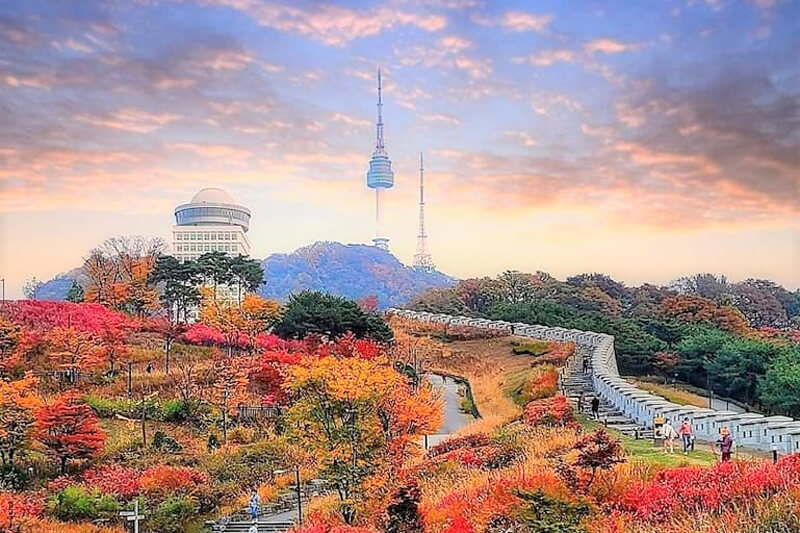
Seoul offering a modern yet traditional lifestyle should be the first place in your south Korea itinerary for 10-days. The Seoul trip for two days will be your first step in familiarizing yourself with the city’s cultural, historical, and traditional sides. Take the first day slow and visit the royal palaces and UNESCO sites. You can start your trip with Gyeongbokgung Palace, and then continue to visit Cheonggyecheon Stream, Gwangju Traditional Market, and Insadong Shopping Street.
Gyeongbokgung is one of the most popular and oldest palaces in Seoul . This served as the main official palace during the Joseon dynasty. The entrance fee to the palace is $2.50 and you can also rent hanboks if you want great pictures in the traditional dresses. After the tour head over to the Cheonggyecheon Stream where you can enjoy a nice walk and enjoy the art murals, greenery, and scenic beauty.
Make your way to Gwangju Market, where you will be enjoying a whole array of foods. Some of the famous foods there as one of the oldest markets in Seoul are bindaetteok, mandu-guk, and bibimbap. From there you can go to visit the traditional Bunchon Hanok village.
For Day 2 in Seoul , start your day with a delicious breakfast in Hongdae. Hongdae is a vibrant area where young people hang out and Hongdae shopping street is also a great area to hang out. From there you can go to museums of the city and during the sunset hike up the N Seoul tower where you will enjoy the beautiful city’s nighttime landscape view. You can also have an amazing dinner on the restaurants of N Seoul tower.
Day 3: Trip to DMZ
The DMZ tour from Seoul takes a whole day. You must keep aside a one-full day for this historic area. You can only have guided tours of the DMZ area. The Demilitarized Zone portrays the rich history of the Korean Wars. The DMZ tour packages are available from $25. Visit the freedom bridge, DMZ exhibition hall, and other monuments. You will get a brief recap of the historical moments throughout the trip to DMZ.
Day 4 & Day 5: 2 Days in Andong
By Korean standards, it’s a long journey between Seoul and Gyeongju . For this itinerary, there’s no better place to break up the trip than Andong. Long known for its traditionalism, Andong is a center of culture and folklore. It’s one of the best places to visit in South Korea for a glimpse of its ancient past.
For Day 1: Explore the impressive grounds of the historic Neo-Confucian Academy with a trip to the historic Dosan Seowon and for Day 2: Admire a stunning view of the surrounding natural landscapes from the top of the Buyongdae Observatory.
Also, the Woryeonggyo Bridge, a wooden footbridge crossing the Nakdong River, provides breathtaking views of the surrounding mountains and is a popular spot for photographers and nature enthusiasts.
Day 6: 1 Day in Gyeongju
No place during your 10 days in South Korea will live up to expectation better than Gyeongju. This fascinating city is nothing short of the cultural and spiritual heart of Korea. Gyeongju checks off all the boxes that drove you to visit South Korea in the first place.
Compared to the hubbub of Seoul and brash Busan, Gyeongju is a relaxing respite. And it’s as fulfilling as either. The top attractions in Gyeongju are spread far & wide. They encompass some of Korea’s finest cultural moments. Tumuli Park is one of the few Gyeongju tourist attractions smack dabs in the middle of town. The park is an ancient burial site. About two dozen Korean royal tombs sprout from the earth here.
Day 7 & Day 8: 2 Days in Jeju Do
Jeju is South Korea’s one of the most vibrant islands to experience beautiful braces, local markets, and more. On the first day arriving in Jeju, you can visit the Jeju Folklore and Natural Music and Halla Arboretum. And you can then visit the Jeju five-day folk market and Dongmun Traditional Market.
The next day you can catch the sunrise at Hallasan or at Sarabong Peak early in the morning. Then you can go visit the Hamdeok beach and Manjangul cave. There are a lot of places to explore in the south of Jeju-do and you will have a refreshing experience while travelling here.
Day 9: Busan
Busan is one of those take-it-or-leave-it places. Apparently, suggests that anyone should fall in love with, or even like, this brash Korean port city. And that’s usually where the story ends. When you are in Busan, don’t leave out the bustling J agalchi Fish Market.
It’s one of the city’s top cultural attractions, and an absolute must-see and must-do. This is not just the port city’s most significant market; it’s the biggest fish market in South Korea. All types of seafood caught around the Korean peninsula find their way to the market stalls of Jagalchi Fish Market .
With your trip coming to close soon, make time to fit one more temple into your Korea itinerary : Beomeosa Temple. This ancient temple is Busan’s top tourist attraction. The original temple was founded in AD 678 by Ui Sang, a monk in the Jogye Order of Korean Buddhism. It has since been rebuilt multiple times. Most of the current buildings hail from the 16th and 17th centuries.
From stone pagodas to ornate wooden gates, the beauty of the city entrances you. The temple also benefits from a spectacular location. It sits at the foot of Mount Geumjeongsan. Visiting Beomeosa Temple, it’s easy to forget you’re in Korea’s second-biggest city.
Day 10: Departure
On Day 10 return to Seoul, and get your things packed. On the last day you can visit some famous places in Seoul or have a last traditional meal of Korean cuisine. You will have a lot of memories and an experience of Korean culture by the time you live.
Most Popular Tourist Attractions in South Korea
There are a lot of beautiful places across South Korea where you can experience a diversity of landscapes, culture and food. Taking a trip to South Korea is a phenomenal way to experience the joys of life. Here are the top few tourist attractions and landmarks of South Korea that any first-time traveler must cover.
DMZ is a zone between South Korea and North Korea near the 38th parallel north. And the demilitarized zone is a walk through the history for tourists where you can understand the value of the war history of the country. This area works as a buffer zone between two countries and is a place for maintaining political peace.
Changdeokgung Palace:
One of the most popular UNESCO sites in Seoul is the Changdeokgung Palace. Changdeokng Palace is an official residential building built in the Joseon dynasty. This complex was built as a secondary palace from Gyeongbokgung Palace to have the administrative work done.
Gyeongbokgung Palace:
The Gyeongbokgung palace is a South Korean first palaces for administrative work. It was built in 1935 in Hanyang, currently the heart of Seoul. This is quite famous for taking pictures in hanbok, traditional korean dress and visiting the historical settings, and artefacts. At the entrance, you will also find the historical Gwanghwamun gate located at the three-way intersection.
Hwaseong Fortress:
Hwaseong fortress is a one-of-a-kind brick and pilestone fortress made in Joseon dynasty. It’s located in the centre of Suwon, a few kms away from Seoul. It was built by King Jeongjo to honour his father, Prince Sado.
Namsan Tower:
Namsan tower located in Seoul is an observatory tower on the highest hill in Yongsan-gu district of Seoul. It gives undeniably the best view in the city and is worth a visit. The lovelocks there for couples are also quite famous. You can also enjoy the views from the cafe or the restaurant on the N Seoul tower.
Lotte World:
Lotte World is a major theme park in Seoul with indoor and outdoor rides, shows and parades, and an aquarium. If you have come here with children, taking a day to go to Lotte world will really make the trip a lot of fun. The aquariums, ice rink and parades are a true treat to kids.
Jeju Island:
Jeju Island is one of the most peaceful and pleasant natural spaces that you can visit. It is one of the most beautiful volcanic islands on the planet Earth. Top attractions in Jeju-do are the lava tunnels, Hallasan, Cheonjiyon waterfall, and the hiking trails.
Nami Island:
Nami Island has gained popularity as a scenic and romantic spot, and you can go there to enjoy cherry blossoms and the tree-lined pathways are quite romantic during Autumn and Spring. You can also enjoy different types of activities like cycling, zip lining and boating in Han River.
Traditional Villages:
There are a beautiful Korean village like Bukchon Hanok, Yongin-si in Seoul where you can get roam around the beautiful streets, visit artisans and traditional arts.If you travel to Andong during your trip, you must visit Andong folk village to visit the Andong folk museum, thatched house. You can also visit the Jeonju-si for old shrines, Boseon-gun in South Jeolla province for the entrancing beauty.
Dodohaehaesang National Park:
Dodohaehaesang National Park is the largest natural park in South Korea and if you are a nature lover you will have a great time as there are 1500+ plant species and 1200+ animal species. The scenic beauty of the island the park is located on is all the is also an attraction.
National Museum of Korea:
National Museum of Korea has collections of Korean traditional products, and you will find a lot of art exhibitions going on every day worth visiting. You will see the collection of art, artifacts, and crafts from Korean and international artists at the National Museum.
South Korea Food Markets
South Korea has a lot of vibrant food markets which are worth visiting for tasting local foods and get immersed in the local lifestyle. A few of the top South Korean food markets are Gwangjang Market, Namdaemun, and Dongdaemun Design Plaza in Seoul for tasting the most famous traditional foods. You may also visit the jagalchi fish market in Busan for fresh fish and seafood and tasty foods.
Budget for South Korea 10-Day Itinerary
Your travel tastes, style, and the time of year you intend to travel all affect how much money you allocate for a 10-day itinerary in South Korea. I can give you a general idea of the expenditures related to a traveler on a medium budget, though. Please be aware that these projections were created using pricing as of my September 2021 update and may have altered since then.
Accommodation: The price of lodging can change based on the area and the type of lodging you select (hotels, hostels, guesthouses, etc.). Budget travelers should budget $30 to $100 per night for a mid-range hotel or guesthouse, on average.
Food: There are numerous culinary alternatives available in South Korea at various pricing brackets. For roughly $5 to $15 each meal, budget-conscious travelers may savour delectable street food and regional cuisine. The price range for meals at mid-range restaurants could be between $15 and $30.
The public transit system in South Korea, which includes buses and subways, is good. Spend between $100 and $150 on transport over the course of ten days, which includes getting around cities and possibly taking the train to various locations.
Activities and Sightseeing: Different attractions and activities have different entrance prices. Budget, on average, $5 to $20 per attraction. You can budget between $100 and $150 for this category if you’re going to numerous paid attractions.
Shopping and souvenirs: Depending on your shopping tastes, this expenditure can vary greatly. Budget travelers should set up $100 to $200 for shopping and souvenirs.
Other: It’s a good idea to have some extra cash on hand for unanticipated costs like tips, extra snacks or drinks, or any emergency requirements. Set aside between $100 and $200 for other costs.
Without factoring in international flights to and from South Korea, a ballpark estimate for a 10-day moderately priced vacation in South Korea could vary from $800 to $1,000. Remember that this is only a rough estimate, and that the actual cost of the trip may change depending on your choices. It is advised to conduct detailed pricing and expense research for your planned route and travel duration in order to obtain a more precise budget.
Related Posts
New zealand itinerary & tour packages to design the perfect vacation, macau trip itinerary: experience the perfect visit, the best 4-day hong kong itinerary: explore the city’s highlights, the best 10-day japan itinerary: exploring tokyo, kyoto, and osaka.
Save my name, email, and website in this browser for the next time I comment.
This site uses Akismet to reduce spam. Learn how your comment data is processed .
Type above and press Enter to search. Press Esc to cancel.

Gina Bear's Blog
Solo Female Travel | Latina Traveler
The Best 10 Day South Korea Itinerary For First Timers
After living in Korea for almost six years, I am your Korea trip expert. This is going to be the most comprehensive 10 Day South Korea Itinerary you’re going to find on the internet. I know what I’m talking about because I’ve personally experienced the Korean language, culture, and society.
The Korean peninsula is one of the most beautiful places you’ll ever encounter. I personally love East Asia (as I lived in both Japan and South Korea). The best thing about South Korea is the ease of being able to get to different parts of the country.
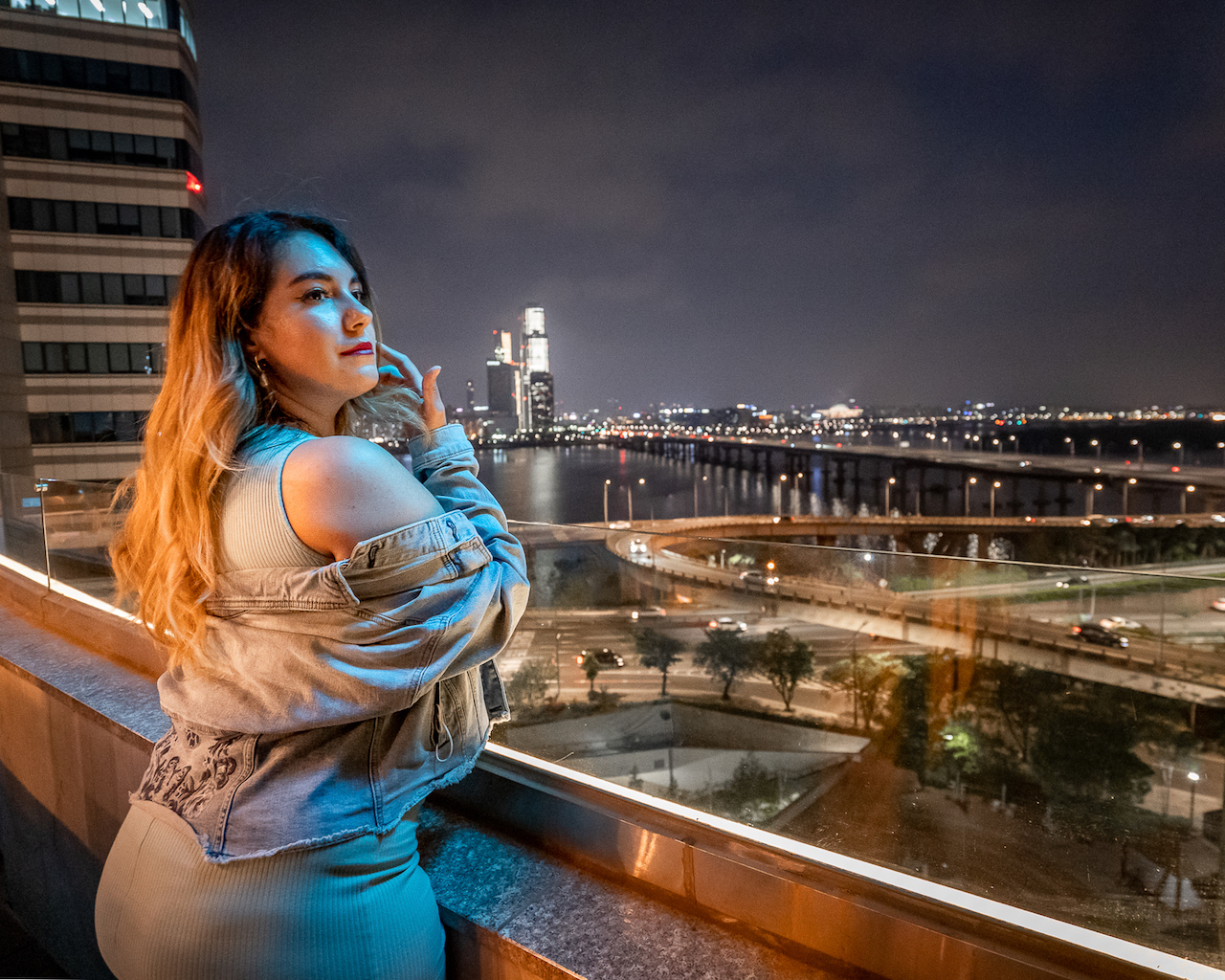
Table of Contents
Blog Posts You Might Like
- 50 Amazing Things To Do in Seoul
- The Best Day Trips From Seoul
Where To Stay in Seoul
When is the best time to visit south korea.
There’s always something happening in Seoul no matter what season you visit. The perfect time to travel spring for all the amazing cherry blossom festivals and autumn for the incredible fall foliage.
Spring in Korea
Korea in spring brings all the beautiful flowers. Since cherry blossom season in Korea is so short you have a very short window to catch them all. In addition, you can visit many different Korean spring flower festivals. Also, shop for the coveted Starbucks Cherry Blossom collection because it sells out super fast. The temperature during this time is comfortable, but prices are more expensive since many Asian holidays happen around this time of year.
- Spring in Seoul | What To Pack for Spring in Korea
- The Best Korean Spring Festivals
- The Ultimate Guide To Spring in Korea
- Where To See Cherry Blossoms in Seoul

Summer in Korea
Like everywhere around the world, Korea in summer is peak tourist season. The best time for Korea summer travel is June and September. July and August bring rainy season so expect to be very moist. recommend visiting Jeju Island as it is perfect to hit the beach and have a cheap staycation.
- Summer in Seoul | What To Pack For Summer in Korea
- The Ultimate Guide To Summer in Korea
- What To Do During Rainy Season in Korea
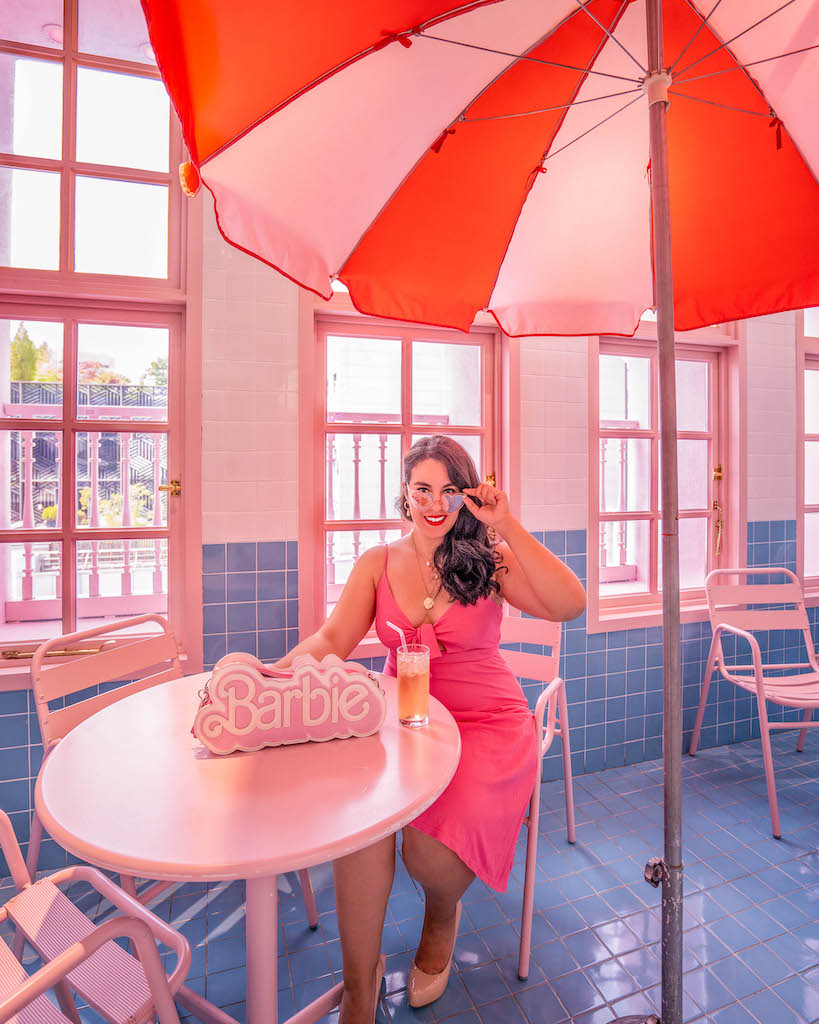
Autumn in Korea
Korea in autumn turns trees bright colors of red, yellow, and orange. September in Seoul still sees many tourists but starts to trickle out in October and November. Fall is shoulder season in Korea as it doesn’t see many tourists. Chuseok (Korea’s Thanksgiving) is around this time. Everything shuts down as Koreans travel back to their hometowns to celebrate with their families. I recommend doing a lot of hiking in Korea’s mountains and traveling to traditional cities like Gyeongju for the best fall in Korea experience.
- The Best Autumn in South Korea Festivals
- The Ultimate Guide To Autumn in Seoul
- Seoul in Fall | What To Pack To Korea in Autumn
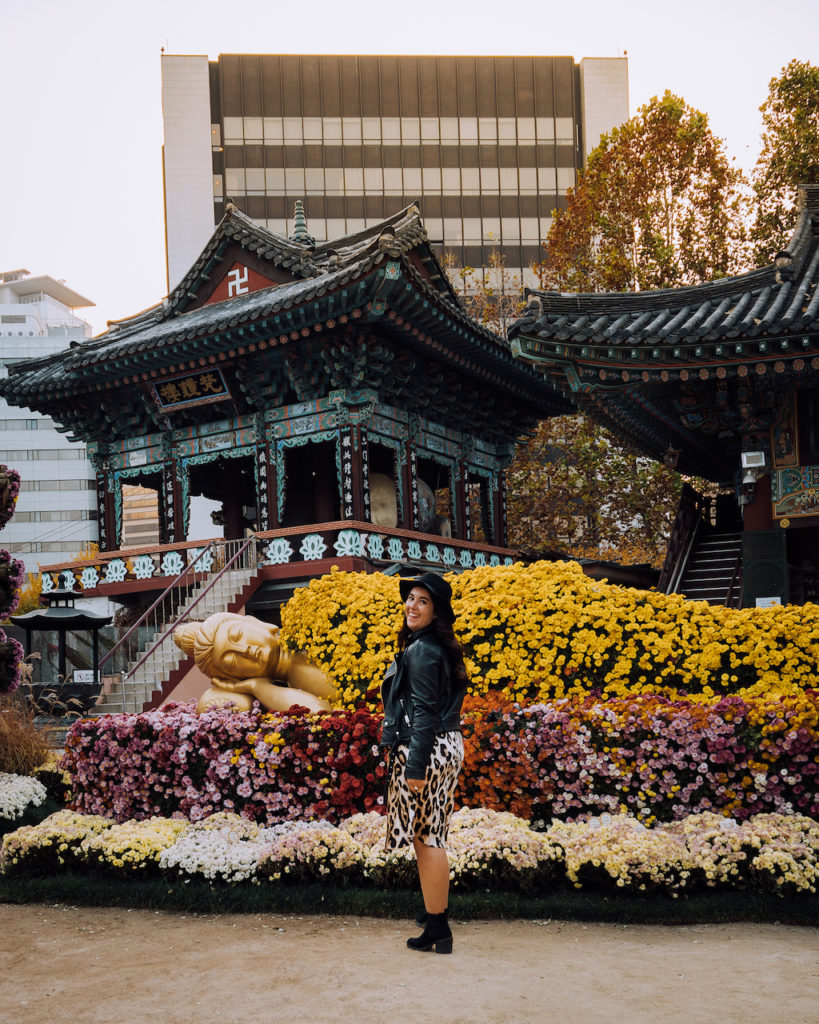
Winter in Korea
Believe it or not, winter in Korea is a great time to visit. Flight prices drop except for around Christmas. Visit early December when the Christmas displays and illuminations decorate Seoul. The Lotte World Theme Park and Everland offer foreigner discount tickets. There are also incredible Korean winter festivals to check out.
- Cool Winter Festivals in South Korea
- The Ultimate Guide To Christmas in Korea
- The Ultimate Guide To Winter in Korea
- Winter in Seoul | What To Pack For Korea in Winter
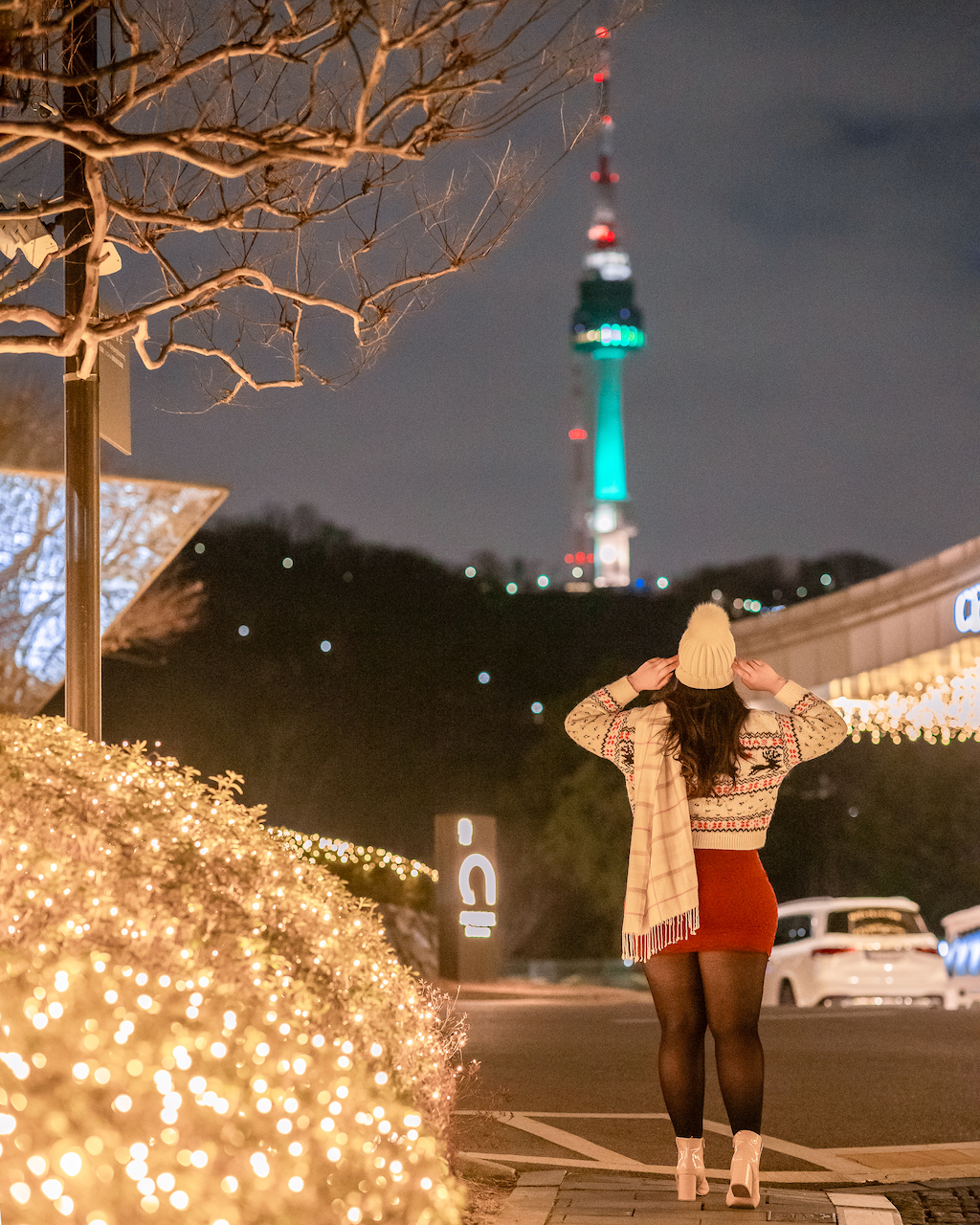
Before You Visit Korea
A trip to the other side of the world takes careful planning and consideration. In this section, I’m going to break down what to pack, apps you need for Korea, and how to get a sim card.
How To Book a Flight To Seoul
Korea high season travel is from June to July. Plane tickets are most expensive during these months. The cheapest month to fly to South Korea is in March. A flight to South Korea from Los Angeles is typically about 13 hours and 30 minutes. (It’s a pretty long distance, but totally worth it.)
What To Pack For Korea
I highly recommend packing as light as possible so that way when you buy all of your favorite Korean products, there will be room in your suitcase. My favorite travel suitcase brand is Béis . I’m obsessed with their weekender bag, carryon, and checked luggage. Use my code for $15 off your first order and 150 points toward your new account .
I also have an ultimate guide for what to pack to Korea in every season .
Travel Essentials For 5 Days Itinerary In Korea
- Korea travel adapter – Korea uses 220V plugs. Daiso has them for 5,000 won.
- Unlocked phone – Book a simcard before you visit Korea and pick it up at Incheon Airport.
- USB power strip – This is great for charging multiple electronics at once.
- Air Filter Mask – The air pollution in Korea is bad, and on its worst days can be on par with China.
- World Nomads Travel Insurance – Give yourself the peace of mind. Many travel insurance companies have flexible COVID-19 cancelation plans.
- Toothpaste – Korean toothpaste sucks. I don’t like it and it doesn’t leave my mouth feeling clean. Bring your own from home.
- Important documents – Bring copies of any important medical documents and a copy of your passport. Leave one copy on your fridge just in case.
- Your passport – This should be a given, but please don’t forget it.
- Credit Cards/Debit Cards – There are ATMs all over Korea and most places accept credit cards.
- Medication – TSA allows you to bring essential medication in your carryon.
Apps You Need To Download For South Korea
Your 5 days in South Korea itinerary will be so much more complete with apps to make your life easier. These were the apps I personally have used to make my day to day life easier.
- Naver Maps – This is your one and only warning. GOOGLE MAPS DOESN’T WORK IN SOUTH KOREA. You need to use Naver Maps which is available in English. Naver Maps for iPhone | Naver Maps for Android
- Kakaotalk – If you want to connect with some cool people you’ve met in your travels, Kakaotalk is the best way to do so. Kakaotalk for iPhone | Kakaotalk for Android
- Kakaotaxi – This app makes it easy to call taxi drivers. The starting fee for taxis is about 3,000 won. Kakaotaxi for iPhone | Kakaotaxi for Android
- KakaoMaps – This is very similar to Naver Maps so just choose one. I recommend downloading both because sometimes you’ll get address links for this app too. KakaoMaps for iPhone | Kakaomaps for Android
- Kakaometro – Have you noticed there’s a trend here with Kakao? They’ve made some pretty amazing apps and this is also great for navigating the subway. Similar to Subway Korea, you’ll get train times, arrival information, and train transfer data. Kakaometro for iPhone | Kakaometro for Android
- Subway Korea – This is one of my favorite apps for navigating the subways. It will give you the times the train will come, what time you’ll arrive at your destination, and which car to sit in for easy transfers. Subway Korea for iPhone | Subway Korea for Android
South Korea Sim Card
South Korea has insanely fast internet fast and free Wifi everywhere. I do recommend you get a sim card so you can connect to Wifi in the subway. There are 3 major carriers in South Korea—KT, SK Telecom, and LG U+. You can easily book a physical South Korea sim card here. Your options range from 1 day to 30 days. You will get unlimited data with this purchase and you can add on a phone number and minutes to call.
Get An E-Sim Card for South Korea
One of the coolest things I discovered in my travels is the beauty of an E-Sim card. Why is it so great? It gets downloaded directly to your phone and is activated immediately. This works best if your phone is unlocked. You can purchase an E-sim card for Korea here.
Get Pocket Wifi
If your phone is locked and you’re unable to switch sim cards out, the next best option is to rent pocket wifi. This is also great if you’re traveling with a friend or have multiple devices to connect. Book your pocket wifi here.
Book The Discover Seoul Pass
One of the cheapest ways to travel Seoul is by investing in the Discover Seoul Pass . You can choose the digital card or physical one. The pass doubles as a T-Money card which can be used on public transport like subways, buses and taxis. It can be topped off in any convenience store and train station kiosk. Plus, it comes in increments of 24, 48, and 72 hours. The Discover Seoul pass grants you free entrance into Korea’s top attractions.
Worried About The Korean Language Barrier?
A language barrier may seem scary during 5 days in South Korea. These apps, products, and courses are all things I’ve used and tested myself.
- Google Traslate – This is a free app where you can put in your mother tongue and target language. You can also take photos and Google will translate. Google Translate for iPhone | Google Translate for Android
- Naver Dictionary – Naver Dictionary is more precise than Google Translate because it was made as a language learning tool for English. Naver Dictionary for iPhone | Naver Dictionary for Android
- Papago – A free app developed for Koreans. I often used it to help translate difficult sentences and phrases. Papago for iPhone | Papago for Android
- 90 Day Korean – If you’re planning a trip months in advance, check out 90 Day Korean. Their course is set up to have a 3 minute conversation with a native speaker of Korean after 90 days.
- How To Learn Korean Easily – This blog post covers all the resources I used to learn and study Korean. You’ll get a list of my favorite tools, websites, books, and apps.
The Pocketalk is a super cool device as it translates 82 different languages in real time. It even has a text to translate camera. This is great for helping you navigate around Seoul. What I like most is its small enough to fit in your pocket or in your purse. You can buy your Pockettalk here.
World Nomads Travel Insurance
Sadly, COVID-19 is here to stay and now a daily part of life. I recommend booking World Nomads Travel Insurance . With the World Nomads Travel Insurance, you can expect:
- Trip Cancelation – This benefit helps you recover non-refundable, pre-paid trip costs when you have to cancel your trip for a covered reason, including for an unexpected sickness that keeps you from traveling.
- Emergency Medical – The only thing worse than catching COVID-19 is getting infected away from home. If you get sick with COVID-19 or another illness, you can get diagnostic tests to confirm your case and other emergency medical benefits.
- Medical Evacuation – If you’re in an inadequate medical facility, our plans have benefits that can arrange a transfer to a hospital capable of treating your medical needs.
- Trip Interuption – During your travels, you might have to return home early. With trip interruption, you could get reimbursed for a one-way, economy-class ticket home and any pre-paid, unused portions of your trip if you need to change your plans for a covered reason.
- Trip Delay – Even when there isn’t a pandemic, traveling can have its bumps and hiccups. If your travels are delayed at least six hours by a covered event, you can be covered.
Arriving in South Korea
You’ll arrive at Incheon International Airport. It is very easy to get to central Seoul from the airport.
If you didn’t book the Discover Seoul Pass , then you should get a T-money or Cashbee card at the convenience store. Or you can book a digital T money card online here so you don’t have to deal with it when you arrive. These are basically reloadable public transport cards. They cost 5,000 won and you can reload the card at any train station kiosk or at the convenience store.
How To Get From Incheon Airport to Seoul
Getting to seoul by train .
If you take the train, there are two ways to get to Seoul. One is by the all-stop train (which takes forever) and the Express Train. You can check the airport train schedule here.
- Express Train – The Express Train travels non-stop from Incheon Airport Terminal 1 Station and Terminal 2 Station to Seoul Station. To take this train, passengers must purchase an Express Train Pass (or have the Discover Seoul Pass ). A discount is available to passengers who present flight tickets from Jeju Air, Korean Air, Asiana Airlines, or T’way Air. Cost: 9,500 won adults | Runs: every 43 minutes
- All-Stop Train – The all-stop train makes stops at all subway stations from Incheon Airport Terminal 1 and Terminal 2 Stations to Seoul Station. Six of the subway stations allow transfers to other metropolitan area subway lines. To take this train, passengers must use a transportation card. International visitors may also use the foreigner-exclusive prepaid transportation card MPASS. Cost: 4,150 won | Runs: every 59 minutes
Getting To Seoul By Airport Bus
Airport buses run from Incheon International Airport to many areas of Seoul. Tickets can be purchased at ticket booths just outside the 1F Arrivals Hall of each terminal. Detailed inquiries on bus routes and bus stops can be made here.
- Check bus routes and purchase tickets at the ticket booths located at the Arrivals Hall (1F) of Terminal 1 near Gates 4 & 9 or outside by Gates 4, 6, 7, 8, 11 or 13.
- Tickets at Terminal 2 can be purchased from the bus terminal at the Transportation Center (B1F)
- Check the bus boarding number indicated on the ticket.
- Go to the bus boarding location and double check the bus route and departure time.
- Once aboard the bus, listen carefully to the English announcement for your stop.
There’s help kiosks located all around the airport if you get lost or have a question. You can also check the Incheon Int’l Airport Bus Guide (Korean, English, Japanese, Chinese).
Getting To Seoul By Private Transfers
There are different kinds of taxis that can take you into Seoul.
- Regular Taxi – Base fare begins at 3,800 won (Seoul standard) with a 20% increased charge from the base fare at nighttime (24:00-04:00).
- Deluxe & Jumbo Taxi – Base fare for deluxe and jumbo taxis begins at 6,500 won. There is no additional nighttime charge.
- International Taxis – International taxi fares are fixed according to region with regular taxi fares ranging 65,000 – 90,000 won, and deluxe and jumbo taxis run from 95,000 – 130,000 won.
Pro Tip: If a taxi driver tries to take advantage by demanding an inflated fare, report the incident to Seoul Global Center (+82-2-2075-4180), which offers services in English, Japanese, Chinese, Russian, Vietnamese, Mongolian, Filipino, Uzbek, and Thai. You can also report your complaint to the Dasan Call Center (+82-2-120), which offers services in English, Japanese, Chinese, Vietnamese and Mongolian.
How To Get Around Seoul
- Subway : The subway is owned by the government so the fares for each line are standardized. Fares start at 1,250 won and cost about 100won – 300won to transfer to another line. The trains run all day, but are closed from midnight to 5:30am.
- Bus – If you’re a first time tourist to Seoul, I would avoid taking the bus; however, if you’re up for the challenge, use Naver Maps. It will tell you where the bus stop is and the bus stops also have information about when the next bus will come. It also costs 1,250 won to get on the bus and 100won – 300won for transfers. If you find yourself stranded without a subway, then you can ride the M Buses at night.
- Taxi – The base fare starts at 3,000 won and goes up from there. They’re a little more expensive to ride at night, but they are available 24/7.
- Seoul Bike – These are public bicycles that can be found all over Seoul. It costs 5,000 won to rent for the day. For more information and a comprehensive guide on how to rent, click here .
- Electric Scooters – There’s a lot of walking in Seoul, but luckily there are a lot of bike paths as well. There are three companies you can rent an electric scooter from in Seoul— Lime , Beam , and Kickgoing (Korean only). Korean law requires you to scan your driver’s license before renting.
Safety in South Korea (10-Day Itinerary South Korea)
South Korea is a very safe country for solo female travelers. Just be aware crime still happens despite the safety ratings. According to Global Finance, Korea has a safety index score of 8.93. This means you will find CCTV everywhere and Koreans in keeps themselves in check. One of the things I enjoy most is being able to leave my valuables on a table and no one will try and steal it.
Check out my post on Where To Stay in Seoul for a detailed guide on booking accommodation in South Korea. You’ll get recommendations for every budget and what each area offers. However, if you’re in a hurry, here’s a mini Seoul city guide.
- Gangnam – Best area to stay in Seoul for luxury travelers.
- Hongdae – For budget travelers to find a cheap hotel room, night life lovers, and foodies.
- Insadong – Traveler who love culture and unique Korean experiences will thrive here.
- Itaewon – For those who don’t want to stray far from home comforts.
- Jamsil – Perfect for families and low key travelers.
- Myeongdong – This is the best neighborhood for Korean food, skincare, and clothes.
Day One in Seoul (10-Day Itinerary South Korea)
For your first day of this 10 day South Korea itinerary, bring your best pair of sneakers because you’ll be doing a lot of walking in the capital city. The pavement is often uneven your gym shoes will protect you from accidents.
Rent a Hanbok at Hanboknam
I recommend experiencing Korean culture and Korean history. One of the best ways to do this is by renting hanbok. A hanbok is a traditional Korean dress. For everything you need to know about renting hanbok in Seoul, click here . Did you know you can get free admission into all the royal palaces by wearing hanbok?
Hanboknam provides hanbok up to a US size 16. The larger sizes leave much to be desired in terms of how pretty they are. In addition, they do have shoes available to rent if you can fit. The largest they go up to is a US size 8. You can book your Hanboknam hanbok rental here.
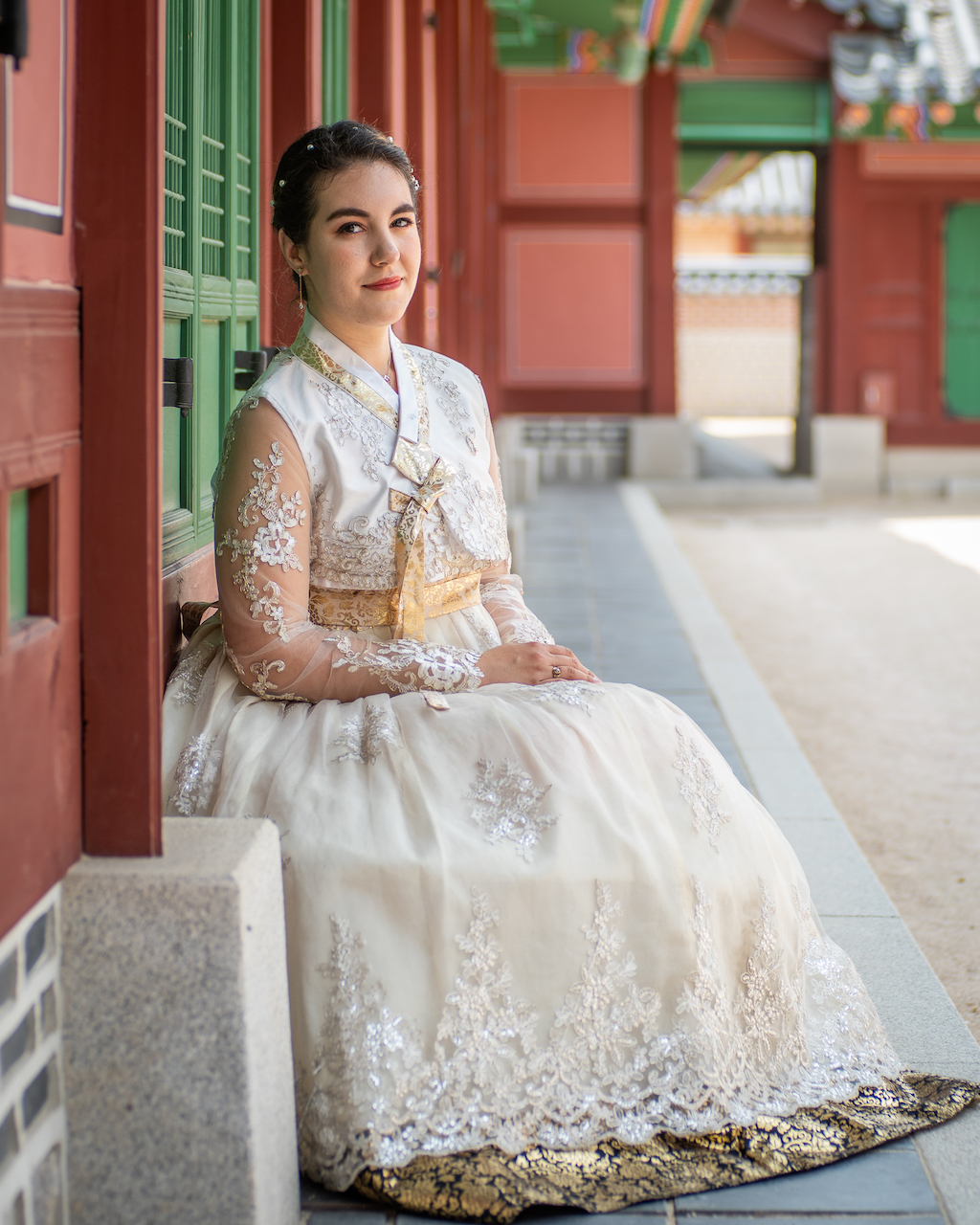
Gyeongbokgung Palace
This is the most beautiful of the palaces and was the main palace during the Joseon Dynasty. A Seoul travel hack is to get the Discover Seoul Pass. If you’re one of those travelers that has to do everything, then I promise you’re going to get the most bang for your buck.
This pass includes a free hanbok rental at Hanboknam. You can also use it to enter Gyeongbokgung without having to wait in the long ticket lines. While at Gyeongbokgung, visit the National Palace Museum of Korea to learn about Korean culture and rich history. The palace grounds are huge, but they’re beautiful.
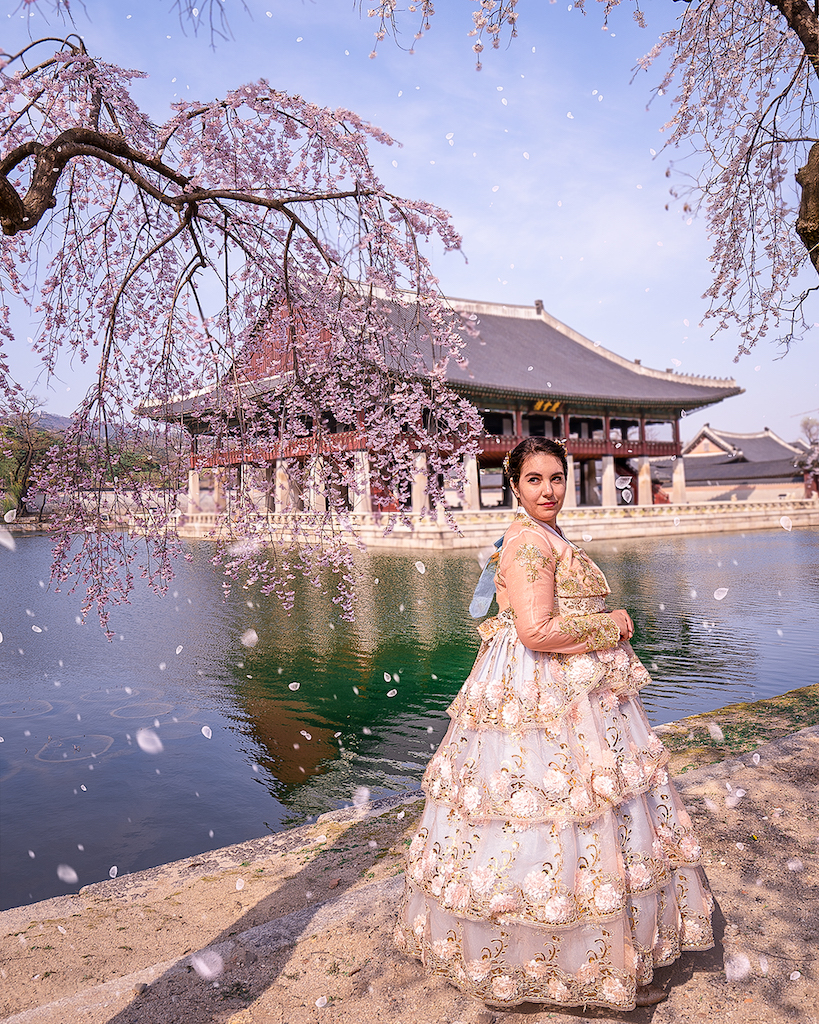
Insadong
Insadong is best for buying souvenirs and local artwork. It’s the only street featuring exclusively Korean signs and no English. You’ll also find very tasty traditional Korean food for cheap. My favorite restaurant for tasty Korean food is called Insadong Geujip . During peak tourist season, you can also find a lot of Korean traditional acts performing on the street from sword fighting to dancing. It’s close to Ikseondong which is about a seven minute walk.
What To Do in Insadong?
- Color Pool Museum
- Make a Traditional Korean Name Stamp
- Korean Rice Wine (Makgeolli) Tasting Tour
- Insadong Half Day Food Walking Tour
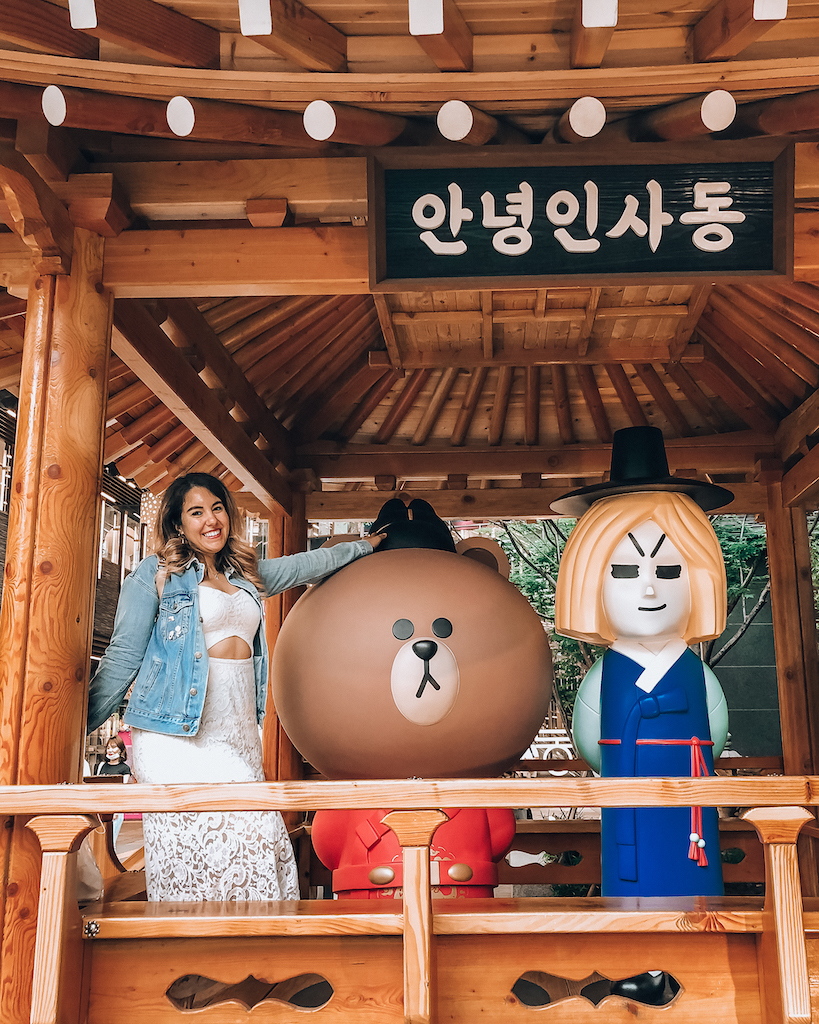
Ikseon-dong Hanok Village
Ikseon dong should be on your to-do list. This is a really trendy hanok village with amazing cafes, restaurants, boutiques and entertainment. It really gives you that old Seoul feel while walking around the narrow alleys. At night, it’s also a great place to go drinking and to eat Korean bbq at a local restaurant. For a full guide on everything you need to do in Ikseondong click here .
What to do in Ikseondong?
It’s really easy to spend a good chunk of your afternoon walking around the Ikseondong Hanok Village. Take your time to explore all the great cafes and views the area offers.
- Insadong & Ikseondong Makgeolli Tasting Tour
- Ikseondong Walking Food Tour
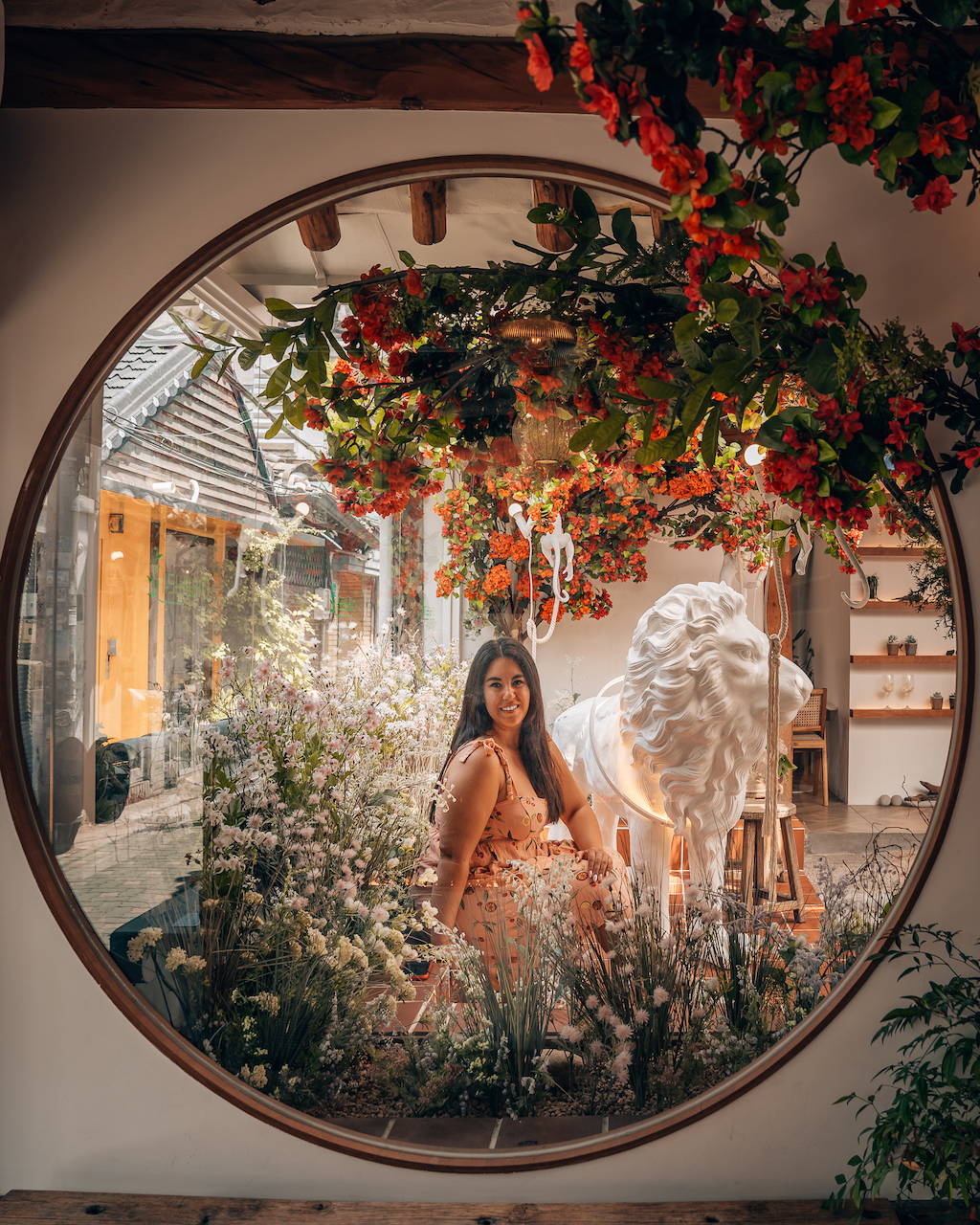
Have A Drink At Moxy Hotel’s Rooftop Bar
Your Seoul itinerary should include at least one rooftop. I went here for my birthday and you get the most amazing view of the Ikseondong Hanok Village. This is also a really fun place to stay with all of its fun and modern decorations. Book your stay at the Moxy Ikesondong here.
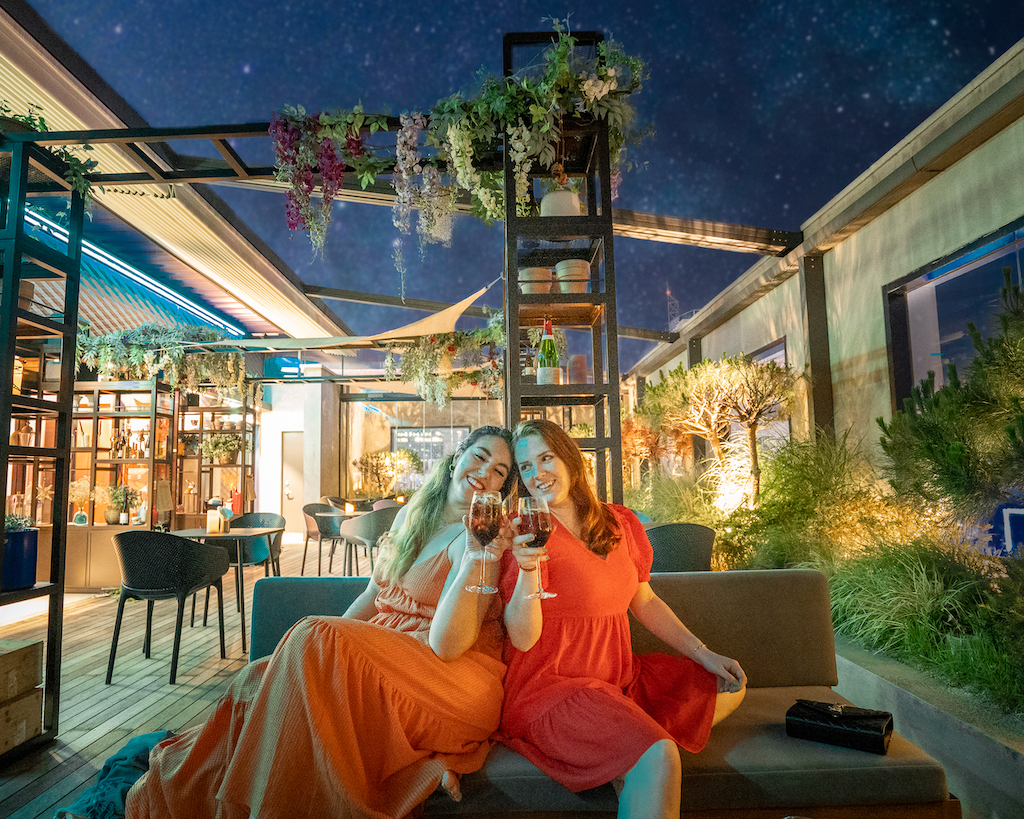
Day Two in Seoul
Next on our itinerary in Seoul, we’re going to visit more historical sites. Even though a lot of the traditional Korean places are located in one area, it’s still a lot of walking. Also, you’re going to want to take your time and learn about Korea’s history, culture, and take amazing photos.
Changdeokgung Palace
This is one of the largest palaces in Seoul not because of the buildings, but because of the gorgeous Secret Garden. It’s also a UNESCO World Heritage Site. It costs 3,00 won to enter the palace. Or if you’d like to delve deep into the history and culture of Changdeokgung and the surrounding Bukchon Hanok village, you can do a guided tour .
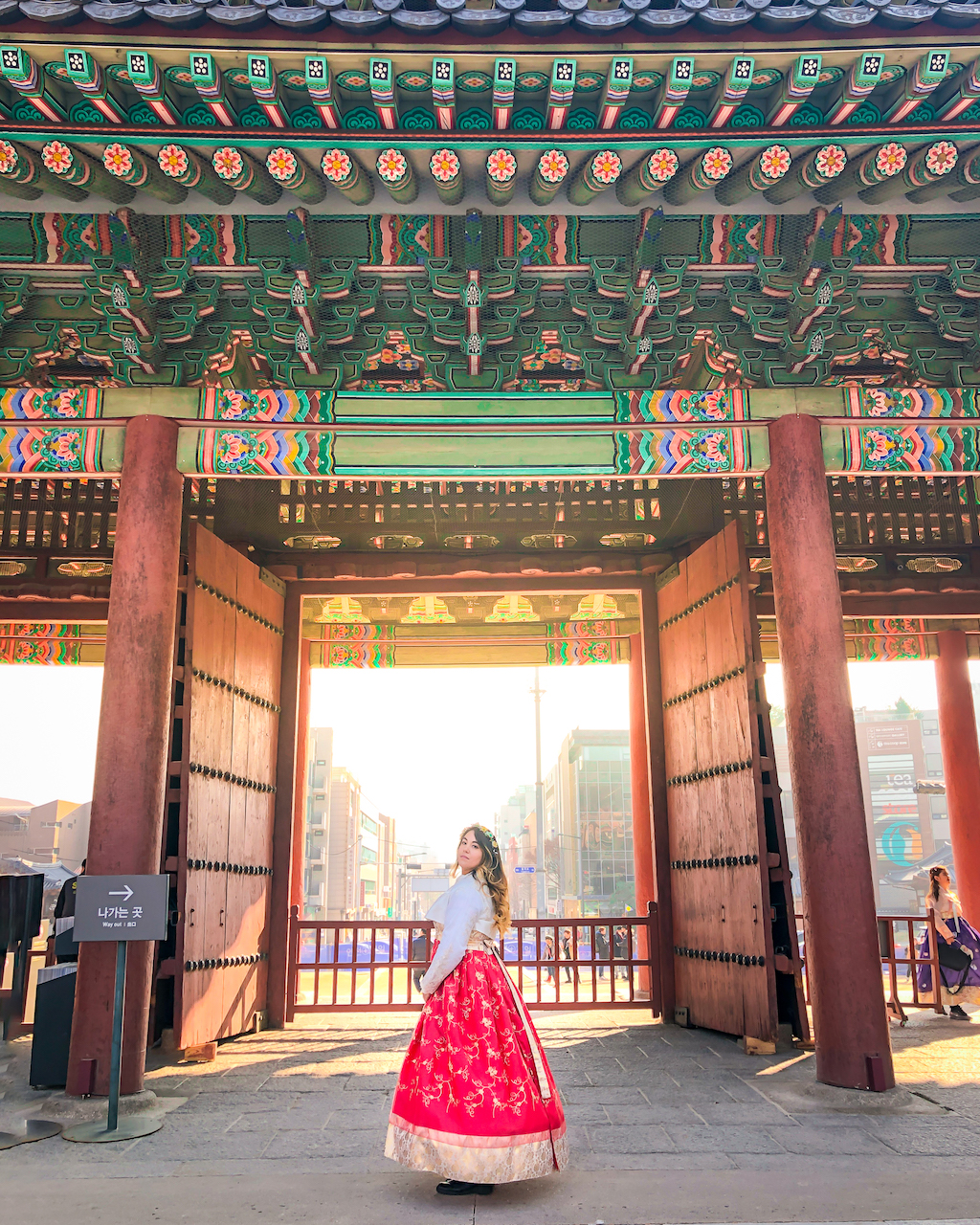
Secret Garden Tour
This is the highlight of visiting Changdeokgung. The royal family used the garden as a place of rest since the reign of King Taejong (1400 to 1418). They would come here to contemplate life, write poems, and hold banquets.
Pro Tip: Two of the most popular times during the year to visit Changdeokgung are during cherry blossom season and autumn when the foliage makes the garden come alive with gorgeous colors. Book tickets to the garden in advance or during the week at 9am.
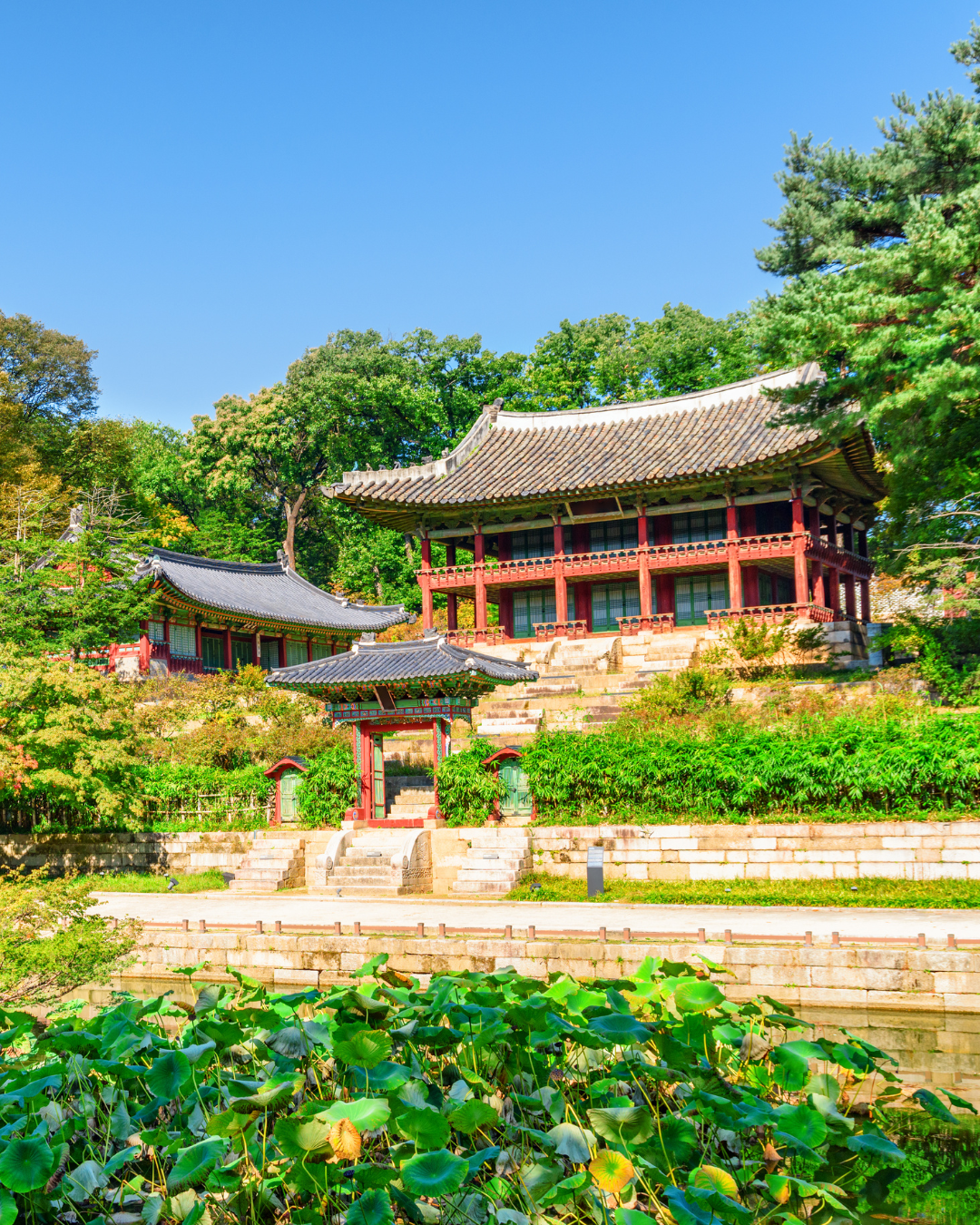
Jogyesa Temple
Jogyesa Temple is one of the oldest Buddhist Temples in Korea and a symbol for Buddhism in Korea. It’s located in the heart of the city and is still an active temple today. While you stroll the grounds, you’ll most definitely catch Buddhist services. Just a note, the temple becomes decorated with beautiful and brightly colored lanterns around Buddha’s Birthday.
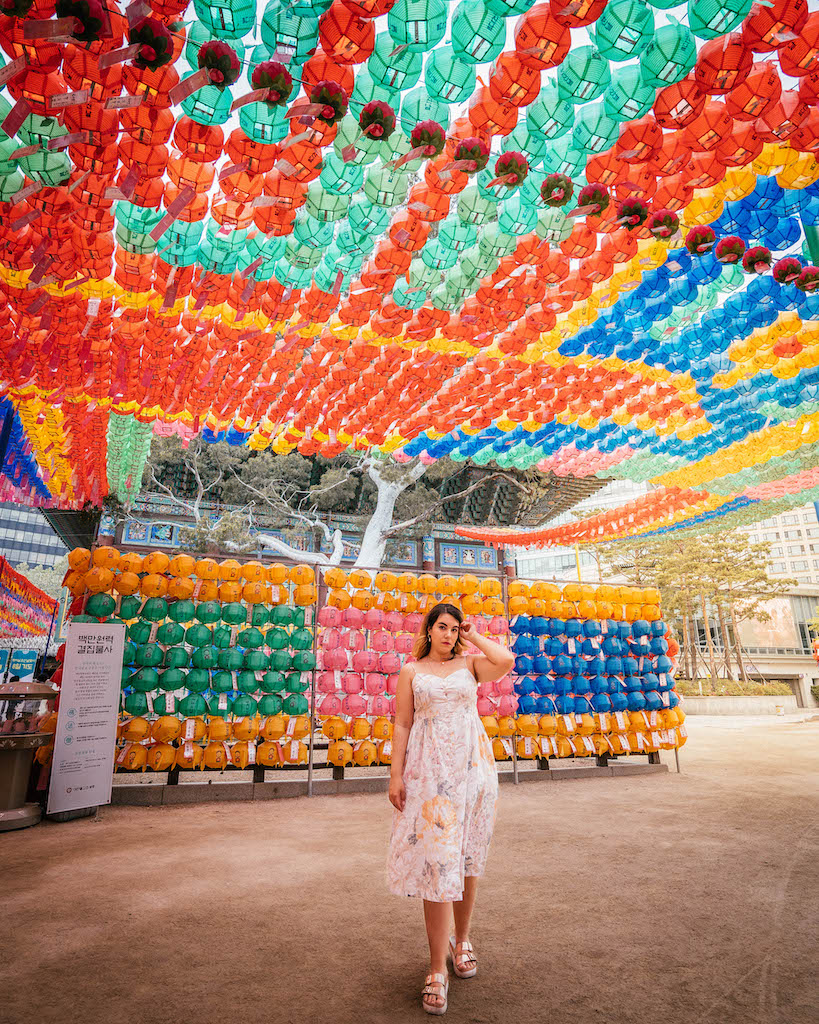
Bukchon Hanok Village
Bukchon is full of beautiful traditional hanok homes. Hanok are Korean traditional houses. People actually live there, so please be respectful of your surroundings. This is a residential area and people do live here so please be quiet and do not disturb others.
If you want to get a shot like mine with no people, go super early in the morning because it gets crowded fast. One Day Hanbok is also located at the heart of this district so it’s easy to rent a hanbok from them and then take photos here.
- Bukchon Hanok Village Walking Tour
- Kimchi Making Class in Bukchon Hanok Village
- Mother of Pearl DIY Class in Bukchon Hanok Village
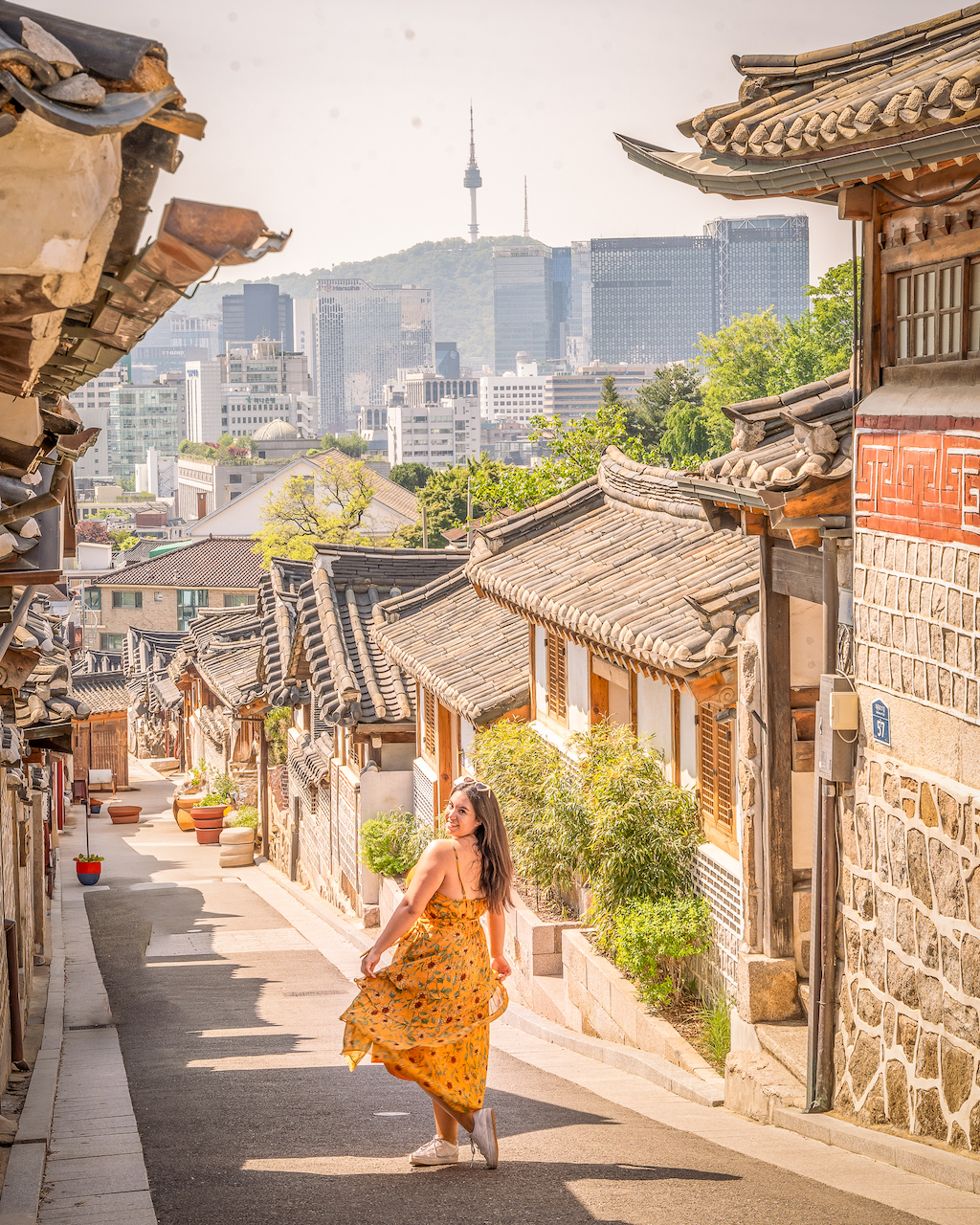
Green Mile Coffee
This is by far one of my favorite coffee shops in the Bukchon area. Their speciality lies in coffee and green tea creations… Which sounds like it wouldn’t go together, but it totally does! It’s a great pick me up and I recommend going around sunset. You can also see the National Folk Museum of Korea from the rooftop.

Optional: Gwangjang Market or Namdaemun Market
These are traditional markets in Seoul. It’s the perfect place to try traditional Korean food. It’s a popular spot for an authentic local food experience in Seoul.
Optional: Nanta Show
This is one of the most entertaining live performances I’ve ever been to… And the best part? You don’t have to know Korean to enjoy this show. They combine cooking with traditional Korean dancing. Book your Nanta Show here.
Day Three in Seoul
Namsan tower .
If you’ve ever watched a romantic Korean drama, then you’ll have seen a scene filmed here. It’s the ultimate couples destination in Seoul. The N Seoul Tower is also known as a complex culture space where the clouds meet Namsan Mountain.
What to do at Namsan Tower?
A few things I recommend are definitely going up the cable car and Namsan Park. You can take a leisurely walk along the city wall from the park and it is amazing for photos. It’s great in all seasons but especially in spring and autumn. There are also two restaurants in the observatory to choose from which makes the experience even cooler.
- Namsan Tower Round Trip Cable Car Ticket
- Namsan Tower Observatory Ticket
- The Place Restaurat at Namsan Tower
- HanCOOK Restaurant at Namsan Tower

Myeongdong
The Myeongdong shopping district is a tourist favorite for the shopping, street food, cute cafes, and Kpop inspired merchandise. You’ll find lots of unofficial Kpop souvenirs in Myeongdong Station. A popular activity is to eat street food. Make sure you try tteokbokki which are spicy rice cakes. Bring cash because the street food vendors don’t do credit or debit cards.
What to do in Myeongdong?
The Myeongdong area is mostly famous for its shopping district but there are so many other cook things to do in Seoul. You can really get a feel for Seoul’s most expensive district by going around to eat street food and taking part in cultural activities.
- Watch a Nanta Cooking Show
- Get Pampered At the Whoo Spa

Han River Picnic
Were you even in Seoul if you didn’t picnic or visit the Han River? One of the top things to do in Seoul is to order delivery to Yeouido Park. The top two contenders are pizza and fried chicken. There are tons of convenience stores around where you can just get a lunchbox and beer and eat anywhere you want. Also, it’s really popular to ride a bike and have a picnic at the Han River .
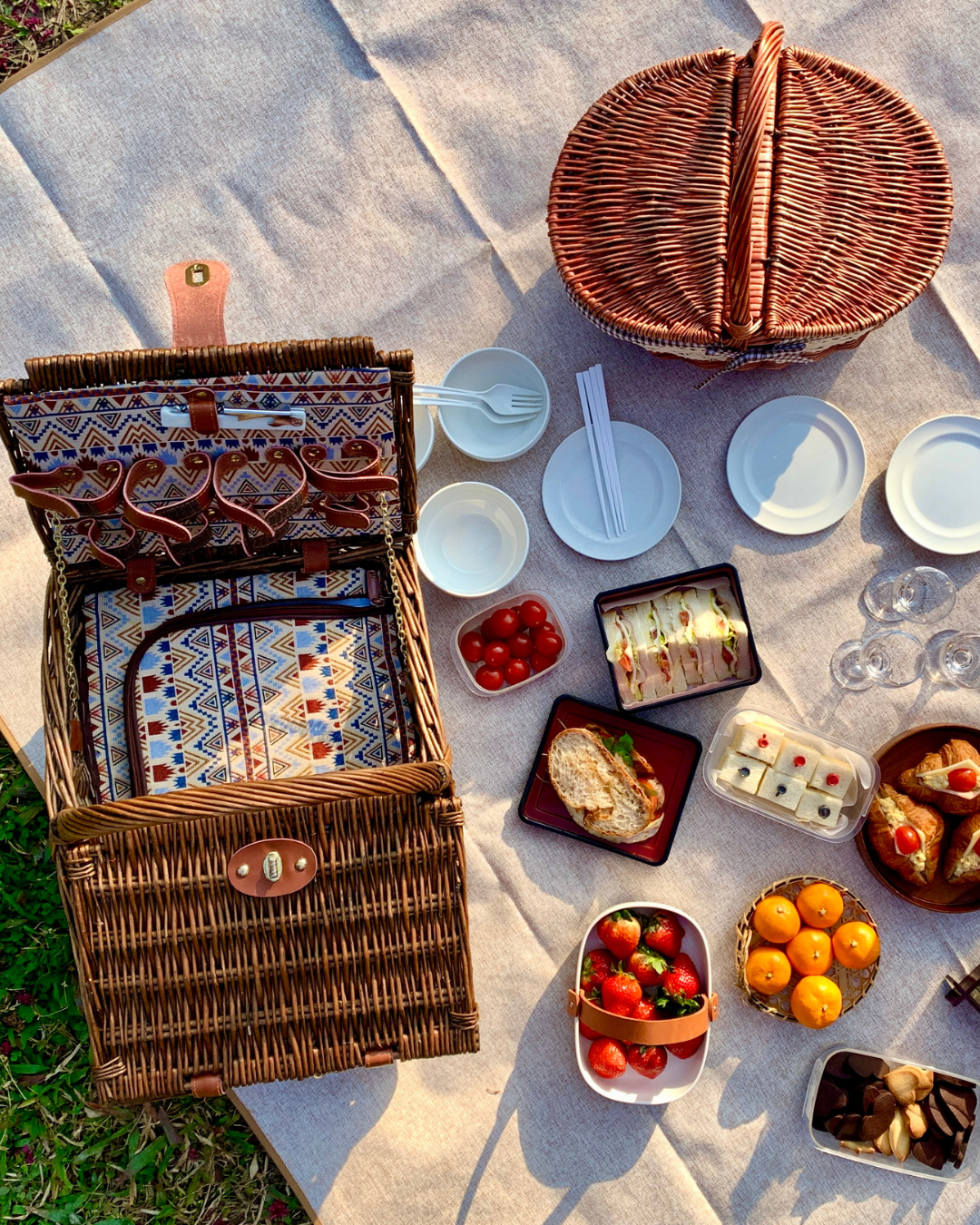
Han River Cruise
Another popular attraction for tourists in Seoul, the Han River Cruise is one of my favorite things to do. If you go on the sunset tour, you can get a drink. You can also watch the city light up. This is a really amazing activity for friends, lovers, or families. You can book your Han River Cruise for a discount here.
Day Four in Seoul | Go On A Day Trip From Seoul
On your last day in Seoul, I recommend going on a trip outside the city. While Seoul is absolutely amazing, you should see other parts of the country. If you’d like more information on all the amazing day trips you can take from Seoul, click here.
Visit The DMZ
Visit the DMZ (Demilitarized Zone) and JSA (Joint Security Area). Whether you’re into history or not, this has definitely been one of the coolest experiences I’ve ever done. You’ll get a chance to tour part of the tunnels the North Korean government made to try and infiltrate Seoul.
The best part is the JSA. This is where President Moon Jae-In and Dictator Kim Jong Eun met for a peace talk. Depending on the day and how high tensions are the JSA may be closed. These cool blue houses are also where you can stand in North Korea during the DMZ Tour. You can book your DMZ and JSA tour here.

Gyeongju Day Trip
Gyeongju was once the capital of the Silla Dynasty and home to many of Korea’s famous historical sites. I also have a completely done for you guide on the Perfect Autumn in Gyeongju Itinerary . I think the best time to visit Gyeongju is during fall and spring. Don’t forget to visit Bulguksa Temple which is a Buddhist Temple and the Seokguram Grotto.
The easiest and most hassle free way to see Korea’s old capitol is to book a one day Gyeongju day trip from Seoul here. One of the best things to do is to a rent (traditional time era hanbok). This is one of my absolute favorite places in Korea because of its rich history.
- Gyeongju Cherry Blossom Tour (Spring Only)
- Gyeongju Fall Foliage Tour (Autumn Only)
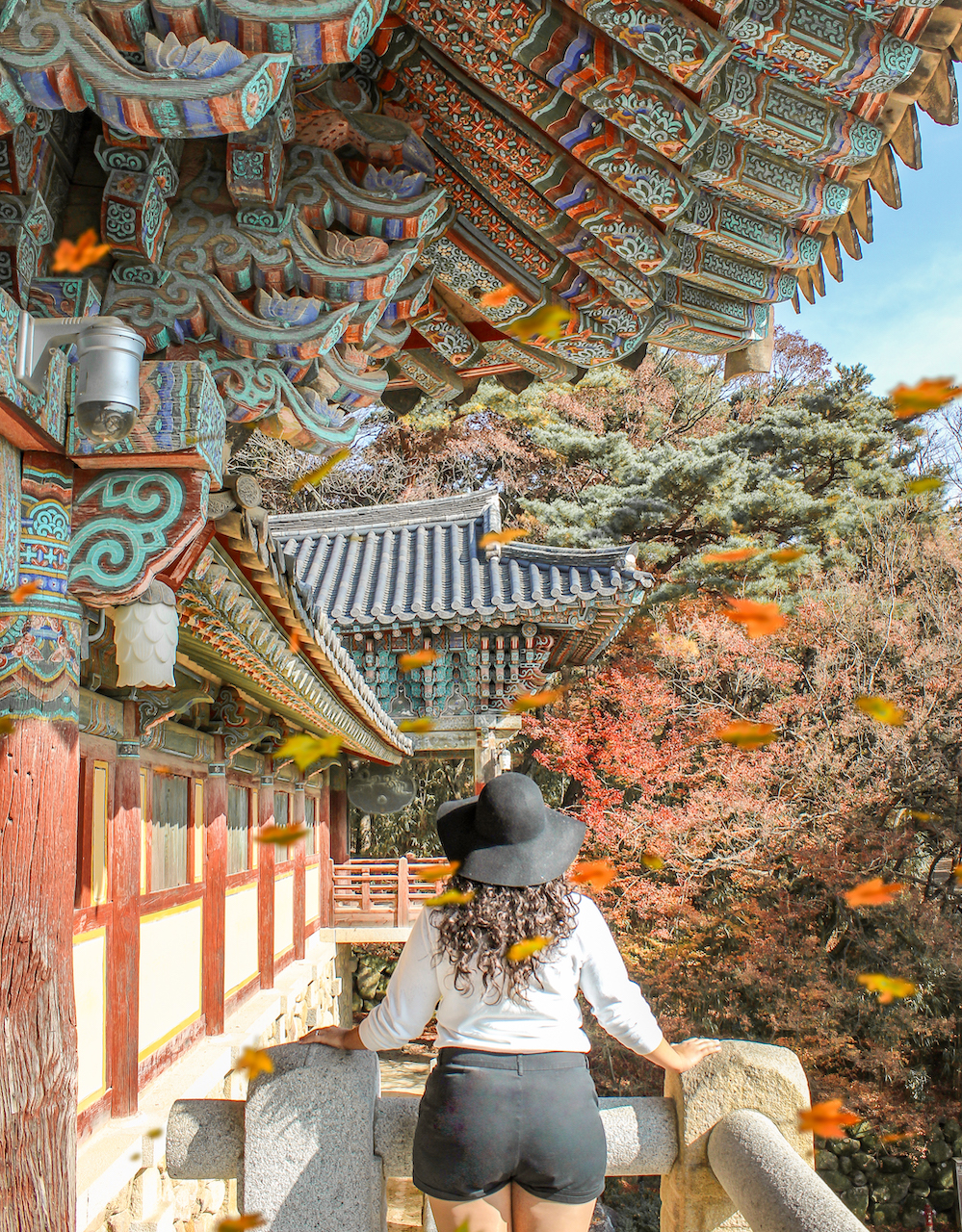
Jeonju Day Trip
Jeonju is particularly crowded during autumn in South Korea. This traditional Korean town features delicious bibimbap, yummy street food, and one of a kind chocopies. It’s kind of tricky to get down to Jeonju yourself so I recommend this one day Jeonju trip from Seoul here .
You can also rent hanbok for cheap and take loads of pictures with great souvenirs. If you’re a fan of Kpop, don’t forget to check out the Catholic cathedral where Big Bang’s Taeyang filmed Wedding Dress. For more information, check out my Jeonju in Autumn Itinerary .
This was one of the most fun day trips I ever experienced. If you want to get there via public transportation, I recommend you use the KTX Trains . The KTX Jeolla Line will take you to Jeonju.
- Jeonju Cherry Blossom & Spring Flowers Tour (Spring Only)
- Jeonju & Naejangsan Fall Foliage Tour (Autumn Only)
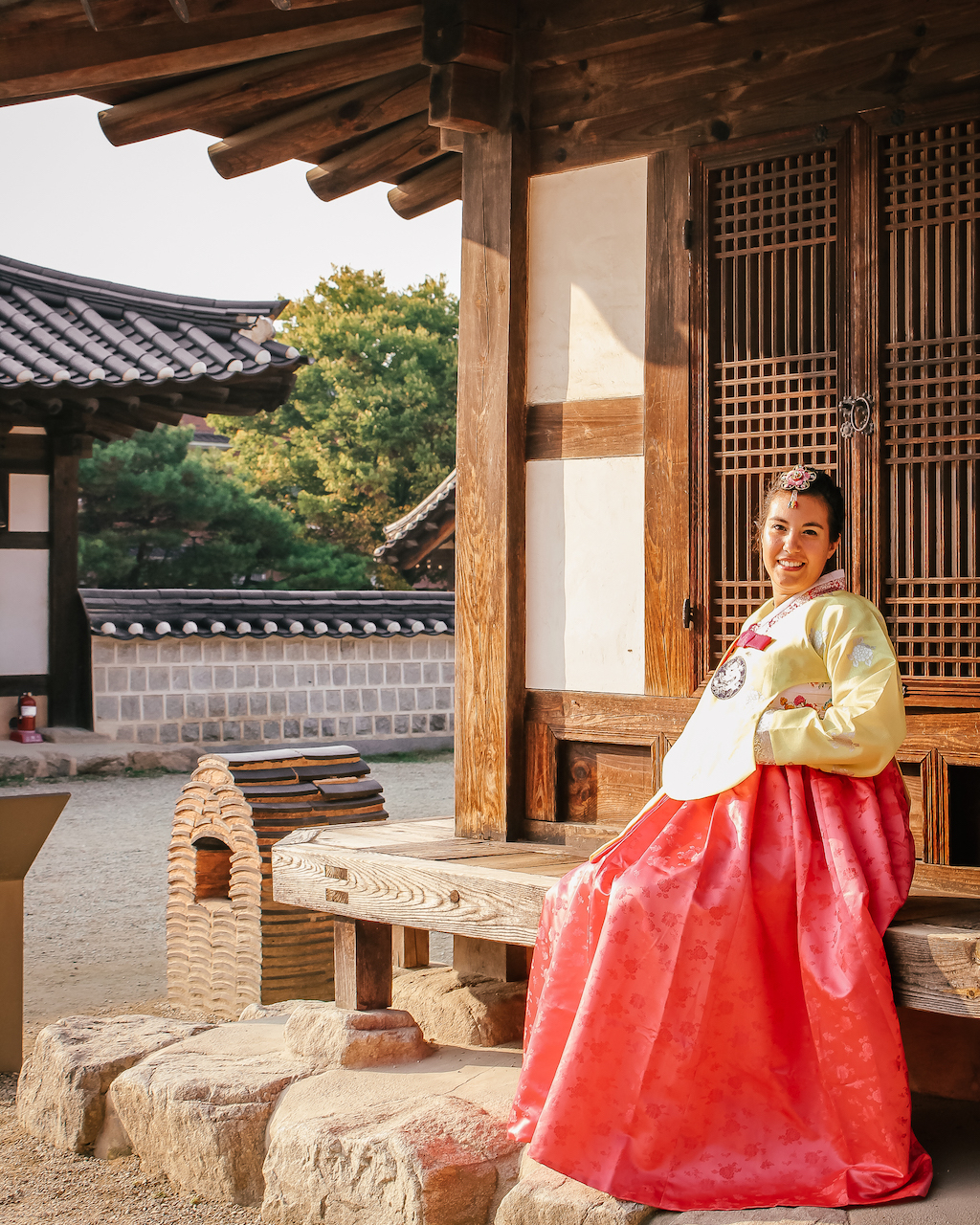
Other Recommended Day Trips
- Everland Amusement Park
- Korean Folk Village
- Namhansanseong Fortress Tour
- Suwon Hwaseong Fortress Tour & Korea Folk Village Tour
- Garden of Morning Calm, Nami Island, Petite France Tour
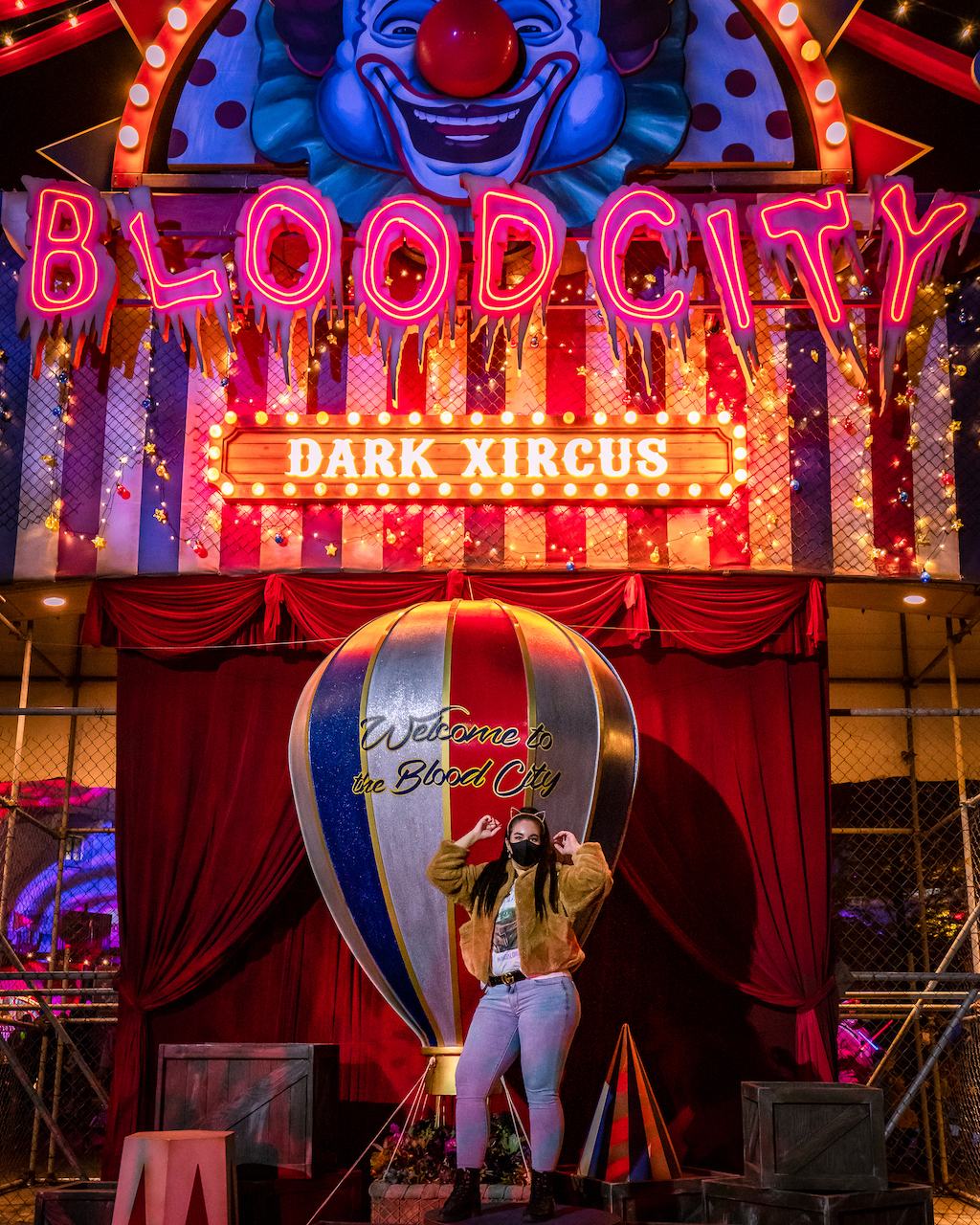
Go Hiking in South Korea
- Bukhansan National Park Hiking Tour
- Seoraksan National Park & Nami Island Tour
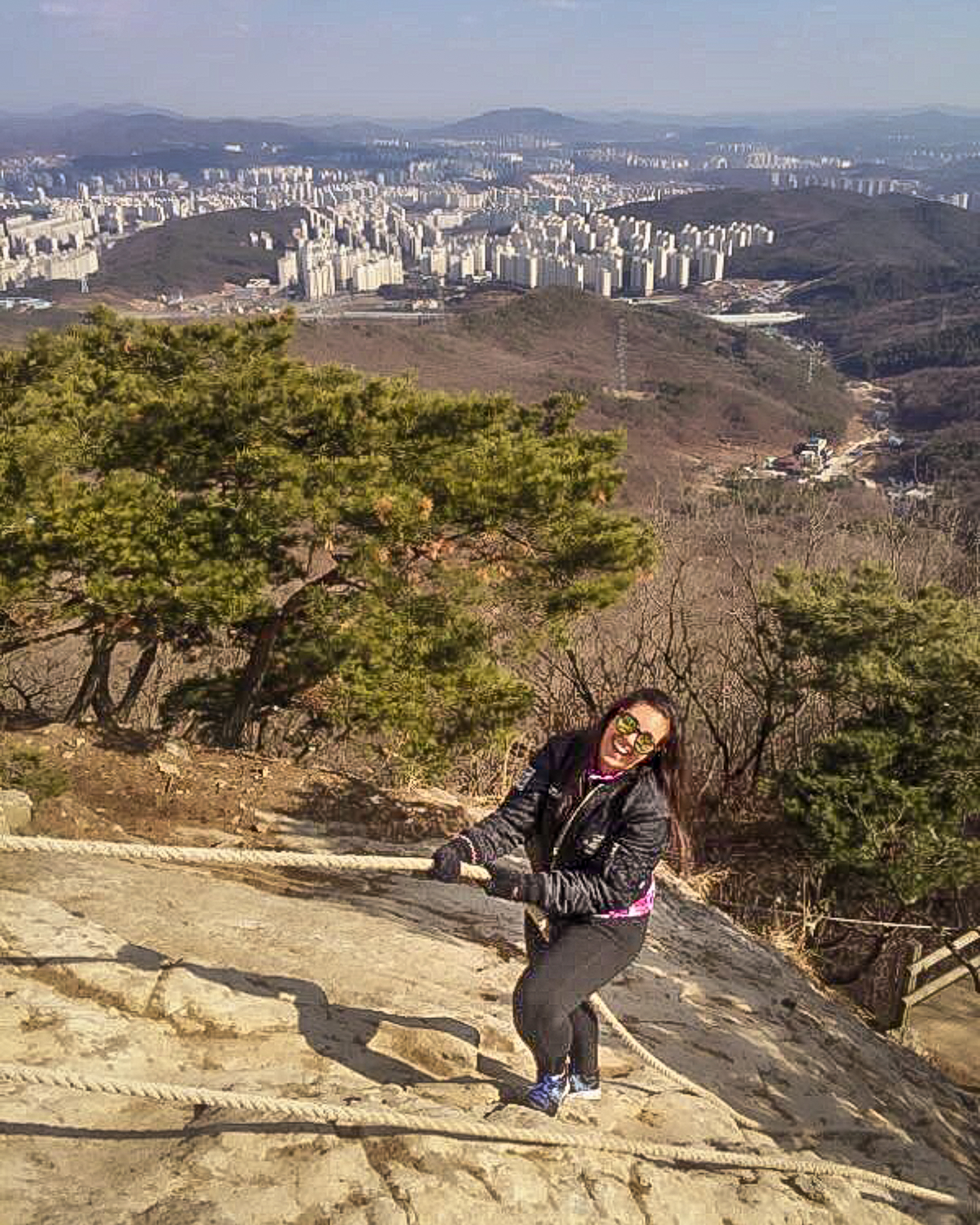
Three Days in Busan (10 Day South Korea Itinerary)
Next on our 10 day South Korea itinerary, we’re gonna pop on over to Busan which is the second largest city in South Korea. The south coast of Korea is a popular destination in summer. It’s one of the best places for a beach holiday, but is great year round. Three days in Busan is the perfect amount of time for getting a feel for this city. If you’d like to stay an extra day instead, check out my four day Busan itinerary here .
Day One Busan Itinerary
Gamcheon culture village.
Many people visit the Gamcheon Cultural Village. It is the top tourist attraction in Busan for a reason. The best things about the village are the colorful homes, ecclectic cafes, and super cute boutiques selling trinkets all around. It is a residential area and there is no entrance fee to get in. Please respect the residents and keep your voice down.
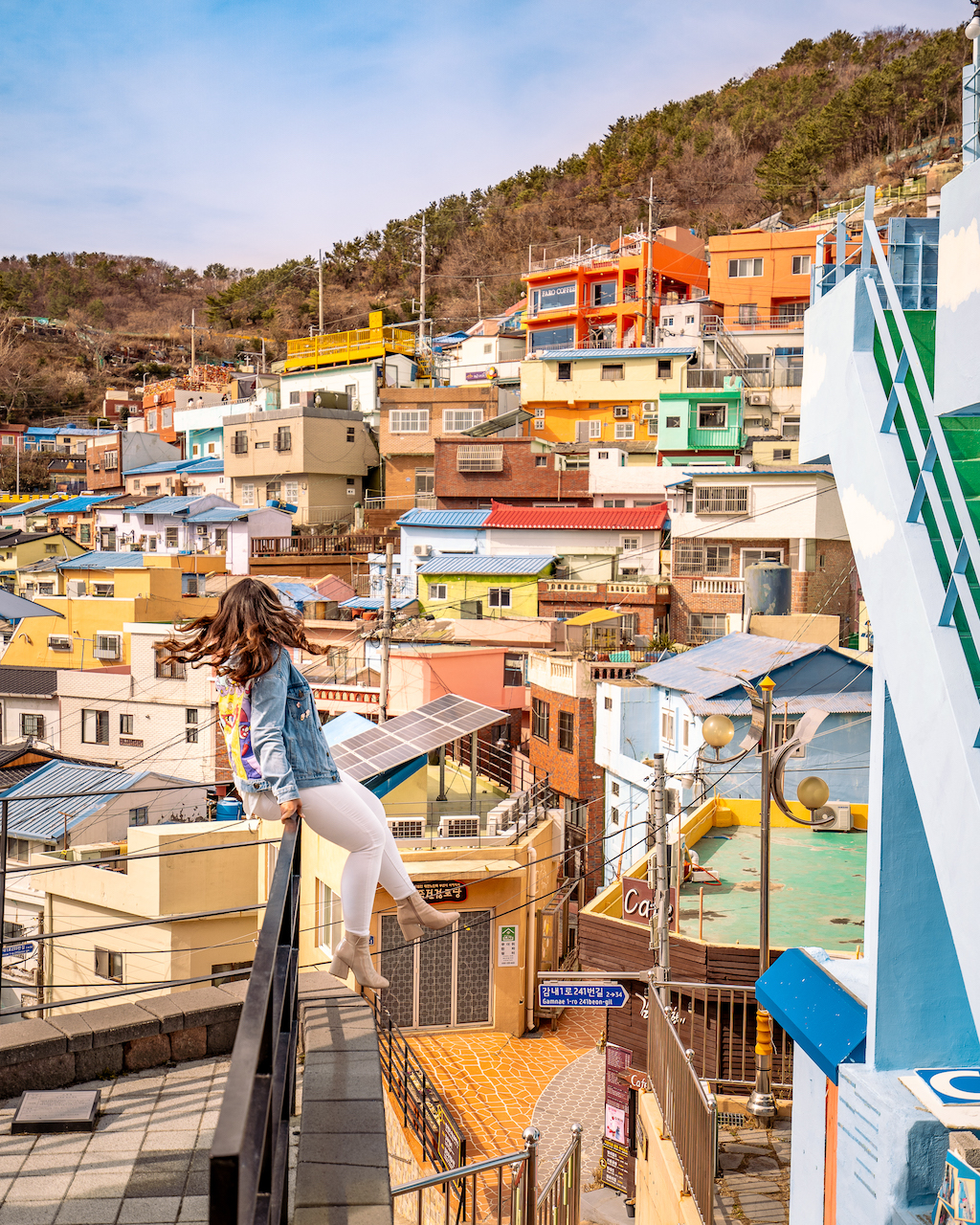
Avant Garde Cafe
Insider tip… The drinks are meh, but the views are FIRE. Stopping by this cafe is a great way to capture one of Busan’s main attractions. You will be guaranteed a great view of the Machu Picchu of Korea.
Cafe OceanView
Cafe Oceanview is the best area to view the port city and the Songdo Cloud Trails. I recommend walking around them to get different angles of the city and different viewpoints. It’s very pretty no matter what time of day you go. It’s a new cafe in Busan so here is the Naver Map link to access it easily.
Songdo Cloud Trails
These are really beautiful walking trails along the ocean and where you can see the cable cars. This is a really unique experience and I recommend spending enough time here to soak up the sites.
View this post on Instagram A post shared by Busanpedia – Every corner of Busan, Korea (@busanpedia)
Huinnyeoul Beach Cafe
What better way to start the day than with some Korean coffee and a great view of the Busan ocean? The cafe has a beach theme. They serve various baked goods like scones and cakes.
View this post on Instagram A post shared by 찌윤 | 여행 🫧 (@dailyoo.n)
Songdo Bay Station
This is where you’re going to catch the Songdo Cable Car after a light lunch at Cafe Oceanview where you can enjoy the natural beauty of the coast. I also recommend going to the Sky Harbor Observation Deck. You can book your tickets with a clear glass floor to the Busan Air Cruise here .
View this post on Instagram A post shared by @ariftanr_
Eat Dinner at Jagalchi Market
I’m sure after a long day of sight seeing you’ll want to settle down and eat delicious food. Jagalchi Market is Korea’s largest seafood selling market. You can find both live and dried fish here. There are food stalls where visitors can eat fresh raw fish right at the market. The Jagalchi Ajhumma sell mackerel, sea squirts, and whale meat on wooden boxes along the road outside of the market and along the shore.
View this post on Instagram A post shared by Cheryl (@adultingwithcheryl)
Day Two Busan Itinerary
Oryukdo skywalk.
Visitors of the skywalk have a beautiful view of the sea and surrounding cliffs through a glass floor. It’s constructed with 12-millimeter glass pieces coated with a bulletproof film so it’s safe to walk around on.
Casa Busano
Casa Busano is a European inspired cafe along Gwangalli Beach. It’s popular at all hours of the day, but mostly at night when the bridge lights up. They have European style coffee and pastries.
View this post on Instagram A post shared by 이졔 | 부산맛집 • 부산근교맛집 (@dlwndlee)
Cheese Form Cafe
The inside of the cafe is completely yellow, and you guessed it…cheese themed. Cheese Form Cafe in Busan offers delicious soufflé and great views of Gwangalli Beach.
View this post on Instagram A post shared by Cholthicha Chaovadee (@ppareez)
Gwangalli Beach
Gwangalli Beach is one of the most pristine beaches because of the white sand. It’s one of the most photogenic spots because the backdrop of the bridge. Additionally, it’s a good place for a picnic on a nice beach. This is a much better place to spend a full day since Haeundae Beach is always super crowded in summer.
View this post on Instagram A post shared by Brigitte Patton (@brigittepatton)
Although not a cafe, the best time to go is at night. They offer a variety of wines, whiskey, and good food. If you want to drink where the locals do, check out Piv Bar. At first glance you wouldn’t know this is a dive bar with amazing views of Busan at night.
View this post on Instagram A post shared by 부산여행 · 부산카페 · 부산맛집 𝄅 혤 🧸 (@hhrrr___)
Day Three Busan Itinerary
Bibibidang cafe.
Bibibidang is a Korean hanok cafe that serves various types of traditional Korean tea, which you can enjoy while seated with a view of Cheongsapo Port. The main attraction of his cafe is the view of Haeundae Beach Train and Sky Capsule on the Green Railway. They even offer a tea class.
View this post on Instagram A post shared by 𝐉𝐨𝐲 조이 – 카페 | 공간 | 여행 (@joy._.traveler)
Haeundae Blue Line Park
This is basically a little train you take along the coastal road of the ocean. To get on the Blue Line, you would go straight to Cheongsapo Station. These little cars are one of the most popular tourist attractions in Busan. Book your Blue Line Sky Capsule Train ride here .
View this post on Instagram A post shared by visitbusan.en (@visitbusan.en)
Cafe Rooftop
Another one of Busan’s most stunning cafes, you absolutely cannot miss this beautiful oceanside cafe. The best part is when the bridge lights up with rainbow colors at night. Drinks start at 5,000KRW.

One of the best Instagram worthy cafes in Busan, Port 1902 offers amazing cafe serves drinks like ade, cocktails, and coffee. Port 1902 also offers snacks and food. The best part? They’re located right by the ocean and have a swimming pool to entertain their customers. It’s also dog friendly. They’re open pretty late so make sure to stay long enough for the pool party to get going and the neon signs to turn on.
View this post on Instagram A post shared by 바리스타.양재혁 (@yang.tomtom)
Holi Lounge
At this restaurant they offer pasta, steak, pizza, brunch, coffee, wine, and beer. They have a great view of the Haeundae Blue Line Capsule Train. You can easily find the Holi Lounge on Naver Maps here .
View this post on Instagram A post shared by 홀리라운지 holi lounge 송정맛집 레스토랑 (@holi_lounge)
Haedong Yonggungsa Temple
Known as the sunrise temple, this beautiful place is truly a wonder to behold. Haedong Yonggungsa Temple was built in 1376 by the teacher known as Naong during the Goryeo Dynasty, and was originally known as Bomun Temple.
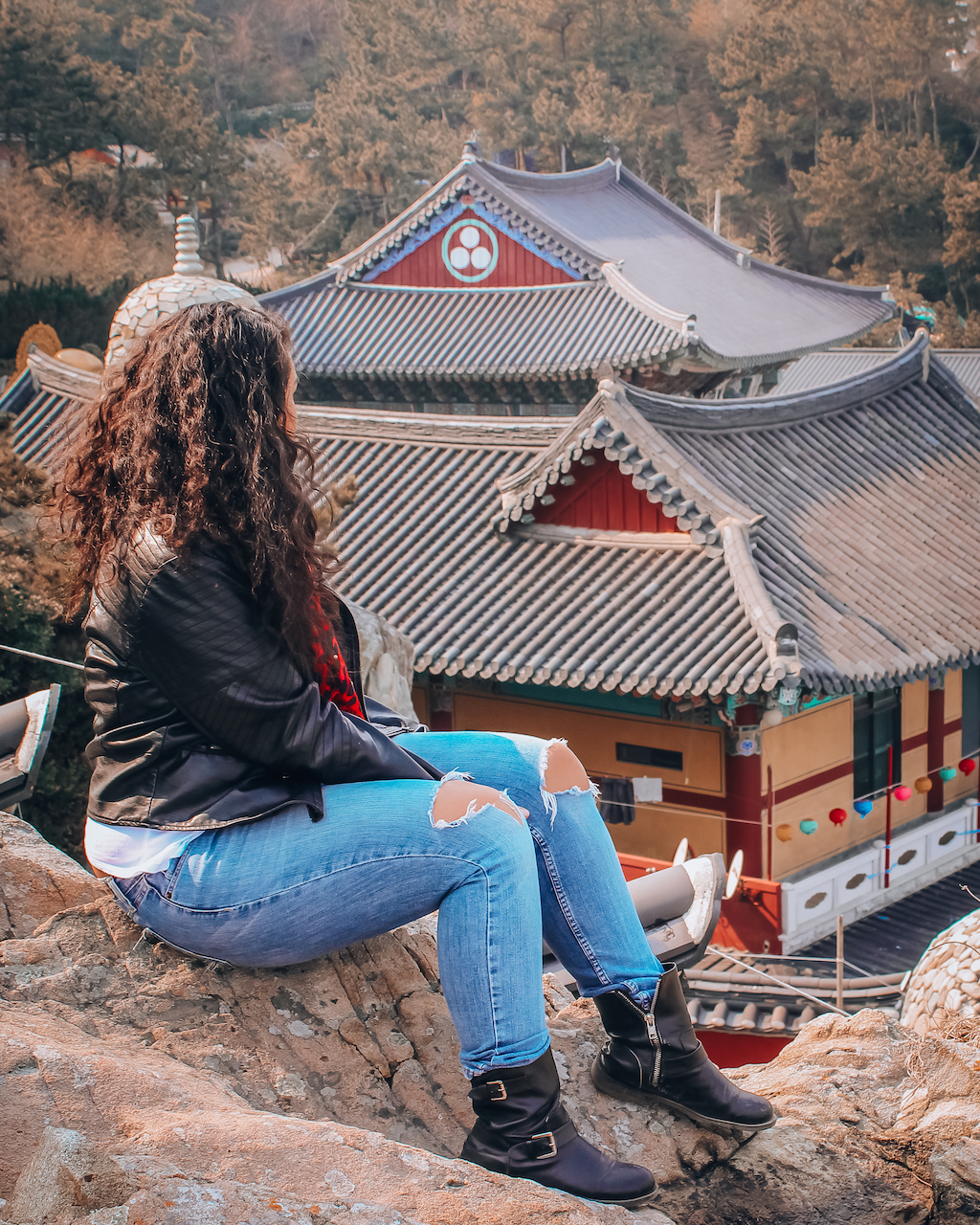
Wave On Coffee
This beautiful cafe is the perfect place to relax in nature with panoramic view of the Gijang’s seashore. It is 3 stories tall and the beach is right in front of the property. Wave On Coffee is the best cafe in Busan with delicious snacks, desserts, and drinks.
View this post on Instagram A post shared by 곽효신 I 카페 그리고 여행 (@hyoshinkwak)
Three Days in Jeju (10 Day South Korea Itinerary)
Jeju Island is a volcanic island often known as the Hawaii of South Korea. For an in depth itinerary for three days in Jeju, click here .
Day One Jeju Itinerary
Cheonjeyeon falls.
A morning stroll through the “Pond of the Gods” refresh you with its beauty and wonder. The minerals in the water give it an extremely blue hue and you’d have to see it to believe it. There’s three different sites you can visit in the area. Expect to spend about one hour hiking around.
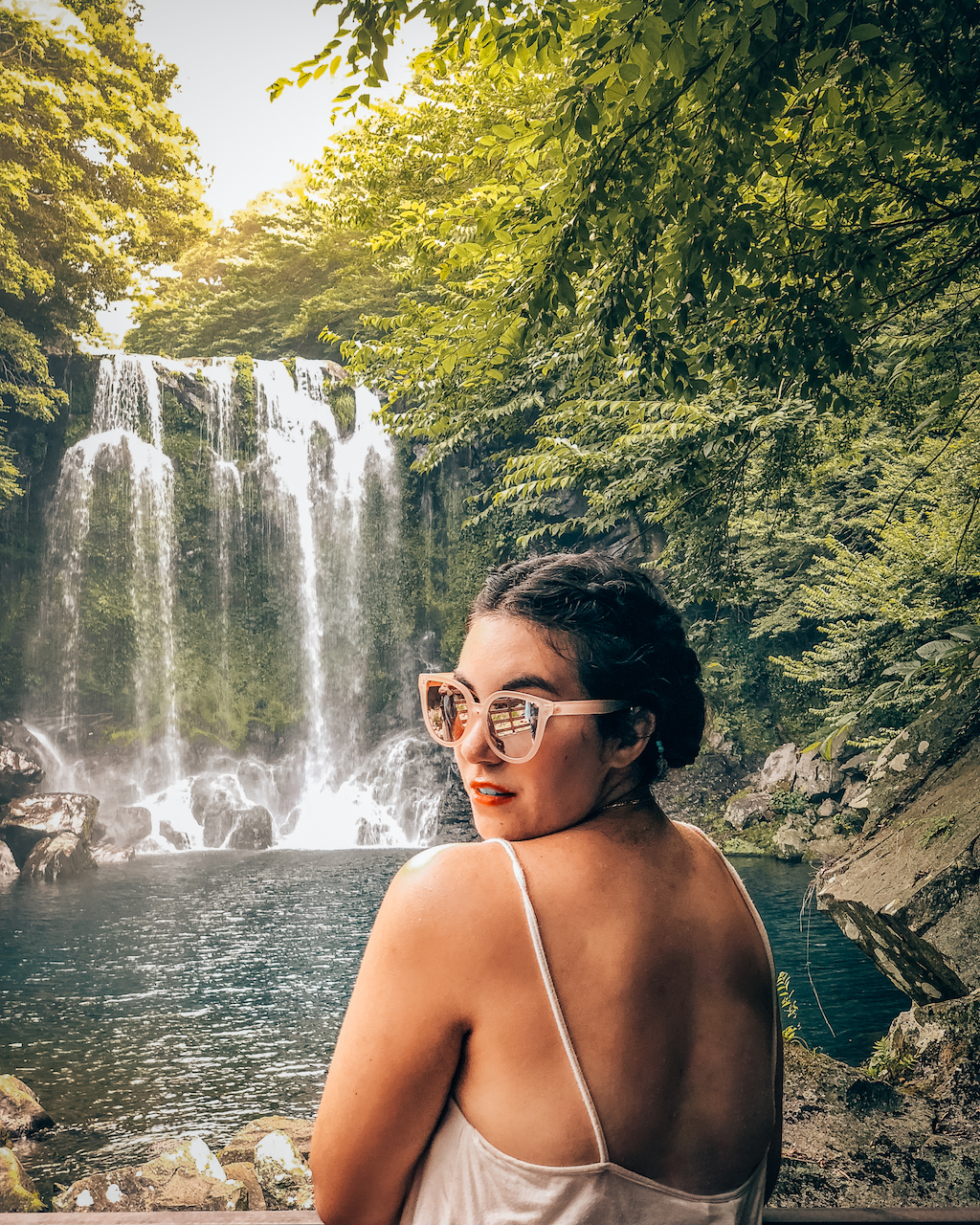
Jeongbang Waterfall
Jeju is full of stunning nature and this waterfall is not exception. My recommendation is to also get there early before its flooded with tourists.
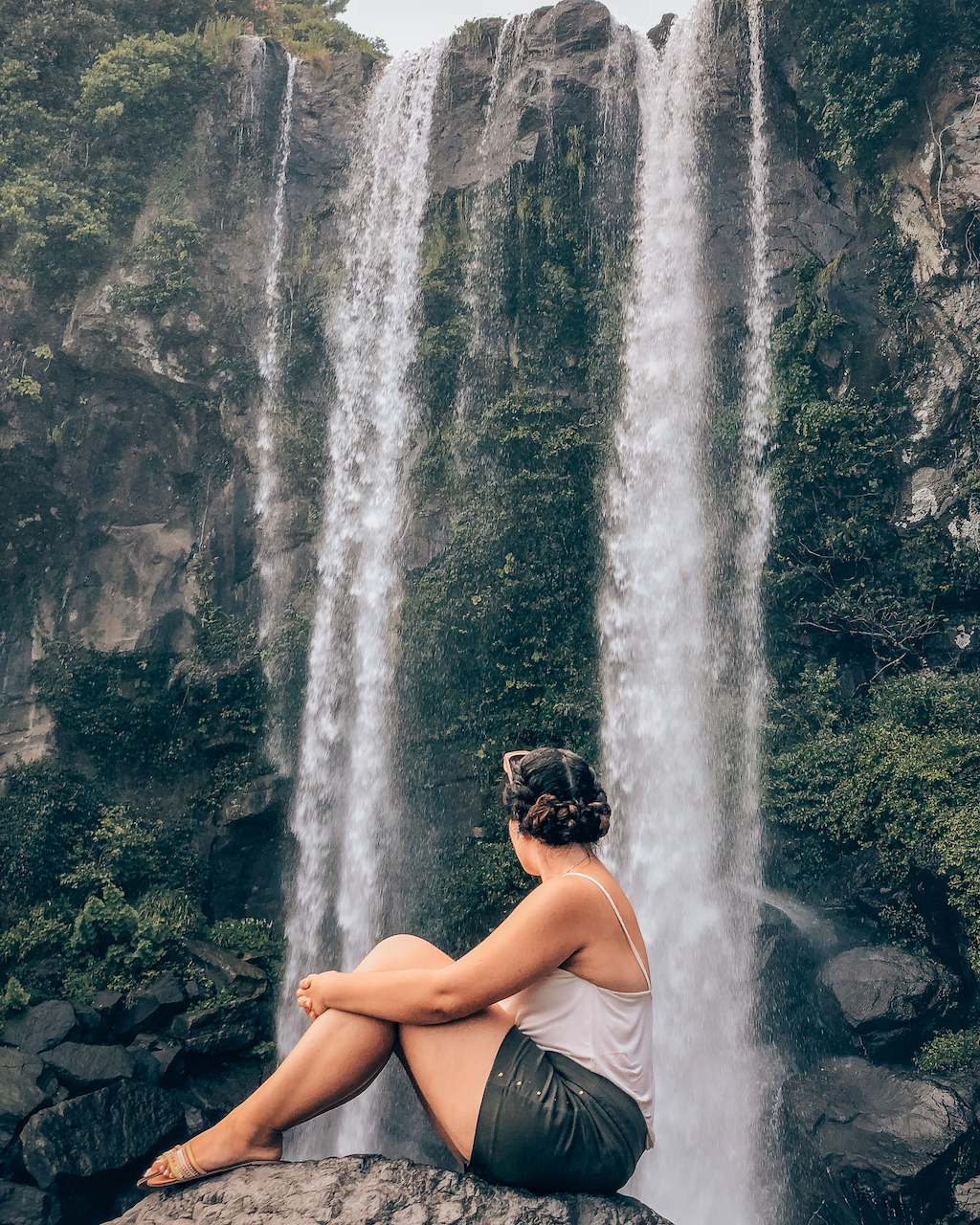
Eat Black Pig for Lunch
The sun gets very hot in Jeju and I recommend packing your best sunscreen. During this time I recommend doing indoor activities. You don’t want to miss out on the the local dish of black pig. A great place to eat it is Black Pork street. Eat at the Black Pork Restaurant, right on the corner of the street.
Teddy Bear Museum
The museum has a collection of teddy bears over 100 years old to an extremely expensive Louis Vuitton bear. There’s even bears dressed up as historical figures like Charlie Chaplin and Michael Jordan. #ImfromChicago If you’d like to go to the museum buy your ticket here and check out your savings !
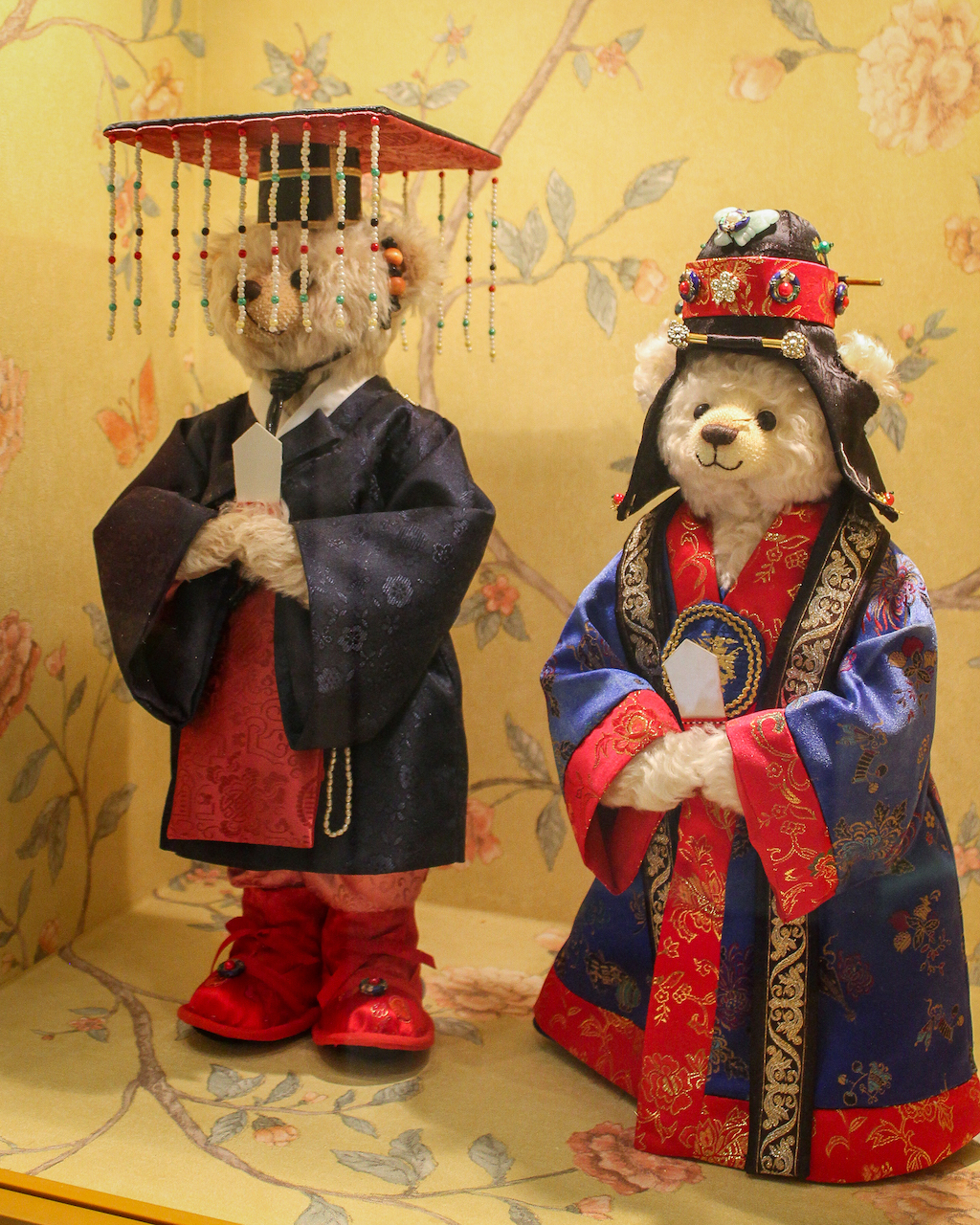
Jeju Chocolate Museum
Did I have you at Jeju chocolate? Good. There’s an admission fee to get in, but the museum gives you a voucher to use on any chocolate food and drinks in the museum. Make sure you try the mandarin and hallabong (Jeju’s special orange) flavors. If you buy your own chocolate kit, you can make it right there in the museum!
Jungmun Saekdal Beach
The water was so pretty here! I loved this beach because it was super clean and not as crowded. If you’re into surfing, this is a great beach for that and there’s also beach side convenience stores for all your munchie needs.

Optional: O’Sulloc Tea Museum
If you have some extra free time, definitely come here. The OSulloc Tea Museum has a tea gallery, eco-friendly rest area, and a cafe where visitors can enjoy a variety of tasty tea-based desserts. You can even eat some tasty green tea ice cream here! If you can’t make it here, don’t worry! There’s a delicious O’Sulloc Tea Sampler you can purchase online .
Innis Free Jeju House
The Innis Free Jeju House is located inside the O’Sulloc Tea Museum. Innis Free is a Korean beauty brand that embodies the natural beauty of Jeju Island. I personally love their Green Tea Hyaluronic Acid Face Cleanser especially during the summer. Visitors can enjoy Innisfree’s cosmetics made with quality ingredients harvested from Jeju, as well as organic food made with fresh local ingredients.

Dinner at Pizzeria 3657
This is a super romantic place at sunset. If you’re craving authentic Italian pizza, then look no further. If you’ve lived in Korea for any amount of time, you’ll have noticed the pizza a sweet. For a non-sweet pizza, eat here. It’s a bit on the pricier side, but what you get is what you pay for. The four cheese pizza was hella good.
Day Two Jeju Itinerary
Seongsan ilchulbong.
Seongsan Ilchilong is a UNESCO World Heritage Site. It is also known as sunrise peak… So obviously the best place to see the sunrise is here! The large crater on top formed by the hot lava mixing with cold ocean water, is located at the top of Seongsan Ilchulbong Tuff Cone. The crater is about 600 meters in diameter and 90 meters deep. A lot of people come in the early morning.

Udo Island
Visiting Udo Island is a great day Jeju itinerary. So what is it? Udo Island is a beautiful island off the coast of Jeju. It’s really small and won’t take all day to go around.
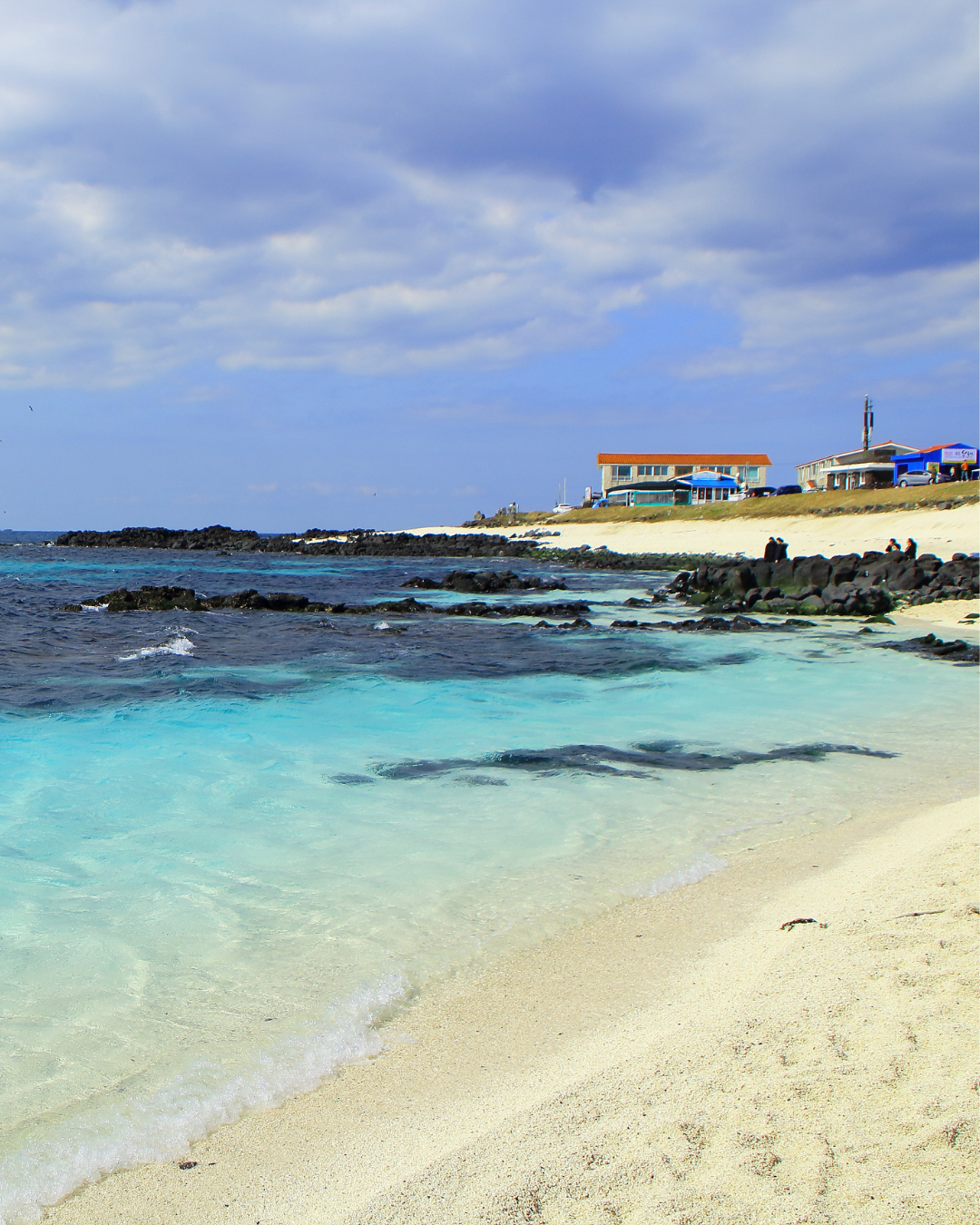
Can you believe this is the last day of our 10 day South Korea itinerary? I know. Me too. It feels like a dream. I recommend going out with a bang and climbing Halla Mountain. Or you can just beach bum it away.
Hike Hallasan Mountain
Hiking Mount Halla was my favorite of Jeju Island’s many wondrous attractions. I went with an ex boyfriend who didn’t listen to my health concerns and I ended up not being able to summit. The next time I climbed, I went with my younger brother and it was one of my best memories. If you’re a beginning hiker or suffer from any health problems, I highly suggest hiking the easy trail. For intermediate hikers, do the hard trail so you can see the crater at the top. It’ll take a good 12 hours to do the entire hike.
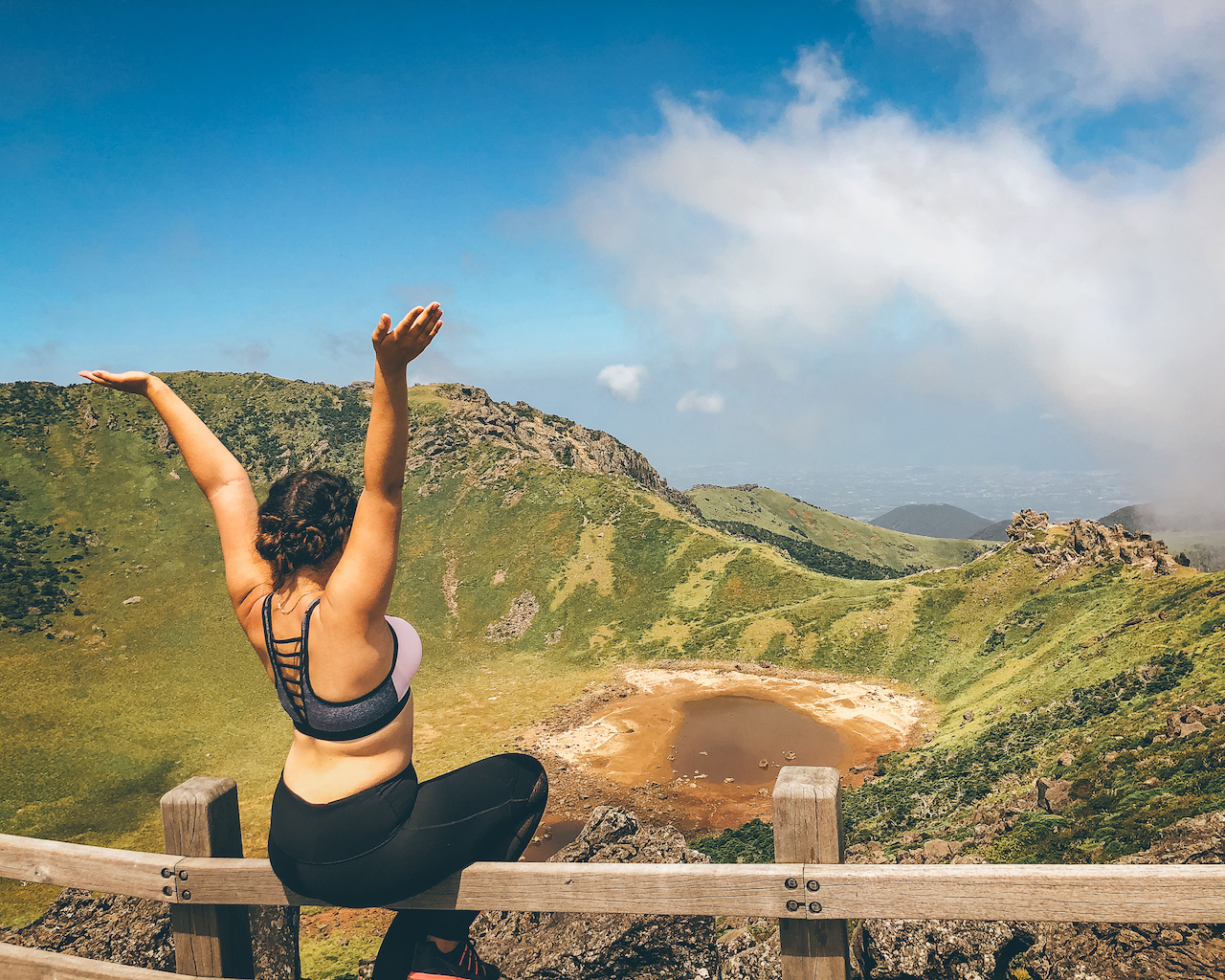
I hope you enjoyed this 10 day South Korea itinerary. If I had to travel South Korea again as a first-timer, I would definitely use this as a guide. It has what you need from culture, food, and everything in between. Since I’ve been to many of these places, you best believe that you’re in good hands. Besides, I’m your Korea travel expert!

This post contains affiliate links which means at no additional cost to you, I make a small commission to help keep Gina Bear’s Blog running. Thanks for your support!
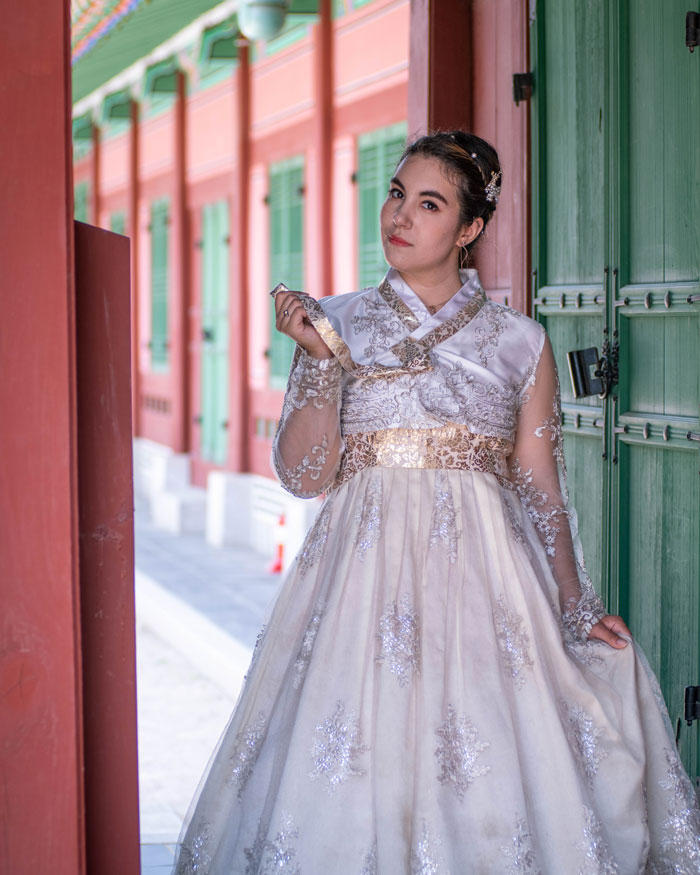
Free Seoul E-Book
Do you love south korea.
Enter your name and email address and click the button below to receive your Easy Seoul Travel Guide so you can travel like a local!
Related Posts

Leave a Reply Cancel reply
Your email address will not be published. Required fields are marked *
This site uses Akismet to reduce spam. Learn how your comment data is processed .

The Only 1 Month Korea Itinerary You Need
While I’ve already written ways to spend two weeks in Korea , I thought I’d make one giant Korea itinerary guide for a month.
I do think one month isn’t nearly enough to see all of Korea, but I’m obviously quite biased ;).
I decided to make this itinerary a bit faster than I’d normally travel just so I could fit in as much as possible. If you only can ever come to Korea once, this should help you feel like you saw everything you could see.
Quick Korea Travel Tips
- Getting in: If you’re coming from abroad, you’ll most likely fly into Incheon International Airport (ICN). It’s about an hour from Seoul and extremely easy to take the subway to get to your hotel. However, you can also get a taxi or book a transfer beforehand.
- Stay Connected: While Korea is pretty well connected wifi wise, I always recommend getting a SIM card! Even better, Korea offers e-SIMs! You can buy ahead and not even have to take out your normal SIM.
- Getting Around: All major cities have some sort of subway system and there’s a pretty robust bus system all around the country even in more rural areas. Download KakaoMap for the most up to date information. In between cities, you can take the train or bus. For trains, I always use Let’s Korail to buy tickets ahead of time as they can sell out. For buses, I usually just show up to the terminal and buy tickets, but my friend told me you could use TxBus , Kobus , or Bustago to order online.
- Language Help: While major tourist points are pretty okay with English, I’d say the rest of Korea you’ll want to have some sort of translation app on hand. And I recommend learning Hangul at least a little bit so you can read. Papago is better than Google translate for Korean.
- Travel Insurance: Korea can be expensive if you wind up in the hospital! I recommend getting either World Nom a ds or SafetyWing . I personally have an annual plan with Allianz.
For more advice, check out my Korea travel tips and my Korea trip planner .
The Ultimate Korea Itinerary Guide for 1 Month
Fly into: incheon international airport.
Assuming you’re coming from abroad, you’re most likely going to fly into Incheon Airport ! Incheon has spoiled me because it’s seriously one of the best airports in the world , even if the “ice rink” is a lie. Seriously, this place even has arrows on the ground to make sure you’re going in the right direction to the subway!

Days 1 – 4: Gangwon Province
So, you’re not actually going into Seoul just yet. Nope, you’re going to the Northeast coast to Gangwon-do! In fact, this is the northernmost province in South Korea.
You get there in one of two ways:
- Take an airport bus from Incheon to Sokcho ( Check the schedule here )
- Use the subway to first go to Seoul Station. Then take a train from Seoul Station to Gangneung Station. Forom there take a bus from Gangenung to Sokcho (Airport – 1 hour, KTX – 2 hours, Bus – 1 hour)
Stay: By the beach! Top spots include Heavenmark , Sokcho Beach’s House , or Sokcho & Guesthouse
Day 1: Sokcho
I’d base myself in Sokcho (속초) for this Gangwon trip. This is the main spot for anyone visiting the area as it’s a gateway city for Seoraksan National Park and has quite a few scenic things to do on its own.
Take the rest of the day to get over jet lag and sleep because your schedule is about to be packed .

Day 2: Hike or visit Seoraksan
Spend the day hiking Seoraksan , one of Korea’s most important mountains. Or you could take the cable car up, I won’t judge.
Day 3: Sea Train
Take the sea train and stop off at some of the main beaches in Gangwon, including Gangneung , Donghae , and Samcheok . Wander around, relax on the beach, and just enjoy. A good day to rest if you did actually hike Seoraksan. If you do want to do some sightseeing, you could do this Gangneung Taxi Tour .
- Seasonal Options: Goseong Lavender Farm in June, surfing and SUP at Surfyy Beach, or any of the ski resorts in winter

Days 5 – 9: Seoul
Time for one of the coolest cities in the world! I’m not kidding. I’ve been to so many cities in my travels and Seoul still tops the list for me. The biggest thing you should know is that it’s massive . Much bigger than what you’re expecting and unless you want to drain your bank account taking taxis, you’re going to want to give yourself more time than you think to get around via the subway or bus.
Getting back: For your time in Seoul, I recommend staying in Insadong . It’s the best location for everything you’ll want to do below! To get to Insadong from Sokcho, you’ll want to take a bus from Sokcho Bus Terminal to Seoul Express Bus Terminal. From there you can take the subway to the closest station to your hotel.
Stay: I’ve personally stayed at the Grid Inn which is in SUCH a good location. If you want to experience a hanok, try Charm Hanok Guest House .

Day 5: Seoul – Insadong
Once you’ve arrived to Seoul and dropped your things off at your hotel, just walk around and enjoy Insadong! This is probably my favorite neighborhood of Seoul because it’s the most historic area.
If you’re up for some walking, spend the afternoon strolling through Bukchon Hanok Village. It’s really such a pretty place as it’s where all the traditional houses are located! Be sure to go to the main view point, which is someone’s house, and see over the tiled roofs to Namsan Tower. Another good stop is the cool cafe, Green Mile Bukchon ! Also my favorite incense shop, Granhand has a location here.
When it comes time for dinner, hop over to Gwangjang Market to sample all the delicious Korean food you can. If it sounds familiar, it’s because the market was featured on Netflix’s “Street Food” series.

Day 6: Storybook Day Tour
There are a few different day tours you can do from Seoul , but I personally love the nearby storybook-esque visits ! You could take the subway to Gapyeong and do the Gapyeong shuttle bus or you can book a tour that will take you to each of the spots throughout the day.
I’ve personally only visited via a tour. Most will take you to the Garden of the Morning Calm , Nami Island , and Petite France . Sometimes the tours have one other stop, but I think doing all three is a good amount for one day without feeling overwhelming. Check this tour for prices + availability

Day 7: Changdeokgung & Deoksugung
To start, there are five official grand palaces of Seoul , and on this trip I have you seeing three of them. It sounds like overkill, but I promise these three are particularly different. Gyeongbokgung is the largest of the palaces (more below) while Changdeokgung is known for its Secret Garden and Deoksugung is much smaller and known for having some European style buildings mixed in. I promise they’re worth it!
On this day, you’re going to start off early and go straight to Changdeokgung . It opens at 9, and you want to make sure you get tickets to see the Secret Garden. If you visit during the fall, the line will be long! This whole palace area will take at least 2 hours to see everything.
For lunch and the middle of the day, you can go around Insadong (there’s plenty of good restaurants to pop into) or you can venture over to Seoul University to see all the restaurants and cafes near there.
In the afternoon, head to Deoksugung . Visit the palace grounds themselves before going up to the observatory to get a cool bird’s eye view. This is a particular must if you visit during peak fall foliage season.

Day 8: Full Day Tour to Suwon Hwaseong or the DMZ
Use this day to tour either the DMZ or Suwon Fortress . Both will take you the better part of the day and will showcase an interesting part of Korea’s history. Book a tour to Suwon here or book a DMZ tour here
Seasonal Option: Hike Bukhansan for its fall foliage.

Day 9: Gyeongbokgung + Cheonggyecheon
Start off early and head there to see the changing of the guards and then head in to walk around. Gyeongbokgung is massive , so you’ll probably spend a good few hours there. You can also stop in and visit the National Folk Museum of Korea.
From Gyeongbokgung, walk along Cheonggyecheon , Seoul’s very pretty manmade river. Depending on when you’re visiting, they sometimes have really nice exhibits. You’ll also pass through Gwanghwamun , which has the big statue of King Sejong and usually some sort of event going on.
From Cheongchyecheon, you can walk over to Jogyesa .
Days 10 – 16: Jeollanam-do and Jeollabuk-do
Time for my favorite provinces of Korea! Jeollanam and Jeollabuk (from here on just combined into Jeolla) are a deeply underrated part of the country. I think they’re home to some of the most incredible scenery and, most importantly, the very best food.
I know, I know. I’m biased because this is exactly where I lived for three years, but I promise it’s worse spending at least six days of your month in Korea here.
To get to Jeonju, the first stop in Jeolla, do one of the following:
- Take a KTX, and it’ll be about 90-minutes from Yongsan Station
- The slow train will be closer to 3 hours from Yongsan Station
- A bus will be around 2 1/2 – 3 hours from the Express Bus Terminal

Day 10: Jeonju
Stay overnight in Jeonju’s Hanok Village and get a proper hanok sleeping experience. I personally loved Ssamok Ssamok Hanok Guesthouse when I stayed overnight.
The main thing to do is to enjoy the hanok village. Compare it to Bukchon and let me know which one you like better, I’m personally more partial to Jeonju’s version.
Depending on how active you want to be, you can also visit Deokjin Park , especially if it’s around summer with the lotus pond, and/or visit Jeonju’s Mural Village .
The biggest thing to try here is bibimbap. I was a big fan of 종로회관 (Jongno Hoegwan) but you can’t really go wrong no matter where you go here. At night, climb up to Omokdae (오목대 ) to get a cool view over the village.
Seasonal Options: If you’re visiting in the fall, don’t go straight to Jeonju! Get up super early and take a bus to Naejangsan or Daedunsan ! You can hike or take the cable cars up *cough*. From either of those places, you can get a bus back to Jeonju.

Day 11: Namwon
Of course, I have to add Namwon . You can either stay another night in Jeonju and just do a day trip here or stay overnight. Either way, take a bus instead of the train as the bus terminal is right in town while the train station is a little ways out of town.
If you’re an avid hiker, then I’d plan to hike to Jirisan’s peak or one of its many trails, like Baemsagol or Guryong Falls .
Otherwise, wander around Gwanghallu , along the river, and eat . People say Jeonju has the best bibimbap, but I think Namwon does ;)
Seasonal Options: If you’re here in May, hike Baraebong instead to see all the royal azaleas.

Day 12: Damyang
Damyang is home to Korea’s famous bamboo forest! This should be another full day trip as you’ll be able to see Meta Provence and the metasequoia trees as well. Trust me, the bamboo forest is huge .
If you’re staying in Namwon, a reader just let me know there are now direct bus routes from Namwon to Damyang that take under an hour – hurrah! (Just check Bustago for times – Kakao didn’t seem to have a bus route option listed).

Day 13: Suncheon
For the rest of your time in Jeolla, Suncheon is the best spot to stay in both because it has a ton to do but also because it’s very easy to get around. I recommend staying around the train station; Sunshine Divine Hotel looks like the nicest option.
Once you’ve dropped off your things, head for the Suncheon Bay Wetland Reserve ! If you get in on time, you can hike up and see the sunset over the bay, and it should be gorgeous. The hike is around an hour maybe less and pretty easy if you’re in shape (only a little hard if you’re not). I’ve done it at least… 4 or 5 times in tennis shoes and skirts!

Day 14: Boseong Green Tea Fields
From Suncheon Bus Terminal, you can get to Boseong in about an hour. It’s an easy day trip that will have you trekking around the tea fields, eating all the green tea flavored food, and, if you have time, soaking in a green tea bath near Yulpo Beach. Just check the last bus back from Boseong to Suncheon so you get back in time.

Day 15: Suncheon
Take a breather in Suncheon and visit Naganeupseong , a pretty fortress village about an hour by local bus from downtown Suncheon. It’s a nice afternoon trip, so sleep in and go around golden hour. There’s also the very fun Open Film Location if you want to see what Korea was like in the 1950s-70s.
Alternatively, you can hike between Seonamsa and Sogwangsa if you still have a bunch of energy.

Day 16: Yeosu
Yeosu is one of Korea’s main port cities, and it’s only 30-minutes away from Suncheon via train! There’s a ton to do but the city is pretty spread out, so you’ll want to splurge on some taxi rides to make it more efficient.
The first thing to do is to go over to Hyangiram on Dolsan Island, a really gorgeous seaside temple that’s worth all the steps, I promise! From there go to Angel Alley to see all the murals and get a coffee at either Nangman Cafe or Cafe Duu. Both have pretty views out to the main Yeosu bridge.
Make your way back into town and enjoy Odongdo , a small island near-ish to the expo. If you’re feeling adventurous, there’s a gejang restaurant near Odongdo where you can try raw crab. I personally LOVE it, but it’s not the best for weak stomachs.
Days 17 – 20: Busan
Time for Busan ! If Seoul is NYC , Busan is LA but nicer. Actually back when I was planning a month-long trip to Korea pre-pandemic, I was planning to spend a solid week in Busan to get to know it better. Most of my trips have been day trips or short weekend trips from Suncheon/Namwon.
To get to Busan from Suncheon, your best bet is to take either a train or bus. They both should be between 2 and 2 1/2 hours. From there you can use the subway to get to your hotel.
Stay: Book your hotels in or around Haeundae to be the most central. Can’t go wrong with Park Hyatt Busan . MS Hotel Haeundae and Ekonomy Haeundae also have nice ocean views.

Day 17: Busan
The first day I’d go to Haedong Yongungsa and then hang out around Haeundae . If you have time, visit Spaland and experience the granddaddy of all jimjilbangs in Korea.
I highly recommend making sure you’re at Haeundae for sunset. It’s gotta be one of the prettiest sunsets I’ve seen in Korea.

Day 18: Gyeongju
Do a day tour of Gyeongju ! There’s SO much to see in this town as it’s got a ton of historical sites related to the Silla dynasty . If you really want to do DIY this, I’d rent a car because everything is super spread out and I remember the buses not being reliable (no idea if it’s gotten a major update). Otherwise we wound up paying a taxi driver to stay with us the whole day. You’re much better off just booking an actual day tour from Busan, like this one.

Day 19: Day Trip or Enjoy Busan
On this day you have to options depending on how you’re feeling. If you do want to rent a car, this is a good day to do a day trip to Tongyeong ! Otherwise, it’s quite hectic trying to get around with the public transportation and/or taxis.
Otherwise you can do a nice hike up Geumjeongsan , relax at either Haeundae or Gwanghalli all day, or see some of the islands close to Busan.
Seasonal Option: If you’re visiting during cherry blossom, get your butt to Hwagae or Jinhae at the crack of dawn!

Day 20: Busan
Start the morning over in Gamcheon Culture Village . It’s less busy in the mornings and easily one of my favorite places in all of Korea. The colorful buildings are so super charming and it’s just the perfect area to spend a few hours walking around.
From Gamcheon, you can head over to Nampodong and check out the different markets and alleyways. It’s also close to Jalgachi Fish Market for lunch and/or dinner.
Days 21 – 27: Jeju
Now for my favorite place in all of Korea – Jeju! For such a small island, you’d be surprised by just how many things there are to do . Depending on how you want to explore the island depends on how you’ll figure out where to stay. I’ve been a few times and while the bus system is really good, I do think if there’s one place to rent a car it’s here. If you do rent a car, you can just base yourself in one place the whole time. Otherwise I’d split my stays between the west and east so you’re not spending too much time in public transport
Getting to Jeju: From Busan, you’ll want to fly to Jeju! Don’t even think of taking a ferry. The best one is in Mokpo, which is 4-5 hours from Busan, and even from there it’s 4 hours by ferry. By the time you figure it all out you’ll wish you’d just flown.
When it comes to where to stay in Jeju , my favorite area is the Northeast. PLAYCE Camp is a really cool spot with sort like its own town center vibe. I also LOVED Baco Home 3 & Slow Mansion which is right next to the smaller port for Udo and by a beach that’s basically private with a view of Seongsan from afar. Another favorite was this super rural stay called Romantopia in Southeast Jeju. You really can only stay at these latter two if you have a car, though. Otherwise finding the bus or taxis will take up half your time!

Day 21: Northwest Jeju
If you’re going the bus route, stay around Hyeopjae for two nights. This is a little under an hour from Jeju Airport. For super budgeters Hyeopjae Guesthouse is nice and on the beach and if you can splurge a bit, Dyne Oceano Hotel looks lovely.
For your first day in Jeju, just enjoy the coast! Before you check in, you can actually stop off at Aewol which has a beautiful sea walk as well as some very cute cafes. If you’re feeling up to it, you can even do some sea kayaking.
Once you’re settled in Hyeopjae, you’ve GOT to go to Donato’s for pizza. It’s on par if not better than some slices I’ve gotten in Italy.
Day 22: Hike Hallasan
Hiking day! Hallasan is still one mountain I’ve yet to hike simply because it was either too hot when I went to Jeju or I just didn’t have time. It’s the tallest mountain in the country, and you’ll want to set aside the whole day to do it. Stop off at a convenience store to pack up some kimbap and snacks for the hike.

Day 23-25: Southwest Jeju + Seogwipo
For your next leg you’ll want to go towards Southwest Jeju and stay somewhere in Seogwipo. All the luxury resorts and hotels are in this area if you’re looking for a splurge. When I did my first trip, I stayed at this really cute hostel called Lemon Tree Guesthouse 2 , and I’ve always wanted to stay at Hidden Cliff Hotel & Nature.
There’s a lot to see in this area, which is why I recommend spending 2-3 days here. Some of the things you can see include Camelia Hill , O’Sulloc Tea Fields , the three major waterfalls, Yeomiji Botanical Garden , and Daesungeolli Cliffs . Seogwipo is the next largest city next to Jeju City but way cuter and more charming. There are also lots of cute cafes sprinkled around this area!

Day 26-27: Northeast Jeju
Next, head over to the east coast! Like I said the Northeast is my favorite area but you could also stay somewhere along the central eastern coast and still get around pretty easily. Spend one of these days moseying your way all around the even tinier island of Udo and at least one sunrise and sunset around Seongsan Ilchulbong! Sunrise is a must and if you go at the right time you’ll see the hanyeo emerging from the morning catches. Sunset, though, is my favorite time. Instead of hiking up to the peak, walk away along the water and look at it from afar. Truly magical.
Some other things to do include Bijarim Forest, Manjanggul Cave, and way more!
Days 28 – 30/31 – Seoul
From Jeju, you can easily (and fairly cheaply depending on when) fly up to Seoul! I’d stay around Hongdae just because it’s right on the same line as the airport, and it’s a fun area to end your trip on.
Stay: RYSE , L7 Hongdae , and Hotel Baroato are all near subway exits and lovely

Day 28: Seoul – Hongdae
Since Hongdae caters to three different universities (Hongik, Yonsei, and Ehwa), it’s bustling with energy and fun things to do. If you want to relax a bit, I’d spend the day at the Trick Eye Museum which holds the X-rated Love Museum, the actual Trick Eye area, an Ice Museum, and CaFace. There’s also the very fun Yeonnam-dong area which is where a ton of trendy cafes in Seoul are located.
You can also take the subway one stop over to Sinchon and Ehwa to visit those areas as well! Ehwa and Hongdae have really fun shopping if you’re hoping to indulge in some Korean fashion.

Day 29: Seokchon + Lotte World
If you don’t mind the trip across the city, you can squeeze in a trip to Seokchon Lake, Lotte World , and Seoul Sky Observatory. This is especially a must-see during cherry blossom season.
Day 30-31: Any Last Minute Visits or Shopping
Use your last day or two to do any last minute sightseeing or souvenir shopping. I know I don’t include Namsan Tower, so this is a good day to go up there!
Last Day: Fly Out of Incheon
If you’ve stayed in Hongdae, it’s a very easy hour ride to get to the airport from Hongdae Station. If for some reason you can’t use the subway, you may want to book an airport transfer .
Hope this guide helps you plan the perfect, month-long Korea itinerary! There’s so much to see and do, it might have pained me a little that I couldn’t recommend all of it.
SHARE THIS ON PINTEREST

want to support?
I’m always grateful when friends and readereach out wanting to support There She Goes Again . Truthfully, I’m just happy my posts are helping people travel! If you’d like to support the blog, here are some companies and brands I’m affiliated with. Simply click the links, and I receive a small commission at no extra cost to you!
- Booking (Hotels)
- Sixt (Car Rental)
- Klook (Tours)
- Viator (Tours)
- Get Your Guide (Tours)
- Trazy (Korea Tours)
- Tiqets (Entrance Tickets)
BLOGGING / SOCIAL MEDIA
- WPX Hosting (Advanced)
- Bluehost (Beginners)
- Lezé the Label (Clothing)
- Printfresh (Pajamas, etc)
- Promptly Journals
- Encircled (Clothing)
- Girlfriend Collective (Athleisure)
- Birkenstock (Sandals)
- Bookshop (For Local)
- Amazon Books
49 Comments
Hello! Thanks so much for the helpful guide.
We have 3 weeks in South Korea, arriving late May. I am not sure we can see both of Jeolla province and Gangwon province in this time… What do you think of the itineraries below? We like walking, food, and happy to take buses/trains where we can. Interested in how tricky it would be to go from Gangwon -> Busan as this isn’t in your plan above.
Option 1 (Gangwon): Arrive in Seoul -> 4-5 nights in Seoul -> bus/train to Gangwon province -> 3-4 nights in Sokcho -> bus/train south to Busan (a whole day?) -> 3-4 nights in Busan -> fly to Jeju -> 3-4 nights in Jeju -> fly to Seoul -> 2-3 nights in Seoul
Option 2 (Jeolla): Arrive in Seoul -> 4-5 nights in Seoul -> bus/train to Jeolla province -> 3-4 nights in Jeonju -> bus/train south to Busan -> 3-4 nights in Busan -> fly to Jeju -> 3-4 nights in Jeju -> fly to Seoul -> 2-3 nights in Seoul
Hi! These both sound great! I’d personally go with Option 2 but I’ll admit I’m not as familiar with Sokcho as I am with Jeonju and Jeolla is my favorite province, so I may be biased. However, I’d still vote Jeolla just because it’s more countryside vibes vs coastal like Sokcho. And you’re already going to get the coast with both Busan and Jeju!
Hello! So glad to find you!
I am heading to Korea for 2 months (basically March and April 2024). I have to say that this one month guide is perfect! I will go more slowly but love how you have helped minimize the travel times. I hate wasting my vacation going back and forth from place to place.
I like nature, beautiful but easy – medium hikes, and cultural/artsy things. If you could add a few days here and there to your itinerary, where would you add? I’ll probably spend about 2 weeks in Seoul before I am done and can do some day trips.
I also do not want to rent a car or use a tour company unless there is a don’t miss thing that really requires a car or tour.
Anyway, appreciate hints AND really really really appreciate this sort of itinerary tool.
Oh such gorgeous months to go!! Definitely add more time in Jeollabuk + Jeollanam – this itinerary is really full on for those provinces. For two months, I’d also build in at least a day or two for jimjilbangs and rest – maybe even a little pampering with a hair appointment or facial. You’ll also be here for the cherry blossoms, so you’ll want to spent a time visiting those areas! Take a day for Hwagae Cherry Blossom Festival and a day for Gwangyang’s Maehwa Festival. Plus Gurye’s Sansuyu and Namwon’s Baraebong Royal Azalea hike… Spring is SUCH a gorgeous time to be here!
Hi Sam! I hope you are doing well. I just want to thank you for all the South Korean guides, trips, and tricks you shared. I have fun doing one month of solo traveling in Korea with it. I’m used to planning, but It was my first time flying solo, so I tend to plan thoroughly, and your blog has been a big help! I went there from last October to November, enjoying the autumn and getting the first snow there before returning! All the destinations are nice, and the food recommendations are delicious (The only sad thing is a lot of restaurants in Namwon are closed due to renovation! I didn’t get to try their naengmyeon) I love Suncheon the most. I got lucky and got to visit Suncheonman for free! Because their 2023 expo was a big success, the government showed its appreciation to the people by opening it free for one week before closing it until 2024. It’s a must visit for everyone visiting Suncheon! It was very very very very very beautiful. Also, have fun hiking in Seoraksan in autumn! I only have the energy to hike Ulsanbawi, but It will be a memory I will never forget. Once again, thank you, and have a great 2024! :)
Hi Jenn, this makes me so happy to read!!! I’m so glad you enjoyed your trip, it sounds like the perfect introduction to Korea! I’ll be visiting Namwon again later this year, so I’ll have to check on those restaurants!
Hi Samantha!
How are you?
I booked a summer 3 weeks for South Korea (big kpop/kdrama fan) but I booked with little knowing of what you can do. I am now reading up on it and feel that I might not love it as much as 3 weeks’ worth.
I booked a non-refundable stay in Seoul for my first 3 nights limiting me. Is there any advice you can give?
So far, I’ve liked the look of Seoul, Jeju Island, Busan but wondering where else I could go? Is there a direct way to get to Busan from Jeollabuk-do? Finding it quite hard to use the suggested Kakao maps (not in English as far as I can tell) and Google maps is useless. Or if you can suggest an itinerary for 3 weeks that’s quite public transport friendly?
I like to get out in nature, very much a scenic person but don’t mind unusual things like the poop cafe etc or anything else quite quirky! Not too much into history so I am wondering if I’ll enjoy the palaces.
There’s so much to do and see in Korea that I feel like even 3 weeks isn’t enough, but I’m obviously biased. Jeollabuk-do is a huge region but I imagine you’d at least want to go to Jeonju. There are both direct buses and trains that go. However I do recommend you use the Papago app to help you translate (you can screenshot maps and upload).
3 nights sounds like a great first time in Korea – how do you think it’s limiting you? I’d start with 3 days in Seoul and then end with 2-3 days in Seoul. You can do day trips, check out each neighborhoods, find filming locations, etc.
Jeju is my favorite place in Korea so I could easily spend a week there but you’d want at least 4-5 days especially if you want to do any of the Hallasan hiking.
I think the palaces and whatnot are gorgeous even if you’re not interested in their history but I guess that’s up to the person. Summer is VERY hot in Korea and Seoul, so plan wisely because there’s not a ton of shade.
This whole one month itinerary is designed to be public transport friendly, so I would pick from that or look at my other posts to see if anywhere else catches your fancy.
If I have 4 days for GANGWON PROVINCE, JEOLLANAM-DO AND JEOLLABUK-DO, how would you recommend I split it? I’m thinking 2 days for Sokcho/Seoraksan, not sure how to spend the other 2 days.
Will be going in late November too, so will be closer to winter
Ok, so just so you know if you go in late November, it’s not closer to winter, it IS winter. That’s when I went and I remember wearing heavy knit sweaters and my down jacket the whole time. There might be some leaves but fall foliage season is usually over, and it’s just very cold. It might even be ski season by late November, though I’m not sure. If you do want to stay up there, other good parts in Gangwon are Odaesan National Park, Donghae, and Gangneung. If I remember correctly Samcheok is supposed to be a cute village, but I haven’t spent enough time in Gangwon to know all the spots first hand!
If you go to Jeollnam & Jeollabuk, I have two options:
2D2N Jeollabuk, 2D2N Jeollanam – 2N in Jeonju – 1 day for Jeonju Hanok Village and Jeonju in general, 1 day for Namwon & Jirisan National Park – 2N in Suncheon – 1 day for Suncheon (lots of options) and 1 day for Boseong, Damyang, or Yeosu
1D1N Jeonju, 3D3N Jeollanam – 1D1N for Jeonju and the Hanok Village – 3N in Suncheon (use as base) – 1 day each for Boseong, Suncheon, and Damyang
Hope that helps!!
I’m planning to go to Seoul in early November, would you recommend going Sokcho/Seoraksan straight after then?
I was originally planning to go Seoul, Jeju, Busan, then the other cities. But if it makes a difference in terms of seeing fall leaves, and not as cold weather, I’ll change to Sokcho/Seoraksan first before Jeju and Busan. Or does it not make any difference?
Wrote this reply before but it’s not showing up here
From memory, fall foliage in the Gangwondo peaks in mid-October. If you’re trying to catch the leaves changing colors, in early November, your best bet is to head along the west coast (Naejangsan, Mudeungsan, etc) or to Jeju. Even looking at the forecast from last year, other places saw their peak the last week of October while the west coast areas were still colorful into the first week of November.
This is phenomenal!! Thank you so much. I love reading all of your pages – I am going to try and read them all before we go. We have booked to visit in mid march to go for 21 days! I am so excited. I have two questions below:
1. We have a late night flight arriving at Incheon airport at 8:30pm, where would you recommend we stay in Seoul if we want to head to Sokcho early in the morning? 2. Do you recommend booking things early in advance, we would like to be the most cost efficient and also stay in the best hostel/hotels?
1. Hmmm how are you planning to get to Sokcho? Bus or train? 2. I think you should be ok regardless. It never hurts to book early but don’t feel stressed that you have to. Cherry blossom season gets a little busier in Seoul, so if there’s anything you want to do around then, I’d book earlier, but I’ve never had any issues doing or booking anything last minute during March or April!
Hey Samantha! I’m planning on going to Korea for a month in September. You mentioned you planned this a little faster than you would normally travel… do you think it would be wise to split some of it into more trips to Korea and instead spend some more time in some places? If so, where would that be?
Hi Cosima! If you can, I would 100% slow it down and split between multiple trips. Give yourself a few extra days in each location – honestly you could spend 2 weeks in Seoul alone and still have left you want to see and do, especially if you factor in day trips.
I am preparing a one month trip to korea and found your article : its so well planned and includes all the places i wanted to go so ill probably follow it step by step ! I just had a question regarding the suitcase, how did you do ? Did you just travel light with a back pack ? Or did you leave your suitcase in some sort of locker ?
Hi! Usually when I travel to Korea I do a carry-on and a backpack for my laptop and camera (currently I use Paravel and Troubadour Goods, to give you an idea of the size). I’ll tuck in a tote bag and smaller bag/crossbody for daywear.
It’s pretty easy to navigate with that set-up! If I don’t have my hotel room, I usually find a locker to put my things in. (All major Seoul subway stations have them and nearly all train stations I’ve been to have them too)
Hi :D First: Thanks for the amazing blog! You put so much information into one page – its amazing!
I’m going to South Korea in about 2 weeks for 22 days. Which parts would you say can be skipped as I will not be able to do the full month like you describe it here. I have to admit that I did not do a ton of research before booking the flight. It was more a spur of the moment kind of thing :P
Thanks a ton!
Hi Claudia; I hope you enjoy your trip!!! I would cut out Gangwon and Busan altogether OR cut out Jeju.
Hey this is awesome. Thanks! I know this is really subjective depending on accommodation types etc but do you have a rough idea of budget? If you stayed in hostels/ mid range hotels. Any suggestions of a rough budget would be awesome
Hi! I would say anywhere from 50,000 KRW – 100,000 KRW a night will get you a decent mid-range or budget hotel or nice Airbnb. To give you an idea of the higher end, I stayed at some nicer hotels in Seoul last spring and I remember it coming out to around 250,000 KRW per night. Hope that helps!
What a amazing itinerary! I am planning to go there from 30 April to 29 May, and look here and there on the several website, I am glad to found your blog. Thank you so much for to share with us your trip, full of interest point. Did you use some pass for all the transfert?
Hi Valeria; I’m glad it was helpful! I’ve never used a pass besides a T-money card for subways and local buses. You can easily by all inter city buses and train tickets at stations!
Going to South Korea May 1-22. Planning to be in South Korea including Seoul May 19-21 for Lantern Festival – other than that pretty flexible. I am over 75 years old woman independent traveler. Although I am a good walker, I never was a hiker, particularly if hilly. Greatest interests are in people, culture, music, food ,history and much less so in scenery . Also I prefer not being on tight schedule. Moderate budget – with some splurges if worthwhile.
What modifications in your itinerary you would recommend for this senior woman?
Besides taking out the hikes in this itinerary, I’d be sure to take it easy and give yourself plenty of time. Korea is more mountain than flat land, so the whole country is basically hilly and even places that aren’t advertised as a hike will likely involve some incline.
I love this blog because it gave me an idea of where to visit when I travel to Korea around Spring time next year. Planning to stay there for at least 1 to 2 months. I just want to know if there is a need to declare and submit this one don’t itinerary to the Korean Embassy as part of their requirement?
Also, how many weeks or months in advance should we submit the application for Korean Visa?
Thanks in advance!
Hi Nina! What country is your passport? I know for Americans, we just have to have a K-ETA which just needs to be done a few days in advance (it can take anywhere from 15 minutes to 2 days for approval). We don’t need an itinerary or anything!
Hi! Thank you for your interesting article. We took a lot of inspiration from it to our trip. We are currently in Suncheon and we wanted to go to the bamboo forest in Damyang. But it seems like a 2 to 3h trip to go from there suncheon to damyang. How did you manage to go there by public transport?
Thank you for your answer! Have a great day!
Hi! If memory serves, it should be under two hours if you do Suncheon – Gwangju (~1hr) and then Gwangju – Damyang (~30mins). It goes pretty quickly and buses are frequent.
Hi Mirana! I’m seeing the same thing trying to go from Suncheon to Damyang…. Did you guys do this trek, and approx how long did it take you each way? 3-4 hrs round trip in a day seems pretty hectic (especially when you consider doing the transfers itself and getting back to the hotel) – if you did it, do you think it’s worth it?
Sam – may be worth editing this guide and suggesting it as a daytrip from Namwon. There’s a direct bus and it only takes 45min each way!
Good to know – there wasn’t a direct bus route when I lived in Namwon so I had no idea one existed now!
Great blog, do you by chance have a map with these points of interest on the map? I guess I can create my own but was wondering if you already had one. I’m not familiar with all these places
Hi! I don’t. The map I recommend – KakaoMap – doesn’t have an integration feature like Google Maps does.
hii!!! this looks like an awsome plan!!! is it also ideal if im going to this in the winter (mid jan to mid feb)?? im doung this as a part of a 4/5 months trip to the far east!
Hi! I just re-checked, and yes I’d say it does! Winter hiking is quite popular in Korea, so most of the popular trails should be okay to hike. If you like skiing, you may just want to re-adjust so you can spend more time in Gangwon!
This post guide got me sooo excited to visit South Korea!! I am especially grateful that you included places outside of Seoul too because I would love to see the countryside! I plan on making a one-month trip to SK in October 2023, hopefully, so I’ll be revisiting this guide. Thanks again!!!
Amazing!! I’m glad you found it helpful. October is one the BEST months to visit :D!
Hi , My dream country is south korea. And I really wanted to visit there.😄 I wanted to ask that I want to experience the weather where little breeze blowing and the sun is not so bright. And the surounding is green.. Can you help me in which month should I visit. And I love your guide. 🌈✨
Hi! Such a great country to love :) I’d say for that kind of weather, late September-mid October is your best bet or late April – mid May. Depends on where you are, of course The more north, the longer it stays cold and the more south, the longer it stays warm!
Love this! I’m going to South Korea for 6 weeks in the winter (i know not so smart lol)!! I’m so excited+terrified. This is my first solo travel and I would really like to explore more than Seoul. however I still book one Airbnb located at Seoul for my whole trip 😂 probably not the best idea, but I got the place pretty cheap with good reviews. I’m terrified for my life to be homeless in a foreign country. I’m thinking maybe I can do 1-day trip outside Seoul and commute back. Good idea, bad idea? 😅
Yay! Omg you couldn’t pick a better place for your first solo travel! I DEFINITELY recommend getting out of Seoul — that’s a long 6 weeks even though there’s a ton to do in the city. It’s pretty easy to arrange ski trips to Gangwon-do (most slopes will have shuttles from Seoul). It’s also super easy to hop on the KTX or an intercity bus to one of the towns nearby. Jeonju is such a fun spot, and I’m partial to my old hometowns of Suncheon and Namwon!
Wonderful post! Thanks so much – it’s really helpful.
Thank you for posting this as I will be staying in South Korea for a month in March/April. I have booked a Airbnb for in Seoul for the whole month but would love to see other parts of S Korea. This post has helped with figuring a few other cities. I was looking in what would be the best option for traveling with the country but not just limited to just 3-5 days. Any suggestions on what would be the best option for seeing other cities? Any other must see cities in S Korea?
Soooo many places! Korea is really easy to travel in and since it’s so small, nothing is really *that* far away by train or bus. Jeju is literally an hour flight from Seoul, so if you’re feeling really crazy, you could do a whirlwind day trip there.
Check out the other Korea posts on my blogs to get more ideas :) Might help you to narrow down where to go.
Awesome thank you! Question is the KTX/ or korail (maybe the same) is there a monthly purchase ticket or is just the 3-5 days? Or is it better to buy the reservation tickets as you go?
Hmm I’ve never bought multi day KTX tickets. I don’t take the KTX that often since the slower trains are still quite nice and the only difference you see in time is for longer distances (for example Suncheon to Namwon is a matter of maybe 20 minutes but the ticket is 2,000 KRW vs 8,000 KRW).
I don’t think you really need them based on the prices I’m seeing on letskorail. I’d just buy tickets as you need them.
This is amazing! How much would you say this would all cost?!?
Hmm good question! I’m not a good budgeter, so I’ve never broke down the costs. I’d say if you’re being careful with money, but you’re not totally on a shoestring budget, you could do about $50 USD (55-60,000 KRW)/day including hostels, food, and transportation. Let’s say you spend $20/night on a hostel bed, put aside $15 for transportation (some days might only be $5, but longer trips between cities might be more expensive), and $15 for food (maybe if you’re eating light for 2 meals and spending a bit more for one big meal — a good meal should be around $10 or less if it’s a mom and pop Korean place), that should even out.
If you’re super-super-super shoestring budgeting, you could maybe get by on $20-30/day. That would mean a lot of $2 kimbap and ramen, cheapest transportation options, and couchsurfing or sleeping in saunas.
Leave a Reply Cancel reply
Your email address will not be published. Required fields are marked *
This site uses Akismet to reduce spam. Learn how your comment data is processed .
- South Africa
- Afghanistan
- North Korea
- Adventure + Outdoors
- Amusement Parks
- Backpacking Trips
- Boating + Cruises
- Budget Travel
- Bus + Train Travel
- Coasts + Islands
- Country Trips
- Fall Vacations
- Family Vacations
- Green Travel
- Heritage + History
- Honeymoons + Romance
- Inspiration + Guide
- Landmarks + Attractions
- LGBT Travel
- Markets + Bazaars
- National Parks + Reserves
- Nature + Wildlife
- Parks + Gardens
- Pets + Animals
- Photography
- Airlines + Airports
- Budgeting + Currency
- Business Travel
- Celebrity Travel
- Customs + Immigration
- Deals + Rewards
- Family Travel
- Hotels + Resorts
- Luggage + Packing Tips
- Offbeat News
- Photography Tips
- Responsible Travel
- Solo Travel
- Tech + Gear
- Travel Etiquette
- Travel Warnings
- Bars + Clubs
- Celebrity Chefs
- Restaurants + Cafés
- Wine + Vineyards
- Beach Hotels
- Boutique Hotels
- Hotel Openings
- Hotel Reviews
- Luxury Hotels
- Mountain + Ski Resorts
- Spa Resorts
- Vacation Rentals
- Asia Cruises
- European Cruises
- Festivals + Events
- Museums + Galleries
- Style + Design
- Travel’s Best
- Hotel with Agoda.com
- Hotel with Booking.com

Arashiyama travel blog — The fullest Arashiyama travel guide with top…
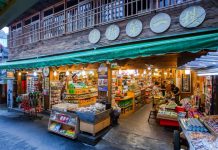
Explore Fenqihu old street — What to do in Fenqihu in…
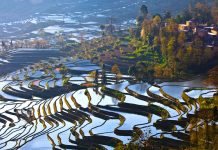
Where to go in Kunming? — 15+ top Kunming attractions &…

Must eat in Georgetown — 10+ famous, must-eat & best street…

Must eat in Melaka — 10+ famous Malacca street food &…

All about tips in Nepal — How much to tip in…

Cambodia travel tips — 15+ what to know & things to…

When is the best time to visit Kyoto? — The best,…
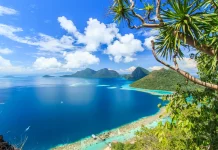
When is the best time to visit Malaysia? — The best,…

Hong Kong Soya sauce Chicken Rice and Noodles — The first…
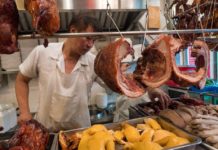
Hong Kong food culture — Hong Kong cuisine tells the historical…

Top hotels in Siem Reap — 8+ best places to stay…

Top hotels in shanghai — 15+ best hotels in Shanghai

Top hotels in Malacca — 10+ good & best hotels in…

Top places to stay in Bali — Top 10 best areas…

10 must-know things for your best first time European river cruise

Top 3 best luxury cruises in Halong Bay, Vietnam

Cherry blossom festival Korea 2024 — Top 5 cherry blossom festivals…

Ghibli museum blog — The fullest Ghibli museum guide for first-timers

Kyoto festival — Top 10 best events & most famous festivals…

National Palace Museum Taipei blog — What to see in National…

Japanese waterfall — Top 10 most beautiful waterfalls in Japan in…

19+ most beautiful towns in Europe every tourist need to visit…

Georgia travel photos — 20+ captivating photos show Georgia is heaven…

Explore Damnoen Floating Market — The oldest floating market of Thailand

Visiting Fenghuang Ancient Town — One of the most charming ancient…

Mekong Delta travel blog — Beyond rivers of Southwestern Vietnam

14 reasons why you should travel when you are young

Shigaraki Tanuki – An animal symbol of good luck in Japan

Living in the charms of cave houses in Andalucia, Southern Spain

20+ jaw-dropping tiny homes around the world
- South Korea
South Korea itinerary 7 days — What to do & how to spend 7 days in Korea perfectly?
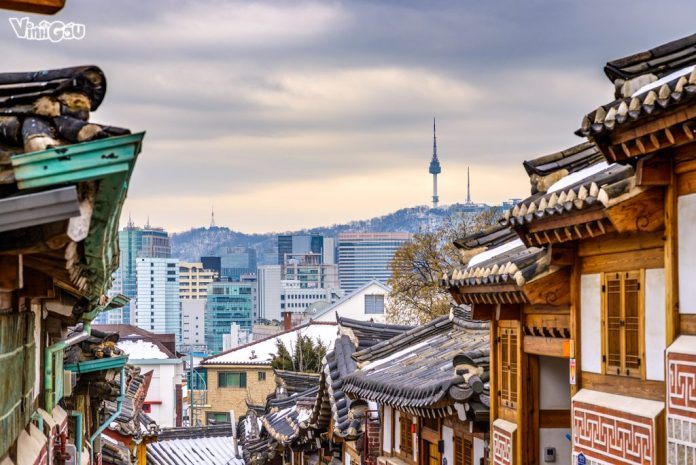
Traveling to Korea at this time is so beautiful because fall and spring are the two best times to come to Korea. Especially in the fall, one of the most romantic and charming season to go when the leaves are gradually changing to yellow, brown, and red everywhere. If you’re so enchanting and don’t go “virtual living” right away, how long will you have to wait? Let us suggest an 8-day, 7-night fun itinerary in Korea for you refer to. Except for one day for traveling, you will have 7 full days to explore the country of these gentle hanboks.
- Gyeongju 1 day itinerary — How to spend one day in Gyeongju, South Korea
- When is the best time to visit Busan? — The best, worst, affordable & best season to visit Busan
- When is the best time to visit Seoul? — The best, worst, cheapest & best season to visit Seoul
- When is the best time to visit South Korea? — The best, worst, affordable & best season to visit Korea
- Seoul cherry blossom 2024 forecast — 9 best places to see cherry blossoms in Seoul
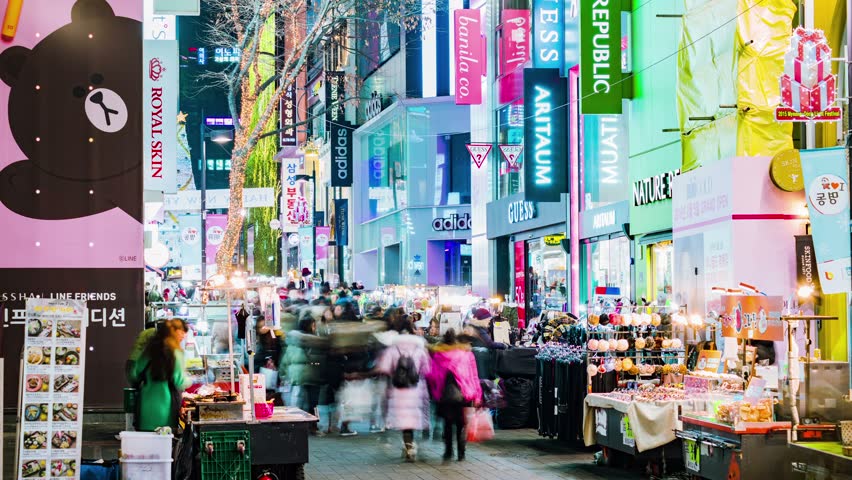
So, how many days in South Korea is enough? Let’s check out our suggested South Korea itinerary 7 days (Korea itinerary 7 days, South Korea itinerary 1 week, South Korea travel itinerary 7 days, 7 days in Korea itinerary, 7 days in South Korea itinerary, 1 week in South Korea) on how to spend 7 days in Korea perfectly in the land of Kimchi as follows!
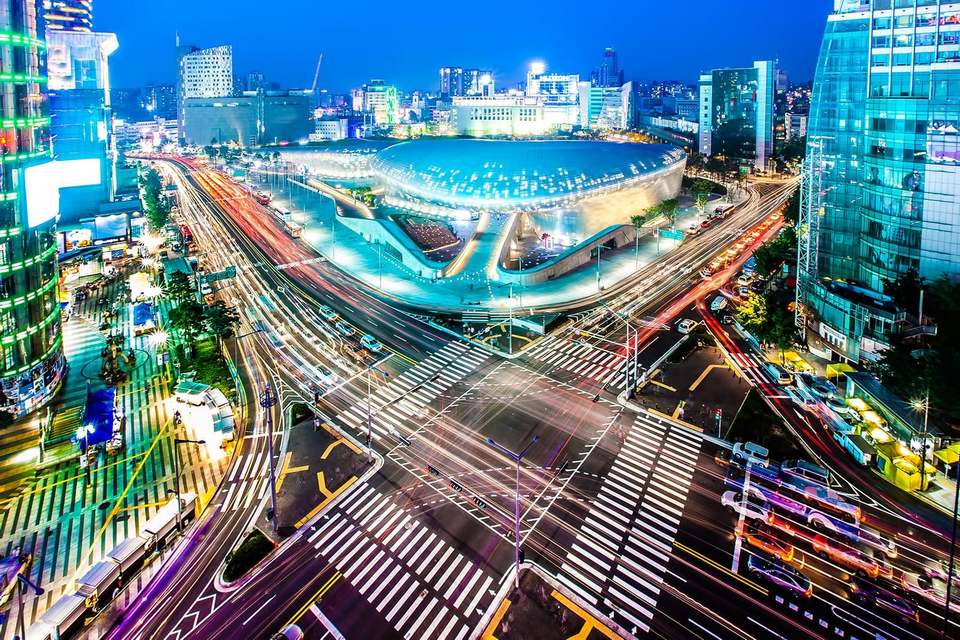
Itinerary summary of 8 days of traveling to Korea
- Day 1: Fly to Incheon (Seoul)
- Day 2: Stroll at Hwadam Botanical Garden & explore central Seoul
- Day 3: Explore Jeonju Hanok Village & Tangjaesan Garden
- Day 4: Stroll in Seoul Forest & traveling to the ancient capital Gyeongju
- Day 5: Explore Gyeongju & traveling to Busan
- Day 6: Explore Gamcheon Culture village, Jagalchi fish market and Haeundae Blue Line park
- Day 7: Explore Haedong Yonggungsa Temple, Gwangalli Beach and watch the sunset at Huinnyeoul Culture Village
- Day 8: Fly back from Gimhae (Busan)
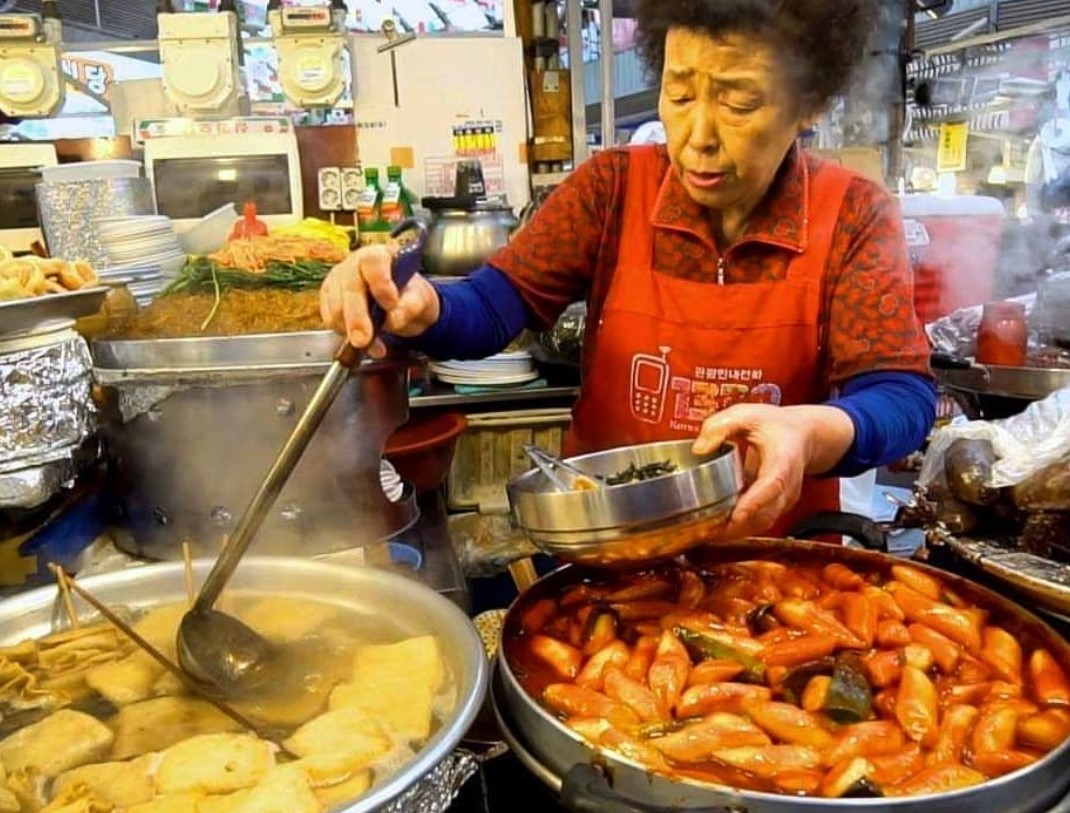
According to the South Korea itinerary above, you will have 7 full days to explore the beautiful country of Korea.
Day 1: Fly to Incheon (Seoul) (# south korea itinerary 7 days)
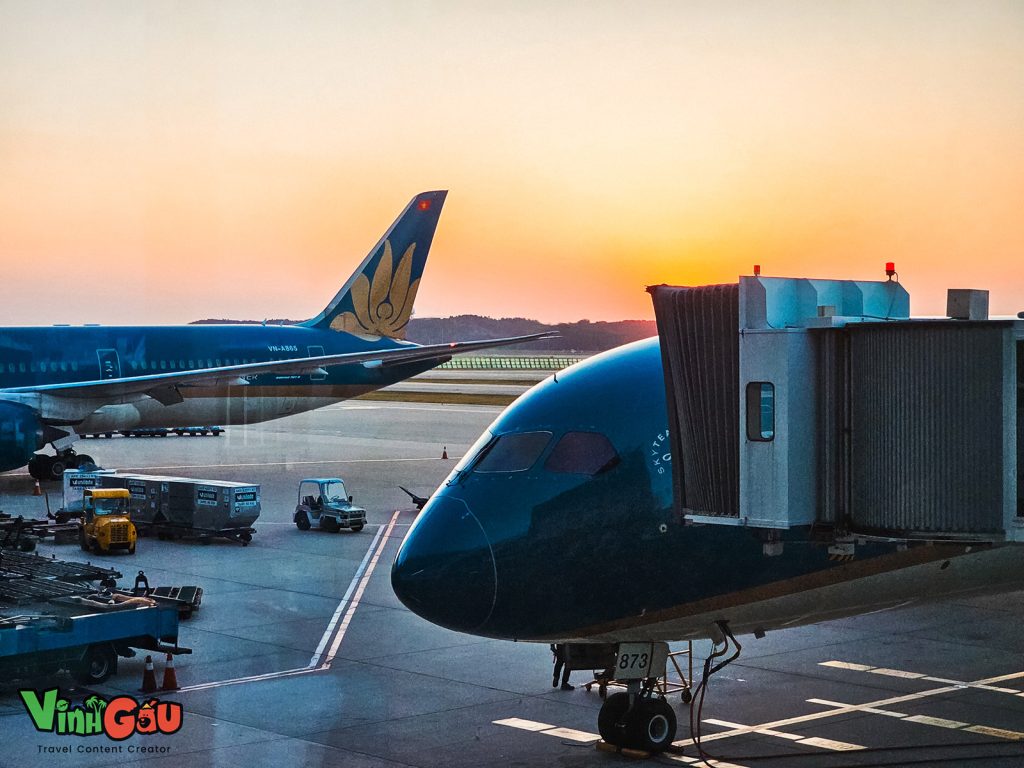
From Vietnam, there are many options for you to fly to Incheon (Seoul), so within the scope of this article, my departure place is Saigon, so flight time frame are for reference only. With flight search and compare sites such as Google Flights, Skyscanner or Kayak, you can easily find suitable flight times with just a few touches, just a few clicks. You should also purchase 4G Korean SIM card or 4G pocket WiFi , especially T-Money magic card for traveling, or transfer service from the airport to the city center on Klook in advance.
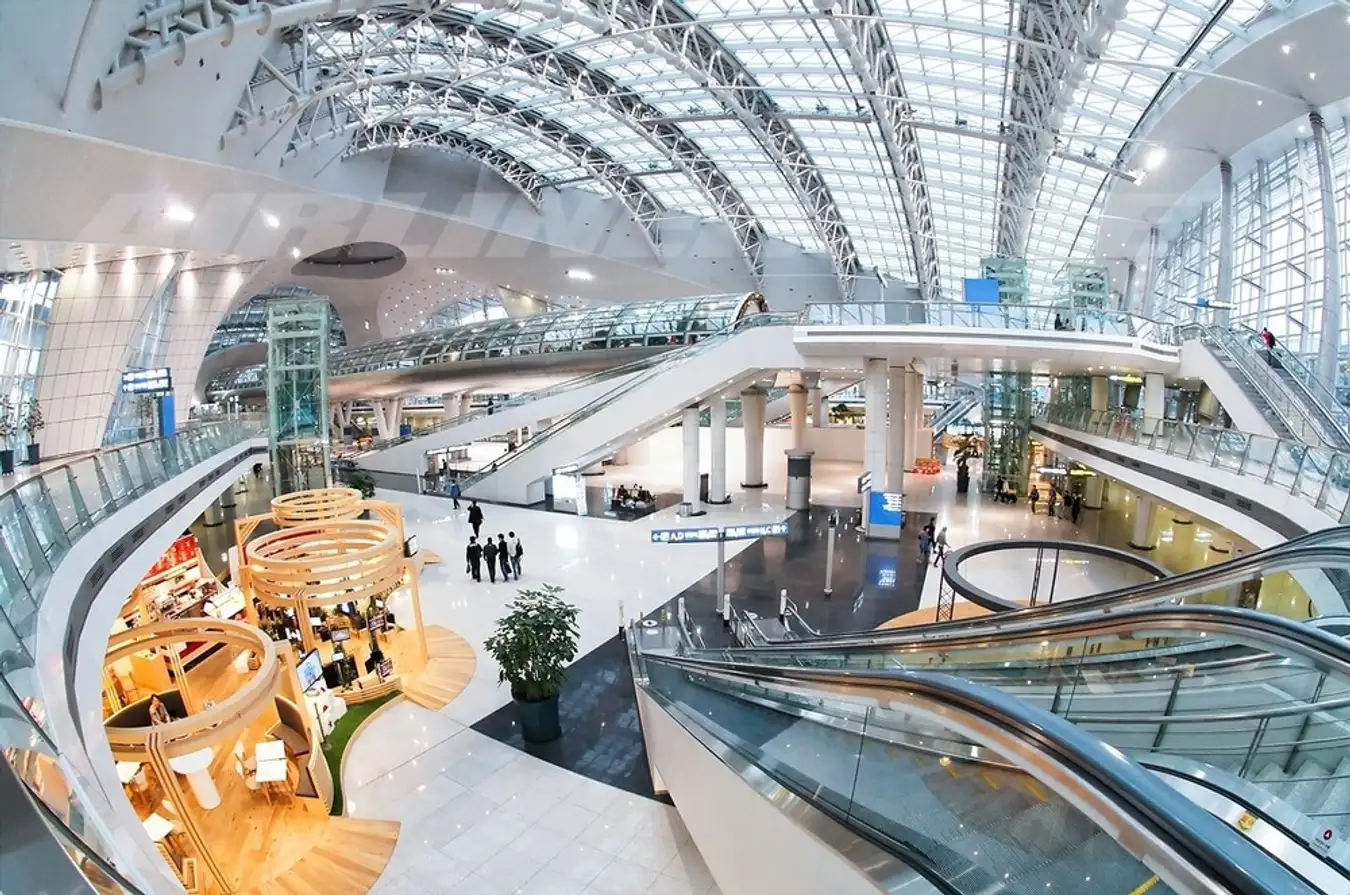
After many times of flying to Incheon, here are a few tips I’ve learned:
- You should take daytime flights to feel better, in particular for your health. Because, with night flights (around 11pm – 1am), you have to wait hard at the airport late at night, and then you don’t get much sleep on the plane because the flight lasts about 4.5 hours.
- When the plane lands in Incheon around 7am (Korean time), if you arrive in central Seoul and the hotel around 9-10am, you won’t be able to check in at the hotel because it’s usually around 3pm. These things can easily make you tired all day long, making you miss everything you do.
- You should fly on a wide-body plane to sit more comfortably, have a screen to watch entertaining movies, have adequate meals so you don’t get hungry from staying up late, and have preferential check-in baggage so you can freely bring clothes and accessories… For these reasons, I chose Vietnam Airlines, Korean Air for this trip to Korea to fly on a genuine Boeing B787 or Airbus A350.
After completing immigration procedures, you go to AREX train station to buy a train ticket to downtown Seoul, then getting to the hotel. Travel time is about 43-53 minutes, depending on the type of train you choose.
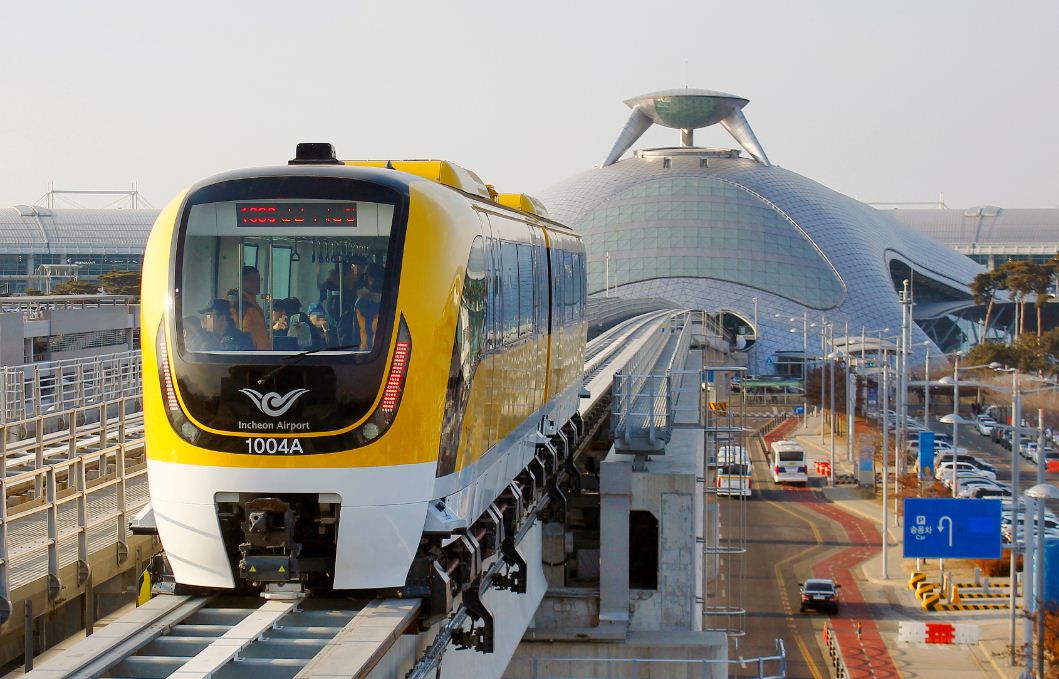
Arrive at the hotel, check in, have dinner and rest.
Day 2: Stroll at Hwadam Botanic Garden & explore central Seoul (# south korea travel itinerary 7 days)
You should come to this Hwadamsup garden early (around 8:30 a.m. – 9:00 a.m.) to have a chance to buy a ticket to visit this place. This is a garden with thousands of trees in the season of changing leaves, making the space here brightly colored yellow and red in the cool weather of Korean autumn.

This Hwadam botanical garden was established in 2013 by the LG Evergreen Foundation with the purpose of creating an ecological space where people and nature can have a conversation with each other. Anyone who loves flowers, plants and small animals will definitely love this place!
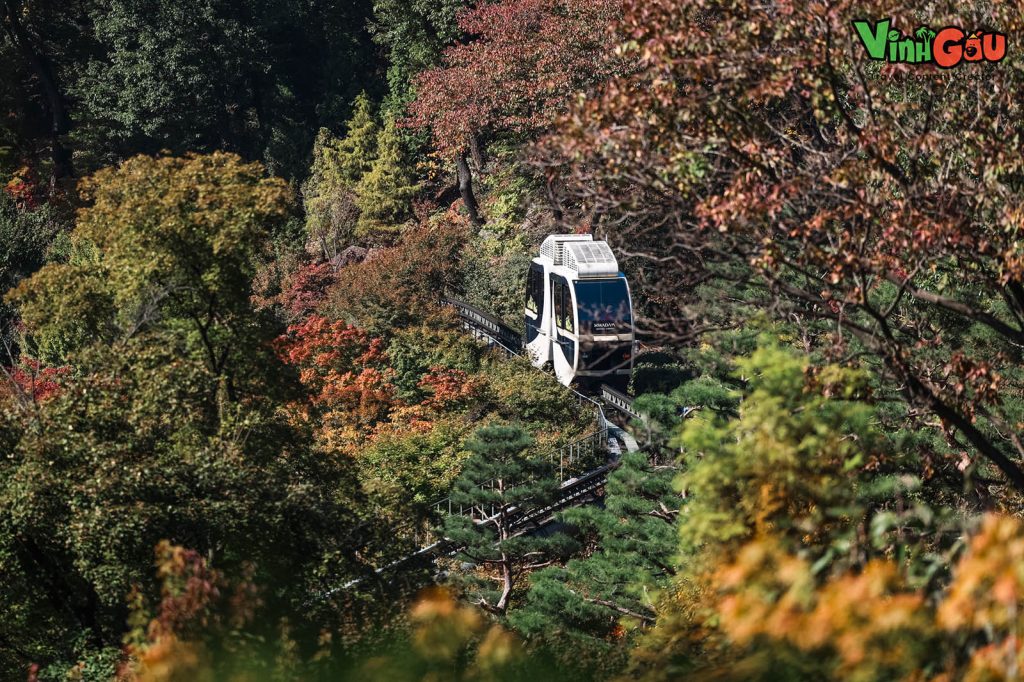
There are about 17 gardens with different themes, such as: birch garden, firefly garden, fern garden,… spread throughout the vast space here. Among them, there is the largest moss garden and pine tree garden in Korea.
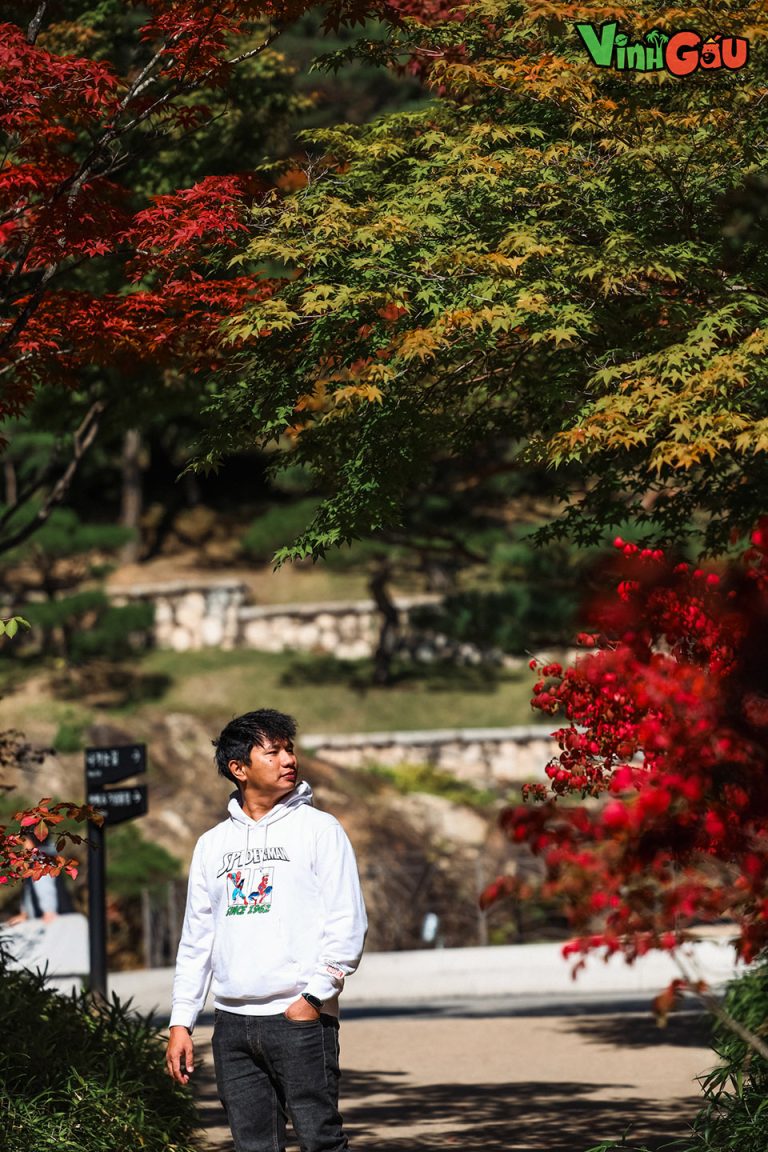
If you are too lazy to walk, you can combine it with the monorail to explore around this garden.
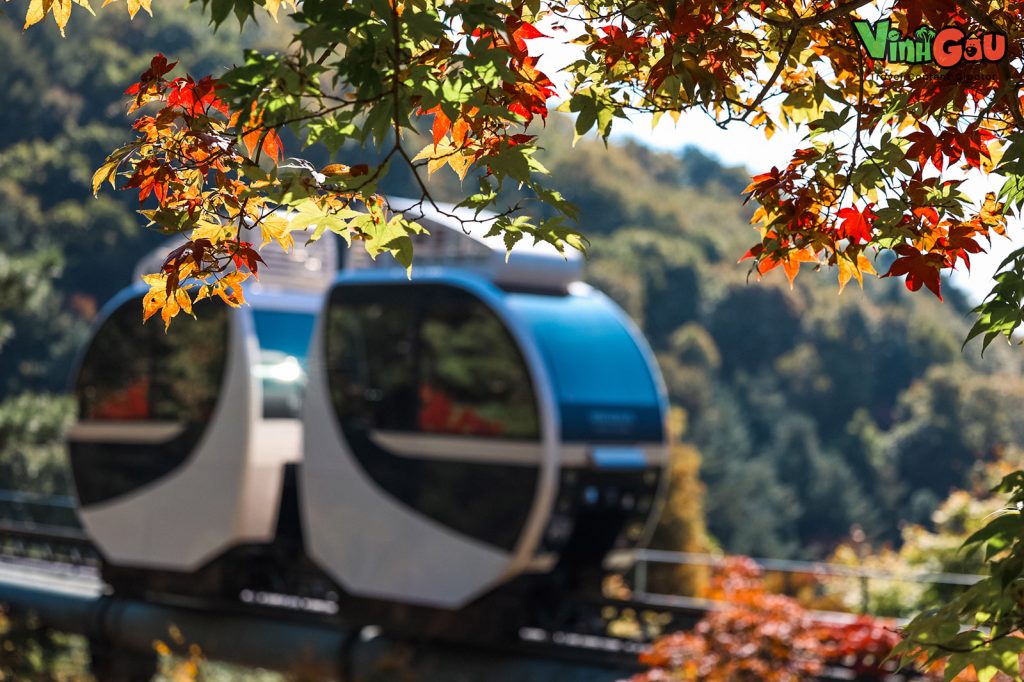
Afternoon (# south korea itinerary 7 days)
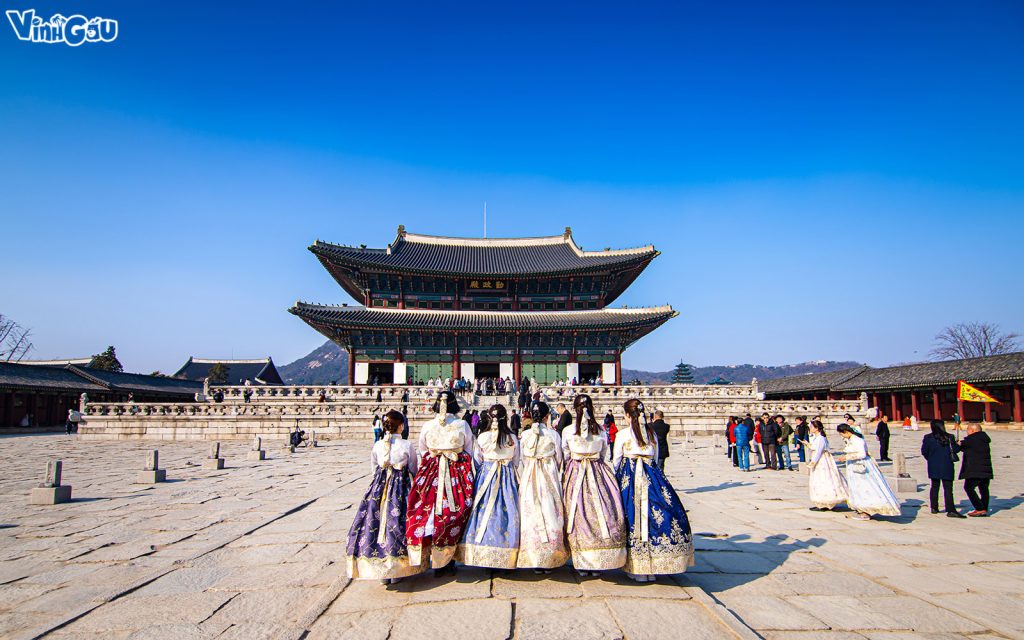
Back in Seoul, you can go to Gyeongbokgung Palace – the largest palace in Seoul, where the royal court is located, where the king’s throne is, and where the king and queen once live. When you come here, don’t miss the changing of the guard ceremony, this ceremony takes place every hour from 10am to 3pm, for 15 minutes. Very spectacular.
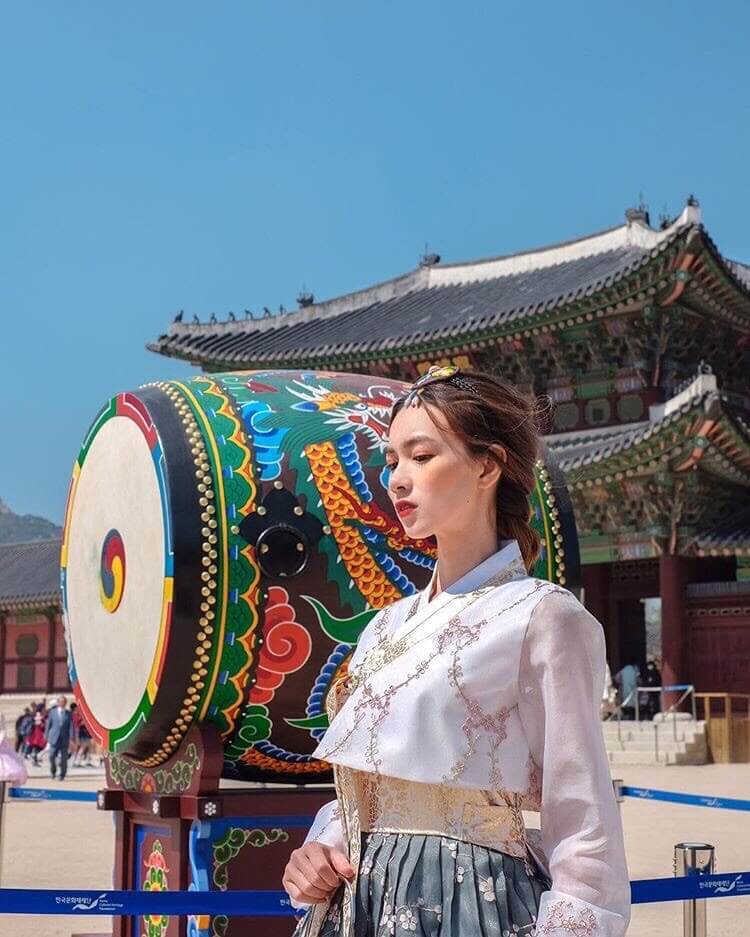
Next is the second largest palace in Seoul – Changdeokgung – where there is an open courtyard for the coronation of Joseon kings and a place to welcome foreign envoys.
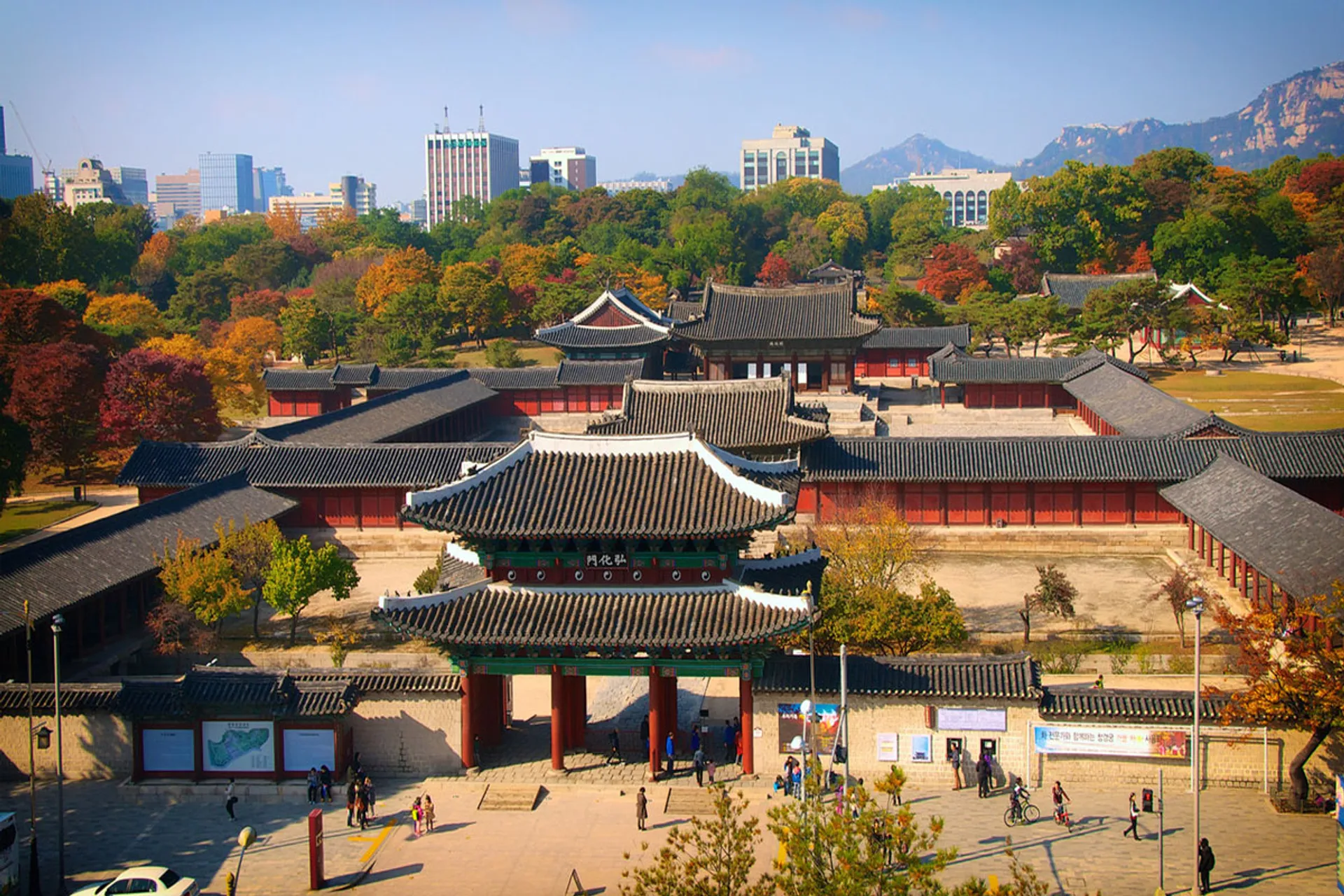
Well, when you come to Gyeonbokkgun palace area, remember to visit Bukchon Hanok Village right nearby. Here there are hundreds of traditional Korean houses – also known as Hanok – waiting for you to visit, experience and learn more about Korean culture when visiting Bukchon.
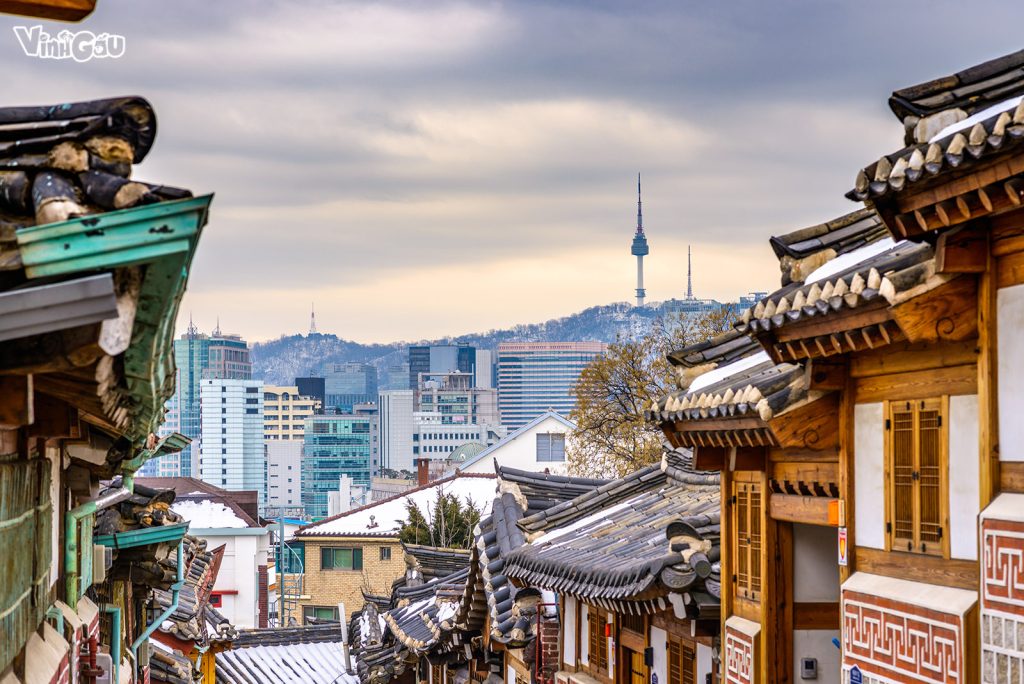
Evening (# south korea itinerary 1 week)
You can explore Myeongdong night market, the most famous shopping street in Seoul. From around 5pm onwards, Myeong dong is like “turning over” after a day’s sleep. In the middle of the road is a row of carts selling street food, snacks, etc. Just like that, smoke rises up, so you can stop and eat a little to relieve tired legs. Don’t miss the boiled intestines and hot fish cakes that everyone can see in Korean movies.
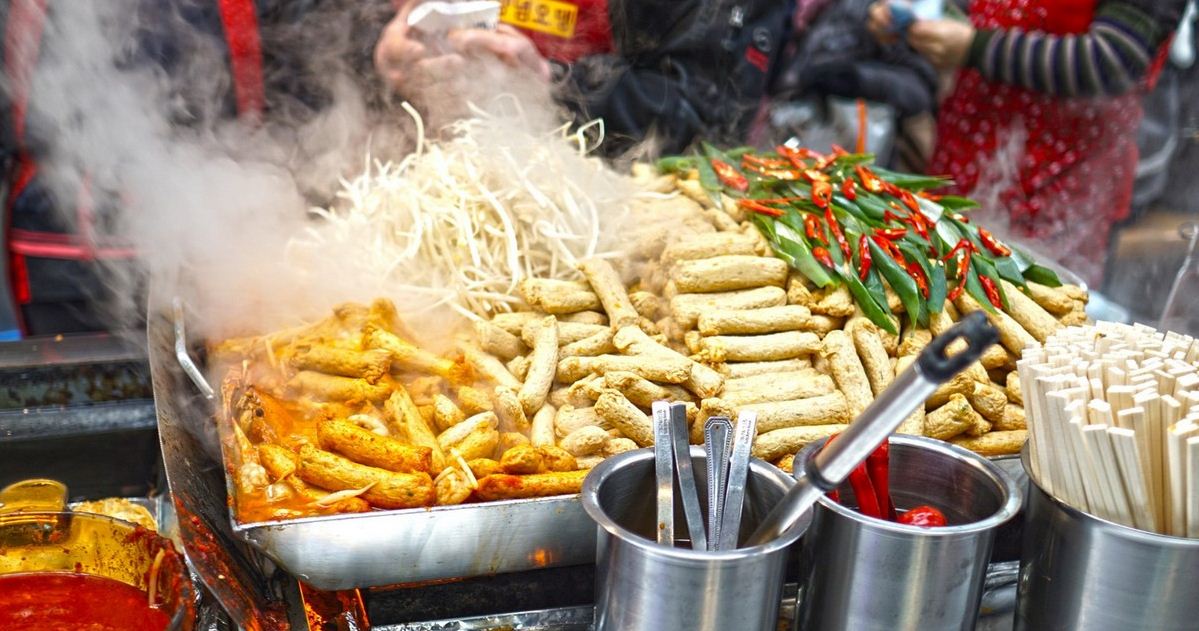
Day 3: Explore Jeonju Hanok Village & Jangtaesan Recreational Forest (# korea itinerary 7 days)
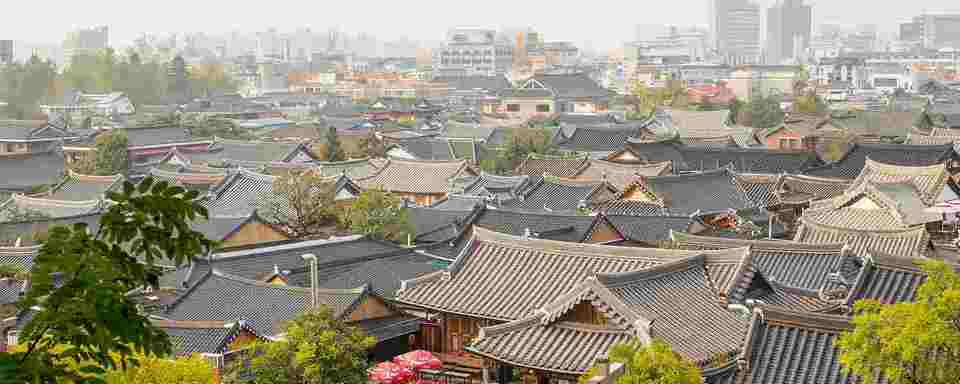
Although located more than 3 hours away from Seoul, this Jangtaesan Recreational Forest always attracts a large number of tourists to visit in the fall, when the whole forest turns yellow and red leaves.
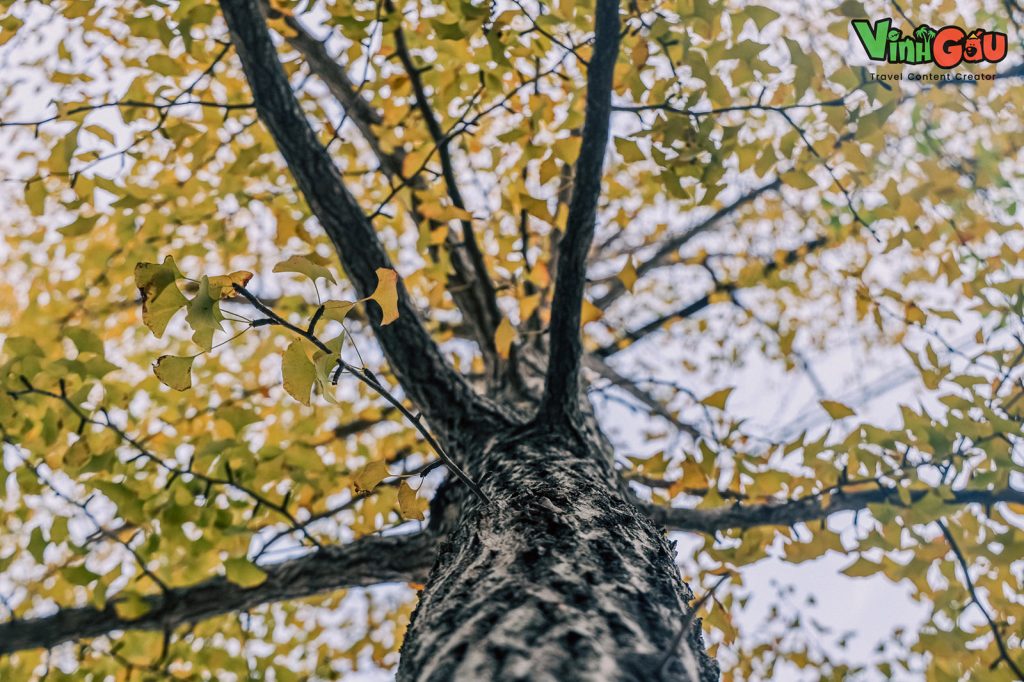
This is the place I want to go back to the most because when I arrived today, the leaves were still very green, around the 2nd week of November it would be absolutely beautiful. However, with the inherent beauty of the forest, blue also has its own appeal… but red is much more beautiful, lol.
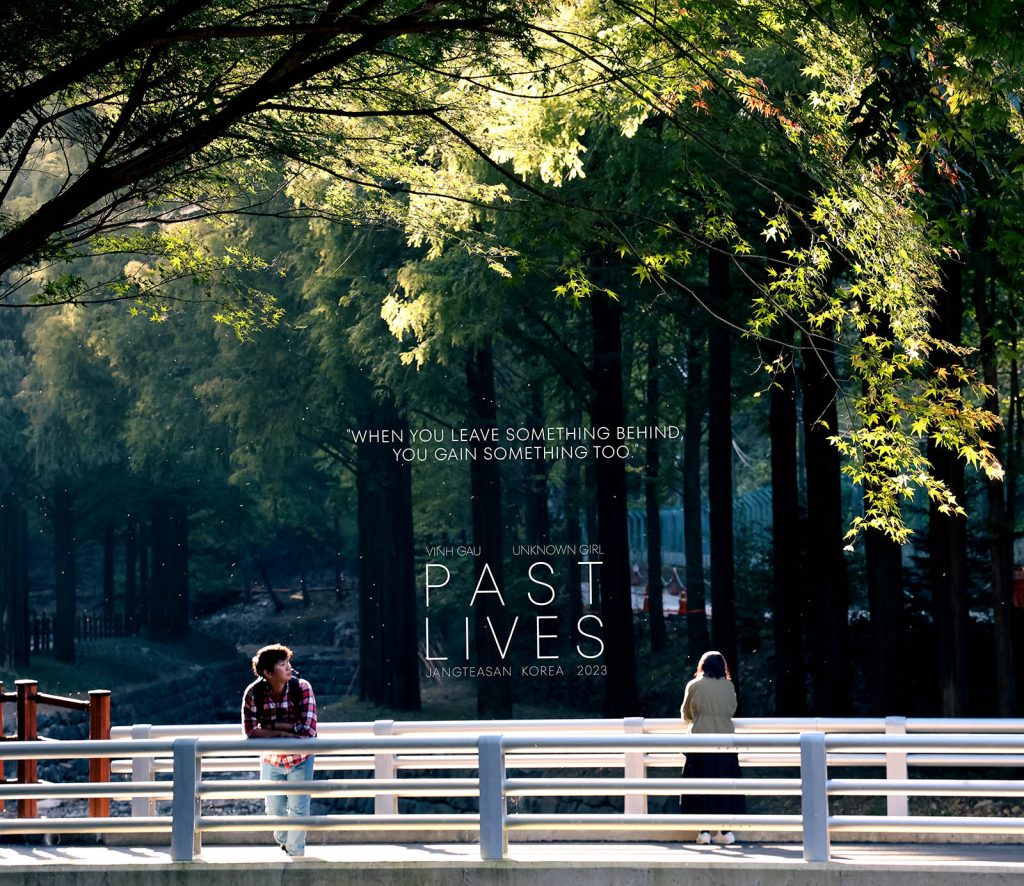
I was fascinated by the straight and tall rows of Dawn redwood trees (Metasequoia), maple trees, etc. here. Walking around these forests in the cool autumn air, It was so relaxing.
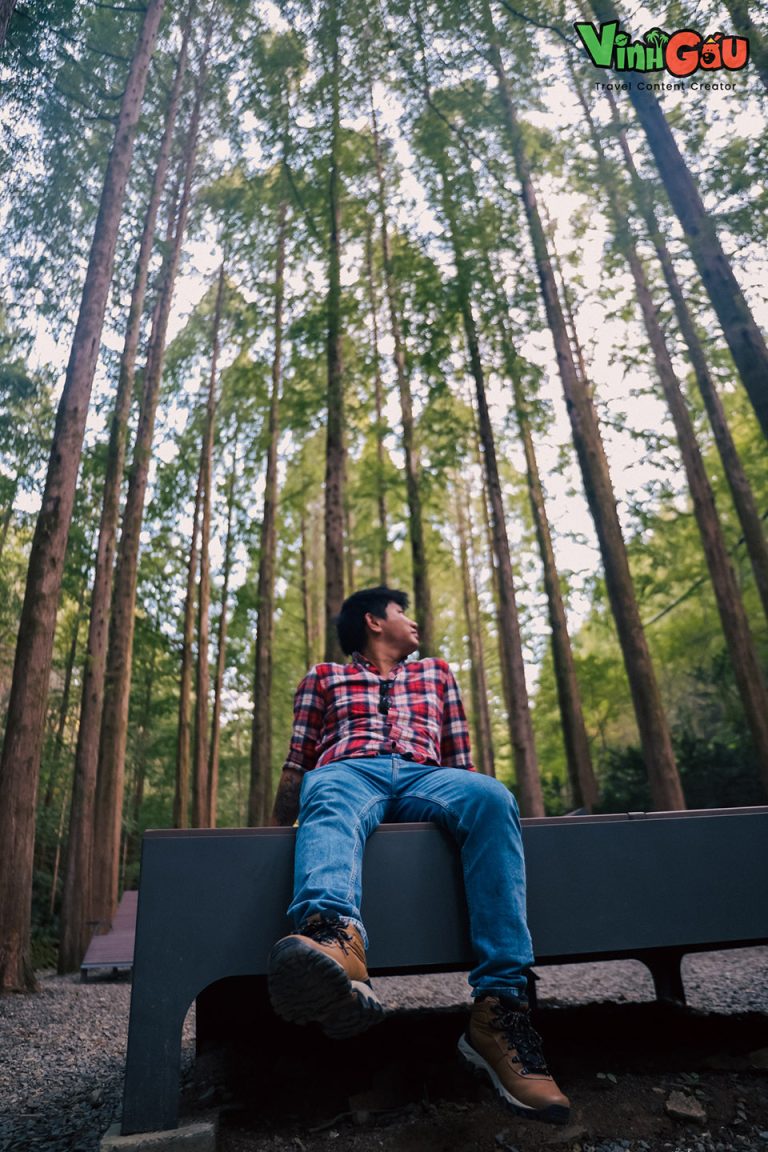
But perhaps many people come here because they want to experience the feeling of walking on the suspension bridge “through space” through the two forests here, then climbing about a hundred more stairs to reach the legendary virtual living rock of this place. From here, you can stand to see the panoramic view of the forest here (it’s still a shame because the leaves haven’t changed color yet) or sit on the cliff to take really cool photos.
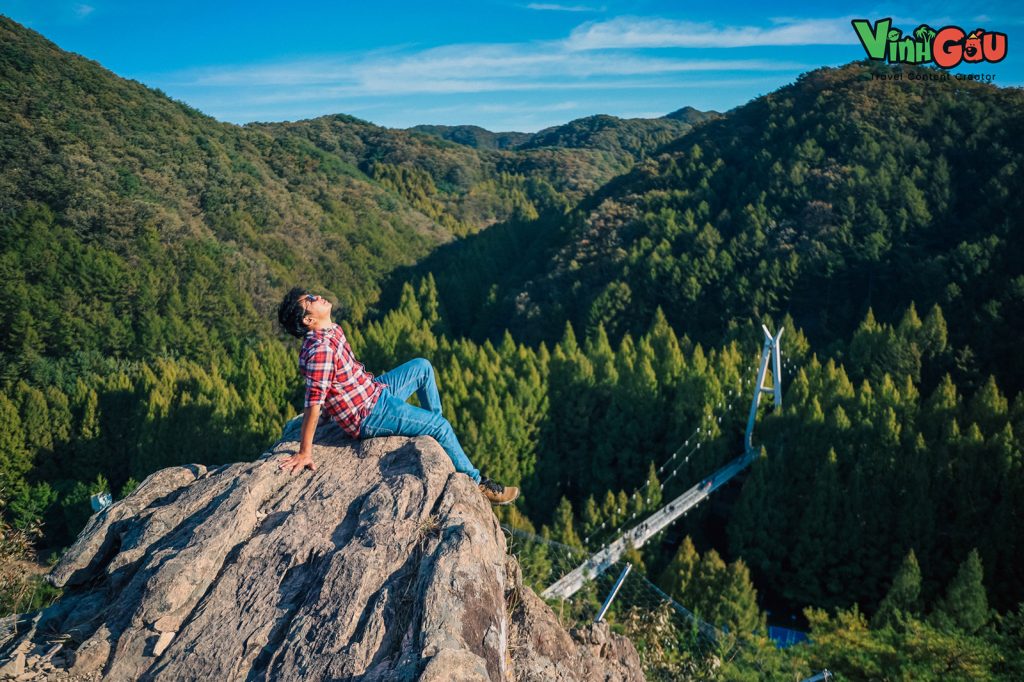
You can buy a one-day return tour via this LINK .
In the evening, you take time to explore the Hongdae neighborhood.
I like Hongdae because the vibe here is very youthful, artistic and stylish. From cafes, fashion and accessory stores… to groups performing, dancing, and singing on many different street corners. I also like to go to Hongdae to hang out with friends, there is a variety of food here and the prices are also reasonable.
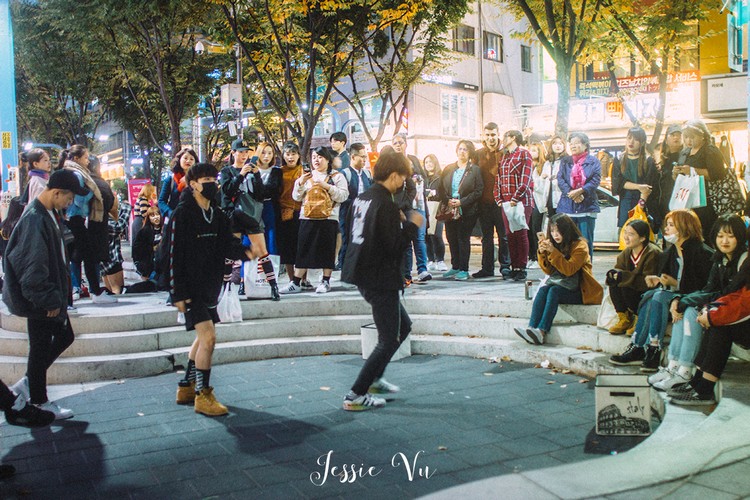
Day 4: Stroll in Seoul Forest & traveling to the ancient capital Gyeongju (# 7 days in south korea itinerary)
You can spend the morning going to Seoul Forest and enjoy the fresh air here. Seoul Forest is a place where Seoul people often bring food and drinks to spread out under the trees and watch the forests change color in the fall or cherry blossoms in the spring.

This forest is also worthy of comparison with Central Park in New York, USA. Surrounding this forest are towering office buildings.
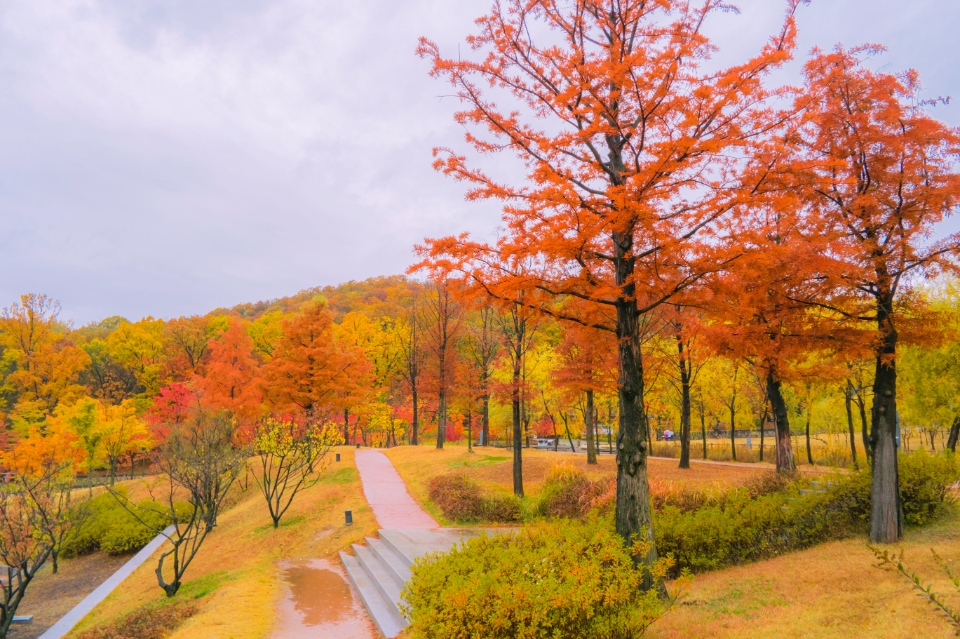
After having fun, drag your suitcase to Seoul Station to board the KTX train to Gyeongju.
Day 5: Explore Gyeongju & continue journey to Busan (# 7 days in korea itinerary)
The younger siblings who went with me said: “I like Gyeongju more than Seoul”, I just smiled lightly. Obviously, the ancient capital always has something that attracts tourists more than the city. Such as: larger natural landscape, fresher air, more winds that make me shiver, more traditional houses,…
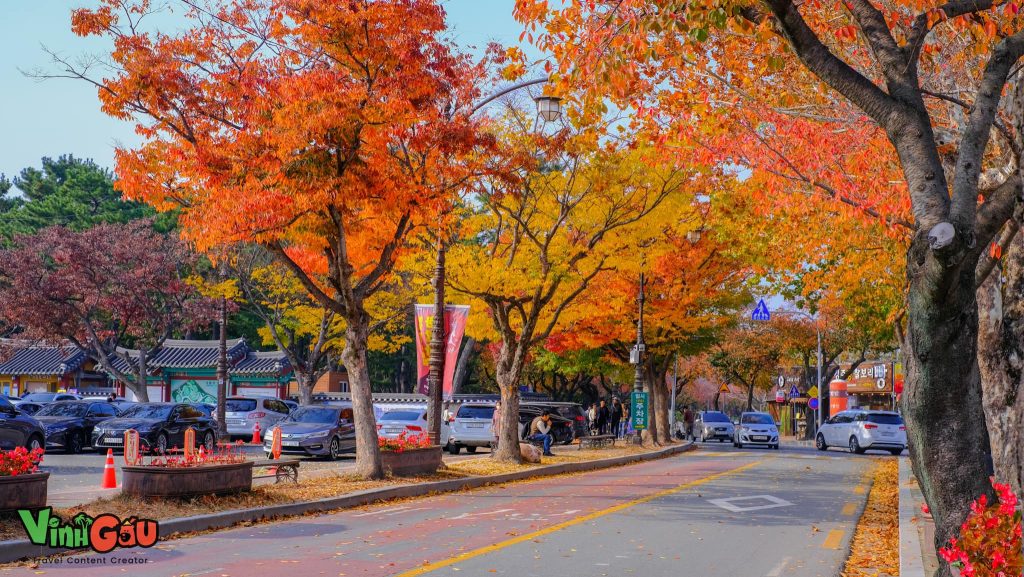
Here are a few places you can visit or see more details through this article:
Fields with types of grass: pink grass, reed grass, foxtail grass,… in the Gyeongju historical site. I went when it was sunny – around noon – the color of the grass, especially the pink grass.
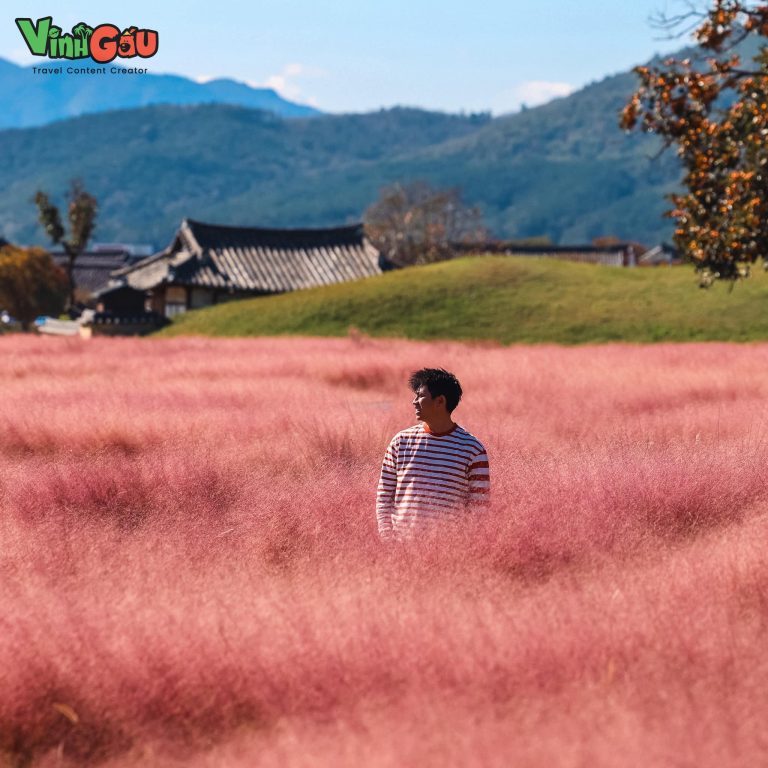
Donggung Palace & Wolji Pond: This is the Crown Prince’s palace of the Silla period. My first impression when I arrived here was the airy, quiet space and very poetic landscape. I was fascinated by the rows of forests in the changing season of leaves in this palace, I could only stand “dumbfounded” when I saw the yellow and red leaves gently falling every time there was a breeze. How many times do I have to click my tongue: “So damn beautiful!” when walking in Donggung palace here and there.
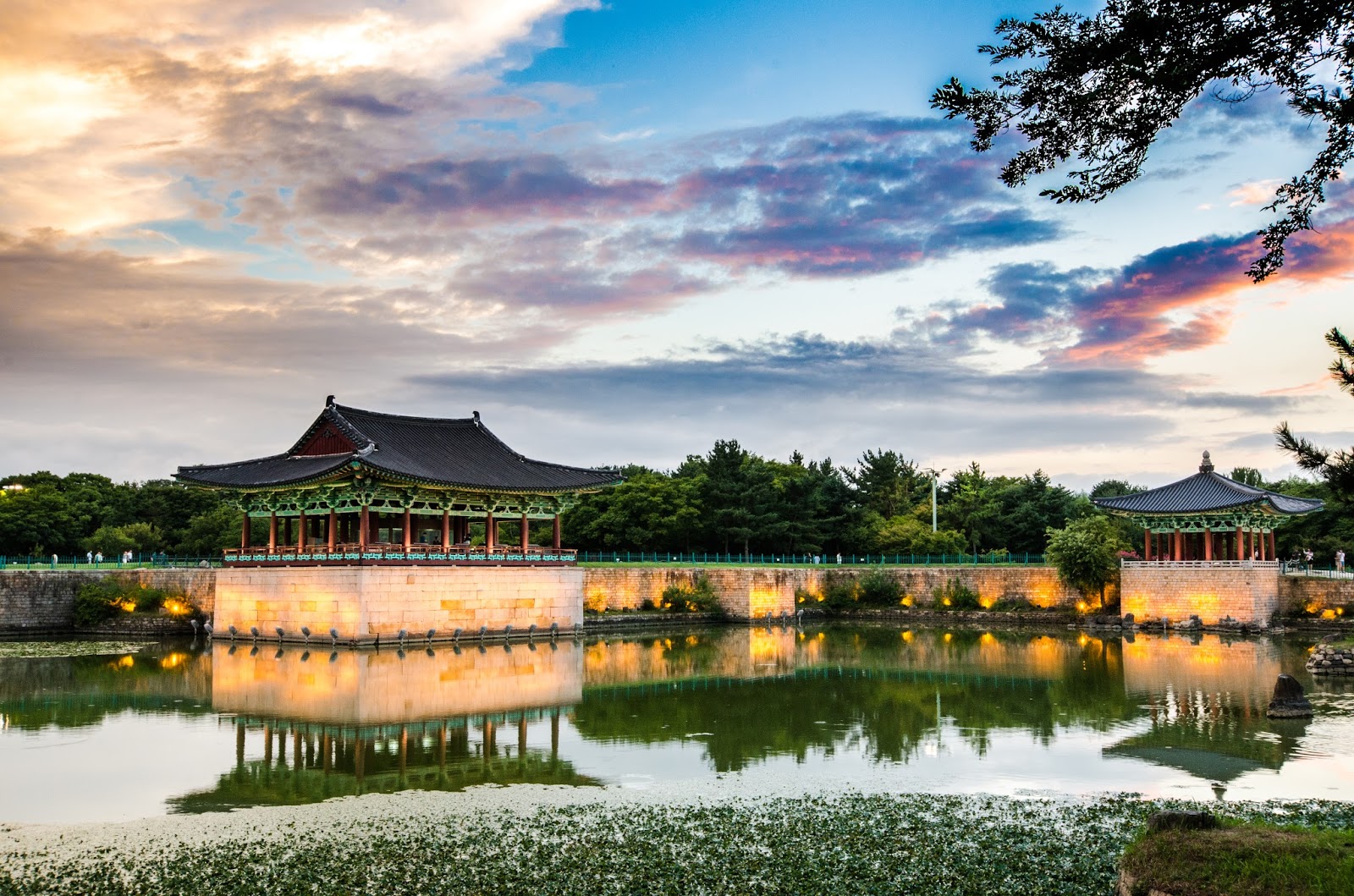
Bulguksa temple is more than 1000 years old and is recognized by UNESCO as a world heritage site. Ignoring stories about history or Buddhism, this is a place with very beautiful scenery. There are many Dawn redwood trees, maple trees, persimmon trees, etc. that have been planted for a long time, so the roots and tree shapes are very beautiful. The leaves here are gradually turning red, very beautiful.
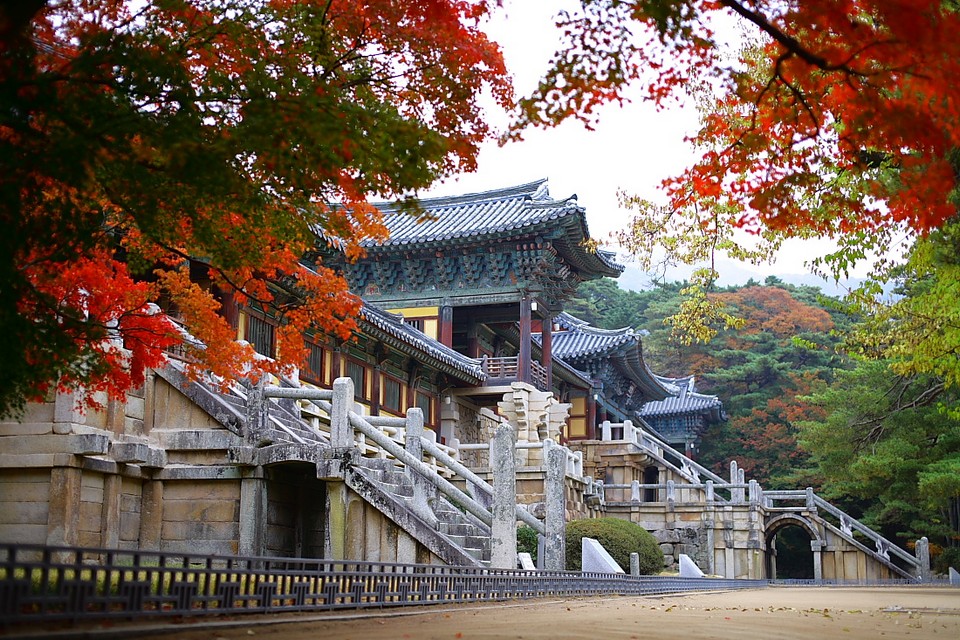
In addition to “hunting” for red leaves, you can wander on Poseok-ro street to enjoy the youthful space with many lovely restaurants, cafes, clothing stores, accessories,… with young Korean people. Vibe is so interesting!
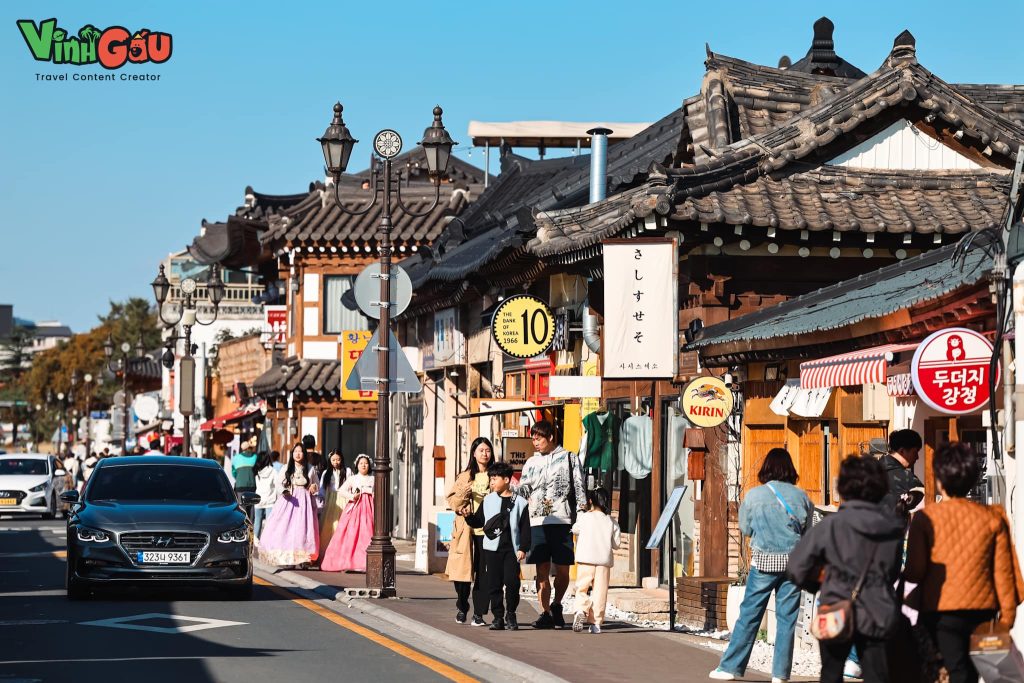
Then in the late afternoon, you drag your suitcase to the KTX train station or Gyeongju Express Bus to move back to the coastal city of Busan.
Day 6: Explore Gamcheon village, Jagalchi fish market and Haeundae Blue Line park
Gamcheon culture village.
This place used to be a “slum” for refugees during the Korean War. Gradually, the population of this place decreased a lot because young people left the village to go to other places to do business and live.
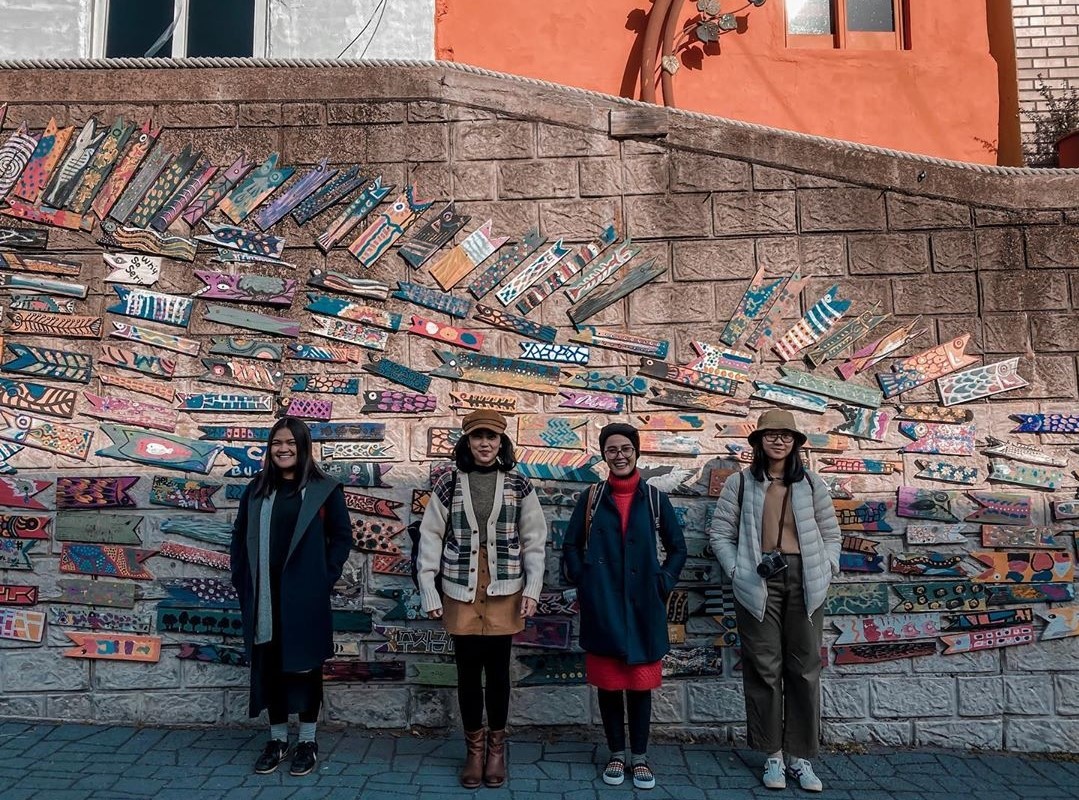
It was not until 2009 that the Korean Ministry of Culture launched a project to renovate the village and invited many artists and art students to come here to beautify the village, making it much more lively. Thanks to that, Gamcheon has now become an extremely hot tourist destination in Busan.
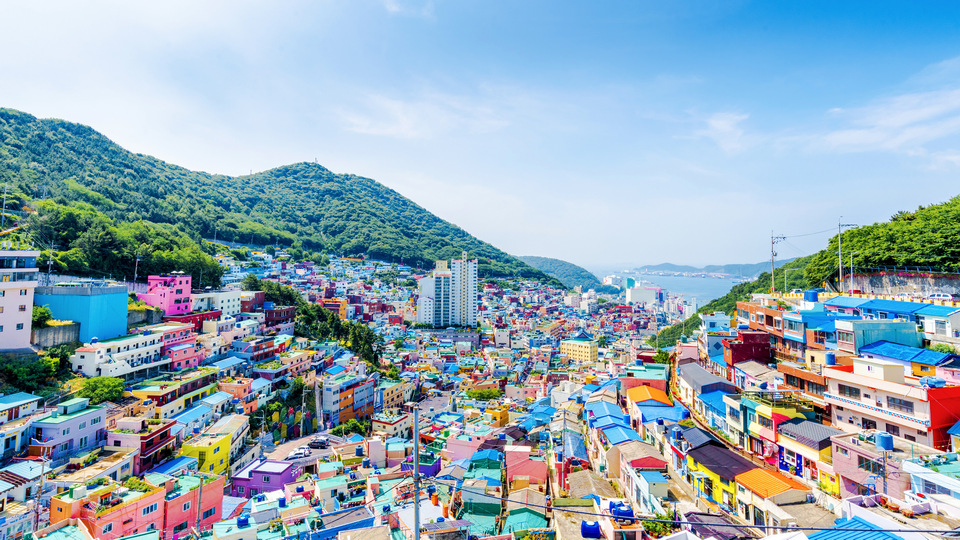
Jagalchi fish market
Jagalchi is the largest fish market in this country, and is also a whole sale market to supply a huge amount of seafood to all of Busan and neighboring cities. Saying it’s a fish market, it’s not smelly at all but very clean.
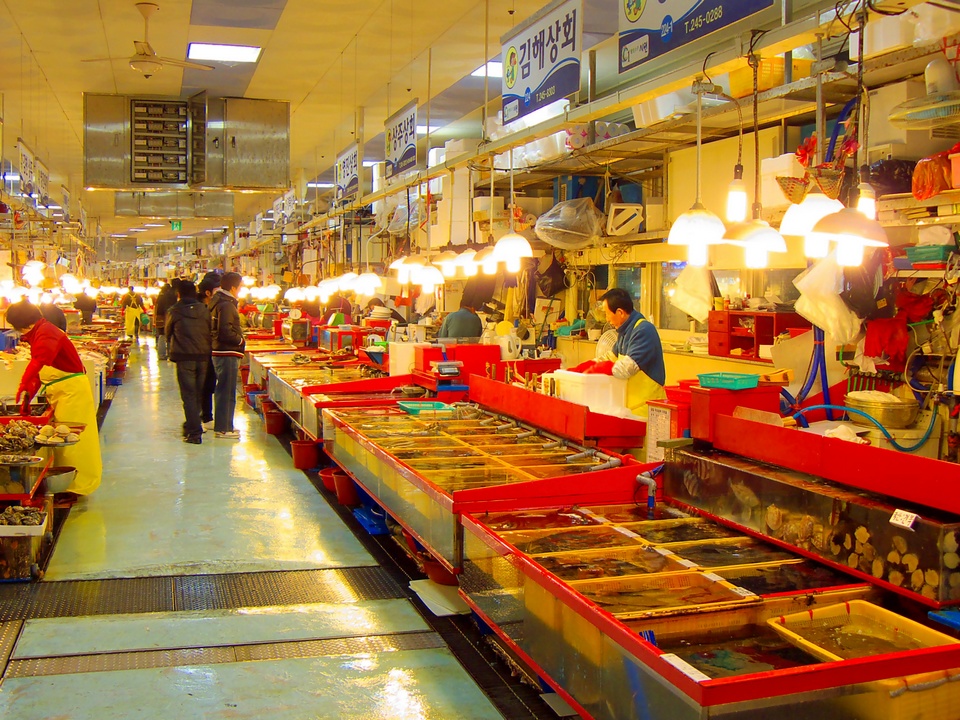
This fish market is very large, divided into many separate areas and operates day and night. Fresh seafood processing and selling area, dried seafood area, and dining area for both residents and tourists. They are very neat and organized. Remember to enjoy the seafood dishes at this fish market before leaving.

Haeundae Blue Line Park
This park was formed on the previously closed Donghae Nambu Line train station area, and is now built into a nature-friendly tourist destination with trains running continuously with a green forest on one side. high up in the sky and on one side is a beautiful blue beach.
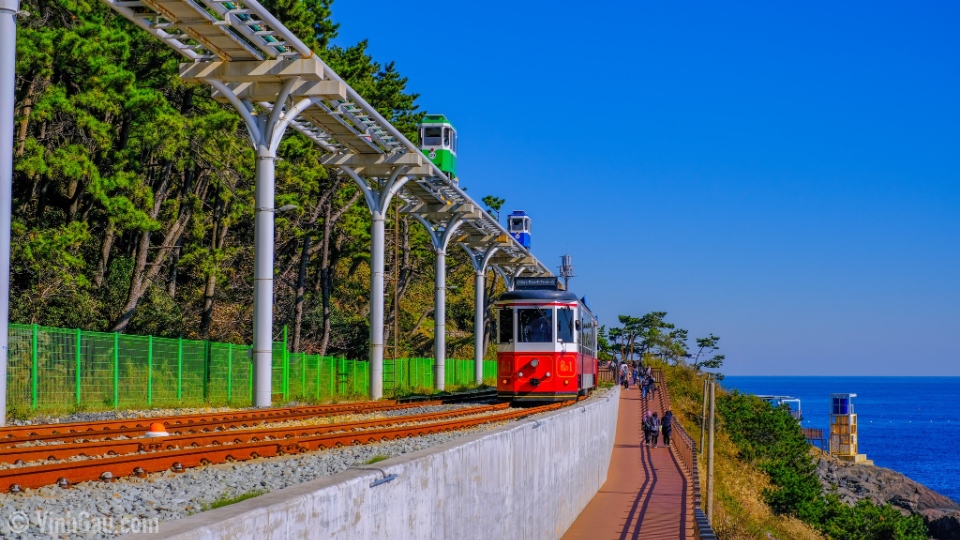
The total distance of this Blue Line park is 4.8km. The most beautiful route I think is: You go to Mipo station, take the Beach Train to Songjeong station, then walk back to Cheongsapo and take the Sky Capsule cabin to return to Mipo station. If you don’t mind walking, you can take the Beach Train to Cheongsapo station.
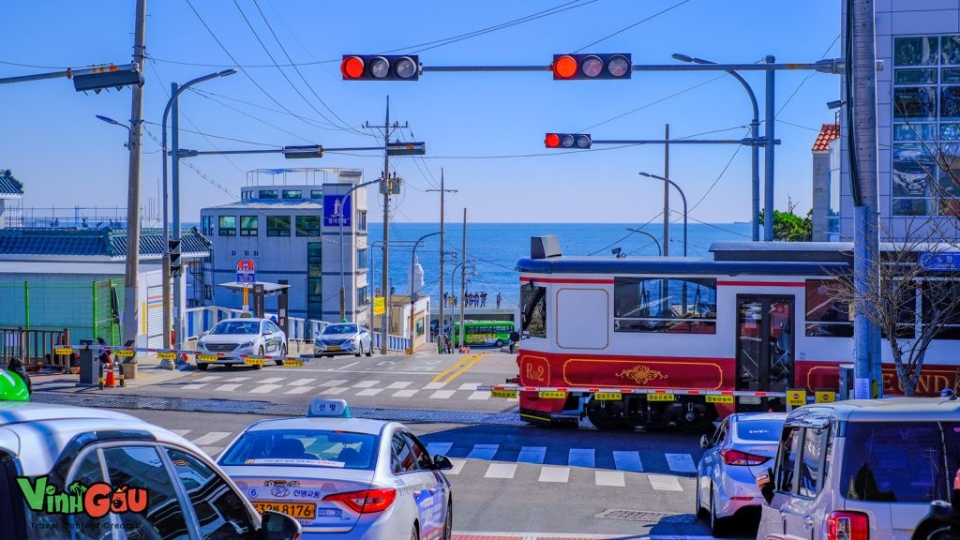
You should buy tickets in advance on the bluelinepark website, change the language to ENG and then book tickets. You should book tickets as early as possible. If the time you want to go is sold out, you can go to the ticket counter early to buy a ticket to go on the same day. In particular, Sky Capsule tickets often sell out quickly. Ah, if you go at sunset time, it’s so beautiful.
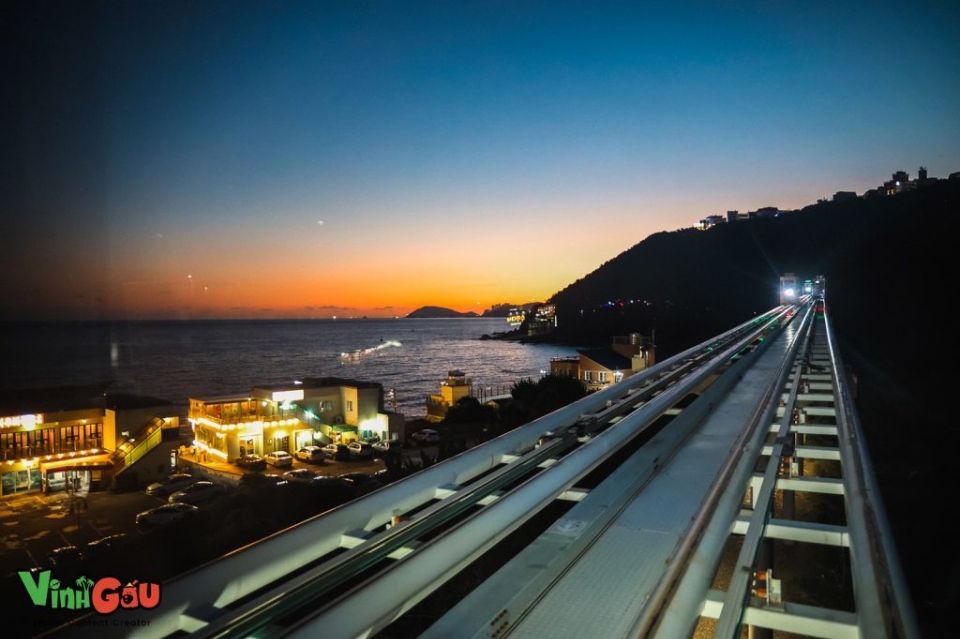
Day 7: Explore Haedong Yonggungsa Temple, Gwangalli Beach and watch the sunset at Huinnyeoul Village
Younggungsa temple.
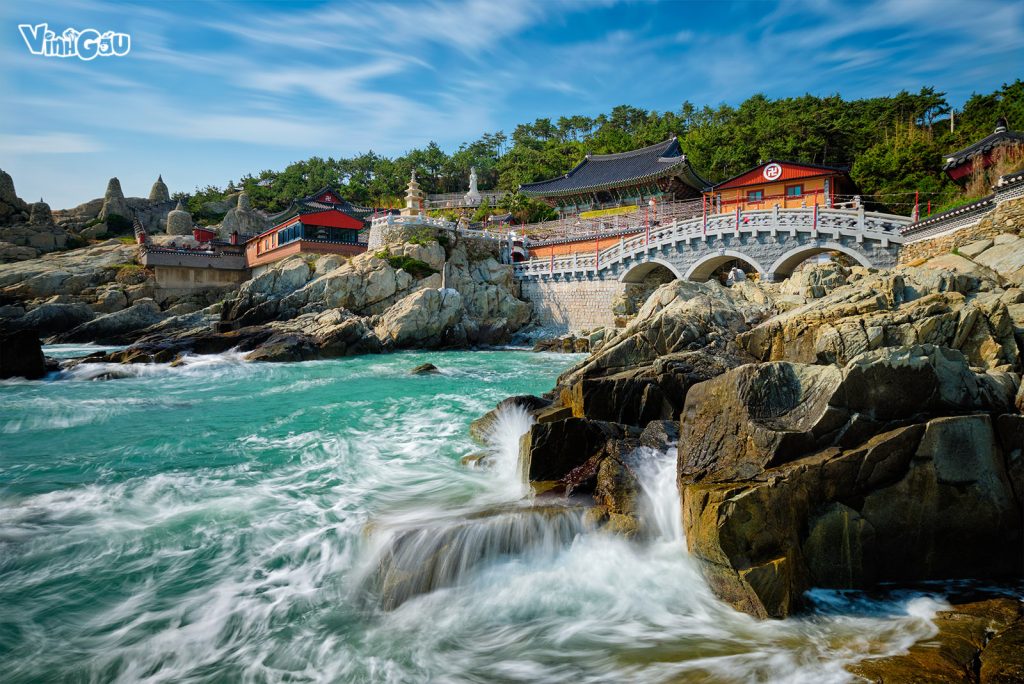
Probably one of the few temples located right on the coast in Korea, because most temples here are usually located in the mountains. Thanks to that, Younggungsa has become an interesting highlight for Busan as it is located on the beautiful Gijang coast.
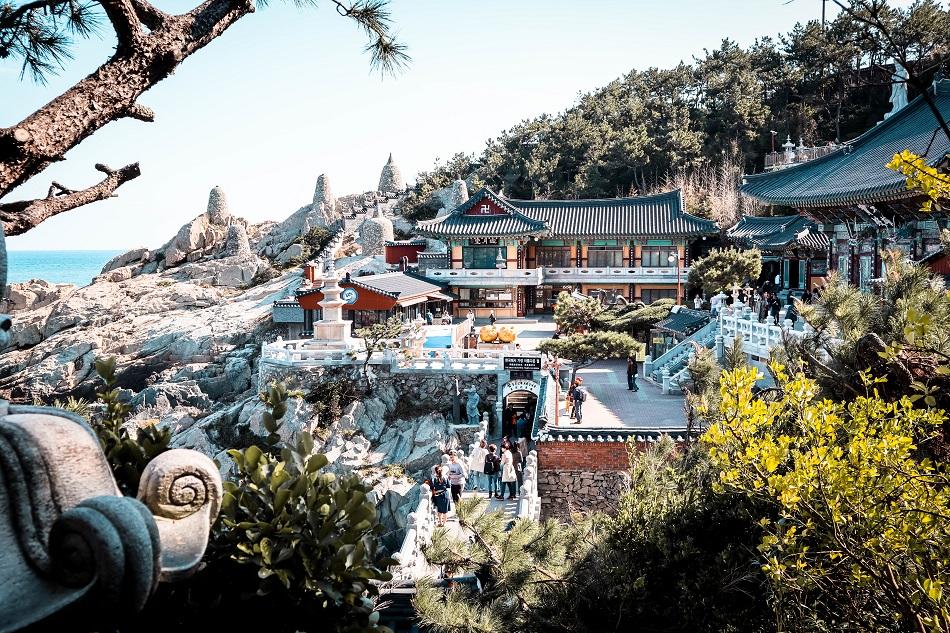
This temple was first built in 1376 with the name Bomunsa. However, the temple was destroyed during the war with the Japanese invaders in 1592. And after more than 300 years, in 1930, the temple was rebuilt with the name Yonggungsa (meaning: Palace Dragon) as at present. As for the main hall of the temple, it was completed in 2005.
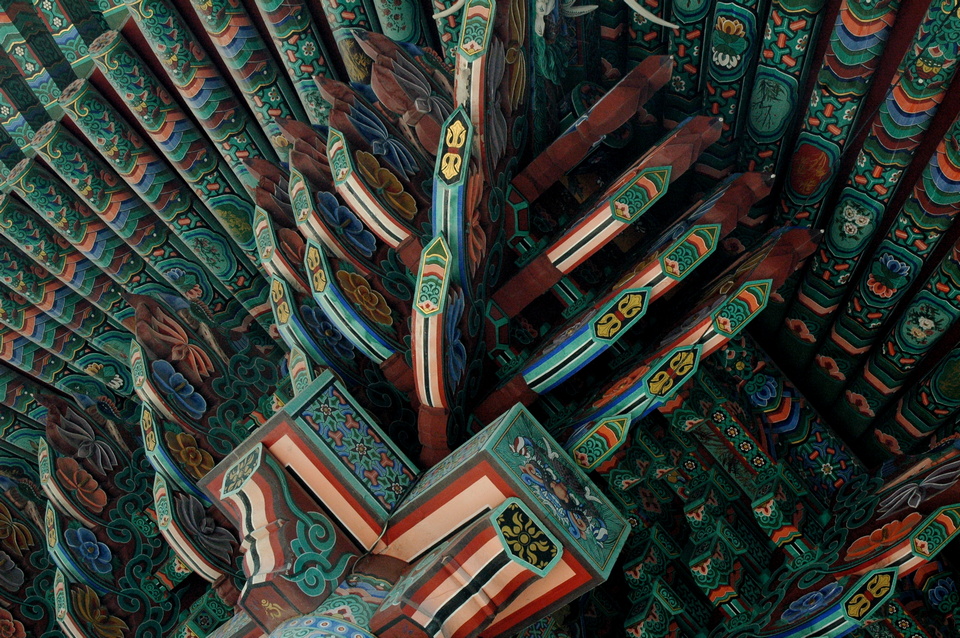
This temple attracts a large number of locals who come here on New Year’s Day to watch the first sunrise of the year and pray for a lucky year.
Gwangalli Beach
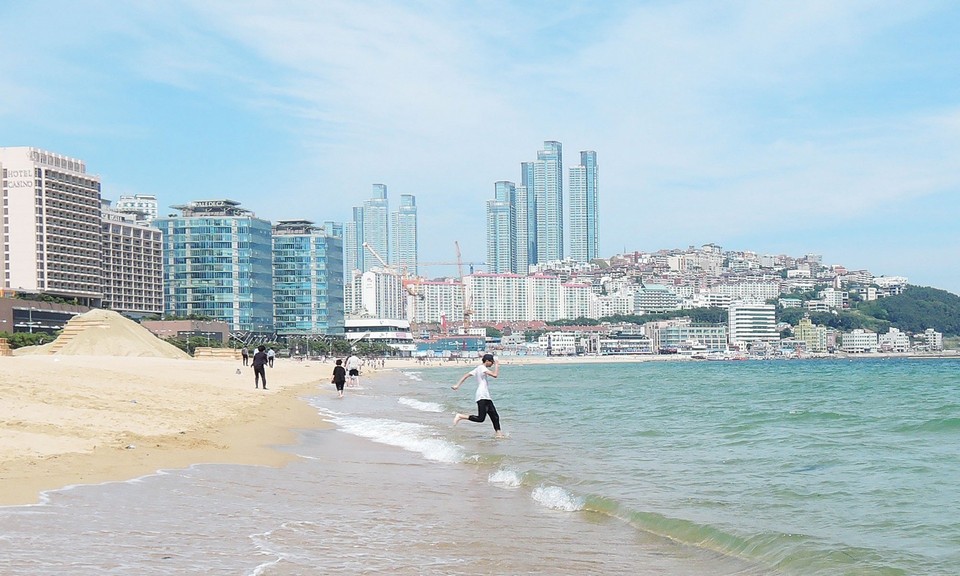
This beach has become a destination that attracts young people everywhere not only because it is a beach in the center of Busan, beautiful and peaceful, but also because of the photos with the Gwangandaegyo bridge standing out in the background. There are many cafes and restaurants with sea views around here for you to relax with friends and family.
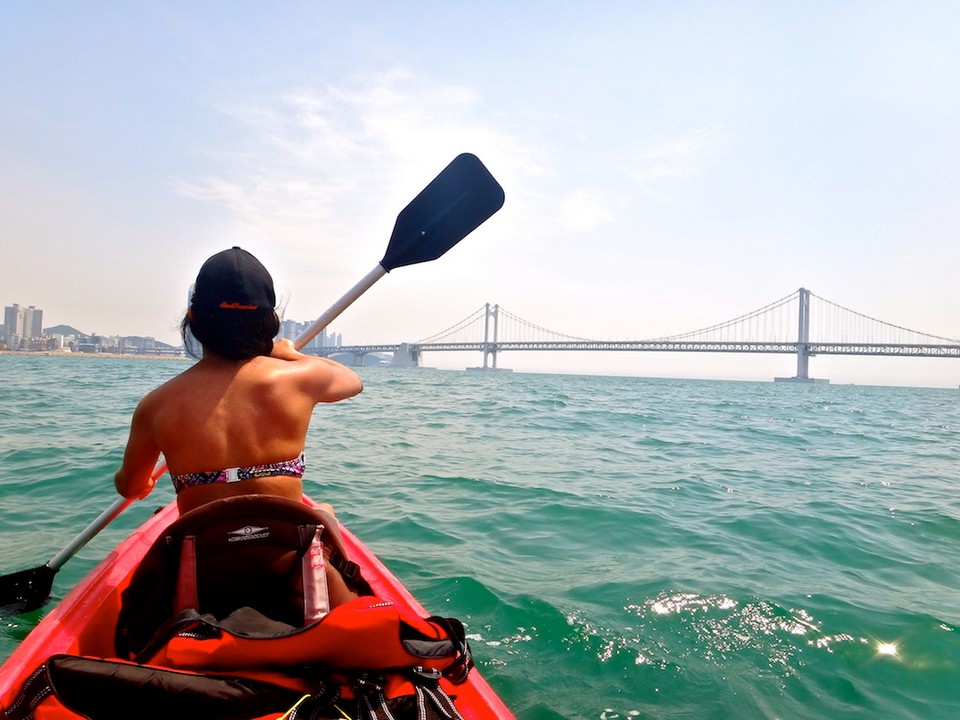
Huinnyeoul Cultural Village
This is a place whose “specialties” are tiny alleys along the coastal slope, with many cafes with views straight to the Busan bridge, Namhang port and towards the setting sun. Therefore, in the afternoon, this village is much more bustling, although it is not as well known as Gamcheon Cultural Village.
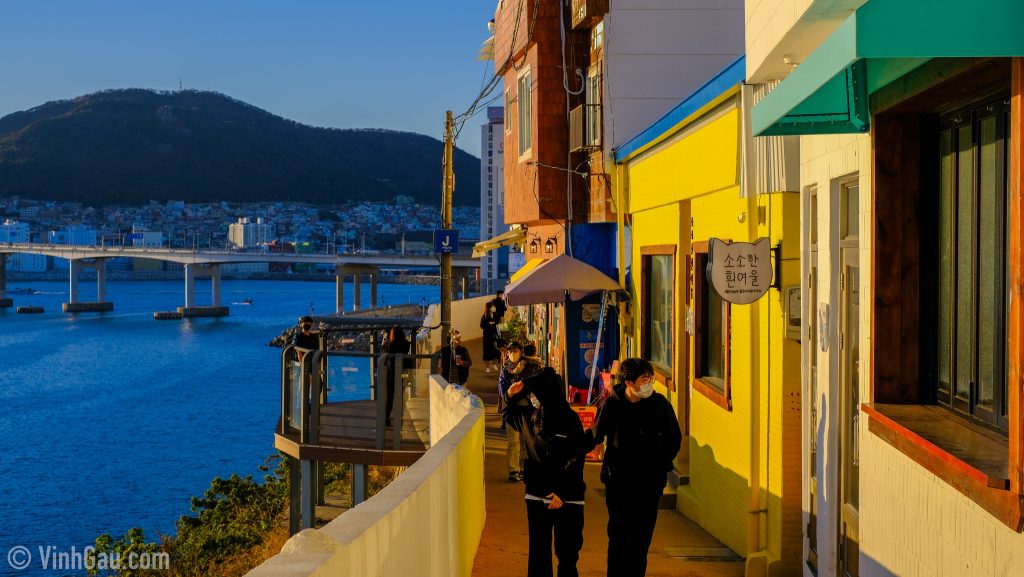
The beautiful small houses with many outstanding colors also make every corner in Huinnyeoul become very “impressive”. This is a hiding place for refugees from the Korean War.
Then in 2011, artists came here and began to revive this area as it is today – this story is quite similar to Gamcheon village. Until recently, many Korean movies came here to film, so many people knew and invited each other to this village to chill.
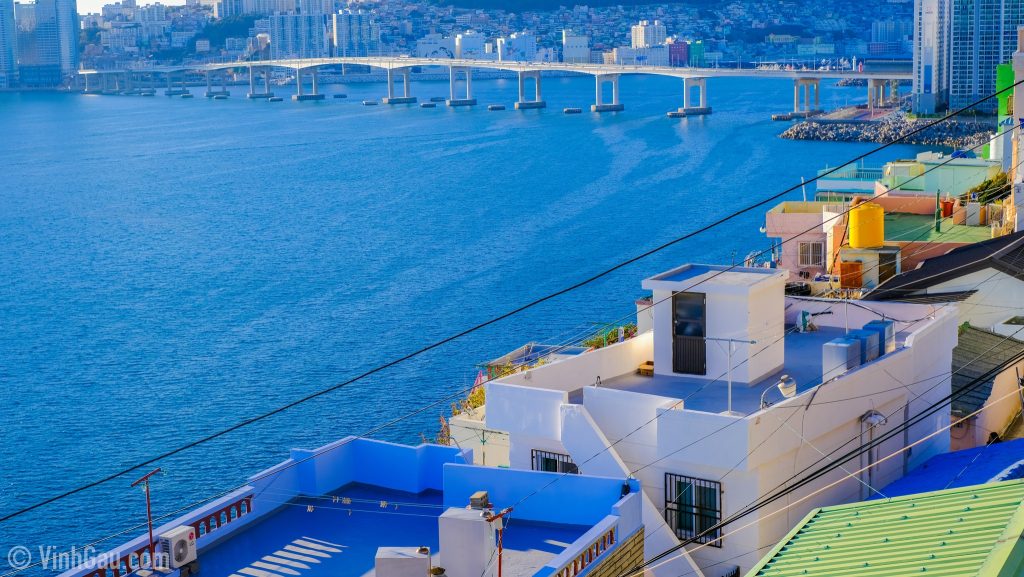
When I came here, I just wanted to wander back and forth through the alleys and chill with a cup of coffee to watch the sunset. Gently, slowly, chill. What more can you expect from an afternoon like this in Busan?
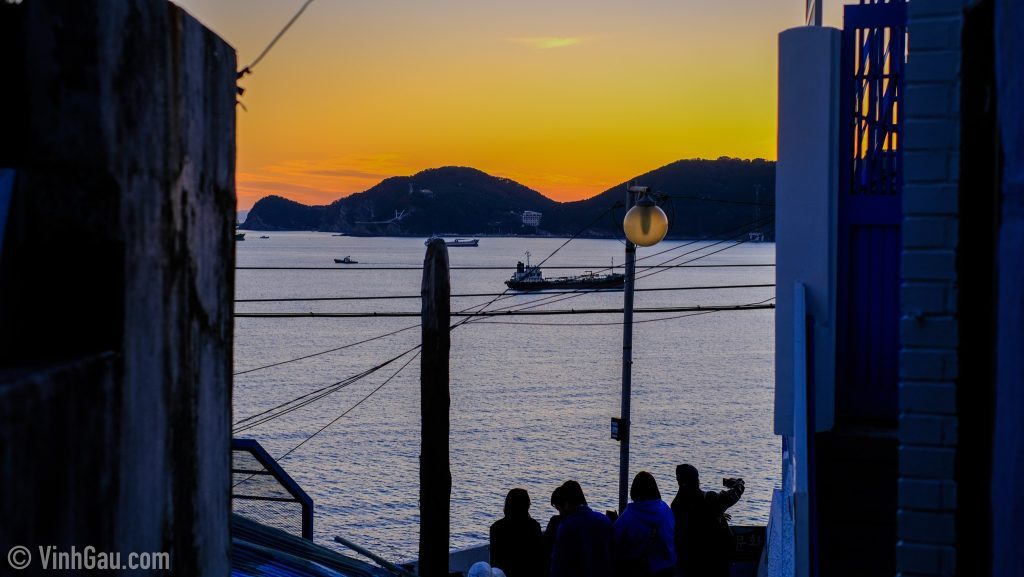
Day 8: Return to Vietnam from Busan
Bring your suitcase to Gimhae International Airport in Busan and fly back to Vietnam.

Where to stay when traveling to Korea?
I’ve just given you full information for the South Korea itinerary 7 days, you already have enough information, so where to stay? Here are some suggestions about the area for you to search on Booking.com yourself. If you find a room price that suits your budget, then boldly click to book and you’re done. It’s as easy as eating ice cream!
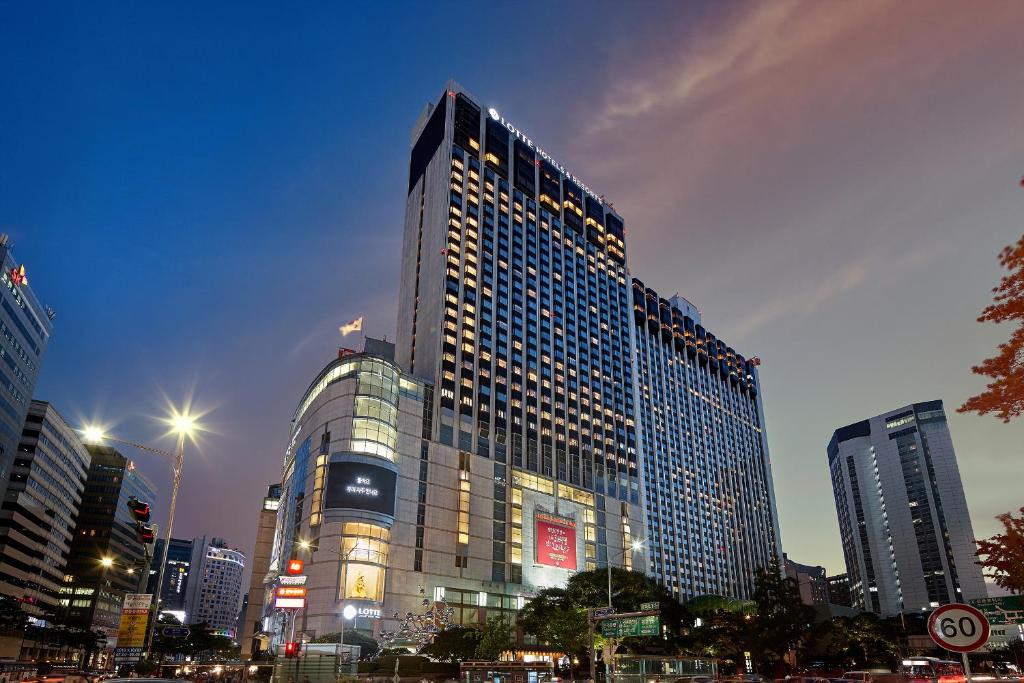
- Seoul : Just find a hotel around Myeongdong , Dongdaemun, Hongdae, Itaewon or near Seoul Station. Convenient to travel but still bustling at night.
- Gyeongju: You can find hotels near Cheomseongdae and Gyeongju National Museum. Going exploring is easier, taking the bus to the KTX train station is even easier.
- Busan : You can find a hotel near Haeundae night market, Haeundae beach or Gwangalli beach to stay there. Right in the entertainment center.
Some best day tours, trips, activities and transfer services, tickets in and from Seoul you can refer to
- Private Incheon International Airport Transfers (ICN) for Seoul
- Private Incheon Airport Transfers (ICN) for Seoul
- Incheon International Airport (ICN) Limousine Bus Transfers for Seoul (Gangnam District)
- Klook Exclusive Seoul 5 Day Pass
- Discover Seoul Pass (BTS Edition Available)
- [SALE] Instant Ticket! Korea Rail Pass (KR PASS) 2/3/4/5 Days to travel around the cities in Korea
- Private Incheon Airport (ICN) and Gimpo Airport (GMP) Transfers for Seoul by S.A Tour
- Everland Private Car Charter with Admission Ticket by Wondertrip
- KAL Limousine Bus Ticket for Seoul
- [Limited Offer] AREX Incheon Airport Express Train One Way Ticket in Seoul
- Bukchon Oneday Hanbok Rental Experience (4/24 Hrs)
- Nami Island, Petite France, Garden of Morning Calm, and Gangchon Rail Bike Day Tour from Seoul
- Seoul City Sightseeing Bus (Downtown Palace Namsan Course/Seoul Panorama Course)
- [Limited Offer] Incheon International Airport (ICN) Luggage Services (Between Airport and Hotel) by Safex
- 4G Prepaid SIM Card (SK Airports Pick Up) for South Korea
- [Sale] Hanbok Experience (Hanboknam Gyeongbokgung Store) with Korean Hairstyling
- [SALE] South Korea 4G Pocket WiFi (KR Airports Pick Up) from KT Olleh
- 4G WiFi (MY Airport Pick Up) for South Korea (Unlimited Data)
- 4G Portable WiFi for South Korea from Uroaming (Unlimited Data)
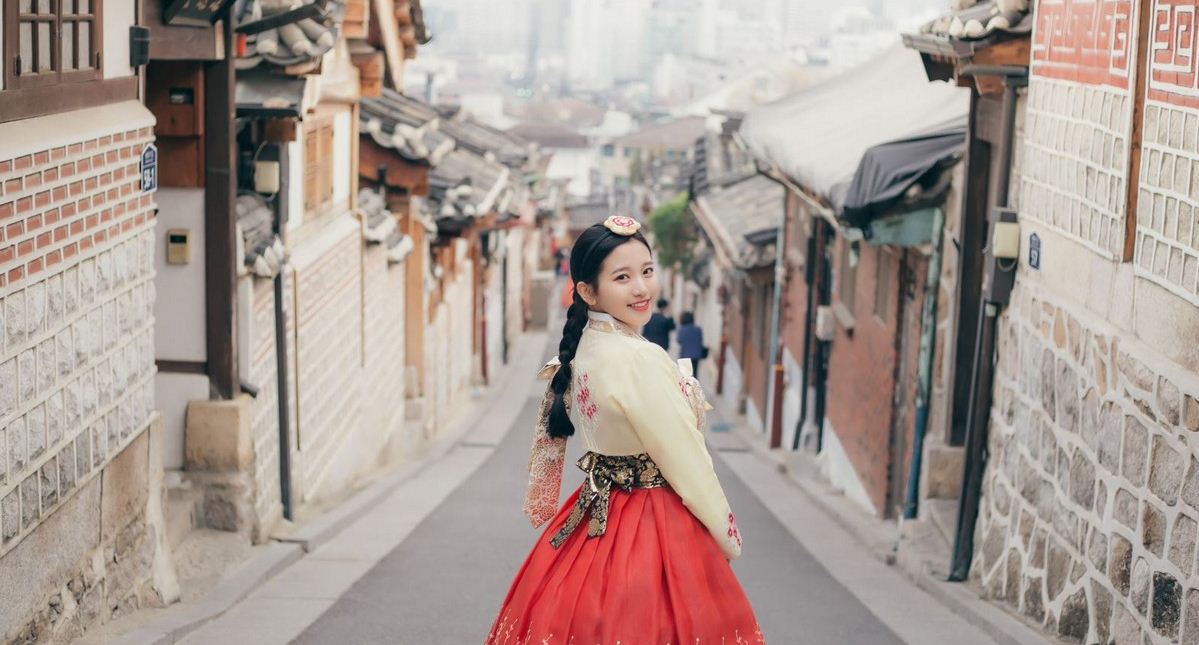
Are you finding more top things to do in Seoul: Tours, activities, attractions and other things? Let’s check it out here .
Related articles
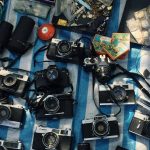
RELATED ARTICLES MORE FROM AUTHOR
Arashiyama travel blog — the fullest arashiyama travel guide with top things to do in arashiyama, explore fenqihu old street — what to do in fenqihu in a day trip, where to go in kunming — 15+ top kunming attractions & best places to visit in kunming, must eat in melaka — 10+ famous malacca street food & must try food in melaka.
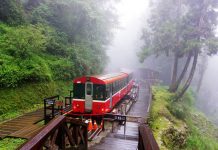
What to do in Alishan? — 5 top attractions & best things to do in Alishan, Taiwan
Hong kong food culture — hong kong cuisine tells the historical story of the whole land.

Melaka food blog — Experience Melaka delicacies, arrived at by Trishaw
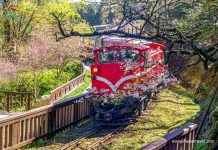
Alishan travel blog — The fullest Alishan travel guide for first-timers
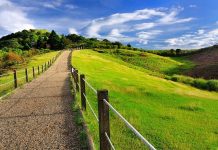
Gingtiangang Grassland Yangmingshan — The ultimate guide on how to go & top things to do
Editor picks.

Arashiyama travel blog — The fullest Arashiyama travel guide with top...

Explore Fenqihu old street — What to do in Fenqihu in...

What to eat in Chongqing? — 14+ most famous, best food...
Popular posts.

What to buy in USA? — 17+ must buy in USA...

Must buy souvenir in Taiwan — Top 17+ most famous, cheap...

Must buy in Korea — Top 23 cheap, famous & best...
Popular category.
- Inspiration + Guide 1455
- Trip Inspiration 469
- Thailand 209
- Food + Drink 207
- Coasts + Islands 193
- South Korea 168
- Vietnam 166
- Travel Photos 144
- Work for Us
- Terms & Conditions
- Privacy Policy
- lol Badge Feed
- win Badge Feed
- trending Badge Feed
Browse links
- © 2024 BuzzFeed, Inc
- Consent Preferences
- Accessibility Statement
South Korea Is A Total Bucket-List Destination – Here Are 10 Amazing Things To Get Up To
From the busy streets of Seoul to a night spent in a traditional hanok home – it's time to start planning your visit!

BuzzFeed Staff
I'm Hanifah and I love to travel. South Korea's been on my bucket list for years, but I’d never gotten around to planning the perfect trip.
View this photo on Instagram
So when I got the chance to join Intrepid’s first-ever Essential South Korea trip, I jumped at the opportunity.
As someone who loves a packed schedule but gets overwhelmed when it comes to the actual organising, the trip looked perfect. This isn't just your average holiday – it's an immersive experience packed full of adventures and is the newest addition to Intrepid’s 15-35 trips. The itinerary involves nine days of soaking up a wealthh of South Korean culture, visiting Seoul, Jeonju, Busan, and more.
From trying street food to staying in a traditional historic home, the itinerary is packed to the brim with so many different cultural experiences, and I can’t think of a better way to explore the country in all its glory. If you’re thinking about visiting South Korea and want to make sure you make the most of it, check out everything that’s included in the Essential South Korea trip here.
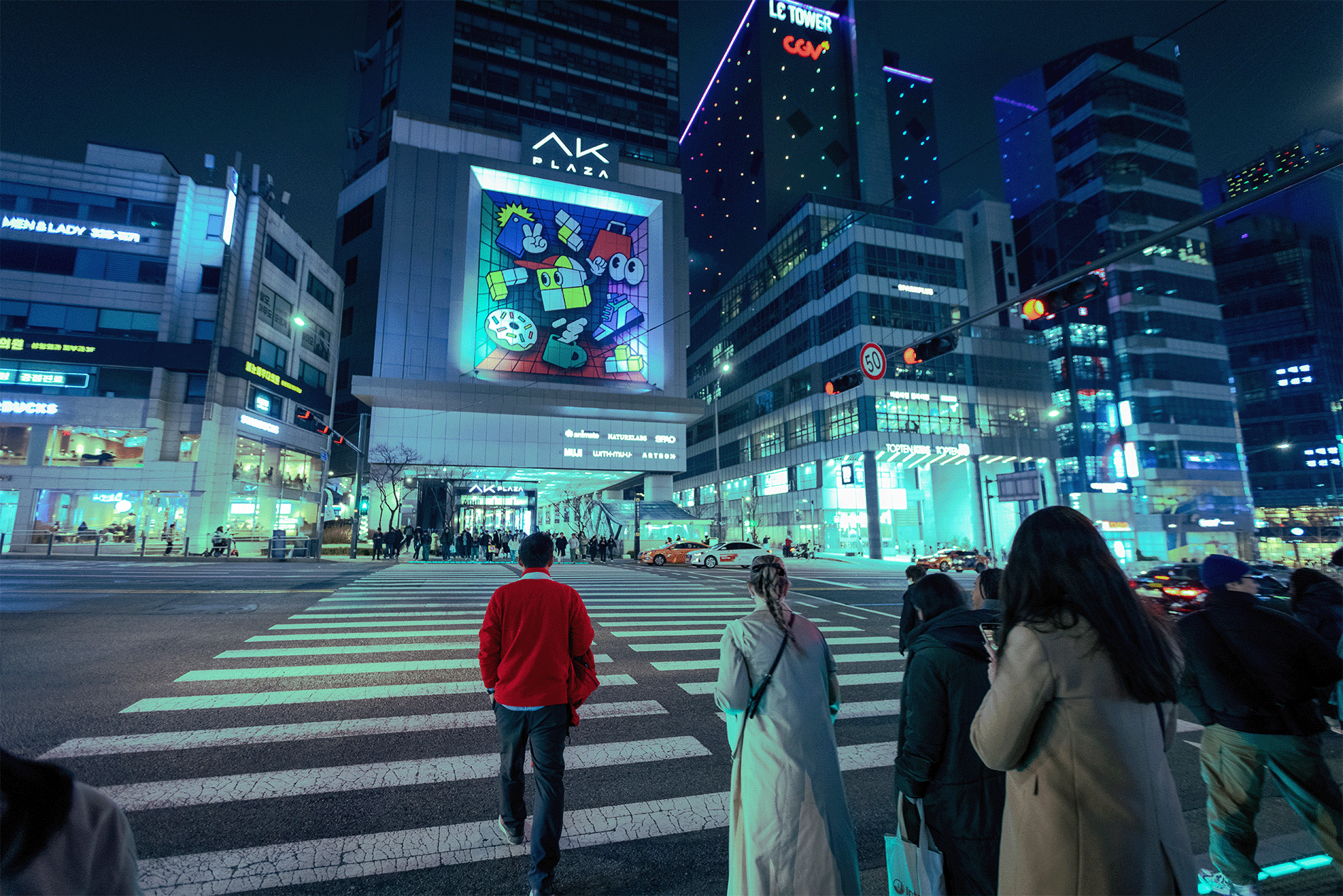
Top tips before you go!
– To make the inevitable language barrier a little bit easier, I suggest downloading the app Papago for on-the-go translations. Not only does it have pretty good vocal recognition, but you can also take photos of text and have it instantly translated.
– No one expects you to be fluent, but knowing some basics of the language goes a long way. “Annyeonghaseyo” (ahn-nyeong-ha-se-yo) means hello and “gamsahabnida” (kam-sa-ham-ni-da) means thank you. You’re sure to pick up more Korean along your journey, but it’s good to have those basics down.
– It’s likely that the data on your phone won’t work, but there are simple solutions at the airport. You can hire a pocket wifi egg or a data sim card at the arrivals gate.
– When it comes to navigating travel in South Korea, Google Maps has nothing on Naver . It gives you perfect walking directions, as well as the best ways to get to your destination (each subway station has multiple exits, and without Naver, I’d have been totally lost).
– A T-money card makes travelling super convenient. You can pick one up at any 7-Eleven for 3,000 KRW (about $2), and top it up in the subway station as you need. You can use a T-money card to pay for your travel on the bus, subway, and some taxis.
Here are some amazing things to get up to in Korea!
🇰🇷 seoul 🇰🇷, 1. take a step back in time at the historical gyeongbokgung palace.

A few stops on the subway takes you out of the bustling city and back to quiet of the the 14th century. Built in 1395, Gyeongbokgung is considered to be the most beautiful palace from the Joseon Dynasty, and it’s easy to see why. As soon as we set foot on the grounds I was blown away by the ornate designs, and with families strolling around adorned in traditional hanbok clothing, it wasn’t hard to imagine just how regal the palace was back in its heyday. It’s a good idea to get there by 11 am, which is when the guard changing procession begins, a recreation of the traditional ceremony of the past.
2. Channel your inner idol at a K-Pop dance lesson at FRZM Studio

In the heart of trendy Hongdae, you’ll find FRZM dance studio , which is home to some of Seoul’s coolest dancers. If you’ve seen even one K-pop video, you’ll know these guys don’t mess around when it comes to choreography, so why not learn from the best? Our teacher Peri was a total star who came prepared with a sleek routine that she somehow managed to break down for us dance newbies. While it didn’t take me long to discover that I don’t, in fact, have what it takes to be a K-Pop star (not even close!), I had so much fun trying to follow along with Peri and her flawless choreography.
3. Eat some delicious traditional food at Gwangjang Market
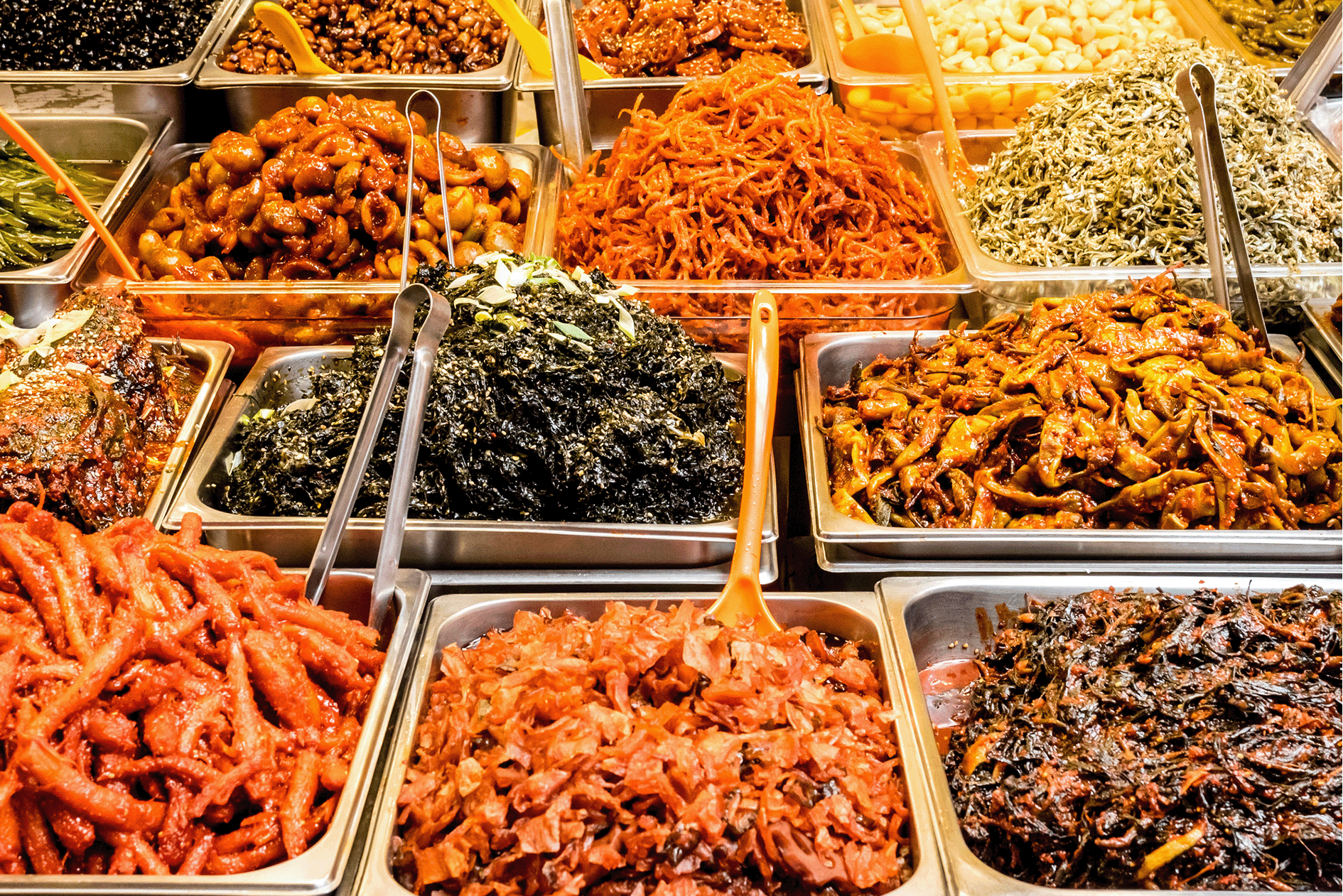
South Korea is famed for its street food, and Gwangjang Market is the perfect place to find out exactly why. As you set foot into the market you’re greeted by an array of glorious flavours, and even though I wasn’t sure what I was smelling, I knew my tastebuds were in for a treat. Whether you fancy traditional fried chicken or soft-shell crab, there are endless stalls offering a plethora of delicious delights. There are so many options to choose from, and most of the stall owners are more than happy to give you a bite or two to sample. The market is also home to traditional goods, groceries, and various souvenirs, so it’s worth taking a look around after you’ve finished stuffing your face.
4. Sing your heart out at karaoke in Hongdae
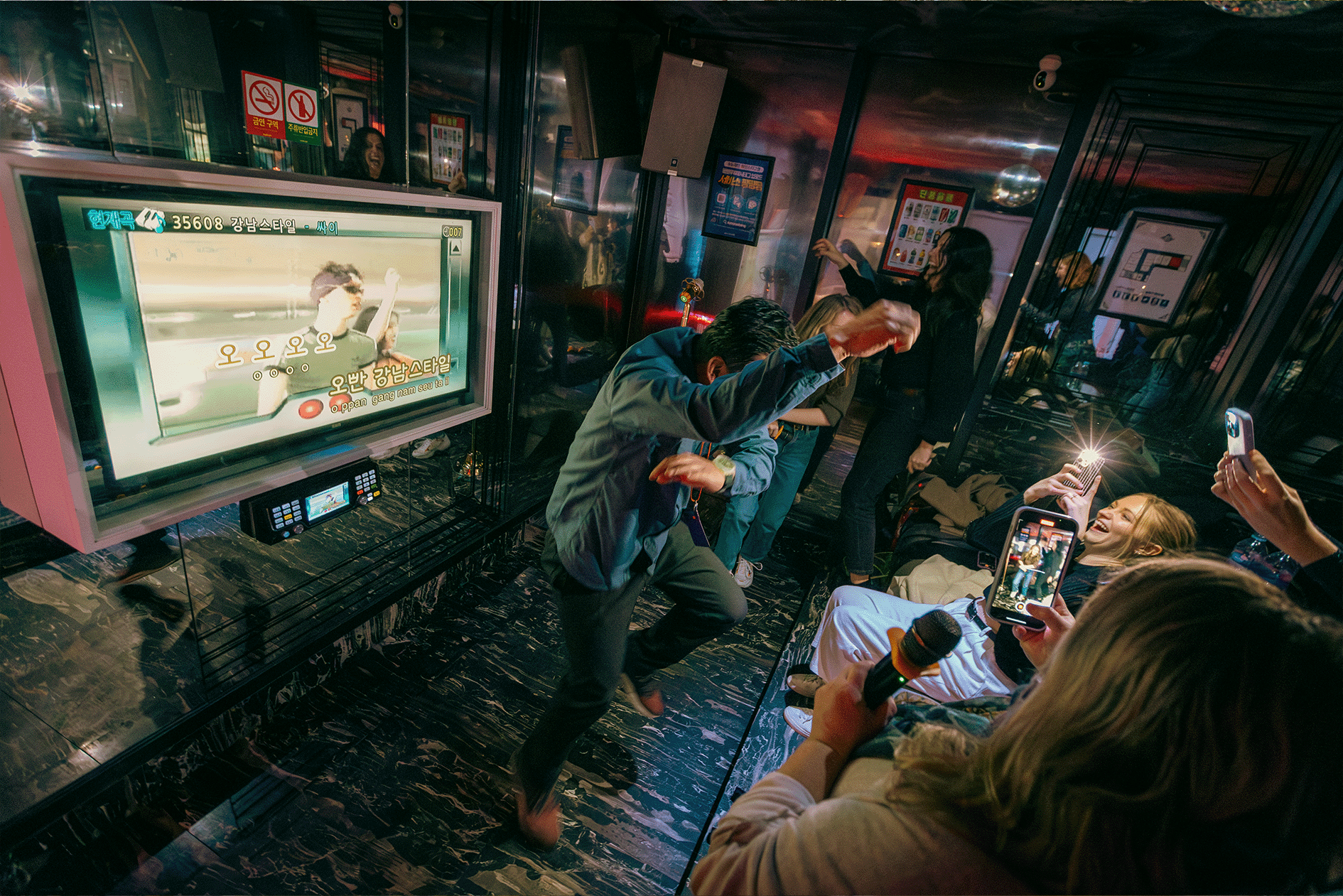
If you’re looking for nightlife, Hongdae is the place to be – packed to the brim with bars and restaurants ready to welcome you with cocktails and anju (food to eat alongside your drinks), and of course karaoke. In Korean, karaoke is referred to as “noraebang”, which literally means a song room, but I don’t think that definition does it justice. They have endless collections of K pop hits (yes, we did “Gangnam Style”) as well as all the classics, and with the disco ball and lights it really feels like your own private night club.
🇰🇷 Jeonju 🇰🇷
5. spend the night in a traditional hanok village.
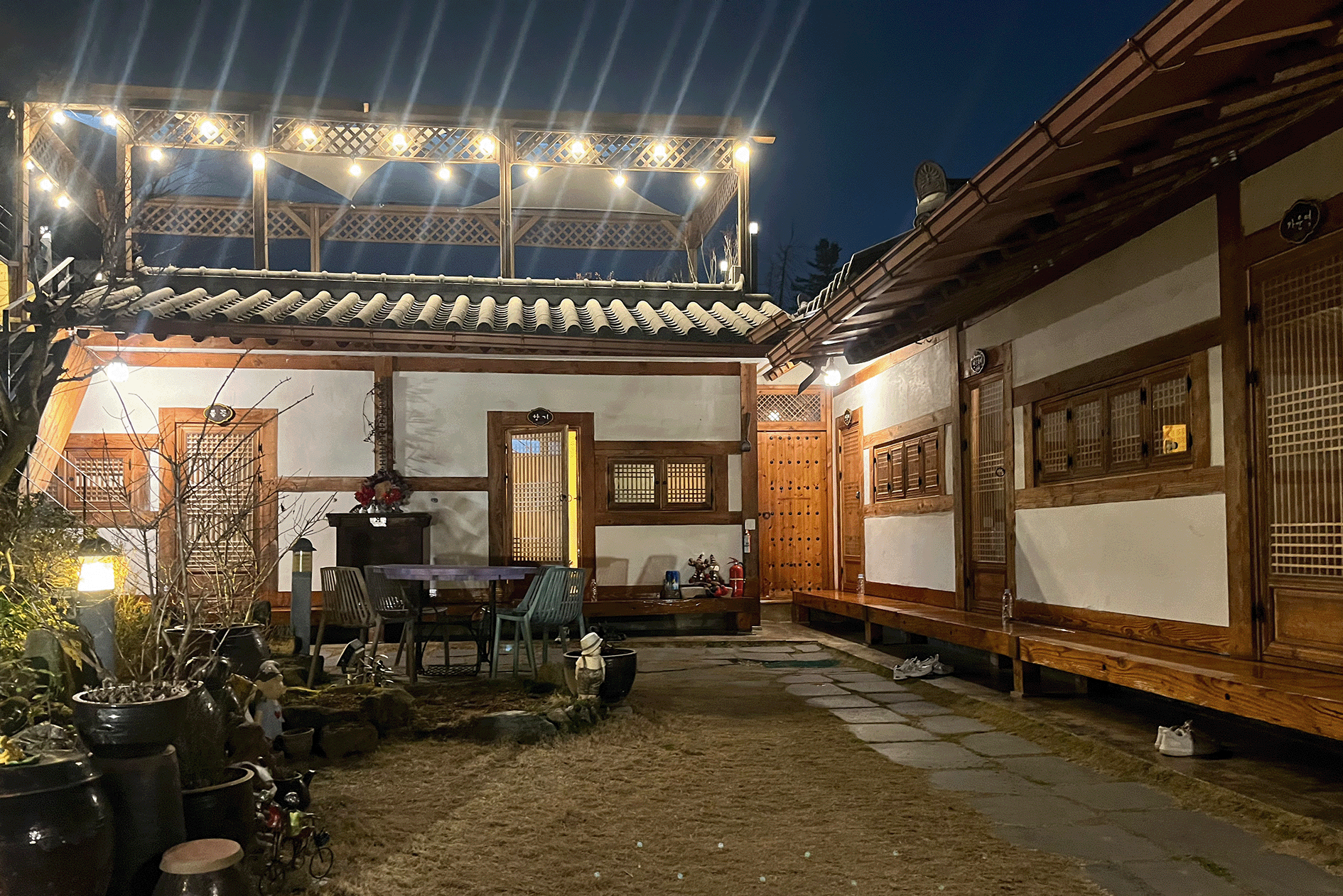
Hanoks are traditional Korean houses, dating all the way back to the Joseon dynasty, and to put it plainly, they’re stunning. Historically, hanoks housed entire families, but the ones you can stay in have been transformed into guest houses. As soon as I stepped into the courtyard I was greeted by some friendly village cats , and things just kept getting better from there. While they’ve been updated with modern conveniences, the heart of the homes remains authentic; the wood panelled walls are decorated with traditional Korean art and the bed folds neatly away into the cupboard. As a sleep lover, I wasn’t sure how I’d fare on the futon-like floor mattress, but with the heated floors and tranquil surroundings, I slept like a baby.
6. Take a Kimchi-making class with the Kimchi master

Kimchi is a staple of the Korean diet, and if you’ve had it before, you’ll know why. We joined Kim Myeong Ok – a total kimchi genius – to learn all about what goes into making the traditional food. After finding out the many seasonings that go into the dish (and snacking on the pickled cabbage, of course), we jumped straight into TV chef mode, determined to be the best rookie kimchi makers we could. Myeong talked us through the marinating process, and with our aprons and long gloves, we really got into the technique. Once you’re finished, you can pack it all up to enjoy eating back home – it’s the perfect holiday souvenir.
7. Visit the ancient ruins of Webosansung
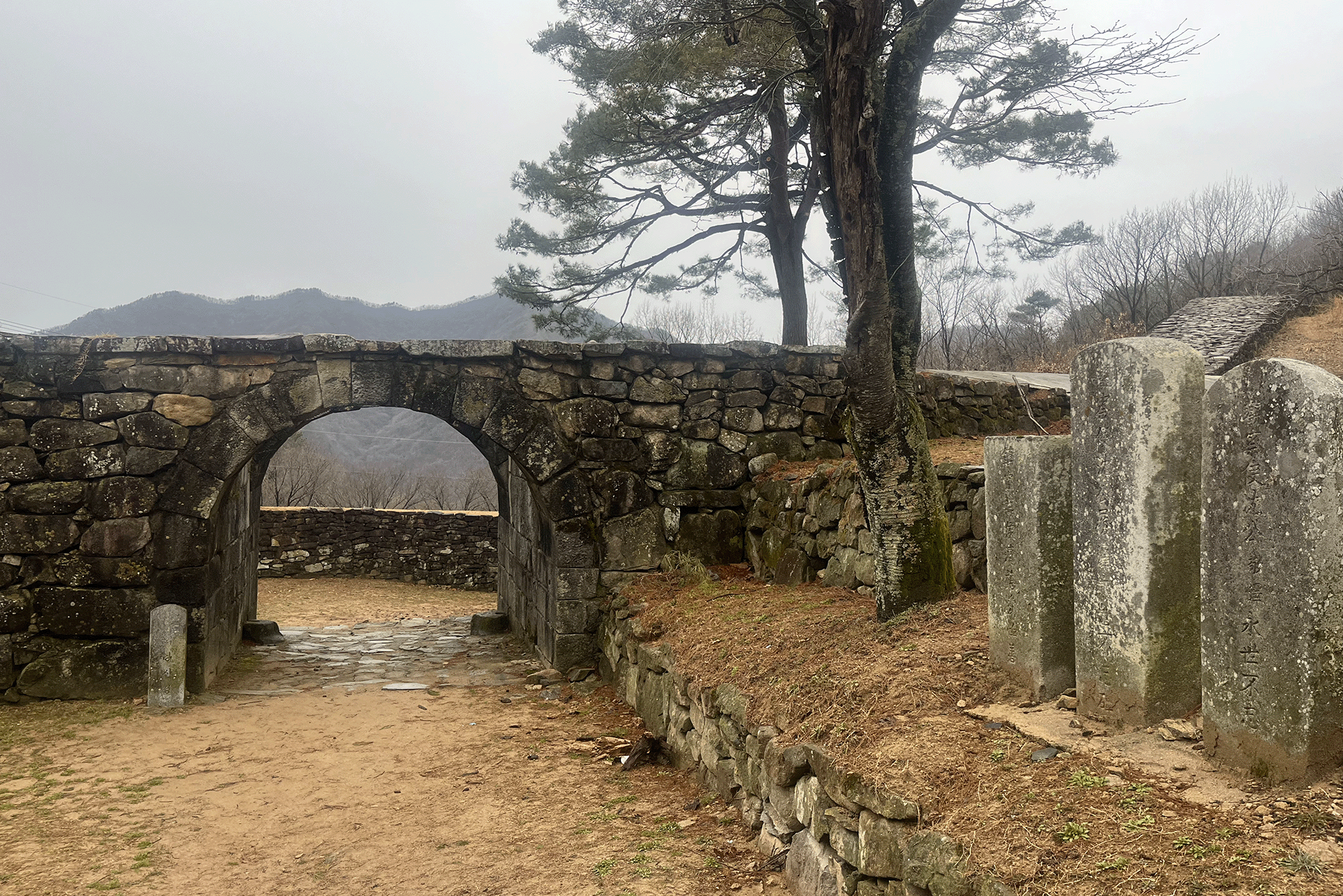
This historic mountain fortress was built in the 17th century, as a way to help evacuate and protect residents in the late Joseon Dynasty. The wall is over eight thousand years old, and it’s surrounded by miles and miles of forest hills – it really feels like taking a stroll in the past. It’s not too far from Awon Museum, which is located across three 250-year-old hanoks that overlook a mountain village; their stunning gardens have some spectacular views.
8. Get a body scrub at The Hanok Spa

This might look like an unsuspecting tower block, but inside is a menagerie of pampering and self care. If I’m being honest, I was a bit intimidated when I first approached the spa – I knew I’d have to strip off, but not much more. This 24 hour spa is really popular with the locals, and while there was a bit of a language barrier, the staff there were super friendly. There are heated pools to rest and relax in, and it didn’t take long for me to feel at home among the older ladies chatting away and watching TV. As a dedicated exfoliator, I wasn’t expecting too much from the body scrub, but boy was I wrong – I could literally see my dead skin getting sloughed off. I left the spa feeling like a soft little peach, and I couldn’t recommend it more.
🇰🇷 Busan 🇰🇷
9. watch the waves at haedong yonggungsa temple.
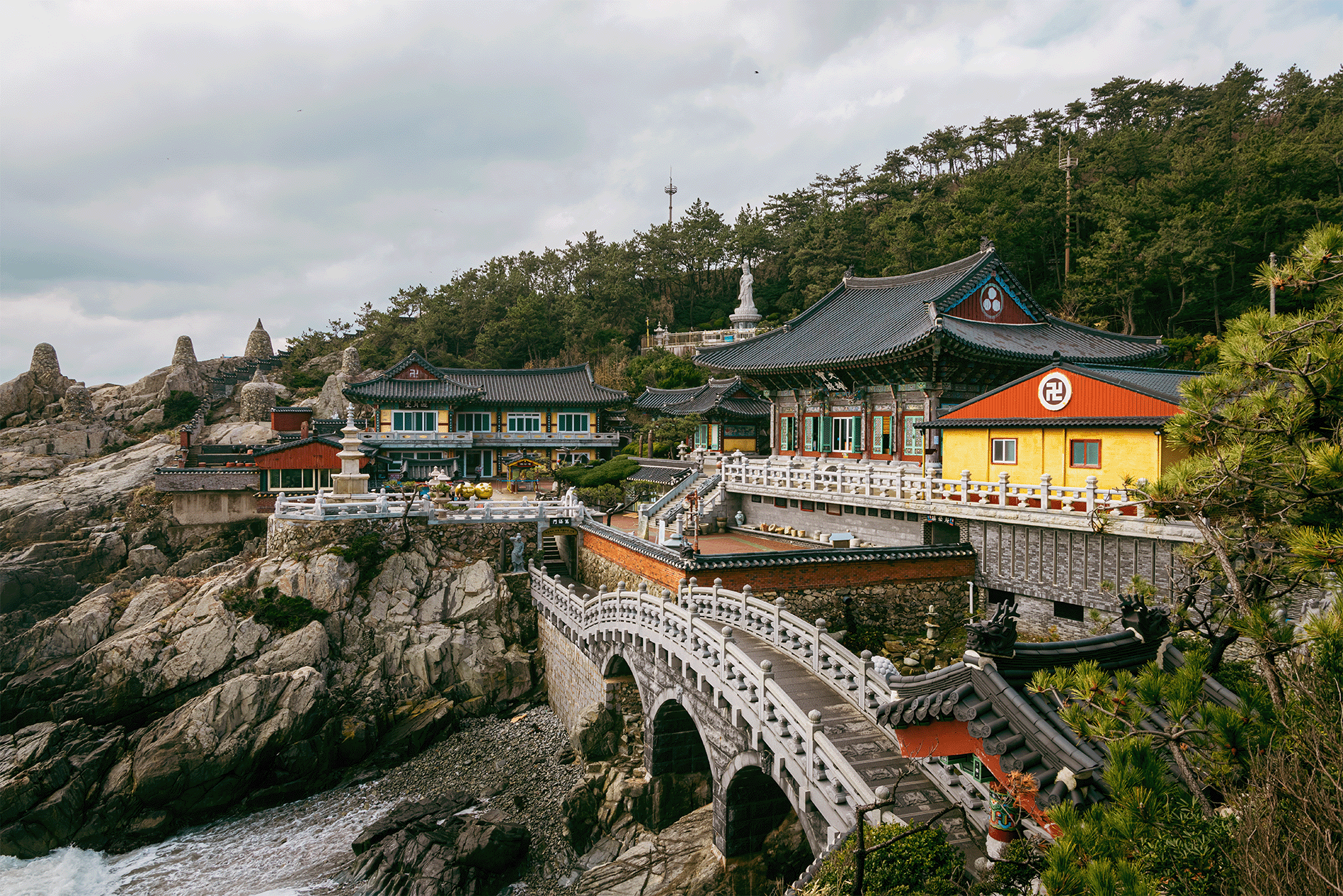
Set right on the shoreline, Haedong Yonggungsa Temple is a wonder of both natural and historical beauty. First built in 1376, the Buddhist temple is a place of reflection and peace, and it's truly breathtaking. As I walked down the temple’s 108 steps, I was blown away by the picturesque views surrounding me – intricately designed architecture, ethereal statues, and gorgeous stone lanterns, to name a few delights. I loved learning about the historical Buddhist traditions and symbolism, but my favourite part was the tranquil backdrop of crashing waves. There are lots of temples to visit, but none as unique as this one.
10. Take a stroll through the stunning Gamcheon Culture Village
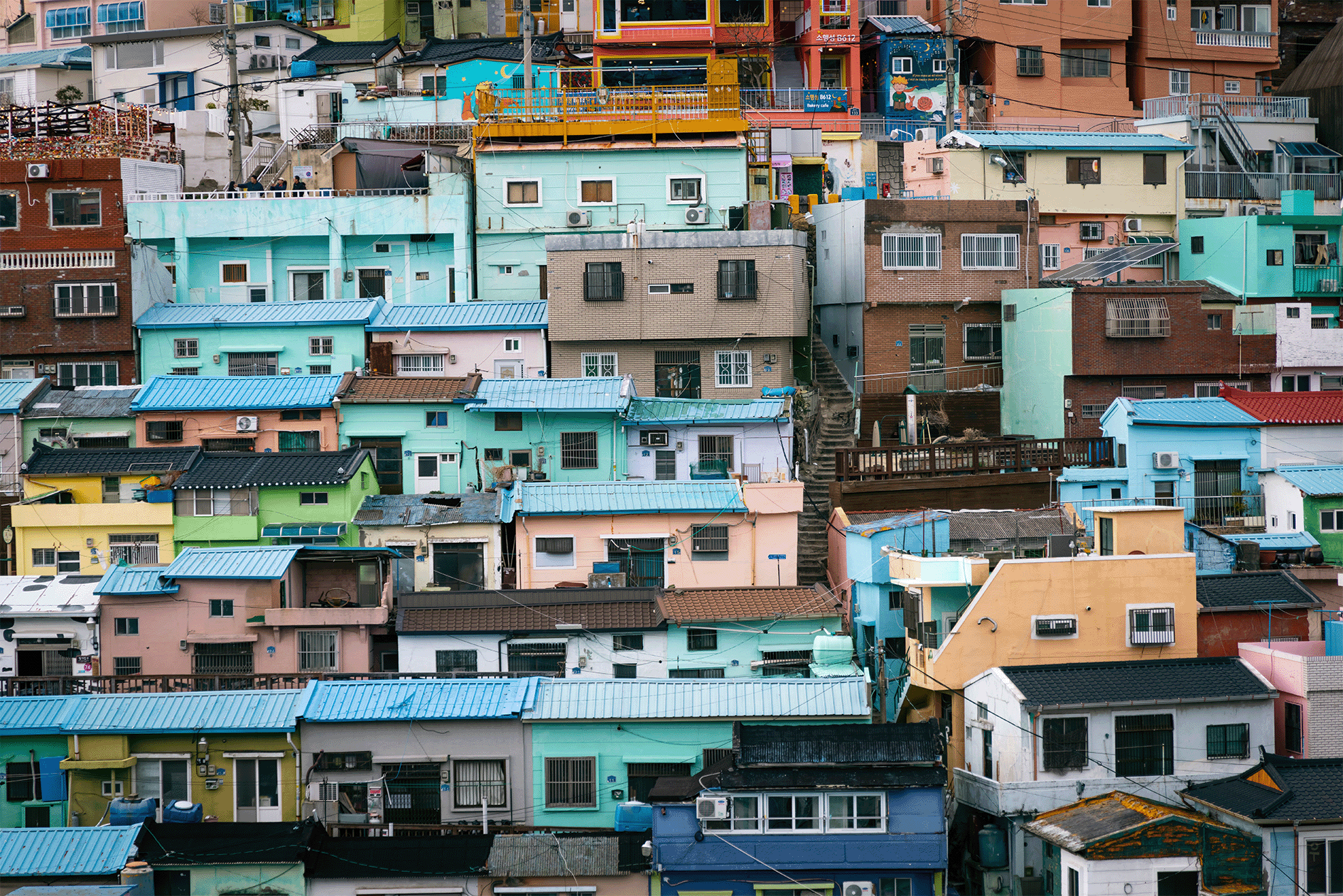
With its twisting alleys and colourful houses, Gamcheon Culture Village feels like a storybook come to life. Decorated by professional artists, art students, and residents, it’s easy to see why the village is one of Busan’s most popular tourist spots. While strolling through the lovingly adorned streets, we were met with tons of artisan shops selling stunning handmade trinkets and some wonderful art installations. BTS fans: keep an eye out for the Jimin and Jungkook mural, it’s really something to behold.
Have you visited South Korea? Let us know your recommendations in the comments below, and visit Intrepid's website to find out more about their 16-35s Adventures!
Share this article.

IMAGES
VIDEO
COMMENTS
Hop onto one of these tours including Namdaemun Market: Seoul Street Food Walking Tour: Enjoy Korean street food delicacies from BBQ ribs to green onion pancakes with your own expert guide. UNESCO and Traditional Markets Tour: Combine a visit to Changdeokgung and Namdaemun Market with this 4-hour afternoon tour.
This 10-day itinerary is excellent for a first visit to South Korea. It covers the must-see attractions in Seoul, Busan, Gyeongju, and Jeju Island, as well as a variety of authentic activities to enrich your trip. 3 nights in Seoul. 1 night in Gyeongju. 2 nights in Busan.
Option 2: One Week in South Korea off-the-beaten-path. Day 1: Cafes, Seongsu, Seoul Forest. Day 2: day trip to Chuncheon. Day 3: Gyeongju day trip. Day 4 + 5: Busan. Day 6: day trip to Namhae, Boseong. Day 7: Back in Seoul or spend a day in Incheon. Option 3: Seoul, Gyeongju, Busan. Option 4: Seoul and day trips.
In this travel guide, we'll help you map out an unforgettable trip to South Korea in just 7 days. We'll provide you with a detailed itinerary, so you can explore the best of South Korea while staying within your budget and schedule. From exploring vibrant markets to enjoying delicious Korean cuisine, we've got your travel plans covered.
South Korea Itinerary 14 Days. Seoul (Days 1-4) Jeju (Days 5-7) Busan (Days 8-9) Suncheon area (Days 10-12) Jeonju (Days 13-14) See below for more information on each city. South Korea Itinerary 10 Days. Seoul (Days 1-4) Jeju (Days 5-7) Suncheon area (Days 8-10) See below for more information on each city. Click to check current hotel prices in ...
Namsan Park & Seoul Tower. Visiting Namsam Park is one of the best places to visit in South Korea! It should definitely be on your 2 week South Korea itinerary and it's the perfect spot to view all of Seoul! It will take 30 minutes to 1 hour to reach the top of the park and it's a relatively easy climb up to the top.
Safety in South Korea . We didn't encounter any problems whatsoever (except getting cash :-)) during our week in Korea but if you would you can call the travel hotline in 4 languages (Korean, English, Japanese and Chinese) 24/7. Internet in South Korea . South Korea has the fastest internet in the world. A lot of places offer free WiFi.
With 10 days in South Korea, you can enjoy a well-rounded introduction to the country's bustling cities and historical sites on a highlights tour or take a deeper dive into Seoul, Andong, Gyeongju, and Busan's intriguing past on a history and culture-focused trip. Adventure seekers can enjoy the endless activities in Odaesan and Seoraksan National Parks, while K-drama fans should take ...
Days 3-4: Andong. When you arrive in Andong, it's not hard to notice a stark contrast from the bustling capital of South Korea. While walking through Seoul is an exercise in back-and-forth time travel from past to present to future, Andong is mostly rooted in centuries-old traditions and culture. I'm not complaining.
Travel route for your South Korea itinerary. Day 1-4: Arrival and Jeju Island (3 nights) Day 4-6: Busan (2 nights) Day 6-7: Gyeongju (1 night) Day 7-12: Seoul (5 nights) Day 12-13: Sokcho (1 night) Day 14: Seoul and departure; Visiting one of the many palaces in South Korea
Day 1: Arrive in South Korea. Day 2: Gorgeous Gyeongju. Day 3: Visit Bulguksa and Seokguram Grotto. Day 4: Explore Hongdae, Seoul's Most Vibrant Neighborhood. Day 5: Historic Seoul. Day 6: Cultural Seoul (and Market Madness) Day 7: Gangnam Style. Day 8 and 9: Stunning Seoraksan National Park.
Getting from Seoul airports to the city. Budget for 2 weeks in South Korea. 2 week South Korea itinerary overview. Days 1-5: Seoul. How to get around Seoul. Day 1 - Bukchon Hanok Village OR Bukhansan National Park. Day 2 - Ihwa Mural Village, Gwangjang Market, Insa-dong & Myeongdong. Day 3 - DMZ day trip. Day 4 - museum & culture day.
The itinerary covers 8 out of 9 Korea's Top 100 Must-Visit Places in Korea (2023-2024) in Seoul (e.g. N Seoul Tower, Gyeongbokgung Palace, Hongdae), as released by Korean Tourism Organization. It also covers previous attraction winners like Myeongdong .
Although one could easily spend a week in Seoul alone, a seven-day itinerary encompassing the entire country is entirely doable, and will give you a thorough overview of Korea's natural beauty and cultural treasures. South Korea is well known for its vast and easy-to-use public transportation system; a seamless network of subways, trains ...
South Korea 7 Day Itinerary at a glance: Day 1 - Historical sights and night views of Seoul. Day 2 - Jogyesa temple, Bukchon village, Gyeongbokgung and modern Seoul. Day 3 - Day trip to Gapyeong (Petite France, Nami Island and Garden of Morning Calm) Day 4 - Seoul parks, Shopping districts and Food markets.
Cost To Travel In South Korea In 2024. This part of the South Korea travel guide will help you understand some of your expected costs to travel to Korea. The costs to travel to Korea include flights, accommodation, food, drinks, transportation, activities, sim cards, visas, souvenirs, travel insurance, and lots more.
How to Get to Beopjusa Temple, Mount Songnisan. South Korea itinerary. It is easy to get to Beopjusa Temple from Seoul. Simply take the bus to Songnisan from Seoul bus station and get off at the last stop. The temple is situated within Songnisan National Park, approximately a 20 minute walk away from the bus terminal.
Andong - City with Traditional Culture. Yeosu - Southern Coastal City with Great Food and Views. Suncheon - South Korean City with Film Set. Or, make it a 20 day itinerary! We hope you have enjoyed and made the most of these 10 days in South Korea! Drop any questions in the comment box below.
Let's begin our journey! South Korea Itinerary: Seoul - 4 Days. Below are the most important tourist attractions in Seoul, the ones I recommend visiting. From breathtaking panoramic views, shopping opportunities, history and culture, this itinerary covers it all. Take A Trip To The North Korean Border.
Here are the top apps for planning South Korea itinerary 10-days you can use to make your journey easy. 10-Day South Korea Itinerary: Provinces, Day to Day. You must start your visit from the capital of South Korea, Seoul and you will get to learn the royal history, Korean cuisine. Then on 3rd Day, you can travel to Suwon to watch the folk ...
Safety in South Korea (10-Day Itinerary South Korea) South Korea is a very safe country for solo female travelers. Just be aware crime still happens despite the safety ratings. According to Global Finance, Korea has a safety index score of 8.93. This means you will find CCTV everywhere and Koreans in keeps themselves in check.
The Ultimate Korea Itinerary Guide for 1 Month Fly Into: Incheon International Airport. Assuming you're coming from abroad, you're most likely going to fly into Incheon Airport!Incheon has spoiled me because it's seriously one of the best airports in the world, even if the "ice rink" is a lie.Seriously, this place even has arrows on the ground to make sure you're going in the right ...
Changing of the guard ceremony | south korea travel itinerary 7 days Gwanghwamun Gate, the main entrance gate to Gyeongbokgung Palace | south korea travel itinerary 7 days. Next is the second largest palace in Seoul - Changdeokgung - where there is an open courtyard for the coronation of Joseon kings and a place to welcome foreign envoys. ...
The itinerary involves nine days of soaking up a wealthh of South Korean culture, visiting Seoul, Jeonju, Busan, and more. ... - When it comes to navigating travel in South Korea, Google Maps ...